Nature in the PACA region
The Provence-Alpes-Côte d'Azur region has a unique biological diversity in France, due to the meeting of Alpine and Mediterranean influences. For example, more than 70% of the native flora of metropolitan France is found in PACA. Four National Parks (Port-Cros, Mercantour, Ecrins and Calanques) and six Regional Parks (Lubéron, Queyras, Verdon, Camargue, Alpilles and Préalpes d'Azur) contribute to preserving this exceptional nature. Associations such as the Conservatoire d'Espaces Naturels Provence-Alpes-Côte d'Azur (CEN PACA) also work to preserve the biodiversity of this region. They need your support to function: join!!! This section mainly concerns the east of the PACA region (Alpes-Maritimes and east of the Var). It deals separately with the Mediterranean range and the mountains.
The Mediterranean range
Unlike that of Corsica, the coast of the Alpes-Maritimes and the Var has been heavily urbanised, leading to the scarcity and disappearance of many species. Only a few relatively spared areas remain (Estérel, coast near Ramatuelle, and Hyères islands).
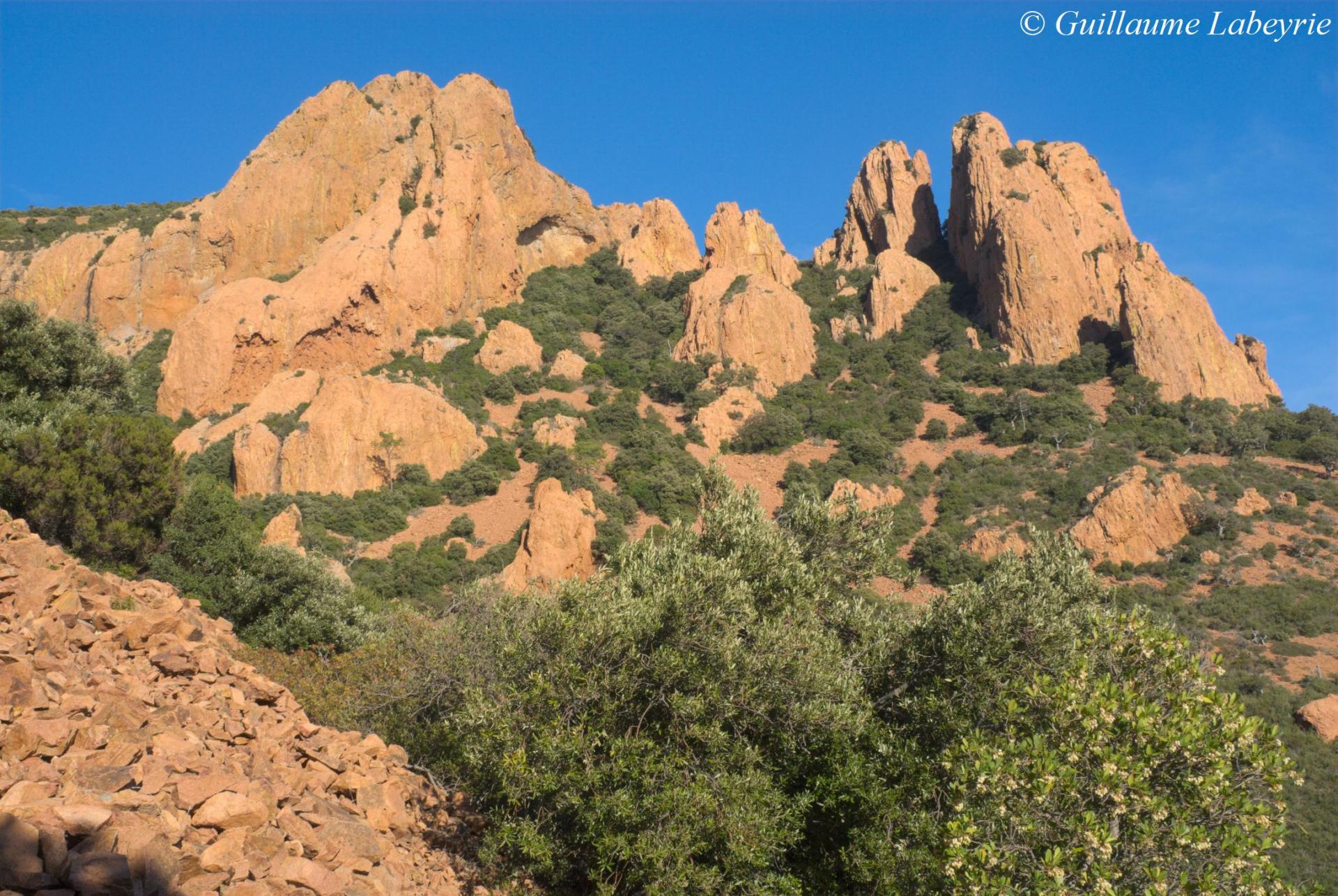 The cliffs of Cap Roux (Estérel). The rhyolite cliffs of Cap Roux overlook the sea, on the south-facing slope of the Estérel range. Protected from urbanisation, the area still contains an original fauna and flora.
The cliffs of Cap Roux (Estérel). The rhyolite cliffs of Cap Roux overlook the sea, on the south-facing slope of the Estérel range. Protected from urbanisation, the area still contains an original fauna and flora.
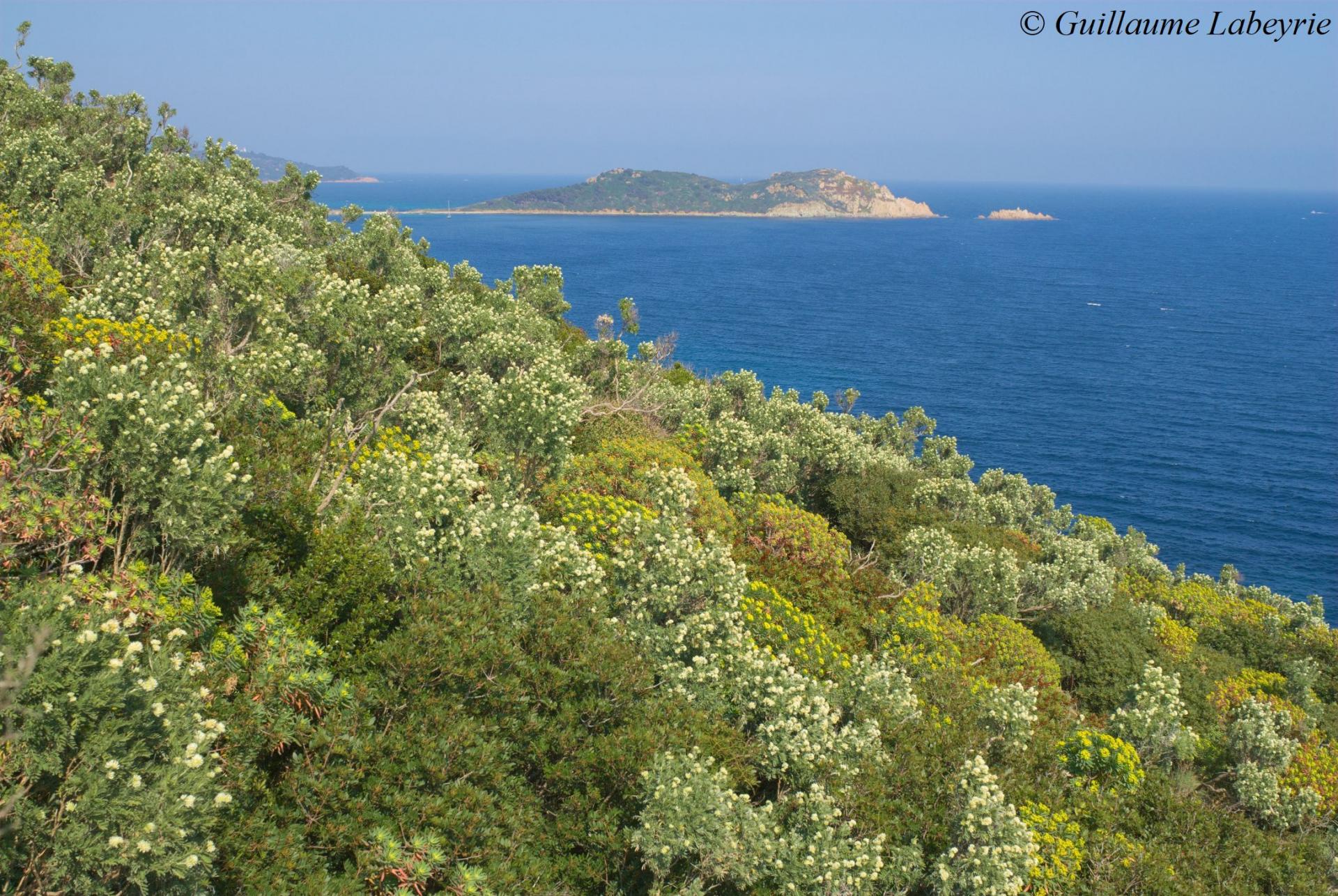 Rich mediterranean maquis at Cap Lardier (Ramatuelle). Located west of Saint-Tropez, this patch of coast is still relatively untouched, and protected by several sites of the French Conservatoire du littoral. A rich Mediterranean flora can be found there, among which the Jupiter's beard (Anthyllis barba-jovis, bushes with white flowers on the photo) and the tree Spurge (Euphorbia dendroides). In the background of this photo, the remarkable isthmus of Cap Taillat.
Rich mediterranean maquis at Cap Lardier (Ramatuelle). Located west of Saint-Tropez, this patch of coast is still relatively untouched, and protected by several sites of the French Conservatoire du littoral. A rich Mediterranean flora can be found there, among which the Jupiter's beard (Anthyllis barba-jovis, bushes with white flowers on the photo) and the tree Spurge (Euphorbia dendroides). In the background of this photo, the remarkable isthmus of Cap Taillat.
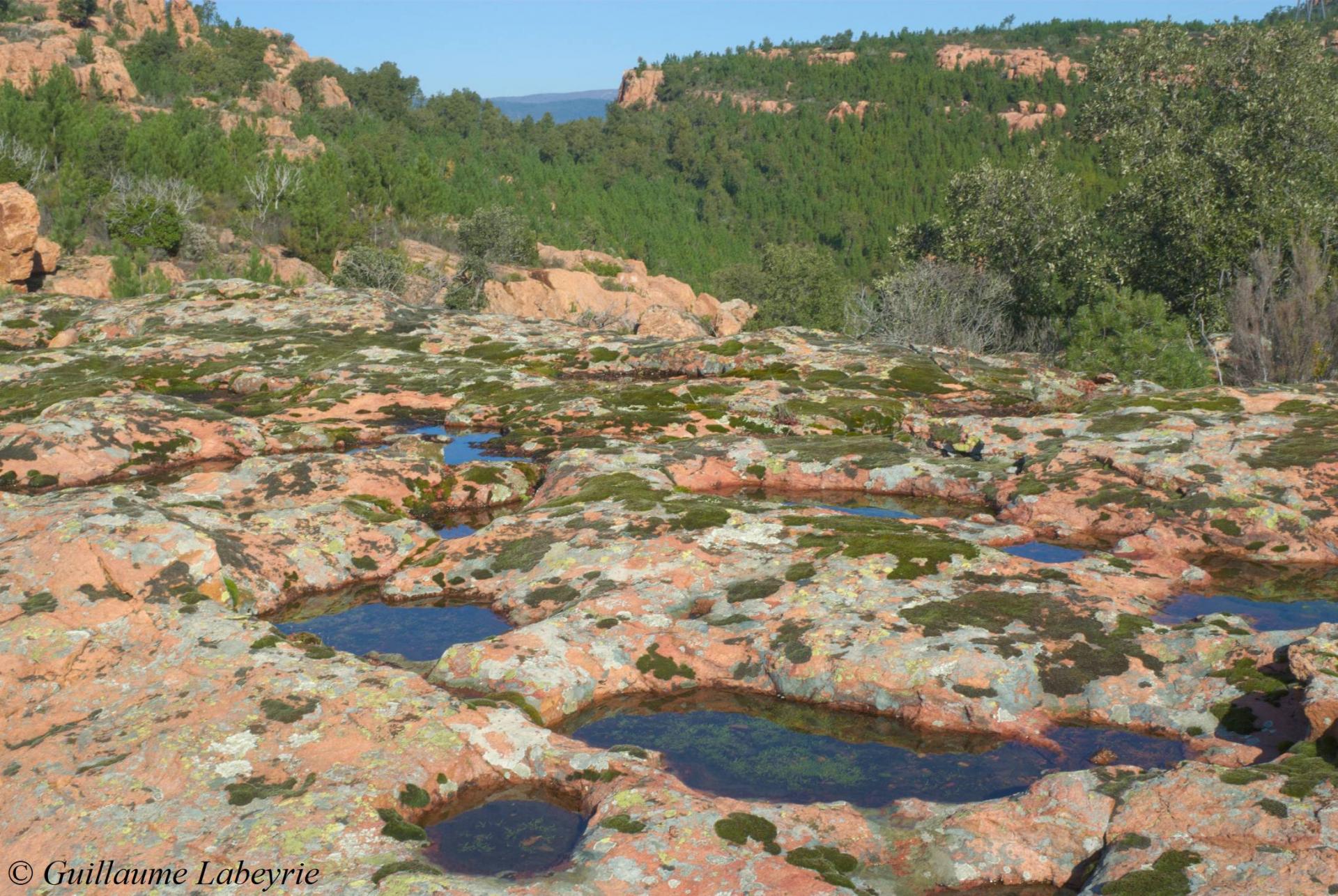 Temporary ponds (massif du Rouet). These temporary ponds often shelter branchiopod crustaceans, as well as an original and protected flora including in particular the narrow-leaved mossy stonecrop (Crassula vaillantii), the quillwort Isoetes duriaei, et the least adder's tongue (Ophioglossum lusitanicum).
Temporary ponds (massif du Rouet). These temporary ponds often shelter branchiopod crustaceans, as well as an original and protected flora including in particular the narrow-leaved mossy stonecrop (Crassula vaillantii), the quillwort Isoetes duriaei, et the least adder's tongue (Ophioglossum lusitanicum).
Flora
The species represented here are grouped by families, listed in alphabetical order. The definition of the families follow the phylogenetic classification APG IV (2016).
Family : Amaryllidaceae
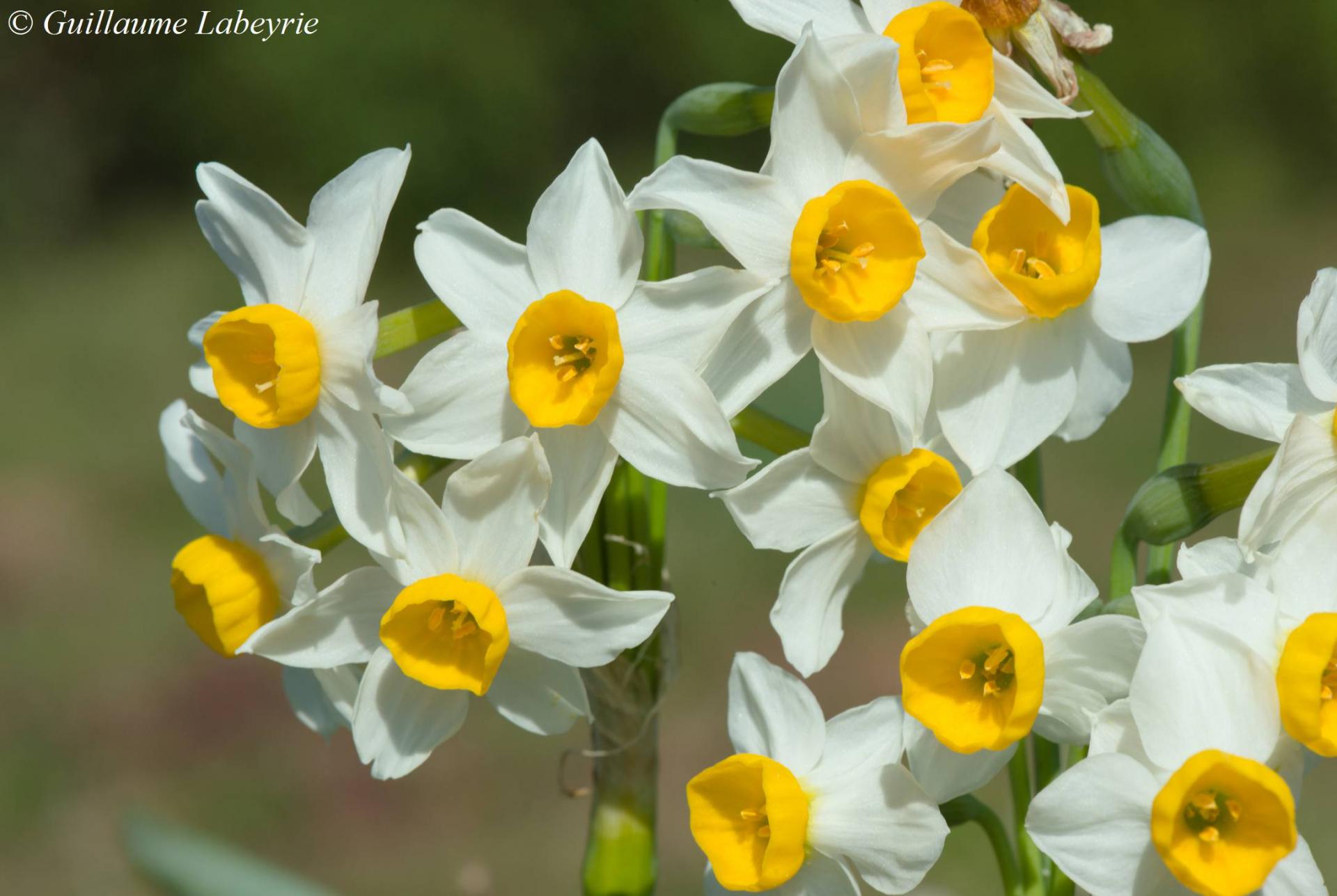 The bunch-flowered daffodil (Narcissus tazetta). This pretty daffodil cannot be mistaken. It is usually found in wet meadows and olive groves. This species is experiencing a considerable decline on the Côte d'Azur due to urbanisation. Distributed around the Mediterranean, it is present in France in Aquitaine, in the South and in Corsica. It is protected in the Alpes-Maritimes.
The bunch-flowered daffodil (Narcissus tazetta). This pretty daffodil cannot be mistaken. It is usually found in wet meadows and olive groves. This species is experiencing a considerable decline on the Côte d'Azur due to urbanisation. Distributed around the Mediterranean, it is present in France in Aquitaine, in the South and in Corsica. It is protected in the Alpes-Maritimes.
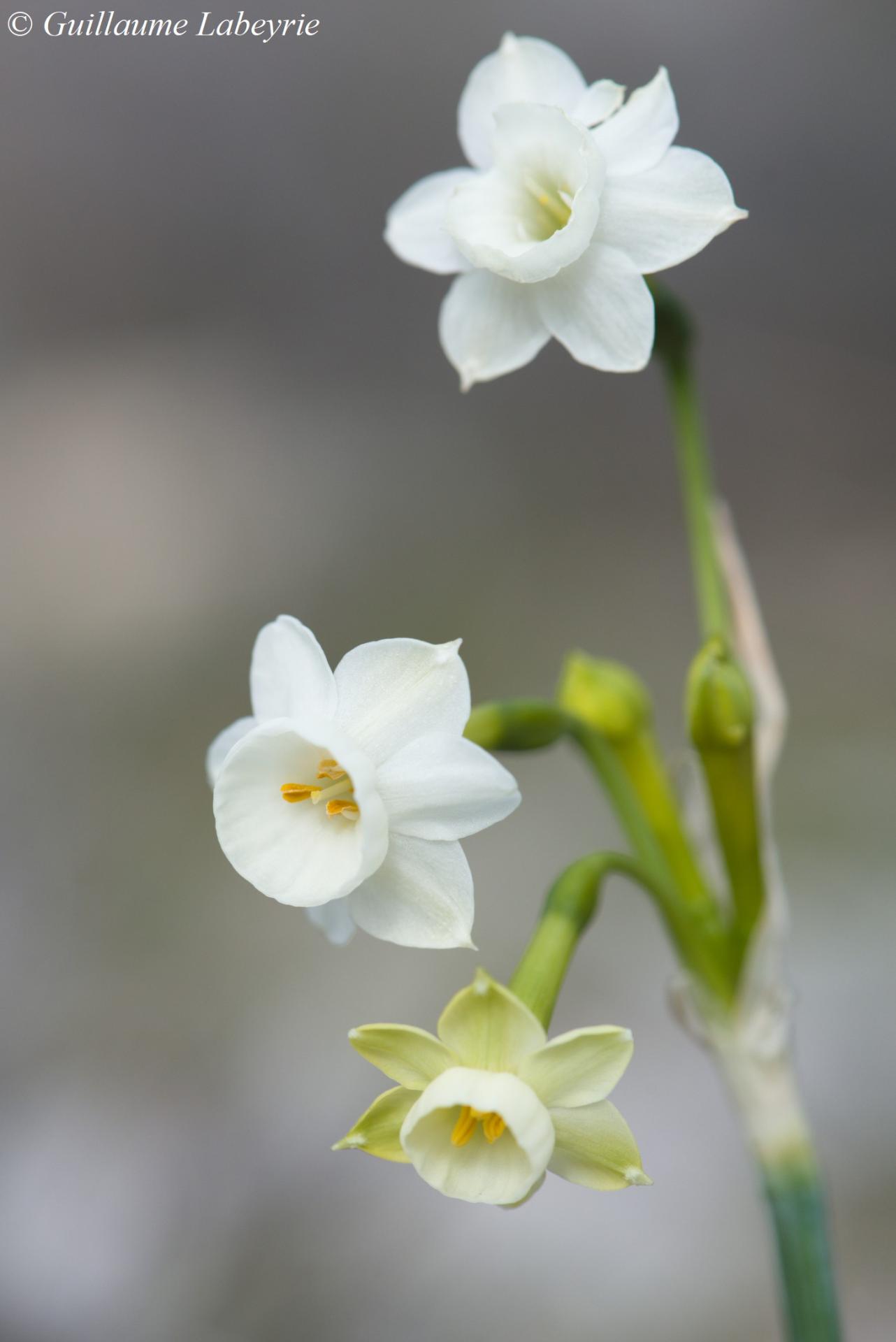 Narcissus dubius. This daffodil is similar in shape to Narcissus tazetta, but its flowers are white. It also grows in much drier environments. In the PACA region, it occurs in the western part of the coast up to Toulon. This species in restricted to France and Spain.
Narcissus dubius. This daffodil is similar in shape to Narcissus tazetta, but its flowers are white. It also grows in much drier environments. In the PACA region, it occurs in the western part of the coast up to Toulon. This species in restricted to France and Spain.
Family : Araceae
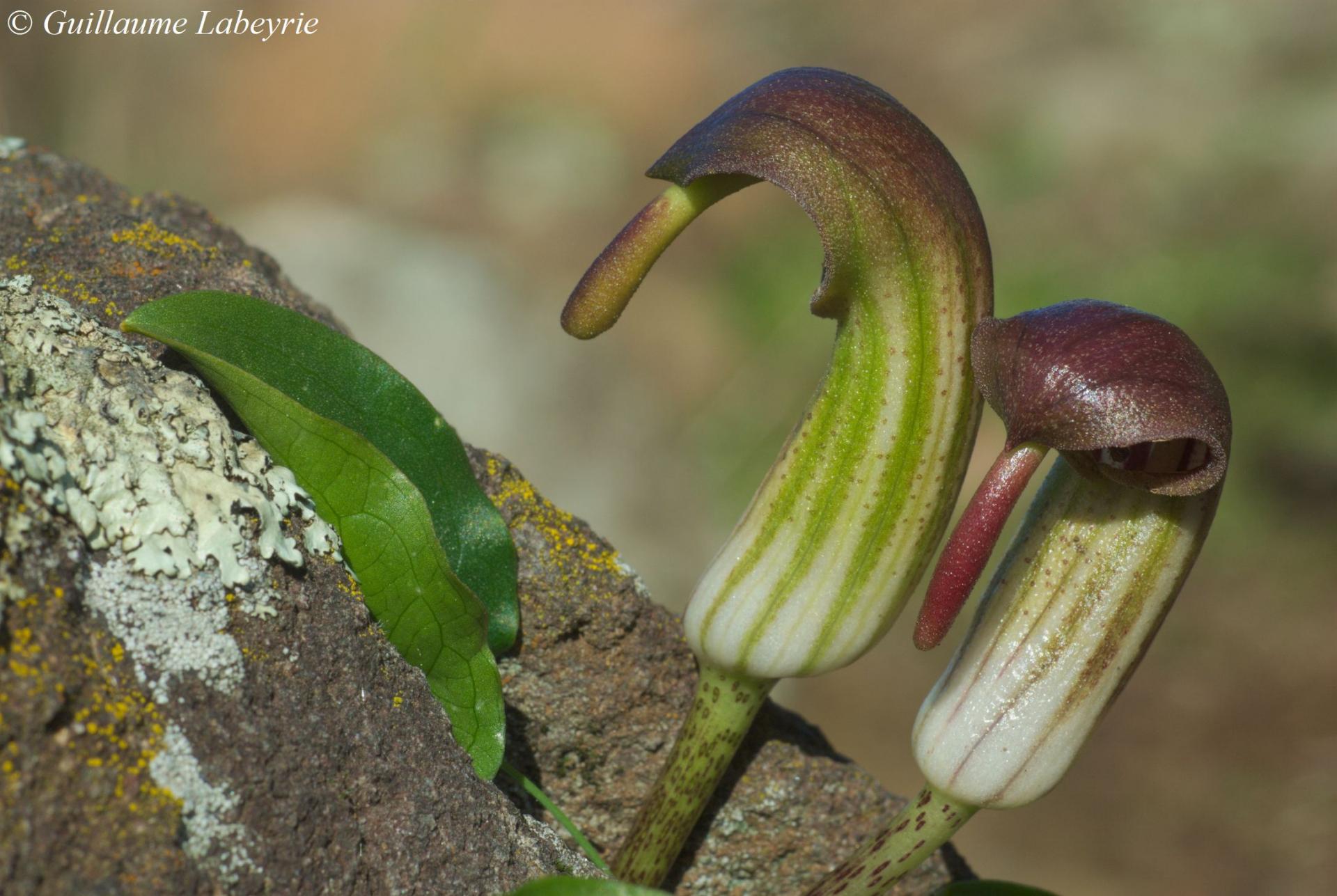 The friar's cowl (Arisarum vulgare). This strange-looking plant is found mostly in moist places, often on siliceous ground. It is native to the Mediterranean area. In France, it is found only in the south-east.
The friar's cowl (Arisarum vulgare). This strange-looking plant is found mostly in moist places, often on siliceous ground. It is native to the Mediterranean area. In France, it is found only in the south-east.
Family : Aristolochiaceae
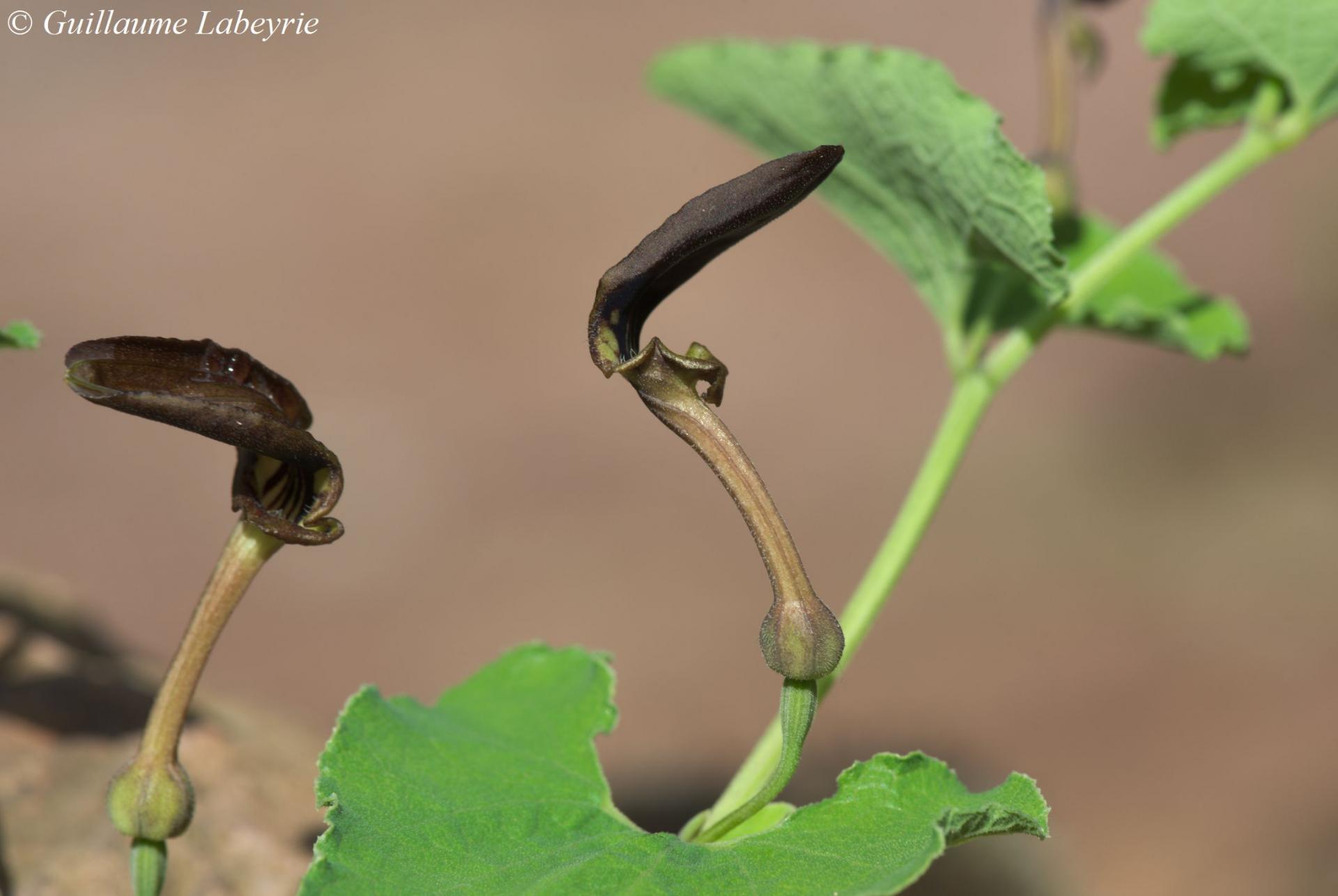 Birthwort (Aristolochia pistolochia). The plants belonging to the genus Aristolochia exhibit strange horn-shaped flowers. Aristolochia pistolochia forms small bushes in dry rocky places and scree. It has dark flowers and wavy-edged leaves. It is the host plant of the Spanish festoon (Zerynthia rumina), a magnificent and scarce Southern butterfly. This species has a distribution area covering France, Spain, Portugal and Morocco. In France, it is present on the Mediterranean facade.
Birthwort (Aristolochia pistolochia). The plants belonging to the genus Aristolochia exhibit strange horn-shaped flowers. Aristolochia pistolochia forms small bushes in dry rocky places and scree. It has dark flowers and wavy-edged leaves. It is the host plant of the Spanish festoon (Zerynthia rumina), a magnificent and scarce Southern butterfly. This species has a distribution area covering France, Spain, Portugal and Morocco. In France, it is present on the Mediterranean facade.
Family : Asteraceae
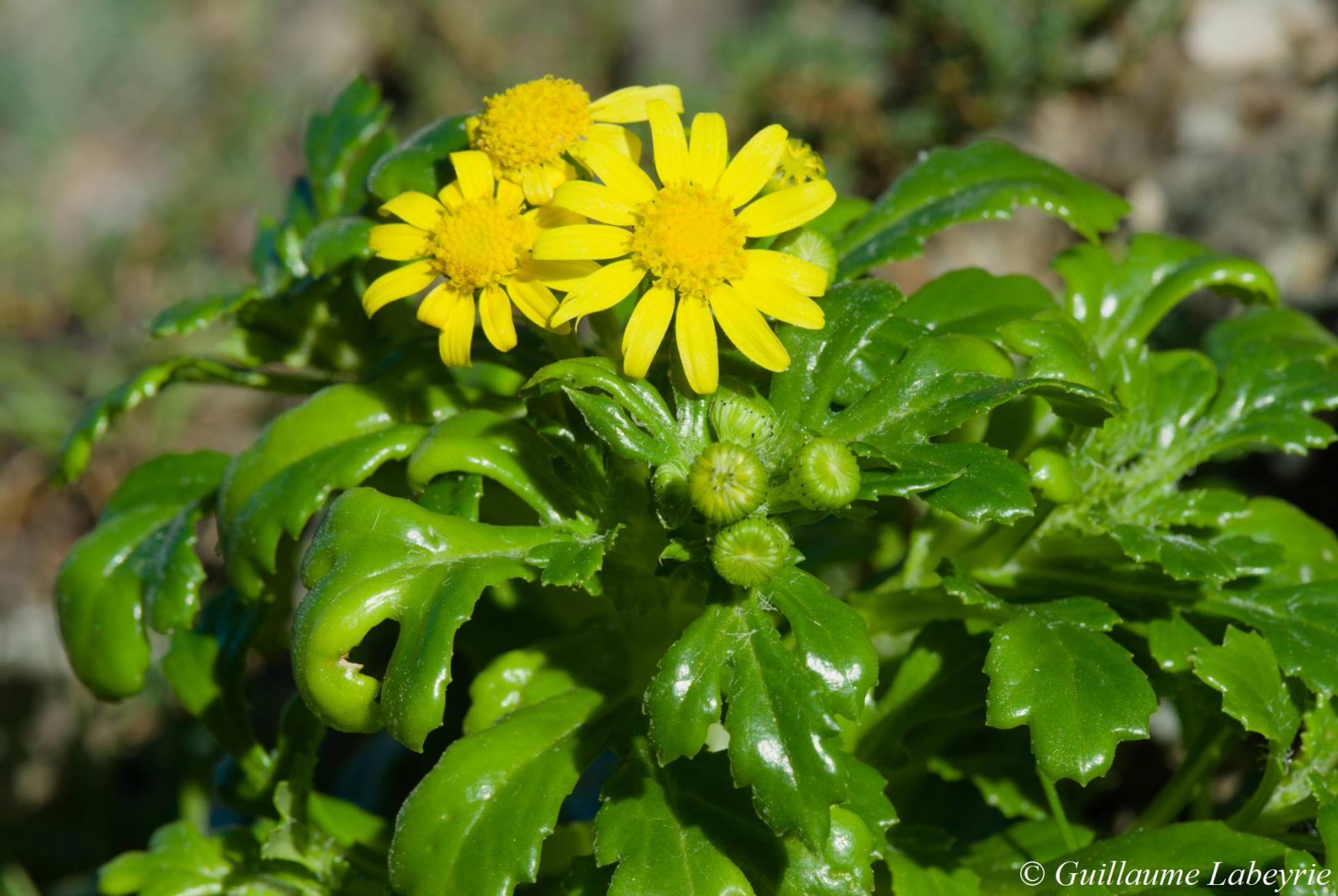 The coastal ragwort (Senecio leucanthemifolius). This ragwort has very characteristic succulent leaves. It colonizes maritime rocky areas. Flowering occurs in spring, starting from February. Of circummediterranean distribution, this species is present in France only on the coast of Bouches-du-Rhône and Var. It is protected in the PACA region.
The coastal ragwort (Senecio leucanthemifolius). This ragwort has very characteristic succulent leaves. It colonizes maritime rocky areas. Flowering occurs in spring, starting from February. Of circummediterranean distribution, this species is present in France only on the coast of Bouches-du-Rhône and Var. It is protected in the PACA region.
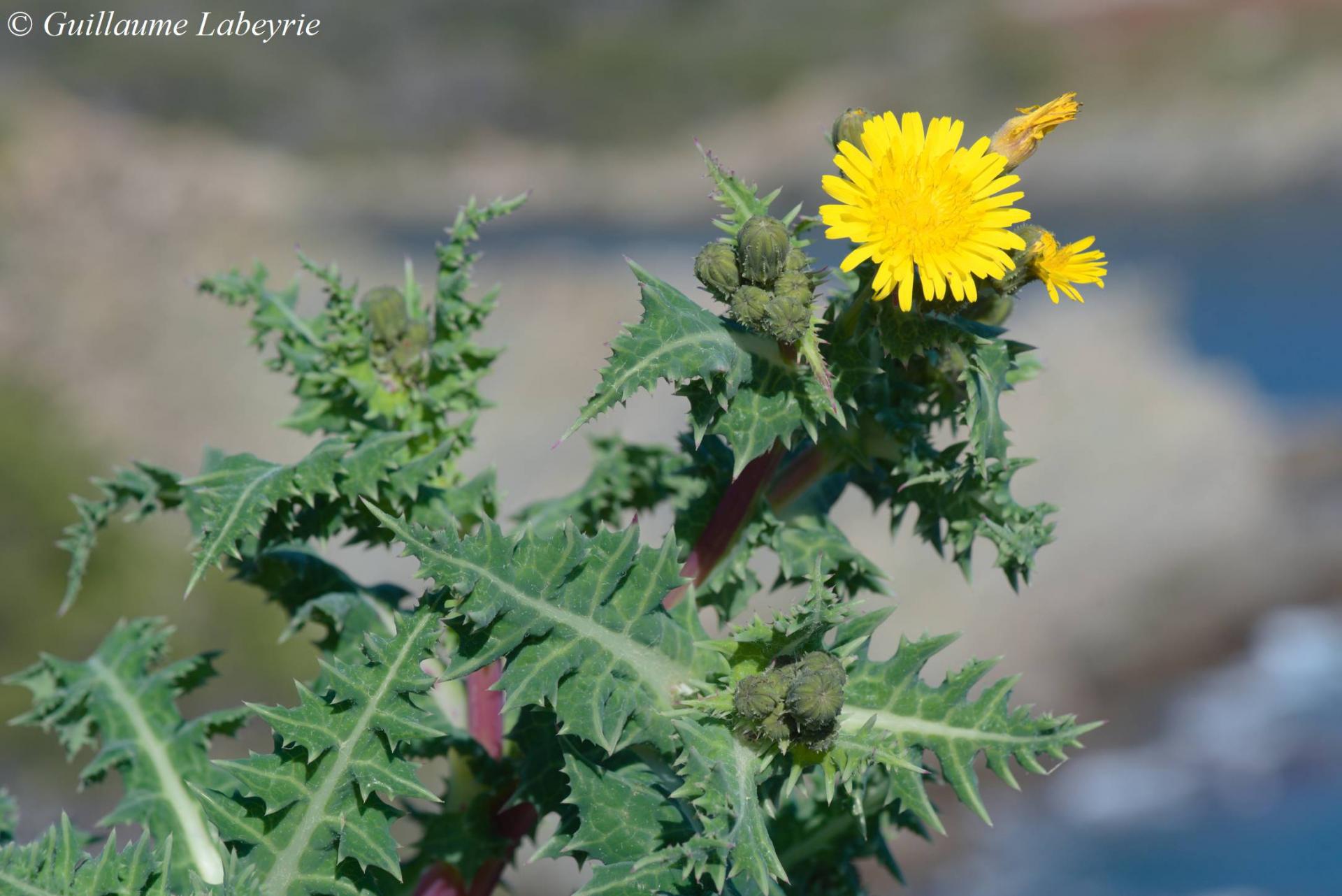 The spiny sowthistle (Sonchus asper subsp. glaucescens). This plant is characterised by very spiny glaucous blue-green leaves. It grows in coastal cliffs and other rocky areas. It has a wide worldwide distribution centered on the Mediterranean. In France, it is only observed on the coast of the South-East and Corsica.
The spiny sowthistle (Sonchus asper subsp. glaucescens). This plant is characterised by very spiny glaucous blue-green leaves. It grows in coastal cliffs and other rocky areas. It has a wide worldwide distribution centered on the Mediterranean. In France, it is only observed on the coast of the South-East and Corsica.
Family : Boraginaceae
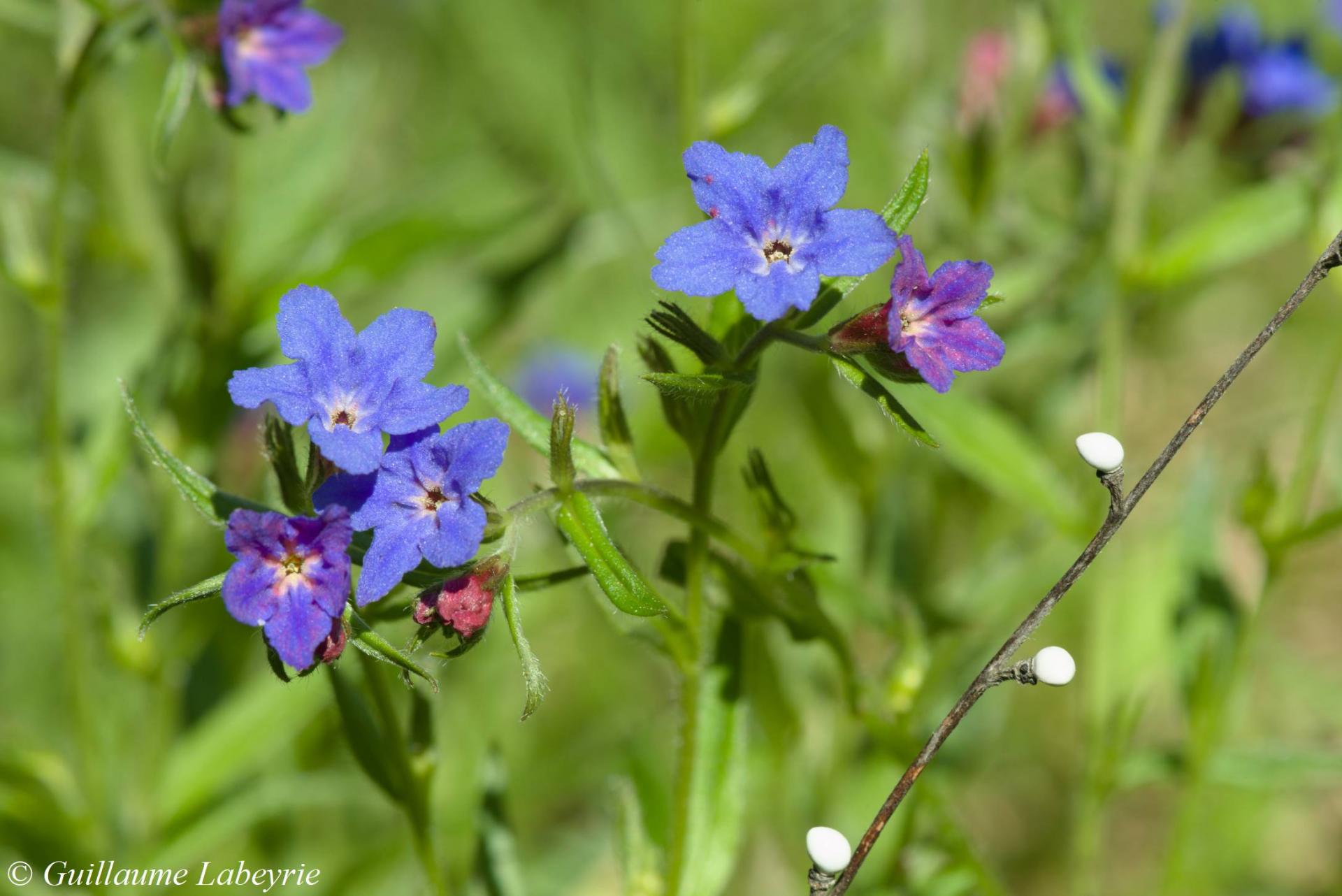 The purple gromwell (Aegonychon purpurocaeruleum). This pretty plant has first purple then blue flowers. The seeds, white and very hard, look like ceramic balls. This species appreciates light woods and edges of streams. It has a wide distribution across Central Europe, as far as the Caucasus and Iran. In France, it is found in a large part of the territory. It is protected in the Ile-de-France and Picardie regions.
The purple gromwell (Aegonychon purpurocaeruleum). This pretty plant has first purple then blue flowers. The seeds, white and very hard, look like ceramic balls. This species appreciates light woods and edges of streams. It has a wide distribution across Central Europe, as far as the Caucasus and Iran. In France, it is found in a large part of the territory. It is protected in the Ile-de-France and Picardie regions.
Family : Brassicaceae
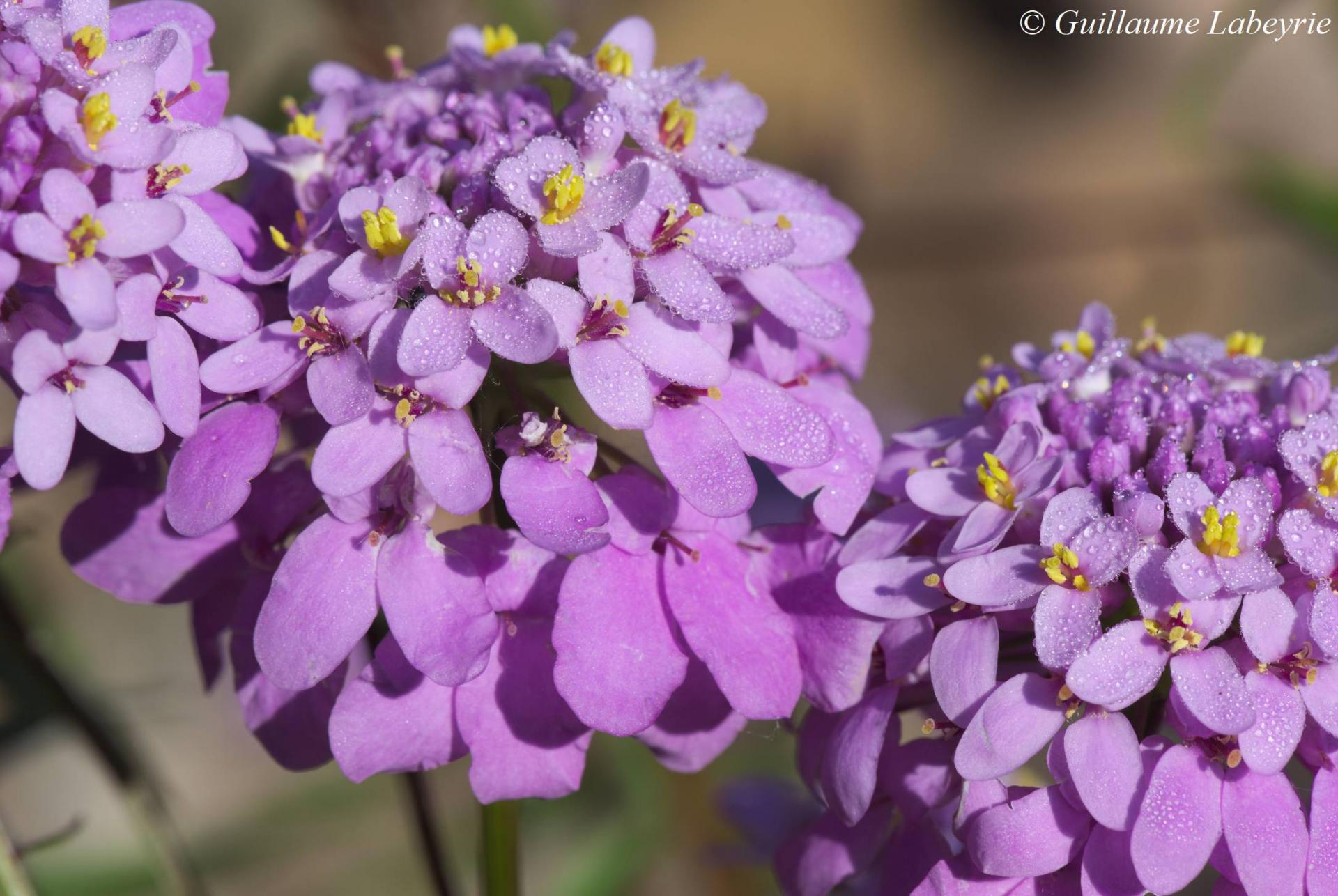 The umbellate candytuft (Iberis umbellata). This beautiful Iberis is rather tall (up to 1 m), bearing large umbels of bright pink flowers. As in all species of the genus, the flowers are asymmetrical with two petals larger than the others. This disproportion is more marked in the external flowers. This uncommon Mediterranean plant is found especially on the banks of streams. It is restricted to France, Italy and the Balkans up to Albania. In France, it seems to be distributed throughout the whole territory except in the North.
The umbellate candytuft (Iberis umbellata). This beautiful Iberis is rather tall (up to 1 m), bearing large umbels of bright pink flowers. As in all species of the genus, the flowers are asymmetrical with two petals larger than the others. This disproportion is more marked in the external flowers. This uncommon Mediterranean plant is found especially on the banks of streams. It is restricted to France, Italy and the Balkans up to Albania. In France, it seems to be distributed throughout the whole territory except in the North.
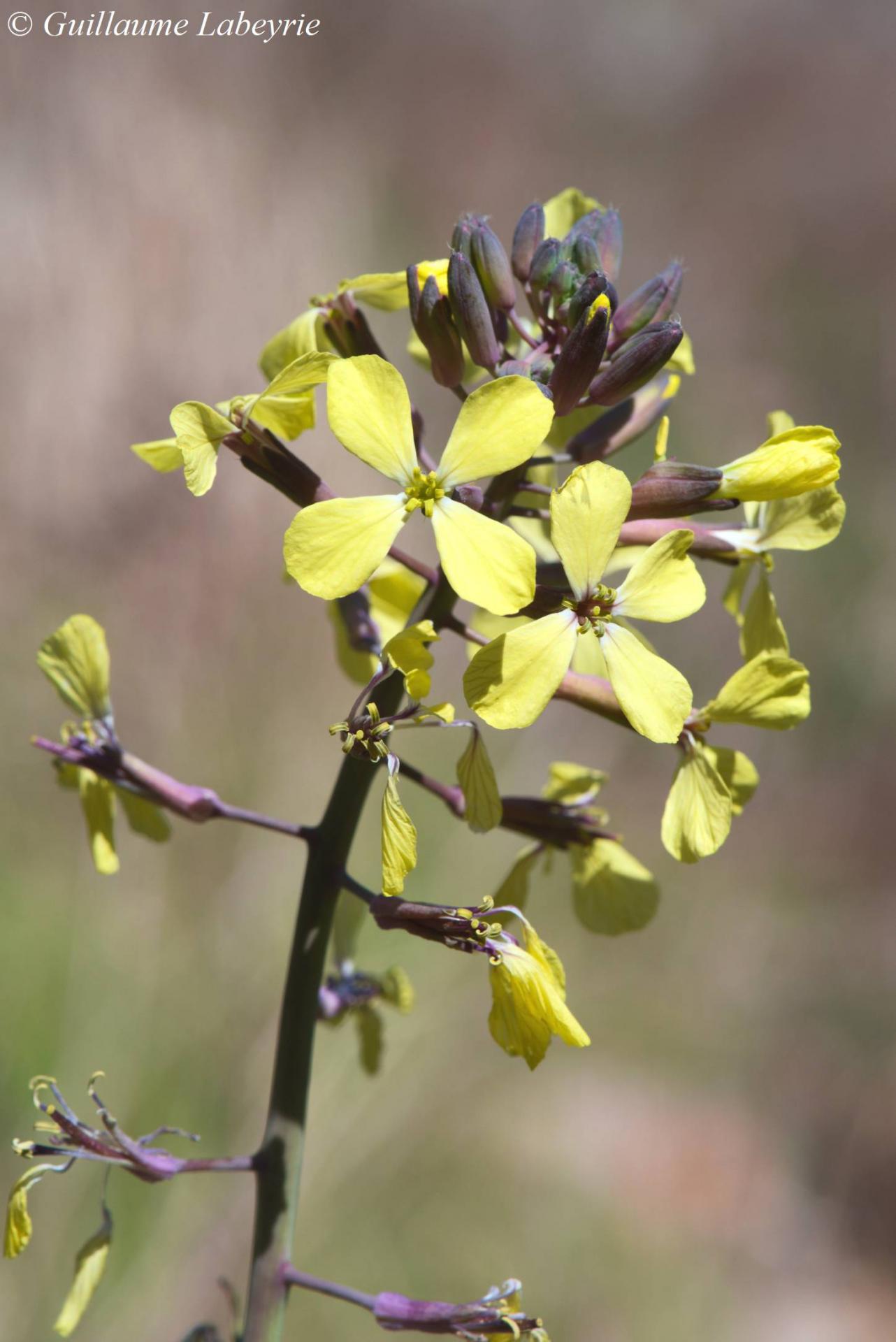 The wallflower cabbage (Coincya monensis subsp. cheiranthos). This tall wallflower has divided, glaucous leaves and pale yellow flowers that contrast with the purple of the calyx. It is found especially in dry siliceous scree. This species is present in Western Europe, from Germany to Spain, as well as in Morocco. It is found throughout France.
The wallflower cabbage (Coincya monensis subsp. cheiranthos). This tall wallflower has divided, glaucous leaves and pale yellow flowers that contrast with the purple of the calyx. It is found especially in dry siliceous scree. This species is present in Western Europe, from Germany to Spain, as well as in Morocco. It is found throughout France.
Family : Campanulaceae
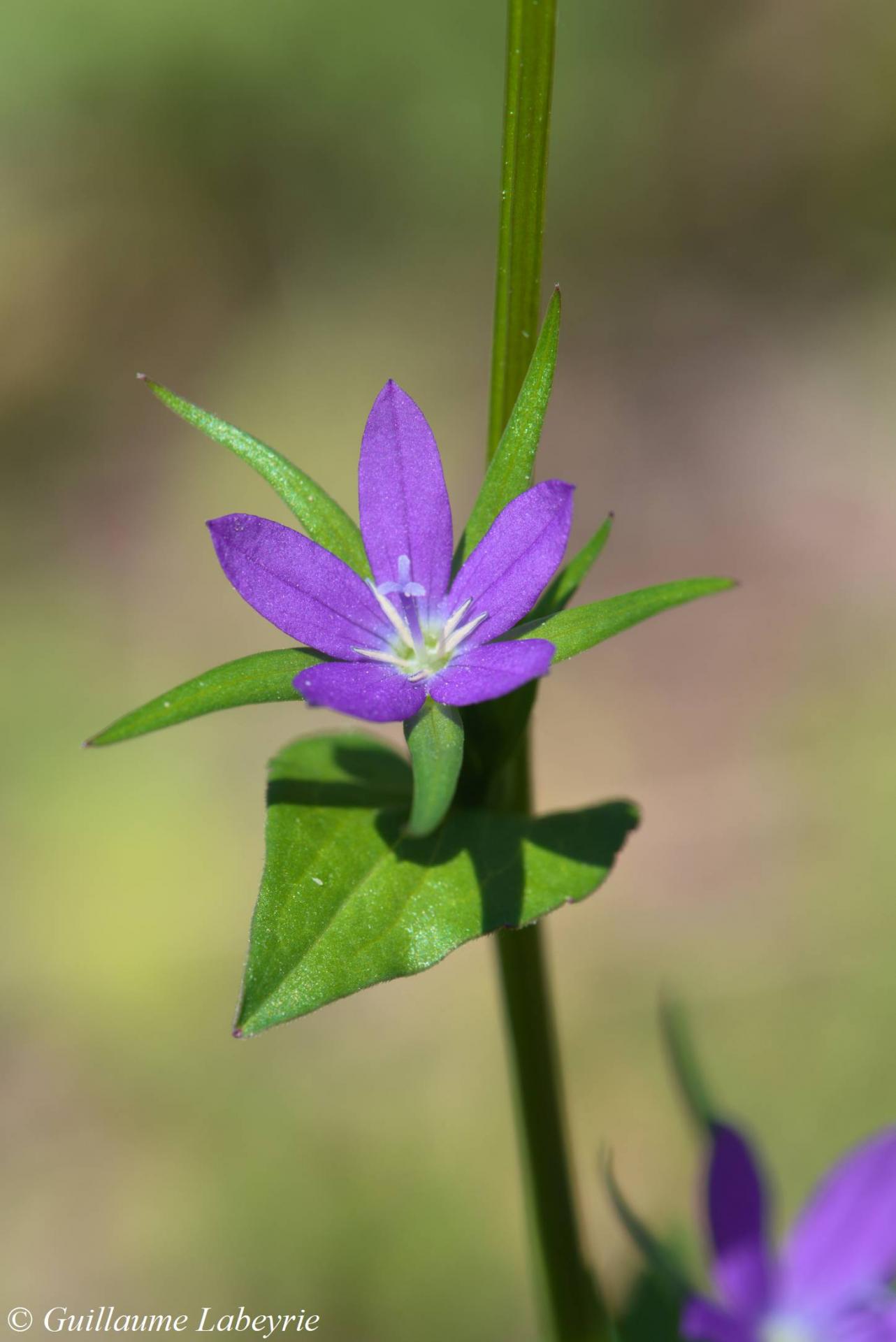 The Syrian Venus's looking-glass (Legousia falcata). This pretty plant is distinguished by very elongated calyx lobes. It grows in dry meadows, but does not disdain crops ... without pesticides ! Of circum-Mediterranean distribution, this species is found in France, especially in the south-east and in Corsica.
The Syrian Venus's looking-glass (Legousia falcata). This pretty plant is distinguished by very elongated calyx lobes. It grows in dry meadows, but does not disdain crops ... without pesticides ! Of circum-Mediterranean distribution, this species is found in France, especially in the south-east and in Corsica.
Family : Caryophyllaceae
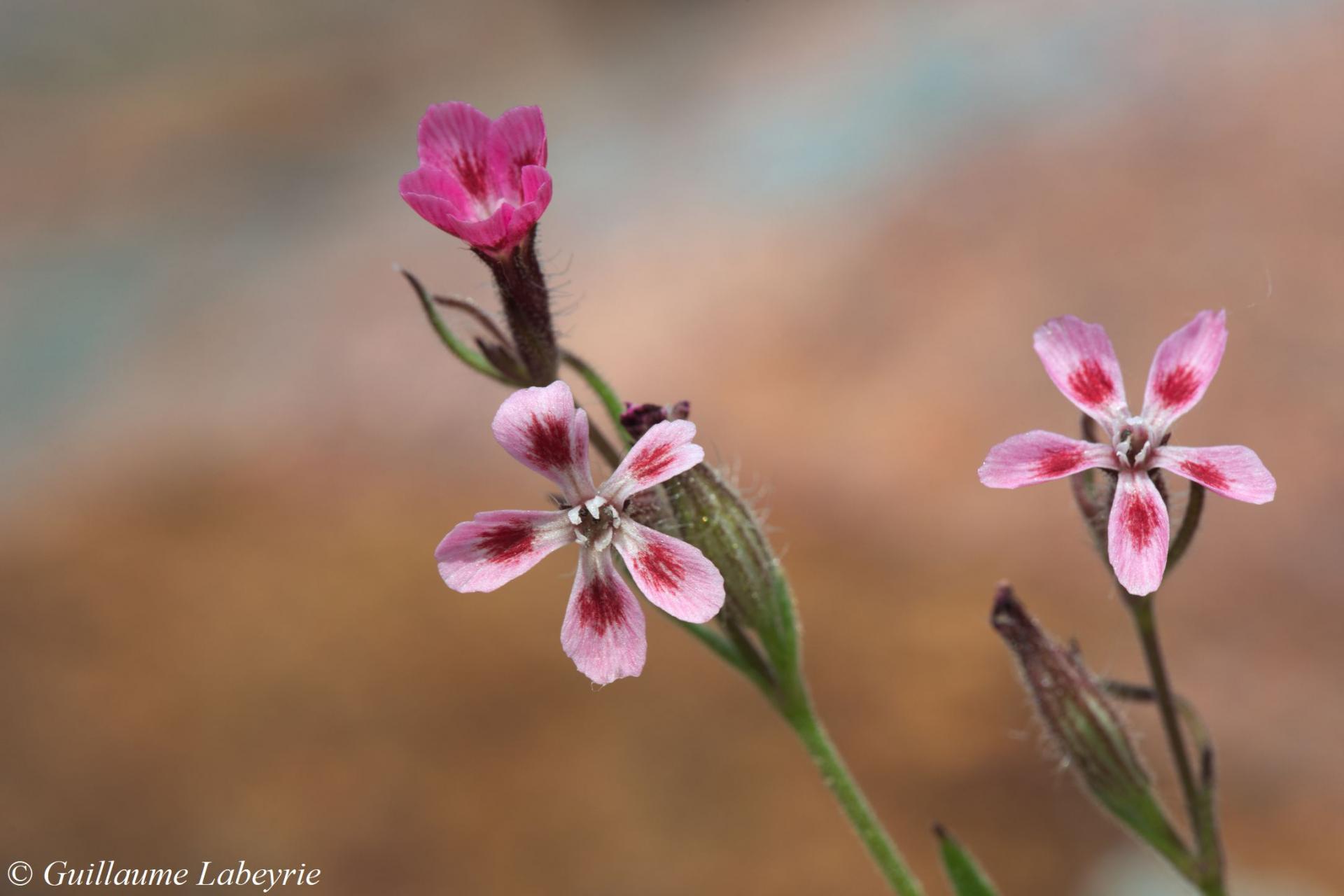 The five-wound catchfly (Silene gallica). This pretty little catchfly appreciates dry and sandy places, in siliceous soil. The plant is small, erect, with linear leaves. The coloring of the flowers is quite variable. It is found around the Mediterranean and in a large part of France.
The five-wound catchfly (Silene gallica). This pretty little catchfly appreciates dry and sandy places, in siliceous soil. The plant is small, erect, with linear leaves. The coloring of the flowers is quite variable. It is found around the Mediterranean and in a large part of France.
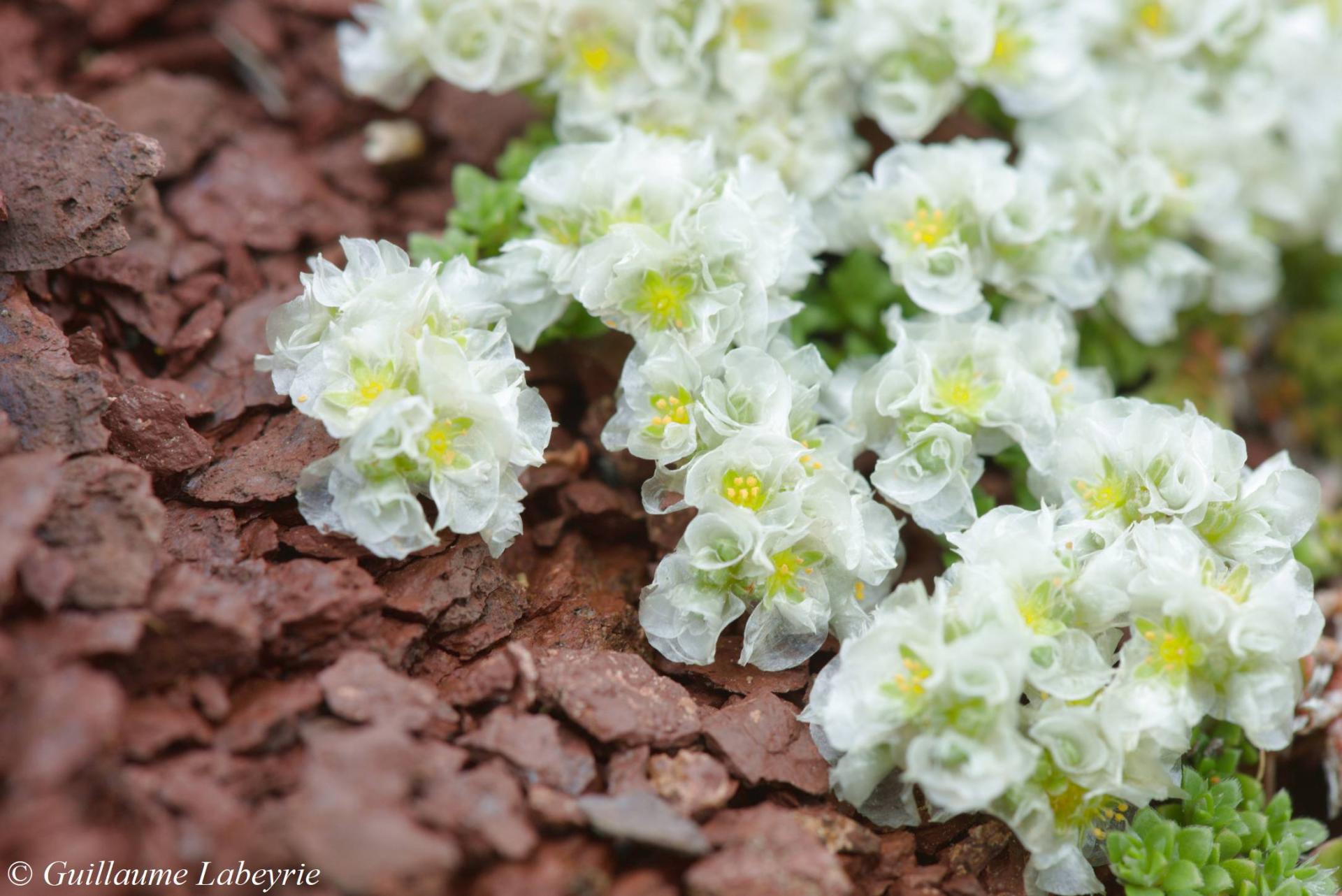 Paronychia kapela subsp. serpyllifolia. This small plant grows prostrate on soils devoid of vegetation. The translucent ''petals'' of the flowers are actually the bracts of the calyx. Distributed around the Mediterranean, this species is found in France in the Pyrenees and the Alps.
Paronychia kapela subsp. serpyllifolia. This small plant grows prostrate on soils devoid of vegetation. The translucent ''petals'' of the flowers are actually the bracts of the calyx. Distributed around the Mediterranean, this species is found in France in the Pyrenees and the Alps.
Family : Cistaceae
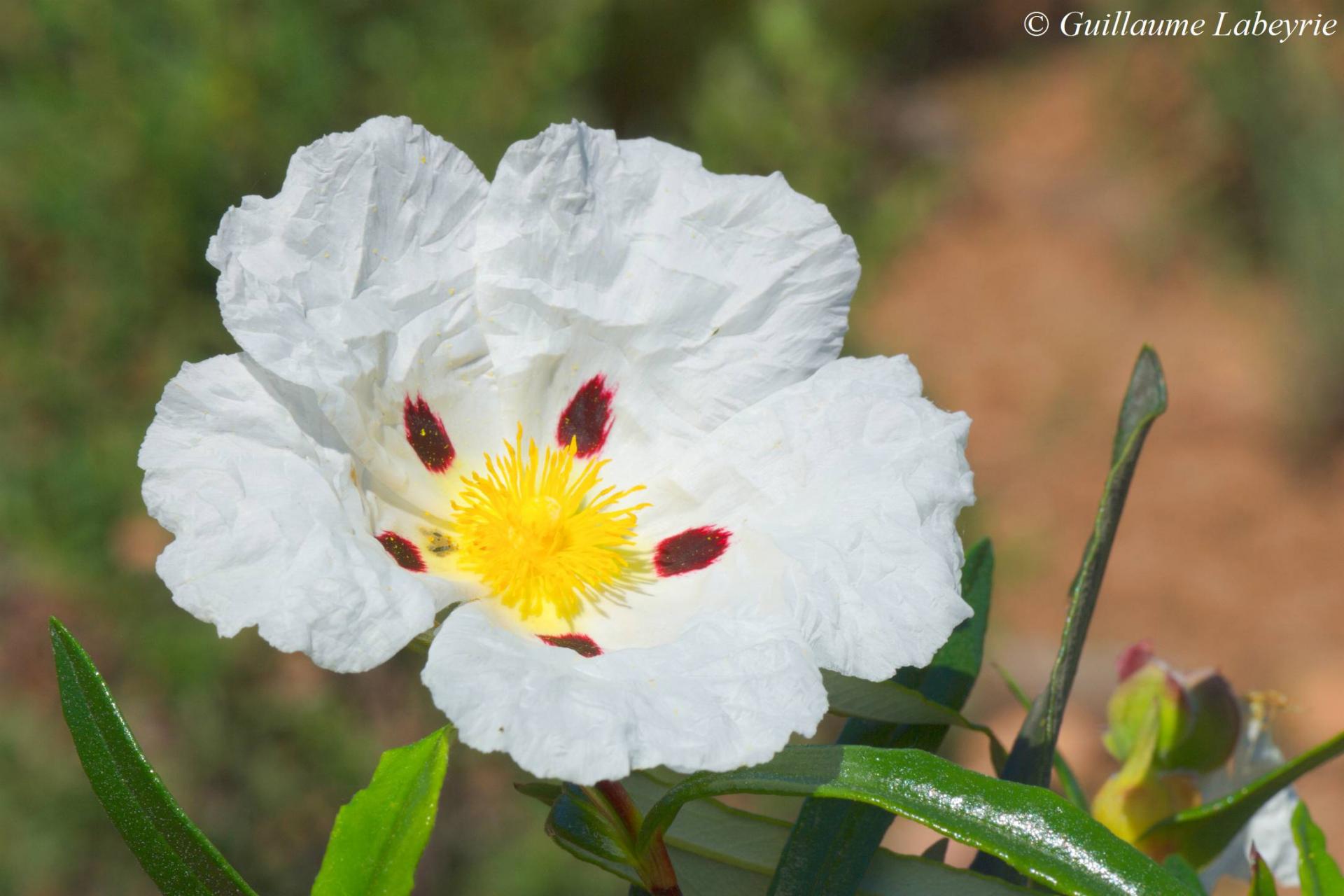 The gum rockrose (Cistus ladanifer). This striking species is found in France only in a few spots along the Mediterranean coast. Its has distinctive large flowers, either completely white of with purple spots, and narrow leaves that are extremely sticky. The gum from this plant has been exploited in perfumery under the name of ladanum. The gum rockrose occurs in Spain, Portugal, France, Sicily and Algeria.
The gum rockrose (Cistus ladanifer). This striking species is found in France only in a few spots along the Mediterranean coast. Its has distinctive large flowers, either completely white of with purple spots, and narrow leaves that are extremely sticky. The gum from this plant has been exploited in perfumery under the name of ladanum. The gum rockrose occurs in Spain, Portugal, France, Sicily and Algeria.
Famille : Crassulaceae
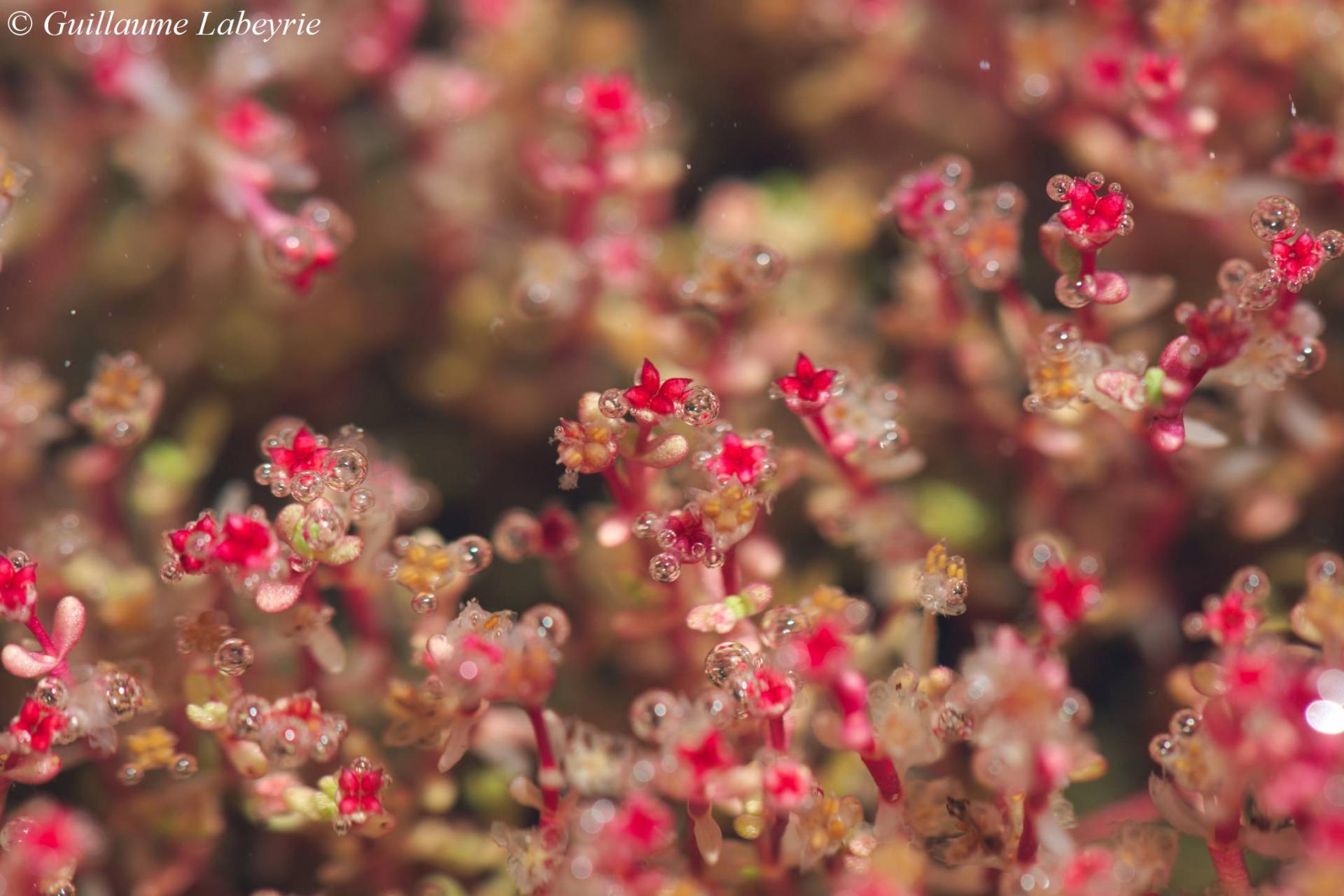 The narrow-leaved mossy stonecrop (Crassula vaillantii). This curious dwarf plant grows in temporarily flooded flats and cupular pools, in siliceous soil. It can flower underwater, as in this photo, showing four distinctive-looking red petals. Fairly widely distributed worldwide, this species is present here and there on the French territory. It appears on the national red list with the mention ''near-threatened'', and is protected in the PACA, Brittany, Ile-de-France, Center and Languedoc-Roussillon regions.
The narrow-leaved mossy stonecrop (Crassula vaillantii). This curious dwarf plant grows in temporarily flooded flats and cupular pools, in siliceous soil. It can flower underwater, as in this photo, showing four distinctive-looking red petals. Fairly widely distributed worldwide, this species is present here and there on the French territory. It appears on the national red list with the mention ''near-threatened'', and is protected in the PACA, Brittany, Ile-de-France, Center and Languedoc-Roussillon regions.
Family : Euphorbiaceae
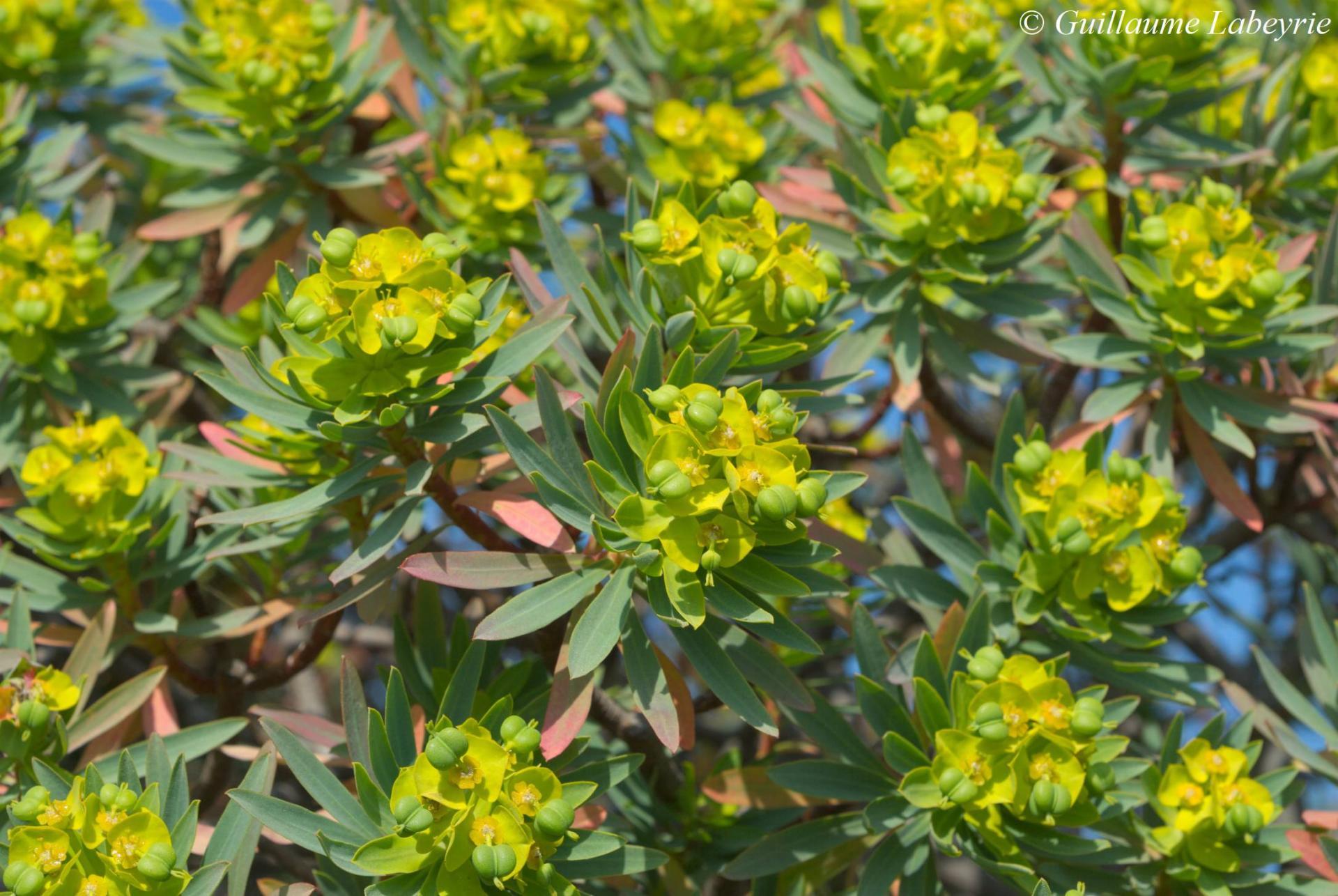 The tree spurge (Euphorbia dendroides). This large spurge forms bushes with a characteristic hemispherical shape, growing up to 2 m. It lives in the scrub and in cliffs, generally near the sea but sometimes further inland. This species is a western Mediterranean endemic. In France, it is found on the coast of Var, Alpes-Maritimes and Corsica.
The tree spurge (Euphorbia dendroides). This large spurge forms bushes with a characteristic hemispherical shape, growing up to 2 m. It lives in the scrub and in cliffs, generally near the sea but sometimes further inland. This species is a western Mediterranean endemic. In France, it is found on the coast of Var, Alpes-Maritimes and Corsica.
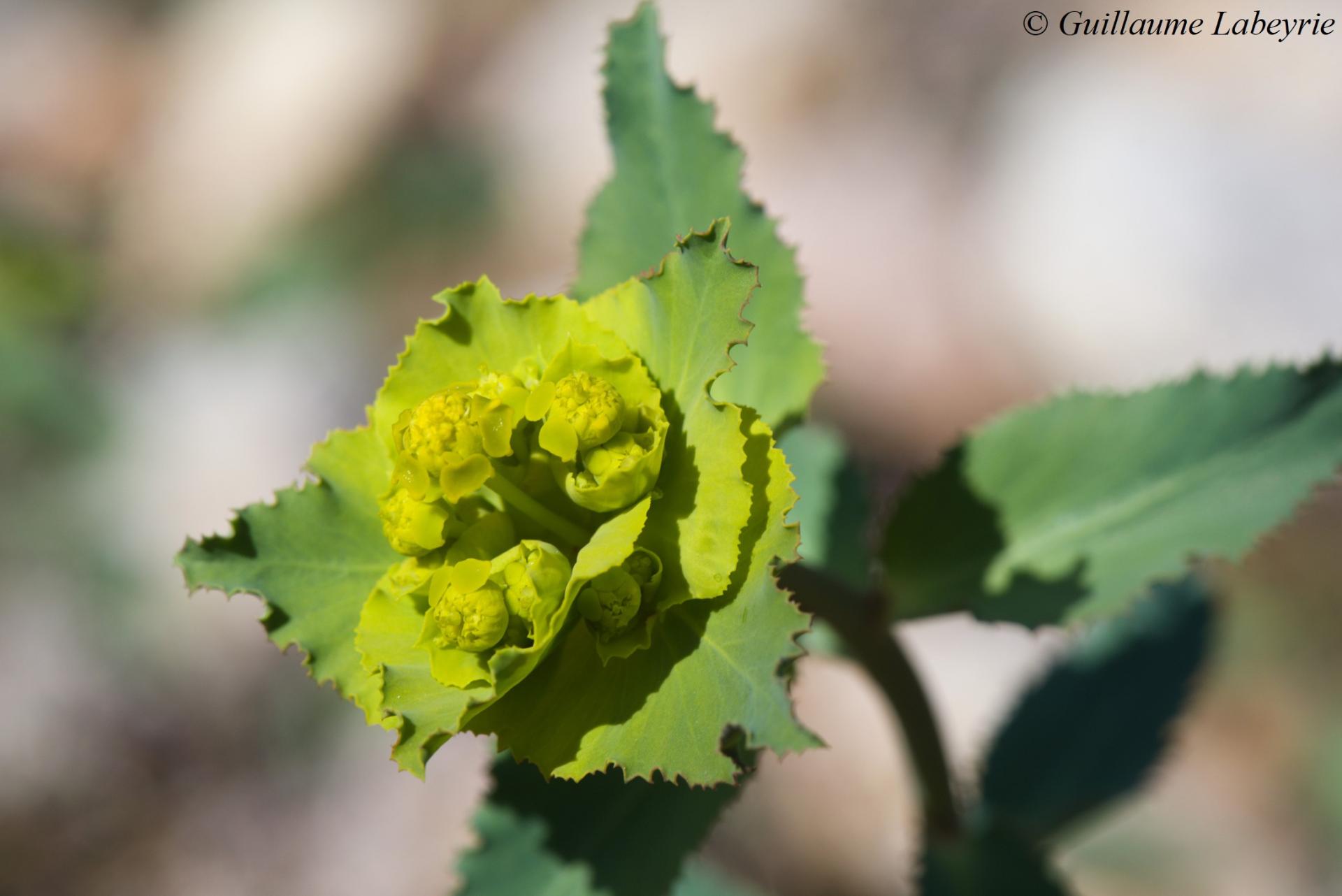
The sawtooth spurge (Euphorbia serrata). This spurge cannot be confused thanks to its very characteristic toothed leaves. It is found in dry places, mainly in Spain and the South of France.
Family : Fabaceae
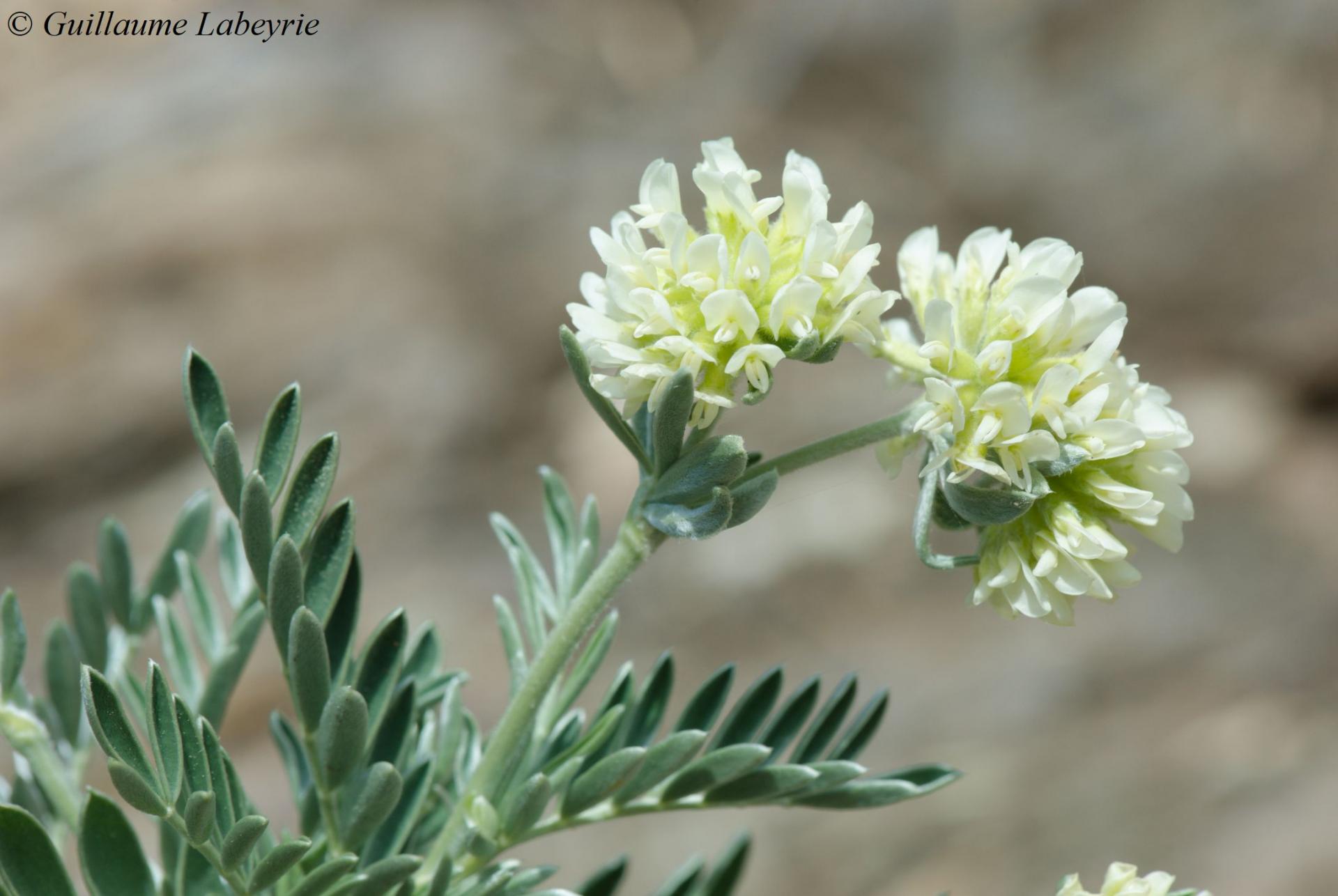 Jupiter's beard (Anthyllis barba-jovis). This splendid species forms large silvery bushes with white flowers, which adorn the edge of maritime cliffs. It is found in southern Europe from the Balkans to Spain, as well as in North Africa (Algeria and Tunisia). In France, where it is fully protected, it is restricted to the eastern part of the Mediterranean coast.
Jupiter's beard (Anthyllis barba-jovis). This splendid species forms large silvery bushes with white flowers, which adorn the edge of maritime cliffs. It is found in southern Europe from the Balkans to Spain, as well as in North Africa (Algeria and Tunisia). In France, where it is fully protected, it is restricted to the eastern part of the Mediterranean coast.
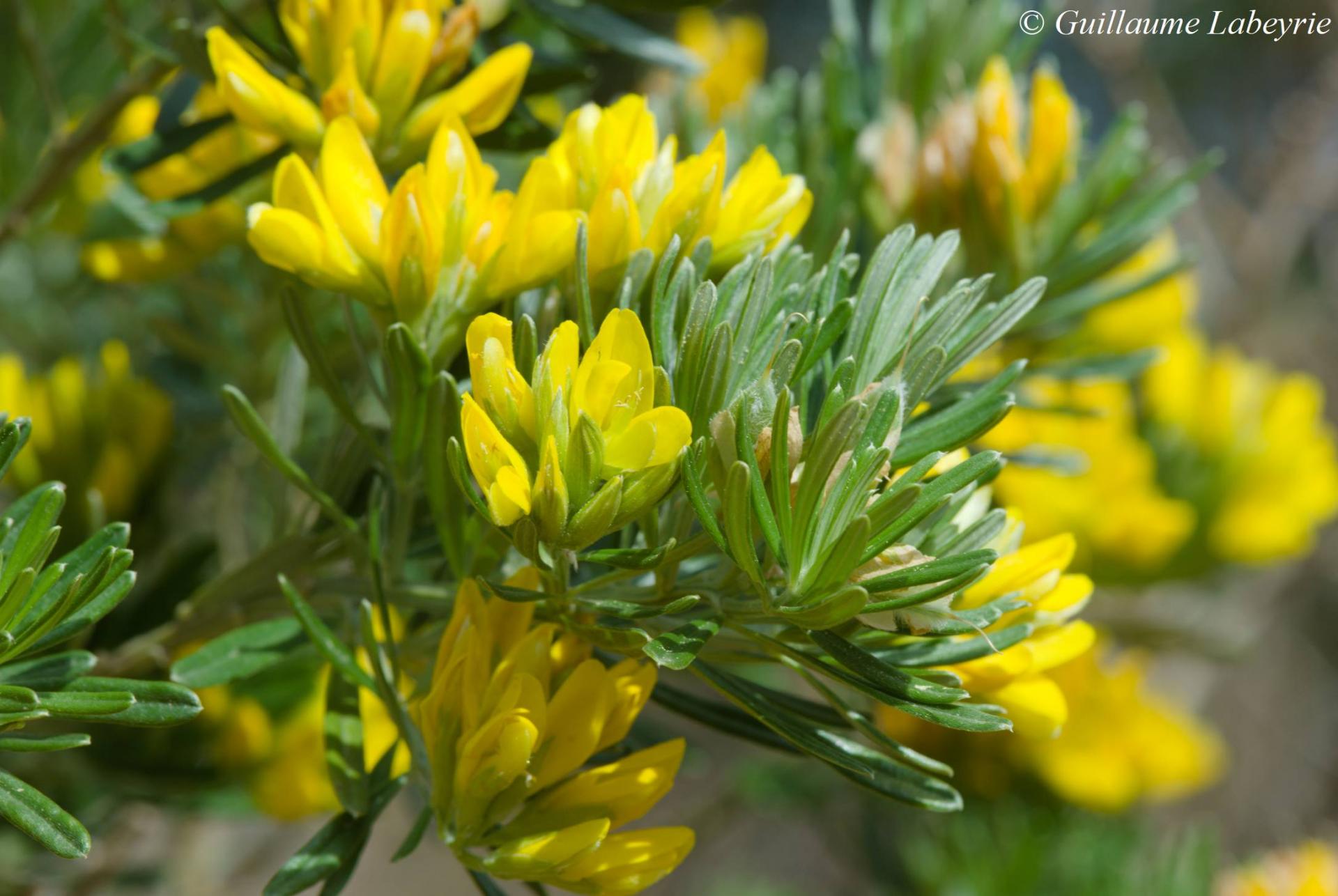 The flax-leaved broom (Genista linifolia). This magnificent broom grows in tall bushes with silvery leaves and yellow flowers. It is found in light woods and coastal rocks. It is present in France, Spain, Balearic Islands, Algeria and Morocco. Very rare in France, it is only found there in the Var around Hyères and in Corsica. It is present on the national red list with the mention ''vulnerable'', and is protected at the national level.
The flax-leaved broom (Genista linifolia). This magnificent broom grows in tall bushes with silvery leaves and yellow flowers. It is found in light woods and coastal rocks. It is present in France, Spain, Balearic Islands, Algeria and Morocco. Very rare in France, it is only found there in the Var around Hyères and in Corsica. It is present on the national red list with the mention ''vulnerable'', and is protected at the national level.
Family : Iridaceae
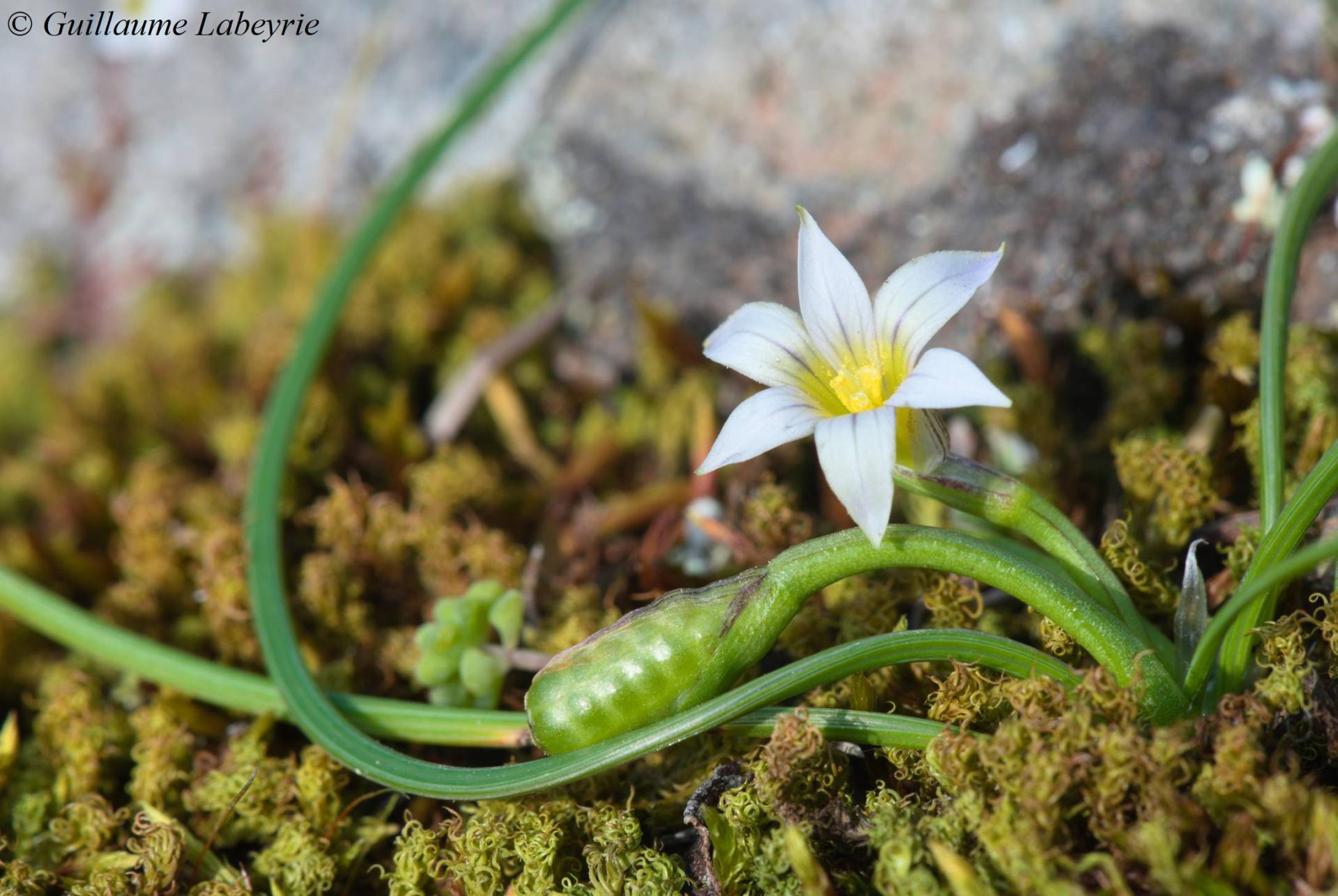 The sand crocus (Romulea columnae). This tiny plant belongs to the Iridacea family. It blooms in sandy areas, starting from February. In France, this species is found along the coast of the Channel, the Ocean and the Mediterranean. It is protected in the PACA region.
The sand crocus (Romulea columnae). This tiny plant belongs to the Iridacea family. It blooms in sandy areas, starting from February. In France, this species is found along the coast of the Channel, the Ocean and the Mediterranean. It is protected in the PACA region.
Family : Isoetaceae
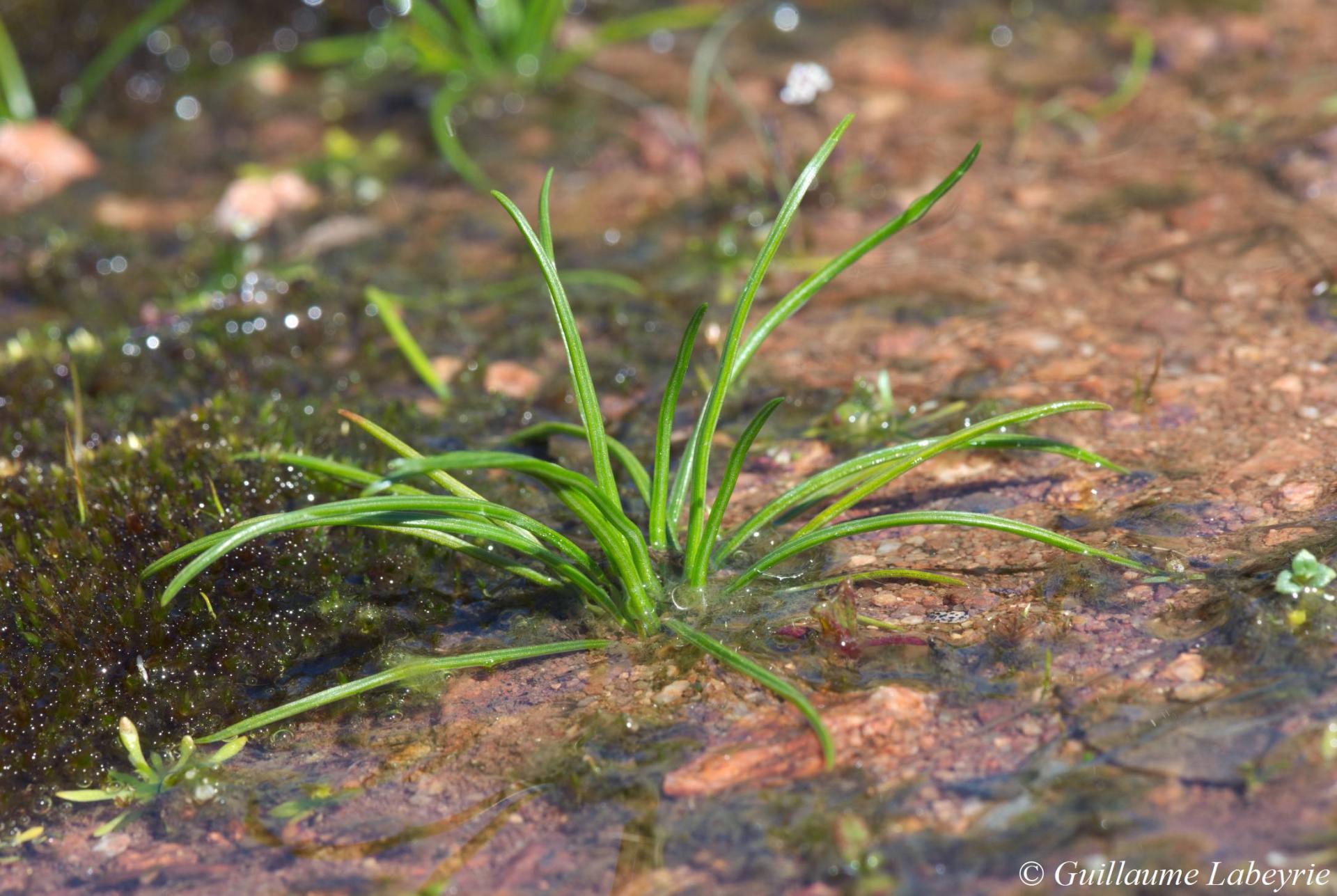 Isoetes durieui. Despite its appearance, this little plant belongs to the fern family. It occurs is sandy area that are temporarily flooded in spring. This species is found in Mediterranean Europe, Africa and Turkey. In France, it is restricted to the Mediterranean border and fully protected.
Isoetes durieui. Despite its appearance, this little plant belongs to the fern family. It occurs is sandy area that are temporarily flooded in spring. This species is found in Mediterranean Europe, Africa and Turkey. In France, it is restricted to the Mediterranean border and fully protected.
Family : Lythraceae
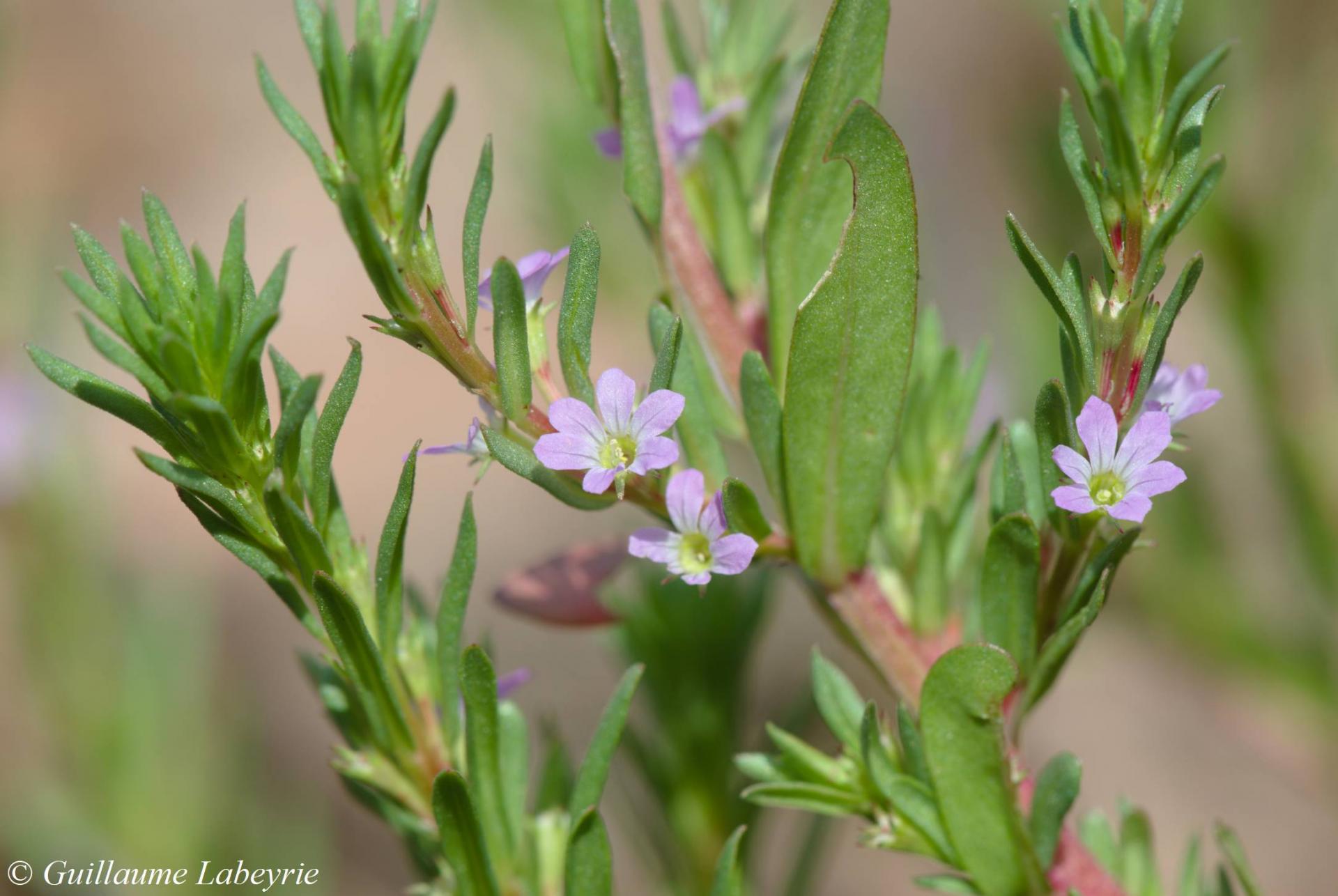 The hyssop loosestrife (Lythrum hyssopifolia). This plant with small pink flowers is found in damp sandy places. Its worldwide distribution is vast, as well as in France. It is protected in the Alsace and Rhône-Alpes regions.
The hyssop loosestrife (Lythrum hyssopifolia). This plant with small pink flowers is found in damp sandy places. Its worldwide distribution is vast, as well as in France. It is protected in the Alsace and Rhône-Alpes regions.
Family : Malvaceae
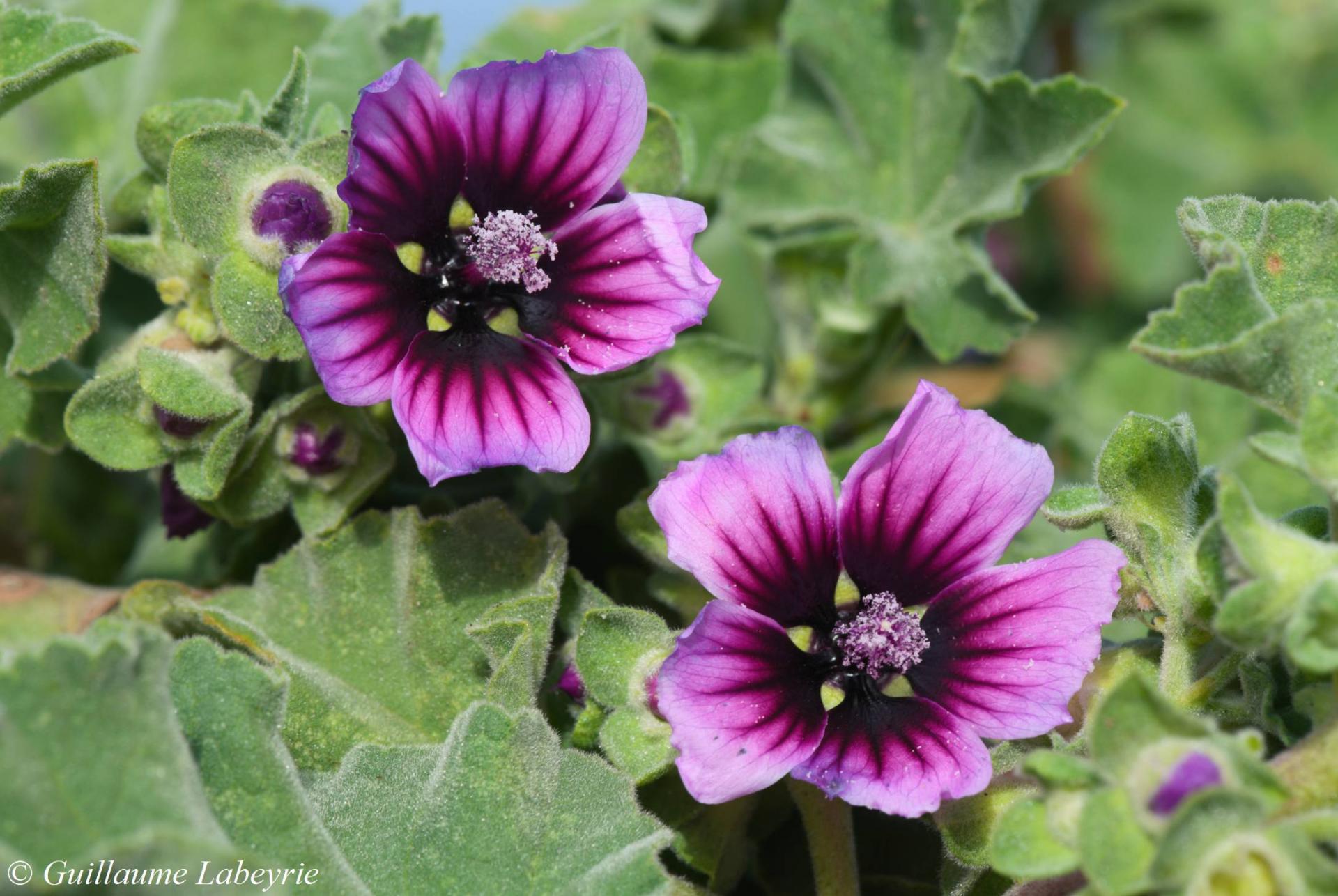 The tree mallow (Malva arborea). This beautiful plant can reach three meters in height. It grows on maritime rocks. Of circum-Mediterranean distribution, it is found in France mainly on the coasts of the Mediterranean, the Atlantic and the English Channel.
The tree mallow (Malva arborea). This beautiful plant can reach three meters in height. It grows on maritime rocks. Of circum-Mediterranean distribution, it is found in France mainly on the coasts of the Mediterranean, the Atlantic and the English Channel.
Family : Molluginaceae
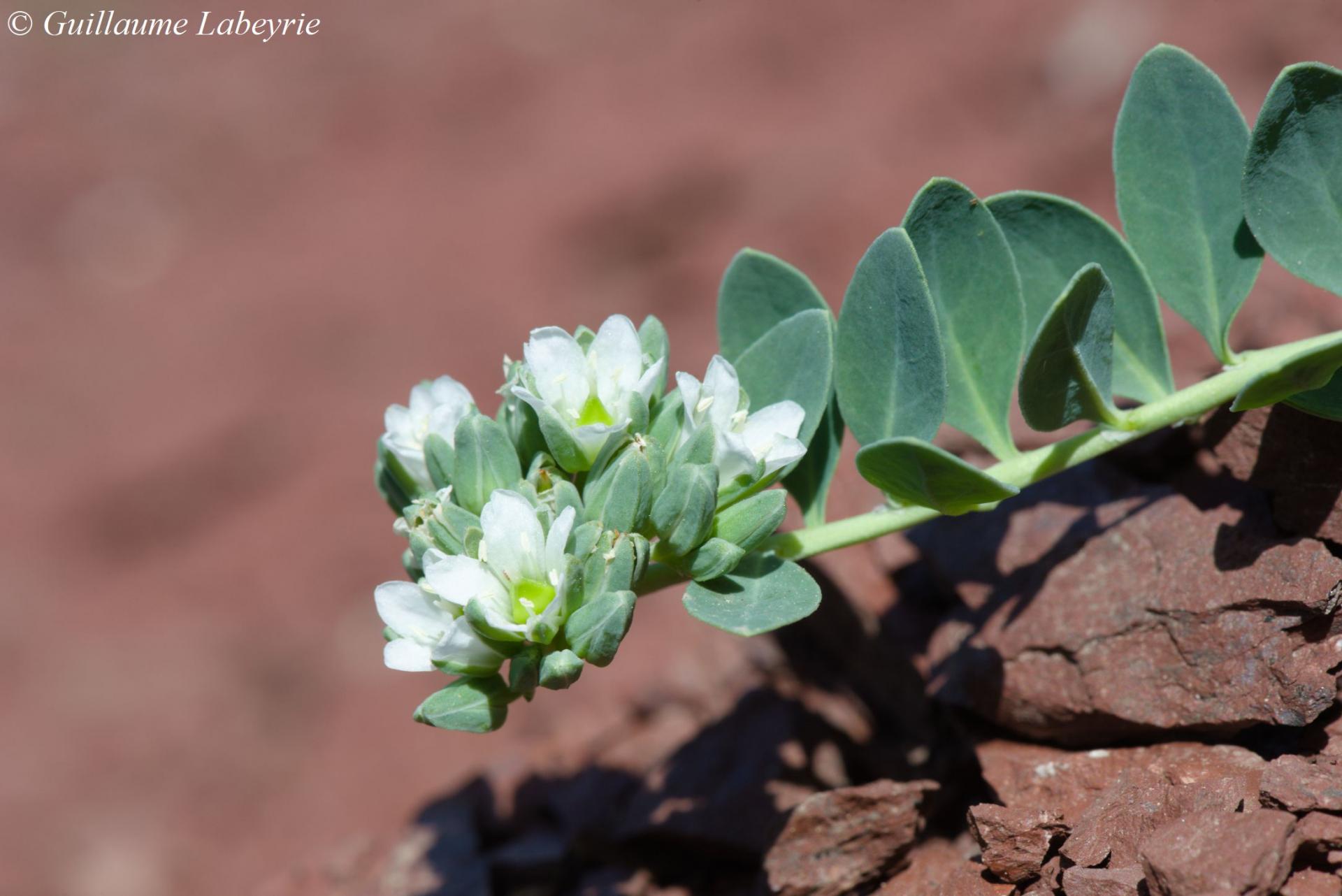 Telephium imperati. This unusual species forms rosettes of procumbent stems, bearing two rows of leaves and white flowers. It grows in scree, generally limestone. Its worldwide distribution includes southern Europe, western Asia and northern Africa. In France, it is found in the East and the South. It is protected in the Franche-Comté region.
Telephium imperati. This unusual species forms rosettes of procumbent stems, bearing two rows of leaves and white flowers. It grows in scree, generally limestone. Its worldwide distribution includes southern Europe, western Asia and northern Africa. In France, it is found in the East and the South. It is protected in the Franche-Comté region.
Family : Ophioglossaceae
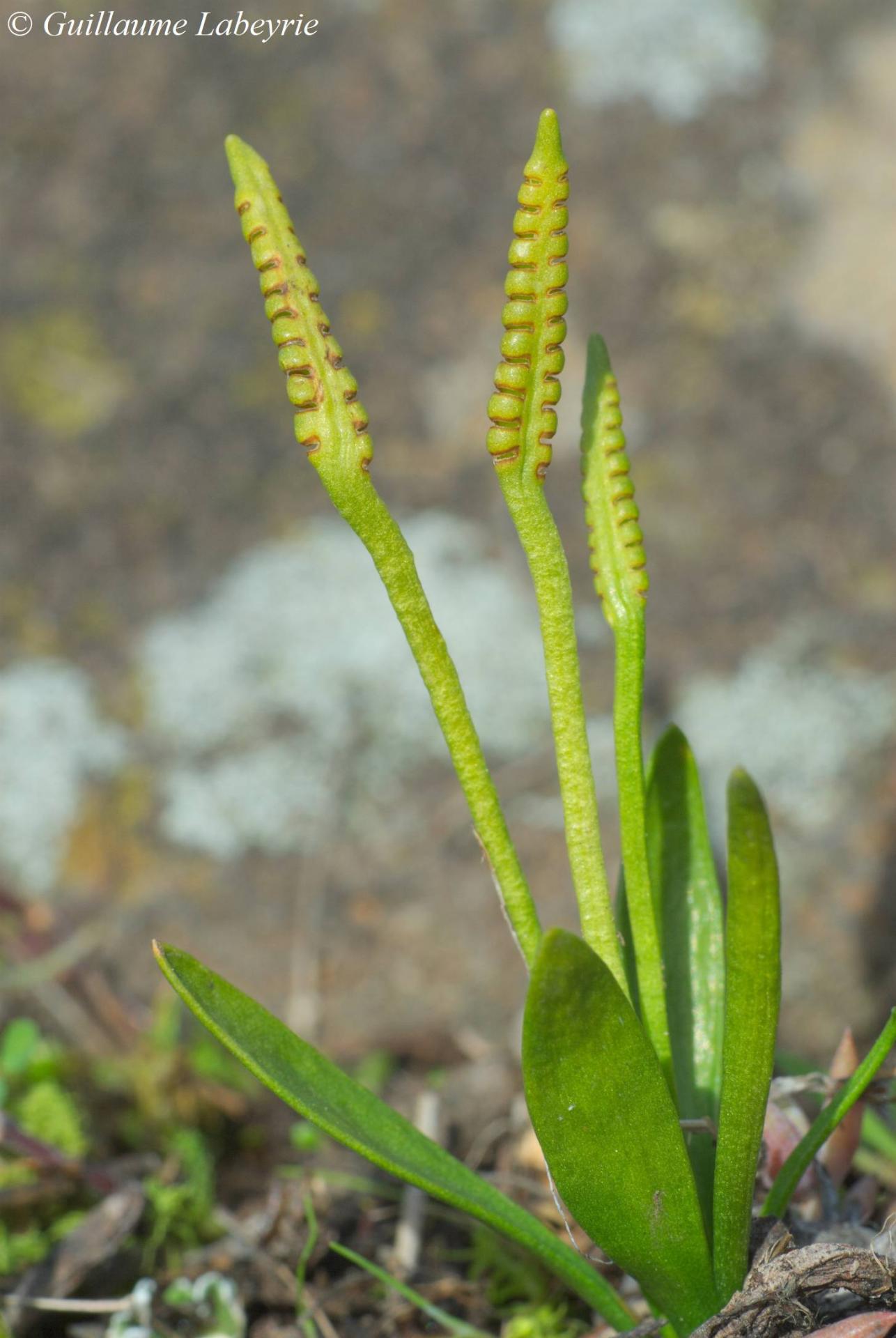 The least adder's-tongue (Ophioglossum lusitanicum). This tiny, inconspicuous plant appreciates wet sandy habitats. It has a vast world distribution, but it is classified as vulnerable by the IUCN. In France, it occurs in the south and along the Atlantic coast. It is protected in the PACA region.
The least adder's-tongue (Ophioglossum lusitanicum). This tiny, inconspicuous plant appreciates wet sandy habitats. It has a vast world distribution, but it is classified as vulnerable by the IUCN. In France, it occurs in the south and along the Atlantic coast. It is protected in the PACA region.
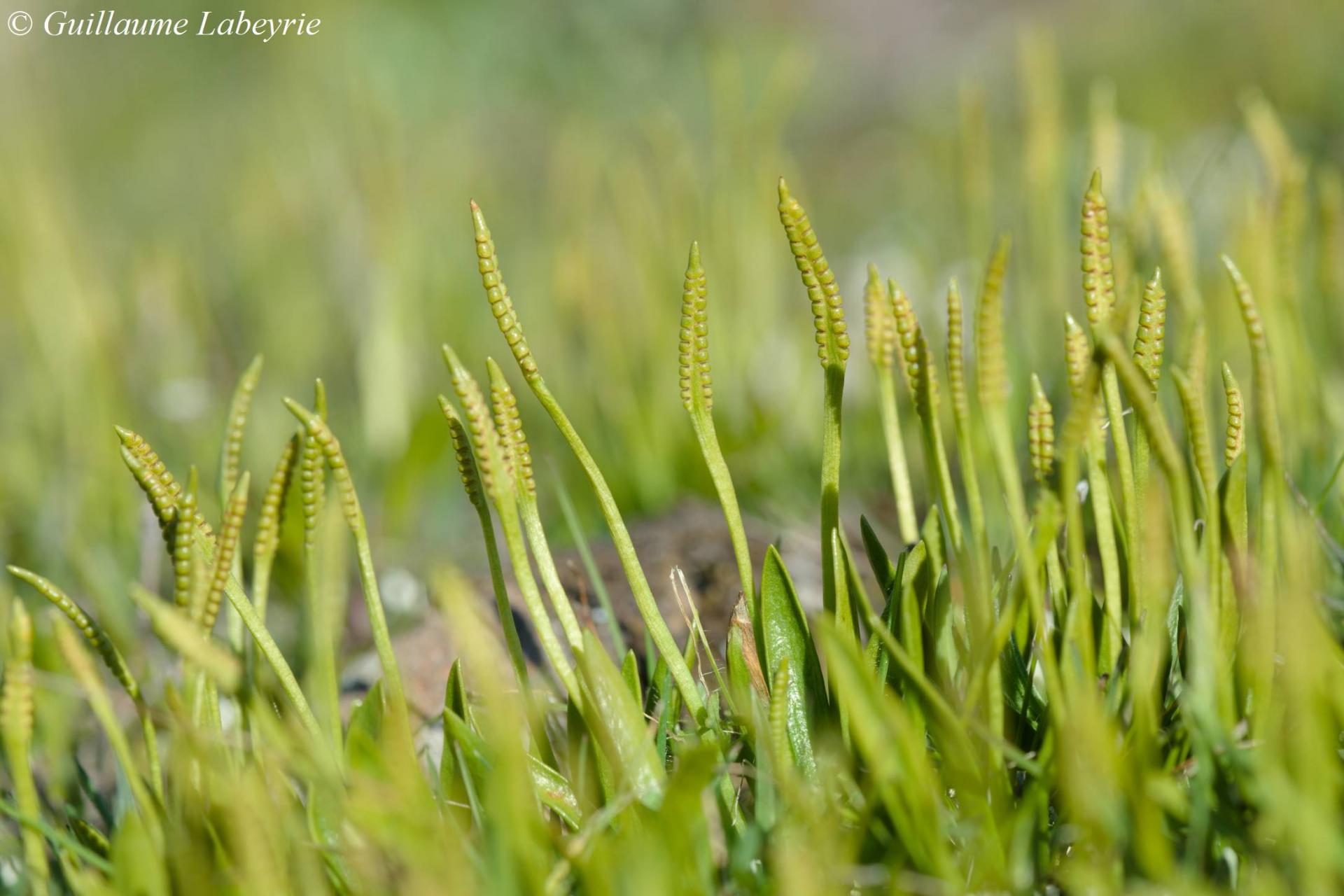
The least adder's-tongue (Ophioglossum lusitanicum).
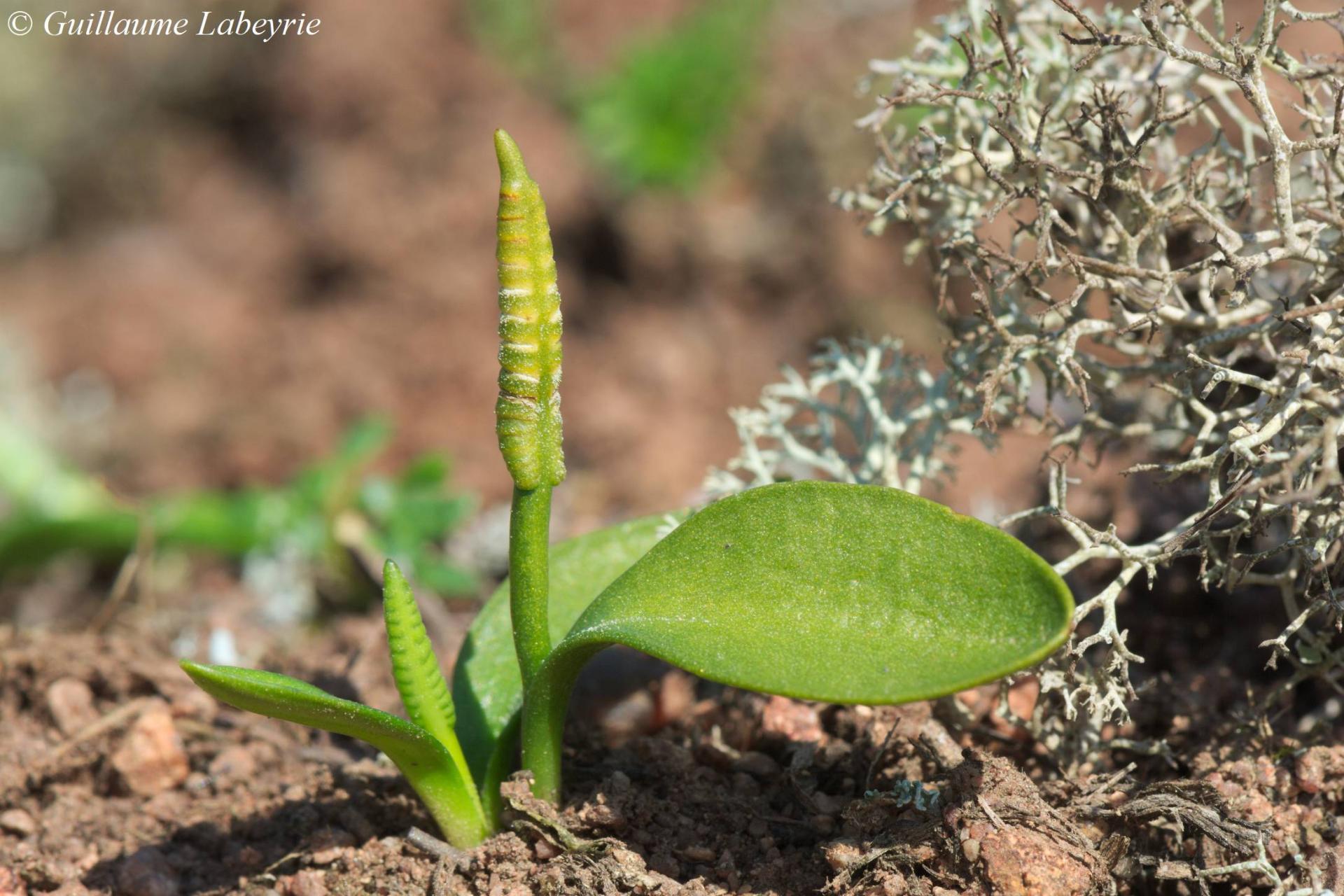 The small adder's-tongue (Ophioglossum azoricum). This strange little fern grows in wet sandy depressions. It is found in westernmost Europe. In France, it occurs in the western half of the country up to the Var department (here in the Plaine des Maures, where it is found together with Ophioglossum lusitanicum and Isoetes durieui). Fully protected in France, it is threatened in several regions.
The small adder's-tongue (Ophioglossum azoricum). This strange little fern grows in wet sandy depressions. It is found in westernmost Europe. In France, it occurs in the western half of the country up to the Var department (here in the Plaine des Maures, where it is found together with Ophioglossum lusitanicum and Isoetes durieui). Fully protected in France, it is threatened in several regions.
Family : Orchidaceae
Orchids are fascinating, both in terms of the diversity of shapes and colors and the amazing strategies developed by these plants to live and reproduce. The PACA region is particularly rich in orchids, with around 120 species. A selection is presented below. Other species from the region are also described in the section dedicated to the Grasse Prealps.
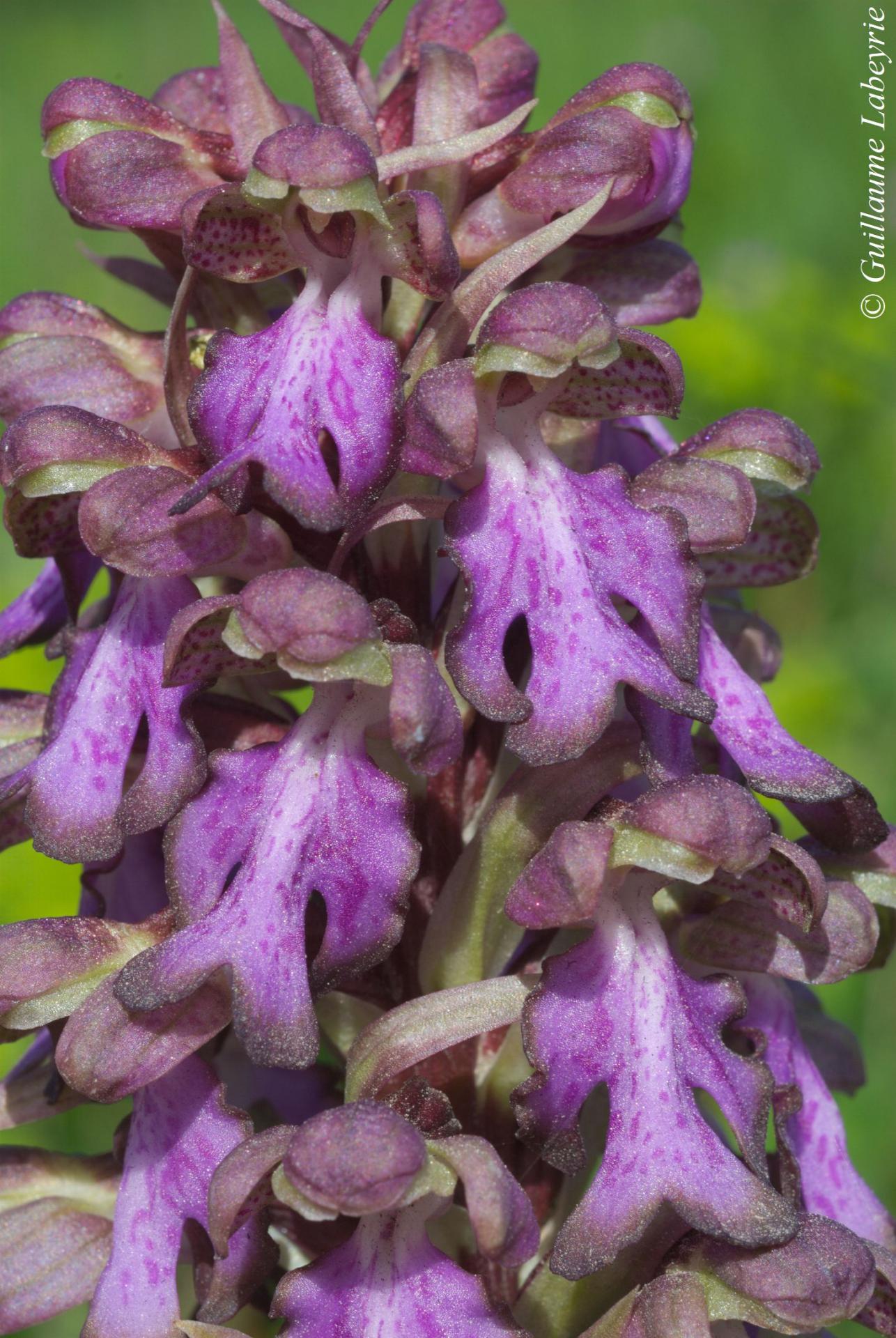 The giant orchid (Himantoglossum robertianum). This robust orchid is a Mediterranean species. It is easily identified by its large purple and green flowers, and its shiny green leaves. This is our most early flowering orchid, starting from January. In France, this plant is present in the south-east quarter, where it is very common.
The giant orchid (Himantoglossum robertianum). This robust orchid is a Mediterranean species. It is easily identified by its large purple and green flowers, and its shiny green leaves. This is our most early flowering orchid, starting from January. In France, this plant is present in the south-east quarter, where it is very common.
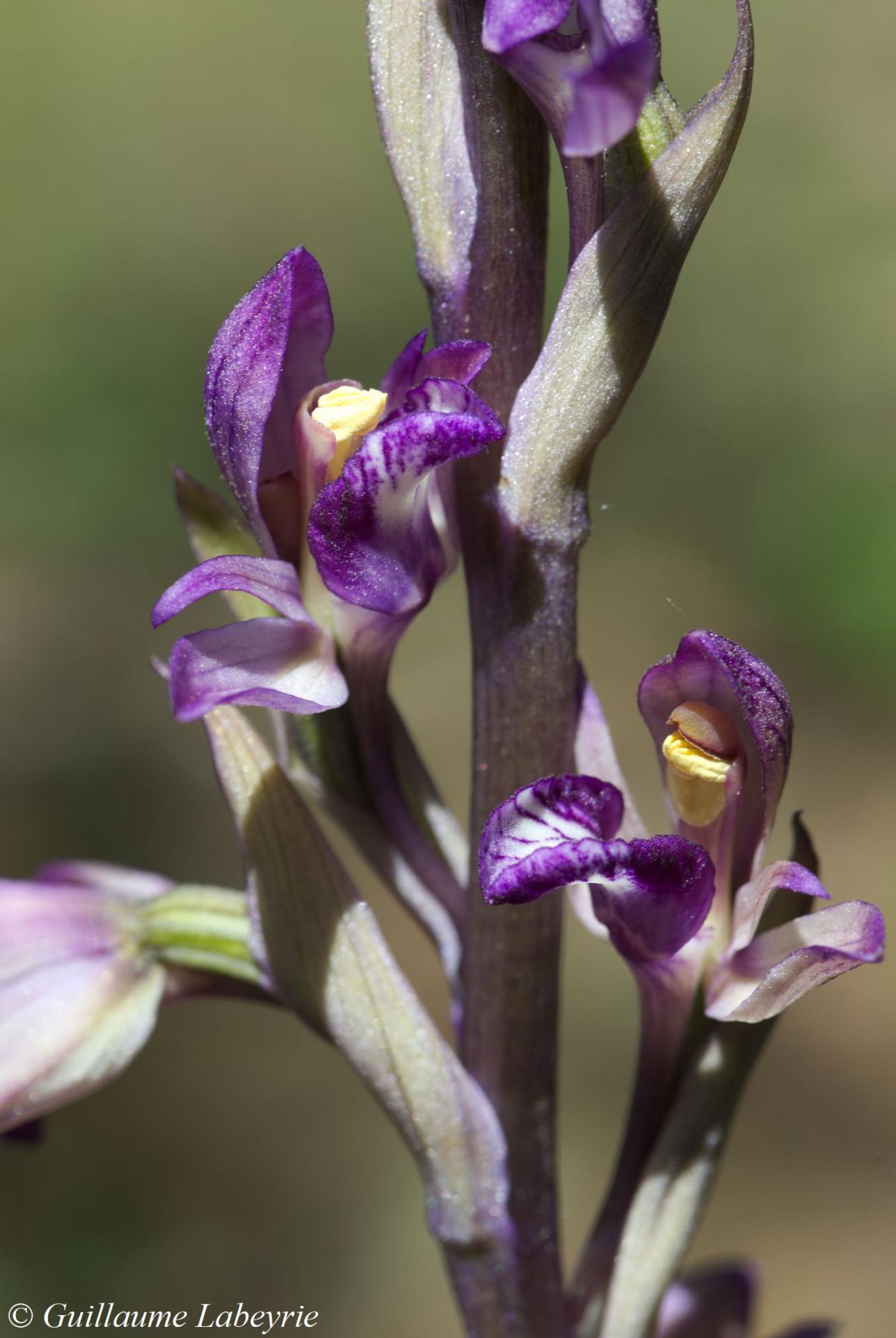 The violet limodore (Limodorum abortivum). Before flowering (in May), this curious species evokes a large purple asparagus. It is frequently found in the undergrowth of holm oaks. The limodore is present in a large part of France, but rare in the north.
The violet limodore (Limodorum abortivum). Before flowering (in May), this curious species evokes a large purple asparagus. It is frequently found in the undergrowth of holm oaks. The limodore is present in a large part of France, but rare in the north.
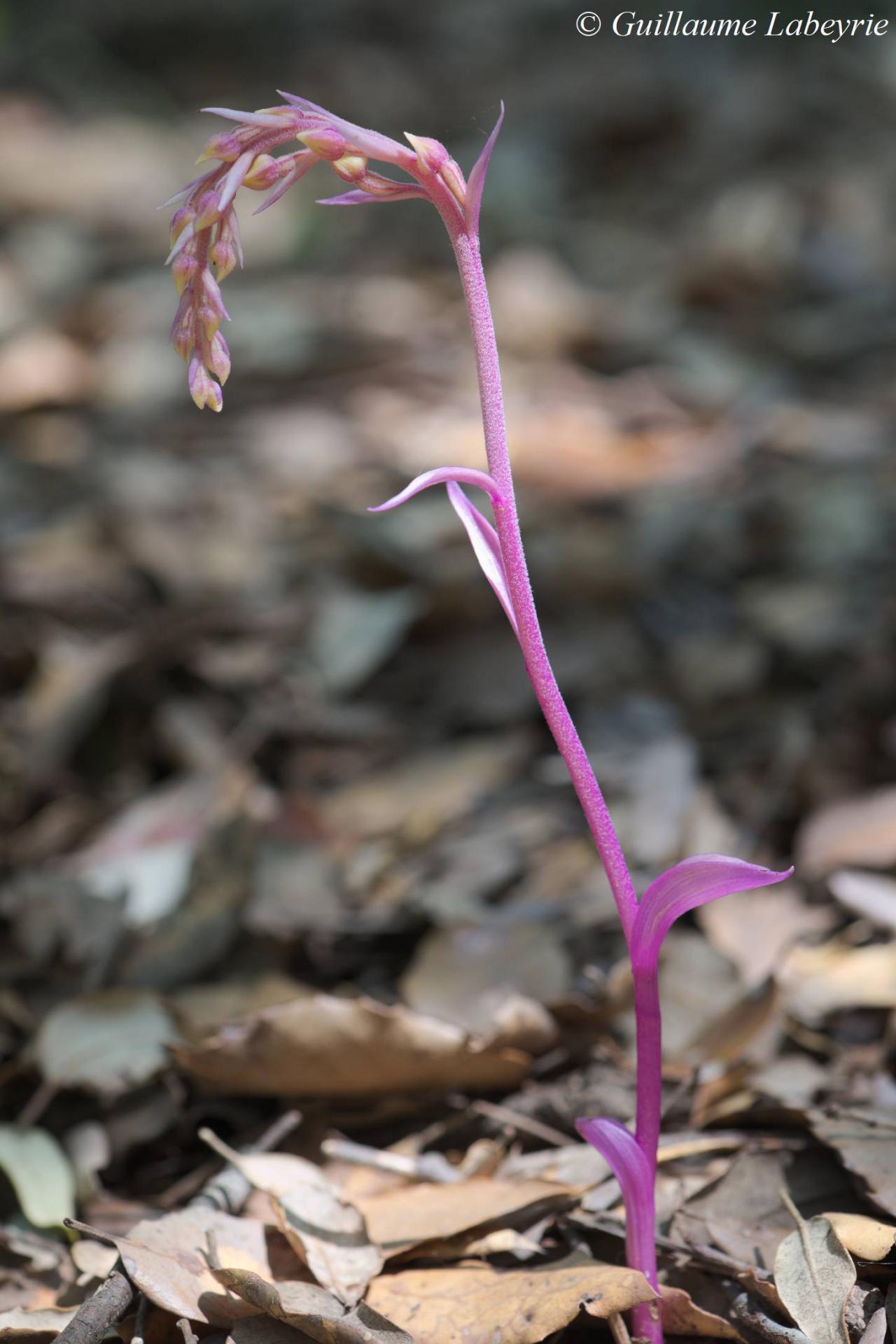 The small-leaved helleborine (Epipactis microphylla). This species, the smallest of the genus Epipactis in France, is often found here in holm oak undergrowth. It is usually greyish-green, with slightly open flowers. This photo represents the rosea form, devoid of chlorophyll, which is rarely observed. To survive, it must resort to associations with various species of fungi (mycorrhizae). Present in a good part of the French territory, except the North and Brittany, Epipactis microphylla is quite rare and protected in several regions.
The small-leaved helleborine (Epipactis microphylla). This species, the smallest of the genus Epipactis in France, is often found here in holm oak undergrowth. It is usually greyish-green, with slightly open flowers. This photo represents the rosea form, devoid of chlorophyll, which is rarely observed. To survive, it must resort to associations with various species of fungi (mycorrhizae). Present in a good part of the French territory, except the North and Brittany, Epipactis microphylla is quite rare and protected in several regions.
Bee Orchids
This very particular genus has a distribution centered on the Mediterranean. Ophrys have a flower part, the labellum, which imitates the females of certain species of insects and sexually attracts the males. During mating attempts ("pseudocopulation"), the insect collects the pollinia (pollen bags) and can thus fertilize other flowers.
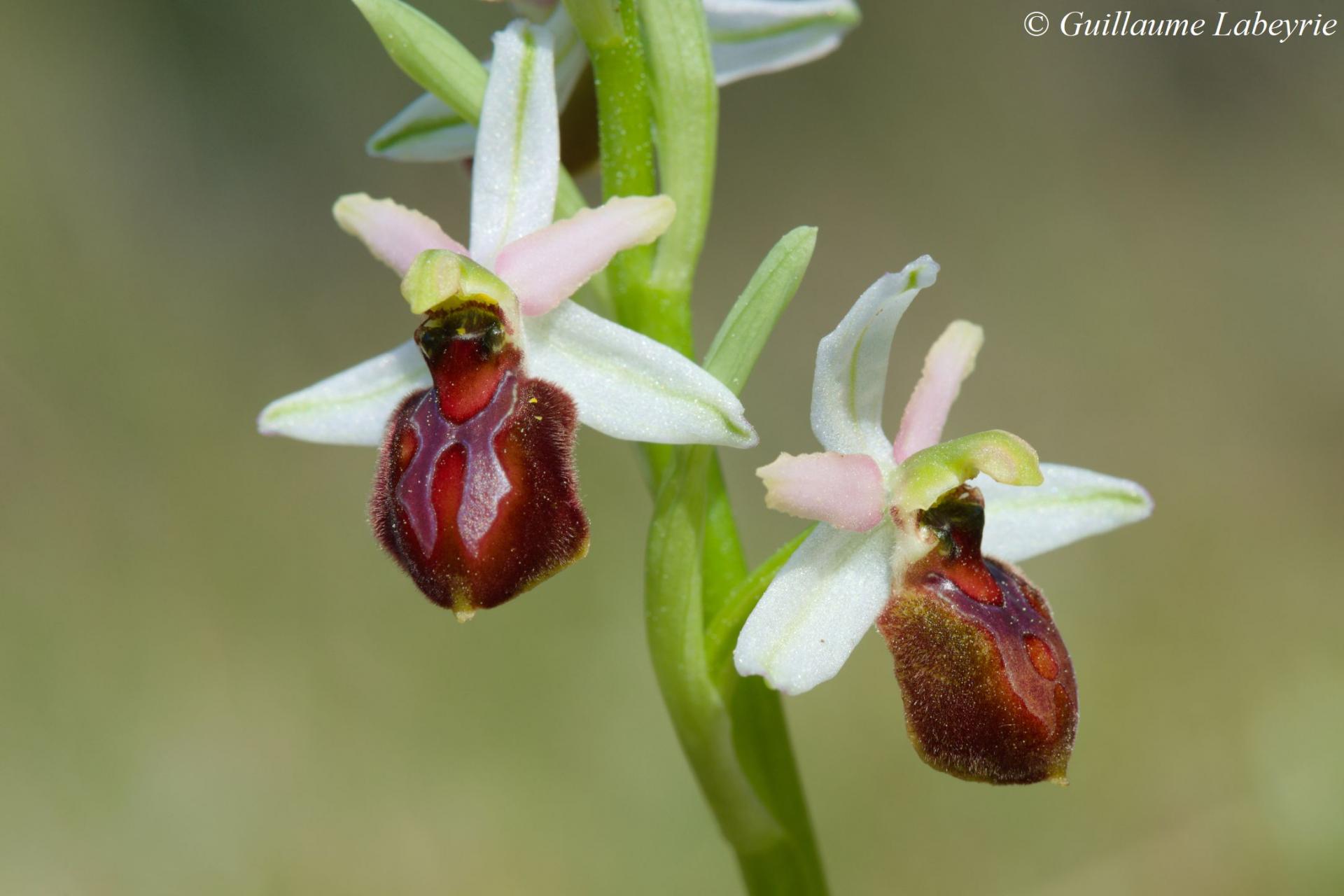 Ophrys arachnitiformis (= O. exaltata subsp. arachnitiformis). This species, very variable, generally has a pink or white perianth and a narrow labellum. On the Côte d'Azur, it is one of the first orchids to bloom, starting in March. The distribution of the Mediterranean species is not well known, due to confusions with other similar species. In France, this rather local orchid is supposed to occur near the coast between the Bouches-du-Rhône and the Alpes-Maritimes.
Ophrys arachnitiformis (= O. exaltata subsp. arachnitiformis). This species, very variable, generally has a pink or white perianth and a narrow labellum. On the Côte d'Azur, it is one of the first orchids to bloom, starting in March. The distribution of the Mediterranean species is not well known, due to confusions with other similar species. In France, this rather local orchid is supposed to occur near the coast between the Bouches-du-Rhône and the Alpes-Maritimes.
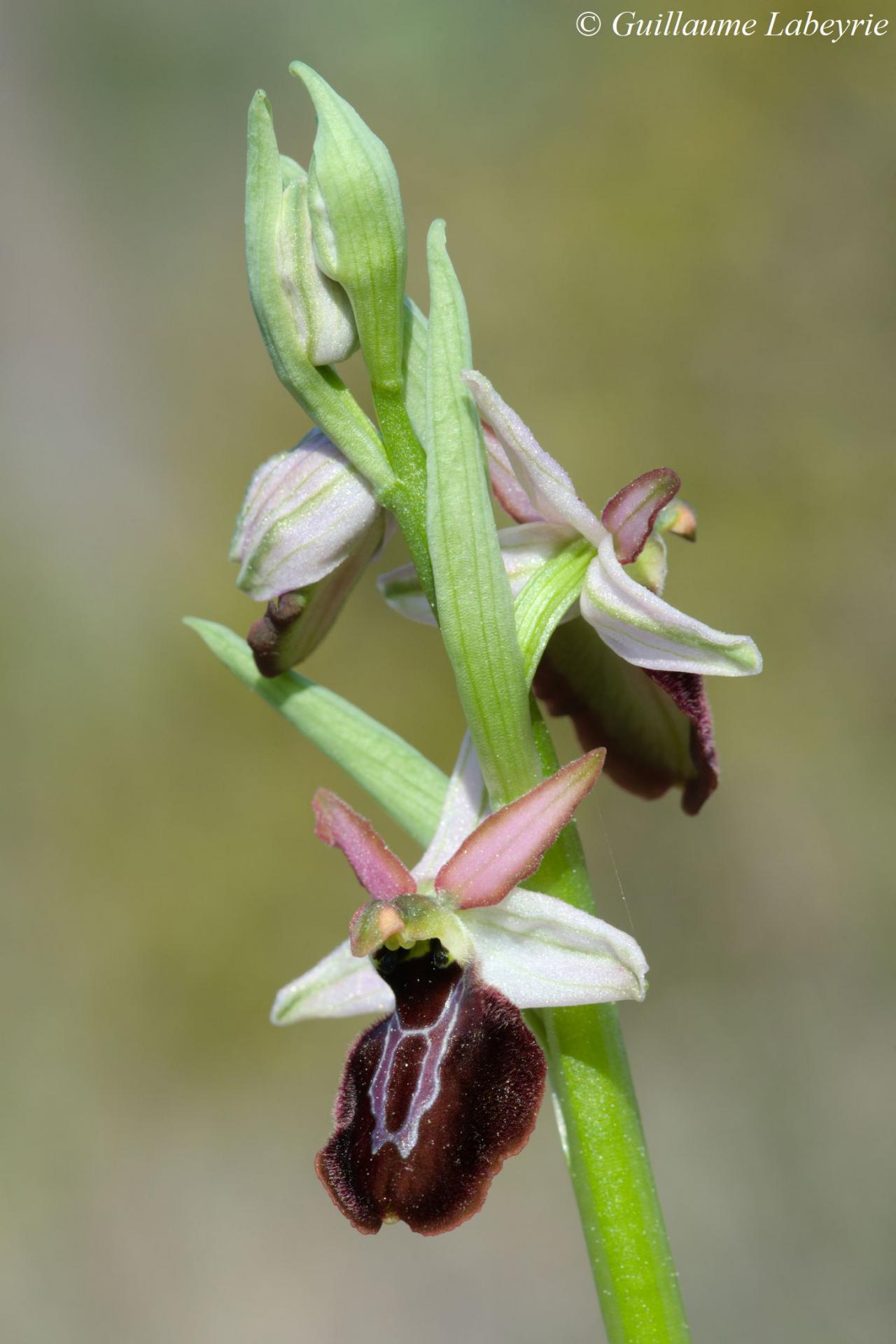 Ophrys arachnitiformis.
Ophrys arachnitiformis.
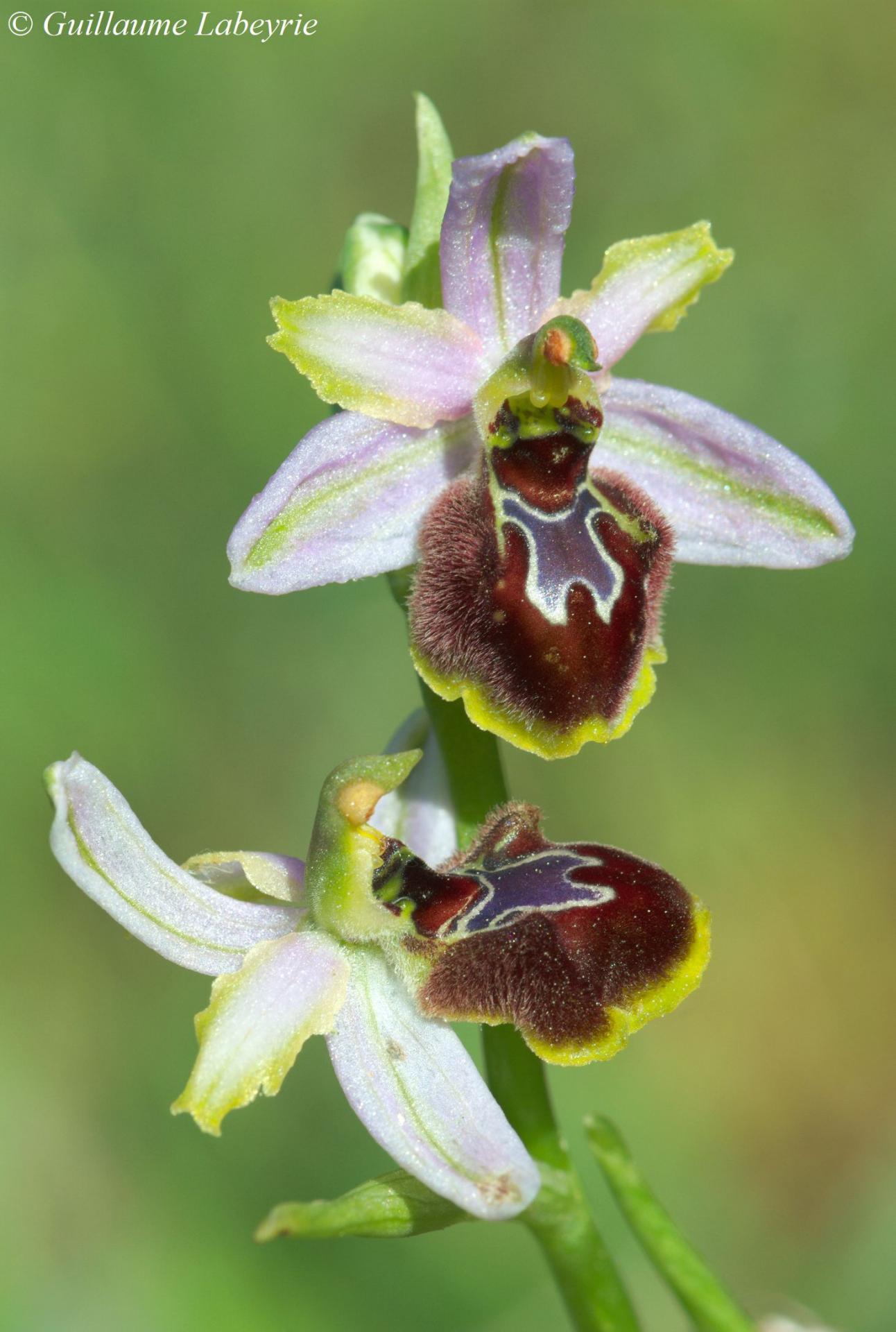 Ophrys splendida ( = O. exaltata subsp. splendida). This beautiful Ophrys is readily identified by the yellow border of its labellum, and the pink or white perianth with broad, bi-colored petals. It is a rather scarce species endemic to Southeastern France.
Ophrys splendida ( = O. exaltata subsp. splendida). This beautiful Ophrys is readily identified by the yellow border of its labellum, and the pink or white perianth with broad, bi-colored petals. It is a rather scarce species endemic to Southeastern France.
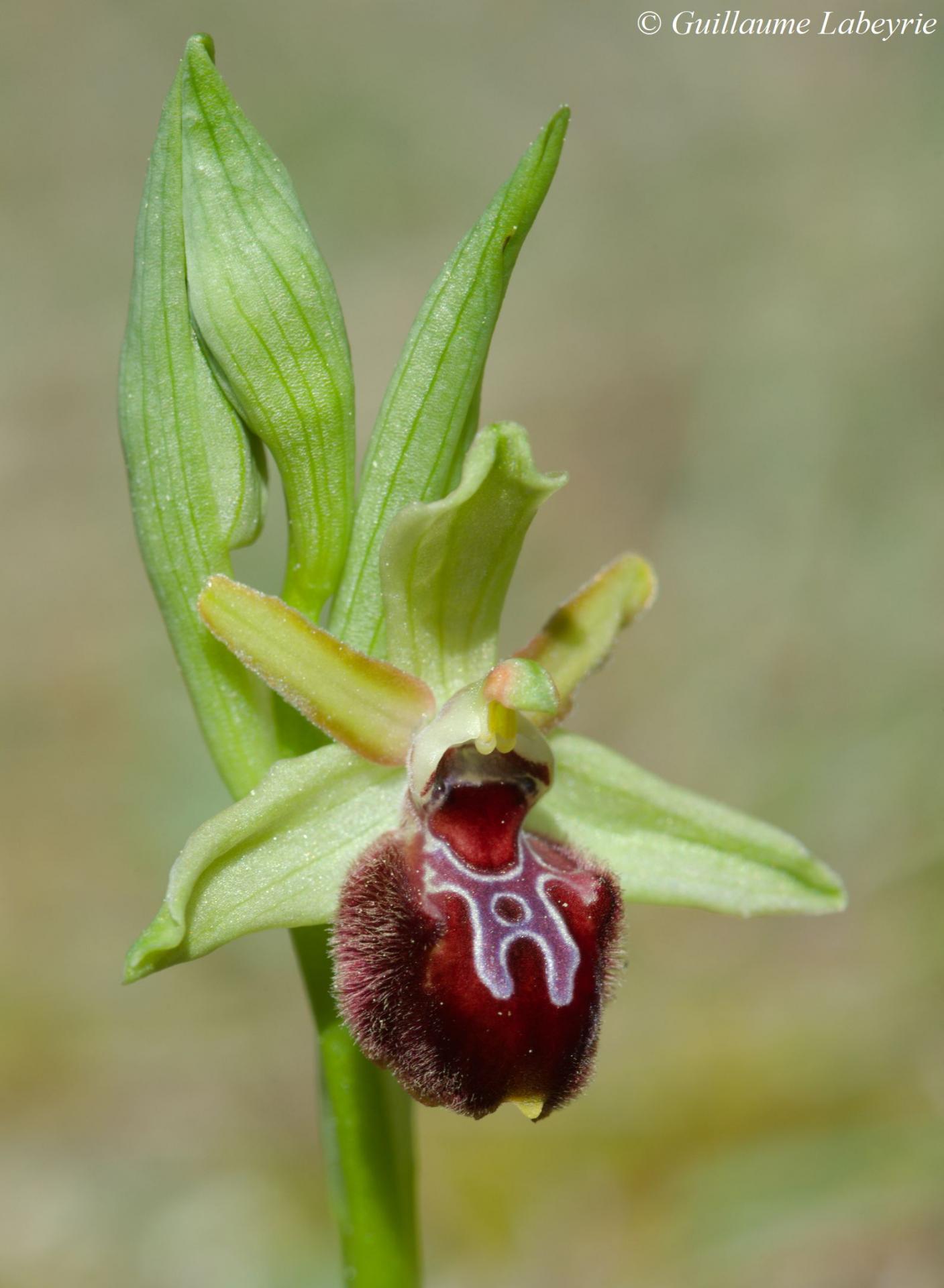 Ophrys provincialis. This beautiful species is endemic to Provence and is found from the Gard to the Alpes-Maritimes. Flowering takes place in April at low altitude, in May in low mountains (up to about 1000 m). The plant is often robust, the flowers have a green perianth and a reddish lip with a white-edged macula. A constant character is constituted by the pseudo-eyes, located at the edge of the stigmatic cavity, which are surrounded by white and surmounted by a brown line. Ophrys provincialis is protected in PACA.
Ophrys provincialis. This beautiful species is endemic to Provence and is found from the Gard to the Alpes-Maritimes. Flowering takes place in April at low altitude, in May in low mountains (up to about 1000 m). The plant is often robust, the flowers have a green perianth and a reddish lip with a white-edged macula. A constant character is constituted by the pseudo-eyes, located at the edge of the stigmatic cavity, which are surrounded by white and surmounted by a brown line. Ophrys provincialis is protected in PACA.
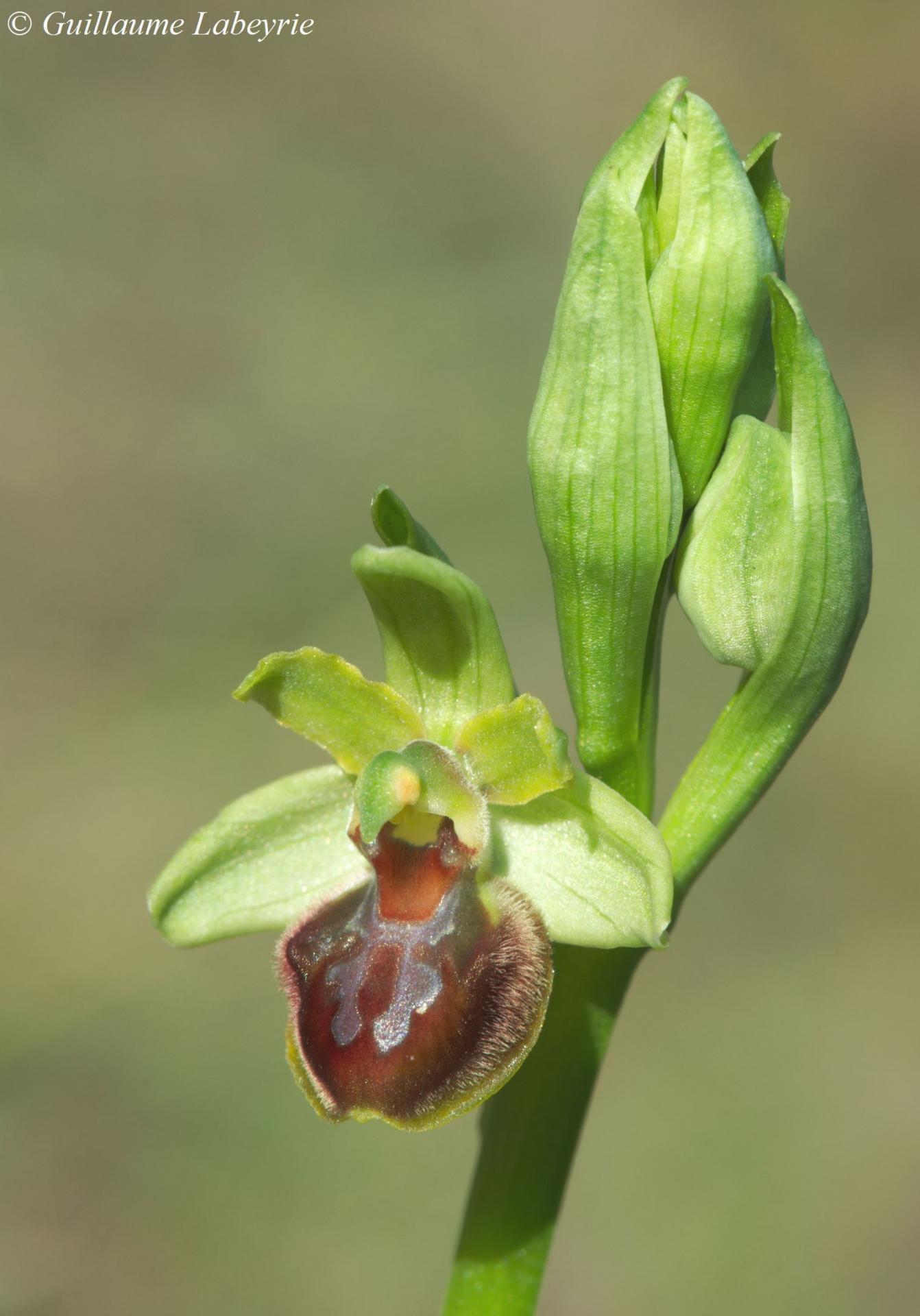 Ophrys aranifera subsp. massiliensis. This orchid, described recently, is characterised by small, pale-coloured flowers, and most of all by its very early flowering (starting in January, even December). It seems to be present only near the Mediterranean coast, from Hérault to Liguria.
Ophrys aranifera subsp. massiliensis. This orchid, described recently, is characterised by small, pale-coloured flowers, and most of all by its very early flowering (starting in January, even December). It seems to be present only near the Mediterranean coast, from Hérault to Liguria.
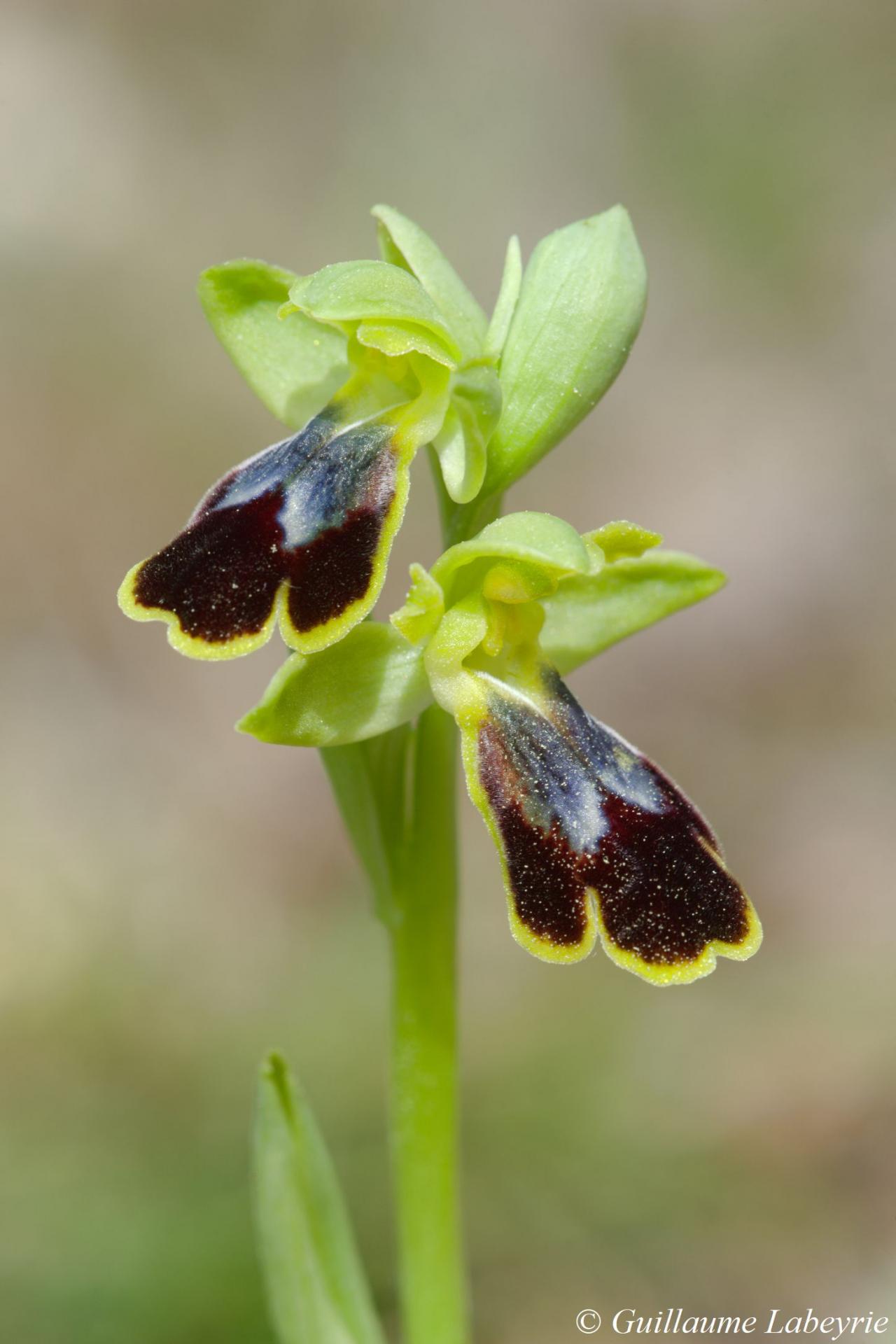 Ophrys bilunulata. This beautiful Ophrys belongs to the "fusca" group, with a complex systematics which has given rise to the description of numerous taxa. The current trend seems to be to return to a simpler situation, with two species in Southeastern France: O. bilunulata characterized by an almost flat labellum with a wide yellow margin with bluish lunules dotted with dots and dashes, and O. fusca (= O. lupercalis = O. forestieri) with a folded lip without a wide yellow margin with white or greyish lunules. This species is often found in open pine forests. Fairly localised in France, it is only present along the Mediterranean, in two islets in the southwest and southeast.
Ophrys bilunulata. This beautiful Ophrys belongs to the "fusca" group, with a complex systematics which has given rise to the description of numerous taxa. The current trend seems to be to return to a simpler situation, with two species in Southeastern France: O. bilunulata characterized by an almost flat labellum with a wide yellow margin with bluish lunules dotted with dots and dashes, and O. fusca (= O. lupercalis = O. forestieri) with a folded lip without a wide yellow margin with white or greyish lunules. This species is often found in open pine forests. Fairly localised in France, it is only present along the Mediterranean, in two islets in the southwest and southeast.
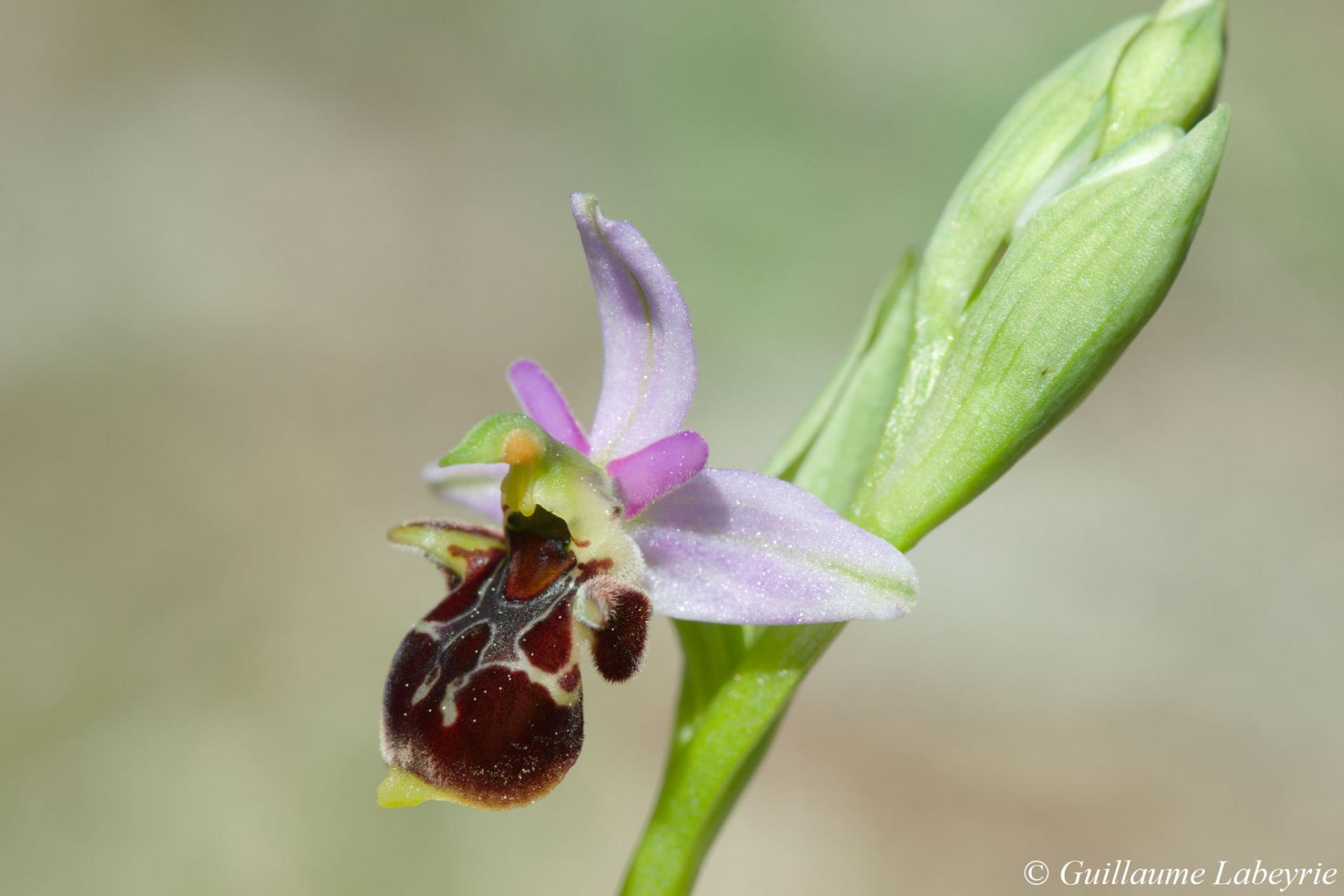 The woodcock orchid (Ophrys scolopax). This Ophrys has a strongly trilobed labellum, with horn-shaped lateral lobes. The central lobe, folded, has a cylindrical shape. This species should not be confused with Ophrys santonica, sporting smaller flowers with a labellum with a yellow margin, flowering much later (end of June instead of the end of April for O. scolopax). The distinction with Ophrys vetula, with a broader labellum and flowering later, seems often delicate. The woodcock ophrys is a fairly common species, present in the southern half of France.
The woodcock orchid (Ophrys scolopax). This Ophrys has a strongly trilobed labellum, with horn-shaped lateral lobes. The central lobe, folded, has a cylindrical shape. This species should not be confused with Ophrys santonica, sporting smaller flowers with a labellum with a yellow margin, flowering much later (end of June instead of the end of April for O. scolopax). The distinction with Ophrys vetula, with a broader labellum and flowering later, seems often delicate. The woodcock ophrys is a fairly common species, present in the southern half of France.
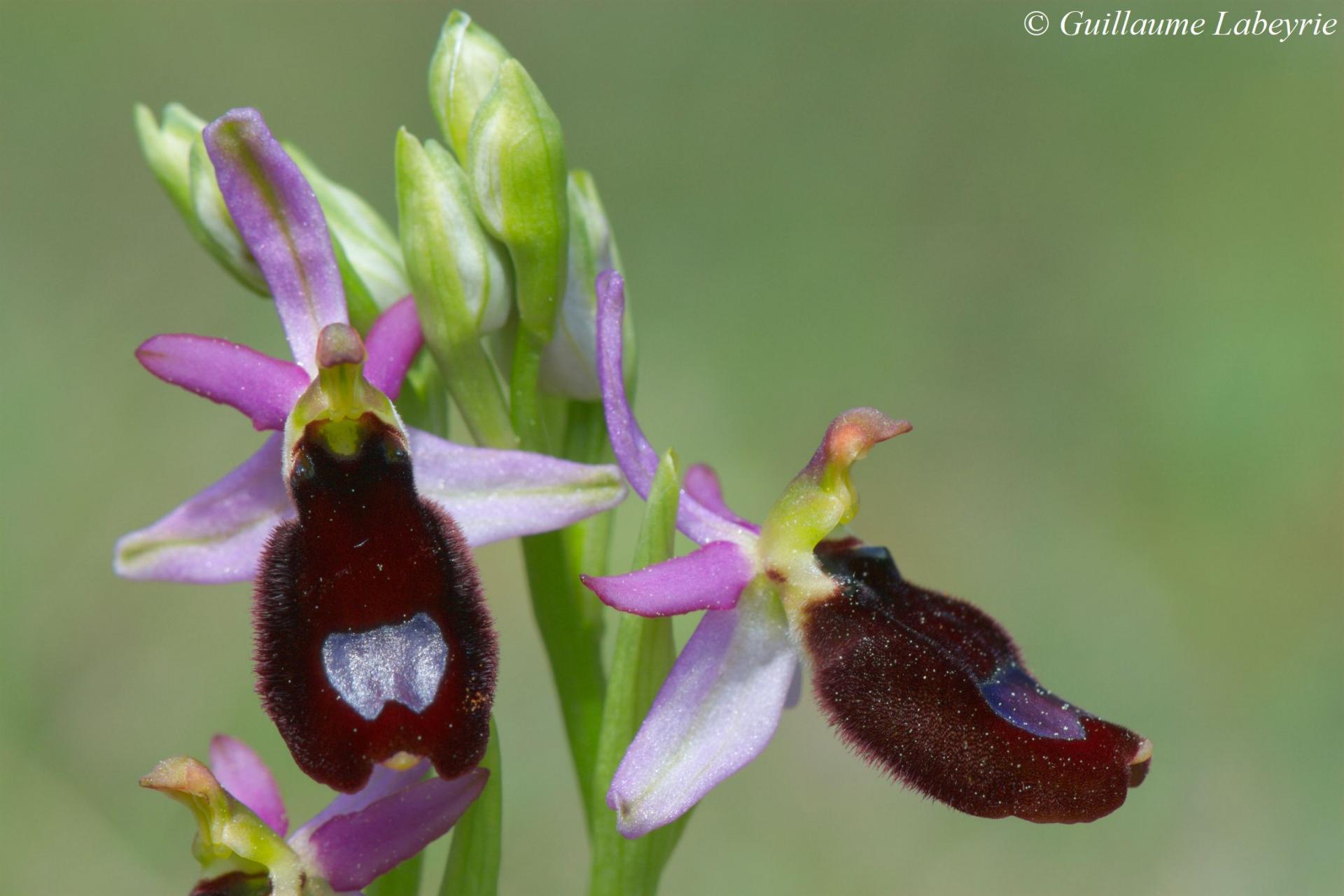 Ophrys aurelia (= O. bertolonii). This is one of our most spectacular orchid. The dark flat, wide labellum and the pink perianth are characteristic. This species can only be confused with Ophrys drumana (= Ophrys saratoi), which has smaller flowers with a narrower labellum. Ophrys aurelia is found in rocky grasslands, from the coast up to an altitude of around 1200 m. In the Alpes-Maritimes, its populations close to the coast have been wiped out by urbanisation. Present in France in the South-East and in Corsica, this species is protected at the national level and appears on the red list as ''near-threatened''.
Ophrys aurelia (= O. bertolonii). This is one of our most spectacular orchid. The dark flat, wide labellum and the pink perianth are characteristic. This species can only be confused with Ophrys drumana (= Ophrys saratoi), which has smaller flowers with a narrower labellum. Ophrys aurelia is found in rocky grasslands, from the coast up to an altitude of around 1200 m. In the Alpes-Maritimes, its populations close to the coast have been wiped out by urbanisation. Present in France in the South-East and in Corsica, this species is protected at the national level and appears on the red list as ''near-threatened''.
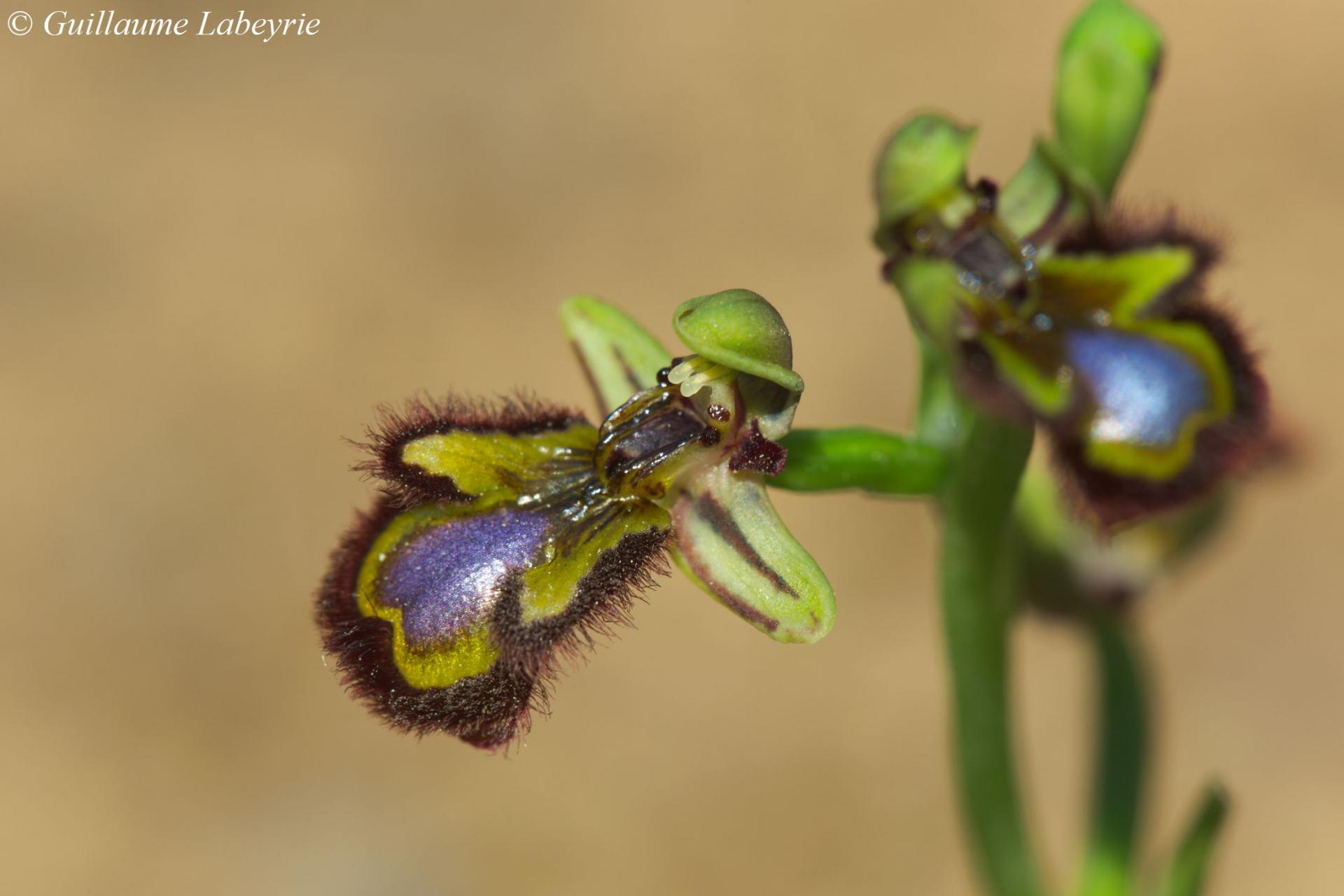 The mirror orchid (Ophrys speculum). This stunning species cannot be confused, with its labellum with a blue macula bordered by long red hairs. France constitutes the northern limit of the range of this species. Very rare in France, it is mainly found on the Mediterranean coast, where its presence is sporadic. In the Alpes-Maritimes, its rare populations are threatened with destruction by urbanisation. The mirror ophrys is however protected at the national level and is on the red list with the mention "endangered".
The mirror orchid (Ophrys speculum). This stunning species cannot be confused, with its labellum with a blue macula bordered by long red hairs. France constitutes the northern limit of the range of this species. Very rare in France, it is mainly found on the Mediterranean coast, where its presence is sporadic. In the Alpes-Maritimes, its rare populations are threatened with destruction by urbanisation. The mirror ophrys is however protected at the national level and is on the red list with the mention "endangered".
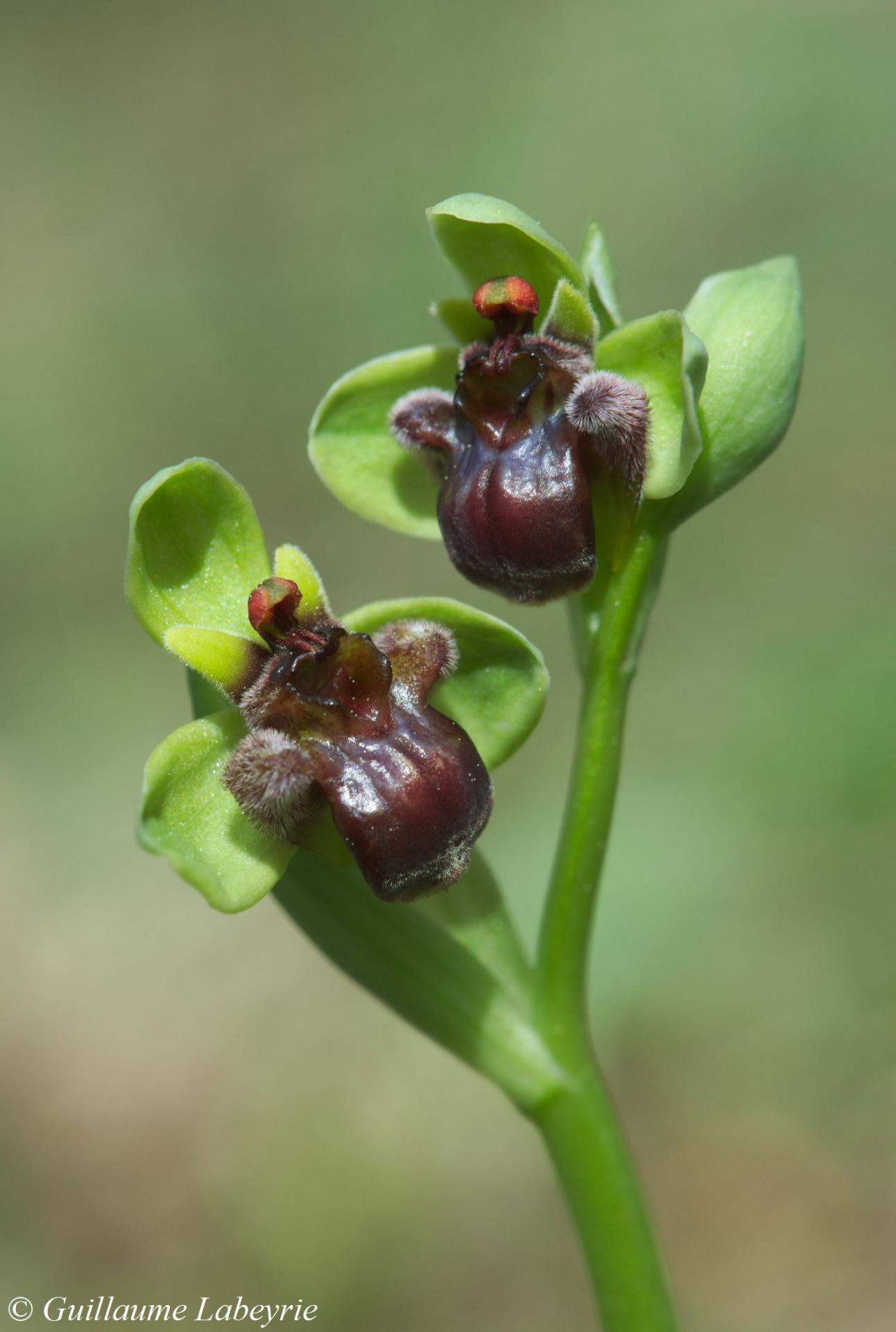 The bumblebee orchid (Ophrys bombyliflora). This tiny species with curious brown flowers is very inconspicuous. It cannot be confused. Like the previous species, this Ophrys finds its northern limit of distribution in France. It is very rare in our country and occurs only in Aude, Hérault, Var, Alpes-Maritimes and Corsica. In the Alpes-Maritimes, it is threatened with extinction due to uncontrolled urbanisation. Appearing on the national red list under the mention "near-threatened", it is protected throughout the territory.
The bumblebee orchid (Ophrys bombyliflora). This tiny species with curious brown flowers is very inconspicuous. It cannot be confused. Like the previous species, this Ophrys finds its northern limit of distribution in France. It is very rare in our country and occurs only in Aude, Hérault, Var, Alpes-Maritimes and Corsica. In the Alpes-Maritimes, it is threatened with extinction due to uncontrolled urbanisation. Appearing on the national red list under the mention "near-threatened", it is protected throughout the territory.
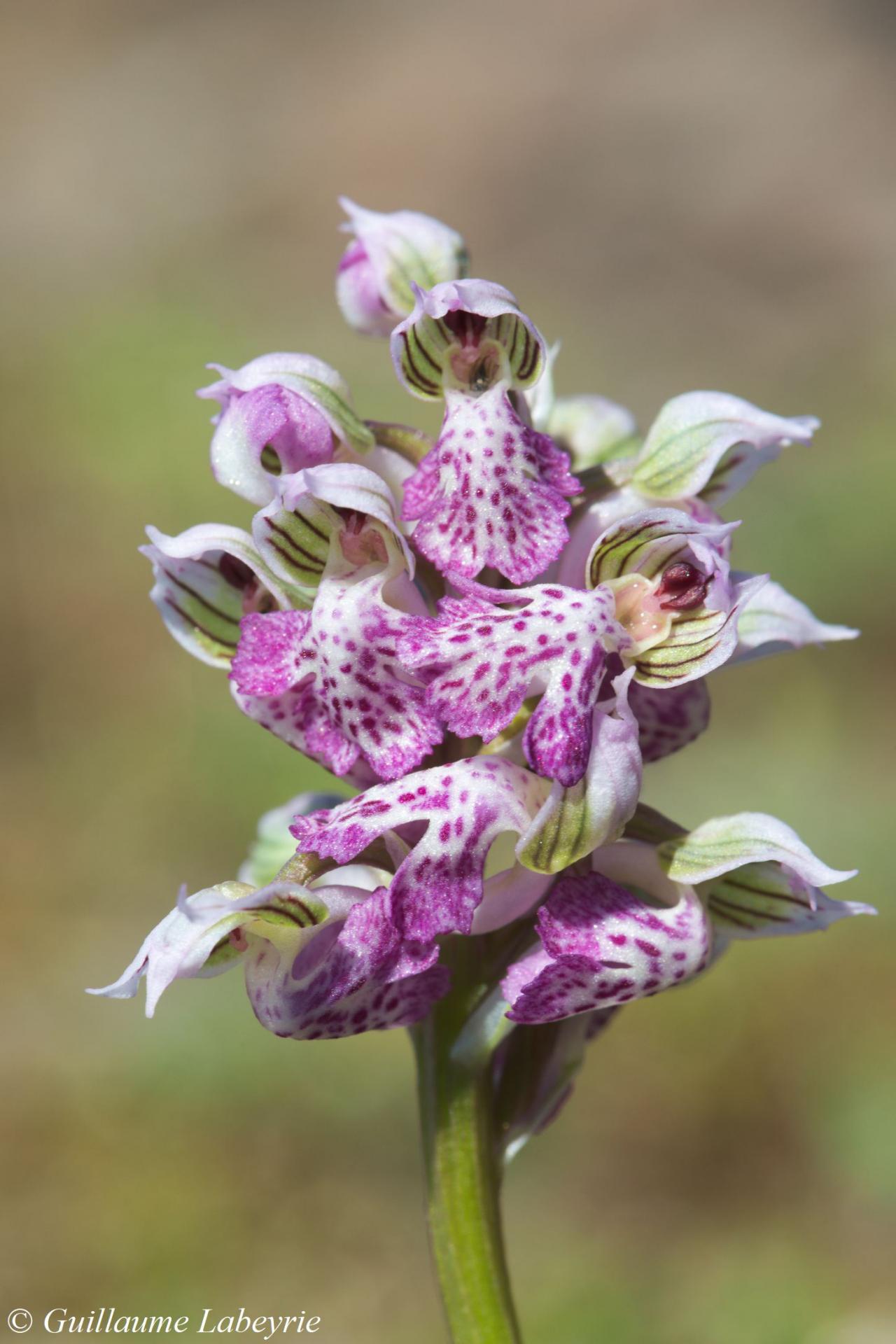 The milky orchid (Neotinea lactea). This beautiful, small-sized species can be identified by its trilobed labellum dotted with purple, and its greenish helmet veined with purple on the inside. Early-flowering and rare, it is found here and there on siliceous as well as calcareous soil. Of circum-Mediterranean distribution, it is found in France only in the extreme south. It appears on the national red list under the mention ''quasi-threatened'', and is protected in the Midi-Pyrénées region.
The milky orchid (Neotinea lactea). This beautiful, small-sized species can be identified by its trilobed labellum dotted with purple, and its greenish helmet veined with purple on the inside. Early-flowering and rare, it is found here and there on siliceous as well as calcareous soil. Of circum-Mediterranean distribution, it is found in France only in the extreme south. It appears on the national red list under the mention ''quasi-threatened'', and is protected in the Midi-Pyrénées region.
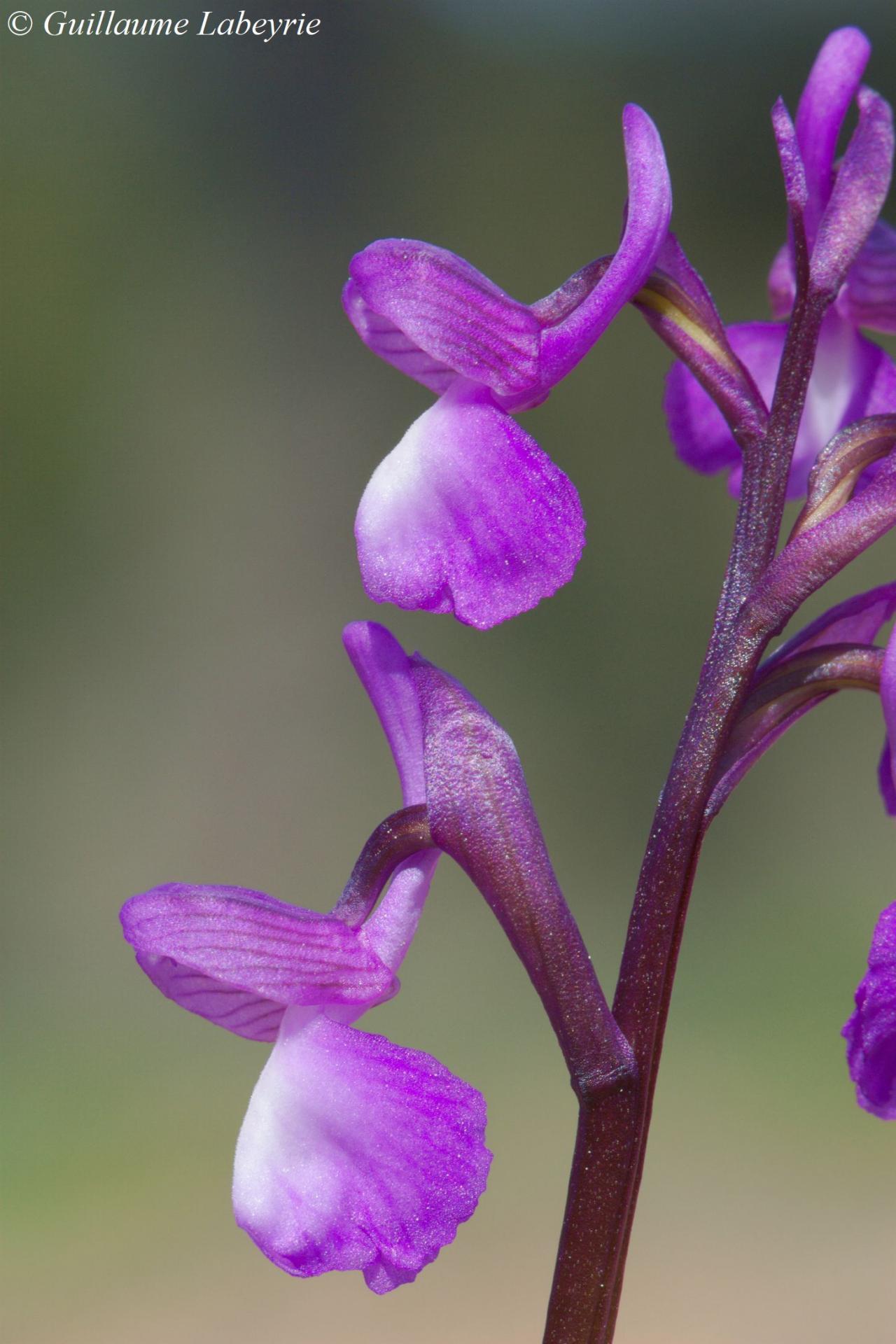 Champagneux's orchid (Anacamptis morio subsp. champagneuxii). This species can be recognized by its strongly folded labellum with a white throat without purple spots, and its long spur widened at the end. It is found in siliceous soil, often in cork oak undergrowth. Restricted to Western Europe (France, Spain and Portugal), it is present in France only in the Var and the Pyrénées-Orientales
Champagneux's orchid (Anacamptis morio subsp. champagneuxii). This species can be recognized by its strongly folded labellum with a white throat without purple spots, and its long spur widened at the end. It is found in siliceous soil, often in cork oak undergrowth. Restricted to Western Europe (France, Spain and Portugal), it is present in France only in the Var and the Pyrénées-Orientales
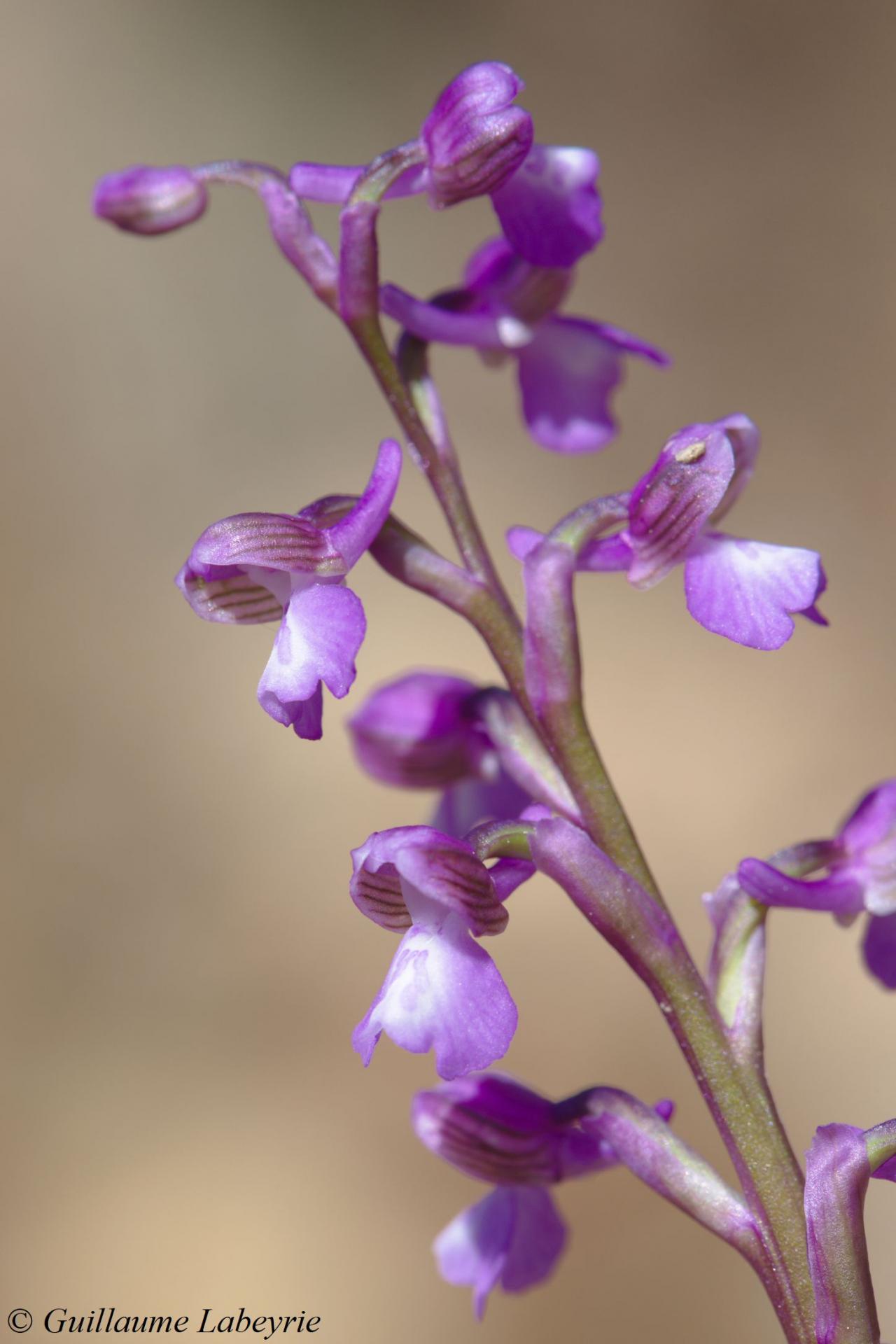 Anacamptis morio subsp. picta. Similar to the green-winged orchid (Anacamptis morio subsp. morio), this orchid is much more slender, and has small pale flowers with a faded macula. The helmet is streaked with green. Contrary to the typical subspecies which is mountainous in the region (see section "Grasse Prealps"), Anacamptis morio subsp. picta is a southern plant which grows in dry maquis, generally in siliceous soil. In France, it is only found in the South.
Anacamptis morio subsp. picta. Similar to the green-winged orchid (Anacamptis morio subsp. morio), this orchid is much more slender, and has small pale flowers with a faded macula. The helmet is streaked with green. Contrary to the typical subspecies which is mountainous in the region (see section "Grasse Prealps"), Anacamptis morio subsp. picta is a southern plant which grows in dry maquis, generally in siliceous soil. In France, it is only found in the South.
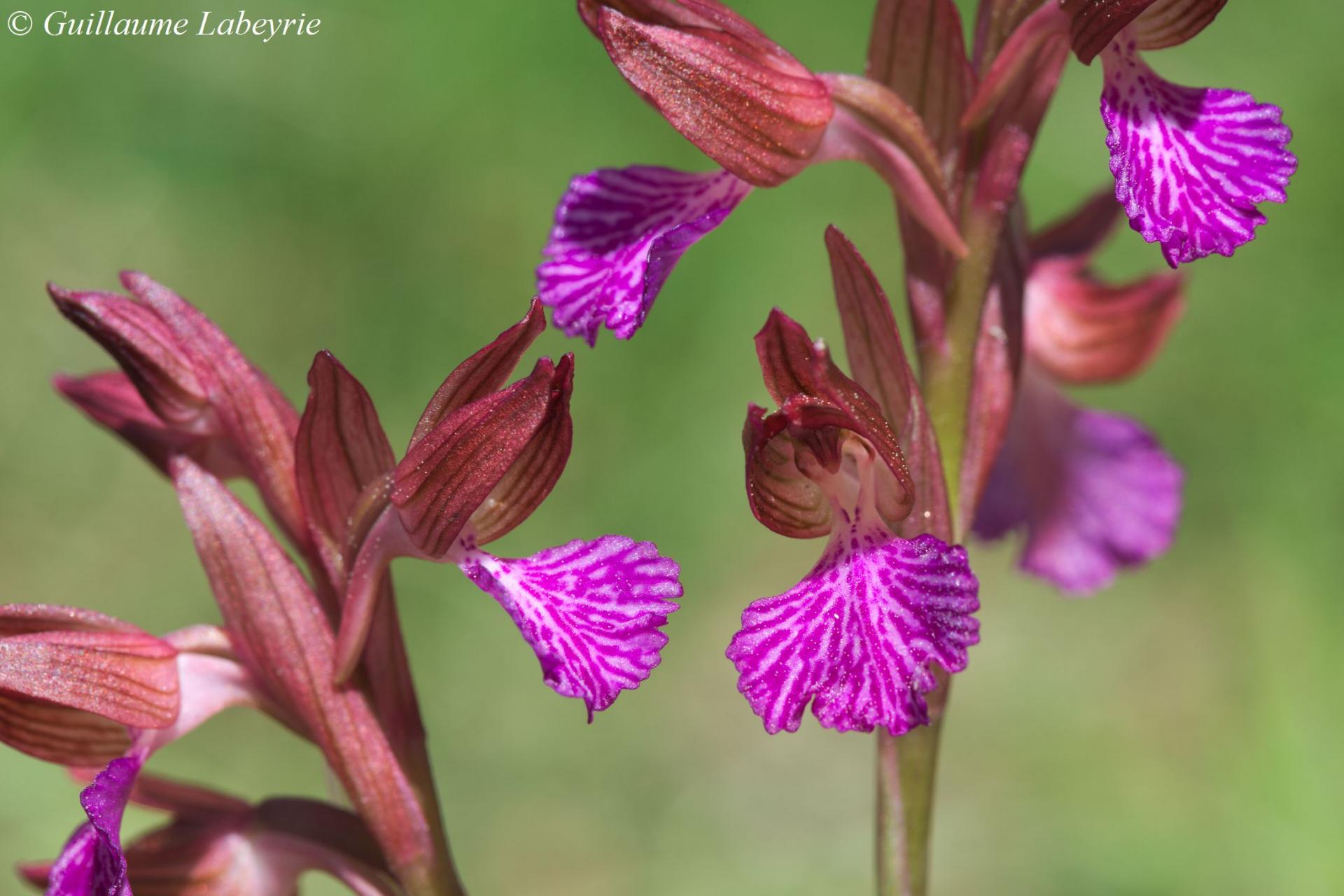 The pink butterfly orchid (Anacamptis papilionacea). This beautiful species is easy to recognize with its red helmet and fan-shaped labellum with purple dashes. It is found in quite varied environments: olive groves, slightly damp meadows, rocky grasslands, etc... Generally observed at low altitude, it reaches 700 m in the Alpes-Maritimes. Of Mediterranean distribution, it is found in France mainly in the extreme south. It is protected in the Midi-Pyrénées region.
The pink butterfly orchid (Anacamptis papilionacea). This beautiful species is easy to recognize with its red helmet and fan-shaped labellum with purple dashes. It is found in quite varied environments: olive groves, slightly damp meadows, rocky grasslands, etc... Generally observed at low altitude, it reaches 700 m in the Alpes-Maritimes. Of Mediterranean distribution, it is found in France mainly in the extreme south. It is protected in the Midi-Pyrénées region.
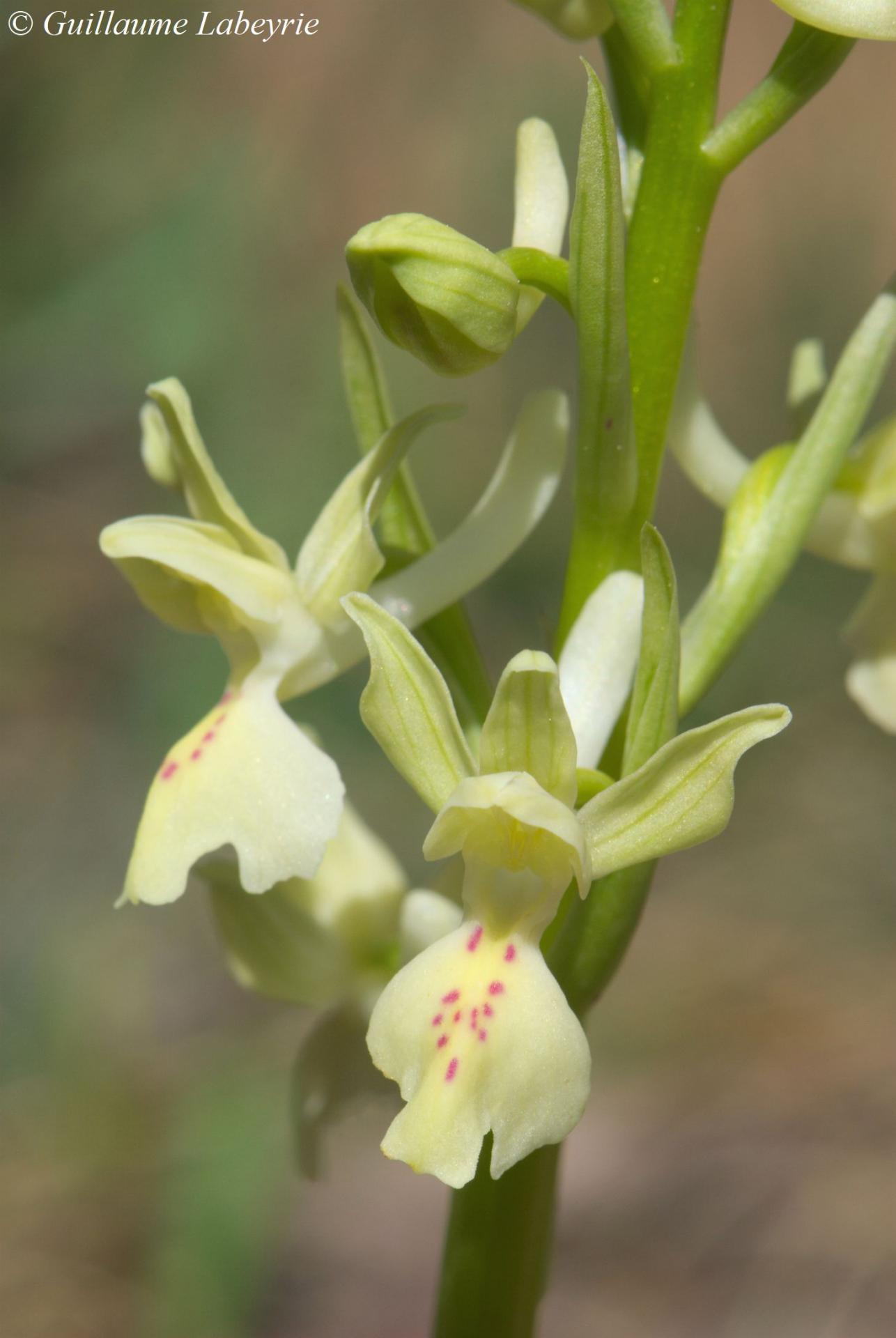 The Provence orchid (Orchis provincialis). With its pale yellow flowers punctuated with pink, this beautiful species can only be confused with Orchis pauciflora, present in Corsica. Orchis provincialis has much paler flowers, and its leaves are usually mottled with brown. This unusual species appreciates shady siliceous soils (it can sometimes be observed in chestnut groves). Of Mediterranean distribution, it is observed in France in the South. It is fully protected.
The Provence orchid (Orchis provincialis). With its pale yellow flowers punctuated with pink, this beautiful species can only be confused with Orchis pauciflora, present in Corsica. Orchis provincialis has much paler flowers, and its leaves are usually mottled with brown. This unusual species appreciates shady siliceous soils (it can sometimes be observed in chestnut groves). Of Mediterranean distribution, it is observed in France in the South. It is fully protected.
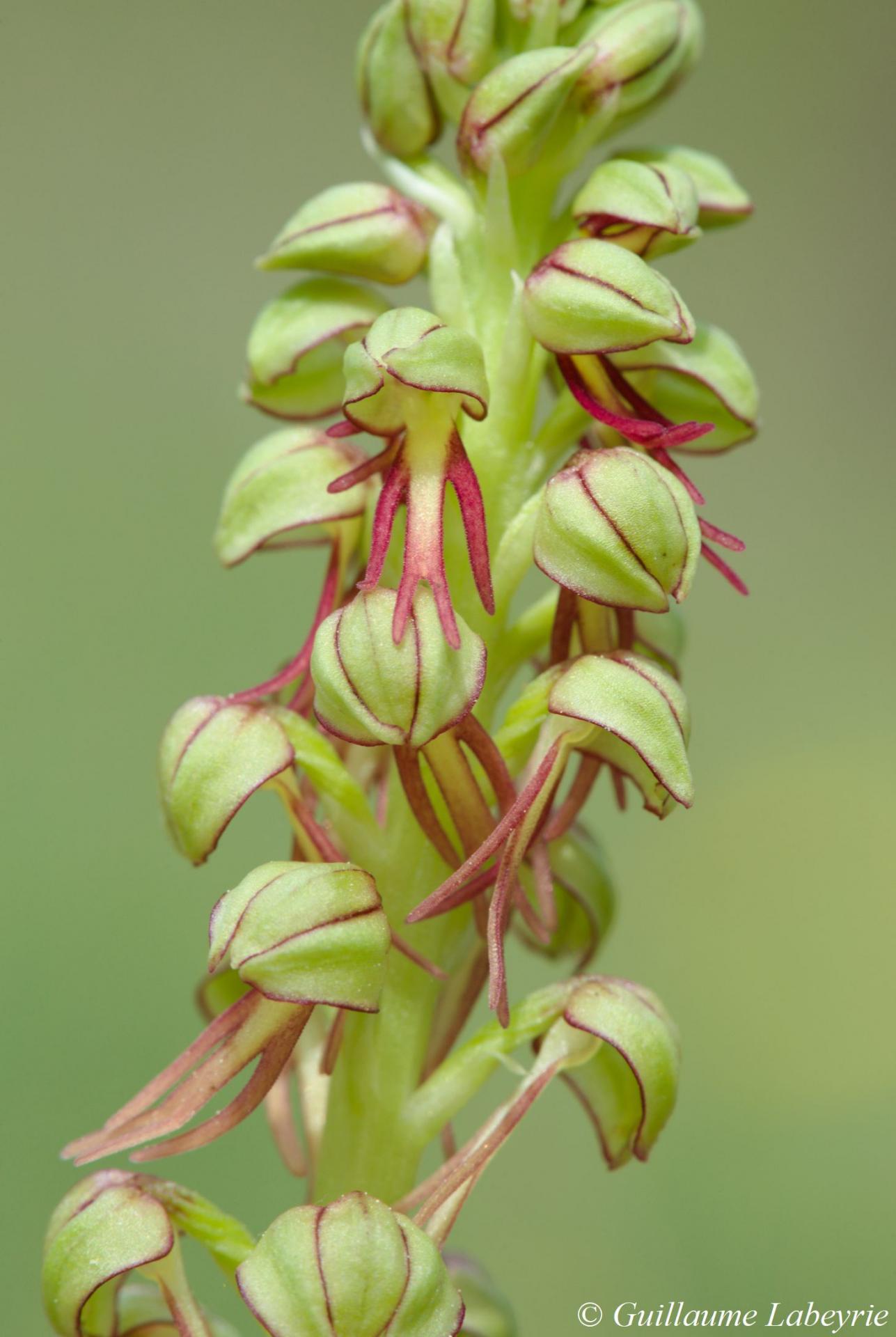 The man orchid (Orchis anthropophora). This orchid has a very characteristic appearance, with its narrow labellum with elongated, green or reddish lobes. It likes dry limestone hillsides. Distributed in central and southern Europe, it is present in France throughout the territory. It is protected in the Centre, Basse-Normandie, Haute-Normandie, Nord-Pas-de-Calais and Pays-de-la-Loire regions.
The man orchid (Orchis anthropophora). This orchid has a very characteristic appearance, with its narrow labellum with elongated, green or reddish lobes. It likes dry limestone hillsides. Distributed in central and southern Europe, it is present in France throughout the territory. It is protected in the Centre, Basse-Normandie, Haute-Normandie, Nord-Pas-de-Calais and Pays-de-la-Loire regions.
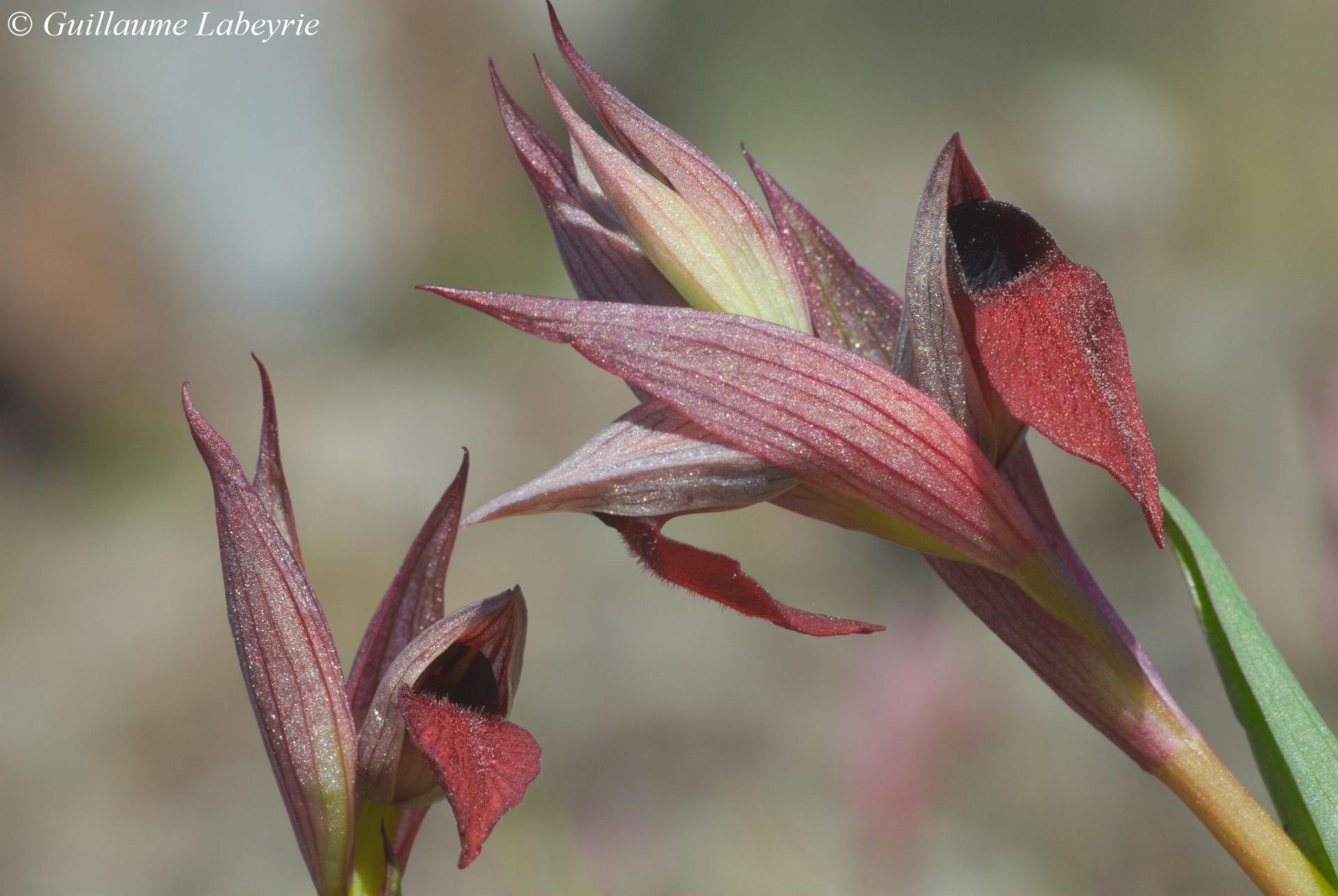 Serapias olbia. This scarce species is distinguished by small dark red flowers, with a labellum often folded backwards. It is found near the coast, in the extreme south-east of France, including Corsica. It is protected in the PACA region.
Serapias olbia. This scarce species is distinguished by small dark red flowers, with a labellum often folded backwards. It is found near the coast, in the extreme south-east of France, including Corsica. It is protected in the PACA region.
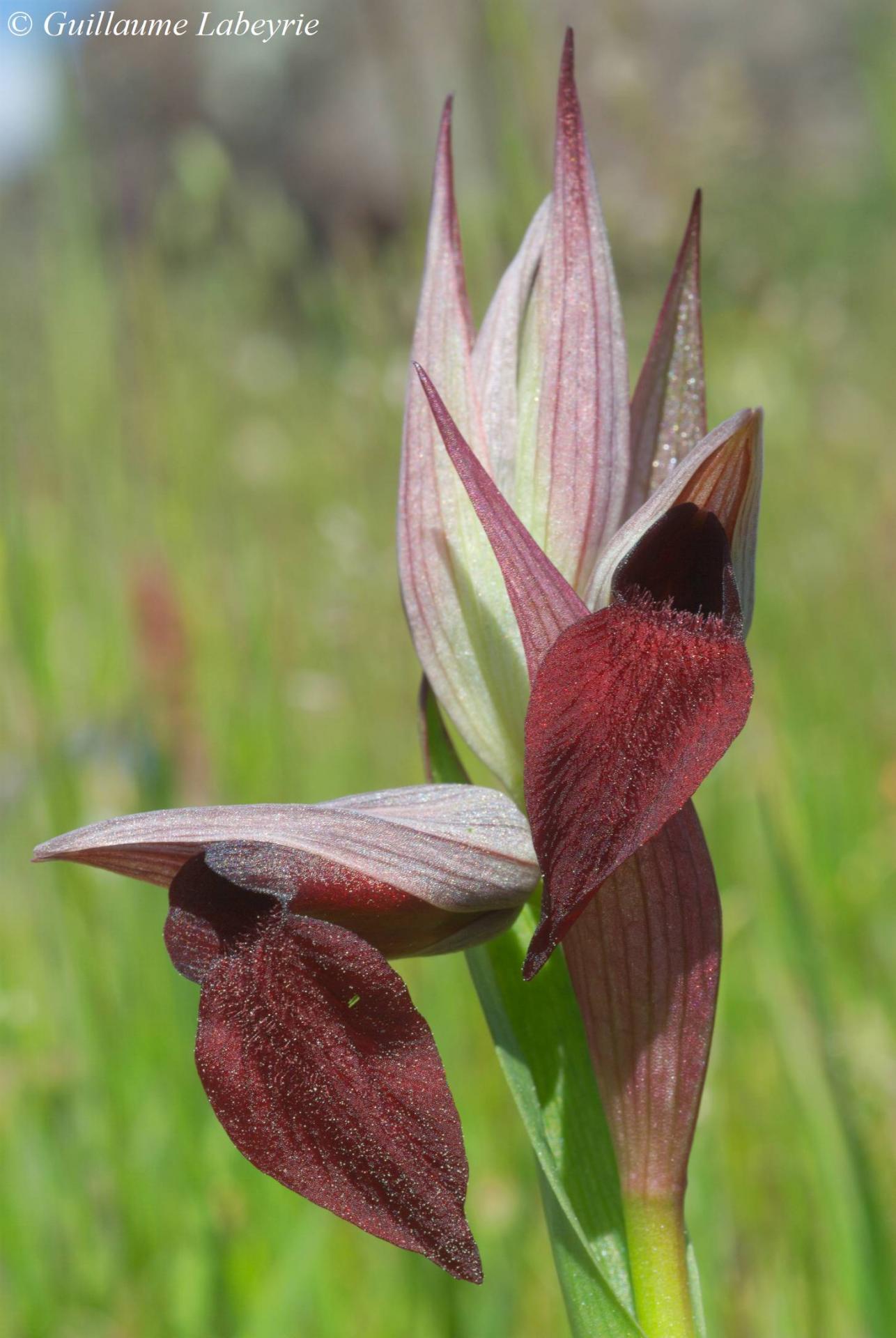 Serapias olbia.
Serapias olbia.
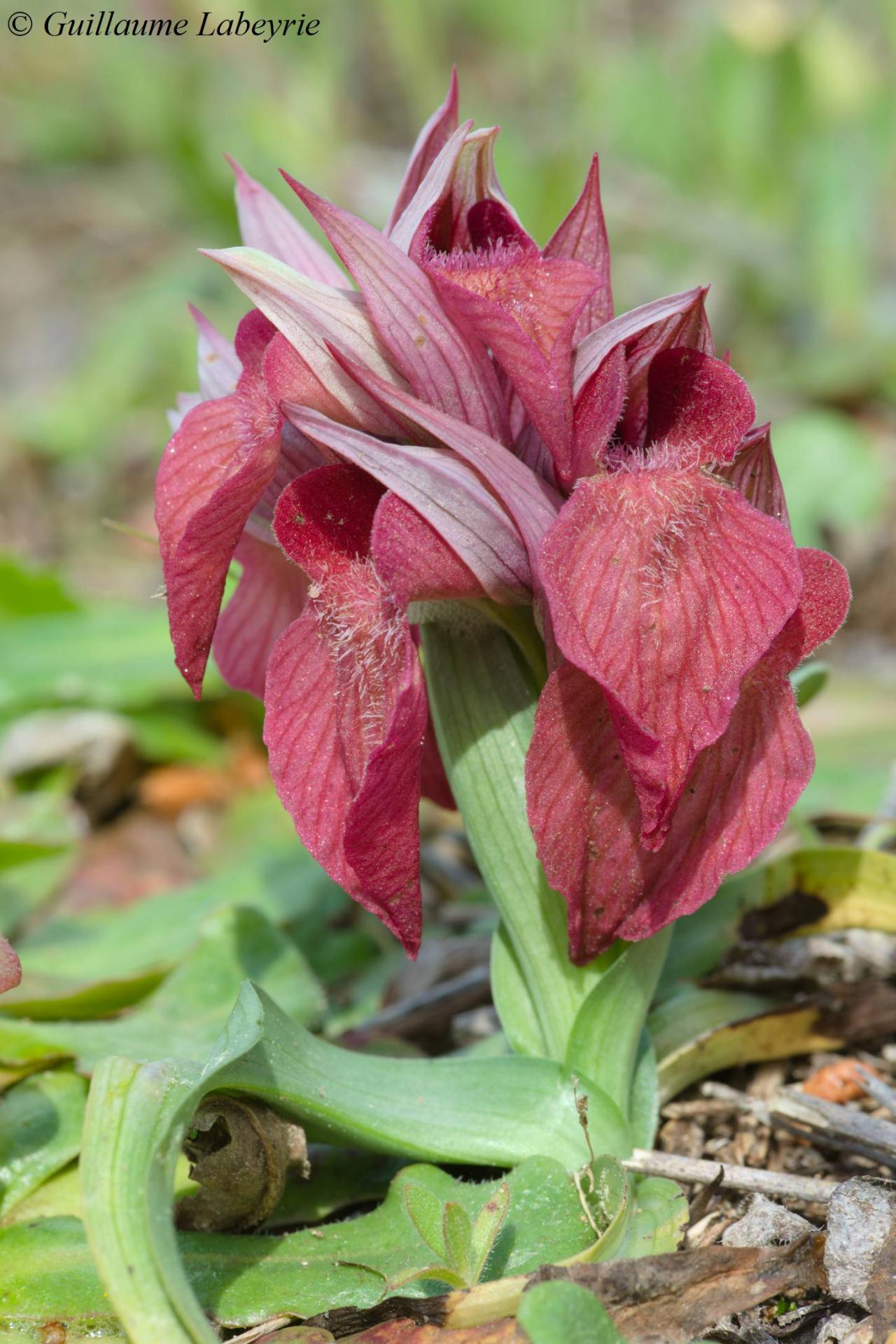 The scarce tongue orchid (Serapias neglecta). This magnificent orchid is distinguished by a very short stem and large pink flowers. It grows on sandy siliceous soils, often temporarily flooded. With a very restricted worldwide distribution (French and Italian Riviera), this rare species is only found in France in Bouches-du-Rhône, Var, Alpes-Maritimes and Corsica. It is protected on the whole territory.
The scarce tongue orchid (Serapias neglecta). This magnificent orchid is distinguished by a very short stem and large pink flowers. It grows on sandy siliceous soils, often temporarily flooded. With a very restricted worldwide distribution (French and Italian Riviera), this rare species is only found in France in Bouches-du-Rhône, Var, Alpes-Maritimes and Corsica. It is protected on the whole territory.
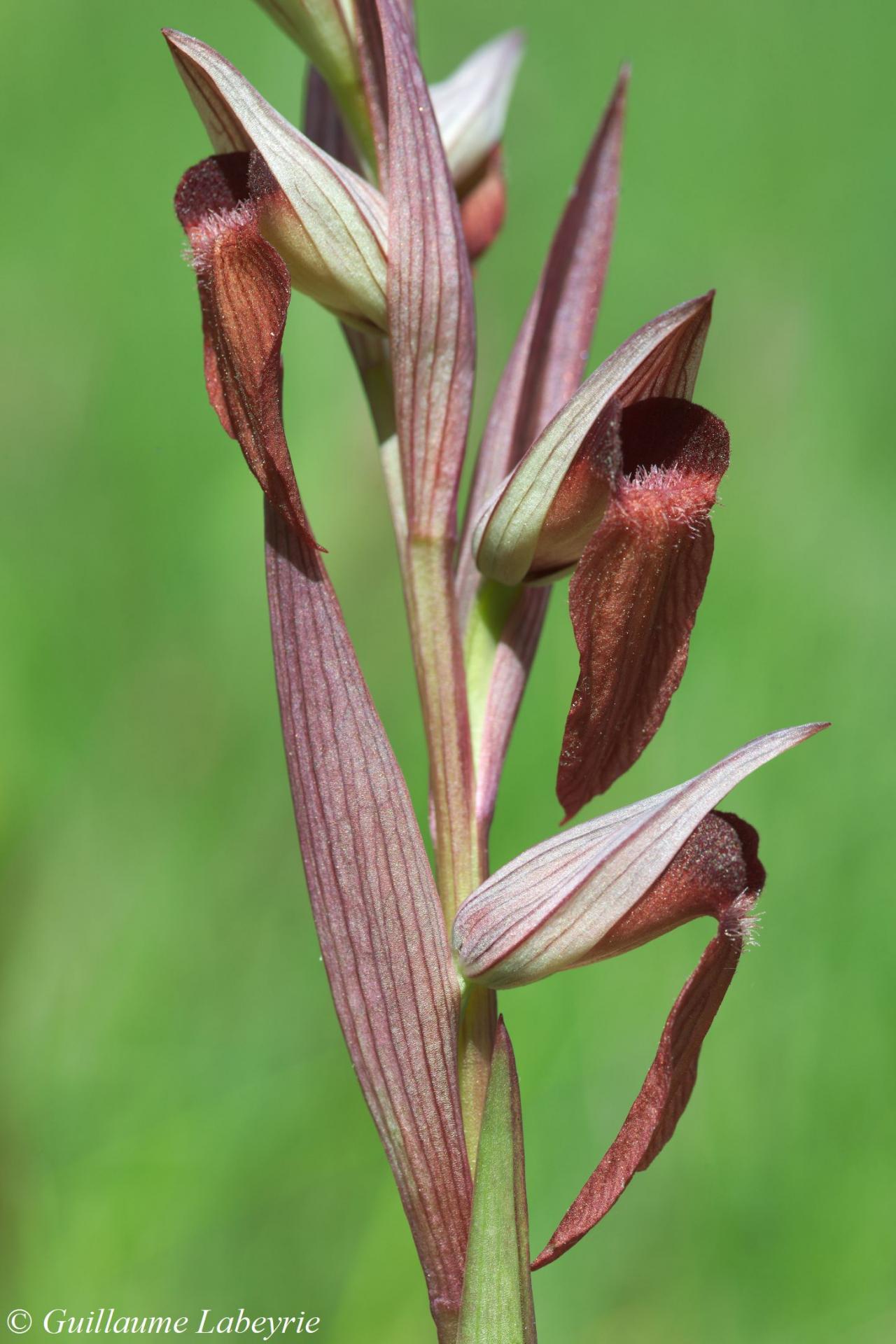 The long-lipped serapias (Serapias vomeracea). This is a rather tall Serapias, up to 40 cm high. It is much more widespread than the two previous species, and is found in a variety of environments including grasslands. Of Mediterranean distribution, it occurs in France in a southern half. It is protected in the Poitou-Charentes region.
The long-lipped serapias (Serapias vomeracea). This is a rather tall Serapias, up to 40 cm high. It is much more widespread than the two previous species, and is found in a variety of environments including grasslands. Of Mediterranean distribution, it occurs in France in a southern half. It is protected in the Poitou-Charentes region.
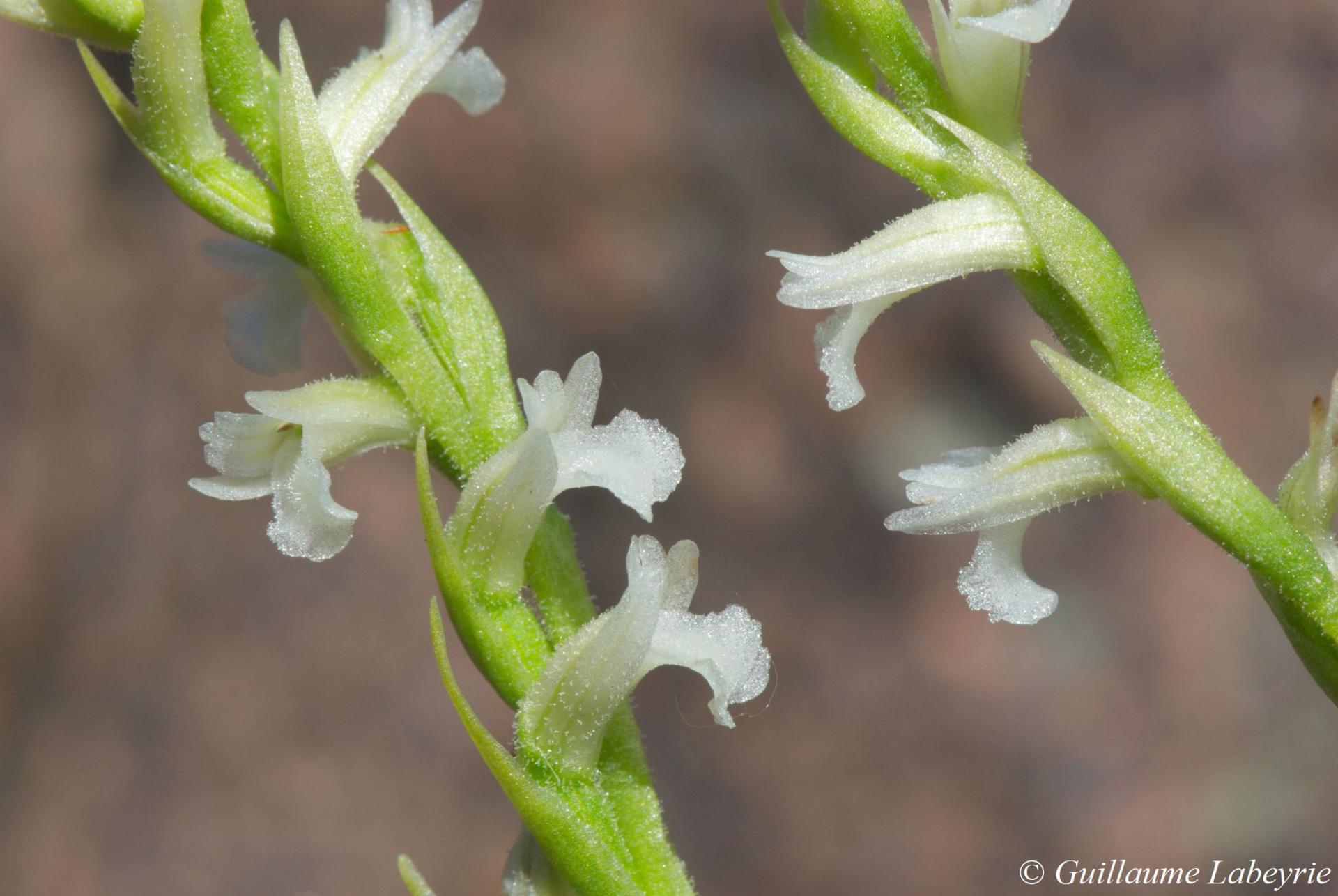 The summer lady's tresses (Spiranthes aestivalis). This small orchid cannot be confused, except with the autumn-flowering autumn lady's tresses (Spiranthes automnalis) with leaves disposed in a rosette flattened on the ground. S. aestivalis is restricted to wetlands, and is therefore experiencing a strong decline on a global scale following the destruction of these environments. In France, it is found in particular on the banks of small Mediterranean streams, in the siliceous massifs of the coast. Present in central and western Europe and in North Africa, it is found in France in a large part of the territory but is very localised and scarce. It is protected at the national level, and appears on the red list under the mention ''vulnerable''.
The summer lady's tresses (Spiranthes aestivalis). This small orchid cannot be confused, except with the autumn-flowering autumn lady's tresses (Spiranthes automnalis) with leaves disposed in a rosette flattened on the ground. S. aestivalis is restricted to wetlands, and is therefore experiencing a strong decline on a global scale following the destruction of these environments. In France, it is found in particular on the banks of small Mediterranean streams, in the siliceous massifs of the coast. Present in central and western Europe and in North Africa, it is found in France in a large part of the territory but is very localised and scarce. It is protected at the national level, and appears on the red list under the mention ''vulnerable''.
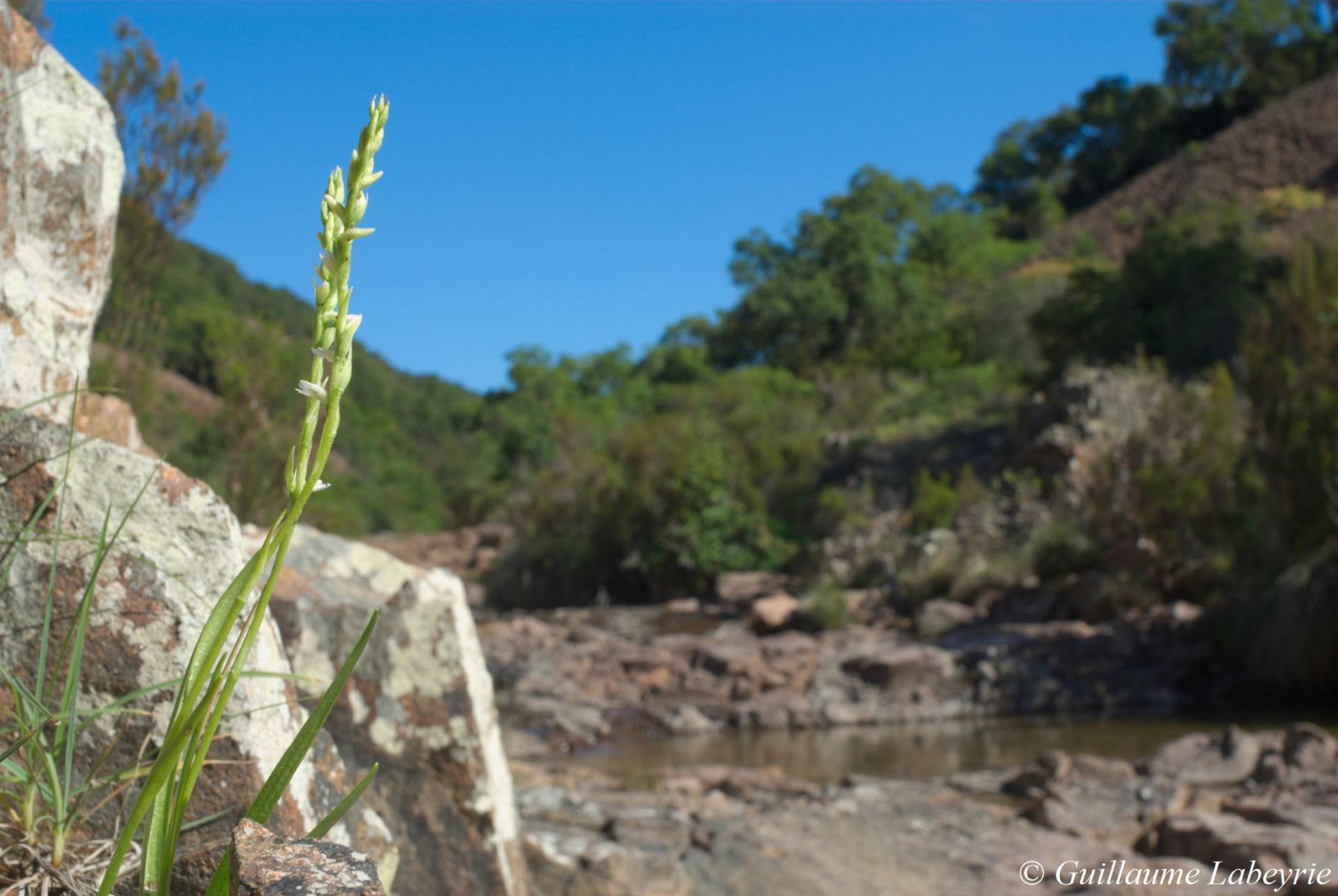
The summer lady's tresses (Spiranthes aestivalis).
Family : Osmundaceae
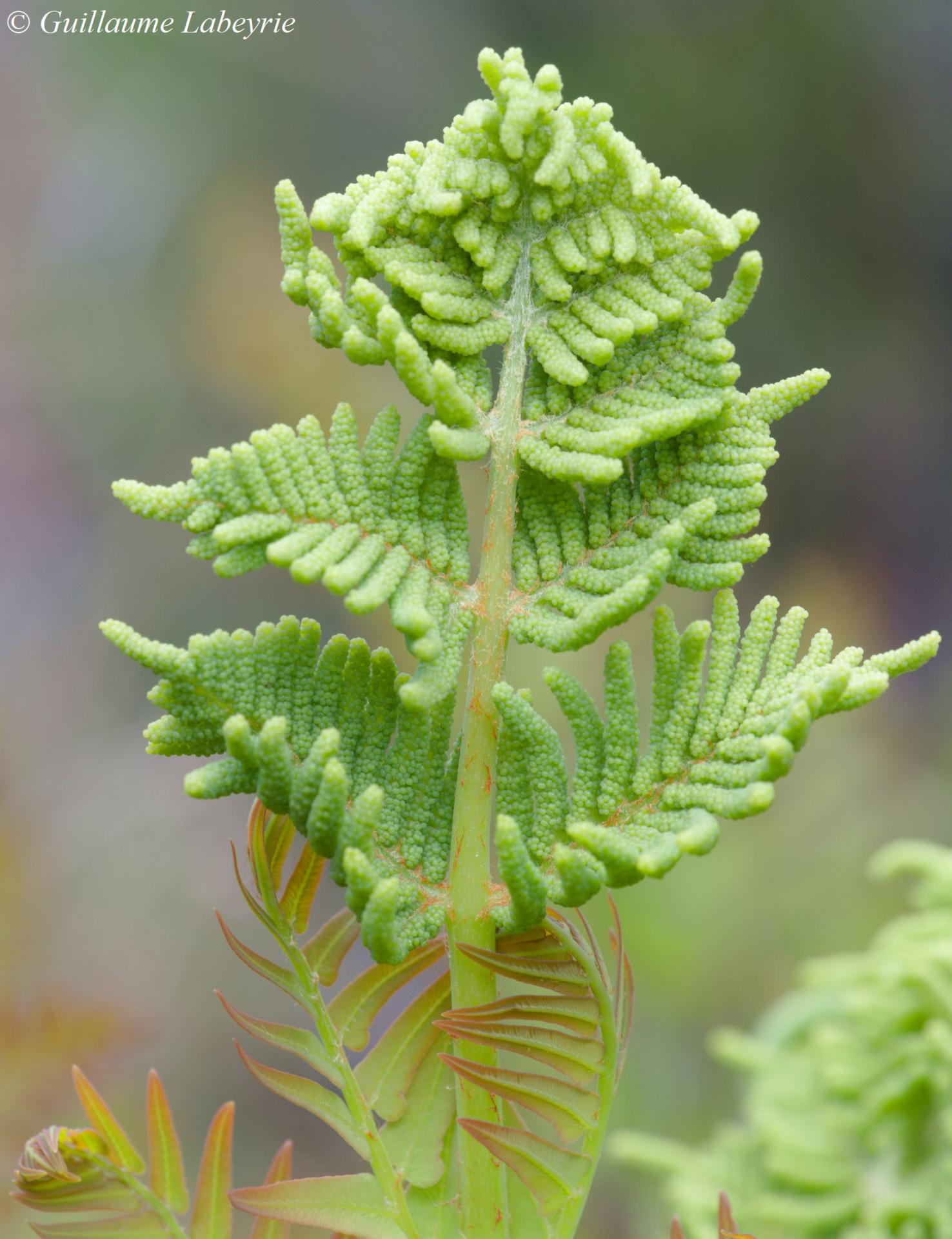 The royal fern (Osmunda regalis). The fronds of this magnificent fern can reach 2 m in height. The upper part is fertile and bears the sporangia, as shown in this photo. This species likes damp places, especially the banks of streams. Widely distributed worldwide, it is present in France over a major part of the territory. It is protected in many regions including PACA, where it is rare.
The royal fern (Osmunda regalis). The fronds of this magnificent fern can reach 2 m in height. The upper part is fertile and bears the sporangia, as shown in this photo. This species likes damp places, especially the banks of streams. Widely distributed worldwide, it is present in France over a major part of the territory. It is protected in many regions including PACA, where it is rare.
Family : Pinaceae
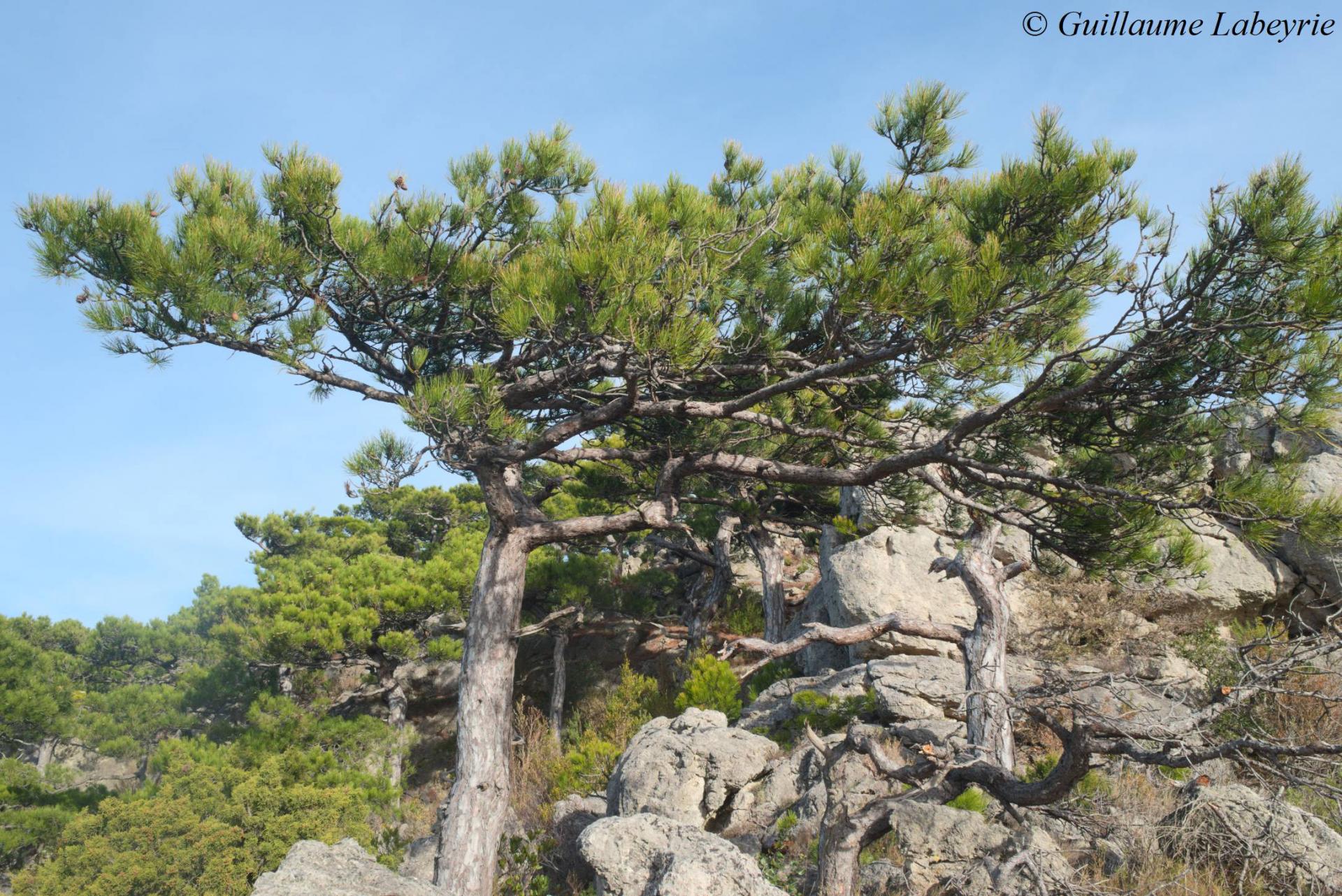 Cevennes black pine (Pinus nigra subsp. salzmannii). This pine is a subspecies of the black pine, just like the Corsican pine (Pinus nigra subsp. laricio). It is found on limestone or siliceous ridges. The differentiation of the various subspecies of the black pine is rather delicate, the Cevennes black pine being notably devoid of needles at the base of the branches. The needles are light yellowish green. In sharp decline, this tree is mainly present in Spain and only survives in France in a few populations in the foothills of the Cévennes and the Pyrénées-Orientales. The most beautiful forest is located above St-Guilhem-le-Désert, in Hérault. This pine is on the national red list with the mention ''near-threatened''.
Cevennes black pine (Pinus nigra subsp. salzmannii). This pine is a subspecies of the black pine, just like the Corsican pine (Pinus nigra subsp. laricio). It is found on limestone or siliceous ridges. The differentiation of the various subspecies of the black pine is rather delicate, the Cevennes black pine being notably devoid of needles at the base of the branches. The needles are light yellowish green. In sharp decline, this tree is mainly present in Spain and only survives in France in a few populations in the foothills of the Cévennes and the Pyrénées-Orientales. The most beautiful forest is located above St-Guilhem-le-Désert, in Hérault. This pine is on the national red list with the mention ''near-threatened''.
Family : Plantaginaceae
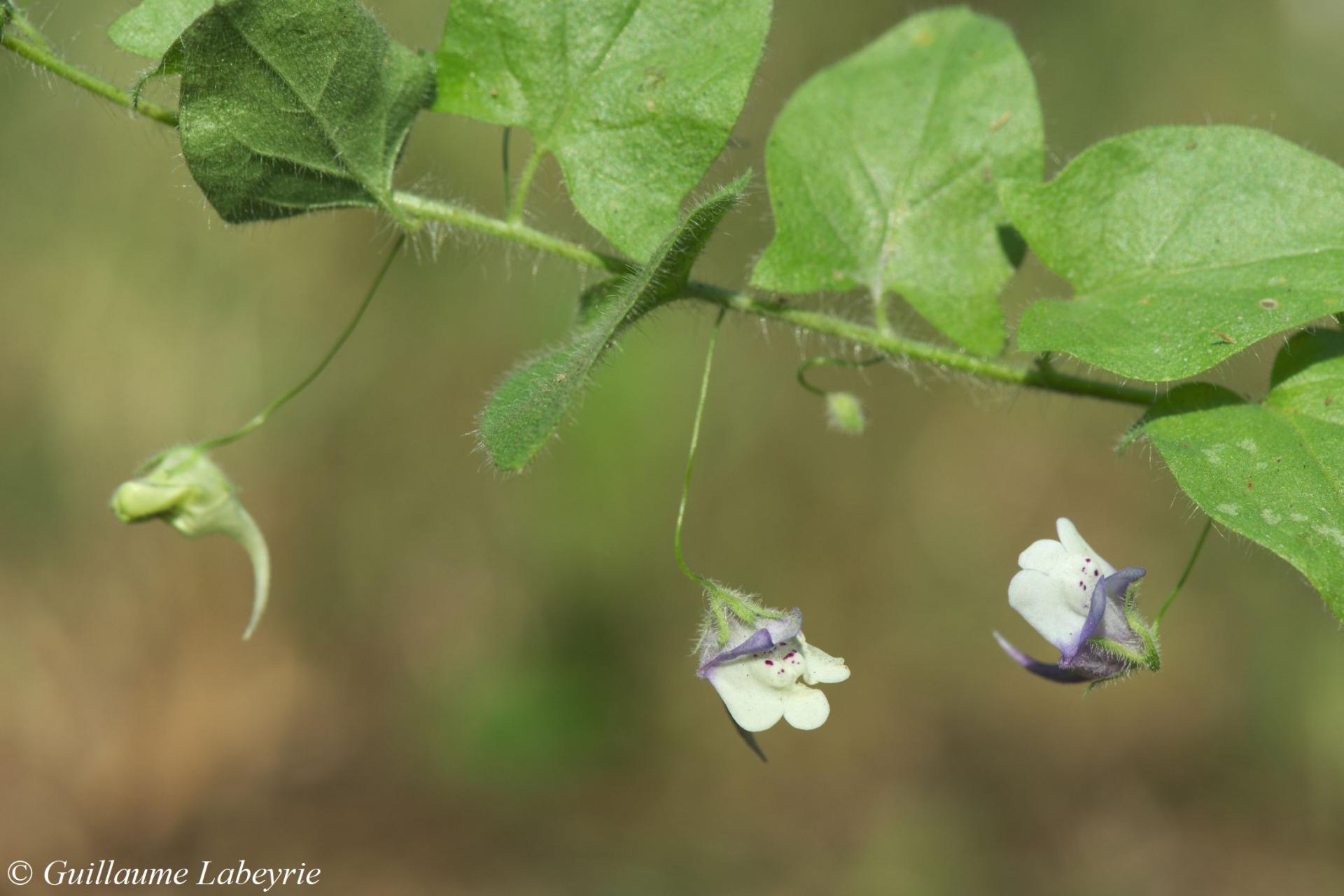 Kickxia commutata. This inconspicuous plant grows lying on the ground. It has hasted leaves and white and purple flowers, with a strongly curved spur. It can be found in different environments, including olive groves and sandy places. With a circum-Mediterranean distribution, this toadflax is present in France mainly on the Mediterranean coast (with isolated populations in Brittany, Gironde and Pyrénées-Atlantiques). It is nationally protected.
Kickxia commutata. This inconspicuous plant grows lying on the ground. It has hasted leaves and white and purple flowers, with a strongly curved spur. It can be found in different environments, including olive groves and sandy places. With a circum-Mediterranean distribution, this toadflax is present in France mainly on the Mediterranean coast (with isolated populations in Brittany, Gironde and Pyrénées-Atlantiques). It is nationally protected.
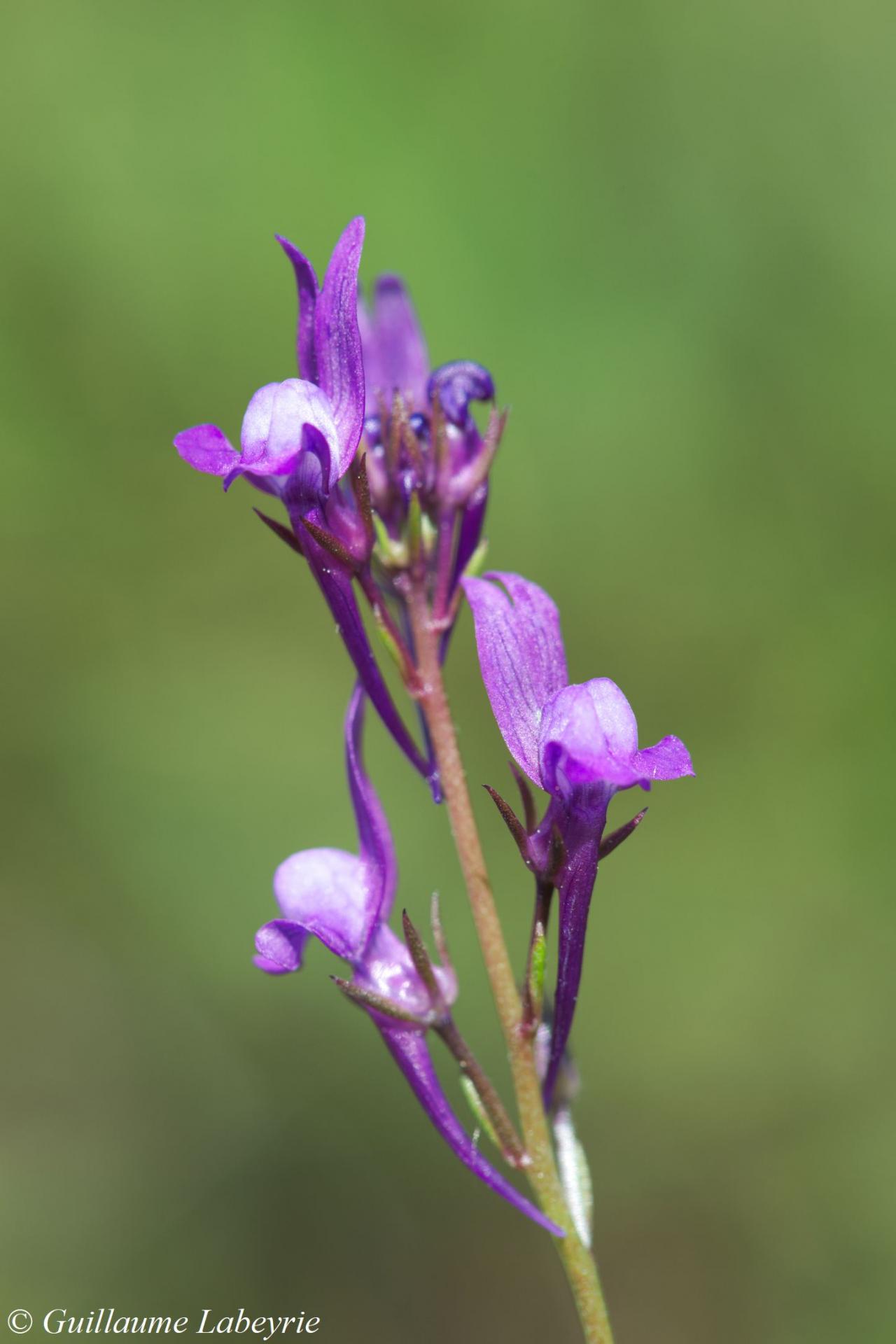 Pellisser's toadflax (Linaria pelisseriana). This toadflax can be identified by its small, straight-spurred purple flowers clustered at the top of an erect stem. It is found in dry and sandy places. It is present in Southern Europe, Asia Minor and Algeria, and in France in the West, Center and South. It is protected in the Aquitaine region.
Pellisser's toadflax (Linaria pelisseriana). This toadflax can be identified by its small, straight-spurred purple flowers clustered at the top of an erect stem. It is found in dry and sandy places. It is present in Southern Europe, Asia Minor and Algeria, and in France in the West, Center and South. It is protected in the Aquitaine region.
 The shrubby globularia (Globularia alypum). This large globularia forms upright bushes with ash-blue flowers. It grows in dry and rocky places. Flowering is often very early, starting in January. Of circummediterranean distribution, this plant is found in France in the South.
The shrubby globularia (Globularia alypum). This large globularia forms upright bushes with ash-blue flowers. It grows in dry and rocky places. Flowering is often very early, starting in January. Of circummediterranean distribution, this plant is found in France in the South.
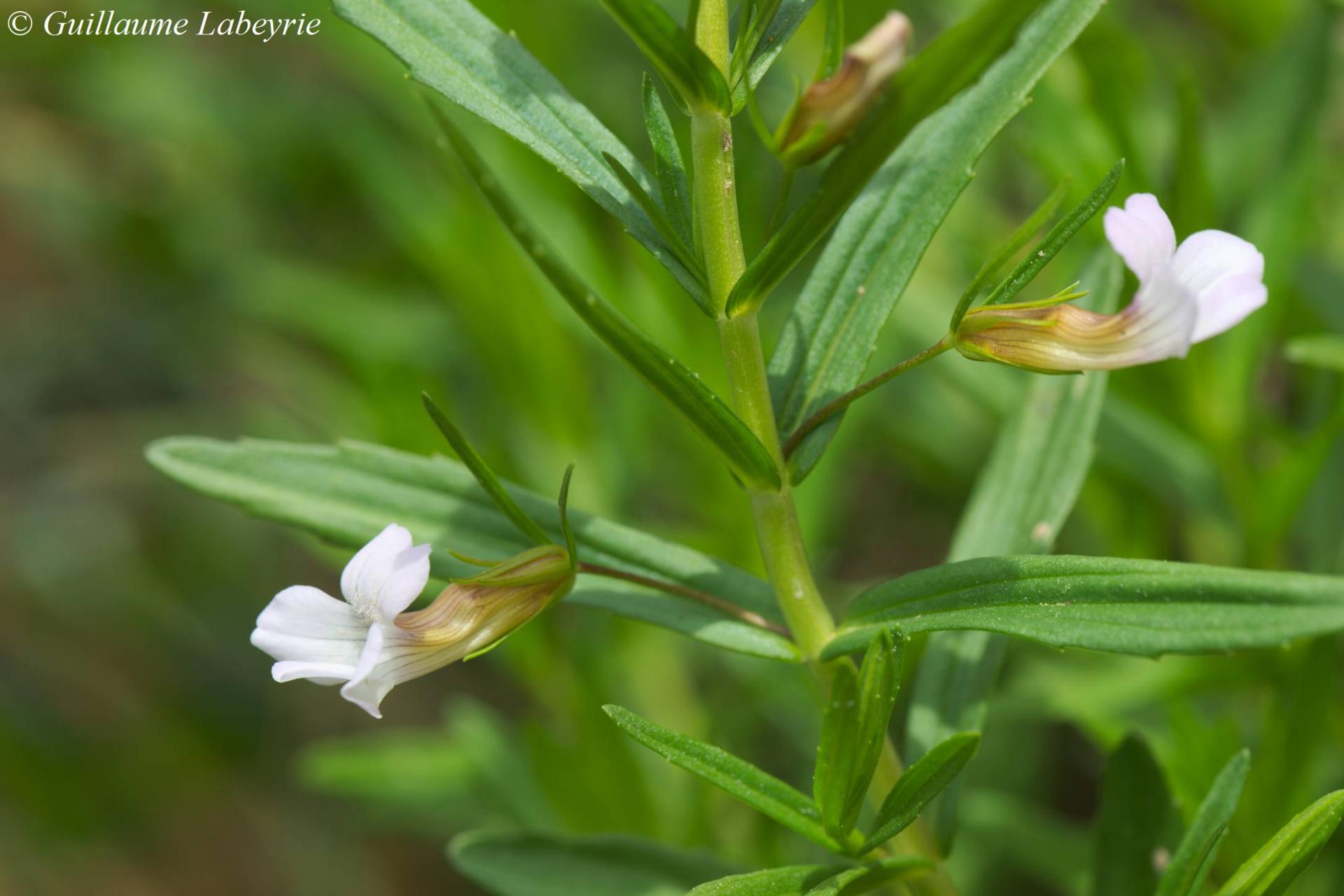 The hedge hyssop (Gratiola officinalis). This plant with characteristic white or pink flowers cannot be confused. It is found in wet meadows and, in the southeast, on the banks of small Mediterranean streams. Distributed throughout Europe as far as Russia, it is present in most of France. It is protected at the national level.
The hedge hyssop (Gratiola officinalis). This plant with characteristic white or pink flowers cannot be confused. It is found in wet meadows and, in the southeast, on the banks of small Mediterranean streams. Distributed throughout Europe as far as Russia, it is present in most of France. It is protected at the national level.
Family : Pteridaceae
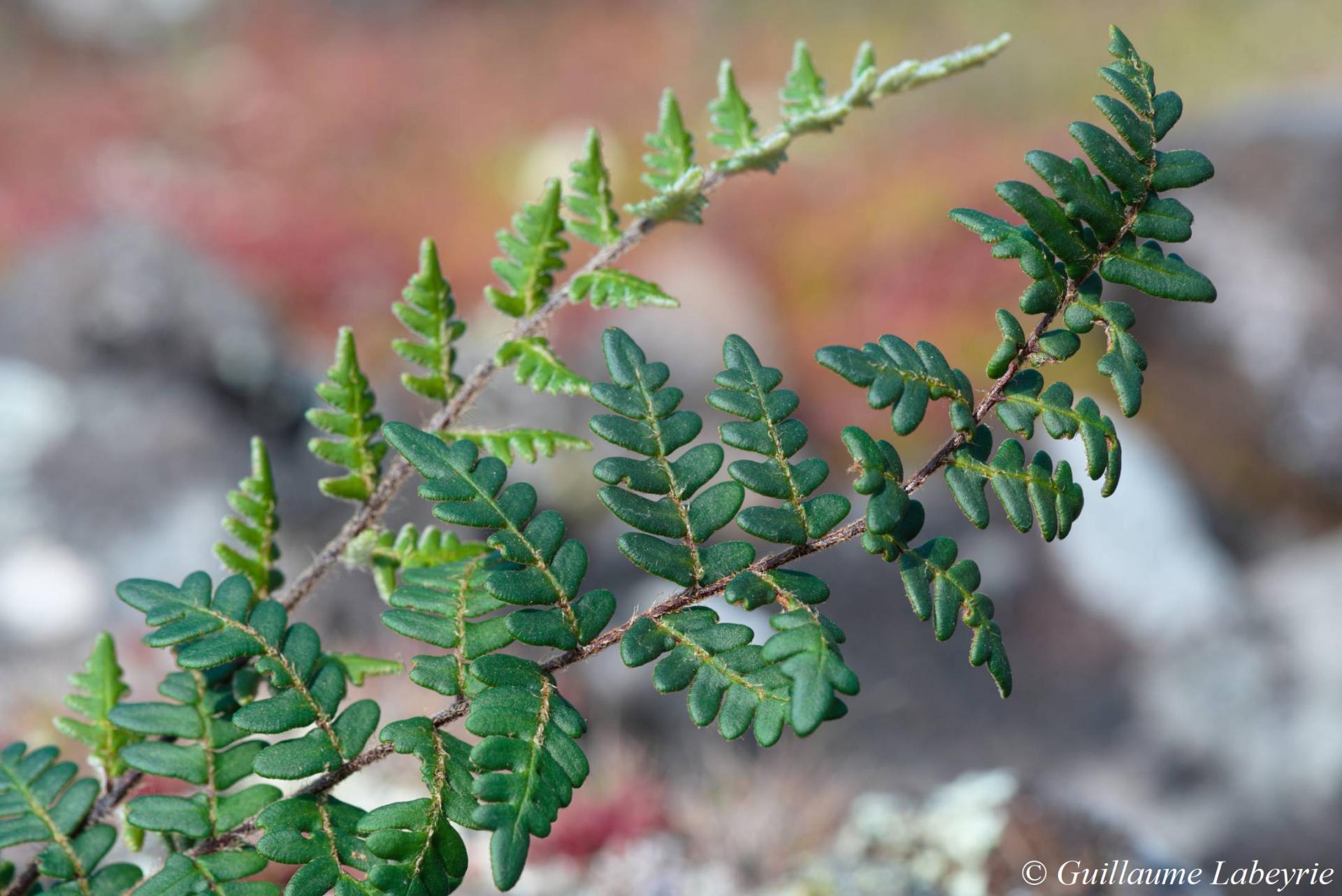 The hardy cloak fern (Paragymnopteris marantae). This small fern with downy stems and dark green fronds (except the young ones which are pale) grows in dry siliceous rocks. It has a wide worldwide distribution. It is observed in France mainly in the Massif Central, on the Côte d'Azur and in Corsica. It is protected in the Midi-Pyrénées, Limousin, Auvergne and PACA regions.
The hardy cloak fern (Paragymnopteris marantae). This small fern with downy stems and dark green fronds (except the young ones which are pale) grows in dry siliceous rocks. It has a wide worldwide distribution. It is observed in France mainly in the Massif Central, on the Côte d'Azur and in Corsica. It is protected in the Midi-Pyrénées, Limousin, Auvergne and PACA regions.
Family : Ranunculaceae
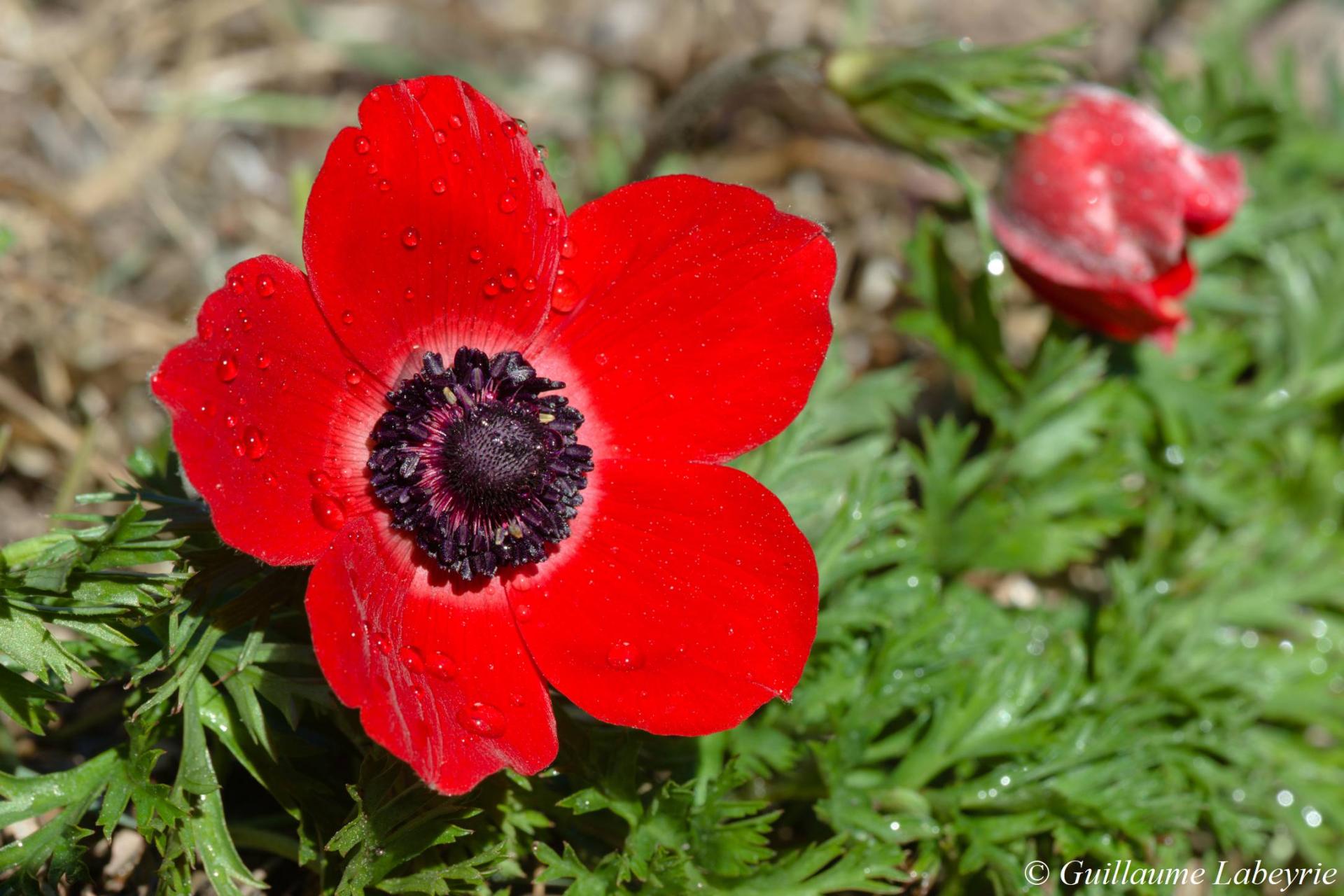 The poppy anemone (Anemone coronaria). This stunning anemone grows locally in olive fields, especially in the area near Grasse (Alpes-Maritimes). Its large flowers of an intense red bloom in March-April. This species occurs in Mediterranean countries, and in France only in the south. It is a protected species.
The poppy anemone (Anemone coronaria). This stunning anemone grows locally in olive fields, especially in the area near Grasse (Alpes-Maritimes). Its large flowers of an intense red bloom in March-April. This species occurs in Mediterranean countries, and in France only in the south. It is a protected species.
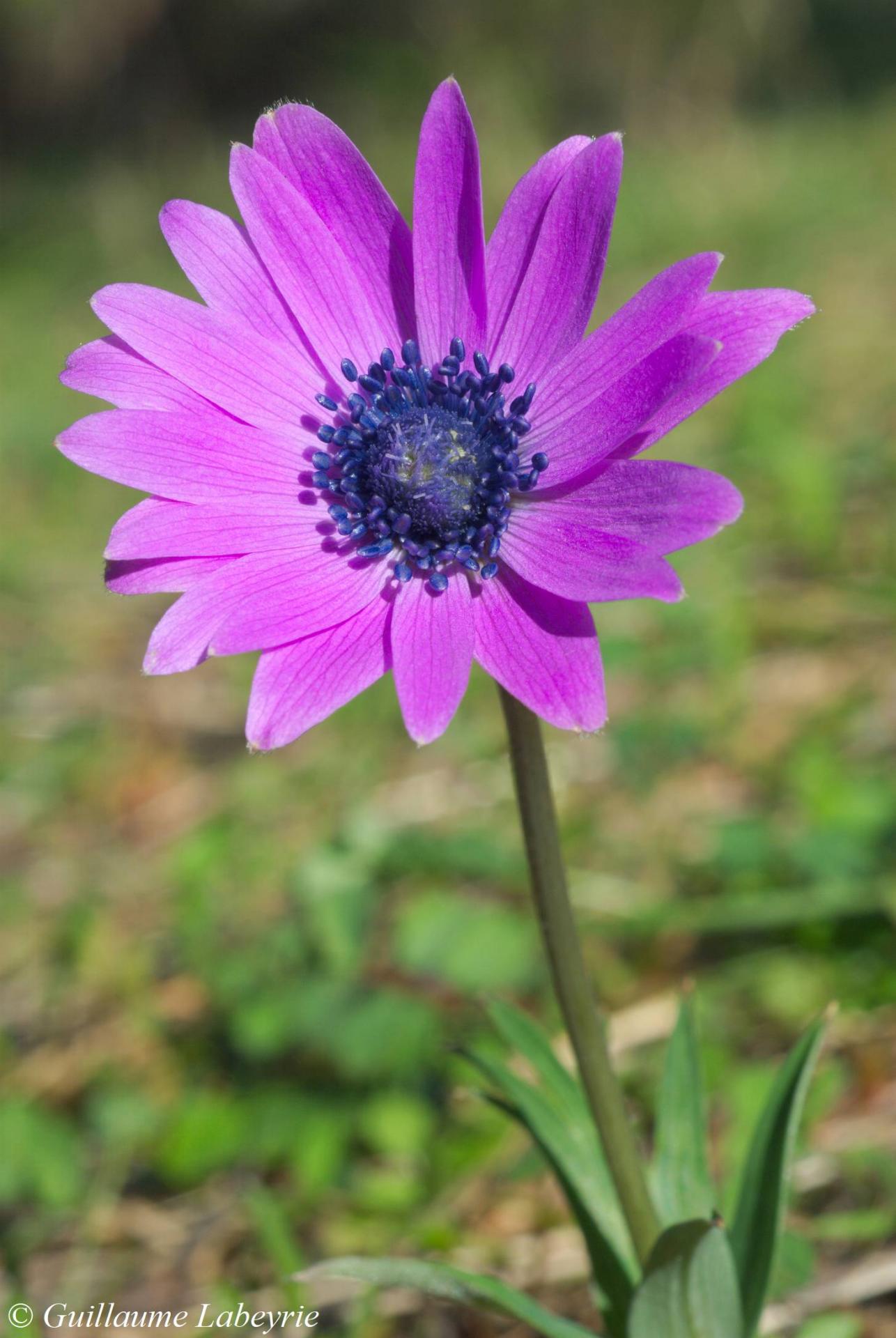 The broad-leaved anemone (Anemone hortensis). Much more common than the previous species, this pretty anemone is found in the same habitat, for instance in olive fields. It flowers early, staring from February. This plant is found in southern Europe and Minor Asia. In France, it is present in the south.
The broad-leaved anemone (Anemone hortensis). Much more common than the previous species, this pretty anemone is found in the same habitat, for instance in olive fields. It flowers early, staring from February. This plant is found in southern Europe and Minor Asia. In France, it is present in the south.
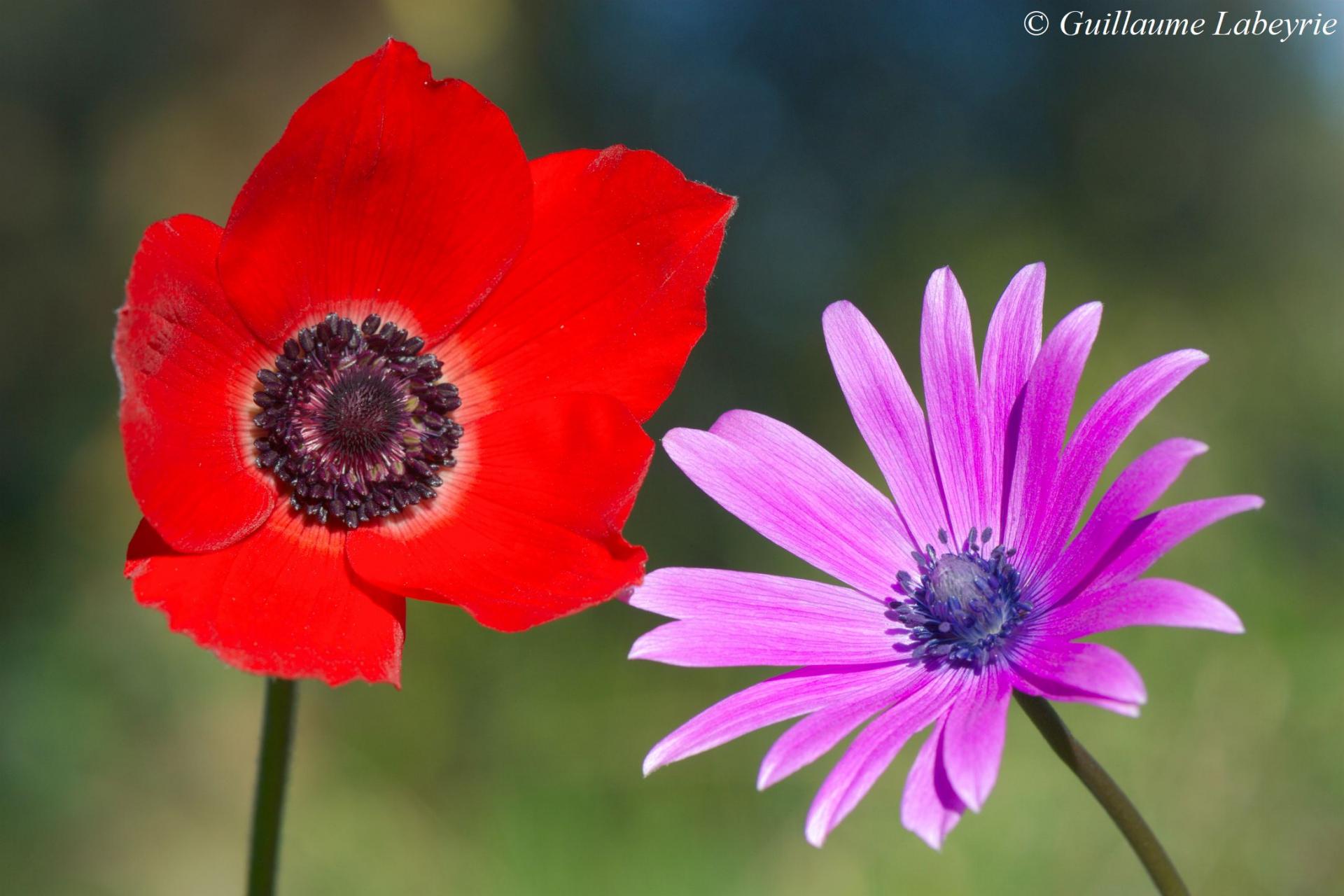 The two anemones.
The two anemones.
Family : Selaginellaceae
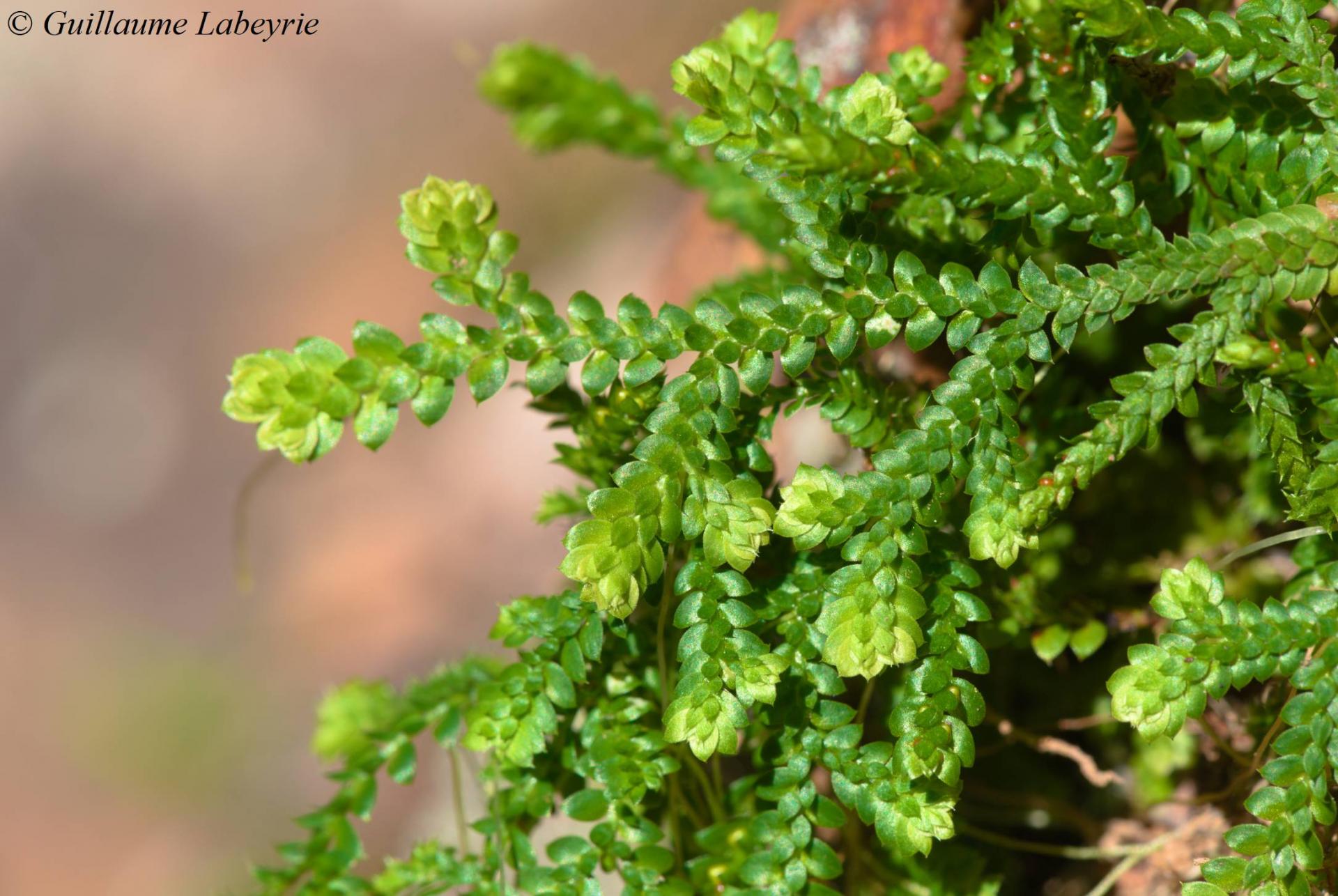 The toothed-leaved clubmoss (Selaginella denticulata). This tiny fern forms scaly-looking branches flattened to the ground. The ''scales'' are terminated by a small tooth. In dry weather, the plant turns orange. This circum-Mediterranean species appreciates the shaded areas of the maquis and the banks of small streams. Rather rare in France, it is mainly present on the Côte d'Azur and in Corsica. It is protected in Languedoc-Roussillon.
The toothed-leaved clubmoss (Selaginella denticulata). This tiny fern forms scaly-looking branches flattened to the ground. The ''scales'' are terminated by a small tooth. In dry weather, the plant turns orange. This circum-Mediterranean species appreciates the shaded areas of the maquis and the banks of small streams. Rather rare in France, it is mainly present on the Côte d'Azur and in Corsica. It is protected in Languedoc-Roussillon.
Family : Solanaceae
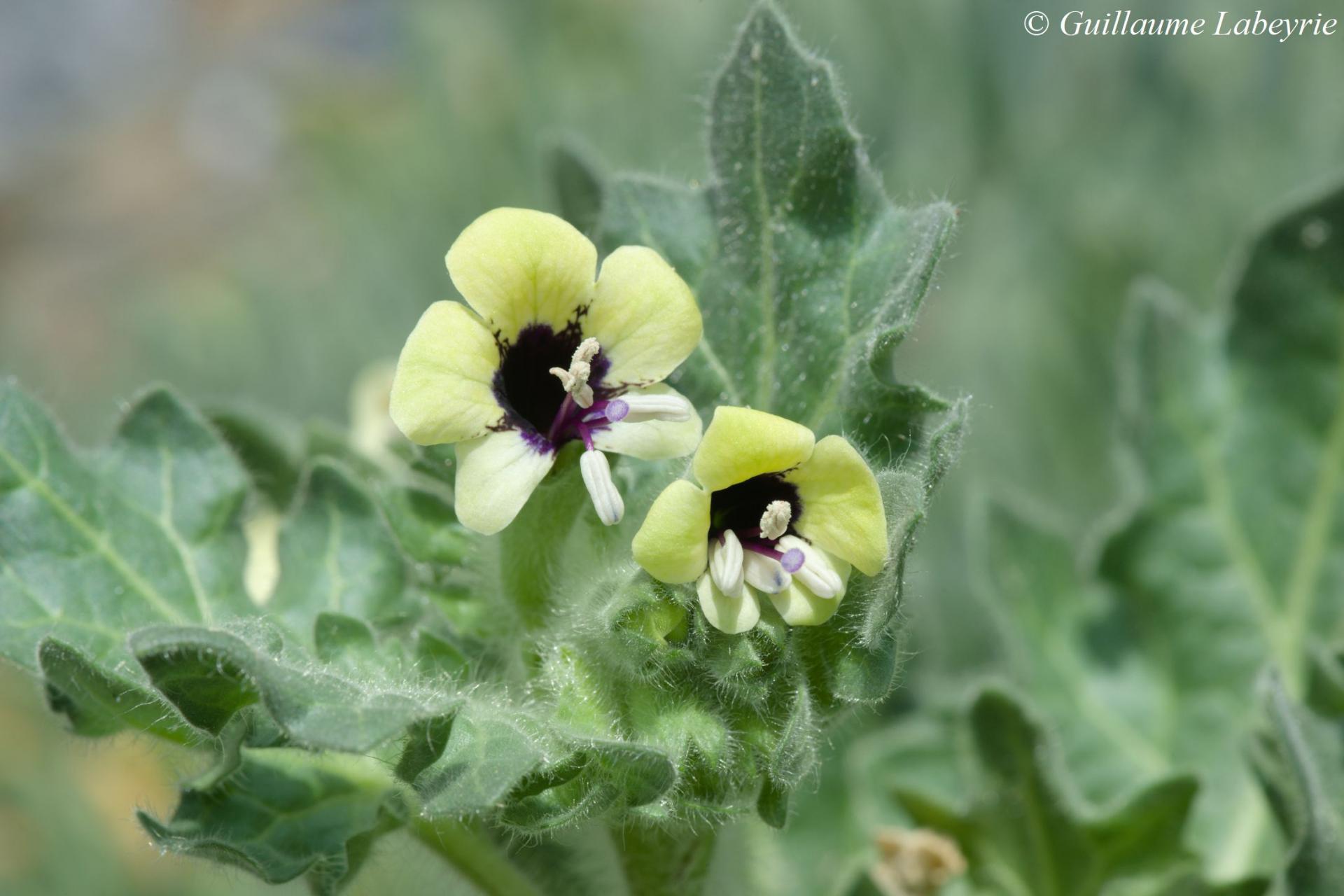 The white henbane (Hyoscyamus albus). This spectacular plant is found in dry rocky places, often near the sea. Like many members of the Solanaceae family, it is highly poisonous. Native to the Mediterranean Basin, it is observed in France in the South.
The white henbane (Hyoscyamus albus). This spectacular plant is found in dry rocky places, often near the sea. Like many members of the Solanaceae family, it is highly poisonous. Native to the Mediterranean Basin, it is observed in France in the South.
Family : Thymeleaceae
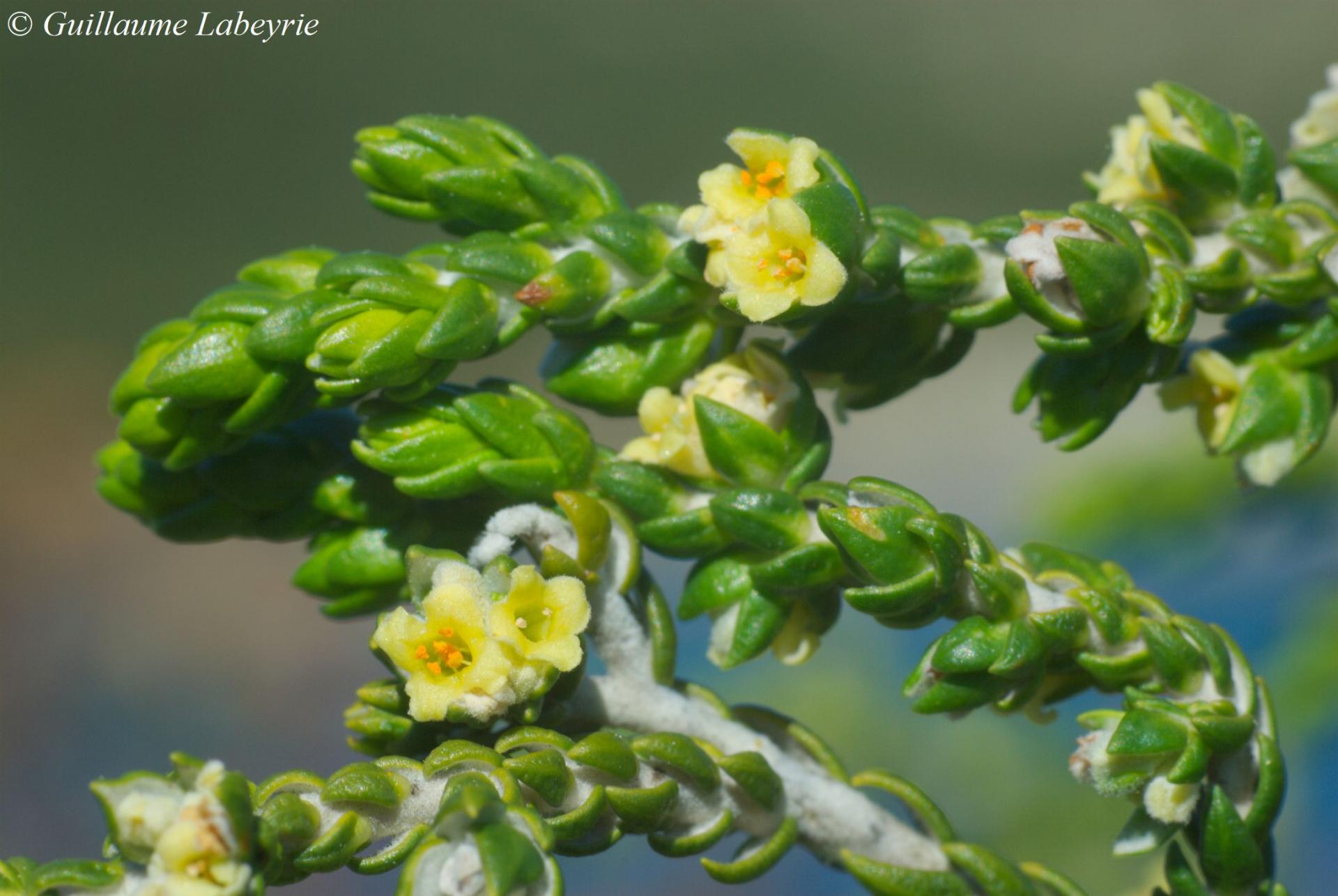 Thymelaea hirsuta. This strange shrub is found in arid places along the coast, in areas submitted to sea spray. It is very toxic. Occurring throughout the Mediterranean basin, this species is found in France only along the Mediterranean coast. It is protected in the PACA region.
Thymelaea hirsuta. This strange shrub is found in arid places along the coast, in areas submitted to sea spray. It is very toxic. Occurring throughout the Mediterranean basin, this species is found in France only along the Mediterranean coast. It is protected in the PACA region.
Family : Vitaceae
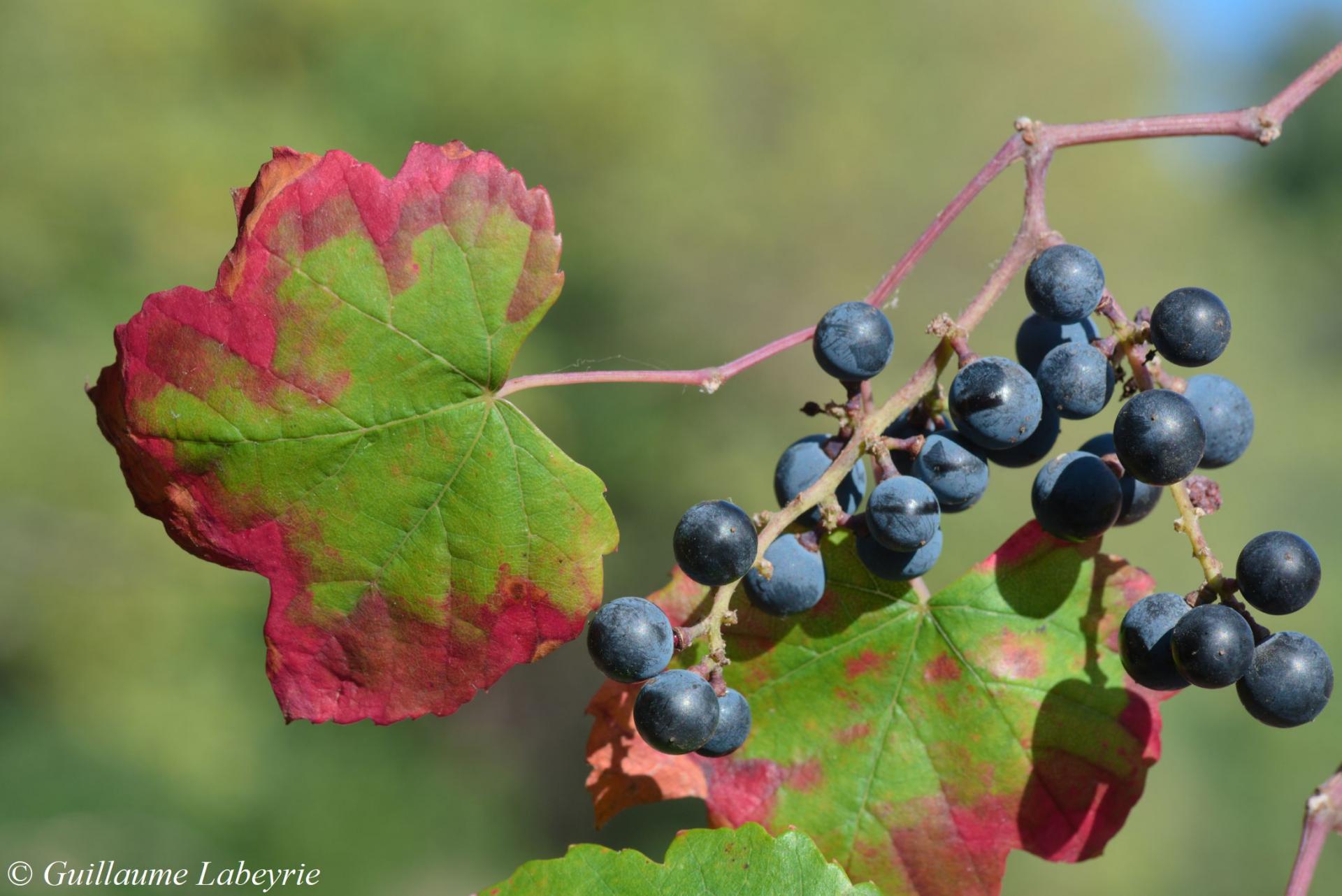 The European woodland grapevine (Vitis vinifera subsp. sylvestris). This wild vine, probably the ancestor of the domestic vine, is a liana reaching more than 20 meters that climbs in the canopy of trees. In the region, it appreciates the riparian forests in siliceous or calcareous soil. Observed in France here and there, it is protected at the national level.
The European woodland grapevine (Vitis vinifera subsp. sylvestris). This wild vine, probably the ancestor of the domestic vine, is a liana reaching more than 20 meters that climbs in the canopy of trees. In the region, it appreciates the riparian forests in siliceous or calcareous soil. Observed in France here and there, it is protected at the national level.
Fungi and lichens
Family : Amanitaceae
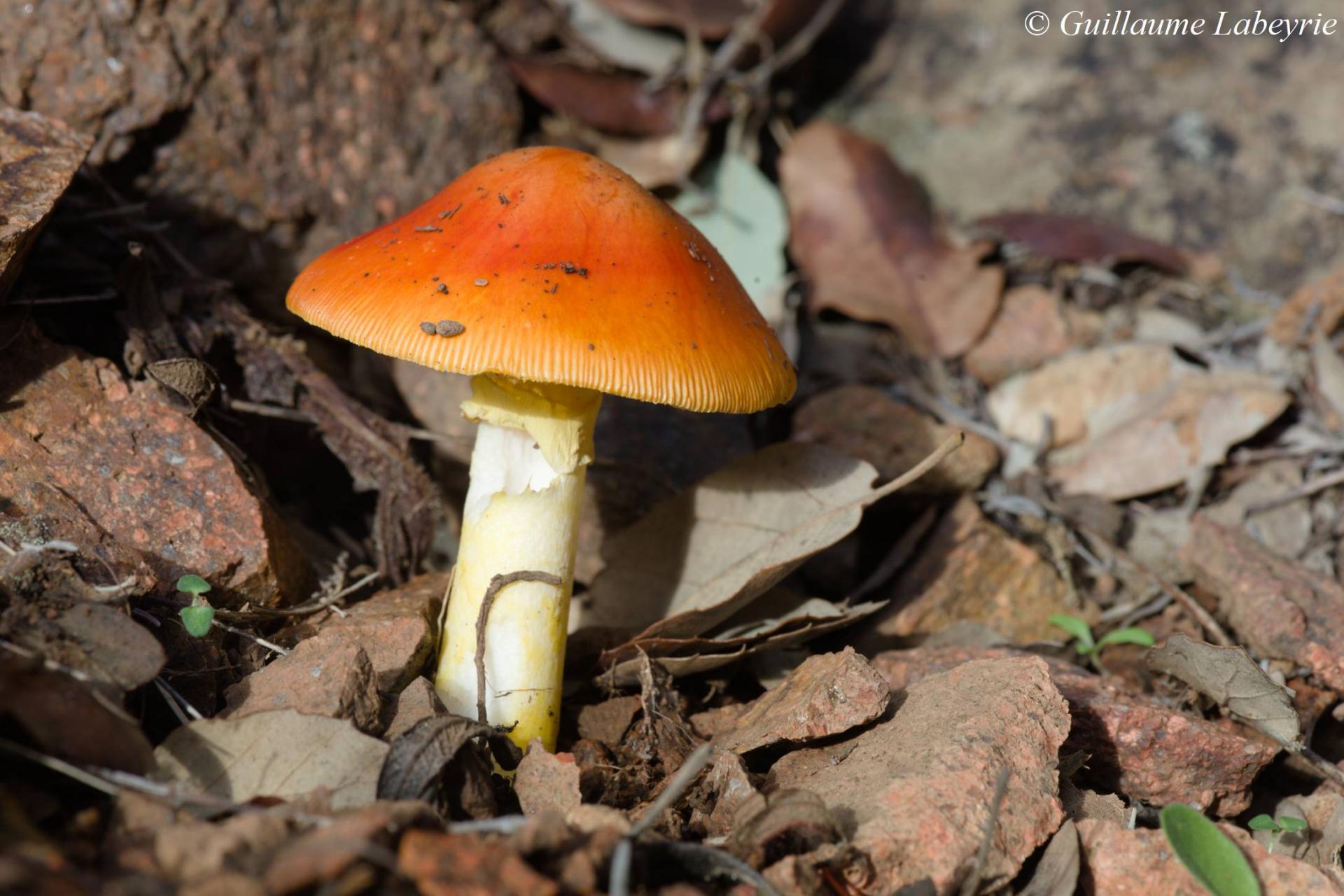 Caesar's mushroom (Amanita caesarea). This beautiful species is distinguished by its orange cap and golden yellow gills and foot. This last characteristic is very important to differentiate it from the fly agaric (Amanita muscaria), which can sometimes lose the white fragments of volva that dot its cap after a rain. This rather uncommon southern mushroom appreciates light woods of pubescent oak, holm oak or cork oak. It is an excellent edible, which can be eaten raw. It is present in a large part of France.
Caesar's mushroom (Amanita caesarea). This beautiful species is distinguished by its orange cap and golden yellow gills and foot. This last characteristic is very important to differentiate it from the fly agaric (Amanita muscaria), which can sometimes lose the white fragments of volva that dot its cap after a rain. This rather uncommon southern mushroom appreciates light woods of pubescent oak, holm oak or cork oak. It is an excellent edible, which can be eaten raw. It is present in a large part of France.
Family : Cantharellaceae
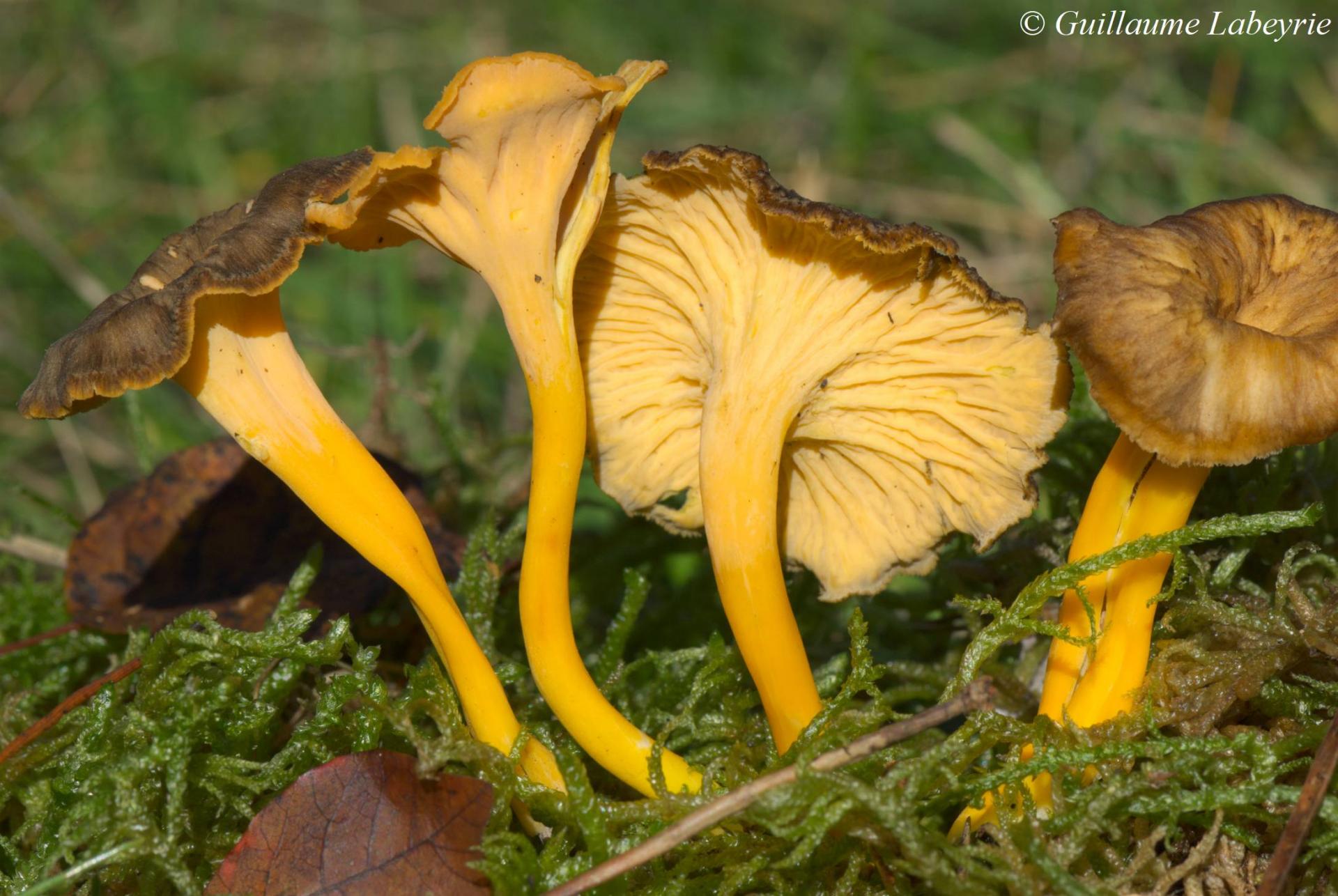 The yellow foot (Cantharellus lutescens). This mushroom grows on humid slopes in coniferous forests, both at near the sea and in low mountain ranges. With a subtle flavor and easily preserved by drying, often very abundant in its locations, this is one of the favourite mushroom in the south-east of France.
The yellow foot (Cantharellus lutescens). This mushroom grows on humid slopes in coniferous forests, both at near the sea and in low mountain ranges. With a subtle flavor and easily preserved by drying, often very abundant in its locations, this is one of the favourite mushroom in the south-east of France.
Lichens
Lichens are amazing organisms resulting from the association of a fungus (constituting the major part of the organism, which provides water and mineral salts) and a green algae (or more rarely a cyanobacterium), which absorbs dioxide carbon and synthesizes organic matter through photosynthesis. About 2500 species are present in France, with a remarkable diversity of textures, shapes and colors. The determination of lichens, which often involves the reaction to certain chemicals, is a matter for specialists !
Family : Acarosporaceae
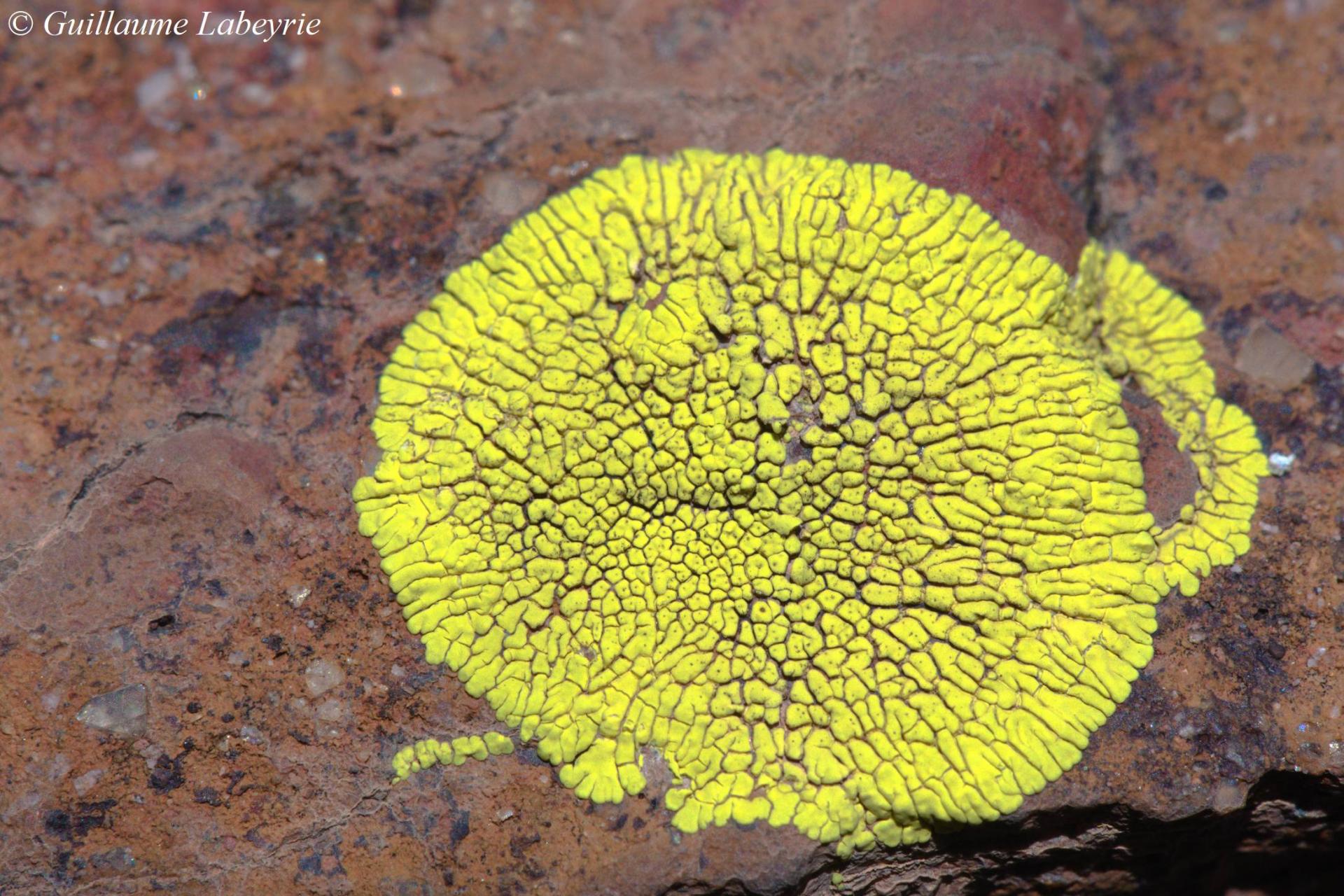 Acarospora hilaris. This beautiful lemon-yellow lichen is found on siliceous rocks facing south. Quite uncommon, it is present in France in the Var, the Alpes-Maritimes and in Corsica.
Acarospora hilaris. This beautiful lemon-yellow lichen is found on siliceous rocks facing south. Quite uncommon, it is present in France in the Var, the Alpes-Maritimes and in Corsica.
Family : Lecanoraceae
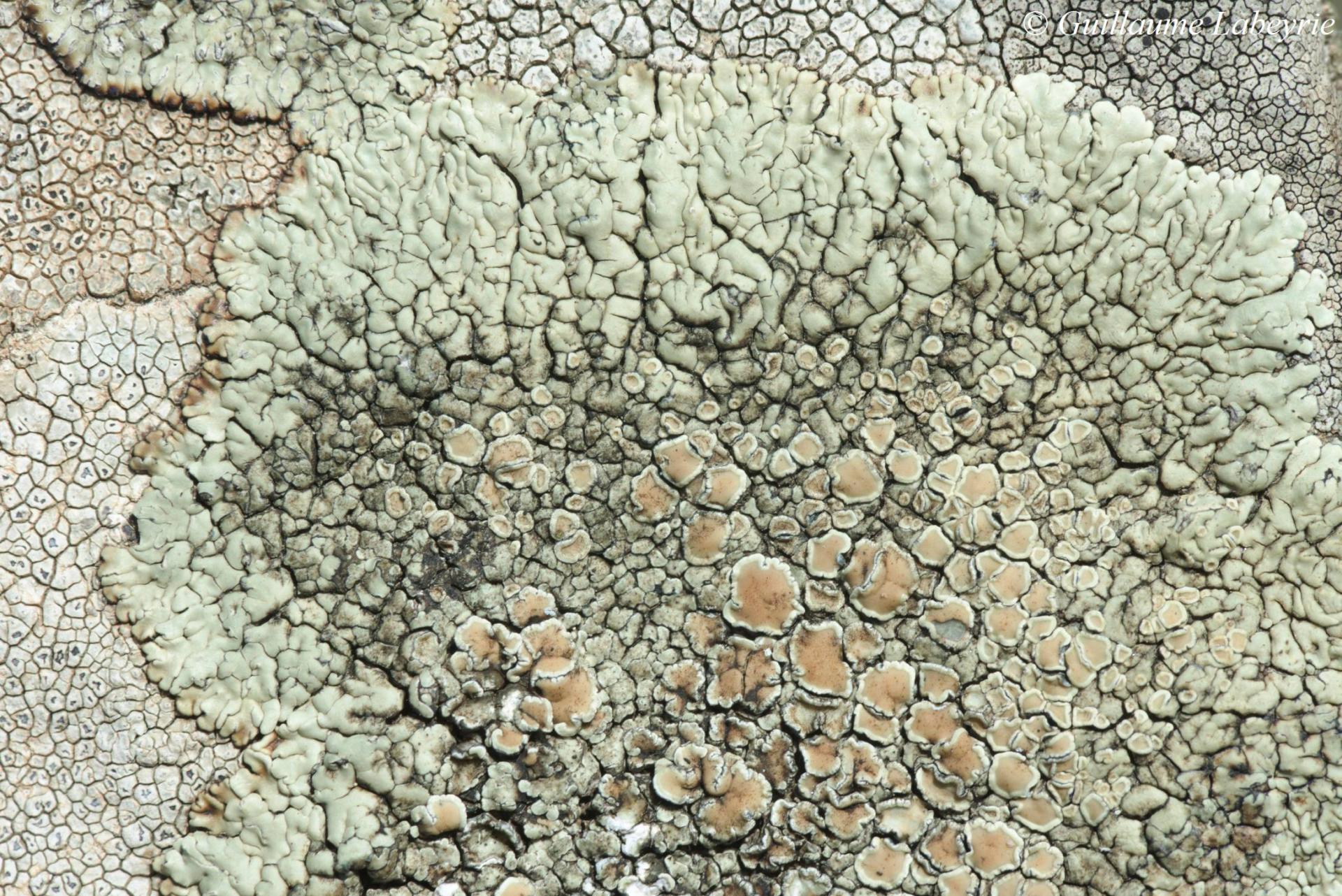
Protoparmeliopsis bolcana. This lichen forms greenish rosettes, with large salmon-colored apothecia with irregular edges. It grows on acidic rocks in dry places, in the Southern France including Corsica.
Family : Parmeliaceae
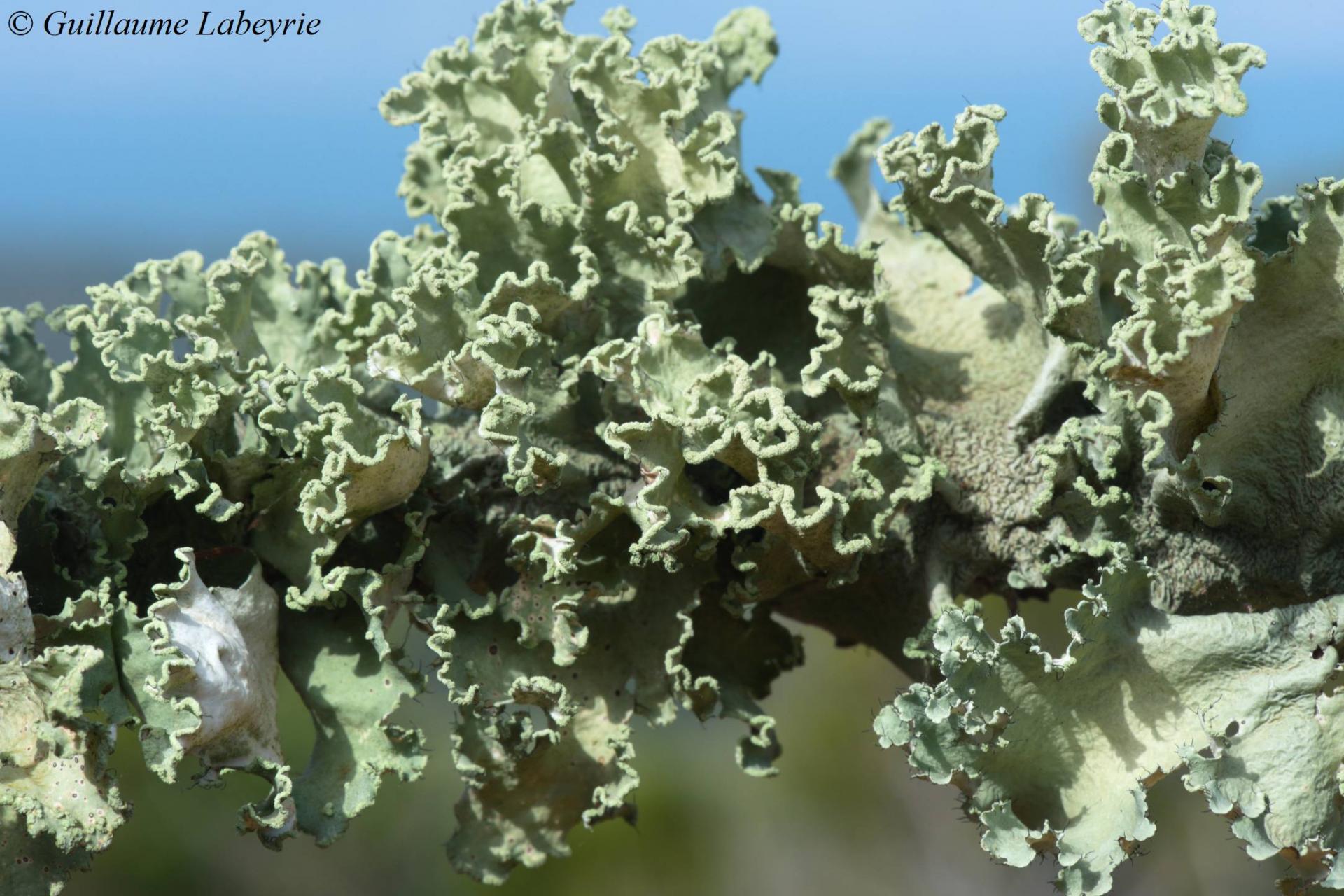 Parmotrema hypoleucinum. This spectacular lichen grows on twigs of shrubs such as strawberry tree (Arbutus unedo) and tree heath (Erica arborea) in coastal maquis. The lobes of the thallus pale green above and white below, and edged with thick black cilia. This rare species, considered in danger of extinction in France, is found only in Hérault, Var and Corsica.
Parmotrema hypoleucinum. This spectacular lichen grows on twigs of shrubs such as strawberry tree (Arbutus unedo) and tree heath (Erica arborea) in coastal maquis. The lobes of the thallus pale green above and white below, and edged with thick black cilia. This rare species, considered in danger of extinction in France, is found only in Hérault, Var and Corsica.
Family : Peltigeraceae

The tree lungwort (Lobaria pulmonaria). This lichen forms large rosettes with a characteristic leathery and lobed thallus, showing a network of round depressions. Brown in dry weather, it turns bright green when wet. It grows on deciduous trunks, in old forests with a humid atmosphere. The species has declined in Europe and is endangered in many areas. It is protected in several French regions.
Famille : Ramalinaceae
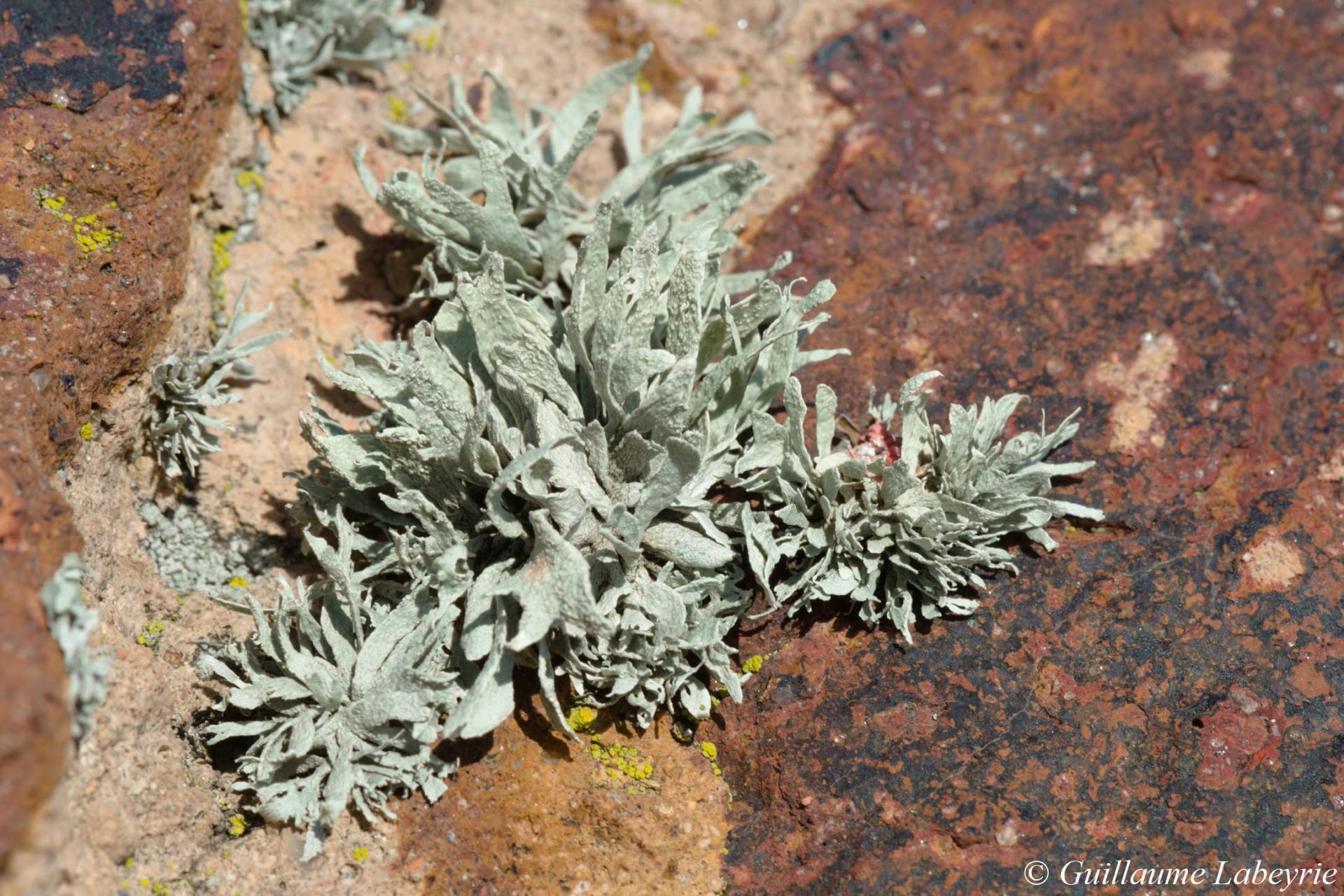 The granular bush lichen (Ramalina polymorpha). This species forms small, flat strappy bushes covered with grainy clusters that are lighter in color than the thallus. Young individuals often look like flowers resting on the rock. This species is often found on rocky peaks serving as resting places for birds, where it takes advantage of the elements present in their droppings.
The granular bush lichen (Ramalina polymorpha). This species forms small, flat strappy bushes covered with grainy clusters that are lighter in color than the thallus. Young individuals often look like flowers resting on the rock. This species is often found on rocky peaks serving as resting places for birds, where it takes advantage of the elements present in their droppings.
 Ramalina pusilla. This lichen (left) forms tiny coral-like bushes. Rare in France, it is found mainly on the islands of the Mediterranean coast, where it grows on the branches of trees (holm oak, etc...) in the coastal maquis.
Ramalina pusilla. This lichen (left) forms tiny coral-like bushes. Rare in France, it is found mainly on the islands of the Mediterranean coast, where it grows on the branches of trees (holm oak, etc...) in the coastal maquis.
Family : Roccellaceae
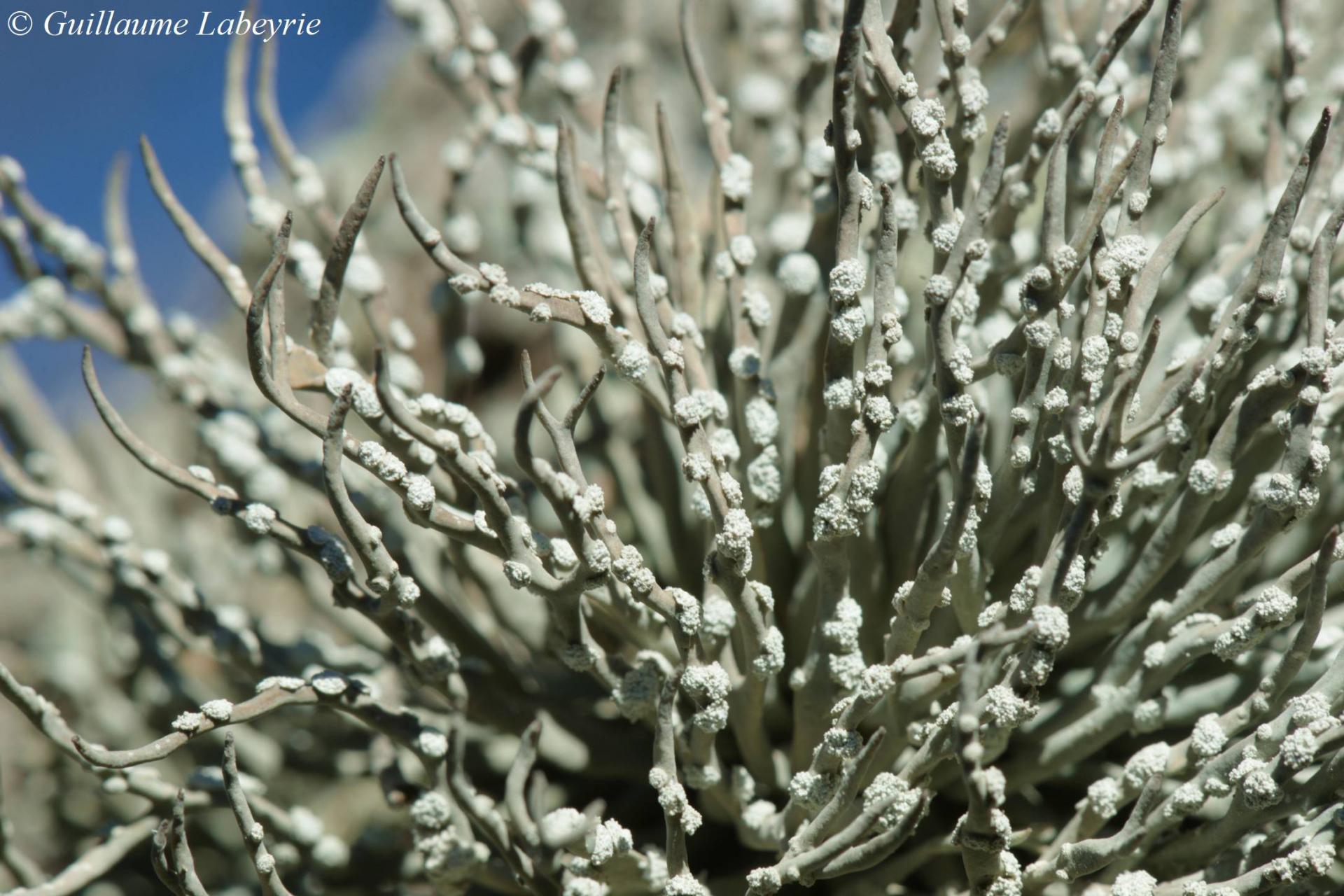 Roccella phycopsis. This fairly rare lichen forms small bushes with cylindrical branches tapering at the end. The branches of the thallus are here covered with soralia (tears in the thallus through which are emitted the soredia, small clusters of cells from the fungus and the partner algae used for vegetative reproduction). This species is mainly found on sea rocks, in Brittany and on the Mediterranean coast.
Roccella phycopsis. This fairly rare lichen forms small bushes with cylindrical branches tapering at the end. The branches of the thallus are here covered with soralia (tears in the thallus through which are emitted the soredia, small clusters of cells from the fungus and the partner algae used for vegetative reproduction). This species is mainly found on sea rocks, in Brittany and on the Mediterranean coast.
Family : Teloschistaceae
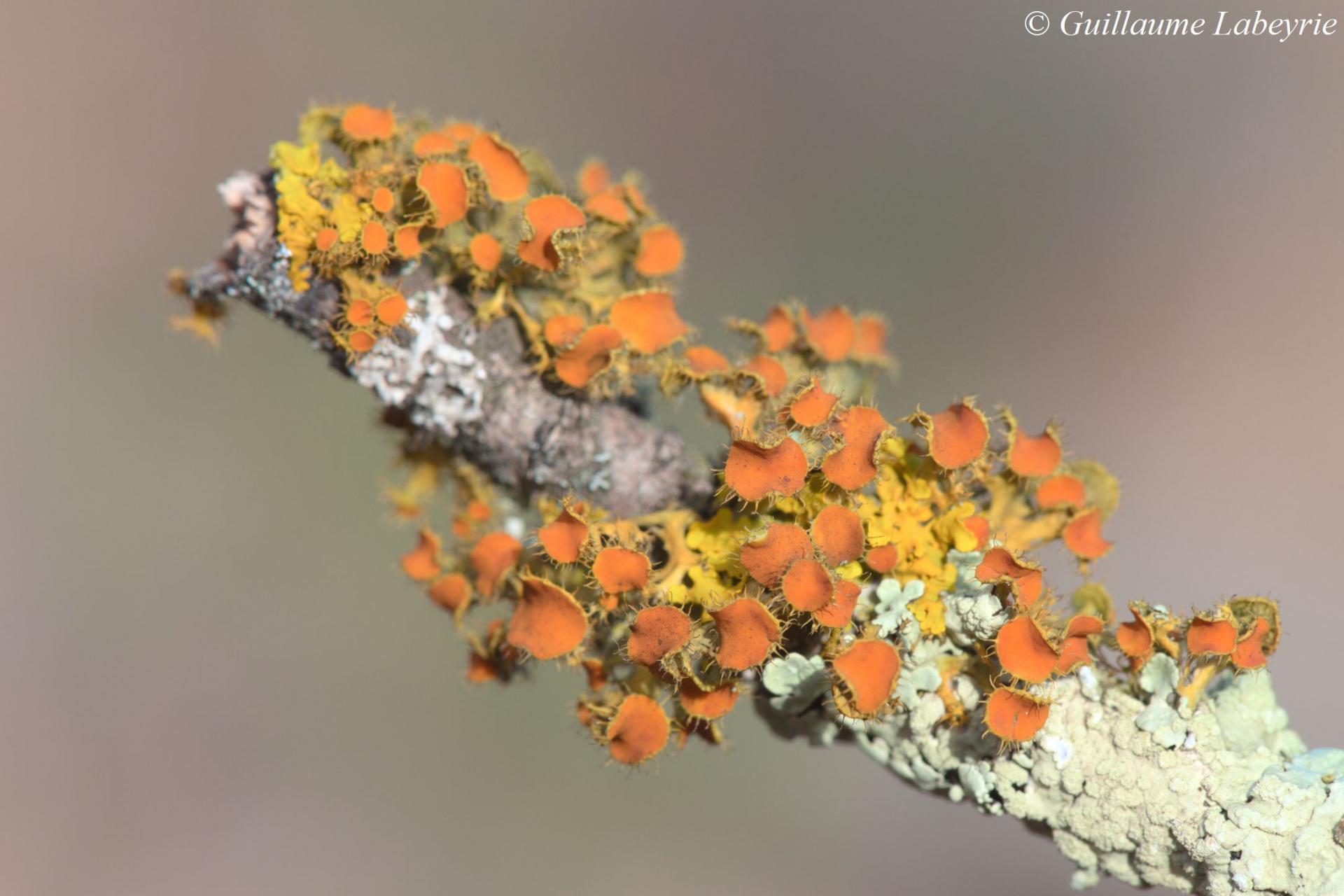 The gold-eye lichen (Teloschistes chrysophthalmus). This small but pretty species is distinguished by its orange, ciliated apothecia (cup-shaped sexual organs). It grows in areas where the air is clean. In the Hérault scrubland, it is often observed on the sprigs of the turpentine tree (Pistacia terebinthus). This lichen is found, in France, in a southwestern half.
The gold-eye lichen (Teloschistes chrysophthalmus). This small but pretty species is distinguished by its orange, ciliated apothecia (cup-shaped sexual organs). It grows in areas where the air is clean. In the Hérault scrubland, it is often observed on the sprigs of the turpentine tree (Pistacia terebinthus). This lichen is found, in France, in a southwestern half.
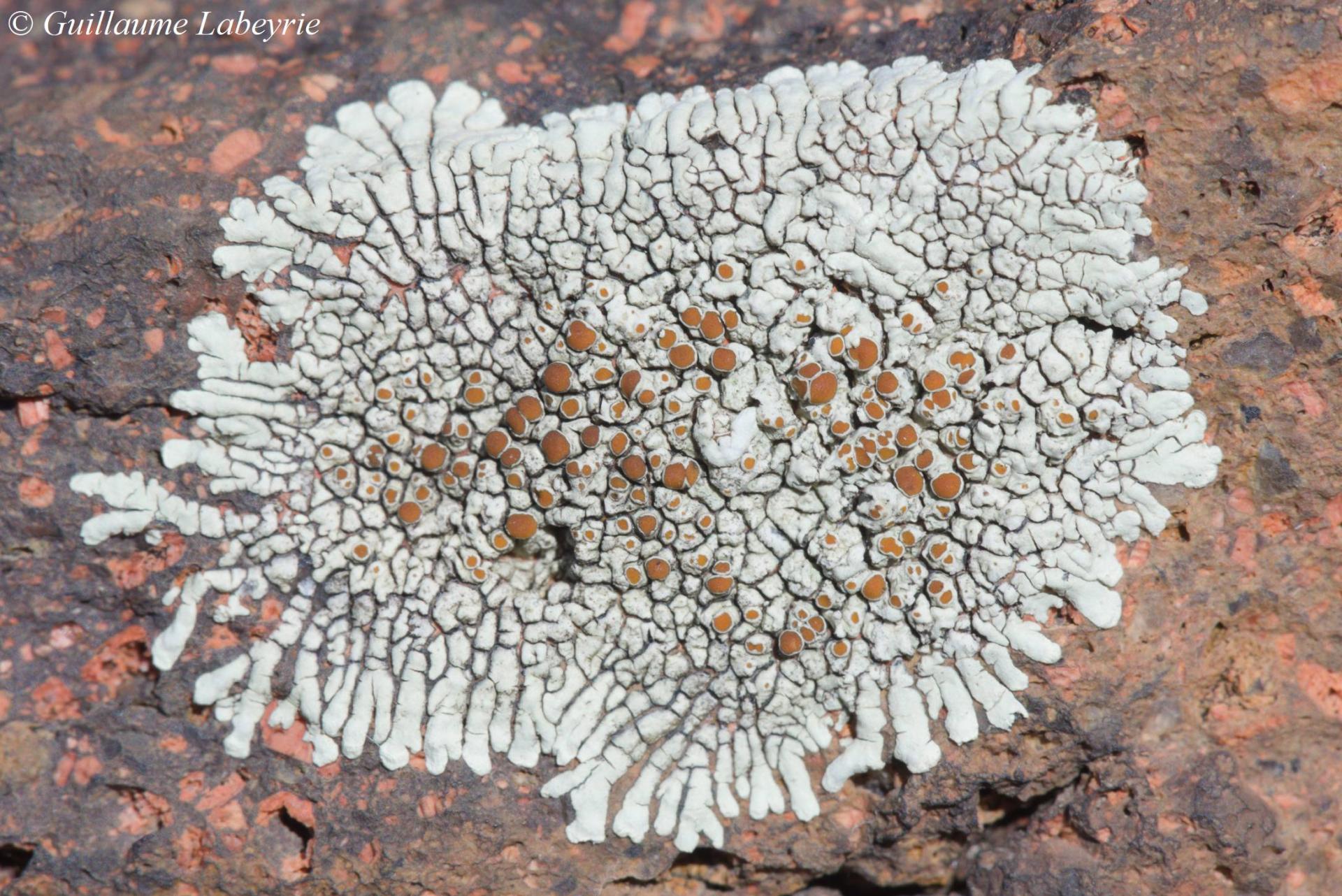
Caloplaca carphinea. This lichen forms small rosettes a few centimeters in diameter, with elongated and radially oriented peripheral lobes. The apothecia are orange and not black as in Dimelaena oreina, a species with which it can be confused. This lichen is found on the siliceous walls exposed to the south. Rare in France, it is only found in the coastal departments of the extreme south-east and in Corsica.
Family : Umbilicariaceae
 Lasallia pustulata. This spectacular lichen can exceed 10 cm in diameter. Its thallus is dotted with characteristic ''pustules''. This species grows on shady siliceous rocks, subject to temporary water flows. It is edible. It is found in most of France.
Lasallia pustulata. This spectacular lichen can exceed 10 cm in diameter. Its thallus is dotted with characteristic ''pustules''. This species grows on shady siliceous rocks, subject to temporary water flows. It is edible. It is found in most of France.
Fauna
Birds
Family : Scolopacidae
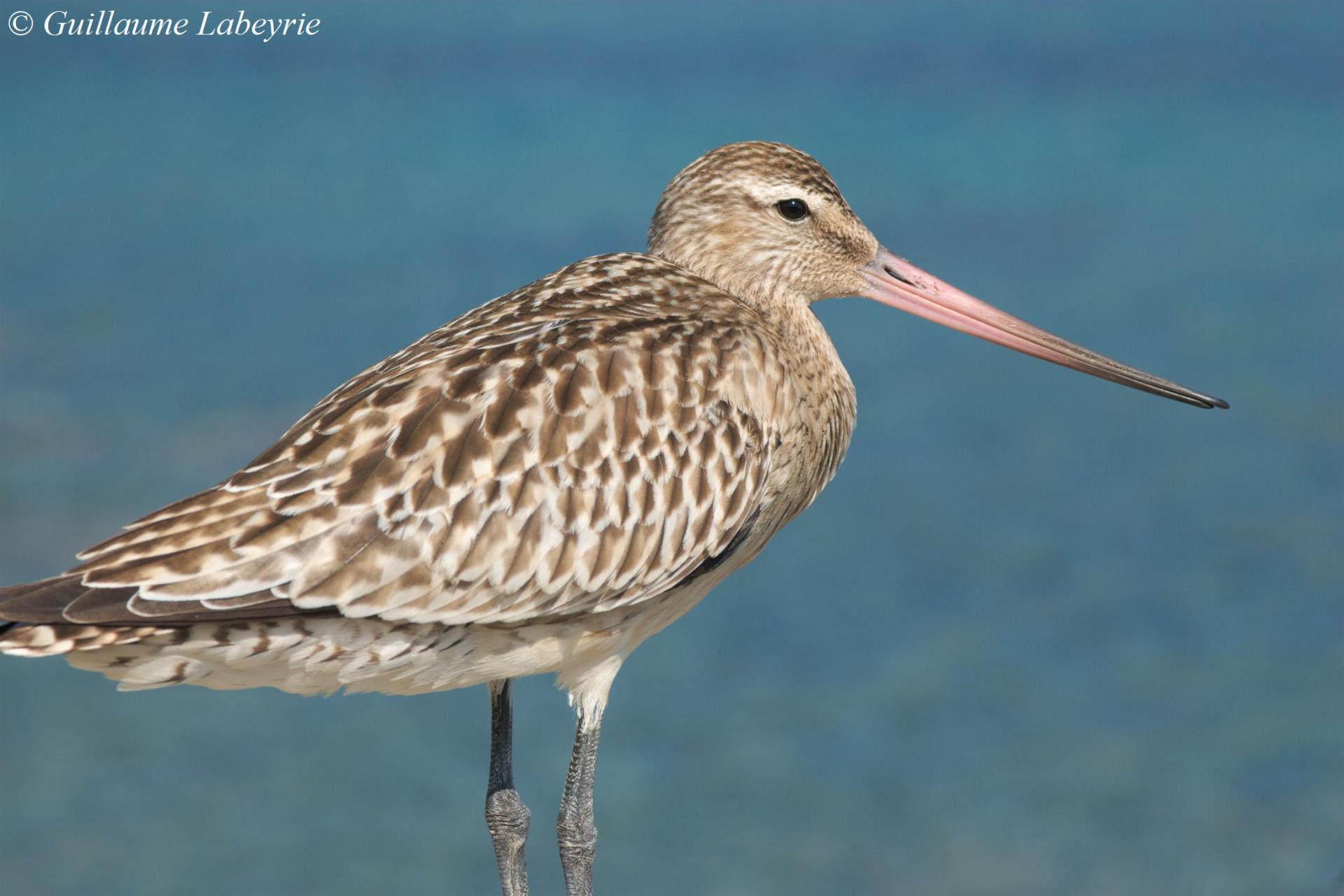 The bar-tailed godwit (Limosa lapponica). This beautiful bird uses its long bill to capture invertebrates in mud or sand. Nesting in Europe in the tundras of the far north, it spends the winter further south on the coasts and in particular in estuaries. Although listed on the world red list as ''near-threatened'', this species is still hunted in France. This shameful situation shows how much our country, which has the sad record in Europe with 89 huntable species, is at the forefront in environmental protection !
The bar-tailed godwit (Limosa lapponica). This beautiful bird uses its long bill to capture invertebrates in mud or sand. Nesting in Europe in the tundras of the far north, it spends the winter further south on the coasts and in particular in estuaries. Although listed on the world red list as ''near-threatened'', this species is still hunted in France. This shameful situation shows how much our country, which has the sad record in Europe with 89 huntable species, is at the forefront in environmental protection !
Mammals
Famille : Erinaceidae
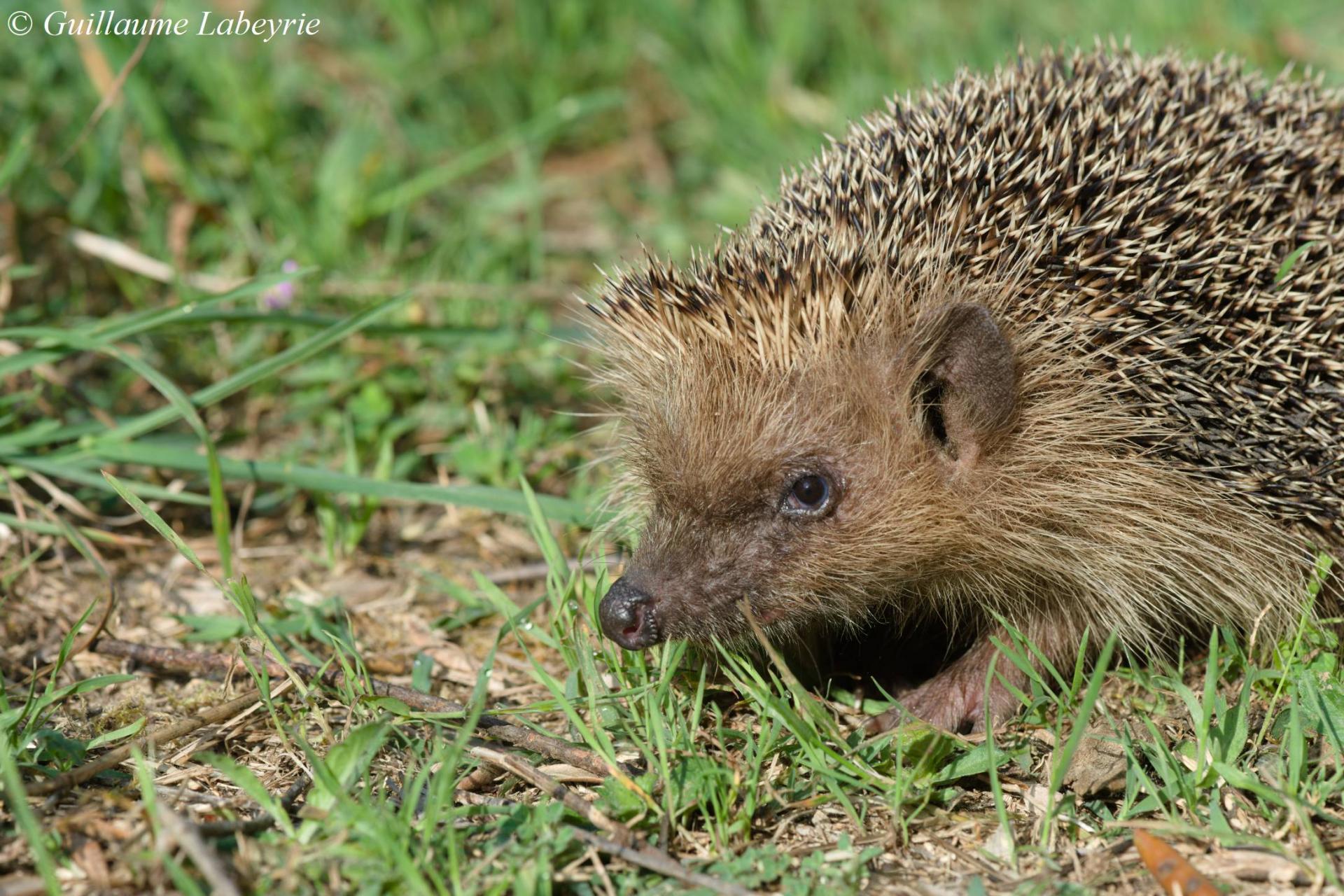 The West European hedgehog (Erinaceus europaeus). This well known little animal is mainly active at night. It plays an important role in gardens by regulating snail and slug populations. The hedgehog is in rapid decline in Europe, due to habitat destruction, car traffic and pesticides. It is however protected in France at the national level.
The West European hedgehog (Erinaceus europaeus). This well known little animal is mainly active at night. It plays an important role in gardens by regulating snail and slug populations. The hedgehog is in rapid decline in Europe, due to habitat destruction, car traffic and pesticides. It is however protected in France at the national level.
Reptiles
Reptiles generally appreciate warm climates, and are therefore more abundant in the southernmost parts of France. 32 of the 40 species of reptiles present in France are found in the PACA region.
Family : Testudinidae
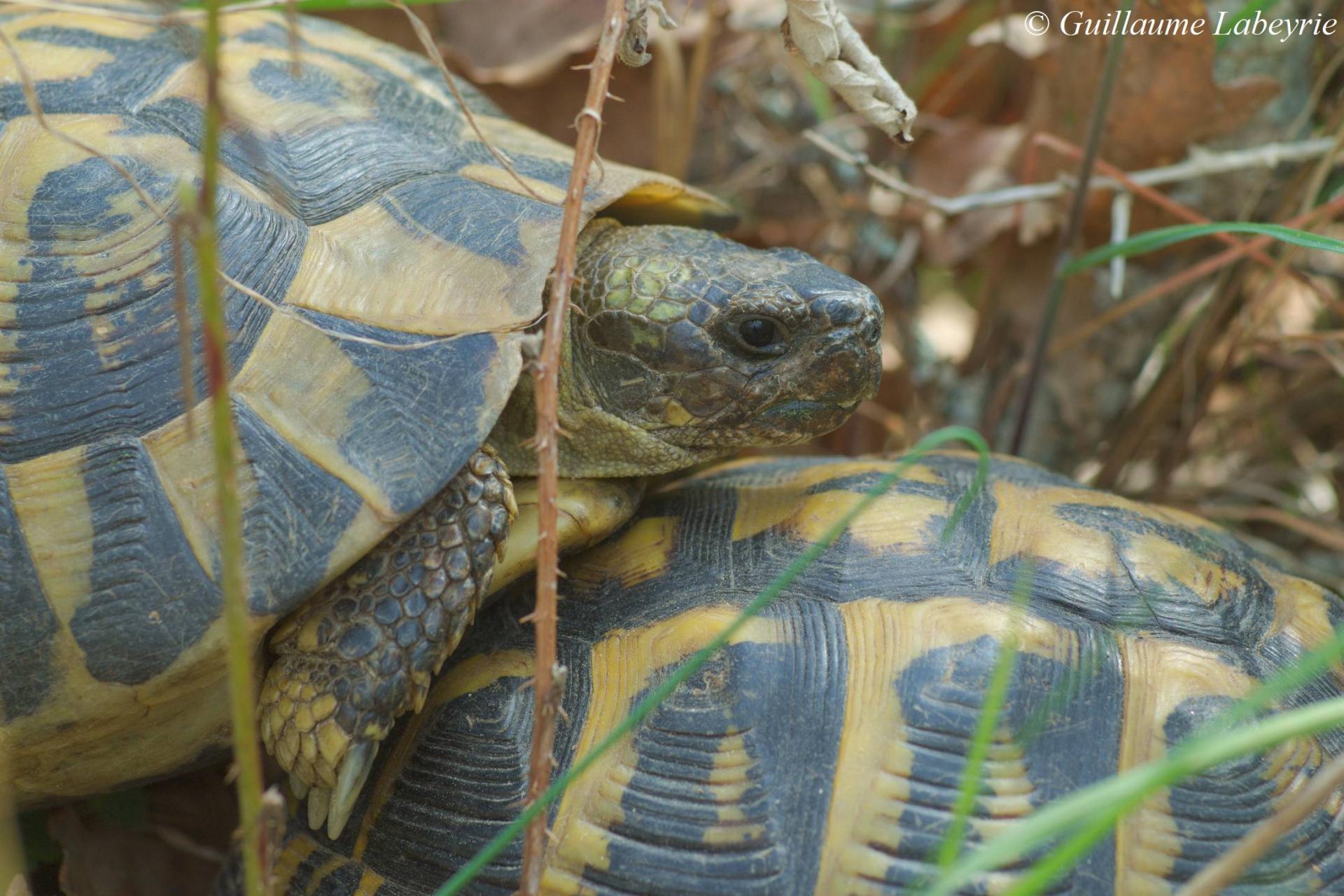 Hermann's tortoise (Testudo hermanni). This tortoise is the only native French species. It lives dry and warm scrubby habitats, with sandy areas to lay its eggs. This species occurs in southern Europe: Spain, France, Italy, the Balkans, Greece and Turkey. In France it is mainly present in the Var (the Maures range) and in Corsica. As a species, Testudo hermanni is classified by UICN as "nearly endangered", but the western subspecies occurring in France is considered threatened and is the object of conservation programs. This tortoise is fully protected in France.
Hermann's tortoise (Testudo hermanni). This tortoise is the only native French species. It lives dry and warm scrubby habitats, with sandy areas to lay its eggs. This species occurs in southern Europe: Spain, France, Italy, the Balkans, Greece and Turkey. In France it is mainly present in the Var (the Maures range) and in Corsica. As a species, Testudo hermanni is classified by UICN as "nearly endangered", but the western subspecies occurring in France is considered threatened and is the object of conservation programs. This tortoise is fully protected in France.
Family : Emydidae
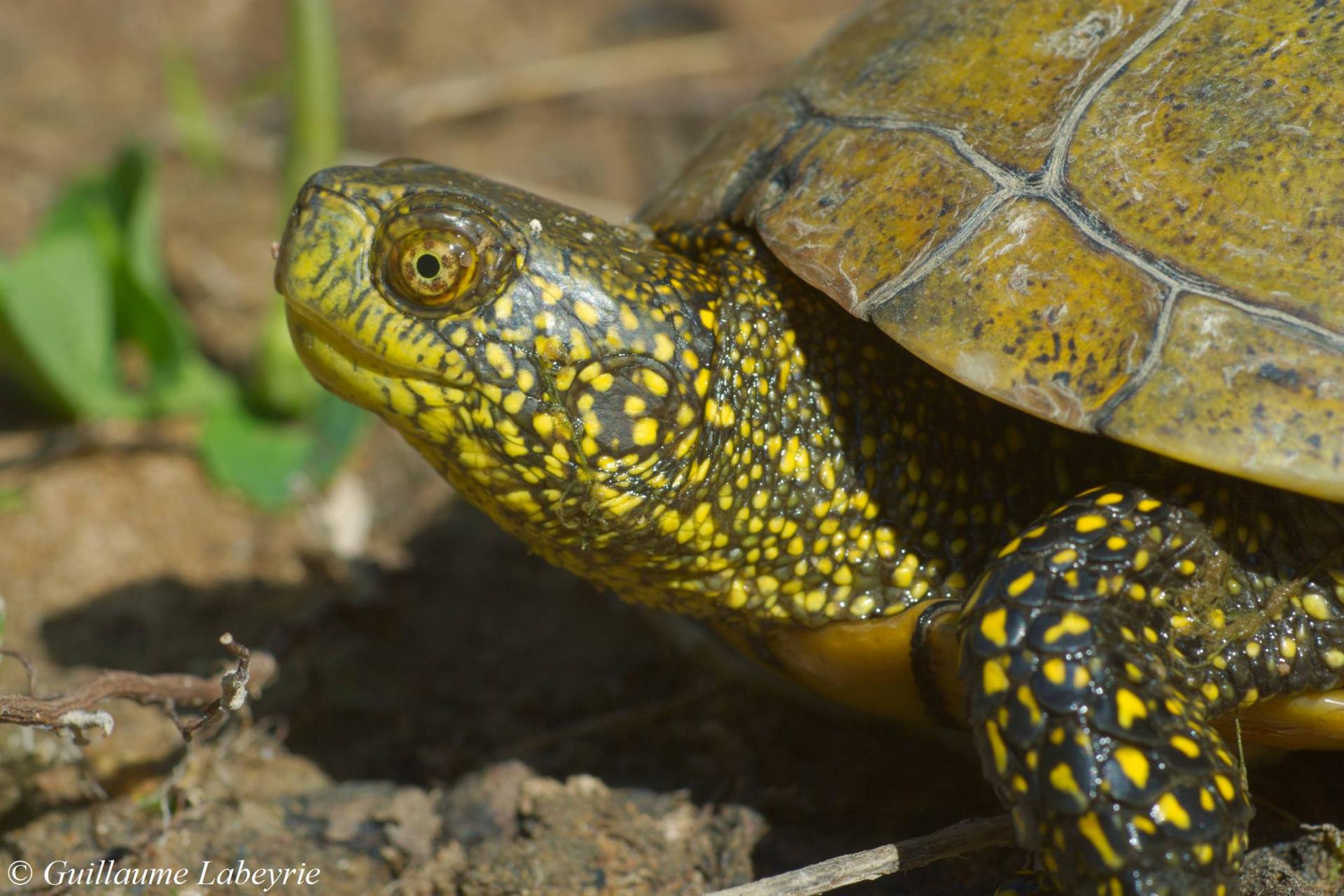 The European pond turtle (Emys orbicularis). This freshwater species appreciates sunny ponds, where it can often be seen sunbathing posted on a branch. Very shy, it quickly jumps into the water once disturbed and hides in the mud or under the aquatic vegetation. Once widespread throughout Europe this species is in strong regression and listed as threatened. In France, it is present in several isolated populations strongholds, among which the Plaine des Maures where this photo was taken. This turtle is fully protected in France.
The European pond turtle (Emys orbicularis). This freshwater species appreciates sunny ponds, where it can often be seen sunbathing posted on a branch. Very shy, it quickly jumps into the water once disturbed and hides in the mud or under the aquatic vegetation. Once widespread throughout Europe this species is in strong regression and listed as threatened. In France, it is present in several isolated populations strongholds, among which the Plaine des Maures where this photo was taken. This turtle is fully protected in France.
Family : Colubridae
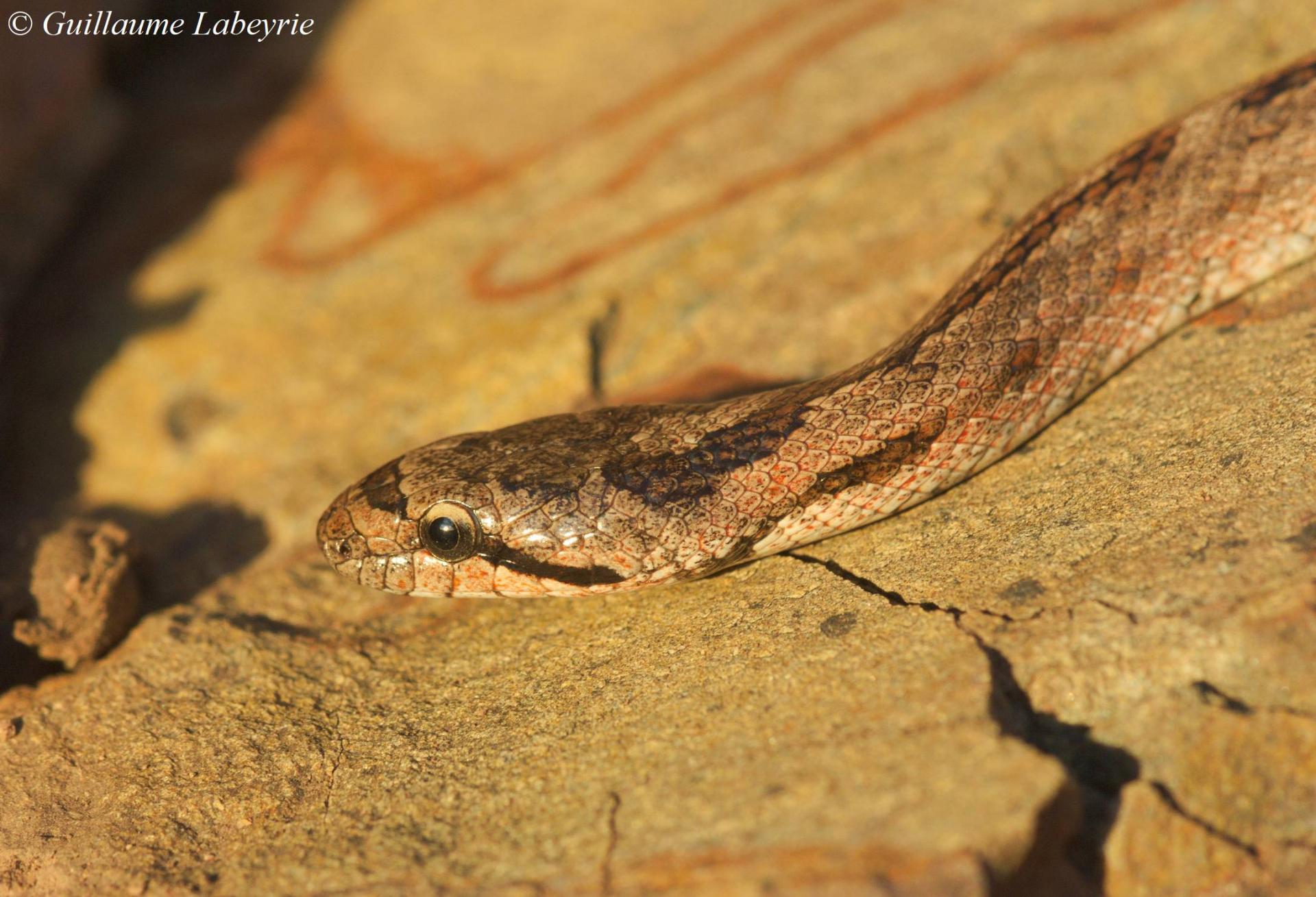 The southern smooth snake (Coronella girondica). This small, slender snake is often observed at dusk. It differs from the smooth snake (Coronella austriaca) in particular by the absence of a dark line between the nostril and the eye. Both species feed mainly on lizards. C. girondica is present in southwestern Europe (Spain, southern France and Italy) and in North Africa.
The southern smooth snake (Coronella girondica). This small, slender snake is often observed at dusk. It differs from the smooth snake (Coronella austriaca) in particular by the absence of a dark line between the nostril and the eye. Both species feed mainly on lizards. C. girondica is present in southwestern Europe (Spain, southern France and Italy) and in North Africa.
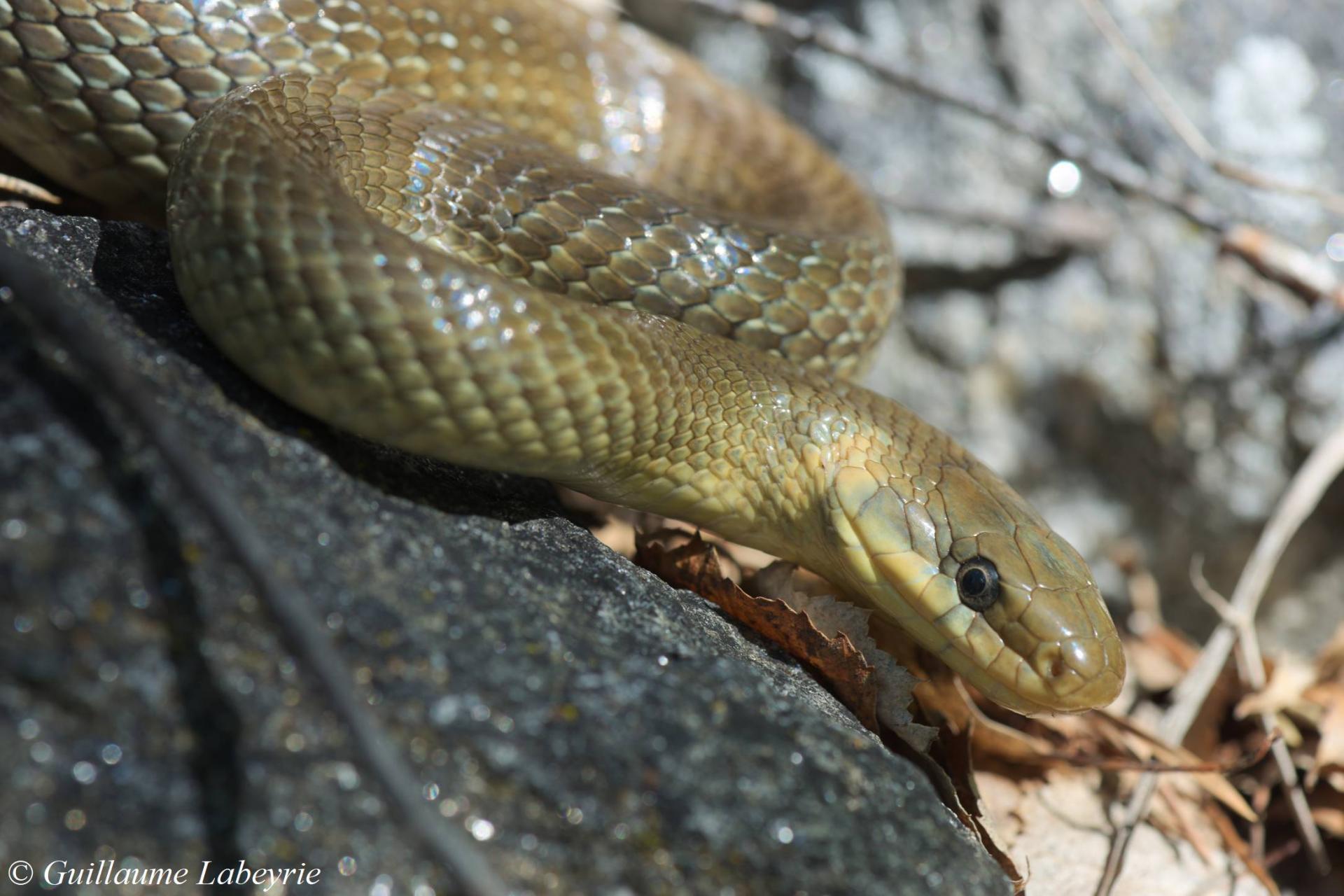 The Aesculapian snake (Zamenis longissimus).This beautiful snake is distinguished by its long, uniform brown body, with a yellowish area on the back of the head. It can reach 2 m in length. It is a species with a distinctly arboreal tendency. In our region, it is found from sea level up to 1500 m altitude. This species is distributed in Europe, from France to Ukraine. It is fully protected in France.
The Aesculapian snake (Zamenis longissimus).This beautiful snake is distinguished by its long, uniform brown body, with a yellowish area on the back of the head. It can reach 2 m in length. It is a species with a distinctly arboreal tendency. In our region, it is found from sea level up to 1500 m altitude. This species is distributed in Europe, from France to Ukraine. It is fully protected in France.
Family : Lamprophiidae

The Montpellier snake (Malpolon monspessulanus). This impressive snake can exceed 2 m in length, making it the largest snake in metropolitan France. Its light brown color is uniform, except in juveniles as in this photo. This snake is able to stand up more than 50 cm to observe the surroundings. Harmless to humans, it does however have poisonous fangs located inside the throat. It is found in dry bushy areas, in the departments bordering the Mediterranean. Like all snakes in France, it is fully protected.
Family : Lacertidae
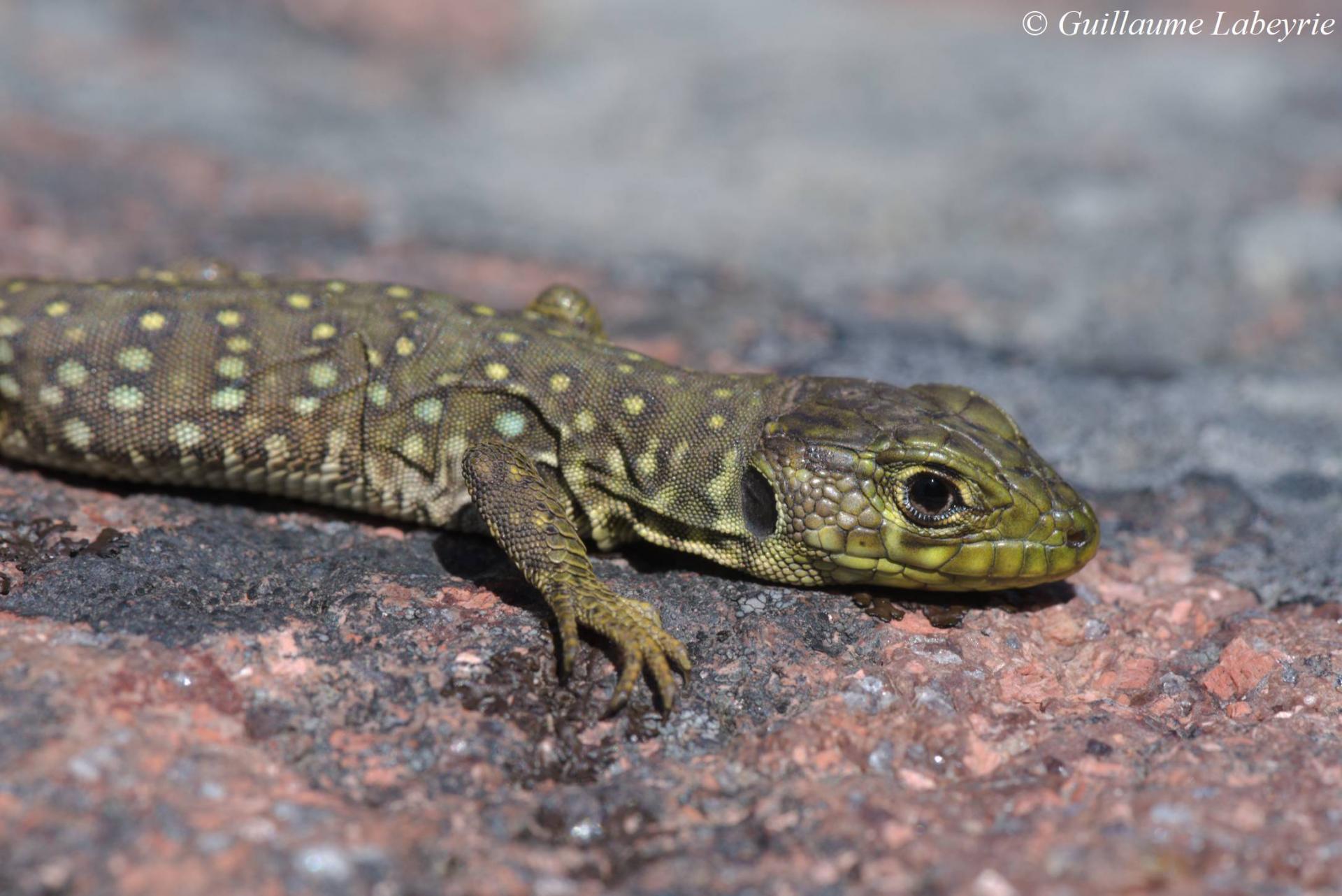 The ocellated lizard (Timon lepidus). This magnificent lizard, which can reach 70 cm in length, is the largest in Europe. The blue ocelli present on the flanks of adult males are characteristic (this photo represents a juvenile). This lizard is found in fairly varied environments, generally rocky and dry. It can reach 1400 m altitude in PACA. In decline in France where it is found in the southern half, it is considered endangered. It is classified as ''vulnerable'' on the national red list and fully protected.
The ocellated lizard (Timon lepidus). This magnificent lizard, which can reach 70 cm in length, is the largest in Europe. The blue ocelli present on the flanks of adult males are characteristic (this photo represents a juvenile). This lizard is found in fairly varied environments, generally rocky and dry. It can reach 1400 m altitude in PACA. In decline in France where it is found in the southern half, it is considered endangered. It is classified as ''vulnerable'' on the national red list and fully protected.
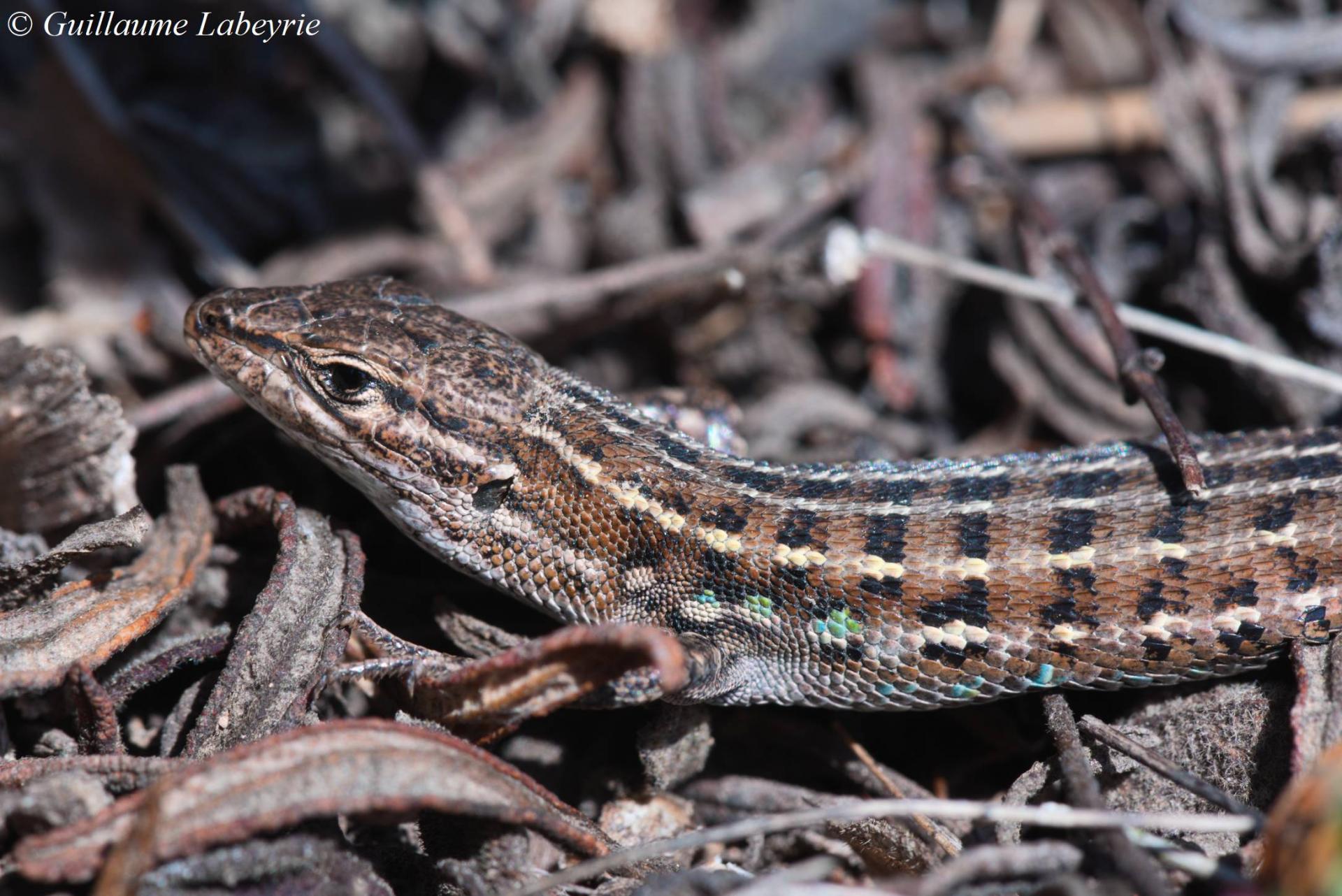 The Spanish psammodromus (Psammodromus hispanicus). This small brown lizard with a striped pattern appreciates dry and open habitats, such as coastal dunes. It is found mainly in the Iberian Peninsula, and in France along the Mediterranean coast, from the Pyrénées-Orientales to the Var.
The Spanish psammodromus (Psammodromus hispanicus). This small brown lizard with a striped pattern appreciates dry and open habitats, such as coastal dunes. It is found mainly in the Iberian Peninsula, and in France along the Mediterranean coast, from the Pyrénées-Orientales to the Var.
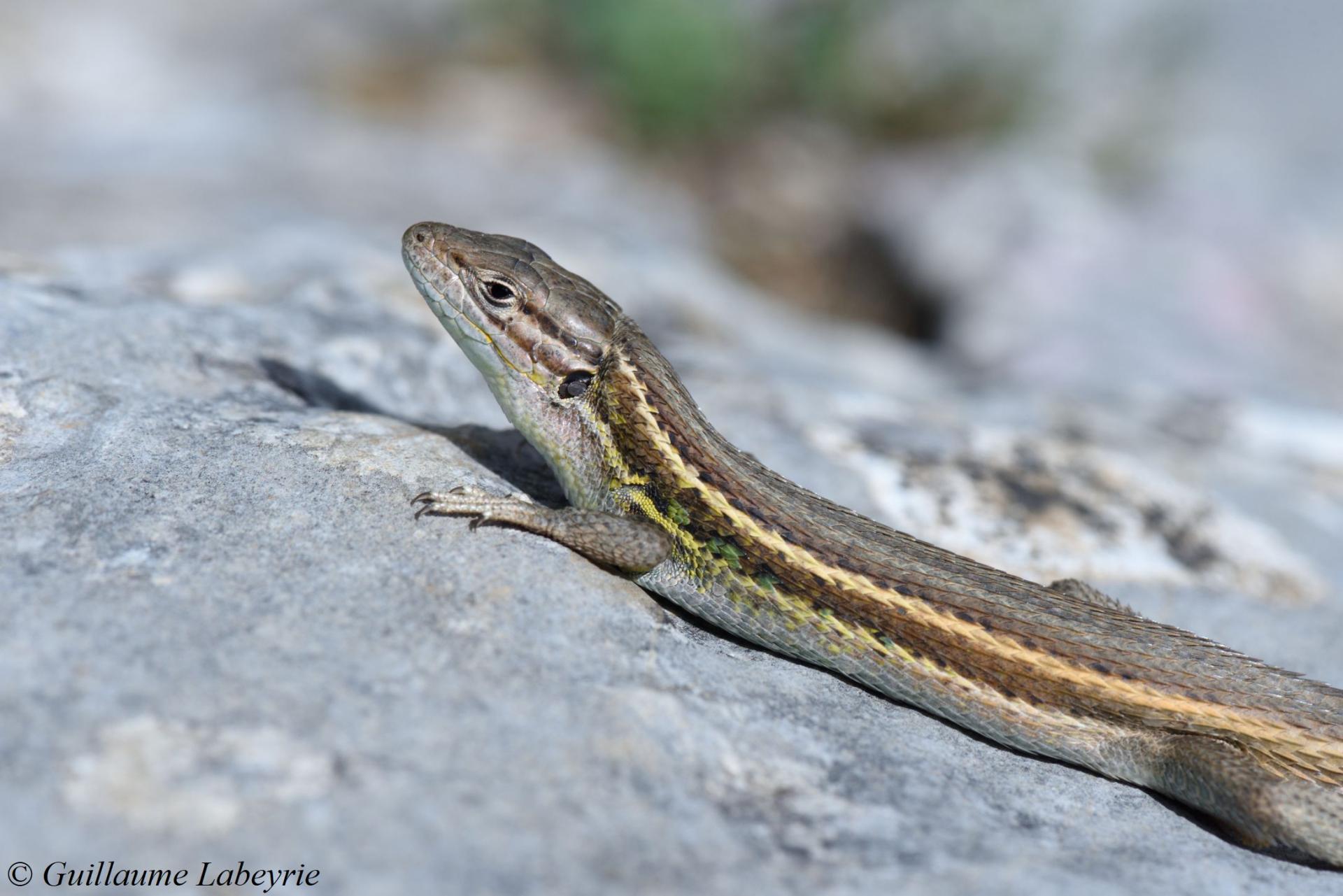
The Algerian psammodromus (Psammodromus algirus). This other Psammodromus is much larger than the previous one, with a uniform brown body with four continuous white lines. It frequents all types of dry environments. It is found throughout the Iberian Peninsula, in North Africa, and in France on the coastal strip from the Pyrénées-Orientales to the Rhône. East of the Rhône, in PACA, observations are much rarer (Var).
Family : Phyllodactylidae
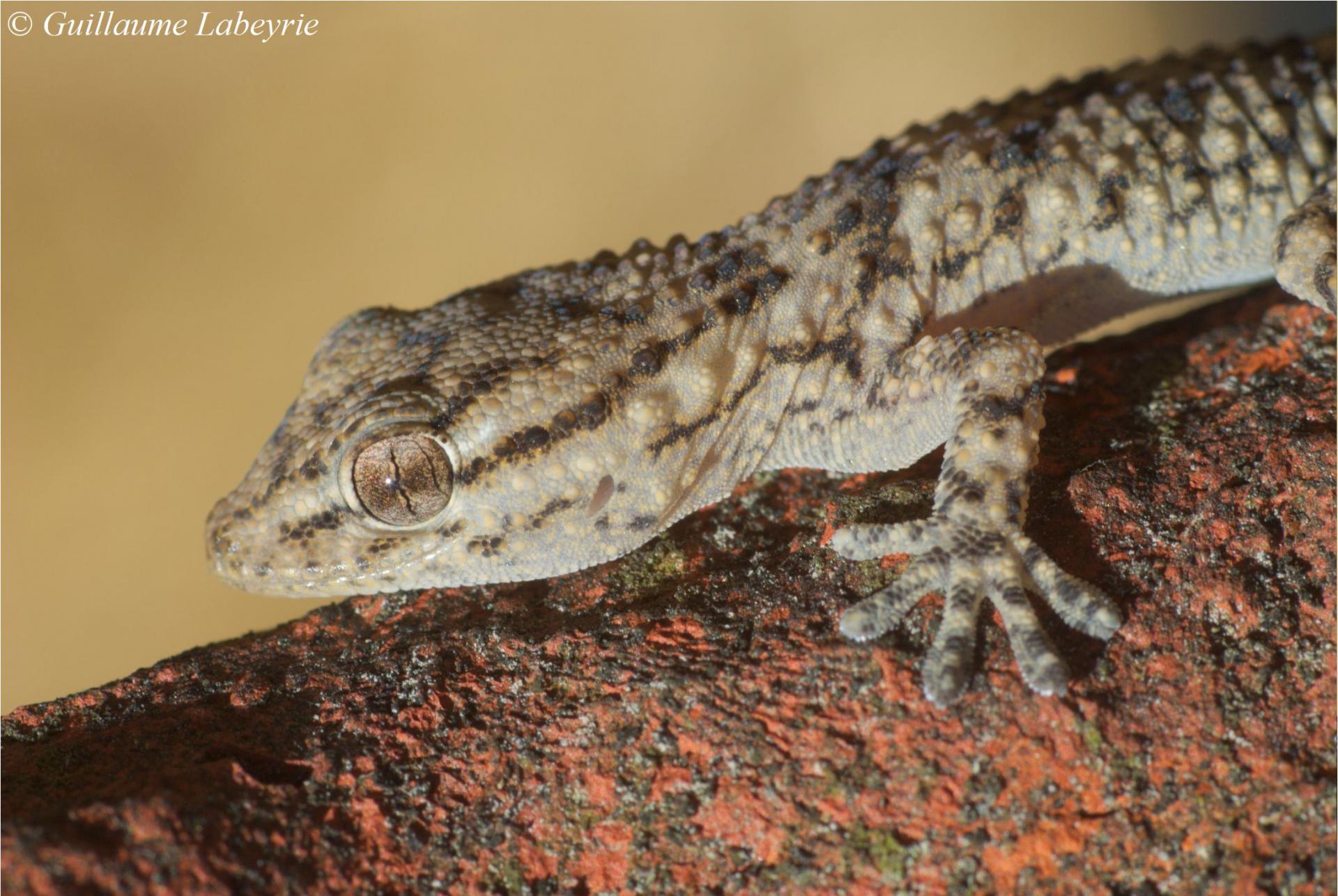 Juvenile moorish wall gecko (Tarentola mauritanica). This gecko, mainly nocturnal, is found in the Mediterranean basin. In the south of France, it is often seen on village walls, catching insects attracted by lamps. During winter, the moorish wall gecko hides in rock cracks but also under roof tiles and in attics. Two other gecko species, much less common, also occur on the French Mediterranean coast: the Mediterranean house gecko (Hemidactylus turcicus) and the European leaf-toed gecko (Phyllodactylus europaeus).
Juvenile moorish wall gecko (Tarentola mauritanica). This gecko, mainly nocturnal, is found in the Mediterranean basin. In the south of France, it is often seen on village walls, catching insects attracted by lamps. During winter, the moorish wall gecko hides in rock cracks but also under roof tiles and in attics. Two other gecko species, much less common, also occur on the French Mediterranean coast: the Mediterranean house gecko (Hemidactylus turcicus) and the European leaf-toed gecko (Phyllodactylus europaeus).
Amphibians
The class of Amphibians includes two orders: Anura (frogs and toads) and Urodela (newts and salamanders). There are 21 species of amphibians in PACA, among the 43 present in France (including introduced species).
Family : Bufonidae
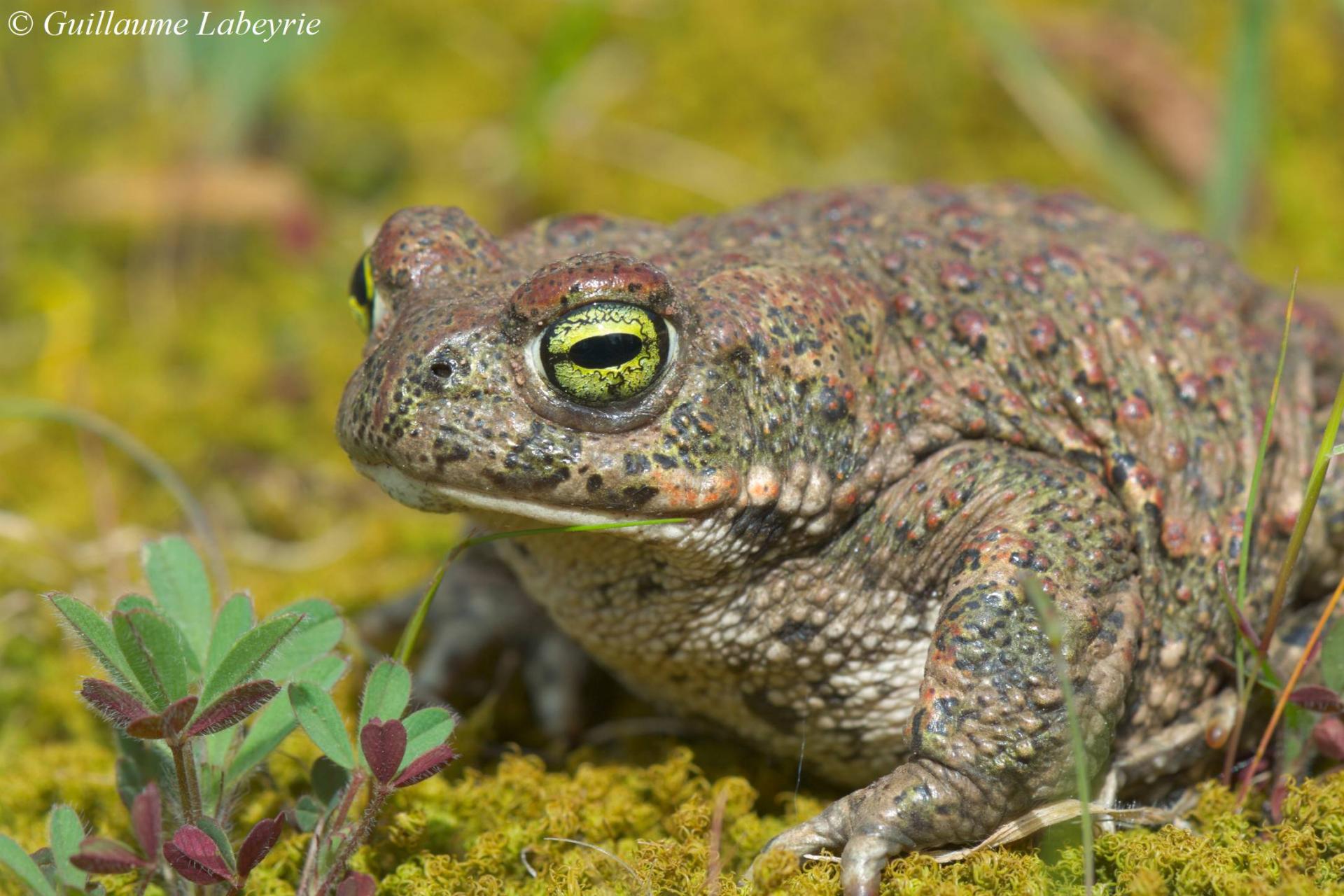 The natterjack toad (Epidalea calamita). This medium-sized toad is distinguished by its beautiful yellow eyes and the clear line that runs down its back. It is mainly active at night, and frequents sandy areas. It is present in the North-West of Europe (from Spain to Latvia), and on the whole of the French territory where it is fully protected.
The natterjack toad (Epidalea calamita). This medium-sized toad is distinguished by its beautiful yellow eyes and the clear line that runs down its back. It is mainly active at night, and frequents sandy areas. It is present in the North-West of Europe (from Spain to Latvia), and on the whole of the French territory where it is fully protected.
Family : Pelodytidae
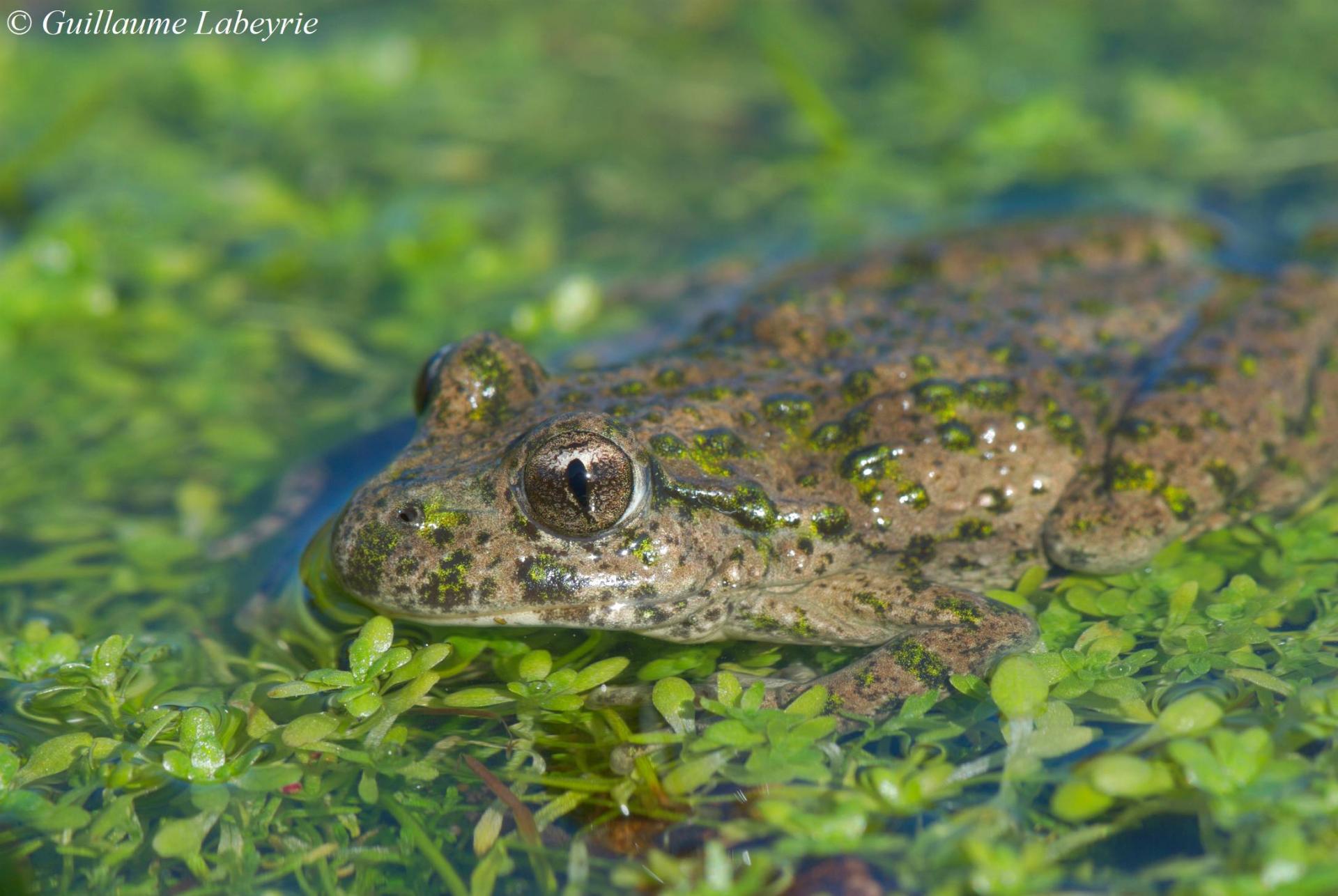 The common parsley frog (Pelodytes punctatus). This small toad with a flattened snout is dotted with green spots. It is able to survive in a wide variety of environments, including dry ones where it shelters under stones during the day. Essentially nocturnal, this species can however be observed during the day during spring, in the ponds where the males sing underwater. The range of this small toad is restricted to France, Italy and the Iberian Peninsula. Considered vulnerable in France, it is protected at the national level.
The common parsley frog (Pelodytes punctatus). This small toad with a flattened snout is dotted with green spots. It is able to survive in a wide variety of environments, including dry ones where it shelters under stones during the day. Essentially nocturnal, this species can however be observed during the day during spring, in the ponds where the males sing underwater. The range of this small toad is restricted to France, Italy and the Iberian Peninsula. Considered vulnerable in France, it is protected at the national level.
Family : Hylidae
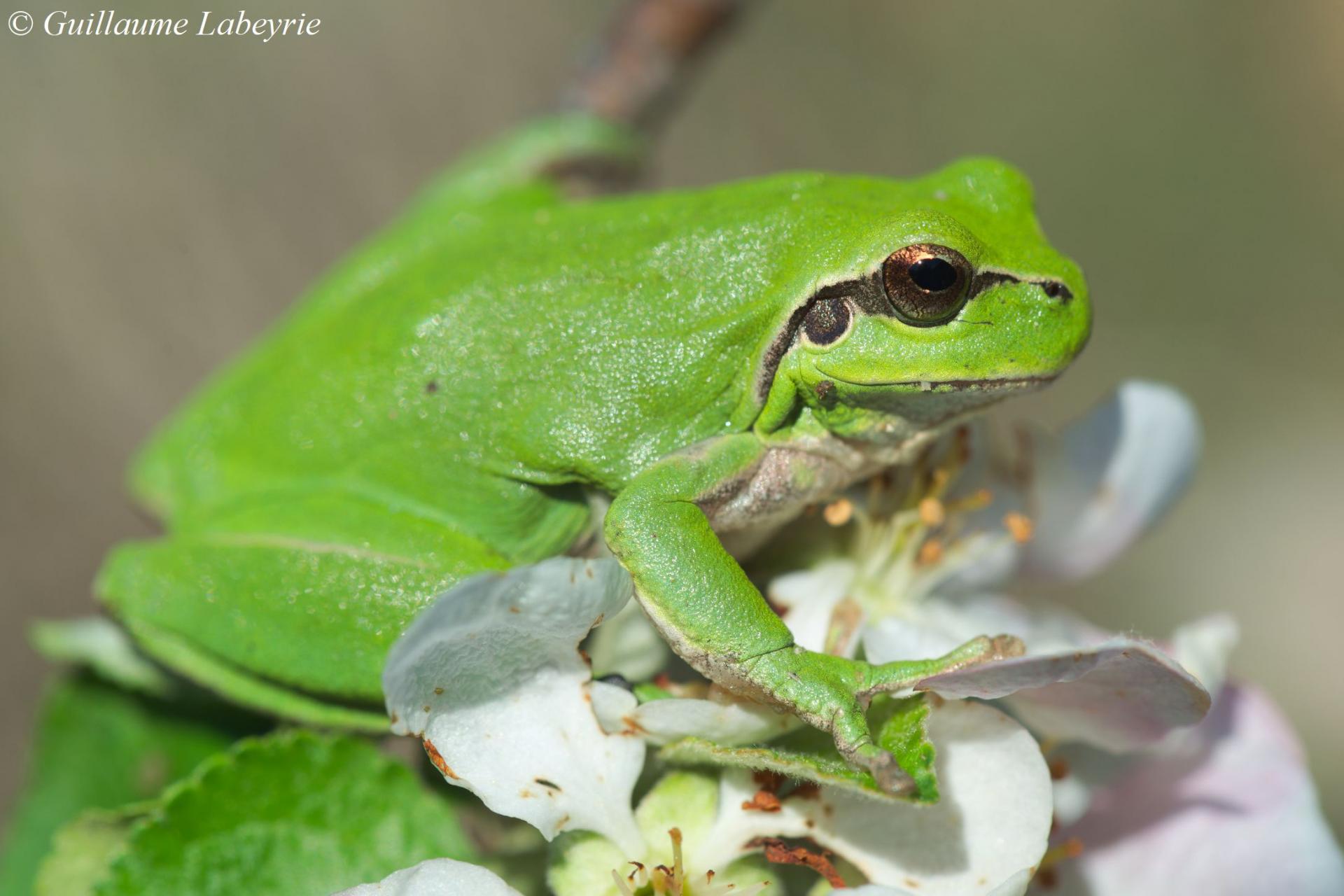 The Mediterranean tree frog (Hyla meridionalis). This pretty little frog can be distinguished from the green tree frog (Hyla arborea) by the dark line behind the eye which does not extend onto the sides. Present in the southern half of France, it is common there, including in the dry maquis where it is sometimes heard singing during the beautiful winter days. It is protected at the national level.
The Mediterranean tree frog (Hyla meridionalis). This pretty little frog can be distinguished from the green tree frog (Hyla arborea) by the dark line behind the eye which does not extend onto the sides. Present in the southern half of France, it is common there, including in the dry maquis where it is sometimes heard singing during the beautiful winter days. It is protected at the national level.
Family : Ranidae
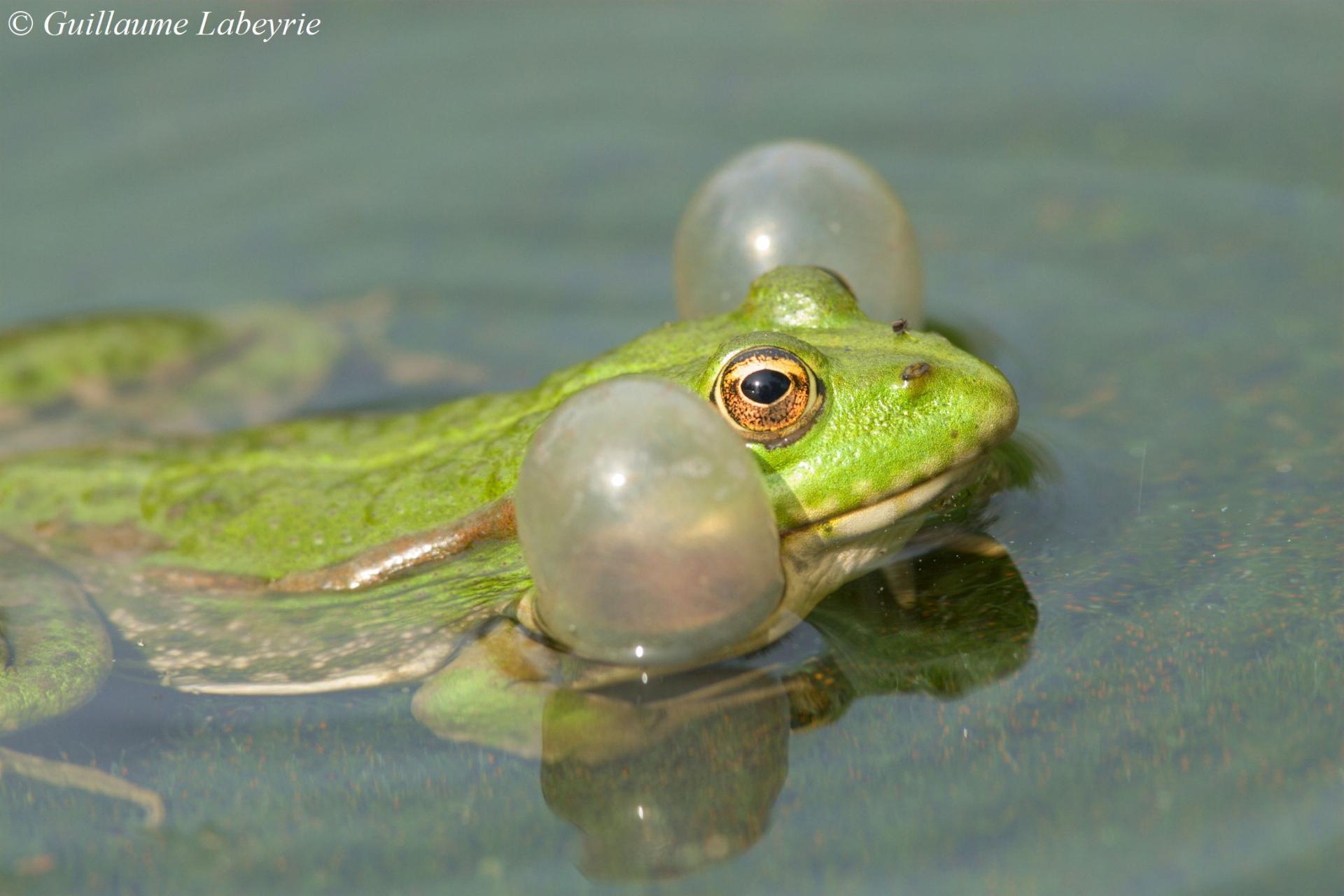 The marsh frog (Pelophylax ridibundus). It is our largest frog, which reaches 15 cm. The male represented in this photo is emitting the sonorous and characteristic song at the origin of its name. This invasive frog was initially distributed in eastern France, but has been introduced everywhere. It is very common in the Southeast. It is fully protected in France.
The marsh frog (Pelophylax ridibundus). It is our largest frog, which reaches 15 cm. The male represented in this photo is emitting the sonorous and characteristic song at the origin of its name. This invasive frog was initially distributed in eastern France, but has been introduced everywhere. It is very common in the Southeast. It is fully protected in France.
Family : Plethodontidae
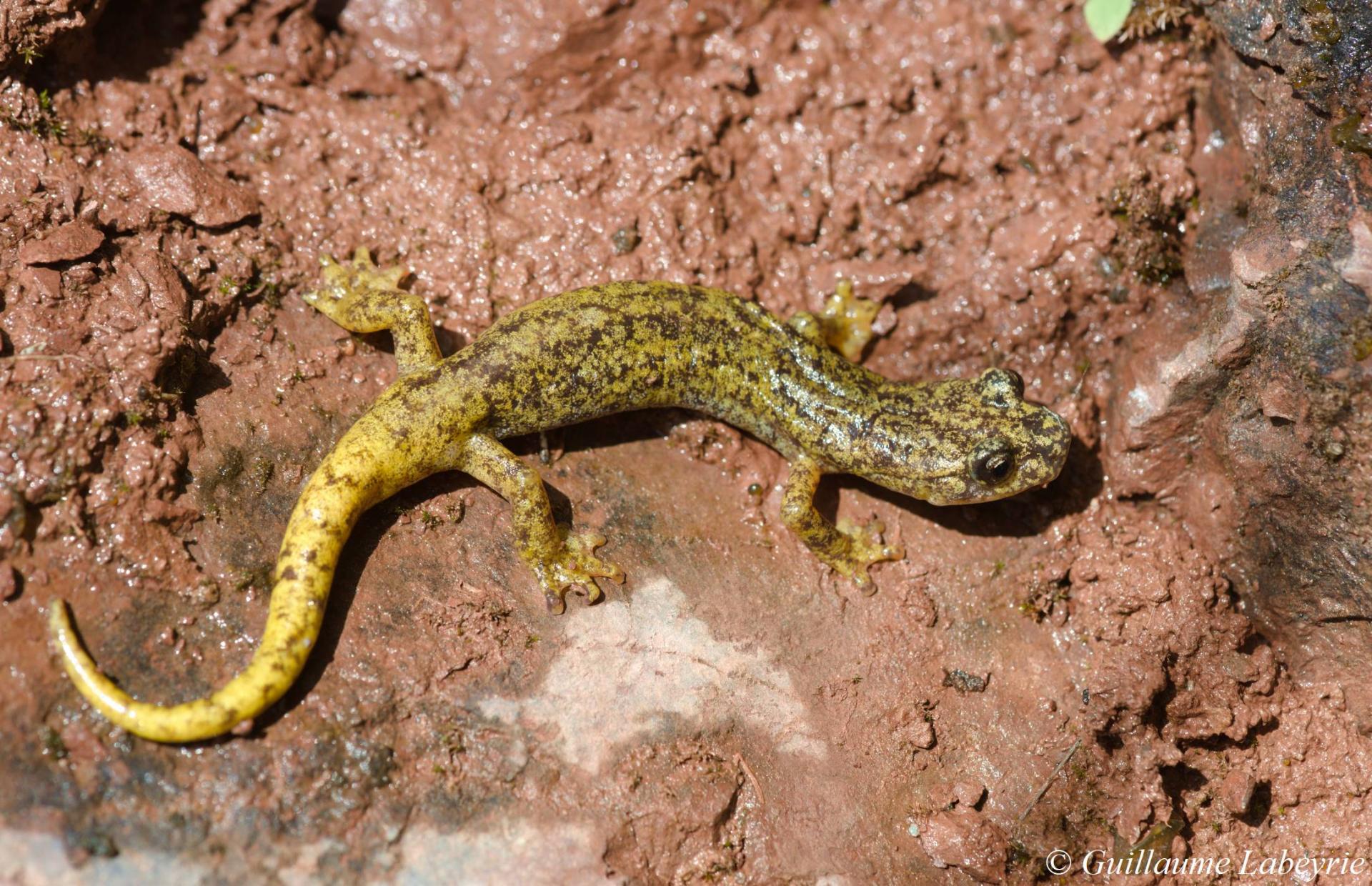 The French cave salamander (Speleomantes strinatii). This small salamander barely exceeds 10 cm. It appreciates the cavities, natural or not, providing good conditions of shade and humidity. It is present from sea level up to 2400 m altitude in the Mercantour. Quite inconspicuous, it seems relatively common in the heart of its range, which is very limited: Liguria, Piedmont and extreme south-east of France. It is fully protected in France.
The French cave salamander (Speleomantes strinatii). This small salamander barely exceeds 10 cm. It appreciates the cavities, natural or not, providing good conditions of shade and humidity. It is present from sea level up to 2400 m altitude in the Mercantour. Quite inconspicuous, it seems relatively common in the heart of its range, which is very limited: Liguria, Piedmont and extreme south-east of France. It is fully protected in France.
Arachnids
This order includes, among others, spiders, scorpions and mites. These arthropods are characterized in particular by the presence of four pairs of legs. Around 1500 species of spiders are said to be present in mainland France, and only 5 species of scorpions.
Family : Buthidae
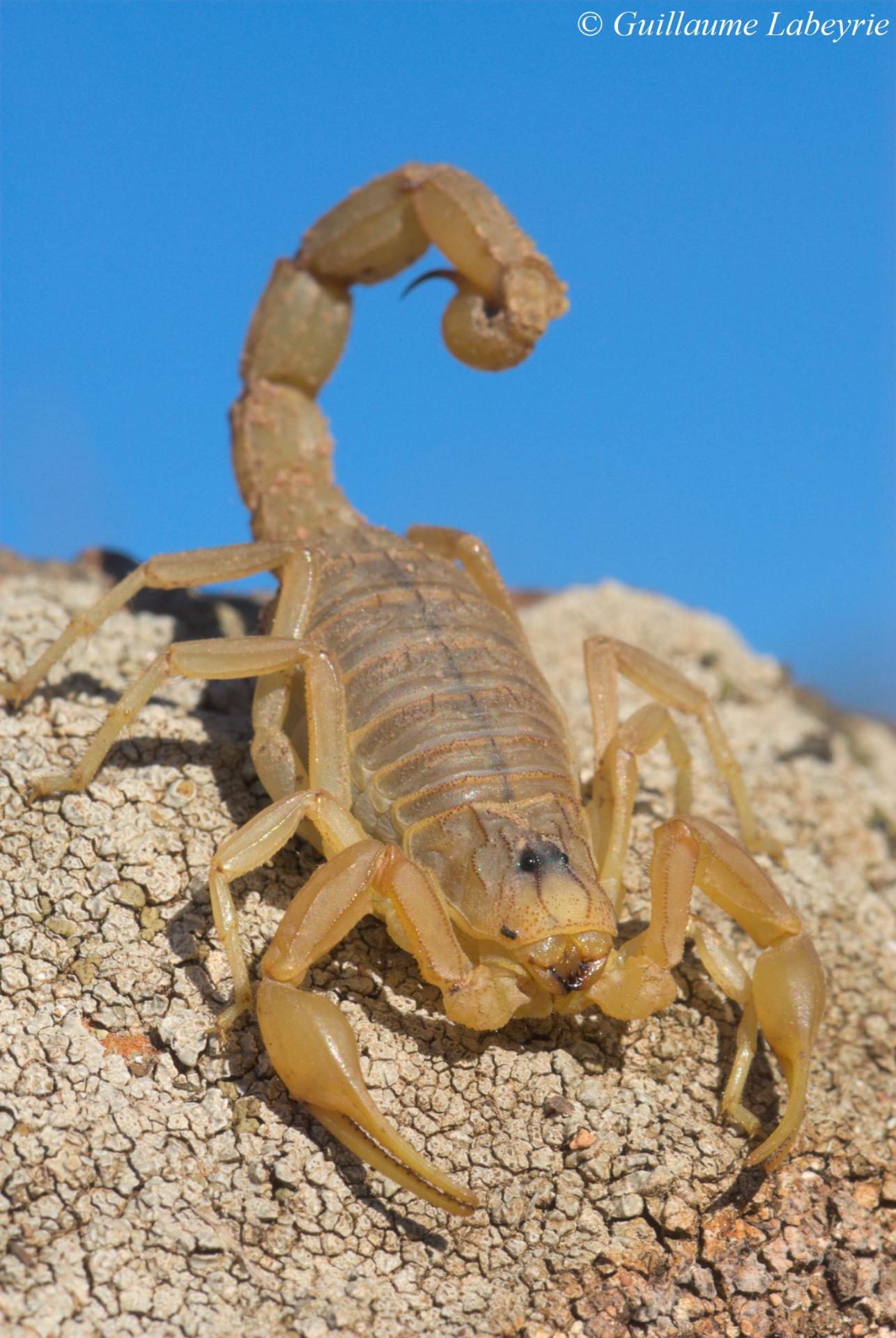 The common yellow scorpion (Buthus occitanicus). This is the largest European scorpion, reaching 8 cm. Its sting can be potentially harmful for humans. This rare species, present in France along the Mediterranean coast, is fully protected. It occurs in the Iberian peninsula, France and North Africa.
The common yellow scorpion (Buthus occitanicus). This is the largest European scorpion, reaching 8 cm. Its sting can be potentially harmful for humans. This rare species, present in France along the Mediterranean coast, is fully protected. It occurs in the Iberian peninsula, France and North Africa.
Family : Lycosidae
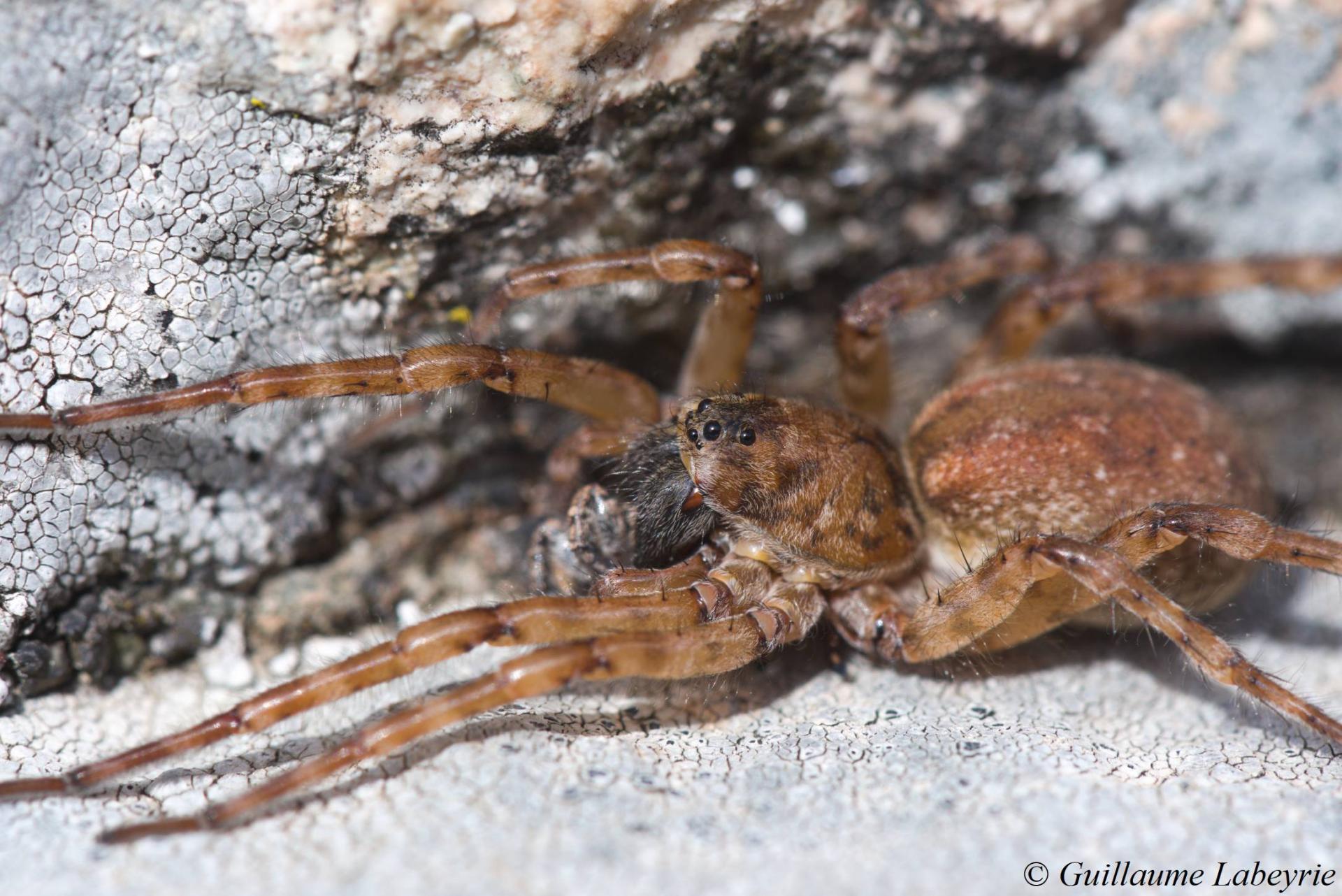
Arctosa similis. This wolf spider is found in sandy areas along rivers. It is restricted to Western Europe (Iberian Peninsula, France, Italy). In France, it is restricted to the South.
Crustaceans
Famille : Cambaridae
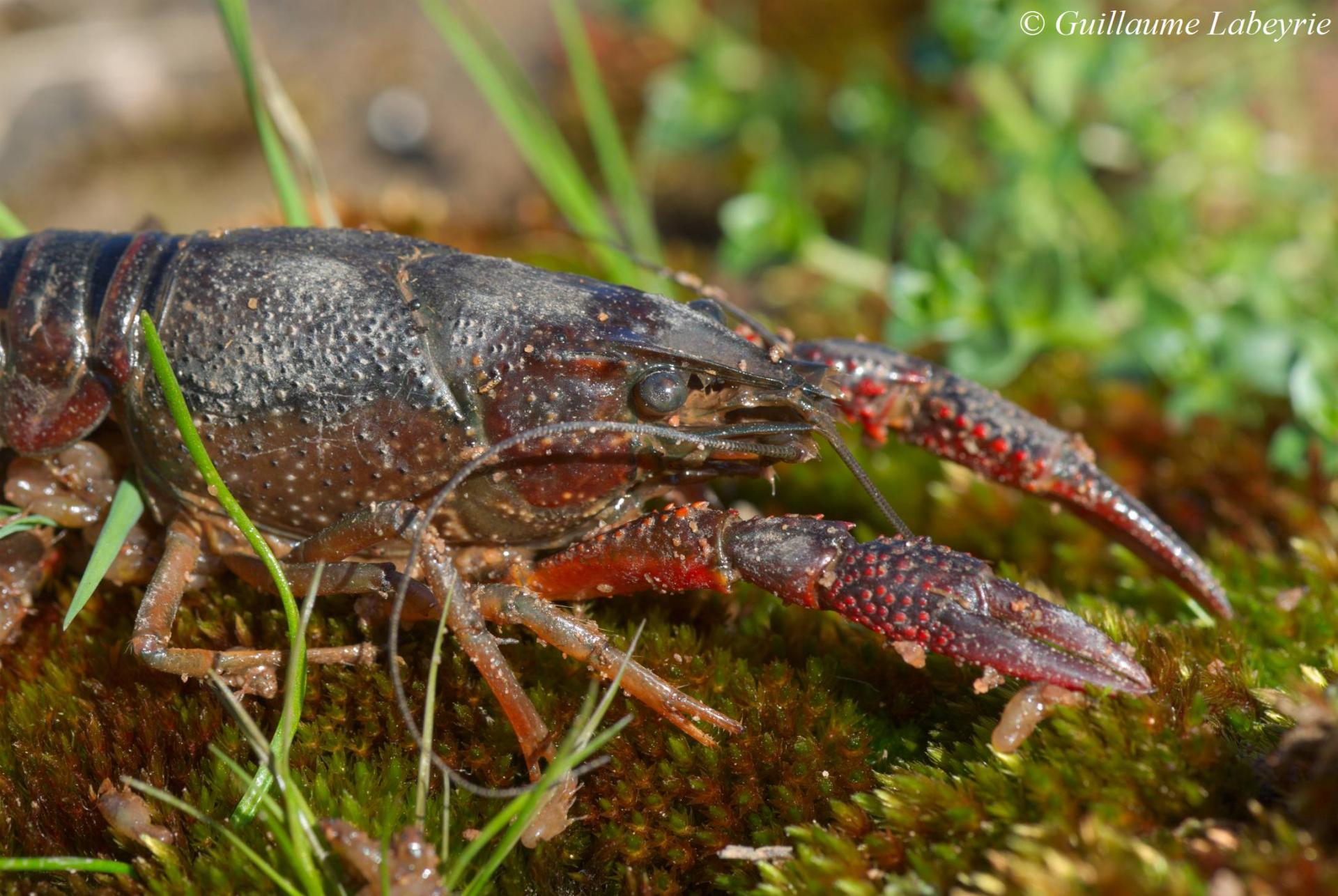 The red swamp crayfish (Procambarus clarkii). Easily identifiable by its red tubercles, this invasive crayfish is very adaptable. In a dry Mediterranean environment, it can be found far from water where it shelters in a burrow under a stone. Voluntarily introduced into France in 1976, it has colonized the entire national territory. It competes with native species and transmits diseases to them, and impacts aquatic environments by burrowing into the banks. It is forbidden to transport and release it. If you encounter it, destroy it !
The red swamp crayfish (Procambarus clarkii). Easily identifiable by its red tubercles, this invasive crayfish is very adaptable. In a dry Mediterranean environment, it can be found far from water where it shelters in a burrow under a stone. Voluntarily introduced into France in 1976, it has colonized the entire national territory. It competes with native species and transmits diseases to them, and impacts aquatic environments by burrowing into the banks. It is forbidden to transport and release it. If you encounter it, destroy it !
Family : Branchipodidae
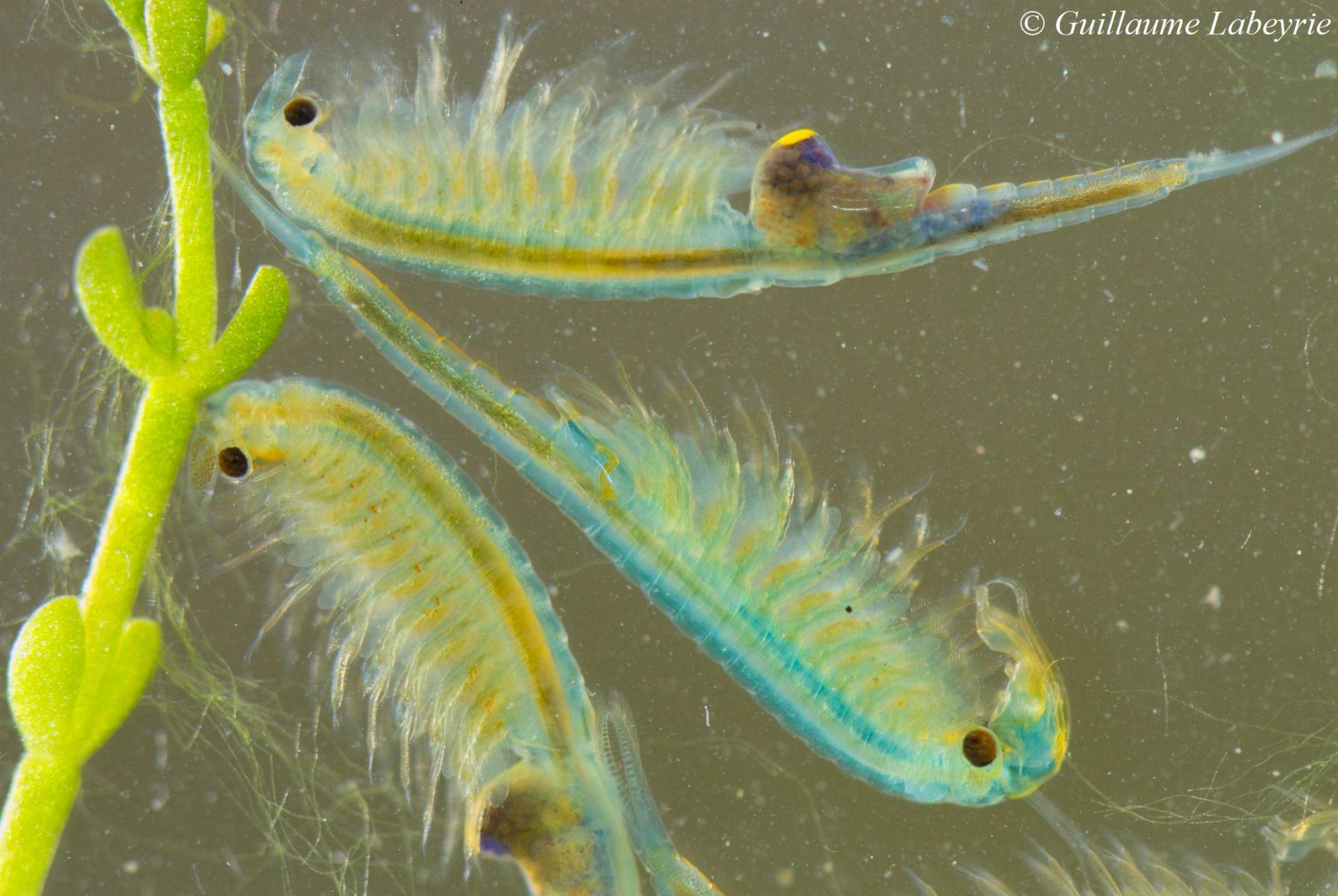 Fairy shrimps (Branchipus sp.). These strange crustaceans, about 1 cm long, are specialists of temporary cupular ponds. We see here a male in the center, surrounded by two females. The eggs or cysts are very hardy, and can persist in dried mud for years. The most widespread species in France is Branchipus schaefferi, present in PACA in particular in Crau. In the cupular ponds of the Var Tanymastix stagnalis can also be found, with a red egg sack. The taxonomic status of the populations of Branchipus from eastern Var, shown in this photo, remains uncertain.
Fairy shrimps (Branchipus sp.). These strange crustaceans, about 1 cm long, are specialists of temporary cupular ponds. We see here a male in the center, surrounded by two females. The eggs or cysts are very hardy, and can persist in dried mud for years. The most widespread species in France is Branchipus schaefferi, present in PACA in particular in Crau. In the cupular ponds of the Var Tanymastix stagnalis can also be found, with a red egg sack. The taxonomic status of the populations of Branchipus from eastern Var, shown in this photo, remains uncertain.
Butterflies
The PACA region is home to an exceptional diversity of Lepidoptera. 85% of the Rhopalocera (''day butterflies'') of mainland France are found there (the Alpes-Maritimes department alone, with an area equivalent to 0.78% of French territory, concentrates 78% of the species). Butterflies are good indicators of the quality of an ecosystem. They are in decline across Europe, with a 40% decrease in numbers observed since 1990. This decline is attributed to habitat destruction, pesticides, and to some extent global warming.
Family : Papilionidae
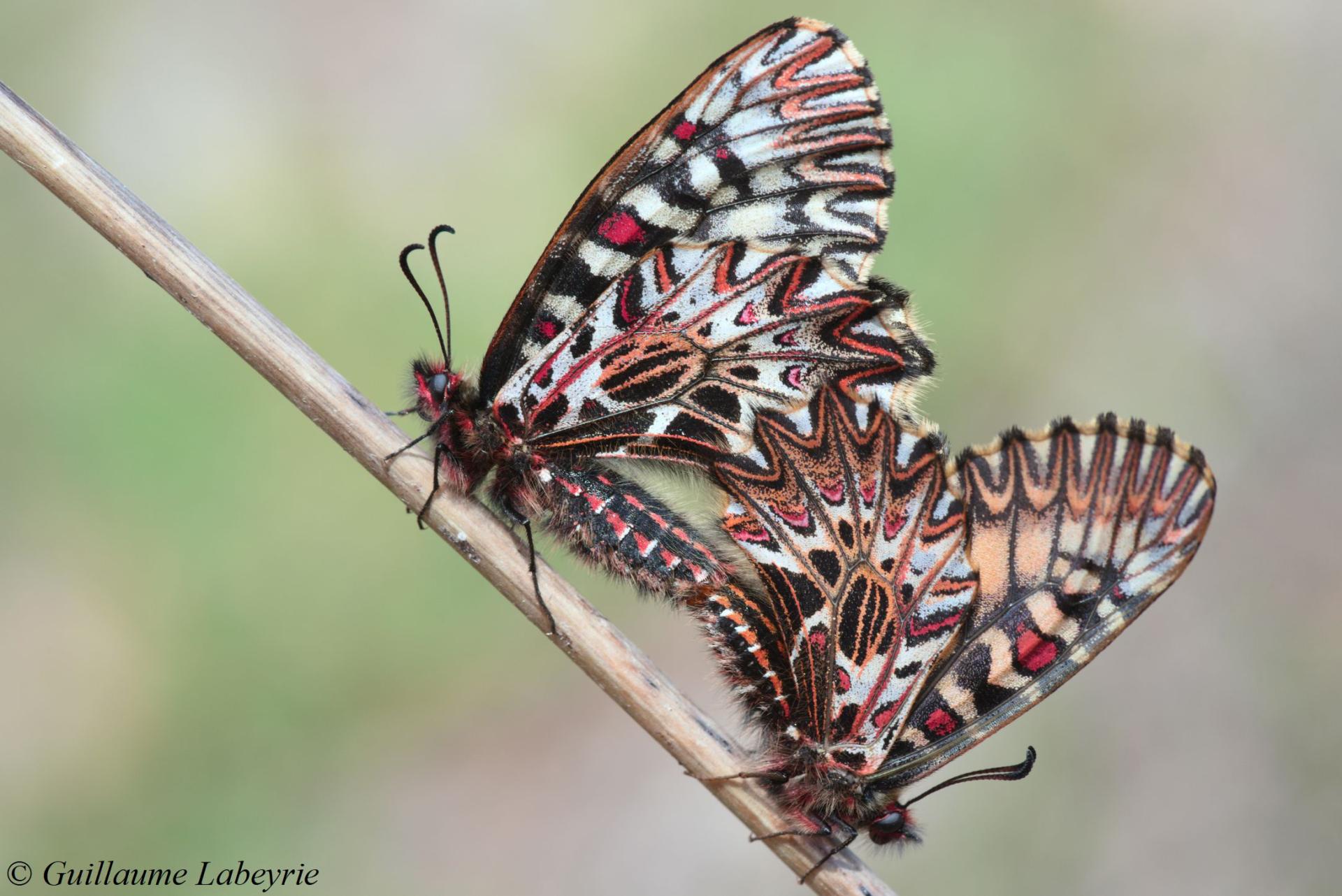
The southern Festoon (Zerynthia polyxena). This splendid butterfly lives in the wet meadows bordering the Mediterranean streams where grows its host plant, the round-leaved birthwort (Aristolochia rotunda). Present in southern Europe and Asia Minor, this species is found in France near the Mediterranean coast. It is fully protected.
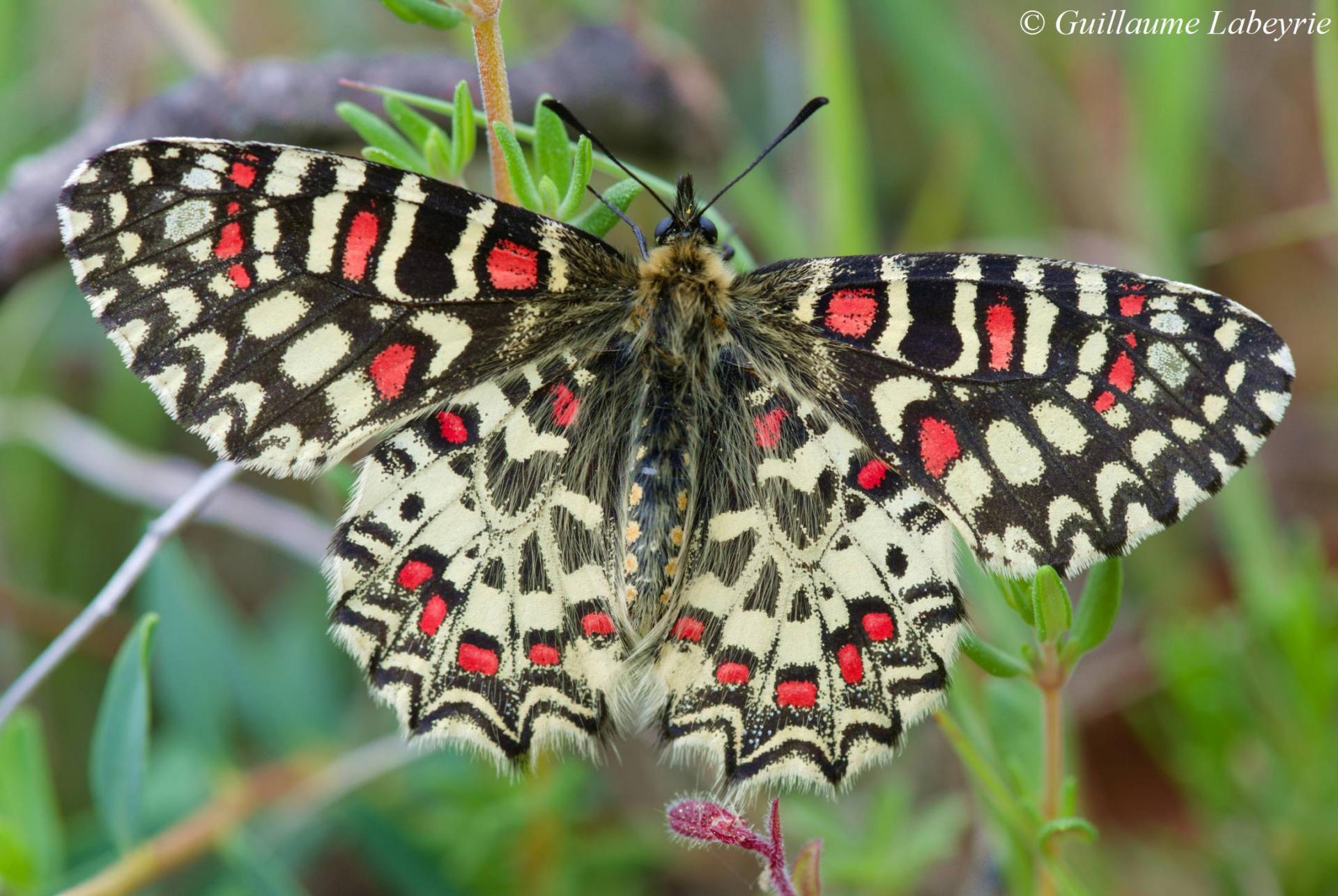 The spanish Festoon (Zerynthia rumina). This magnificent species is much more marked with red than the previous one, especially on the forewings. It frequents drier and rockier environments, where grows its host plant, the birthwort Aristolochia pistolochia. It is distributed in South-Western Europe (France, Spain and Portugal) and in North Africa. It is protected in France, where it is restricted to the Mediterranean coast.
The spanish Festoon (Zerynthia rumina). This magnificent species is much more marked with red than the previous one, especially on the forewings. It frequents drier and rockier environments, where grows its host plant, the birthwort Aristolochia pistolochia. It is distributed in South-Western Europe (France, Spain and Portugal) and in North Africa. It is protected in France, where it is restricted to the Mediterranean coast.
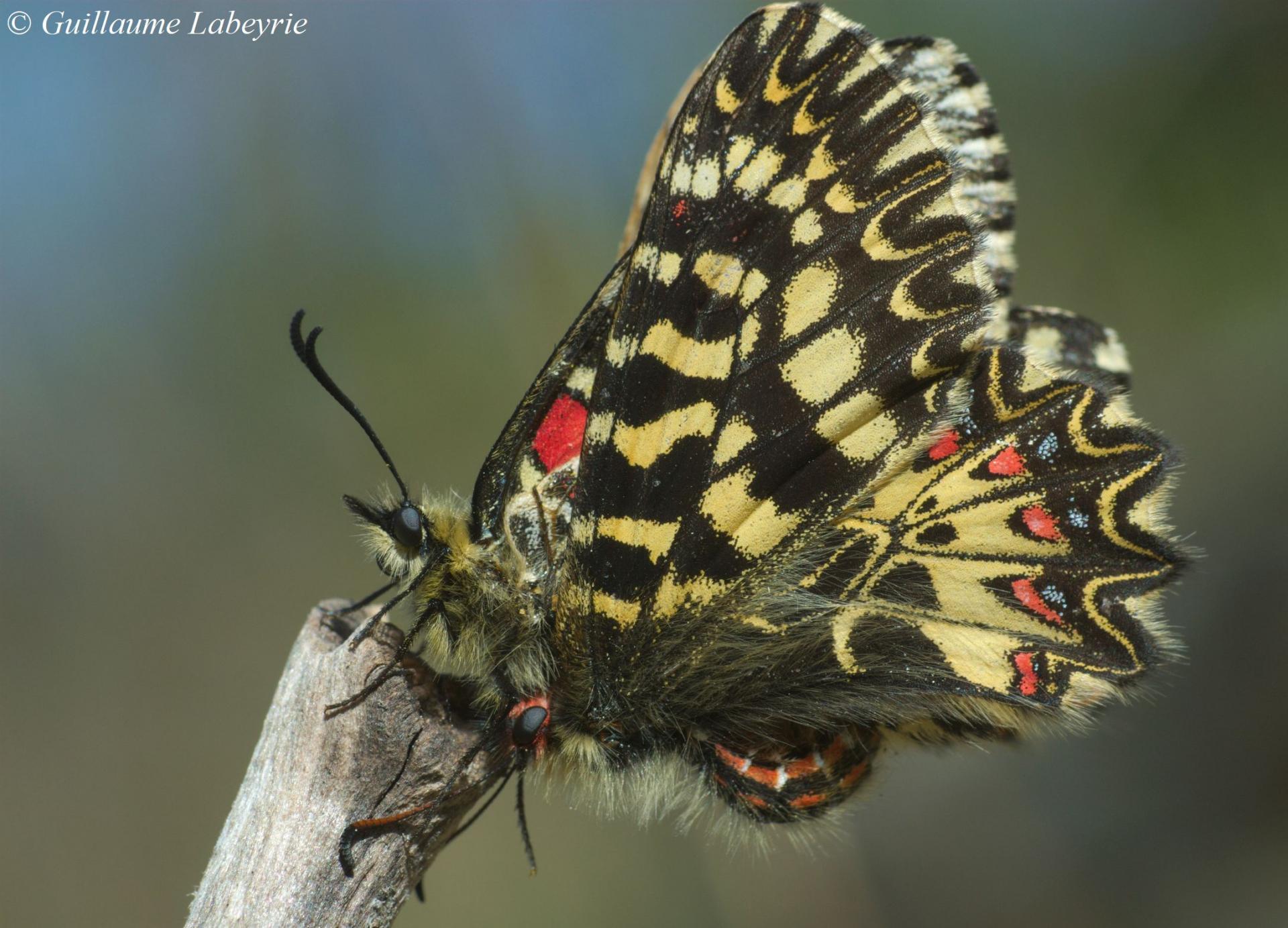 Inter-specific festoon mating. In the rare localities where the two species of Zerynthia coexist, hybridizations can occur. This photo illustrates the mating, rarely photographed in the wild, of a female Z. rumina (above) with a male Z. polyxena (below).
Inter-specific festoon mating. In the rare localities where the two species of Zerynthia coexist, hybridizations can occur. This photo illustrates the mating, rarely photographed in the wild, of a female Z. rumina (above) with a male Z. polyxena (below).
Family : Nymphalidae
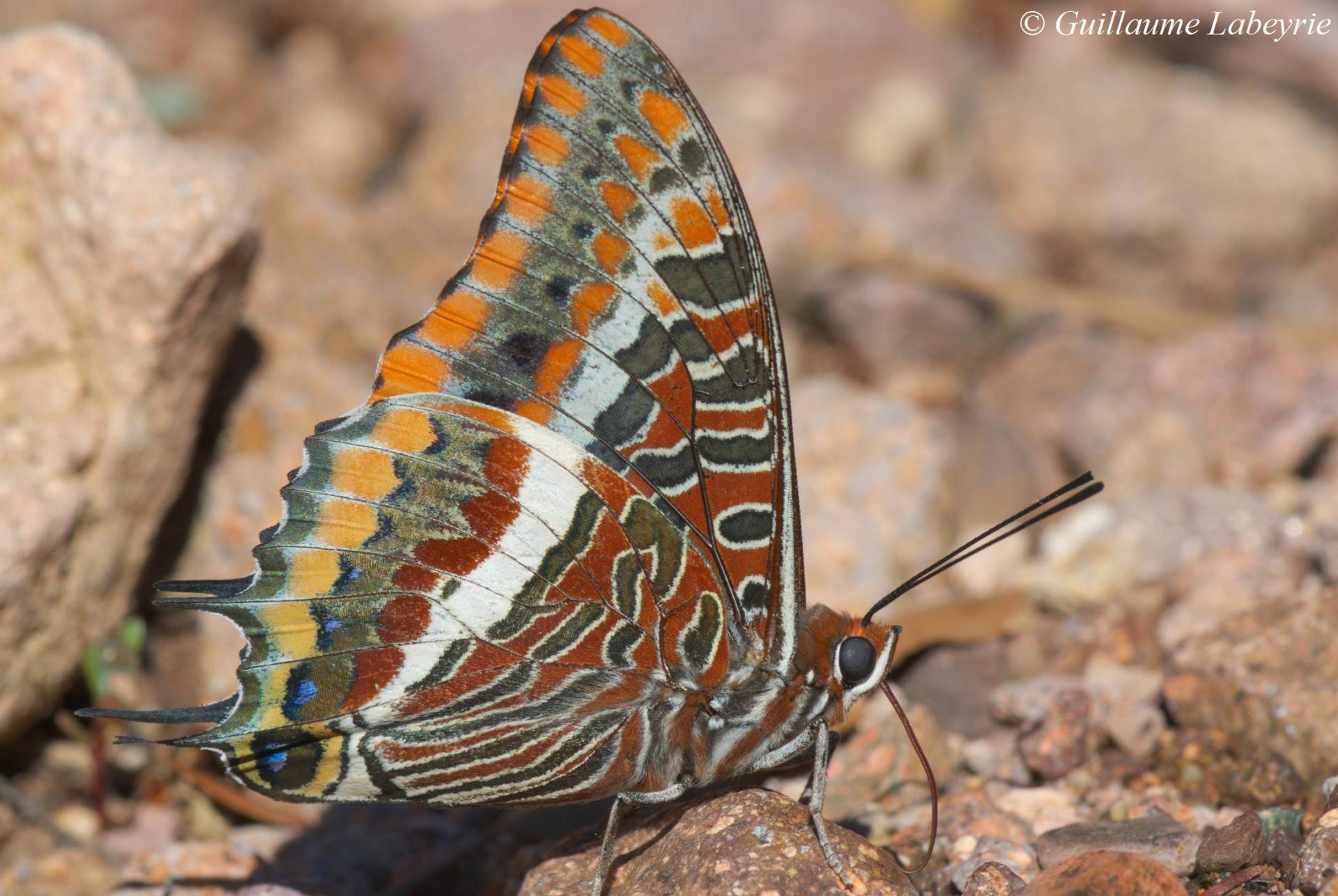 The two-tailed pasha (Charaxes jasius). This is one of the largest butterflies in Europe, and one of the most beautiful. It is found in maquis and other places where its host plant, the strawberry tree (Arbutus unedo), grows. Present in Africa and southern Europe, it is found in France in a southern third of the country.
The two-tailed pasha (Charaxes jasius). This is one of the largest butterflies in Europe, and one of the most beautiful. It is found in maquis and other places where its host plant, the strawberry tree (Arbutus unedo), grows. Present in Africa and southern Europe, it is found in France in a southern third of the country.
Family : Lycaenidae
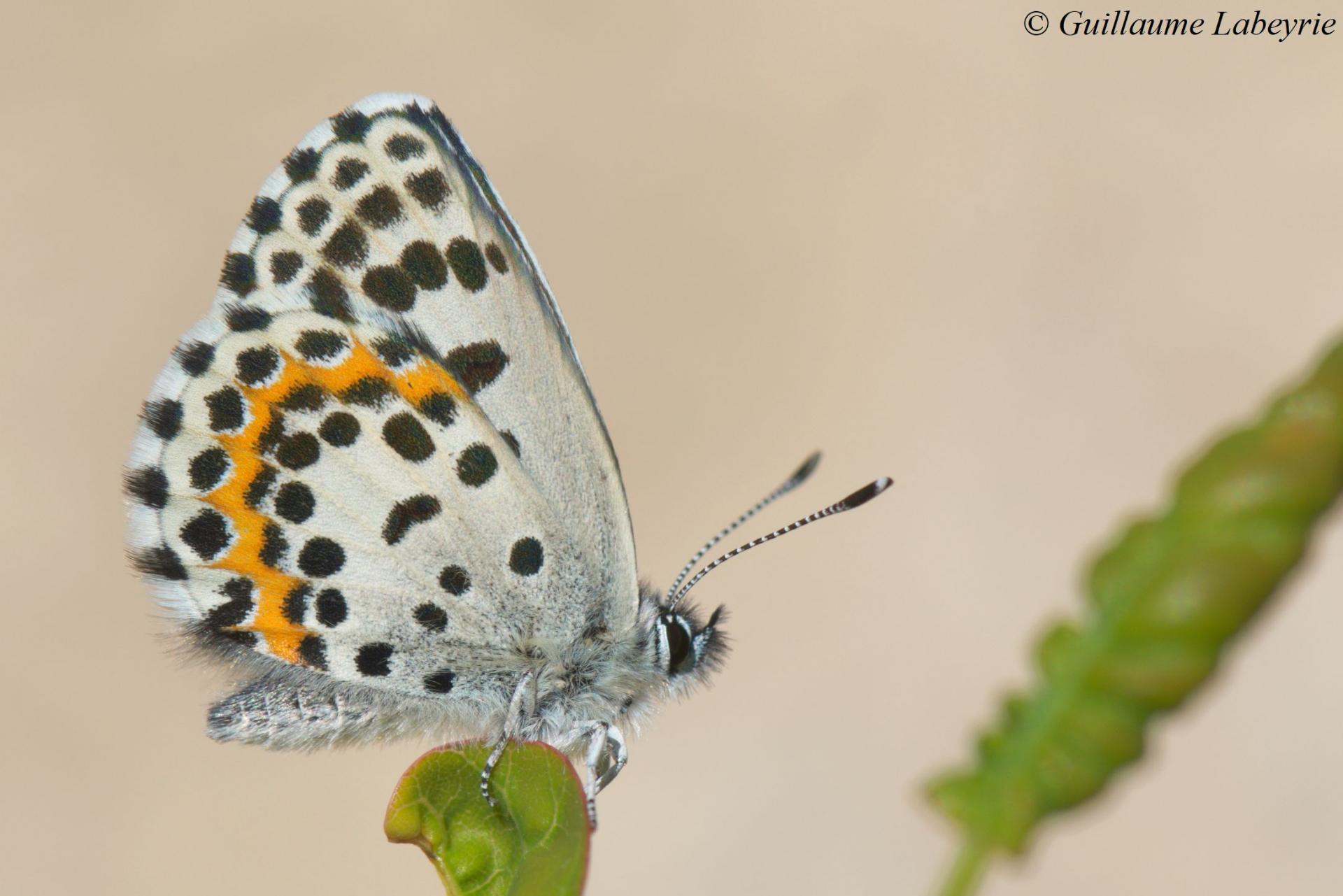 The chequered blue butterfly (Scolitantides orion). This nice little blue is strongly marked with black and orange on the underside of the wings. In the male, the uperside is mostly black, with some dark blue scales. This rather rare species is found in dry and rocky places where stonecrops (Sedum sp.) grow, both on limestone and siliceous soil. This butterfly has a wide worldwide distribution, but it is always localized. In France, it is present in a large south-eastern third.
The chequered blue butterfly (Scolitantides orion). This nice little blue is strongly marked with black and orange on the underside of the wings. In the male, the uperside is mostly black, with some dark blue scales. This rather rare species is found in dry and rocky places where stonecrops (Sedum sp.) grow, both on limestone and siliceous soil. This butterfly has a wide worldwide distribution, but it is always localized. In France, it is present in a large south-eastern third.
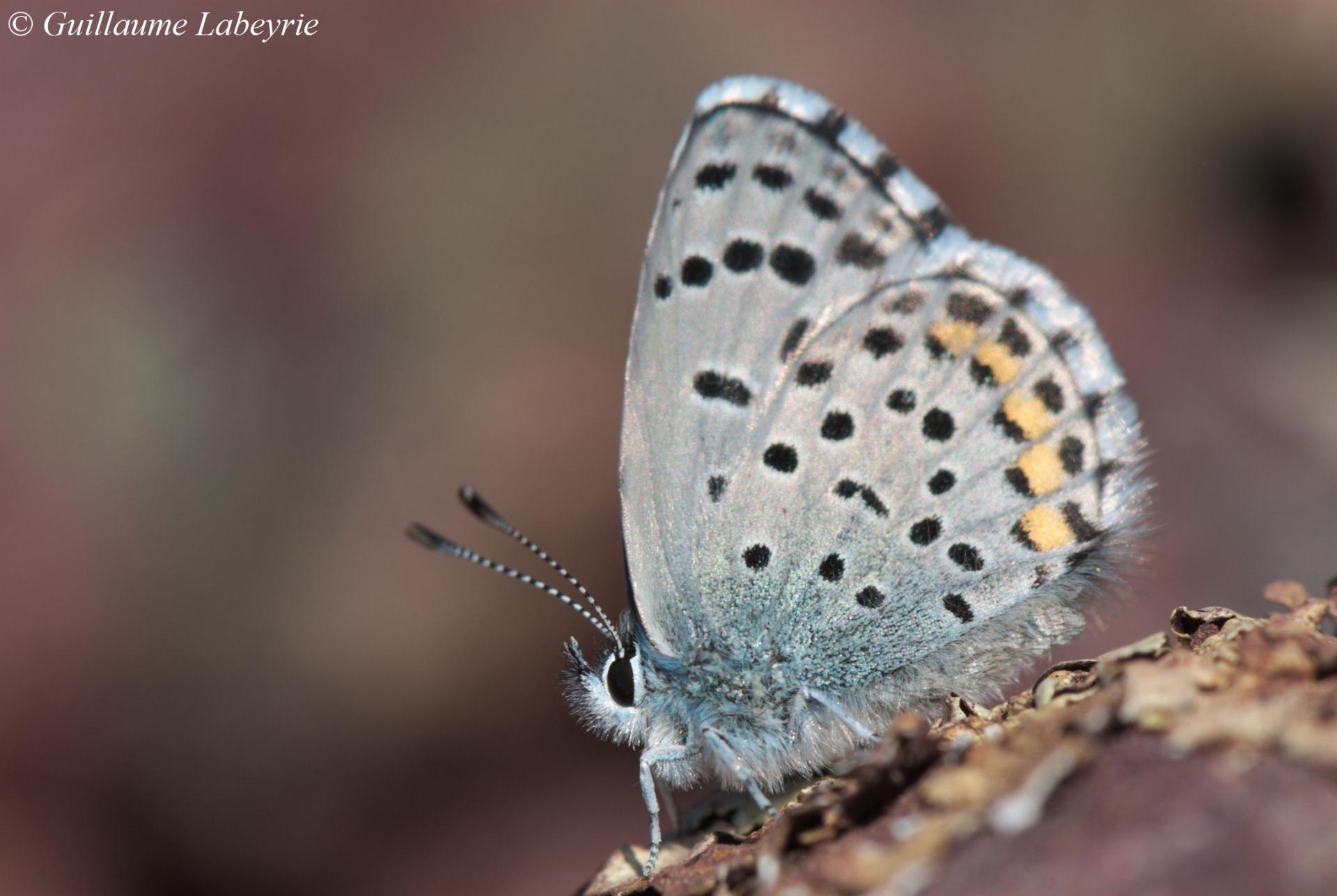 The baton blue (Pseudophilotes baton). Even smaller than the previous species, it is distinguished by the orange lunules on the back of the hindwings which are well differentiated and do not form a continuous band. The upper side of the male is light blue. It is found in dry places where thyme, its host plant, grows. Present in a large part of France, it is protected in the Ile-de-France region.
The baton blue (Pseudophilotes baton). Even smaller than the previous species, it is distinguished by the orange lunules on the back of the hindwings which are well differentiated and do not form a continuous band. The upper side of the male is light blue. It is found in dry places where thyme, its host plant, grows. Present in a large part of France, it is protected in the Ile-de-France region.
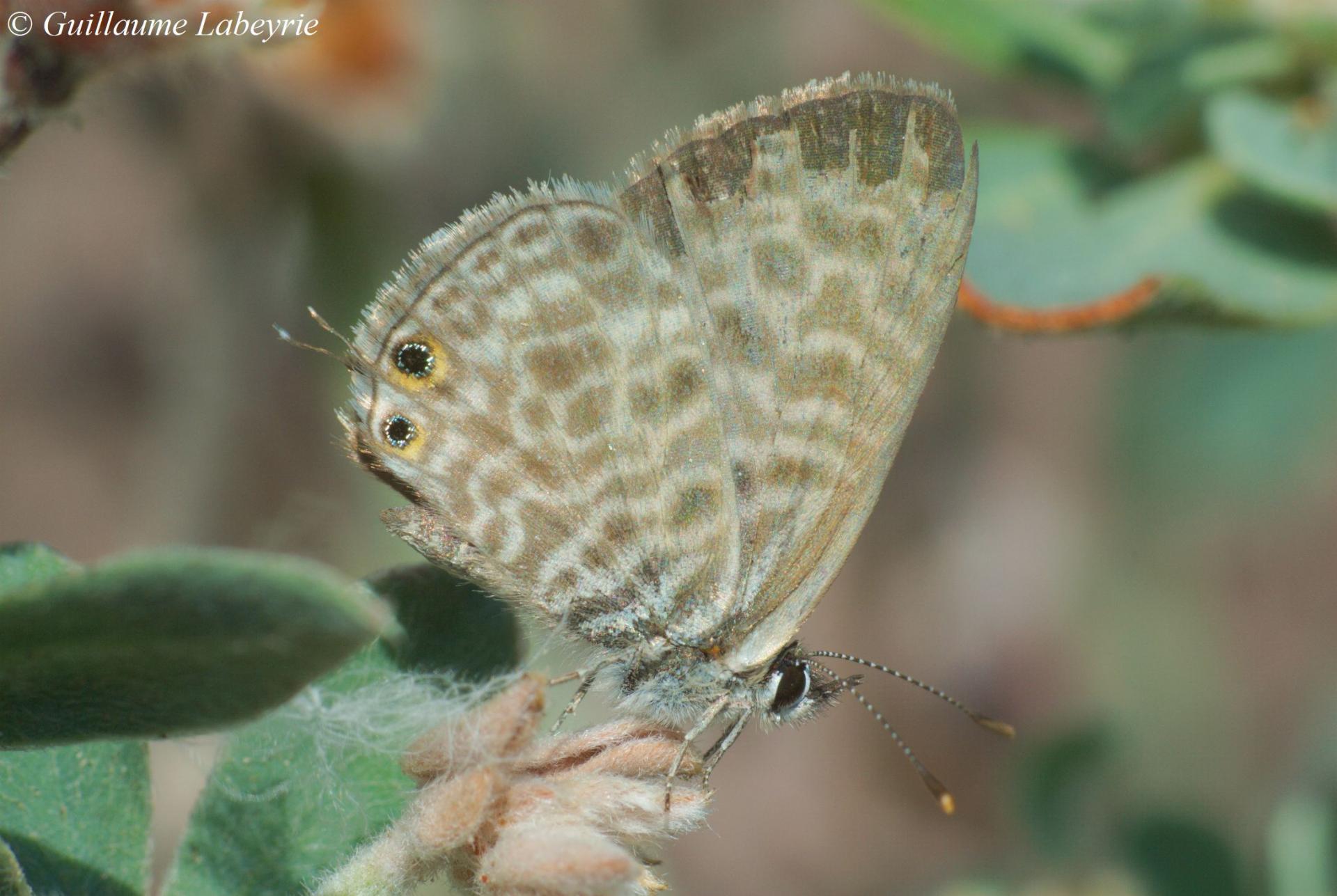 Lang's short-tailed blue (Leptotes pirithous). This small butterfly is identified by the complex white pattern on the underside of the wings and the presence of tiny tails on the hindwings. It is found in Africa, Asia and southern Europe. In France, it lives in the Mediterranean south but can be seen in most of the country during migrations.
Lang's short-tailed blue (Leptotes pirithous). This small butterfly is identified by the complex white pattern on the underside of the wings and the presence of tiny tails on the hindwings. It is found in Africa, Asia and southern Europe. In France, it lives in the Mediterranean south but can be seen in most of the country during migrations.
Famille : Pieridae
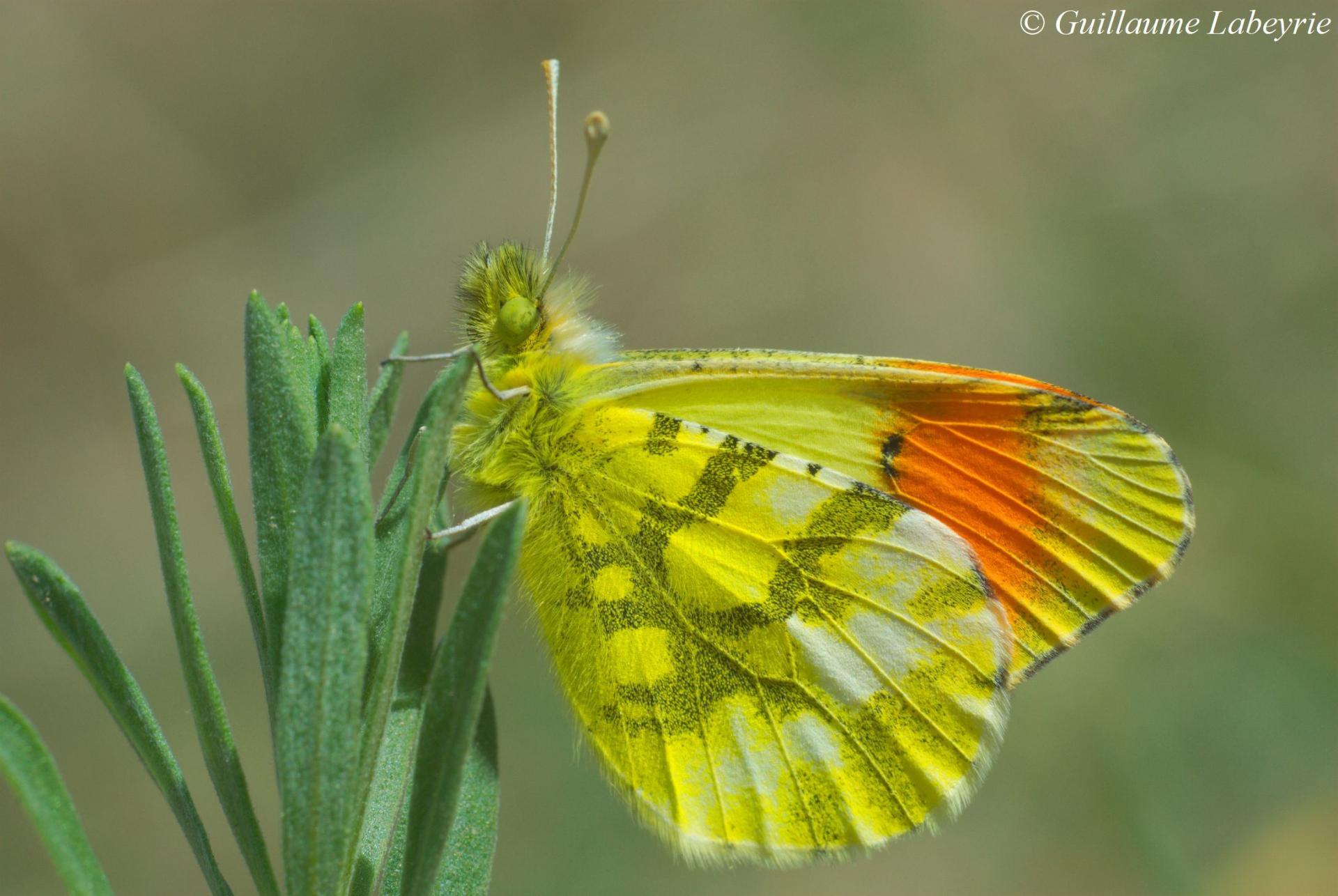 The Moroccan ornage tip (Anthocaris euphenoides). This colorful butterfly flies in spring above dry slopes looking for Biscutella laevigata, its host plant. The yellow wings with and orange tip are distinctive. This butterfly occurs mostly in Northern Africa and in southwestern Europe including south of France.
The Moroccan ornage tip (Anthocaris euphenoides). This colorful butterfly flies in spring above dry slopes looking for Biscutella laevigata, its host plant. The yellow wings with and orange tip are distinctive. This butterfly occurs mostly in Northern Africa and in southwestern Europe including south of France.
Famille : Hesperiidae
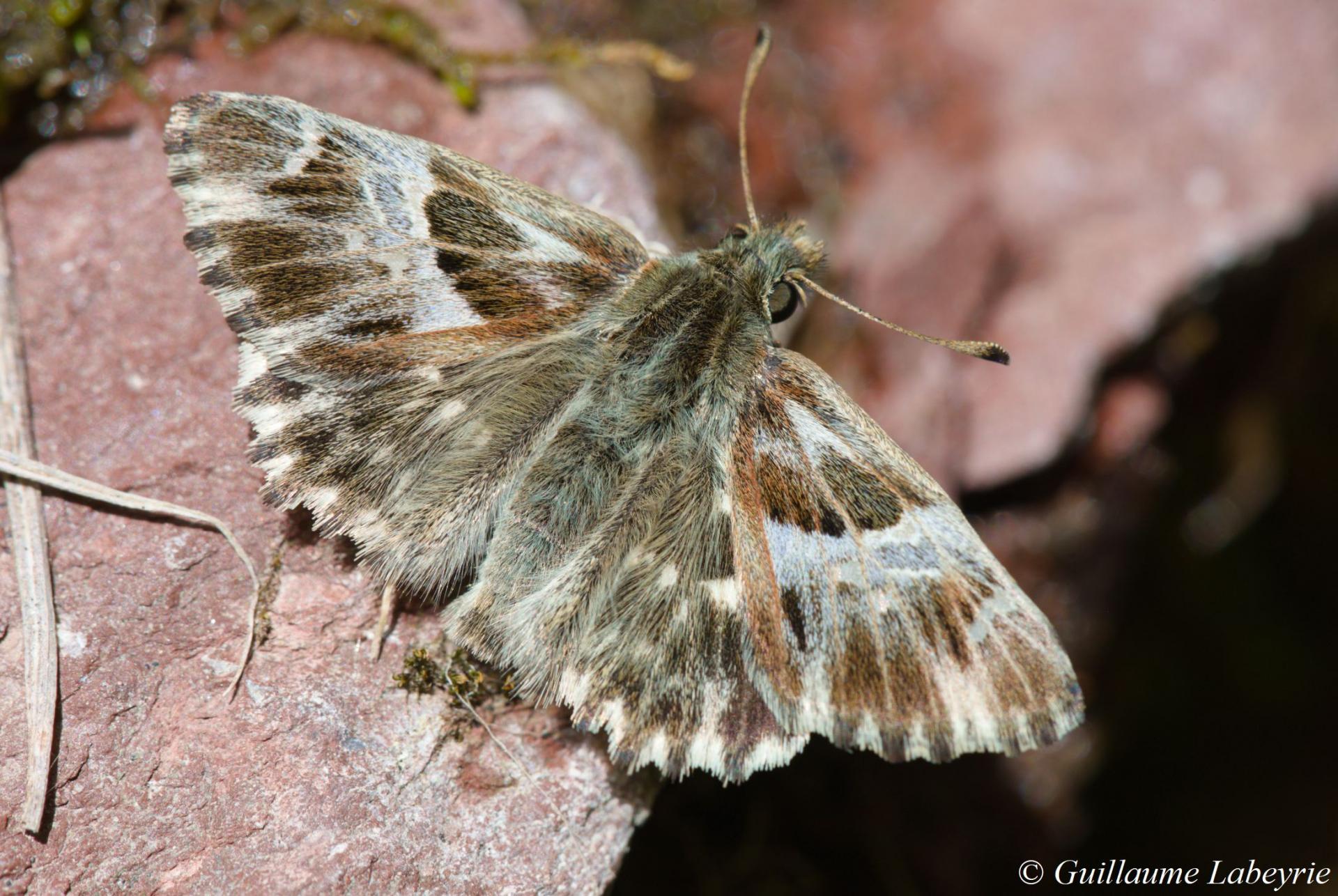 The tufted skipper (Carcharodus floccifer). Species of the genus Carcharodus are distinguished from other Hesperiidae by the presence of more or less translucent "windows" on the forewings and the absence of the usual pattern of white spots on a gray background. C. floccifer is distinguished from C. alceae, a similar species, in particular by the very white spots on the front of the hind wings. This butterfly is present in a southern half of France.
The tufted skipper (Carcharodus floccifer). Species of the genus Carcharodus are distinguished from other Hesperiidae by the presence of more or less translucent "windows" on the forewings and the absence of the usual pattern of white spots on a gray background. C. floccifer is distinguished from C. alceae, a similar species, in particular by the very white spots on the front of the hind wings. This butterfly is present in a southern half of France.
Famille : Erebidae
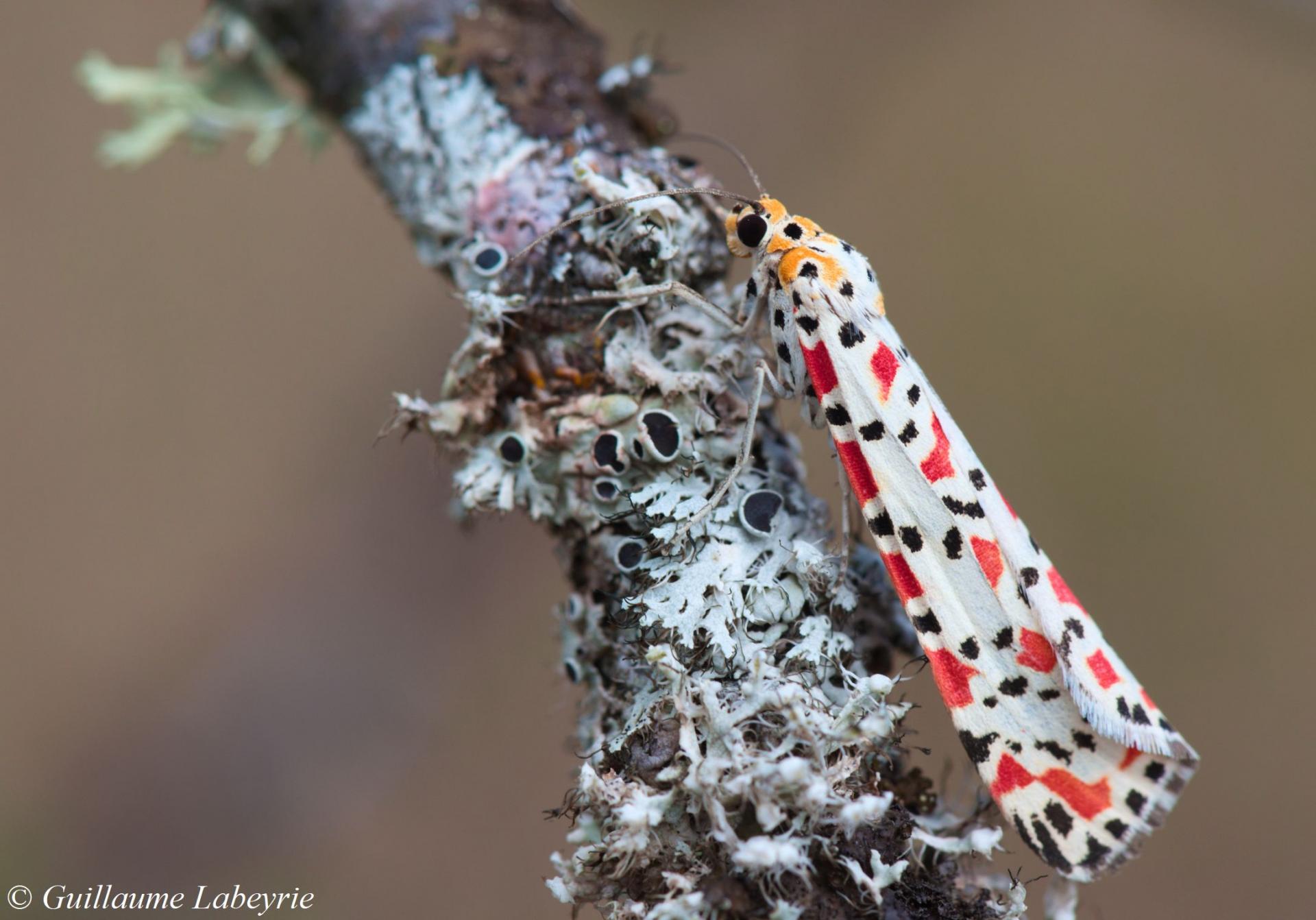 The crimson-speckled flunkey (Utetheisa pulchella). This small but colorful moth is observed in France especially on the Mediterranean coast. It can be encountered, rarely, up to 1000 m altitude. Its host plants are various species of Boraginaceae. It is a subtropical migrant, with a wide global distribution.
The crimson-speckled flunkey (Utetheisa pulchella). This small but colorful moth is observed in France especially on the Mediterranean coast. It can be encountered, rarely, up to 1000 m altitude. Its host plants are various species of Boraginaceae. It is a subtropical migrant, with a wide global distribution.
Famille : Saturniidae
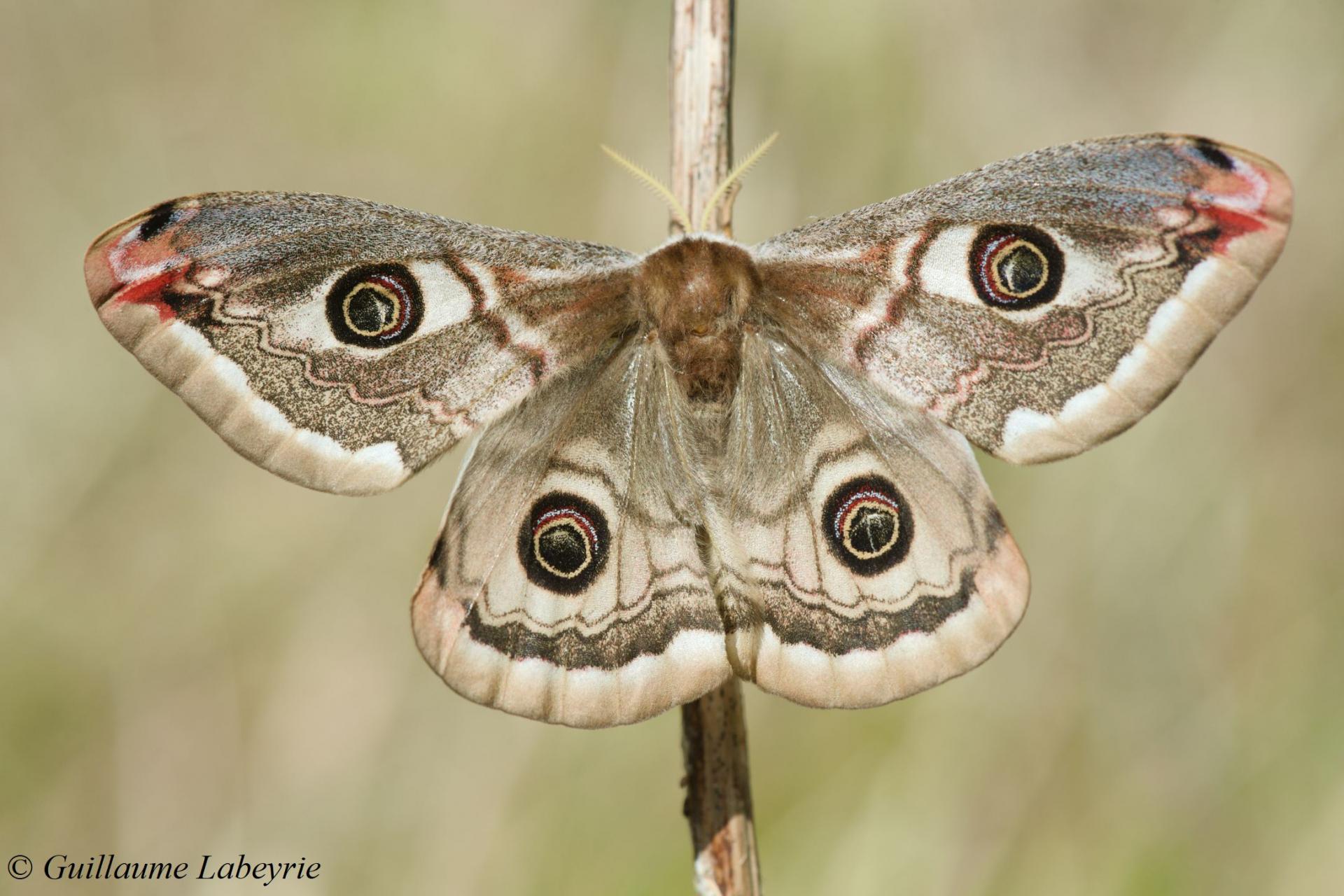 Saturnia pavoniella. This taxon, formerly considered a subspecies of the small emperor moth (Saturnia pavonia), was elevated to species status in 2003. One of the morphological criteria for differentiation is the fact that the posterior and submedian lines on the hindwings approach before diverging near the inner edge of the wing (parallel in S. pavonia). However, a study by Mazel in 2008 showed a systematic mixture of criteria, hence some confusion about the status of this taxon ! It is present from Slovenia to France, and in France on the Mediterranean border.
Saturnia pavoniella. This taxon, formerly considered a subspecies of the small emperor moth (Saturnia pavonia), was elevated to species status in 2003. One of the morphological criteria for differentiation is the fact that the posterior and submedian lines on the hindwings approach before diverging near the inner edge of the wing (parallel in S. pavonia). However, a study by Mazel in 2008 showed a systematic mixture of criteria, hence some confusion about the status of this taxon ! It is present from Slovenia to France, and in France on the Mediterranean border.
Family : Sphingidae
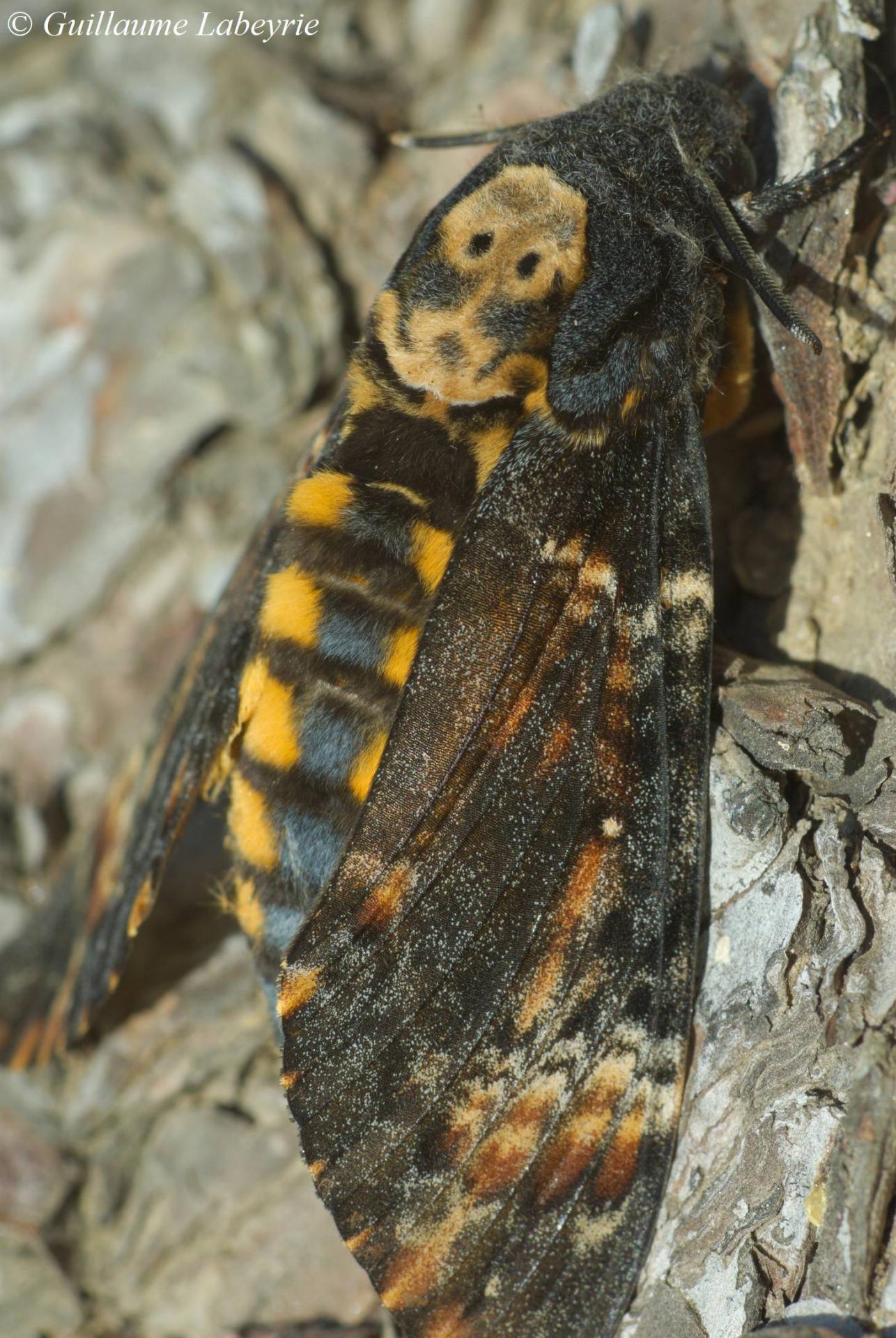 The death's-head hawk moth (Acherontia atropos). This magnificent moth is one of the biggest in Europe, with a wingspan up to 5 inches. When taken in hands, it has the particularity to squeal. A great honey-lover, this moth gets inside beehives protected by its dense fur. Resident in Africa and Asia, this moth is found in Europe as a summer migratory species (in regressing numbers).
The death's-head hawk moth (Acherontia atropos). This magnificent moth is one of the biggest in Europe, with a wingspan up to 5 inches. When taken in hands, it has the particularity to squeal. A great honey-lover, this moth gets inside beehives protected by its dense fur. Resident in Africa and Asia, this moth is found in Europe as a summer migratory species (in regressing numbers).
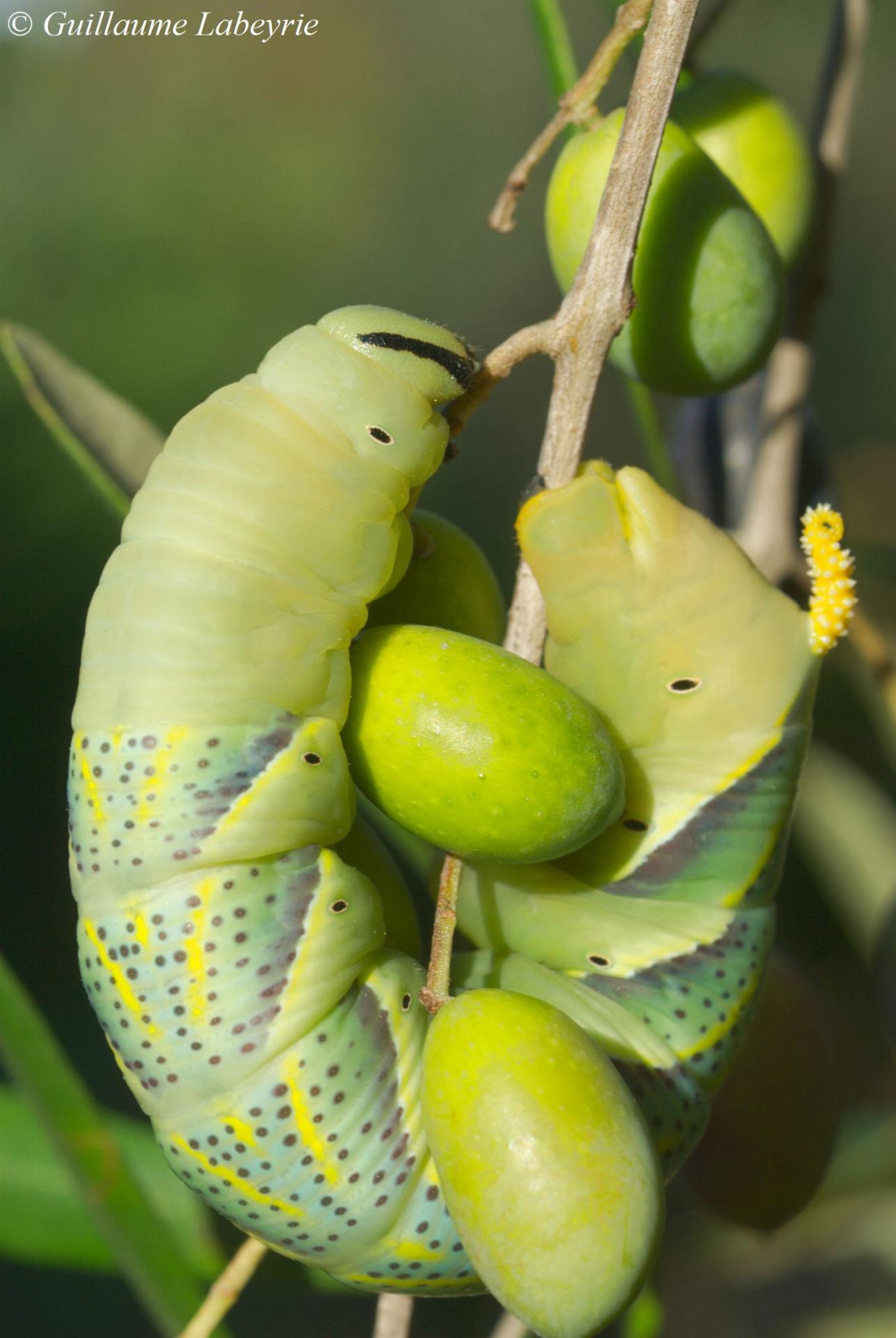 Caterpillar of death's-head hawk moth (Acherontia atropos) on olive tree. This caterpillar is spectacular due to its size (up to 15 cm), its shape and its colors. It feeds on various Solanaceae (potatoes, eggplant) but also sometimes on olive trees.
Caterpillar of death's-head hawk moth (Acherontia atropos) on olive tree. This caterpillar is spectacular due to its size (up to 15 cm), its shape and its colors. It feeds on various Solanaceae (potatoes, eggplant) but also sometimes on olive trees.
Family : Zygaenidae
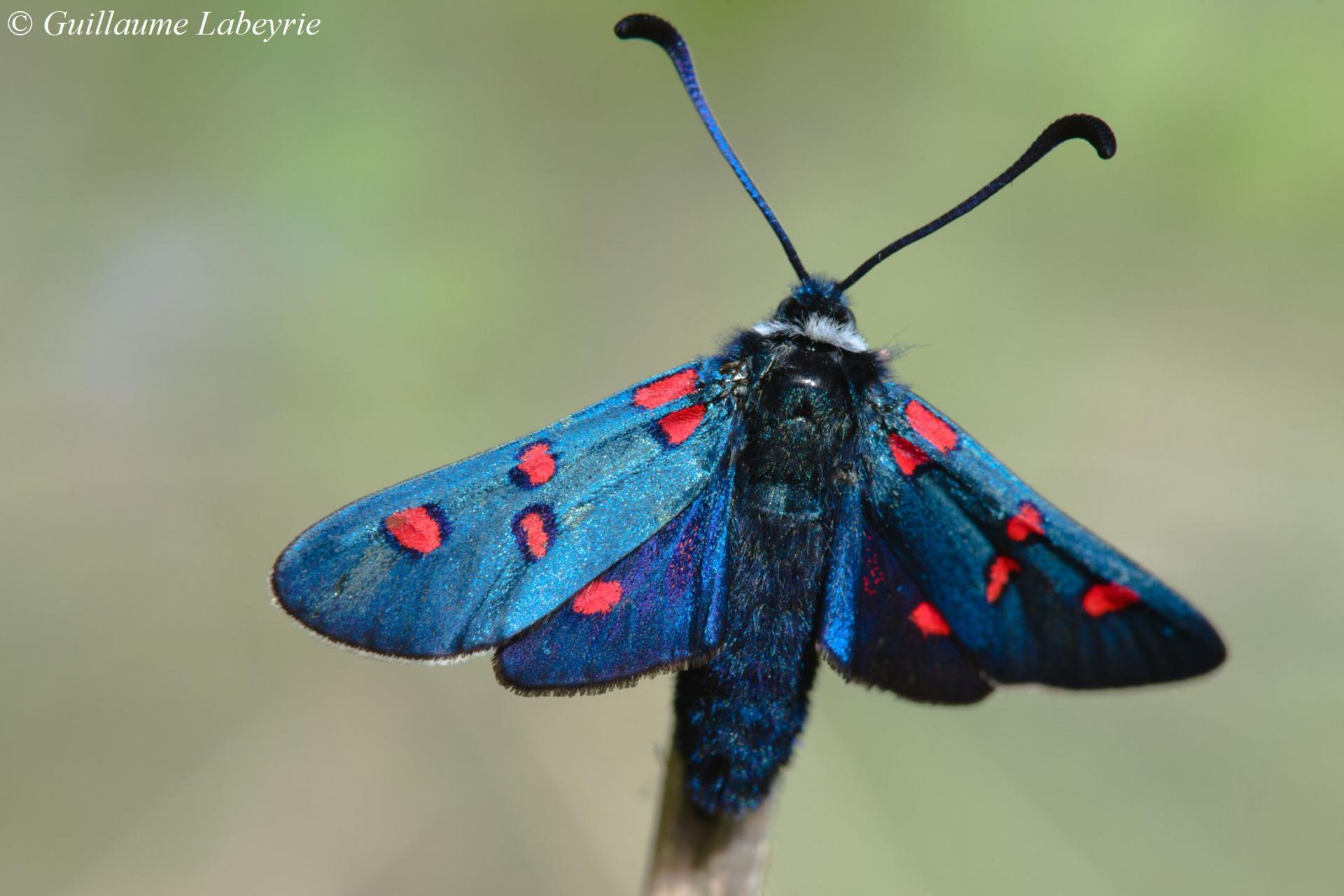 Zygaena lavandulae. This zygene is easily identified, with its white collar and its bluish wings with red spots circled in black. It is found in dry places up to an altitude of about 1000 m, where its host plant the Fabaceae Lotus dorycnium grows. Distributed in Western Europe (Portugal, Spain, France, and Italy only in Liguria) and North Africa, this species is present in France in the South.
Zygaena lavandulae. This zygene is easily identified, with its white collar and its bluish wings with red spots circled in black. It is found in dry places up to an altitude of about 1000 m, where its host plant the Fabaceae Lotus dorycnium grows. Distributed in Western Europe (Portugal, Spain, France, and Italy only in Liguria) and North Africa, this species is present in France in the South.
Beetles
Very large, this order includes about 10,000 species in France. Some are among our largest insects, such as the greater capricorn (Cerambyx cerdo) and the European rhinoceros (Oryctes nasicornis).
Family : Carabidae
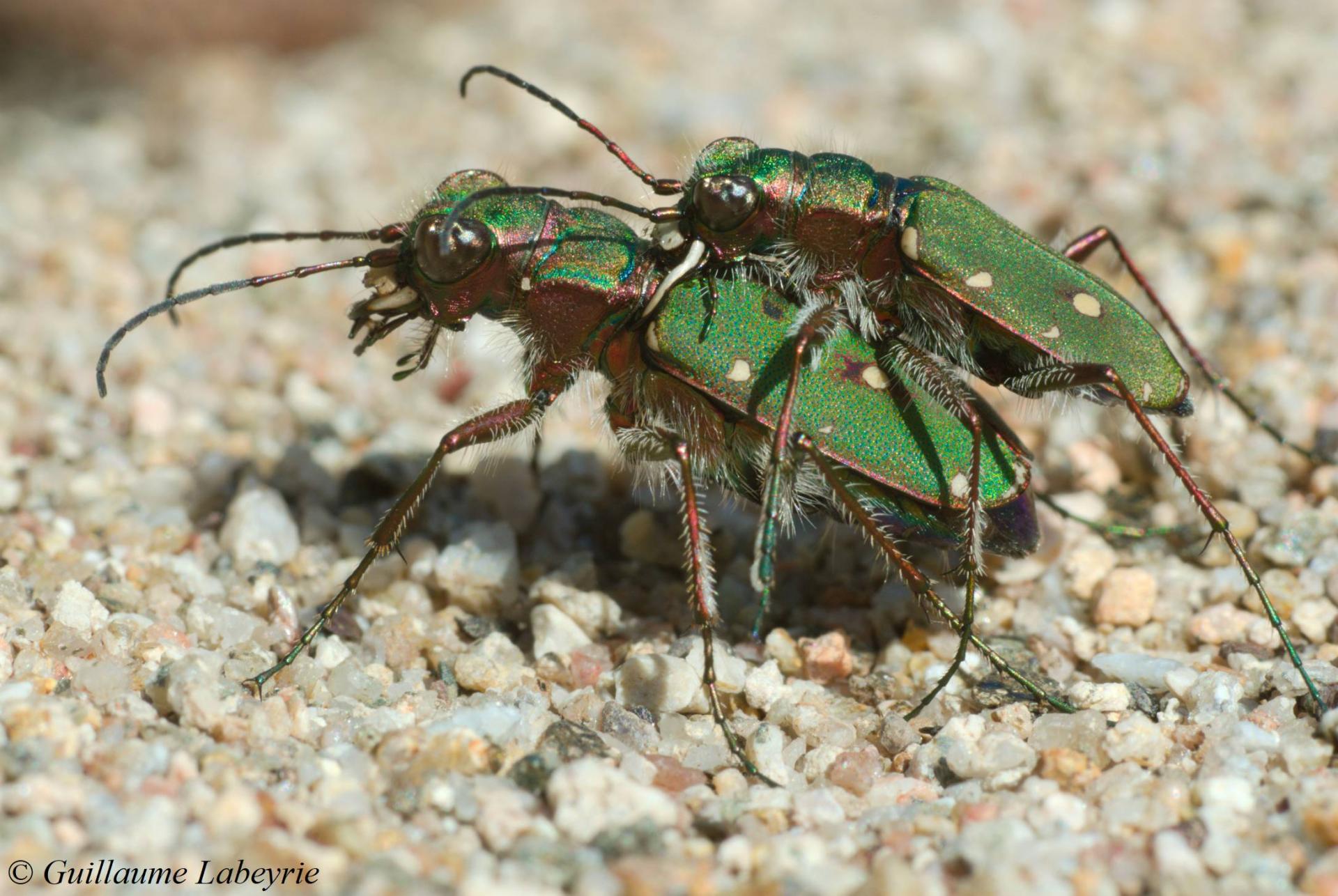 Green tiger beetles (Cicindela campestris) mating. Tiger beetles are voracious predators with a rapid flight and an excellent eyesight. They are usually found in sandy, open areas. The green tiger beetle is distributed through most of Europe.
Green tiger beetles (Cicindela campestris) mating. Tiger beetles are voracious predators with a rapid flight and an excellent eyesight. They are usually found in sandy, open areas. The green tiger beetle is distributed through most of Europe.
Lophyra flexuosa. This beautiful tiger beetle is distinguished by a bronze-colored body, with large, flexuous white bands on the elytra. It appreciates sandy beaches near streams. It is mainly present in southern Western Europe and North Africa. In France, it is found on the Atlantic coast and on the Mediterranean coast as far as the Var department in the east.
Family : Curculionidae
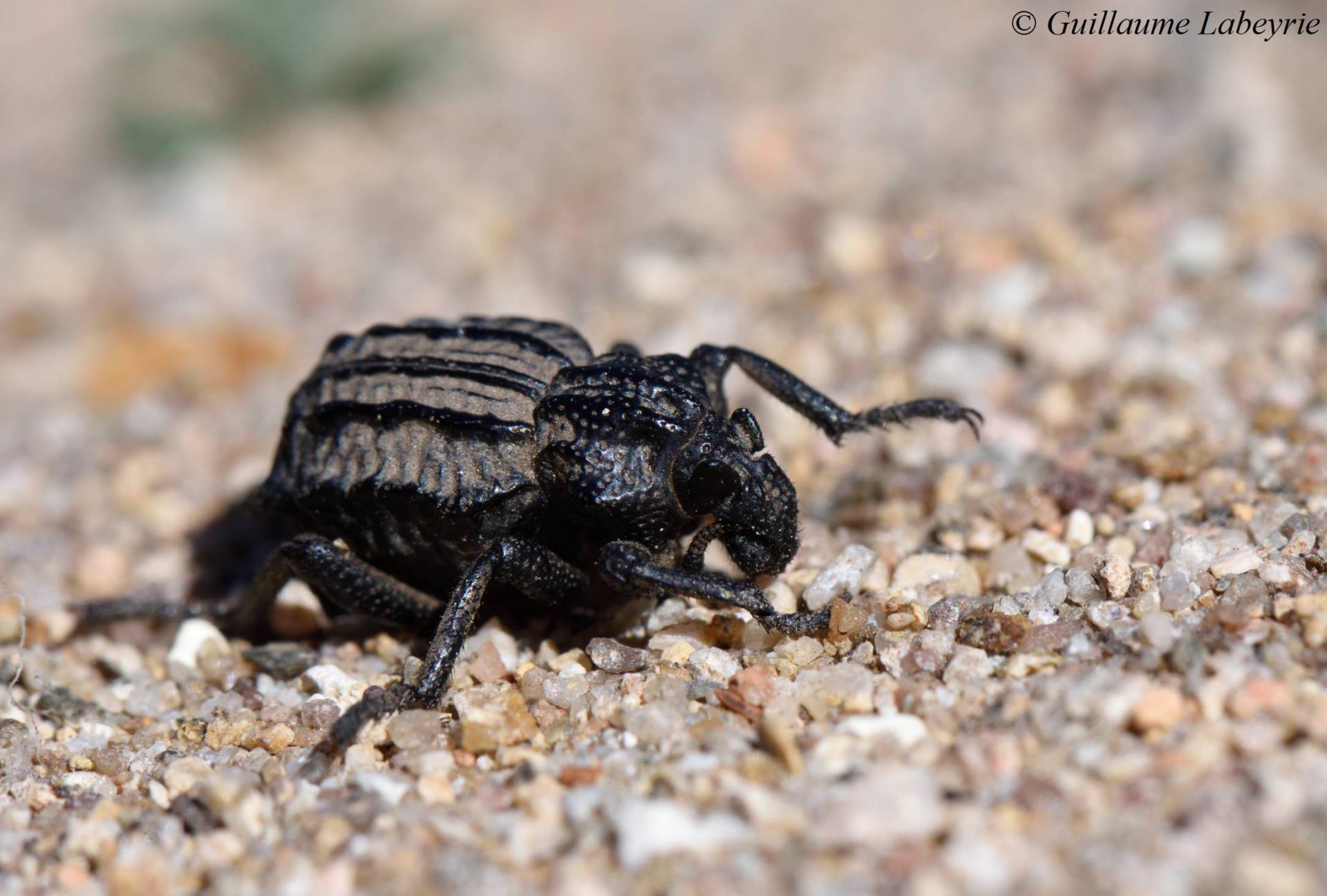
Brachycerus undatus. This large weevil has distinctive ridges on the elytra and pronotum. Its larva develops in the bulbs of Liliaceae and Amaryllidaceae. It is found in dry areas with little vegetation. Present sporadically in Europe on the Mediterranean coast, it is only found in France between Montpellier and the Var valley, in the Alpes-Maritimes.
Family : Scarabaeidae
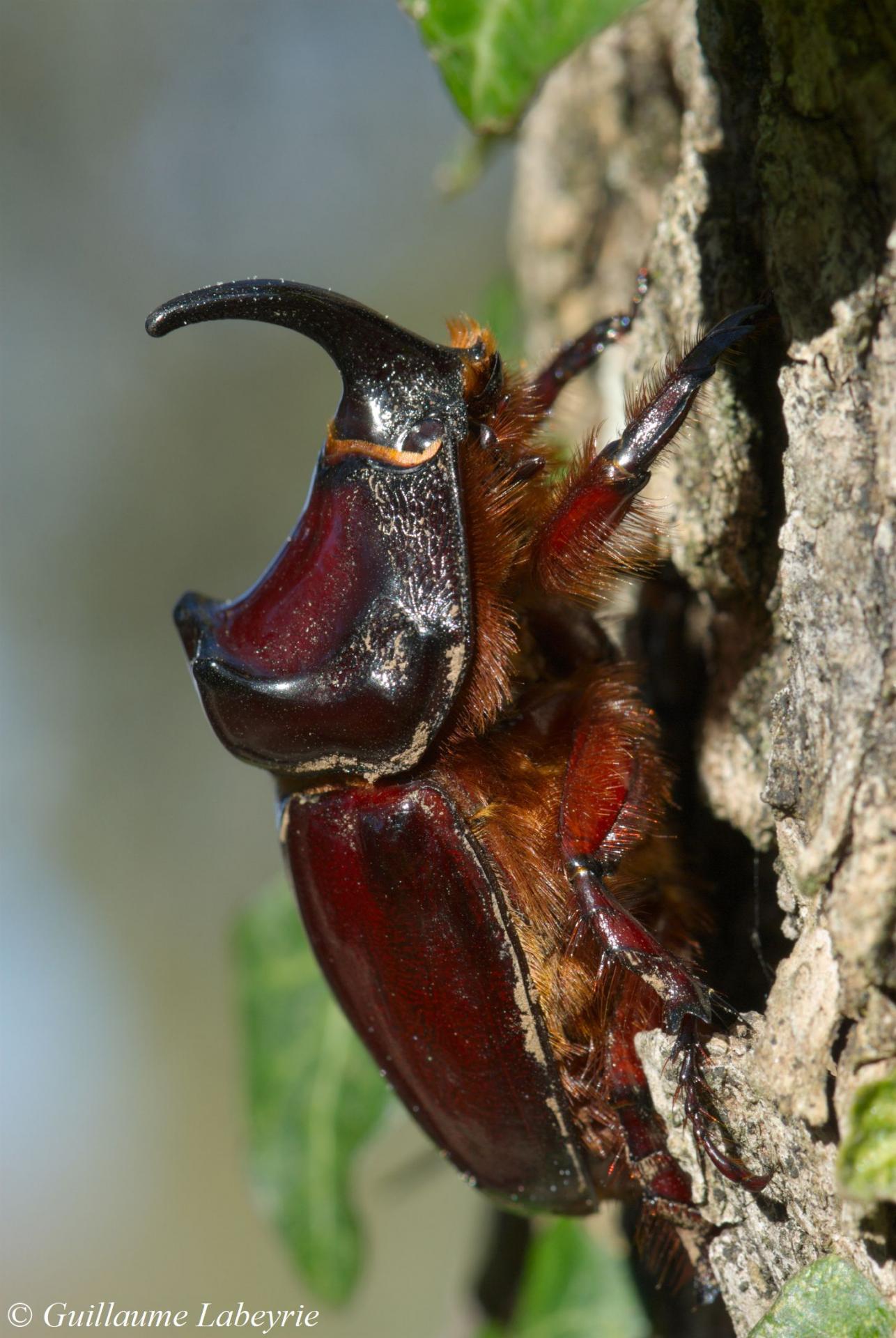 The European rhinoceros beetle (Oryctes nasicornis). This superb beetle is one of our largest and heaviest species. It is often attracted at night by house lighting. Its larvae develop in decomposed wood and garden compost. They are parasitized by a giant wasp, the mammoth wasp (Megascolia maculata). Present in Europe up to Pakistan, the rhinoceros beetle is found in a large part of France.
The European rhinoceros beetle (Oryctes nasicornis). This superb beetle is one of our largest and heaviest species. It is often attracted at night by house lighting. Its larvae develop in decomposed wood and garden compost. They are parasitized by a giant wasp, the mammoth wasp (Megascolia maculata). Present in Europe up to Pakistan, the rhinoceros beetle is found in a large part of France.
Family : Vesperidae
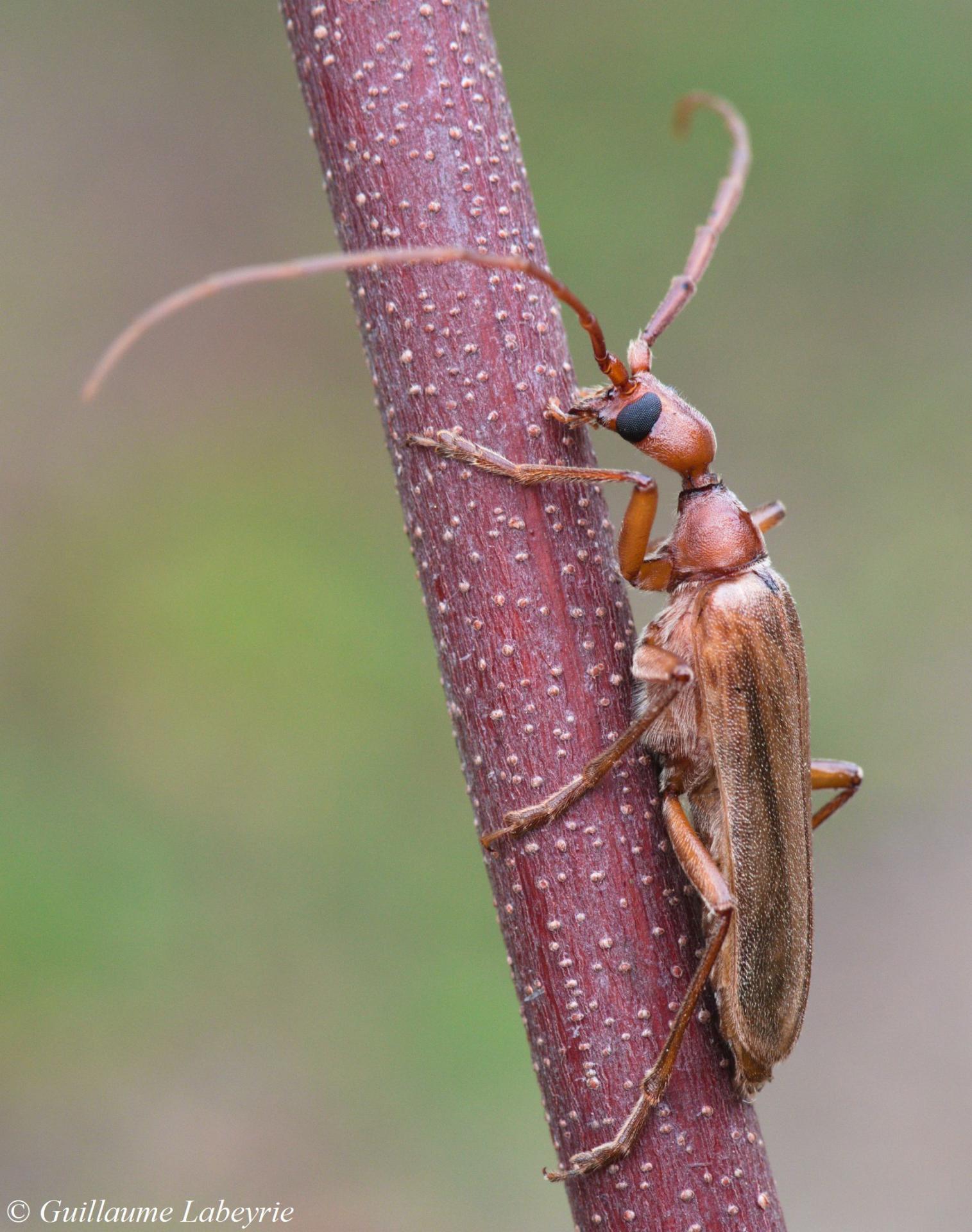 Vesperus strepens. The males of the species fly at dusk and often appear late in the season, in November or even December. Vesperus strepens is restricted to southeastern France (Var, Alpes-de-Haute-Provence and Alpes-Maritimes) and northwestern Italy.
Vesperus strepens. The males of the species fly at dusk and often appear late in the season, in November or even December. Vesperus strepens is restricted to southeastern France (Var, Alpes-de-Haute-Provence and Alpes-Maritimes) and northwestern Italy.
Hymenoptera
This order of insects includes bees, wasps, hornets and ants. There are around 8000 species in France, including almost 1000 species of bees !
Family : Colletidae
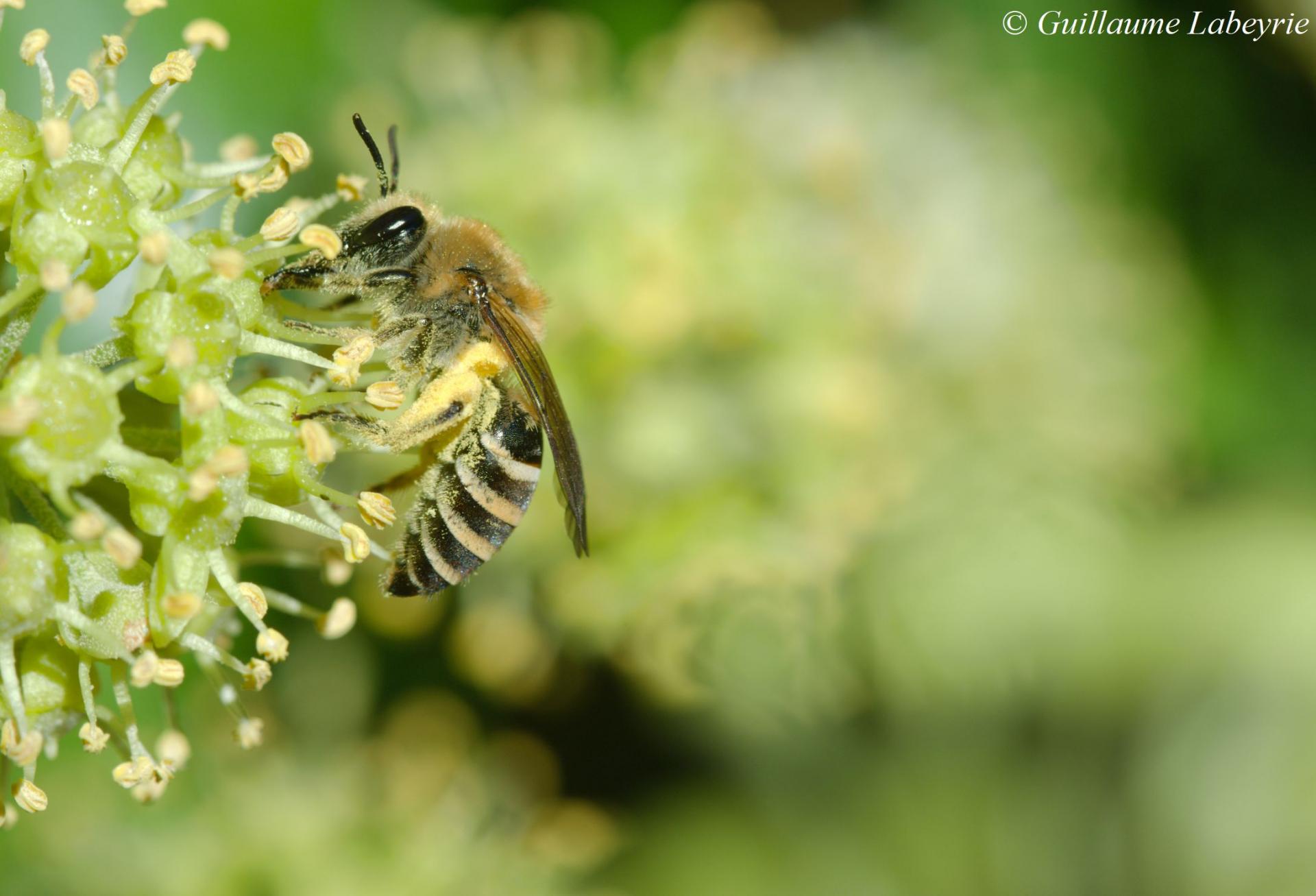 The ivy bee (Colletes hederae). This small bee is identified by the white rings that delimit the segments of its abdomen... and especially by its presence on the ivy flowers ! Indeed, it is usually observed on ivy, whose pollen and nectar make up its entire diet. It is a solitary bee that does not form a colony, but whose underground nests are often grouped into ''villages'' with many individuals. It is distributed in Central Europe, and here and there in France.
The ivy bee (Colletes hederae). This small bee is identified by the white rings that delimit the segments of its abdomen... and especially by its presence on the ivy flowers ! Indeed, it is usually observed on ivy, whose pollen and nectar make up its entire diet. It is a solitary bee that does not form a colony, but whose underground nests are often grouped into ''villages'' with many individuals. It is distributed in Central Europe, and here and there in France.
Diptera
This order characterized by the presence of a single pair of wings includes flies, horseflies, mosquitoes, ... The number of species in France is poorly known, estimates place it between 8 000 and 10 000.
Family : Tephritidae
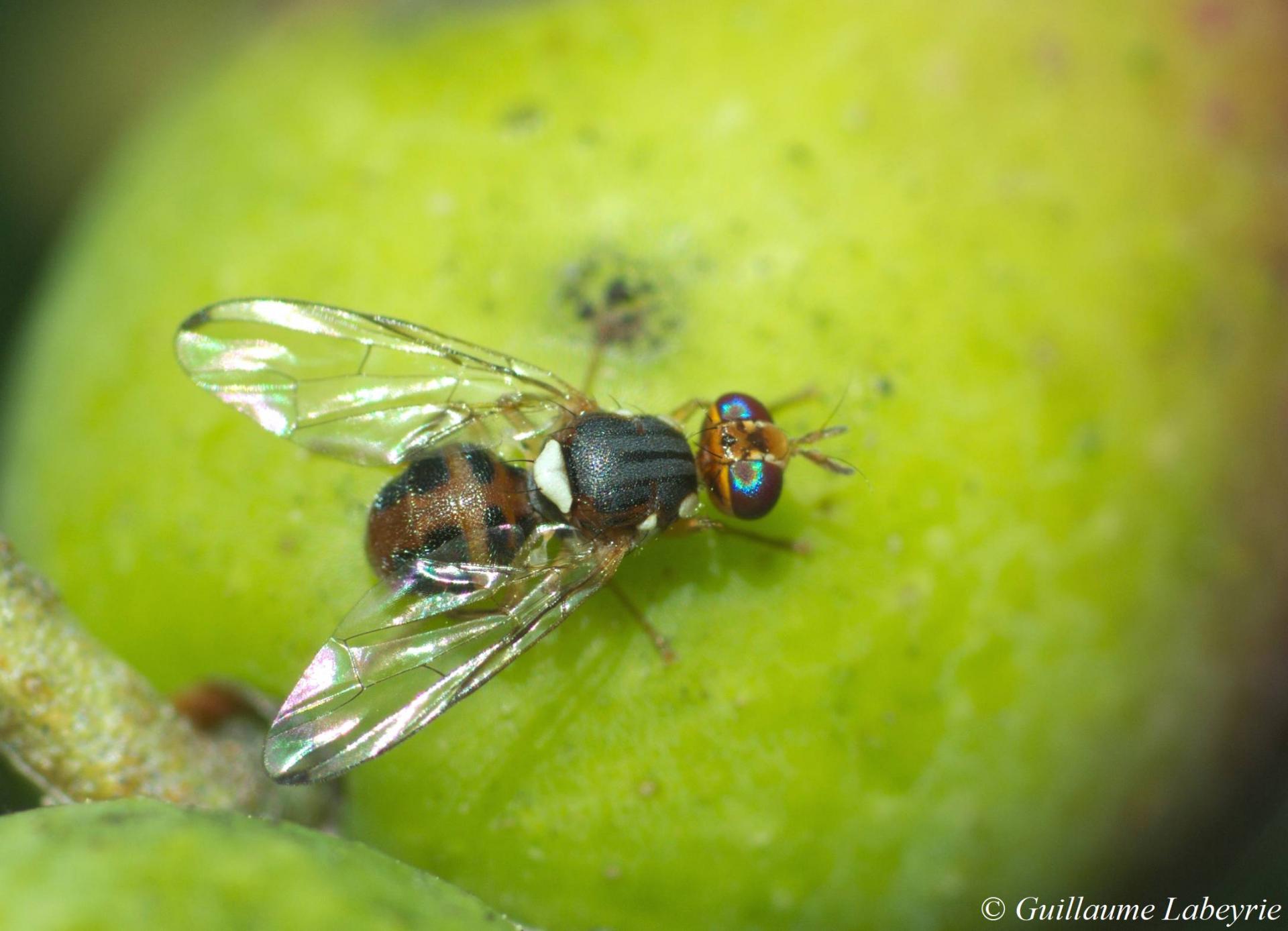 The olive fruit fly (Bactrocera oleae). This tiny fly is only 5-6 mm long. It is best known for the damage it inflicts on olive crops around the world. It attacks olives grown in producing countries (Italy and Spain in particular), but also wild olive species, particularly in Africa.
The olive fruit fly (Bactrocera oleae). This tiny fly is only 5-6 mm long. It is best known for the damage it inflicts on olive crops around the world. It attacks olives grown in producing countries (Italy and Spain in particular), but also wild olive species, particularly in Africa.
Mantises
This order includes several families such as Mantidae and Empusidae. They are carnivorous insects that hunt using a pair of abducting forelegs. There are 8 species in metropolitan France.
Family : Empusidae
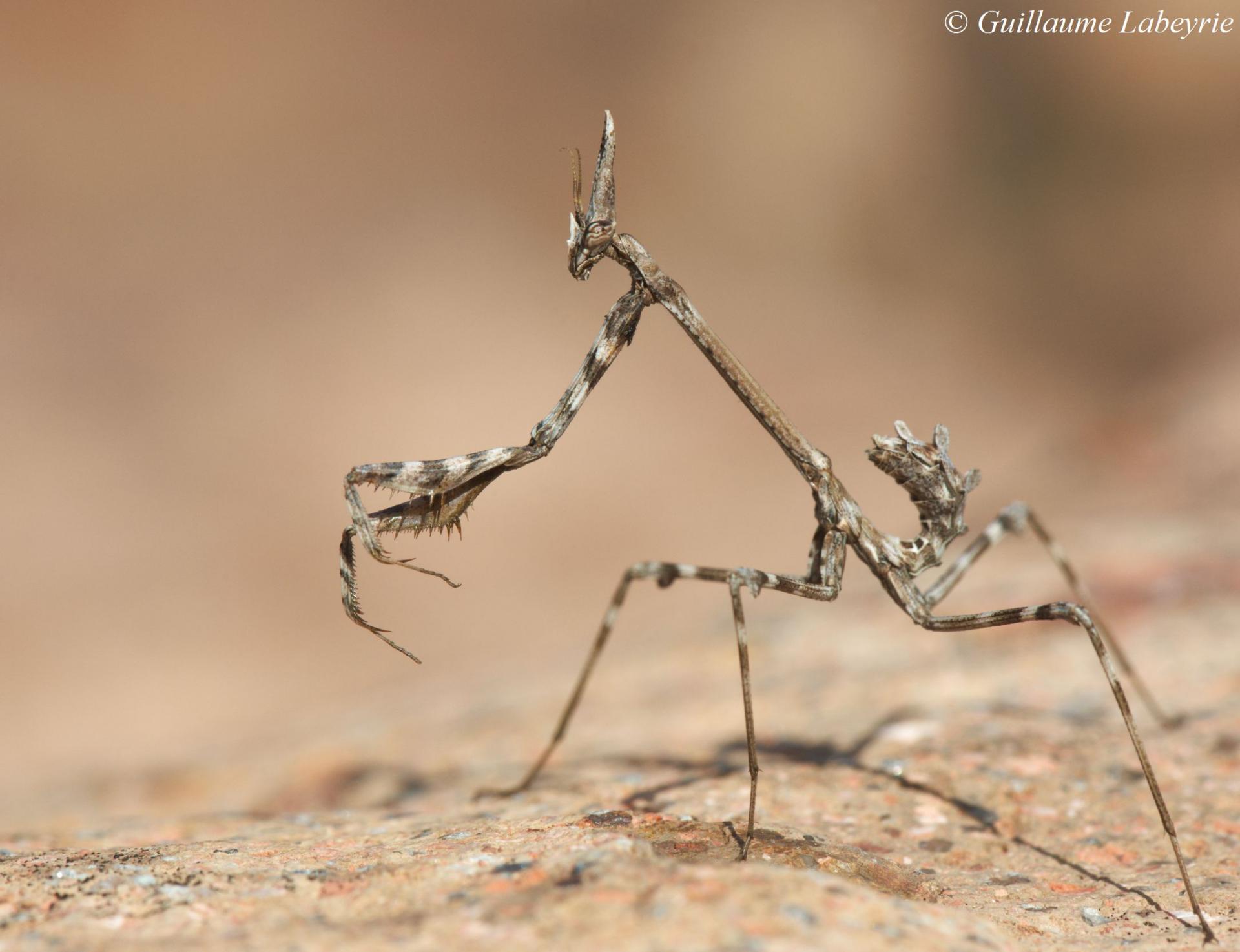 Juvenile conehead mantis (Empusa pennata). The juveniles of this praying mantises are identified by their upturned abdomen looking like a small pine cone. Extremely mimic, they merge with the twigs of the bushes they hide into.
Juvenile conehead mantis (Empusa pennata). The juveniles of this praying mantises are identified by their upturned abdomen looking like a small pine cone. Extremely mimic, they merge with the twigs of the bushes they hide into.
Family : Mantidae
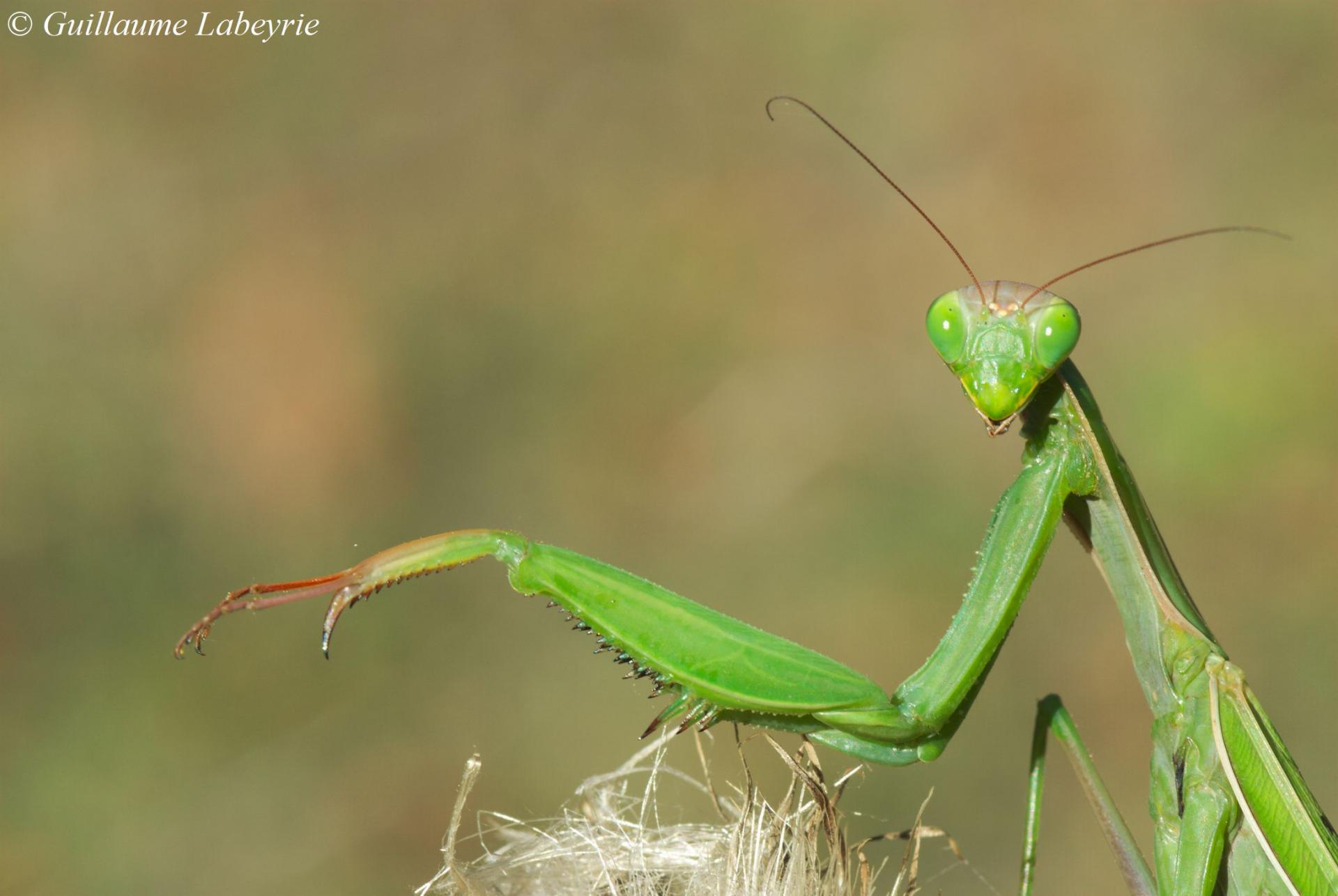 The European mantis (Mantis religiosa). This large mantis is common in Provence, where it is observed especially at the end of summer. The eyes striped with a white streak are characteristic. This species is the only one to be found over most of the national territory, the others being more strictly Mediterranean.
The European mantis (Mantis religiosa). This large mantis is common in Provence, where it is observed especially at the end of summer. The eyes striped with a white streak are characteristic. This species is the only one to be found over most of the national territory, the others being more strictly Mediterranean.
Family : Eremiaphilidae
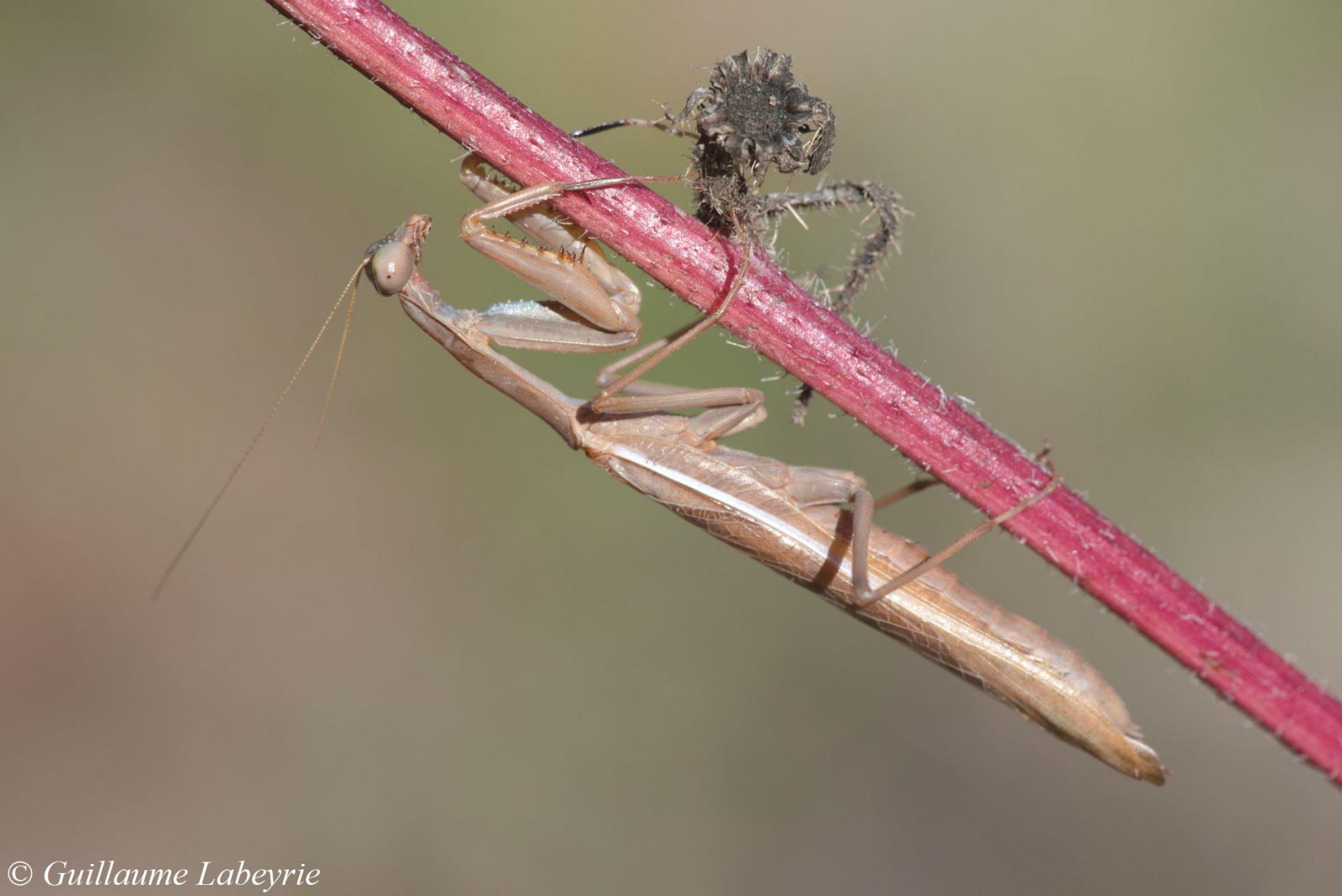 The Mediterranean mantis (Iris oratoria). This mantis is a little smaller than the previous species. It is distinguished by its unstreaked eyes, by the white band on the edge of the fore wings, and especially by the blue and red hind wings. In the female, the wings are shorter than the abdomen (this photo represents a male). This species is found in dry places, generally below 600 m altitude. In France, it is present only near the Mediterranean coast.
The Mediterranean mantis (Iris oratoria). This mantis is a little smaller than the previous species. It is distinguished by its unstreaked eyes, by the white band on the edge of the fore wings, and especially by the blue and red hind wings. In the female, the wings are shorter than the abdomen (this photo represents a male). This species is found in dry places, generally below 600 m altitude. In France, it is present only near the Mediterranean coast.
Odonata
This order includes dragonflies (Anisoptera) and damselflies (Zygoptera). The former are generally quite large and fold their wings horizontally when at rest, while the latter are smaller and fold their wings vertically. Just over a hundred species are present in France.
Family : Aeshnidae
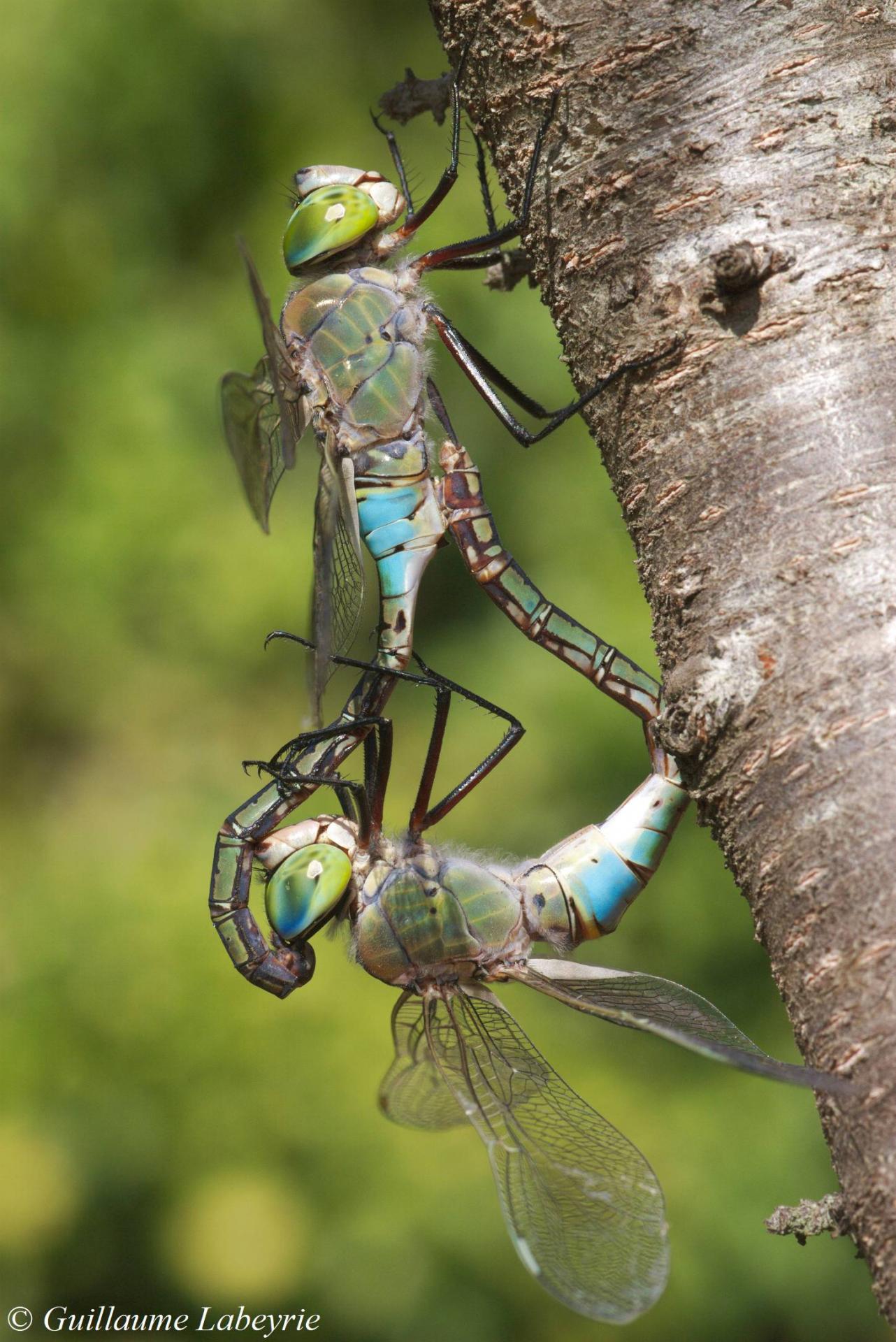 The lesser emperor (Anax parthenope). This large dragonfly is identified by the blue ''saddle'' present in both sexes on the top of the first segments of the abdomen. Distributed throughout Europe to Asia, it is found in France throughout the territory.
The lesser emperor (Anax parthenope). This large dragonfly is identified by the blue ''saddle'' present in both sexes on the top of the first segments of the abdomen. Distributed throughout Europe to Asia, it is found in France throughout the territory.
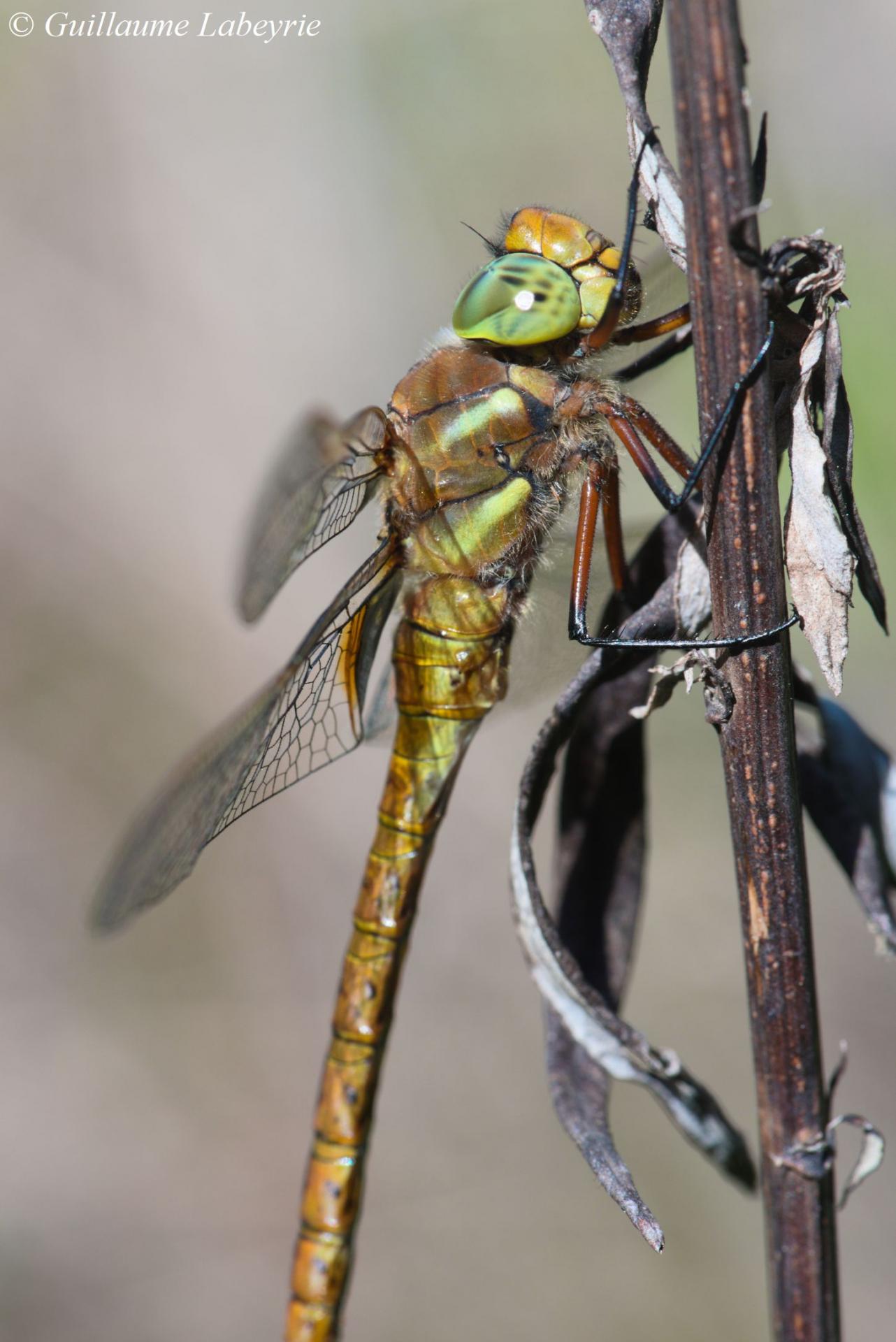 The green-eyed hawker (Aeshna isoceles). This large dragonfly is distinguished by a brown body with a small yellow dorsal triangle, and beautiful green eyes. It appreciates stagnant waters with reedbeds. It is found in a large part of France, at low altitude. It is distributed from Europe to Kazakhstan.
The green-eyed hawker (Aeshna isoceles). This large dragonfly is distinguished by a brown body with a small yellow dorsal triangle, and beautiful green eyes. It appreciates stagnant waters with reedbeds. It is found in a large part of France, at low altitude. It is distributed from Europe to Kazakhstan.
Family : Corduliidae
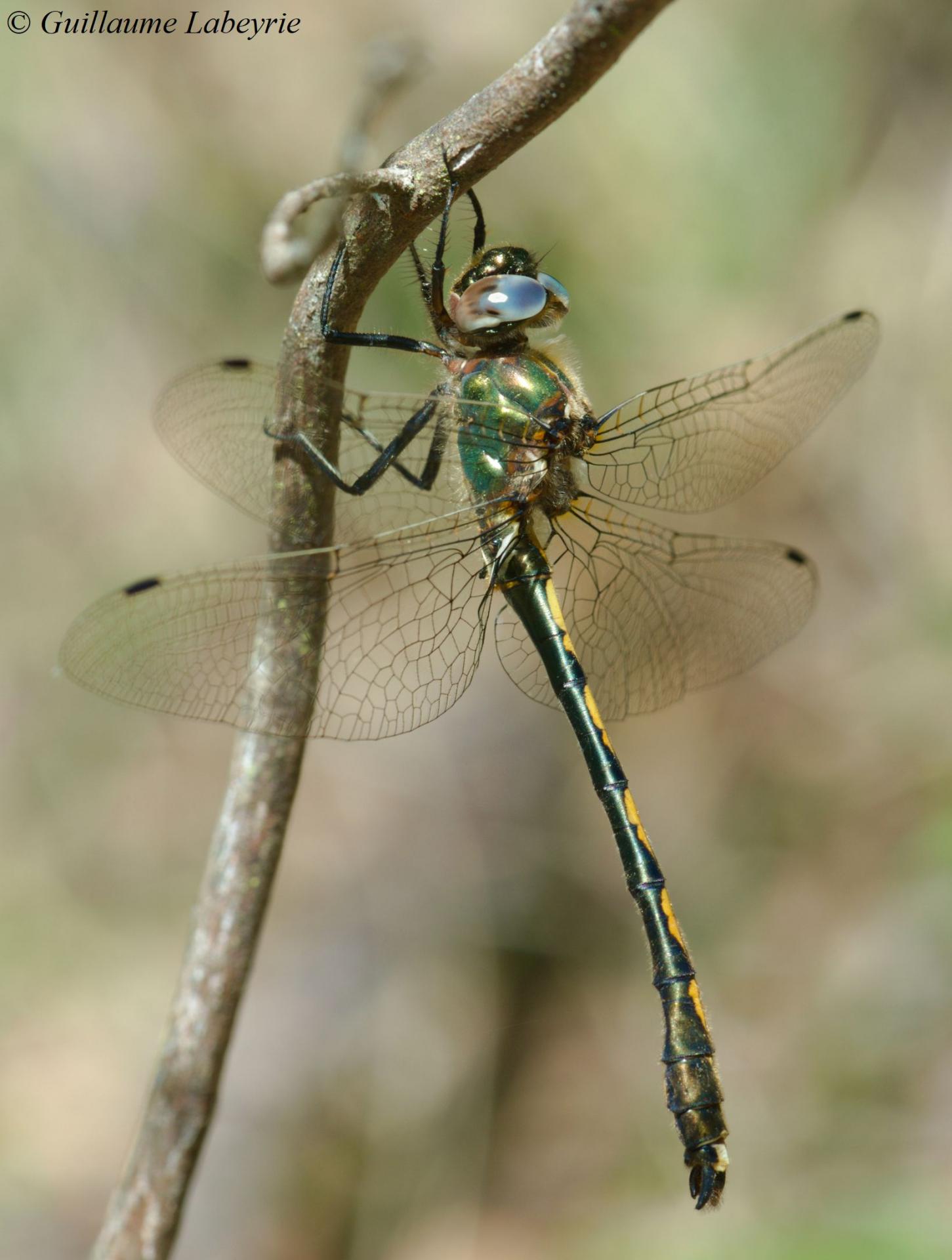 The orange-spotted emerald (Oxygastra curtisii). This medium-sized dragonfly has a copper-green thorax, and a rather thin abdomen widening at the end with yellow spots on the top of the segments. It appreciates river courses with riparian willow and alder forest, as the larvae develop in their root masses. This species from South-West Europe (Spain, Portugal, France and Italy) is widespread in France in the South-West and on the Atlantic and Mediterranean coasts, and is rarer in the North-East. It is fully protected in France.
The orange-spotted emerald (Oxygastra curtisii). This medium-sized dragonfly has a copper-green thorax, and a rather thin abdomen widening at the end with yellow spots on the top of the segments. It appreciates river courses with riparian willow and alder forest, as the larvae develop in their root masses. This species from South-West Europe (Spain, Portugal, France and Italy) is widespread in France in the South-West and on the Atlantic and Mediterranean coasts, and is rarer in the North-East. It is fully protected in France.
Family : Libellulidae
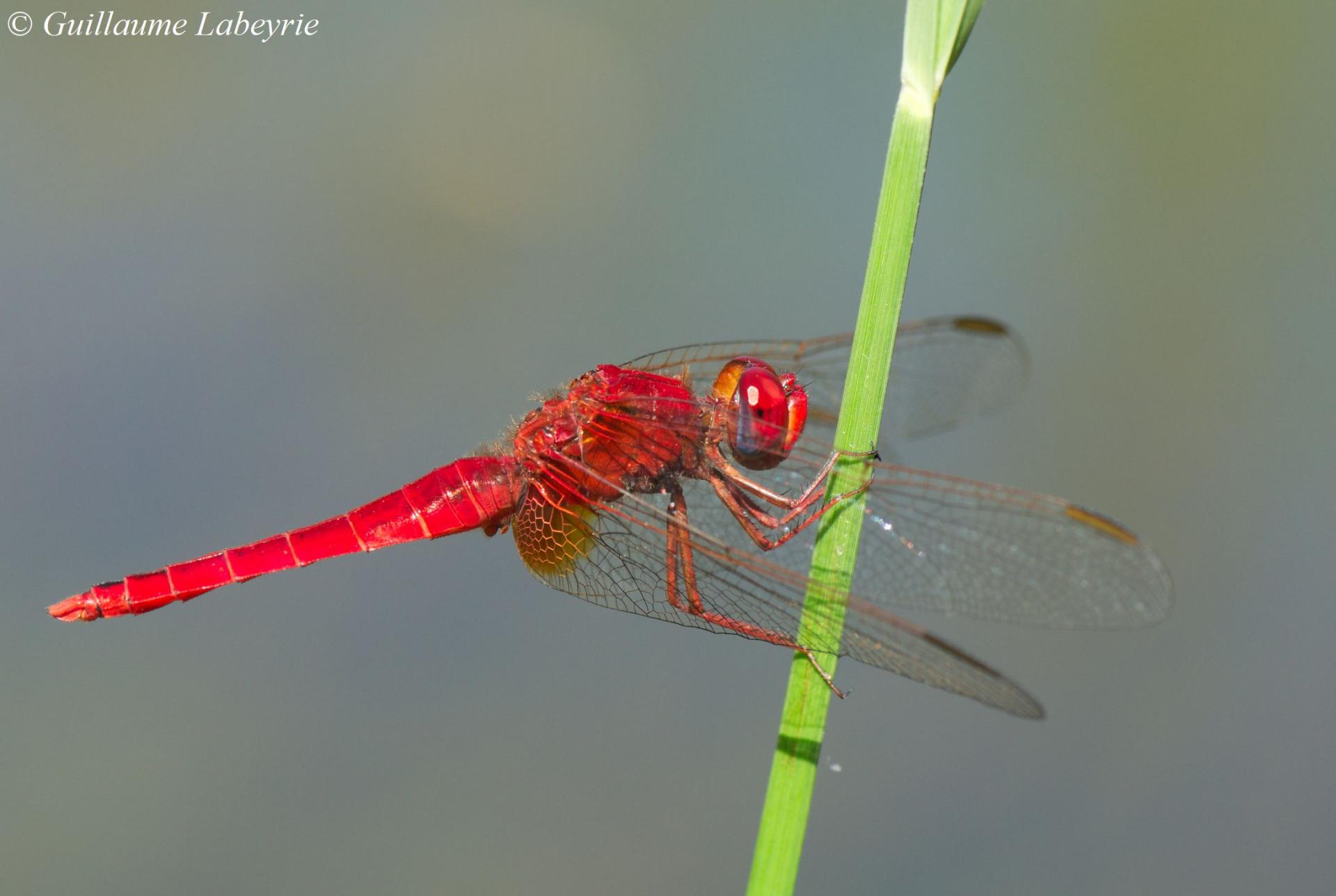 The scarlet dragonfly (Crocothemis erythraea). This dragonfly is best recognized to the reddish areas at the base of the wings. The male is scarlet while the female is a brownish yellow. This species has an extended world distribution including Africa, Asia and the south of Europe (expanding northward).
The scarlet dragonfly (Crocothemis erythraea). This dragonfly is best recognized to the reddish areas at the base of the wings. The male is scarlet while the female is a brownish yellow. This species has an extended world distribution including Africa, Asia and the south of Europe (expanding northward).
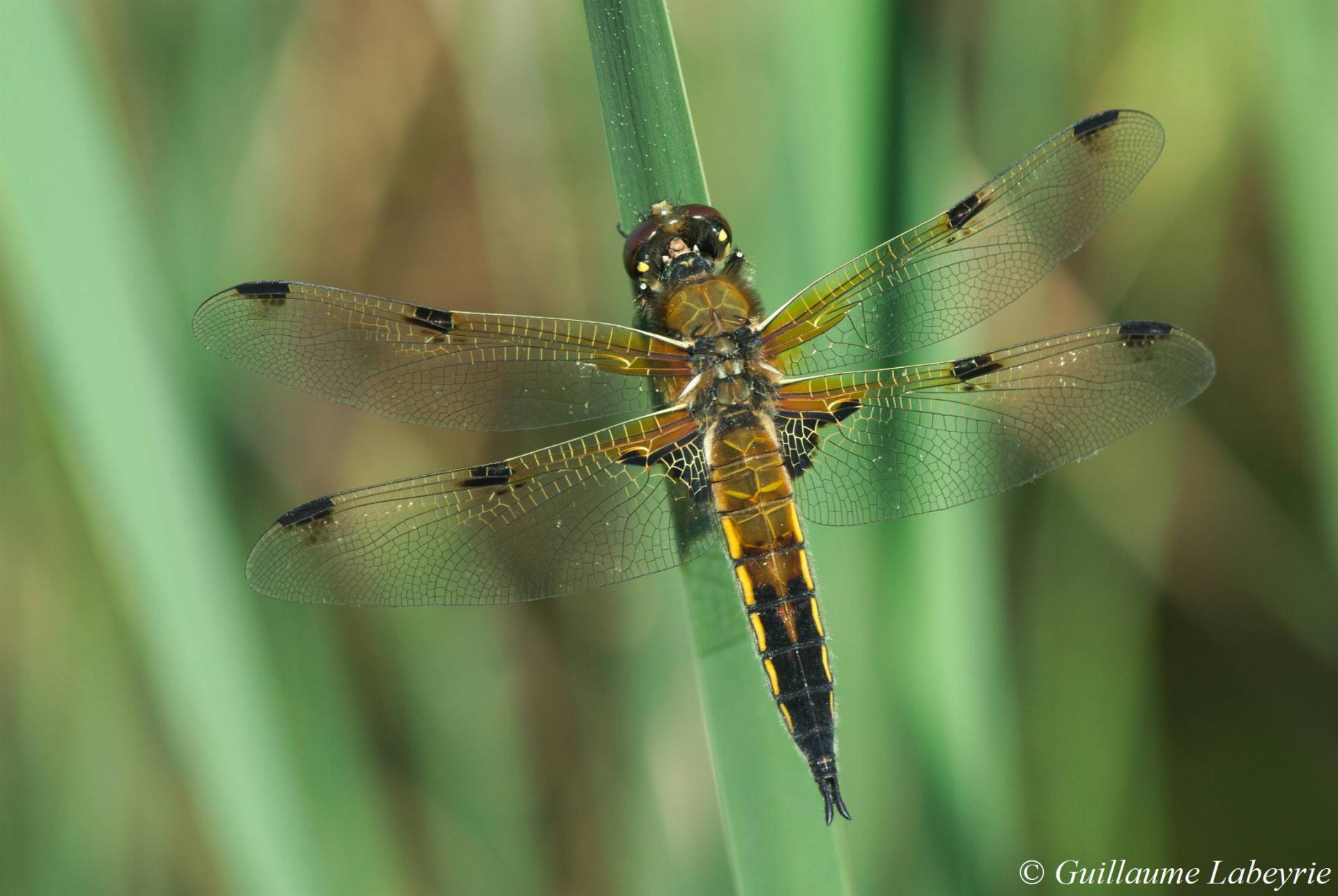 The four-spotted chaser (Libellula quadrimaculata). This pretty dragonfly has a flattened brown abdomen, and four black spots on each pair of wings. Males and females are quite similar, but the divergent cercoids, clearly visible in this photo, indicate a male. This species frequents stagnant waters. It has a very wide worldwide distribution, and is present everywhere in France.
The four-spotted chaser (Libellula quadrimaculata). This pretty dragonfly has a flattened brown abdomen, and four black spots on each pair of wings. Males and females are quite similar, but the divergent cercoids, clearly visible in this photo, indicate a male. This species frequents stagnant waters. It has a very wide worldwide distribution, and is present everywhere in France.
 The common darter (Sympetrum striolatum). This species is distinguished from several other orange Sympetrum by the thorax which alternates reddish and yellowish patches. The female is grey-brown. This dragonfly is very common in small Mediterranean streams, where it remains active all year round with matings frequently observed in the middle of winter ! Widespread from Europe to Western Asia, it is present everywhere in France.
The common darter (Sympetrum striolatum). This species is distinguished from several other orange Sympetrum by the thorax which alternates reddish and yellowish patches. The female is grey-brown. This dragonfly is very common in small Mediterranean streams, where it remains active all year round with matings frequently observed in the middle of winter ! Widespread from Europe to Western Asia, it is present everywhere in France.
Family : Coenagrionoidae
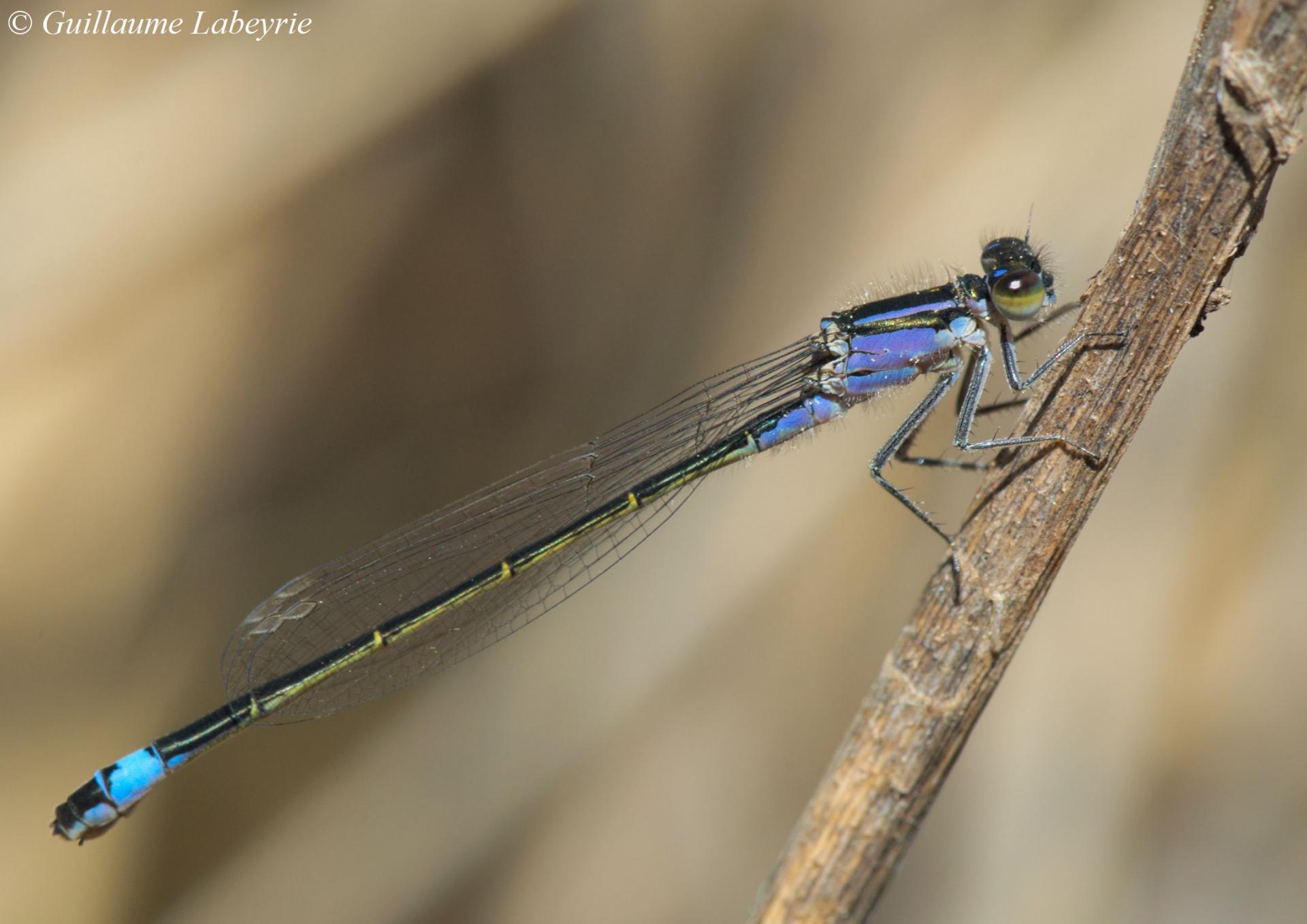 The blue-tailed damselfly (Ischnura elegans). This small damselfly has a black abdomen with a bright blue tip. The coloring is very variable, especially in females (here an immature with a purple thorax). This species frequents ponds with reedbeds. It is found from Europe to Japan, and throughout France except in Corsica, where it is replaced by the island bluetail damselfly (Ischnura genei).
The blue-tailed damselfly (Ischnura elegans). This small damselfly has a black abdomen with a bright blue tip. The coloring is very variable, especially in females (here an immature with a purple thorax). This species frequents ponds with reedbeds. It is found from Europe to Japan, and throughout France except in Corsica, where it is replaced by the island bluetail damselfly (Ischnura genei).
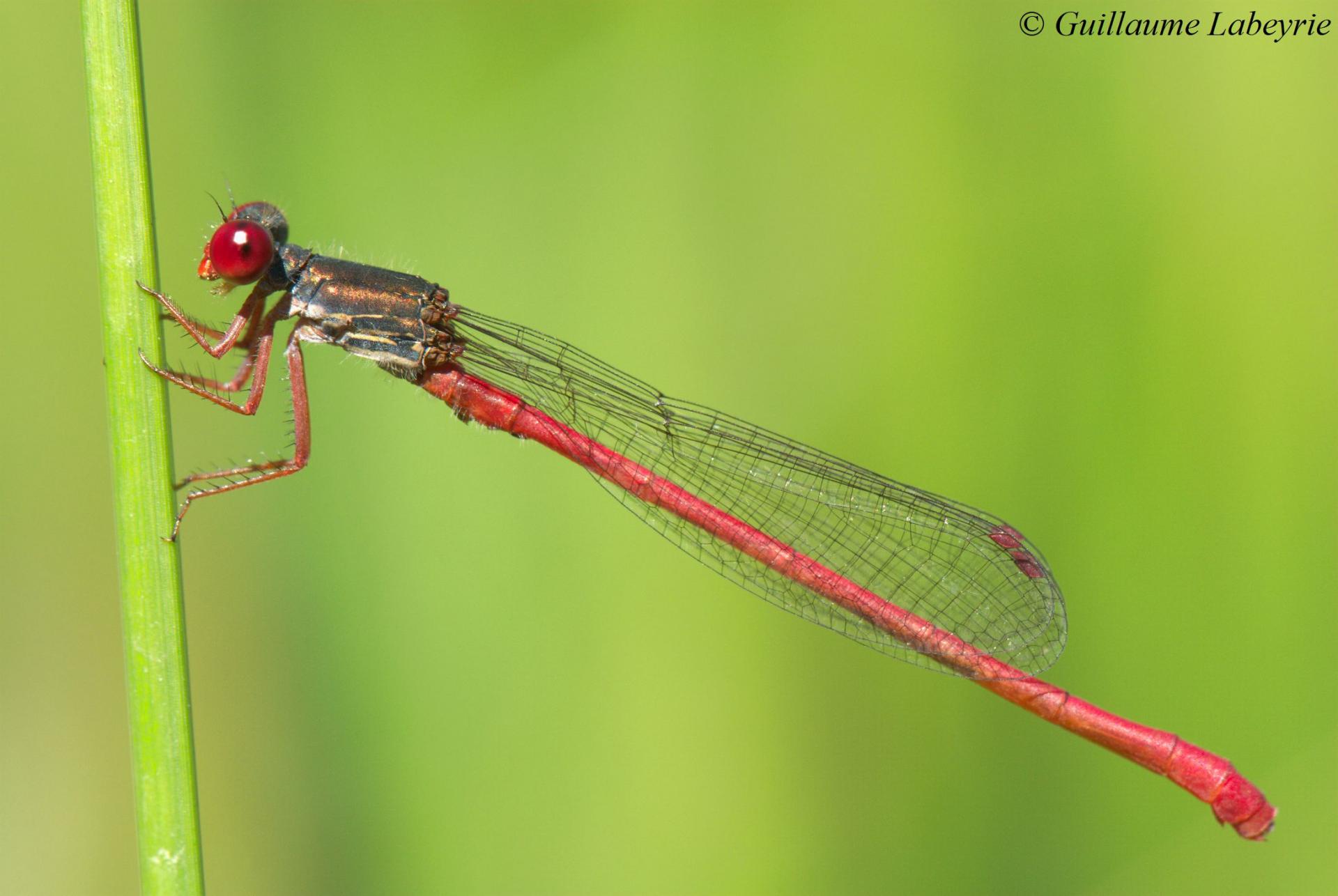 The small red damselfly (Ceriagrion tenellum). This tiny damselfly is distinguished by its uniform red body, red legs and coppery thorax, characteristics that differentiate it from the large red damselfly (Pyrrhosoma nymphula), the only other small red species in our region (see below). It is widespread in North Africa and in a major part of Western Europe, as well as throughout France up to 1000 m above sea level.
The small red damselfly (Ceriagrion tenellum). This tiny damselfly is distinguished by its uniform red body, red legs and coppery thorax, characteristics that differentiate it from the large red damselfly (Pyrrhosoma nymphula), the only other small red species in our region (see below). It is widespread in North Africa and in a major part of Western Europe, as well as throughout France up to 1000 m above sea level.
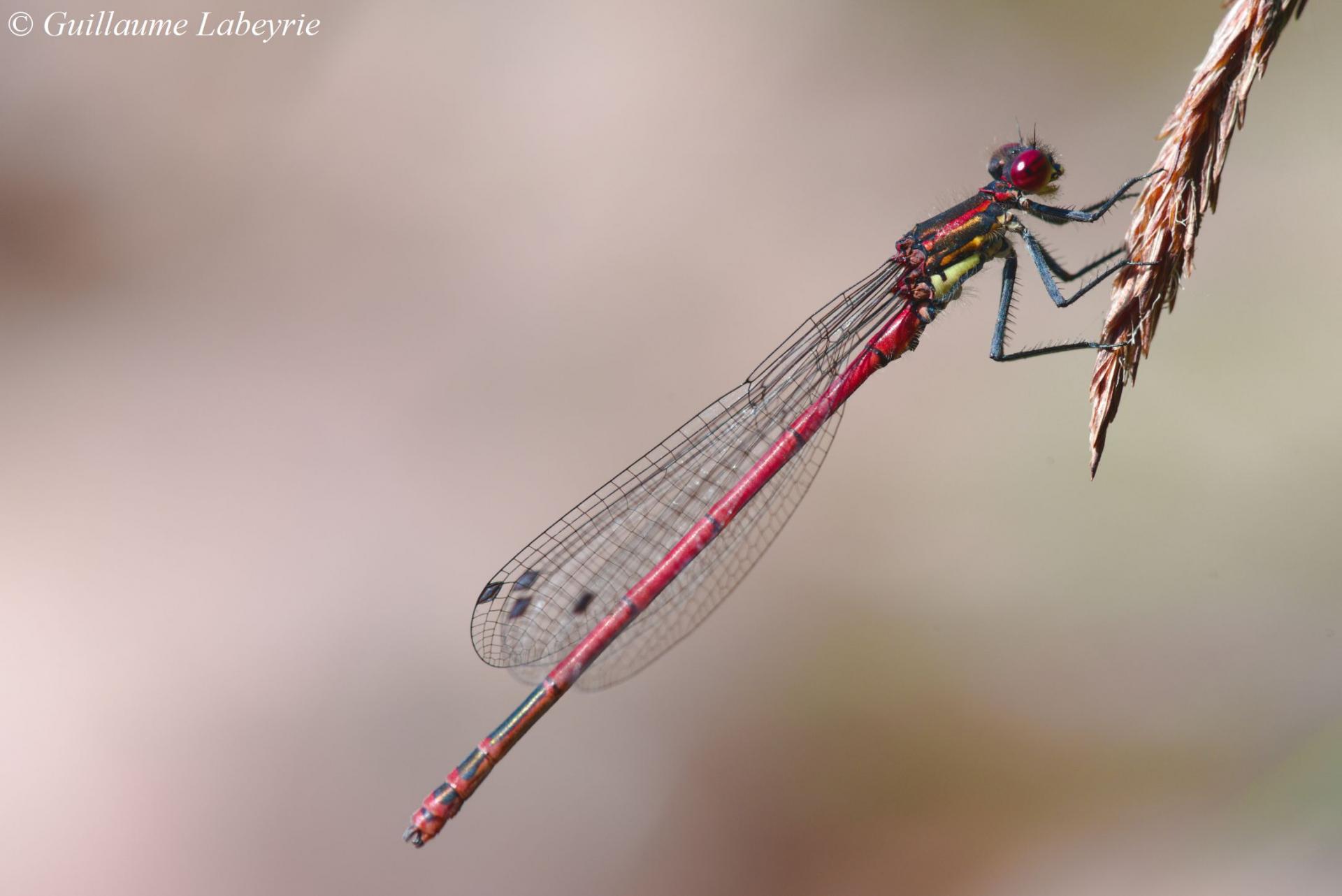 The large red damselfly (Pyrrhosoma nymphula). This damselfly has a red body, a striped thorax, and black pterostigmas. It mainly frequents stagnant waters, from sea level up to 2400 m. It is found from Europe to Iran, and everywhere in France.
The large red damselfly (Pyrrhosoma nymphula). This damselfly has a red body, a striped thorax, and black pterostigmas. It mainly frequents stagnant waters, from sea level up to 2400 m. It is found from Europe to Iran, and everywhere in France.
Family : Lestidae
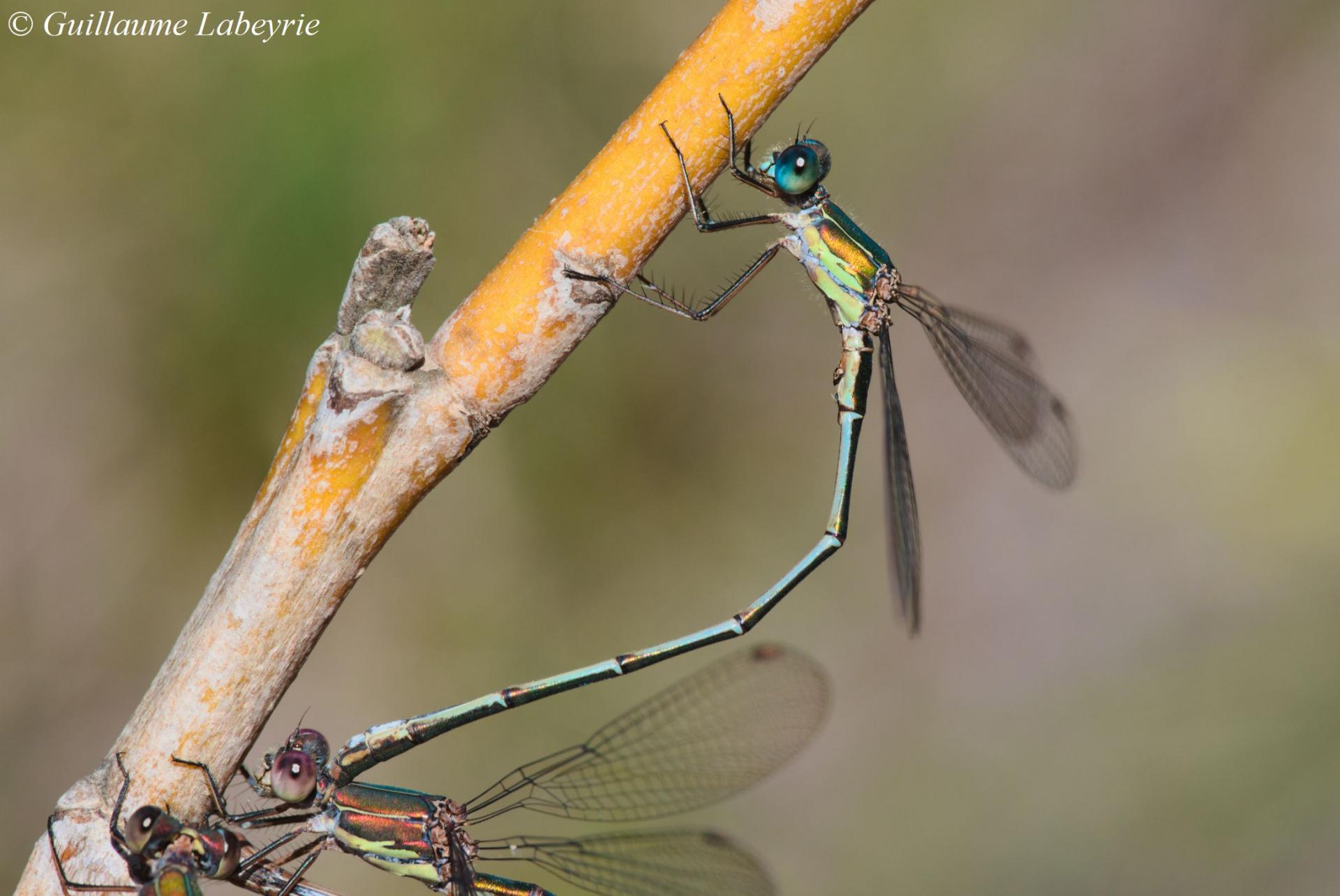 The willow emerald damselfl (Chalcolestes viridis). This pretty species is distinguished by its coppery green body and its yellow pterostigmas. It is often found at the edge of small Mediterranean streams, where it can remain active all year round if the winter is mild. Distributed in Western and Central Europe as well as in the Maghreb, it is found in France throughout the territory.
The willow emerald damselfl (Chalcolestes viridis). This pretty species is distinguished by its coppery green body and its yellow pterostigmas. It is often found at the edge of small Mediterranean streams, where it can remain active all year round if the winter is mild. Distributed in Western and Central Europe as well as in the Maghreb, it is found in France throughout the territory.

The southern emerald damselfly (Lestes barbarus). This other damselfly has a bicolor green and cream occiput (area behind the eyes), and bicolor pterostigmas. It is an opportunistic and highly adaptable species. Present from Europe to Mongolia, it is widespread throughout France.
Family : Platycnemididae
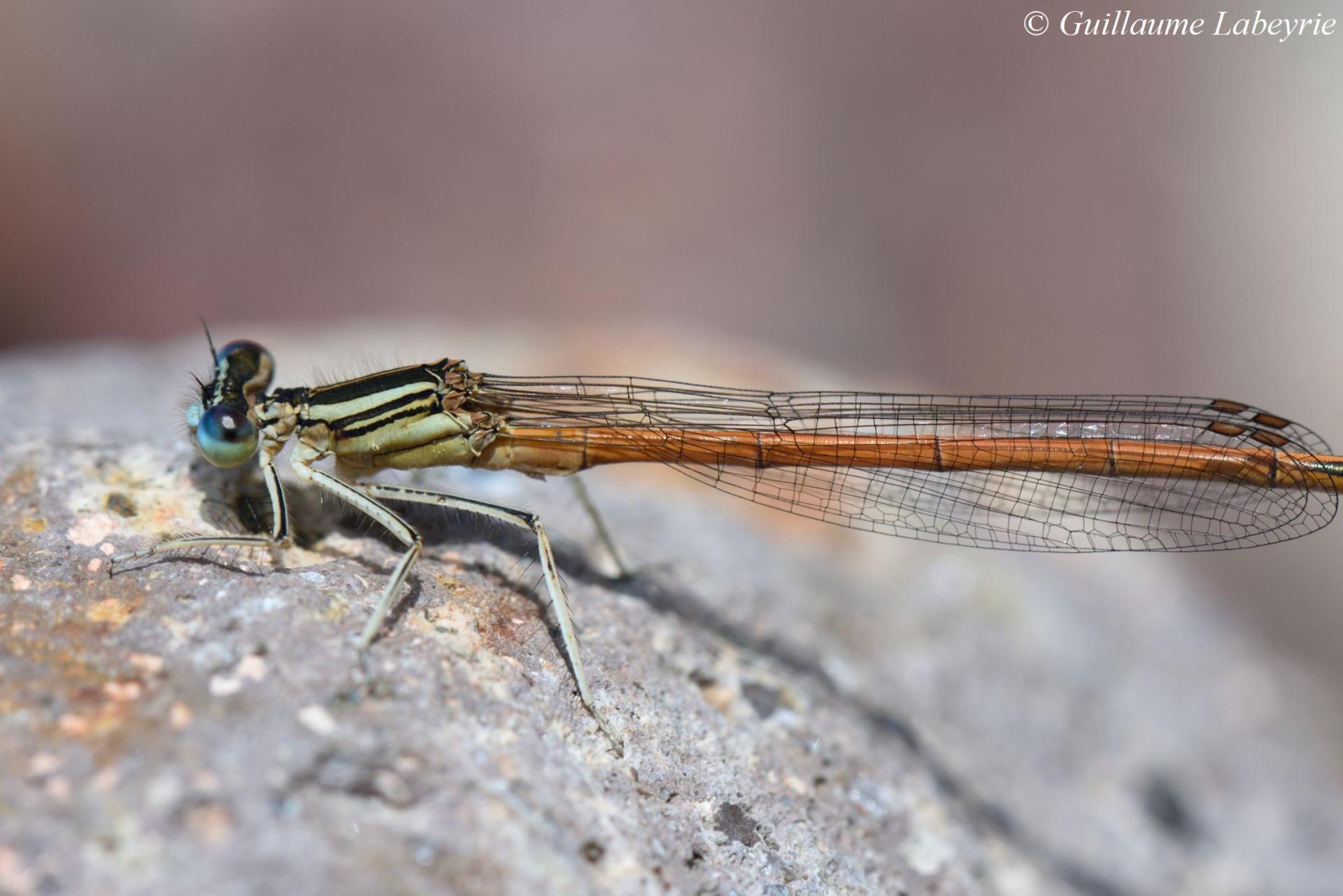
The orange featherleg (Platycnemis acutipennis). It is our only Zygoptera with a frankly orange body. In our region, it is found locally along small Mediterranean streams. Endemic to South-West Europe (France and the Iberian Peninsula), this damselfly is present in France in the South-West half.
Orthoptera
This order includes grasshoppers (Caelifera) and crickets (Ensifera). About 200 species are present in France.
Family : Acrididae
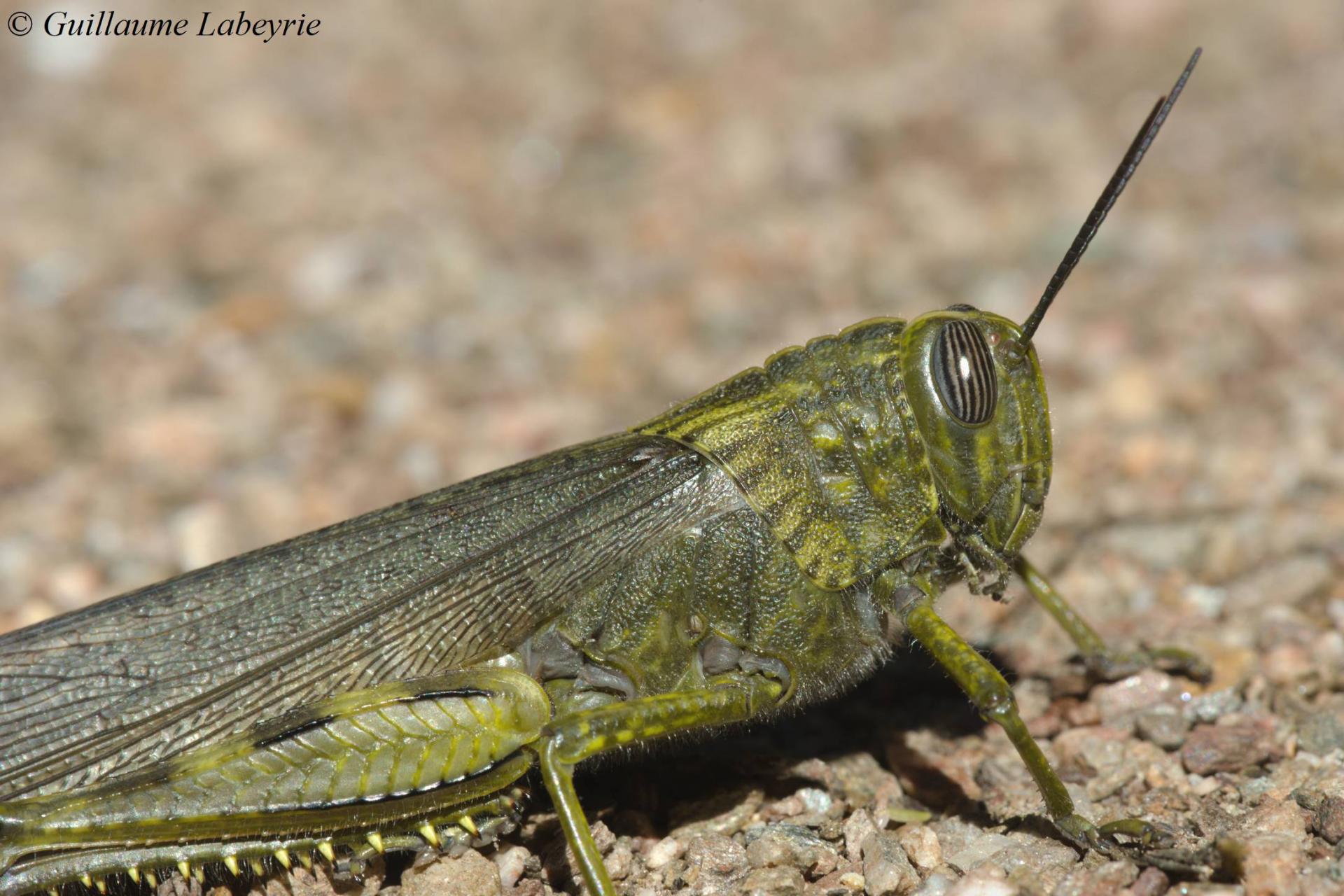 The Egyptian locust (Anacridium aegyptium). This is one of our largest species, reaching 7 cm in length. The striped eyes are characteristic. Body color is gray or brown. This species produces a characteristic clicking sound during flight. It is common in dry maquis near the coast, in the south-east of France and in Corsica. The Egyptian locust is present in the Mediterranean area and in West Asia.
The Egyptian locust (Anacridium aegyptium). This is one of our largest species, reaching 7 cm in length. The striped eyes are characteristic. Body color is gray or brown. This species produces a characteristic clicking sound during flight. It is common in dry maquis near the coast, in the south-east of France and in Corsica. The Egyptian locust is present in the Mediterranean area and in West Asia.
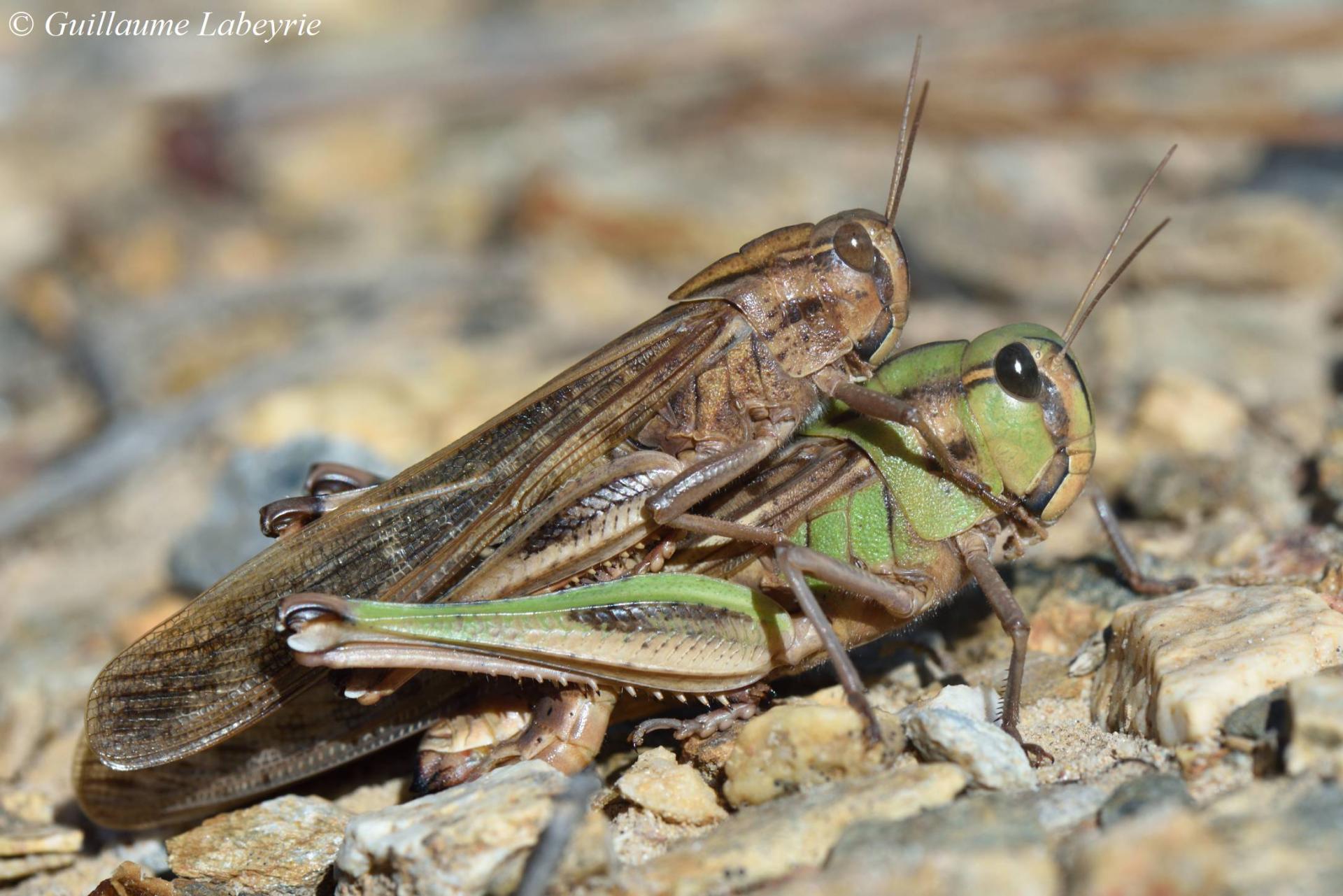
Locusta cinerascens. This other large species frequents the same environments as the Egyptian locust, while being much less frequent. The unstreaked eyes and the usually green color allow it to be identified. This species is present in France, in the South-East (Corsica included).
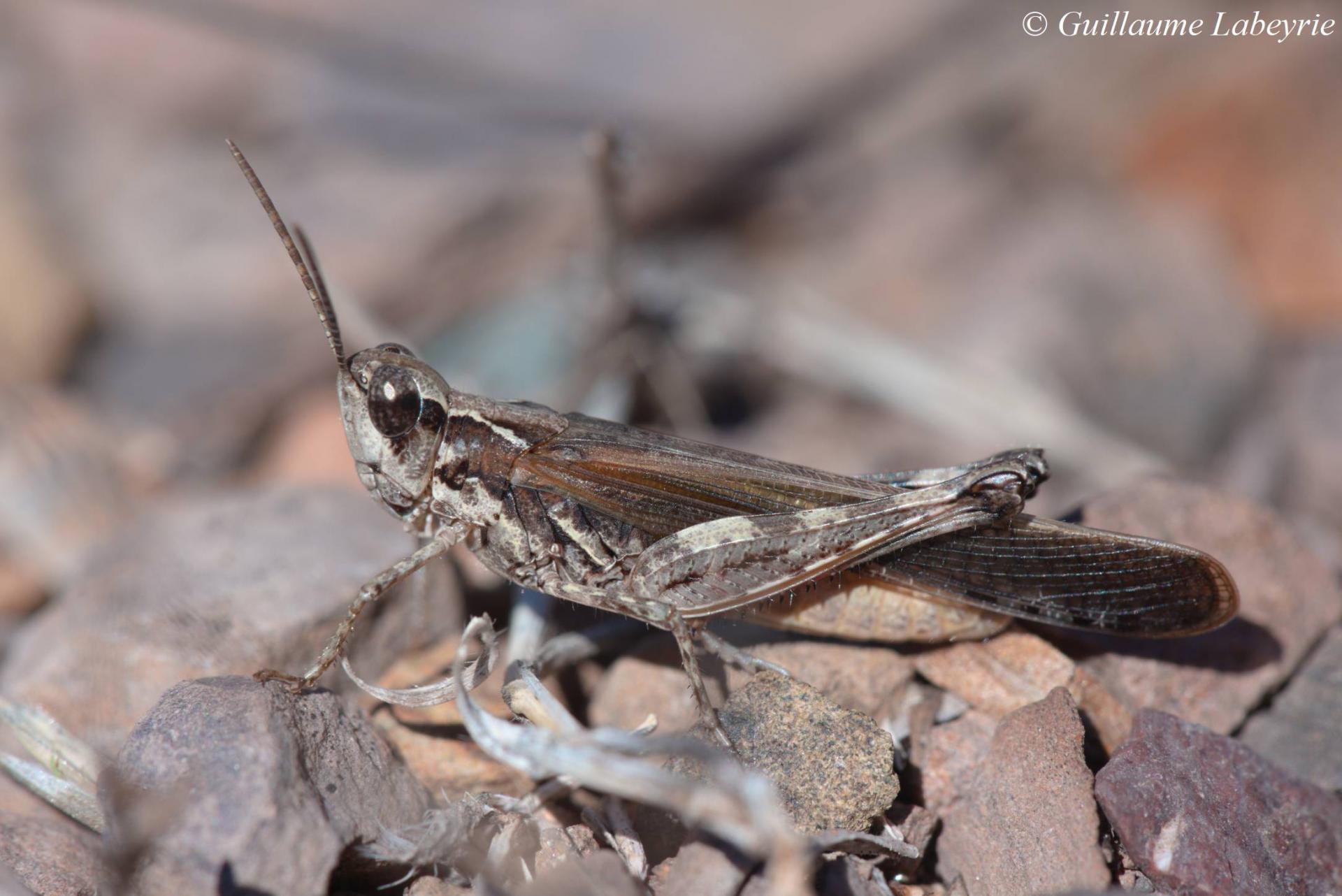 Aiolopus puissanti. This slender species flies particularly well. The male, shown here, is smaller than the female. Aiolopus puissanti frequents dry and sandy places, close to the coast. It is present in Western Europe (France, Spain, Portugal, Canary Islands) and in Morocco. In France, it is observed only on the Mediterranean coast, including Corsica.
Aiolopus puissanti. This slender species flies particularly well. The male, shown here, is smaller than the female. Aiolopus puissanti frequents dry and sandy places, close to the coast. It is present in Western Europe (France, Spain, Portugal, Canary Islands) and in Morocco. In France, it is observed only on the Mediterranean coast, including Corsica.
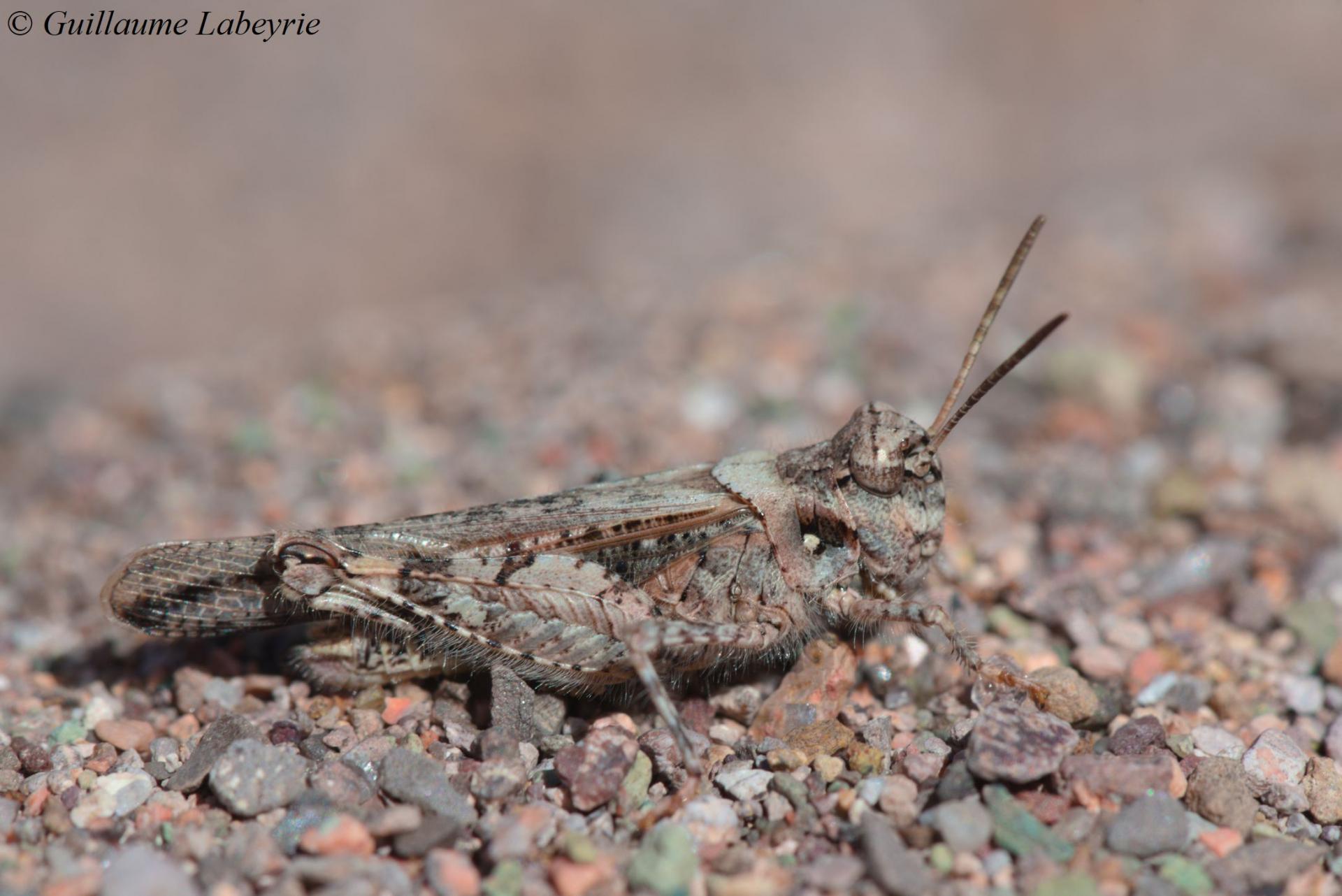 Acrotylus insubricus. This small species is found on sandy areas. It differs from the very similar A. fischeri in particular by its more slender appearance. Both species have the base of the wings tinted with pink. Acrotylus insubricus is present in Europe, Africa and Asia. In France, it is found on the Mediterranean coast and south of the Atlantic coast.
Acrotylus insubricus. This small species is found on sandy areas. It differs from the very similar A. fischeri in particular by its more slender appearance. Both species have the base of the wings tinted with pink. Acrotylus insubricus is present in Europe, Africa and Asia. In France, it is found on the Mediterranean coast and south of the Atlantic coast.
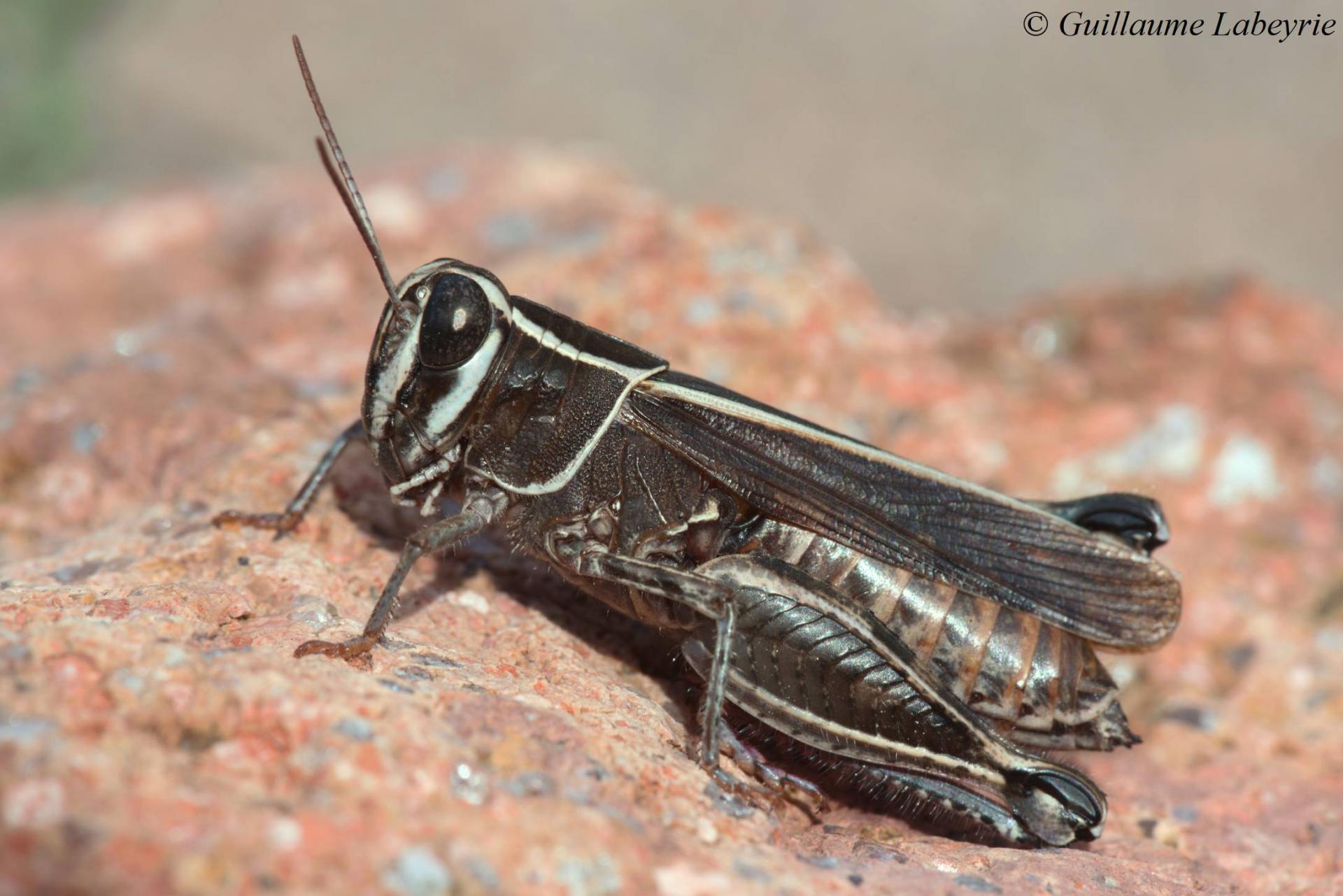 Calliptamus barbarus. Several species of the genus Calliptamus are found in France in dry environments near the Mediterranean coast. It is considered that only males can be identified with certainty, thanks to the shape of their penis ! The female represented here probably belongs to C. barbarus, because the edges of the elytra are parallel. This individual belongs the marginella form, which is very contrasted. This species is present in most of France, with the exception of the North. It is protected in the Ile-de-France region.
Calliptamus barbarus. Several species of the genus Calliptamus are found in France in dry environments near the Mediterranean coast. It is considered that only males can be identified with certainty, thanks to the shape of their penis ! The female represented here probably belongs to C. barbarus, because the edges of the elytra are parallel. This individual belongs the marginella form, which is very contrasted. This species is present in most of France, with the exception of the North. It is protected in the Ile-de-France region.
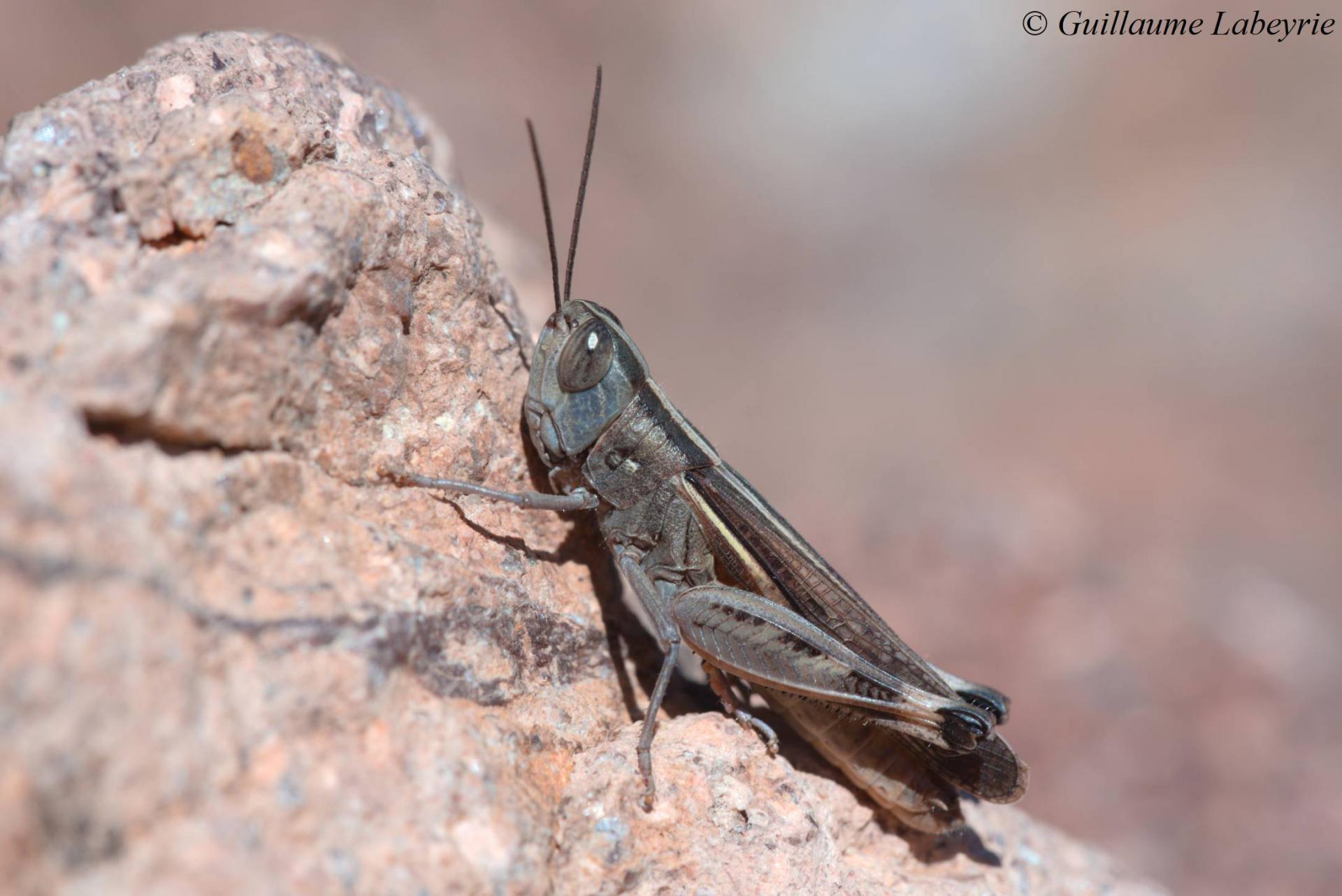 Ramburiella hispanica. This grasshopper is characterized by the white line that runs through its head, pronotum and back. The male, shown here, is much smaller than the female. This local species frequents dry and rocky environments, close to the coast. It is present in France and Spain, and in North Africa. In our region, it is restricted to the Mediterranean coast.
Ramburiella hispanica. This grasshopper is characterized by the white line that runs through its head, pronotum and back. The male, shown here, is much smaller than the female. This local species frequents dry and rocky environments, close to the coast. It is present in France and Spain, and in North Africa. In our region, it is restricted to the Mediterranean coast.
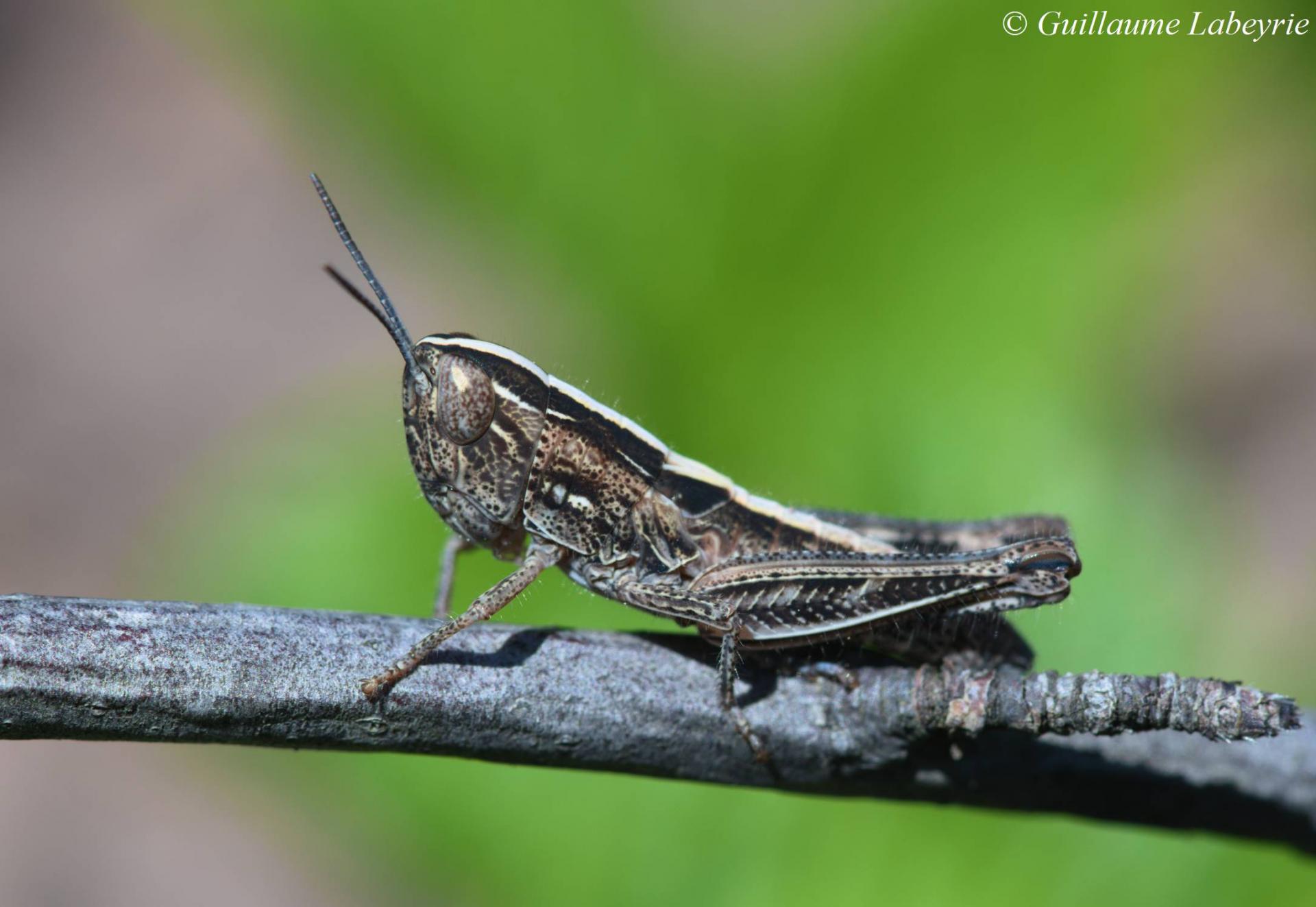 Larva of Ramburiella hispanica.
Larva of Ramburiella hispanica.
Family : Pyrgomorphidae
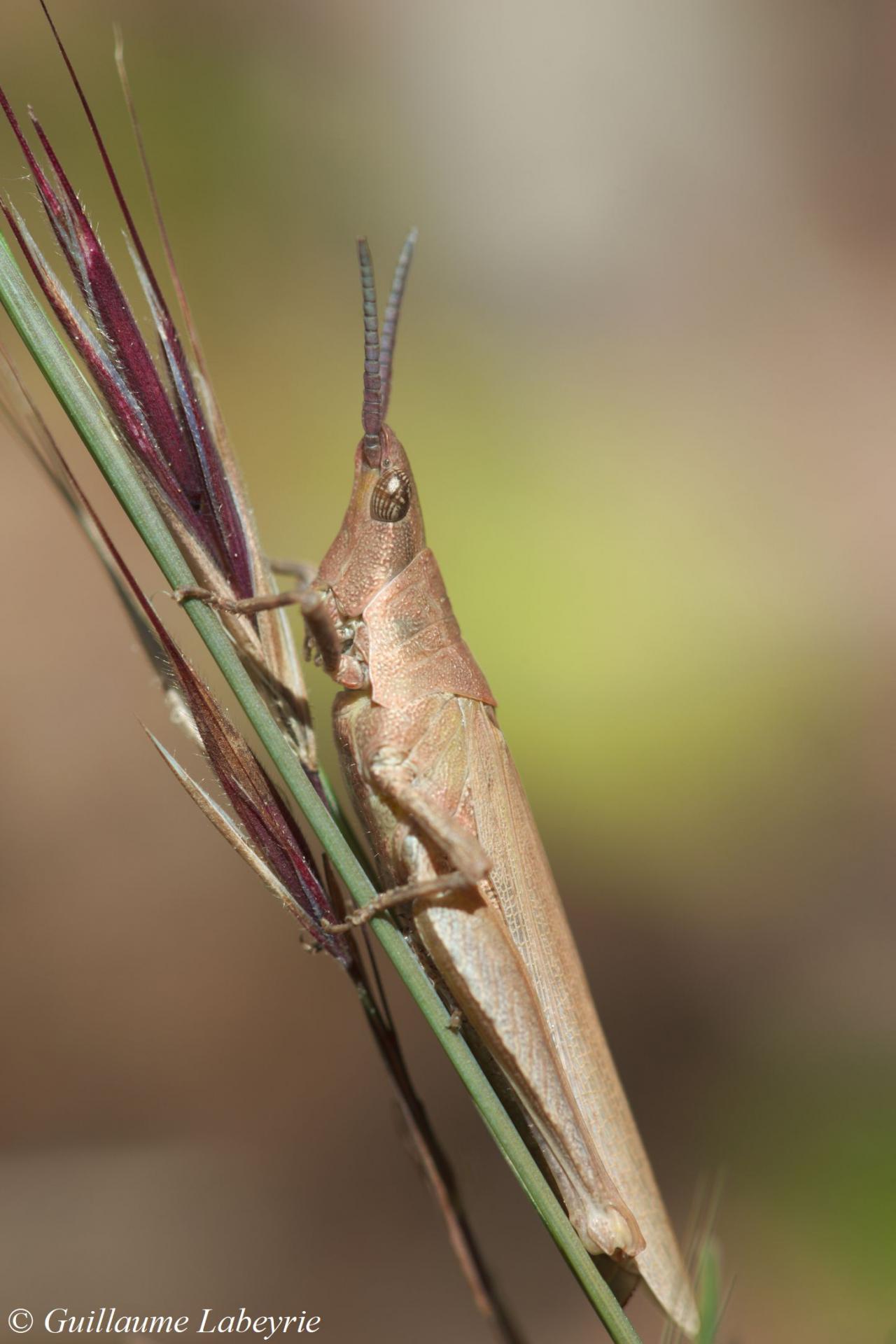 Pyrgomorpha conica. This small grasshopper measures about 2 cm. It is easily identified by its conical head and its flattened antennae. The individual represented here is an adult female. This species is found in dry places, often on siliceous ground. The tiny larvae can be observed in winter. Pyrgomorpha conica is widely distributed from southern Europe to western Asia. In France, it is present only on the Mediterranean littoral fringe.
Pyrgomorpha conica. This small grasshopper measures about 2 cm. It is easily identified by its conical head and its flattened antennae. The individual represented here is an adult female. This species is found in dry places, often on siliceous ground. The tiny larvae can be observed in winter. Pyrgomorpha conica is widely distributed from southern Europe to western Asia. In France, it is present only on the Mediterranean littoral fringe.
Family : Tetrigidae
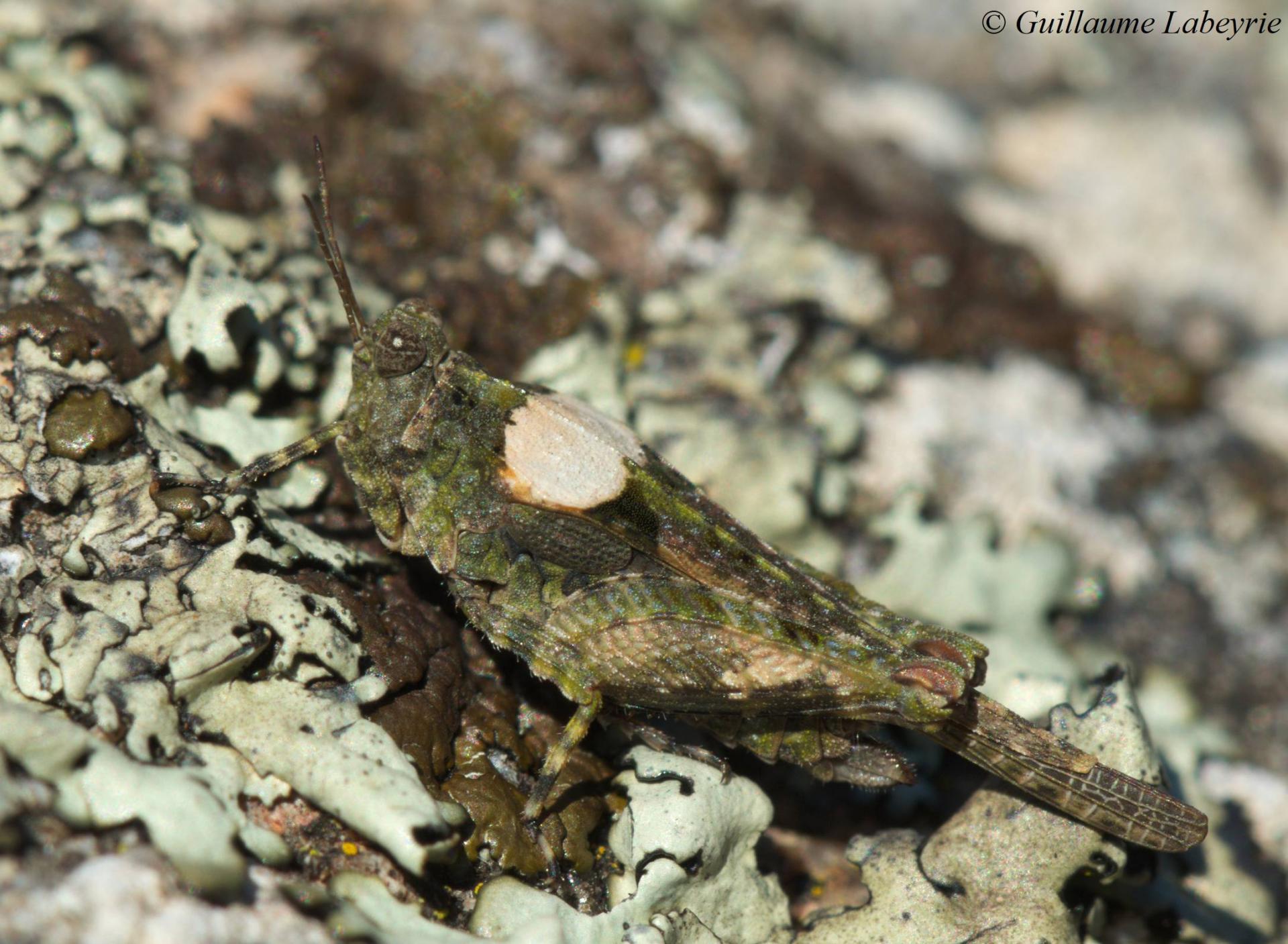 Paratettix meridionalis. This miniature groundhopper measures only one centimeter. Very mimetic, it is difficult to spot. It is identified by its close-set eyes and the length of the pronotum, which is streamlined and extends well beyond the body. This species is found in sandy areas near watercourses, frequently in the company of Tetrix depressa illustrated below. It is present in a southern half of France.
Paratettix meridionalis. This miniature groundhopper measures only one centimeter. Very mimetic, it is difficult to spot. It is identified by its close-set eyes and the length of the pronotum, which is streamlined and extends well beyond the body. This species is found in sandy areas near watercourses, frequently in the company of Tetrix depressa illustrated below. It is present in a southern half of France.
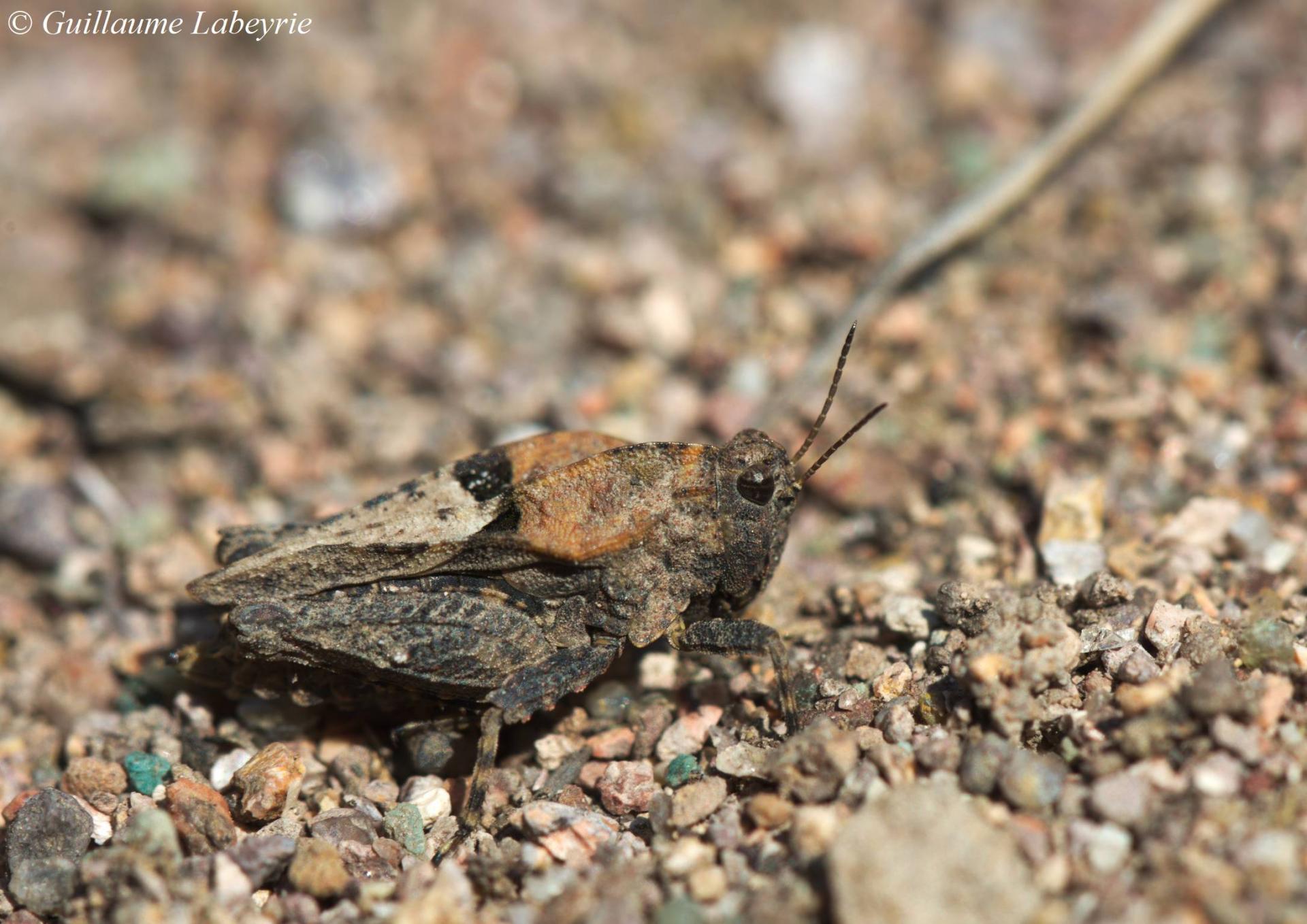 Tetrix depressa. In this species, the pronotum is broad and flat, and presents a median carina forming a hump forward. It occurs in a southern half of France.
Tetrix depressa. In this species, the pronotum is broad and flat, and presents a median carina forming a hump forward. It occurs in a southern half of France.
Family : Mogoplistidae
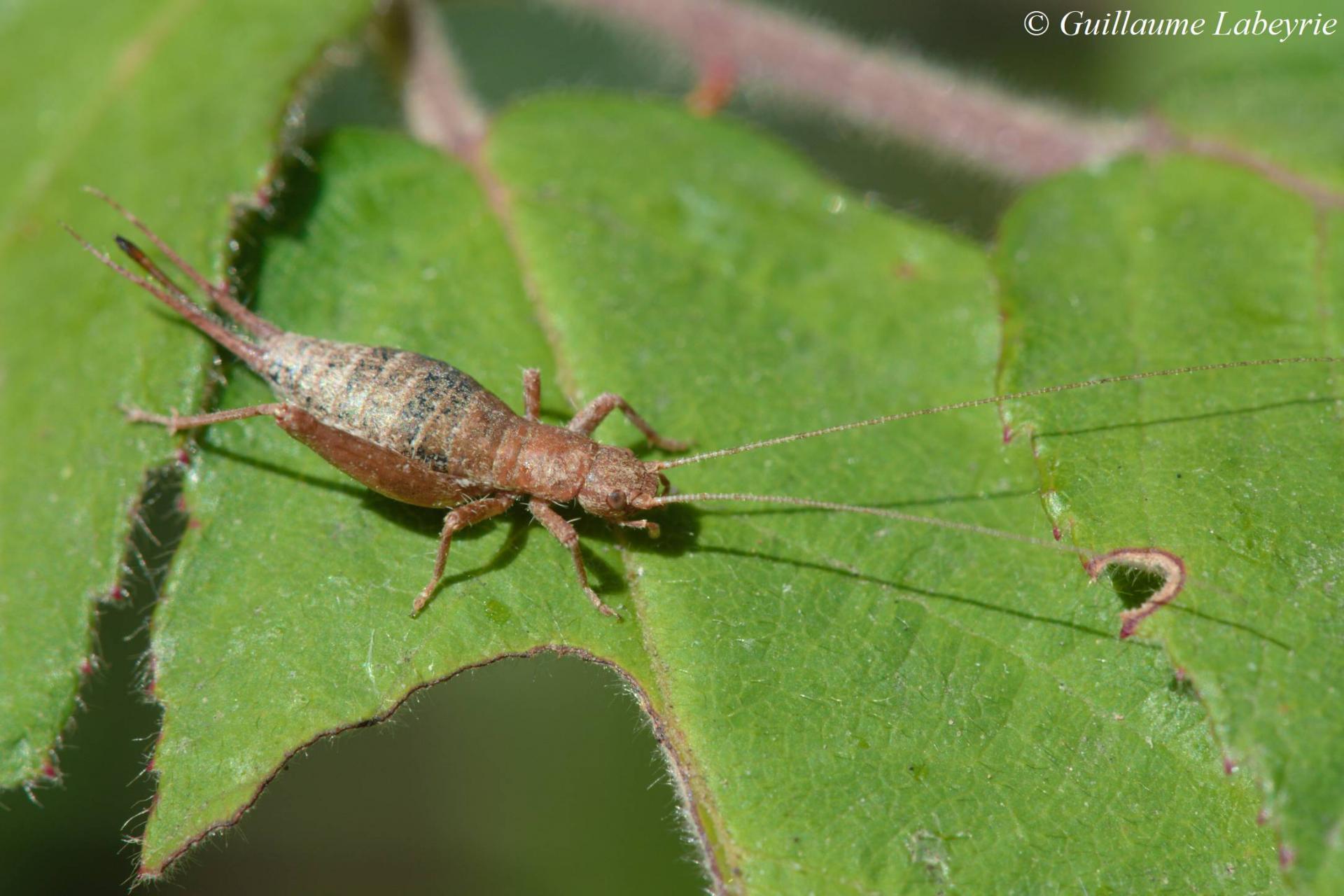 Arachnocephalus vestitus. This tiny cricket, very inconspicuous, is between 6 and 8 mm long. Its cylindrical body is characteristic. It is observed in shrubs, hedges, ... Distributed in southern Europe as far as Turkey, it is restricted in France to the Mediterranean border.
Arachnocephalus vestitus. This tiny cricket, very inconspicuous, is between 6 and 8 mm long. Its cylindrical body is characteristic. It is observed in shrubs, hedges, ... Distributed in southern Europe as far as Turkey, it is restricted in France to the Mediterranean border.
Family : Tettigoniidae
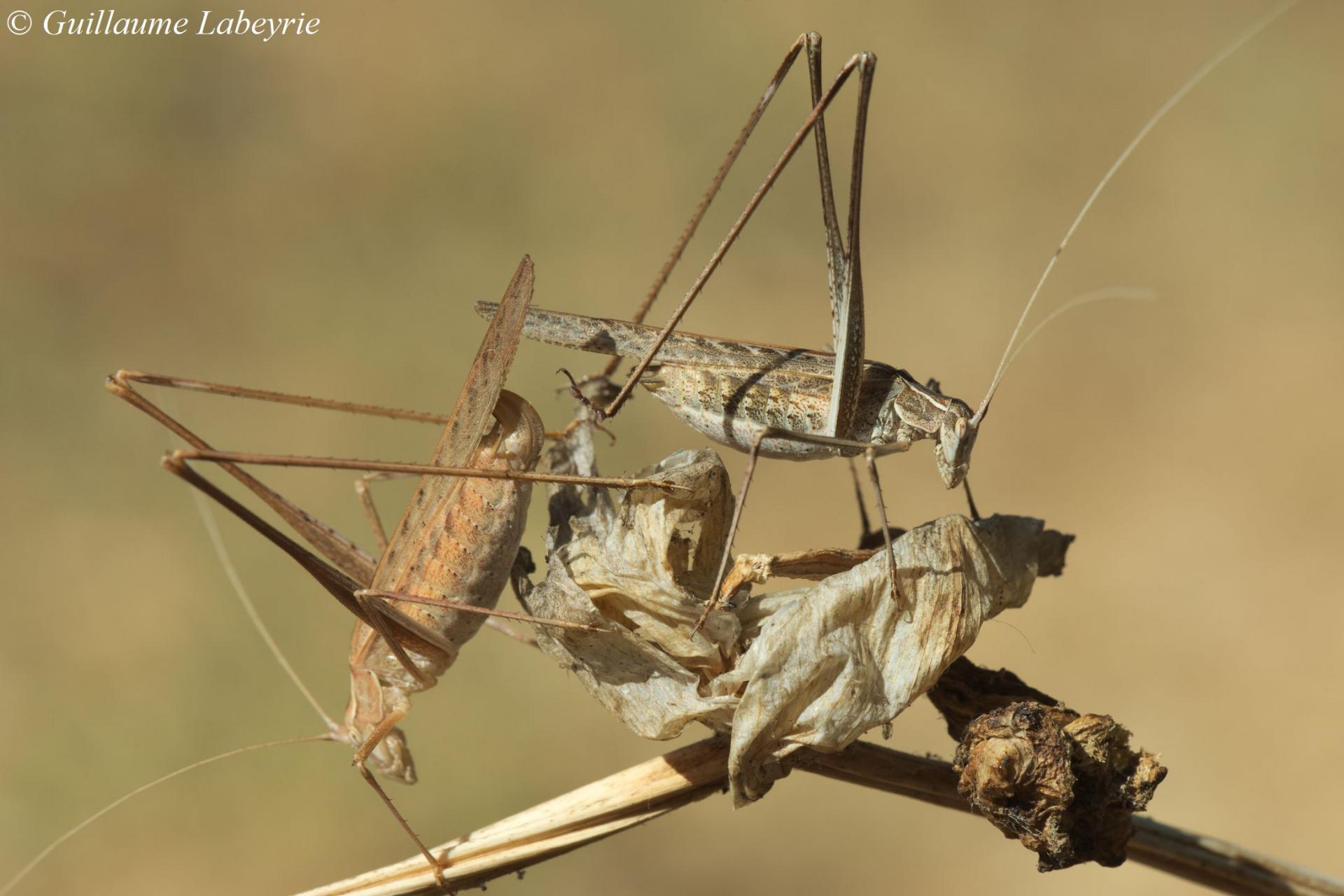 The lily bush-cricket (Tylopsis lilifolia). This slender katydid is between 12 and 25 mm long. The antennae are white, very long and thin, and the hind legs are disproportionate. It likes dry thickets. It is found throughout southern Europe as far south as Russia. In France, it is present in the South.
The lily bush-cricket (Tylopsis lilifolia). This slender katydid is between 12 and 25 mm long. The antennae are white, very long and thin, and the hind legs are disproportionate. It likes dry thickets. It is found throughout southern Europe as far south as Russia. In France, it is present in the South.
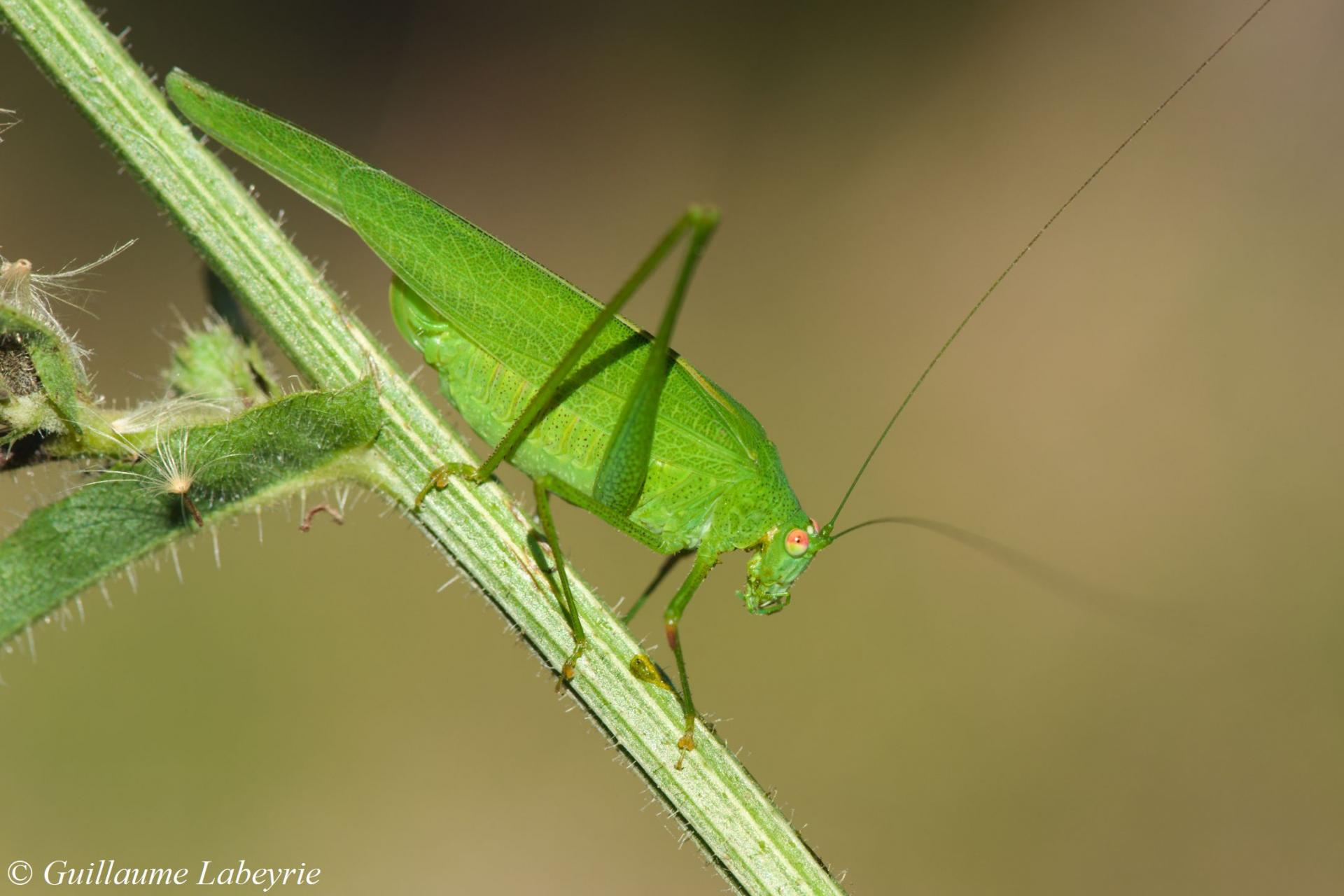 The southern sickle bush-cricket (Phaneroptera nana). This small species, about 15 mm long, has pronotum lobes that are higher than wide which allows it to distinguish it from the similar sickle-bearing bush-cricket (Phaneroptera falcata). It is found in hot environments with thickets. It has a wide worldwide distribution, and is present in France in a major part of the territory with the exception of the North.
The southern sickle bush-cricket (Phaneroptera nana). This small species, about 15 mm long, has pronotum lobes that are higher than wide which allows it to distinguish it from the similar sickle-bearing bush-cricket (Phaneroptera falcata). It is found in hot environments with thickets. It has a wide worldwide distribution, and is present in France in a major part of the territory with the exception of the North.
 The cone-headed grasshopper (Ruspolia nitidula). This beautiful species measures 20 to 30 mm. The body is usually green, sometimes brown. The conical head is characteristic. This bush-cricket frequents thermophilic meadows up to 1300 m of altitude. Distributed mainly in southern Europe, it is found in most of France. It is protected in the Ile-de-France region.
The cone-headed grasshopper (Ruspolia nitidula). This beautiful species measures 20 to 30 mm. The body is usually green, sometimes brown. The conical head is characteristic. This bush-cricket frequents thermophilic meadows up to 1300 m of altitude. Distributed mainly in southern Europe, it is found in most of France. It is protected in the Ile-de-France region.
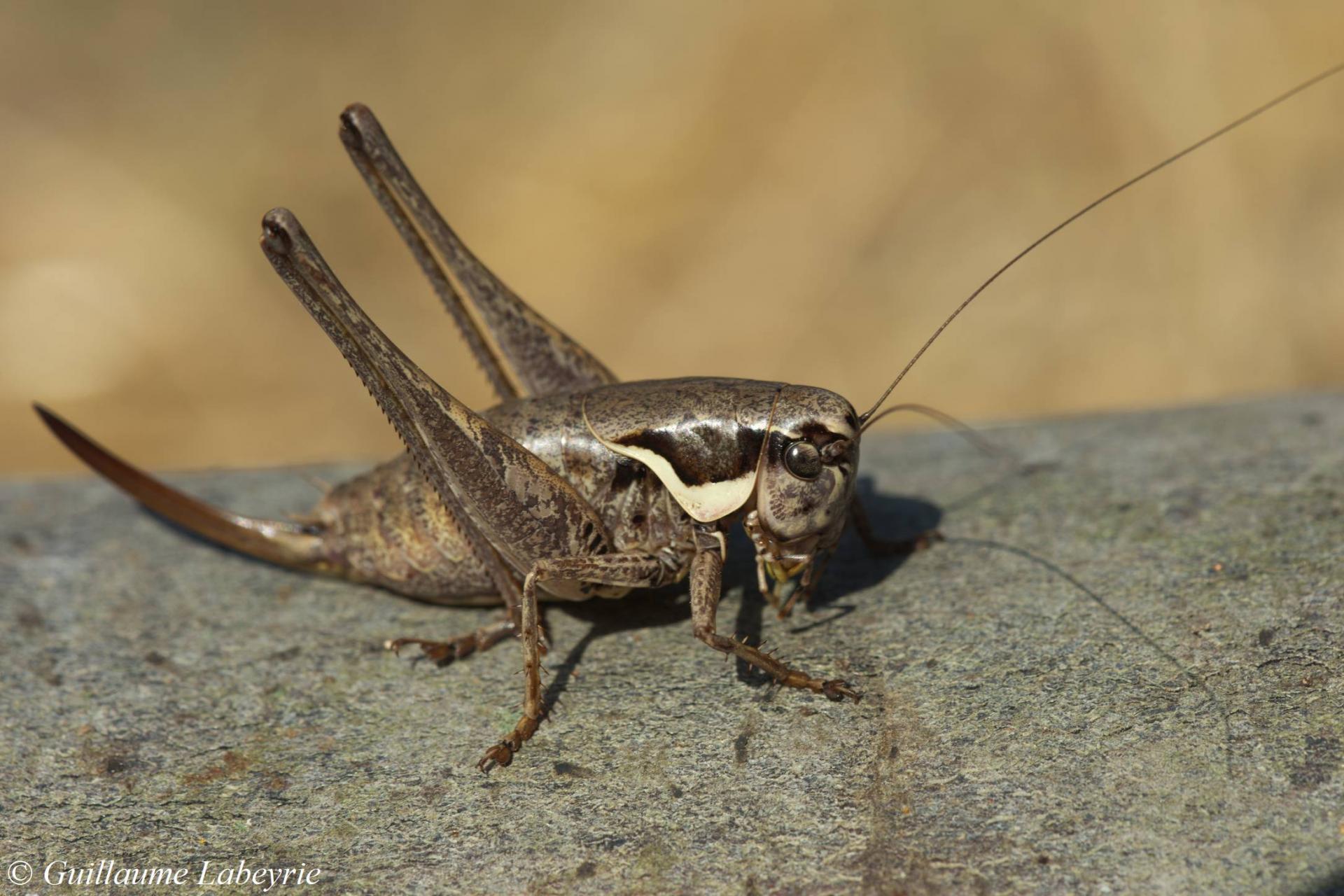 The large dark bush-cricket (Pholidoptera femorata). This rather massive bush-cricket is 20 to 30 mm long. It can only be confused with Pholidoptera fallax, present in France only in the Alpes-Maritimes, from which it is distinguished in the female by its long oviscapt, and in the male by its short elytra with an apical white spot. It frequents thermophilic grasslands, up to about 1300 m altitude. It is found in southern Europe from France to Greece, and in France in the South.
The large dark bush-cricket (Pholidoptera femorata). This rather massive bush-cricket is 20 to 30 mm long. It can only be confused with Pholidoptera fallax, present in France only in the Alpes-Maritimes, from which it is distinguished in the female by its long oviscapt, and in the male by its short elytra with an apical white spot. It frequents thermophilic grasslands, up to about 1300 m altitude. It is found in southern Europe from France to Greece, and in France in the South.
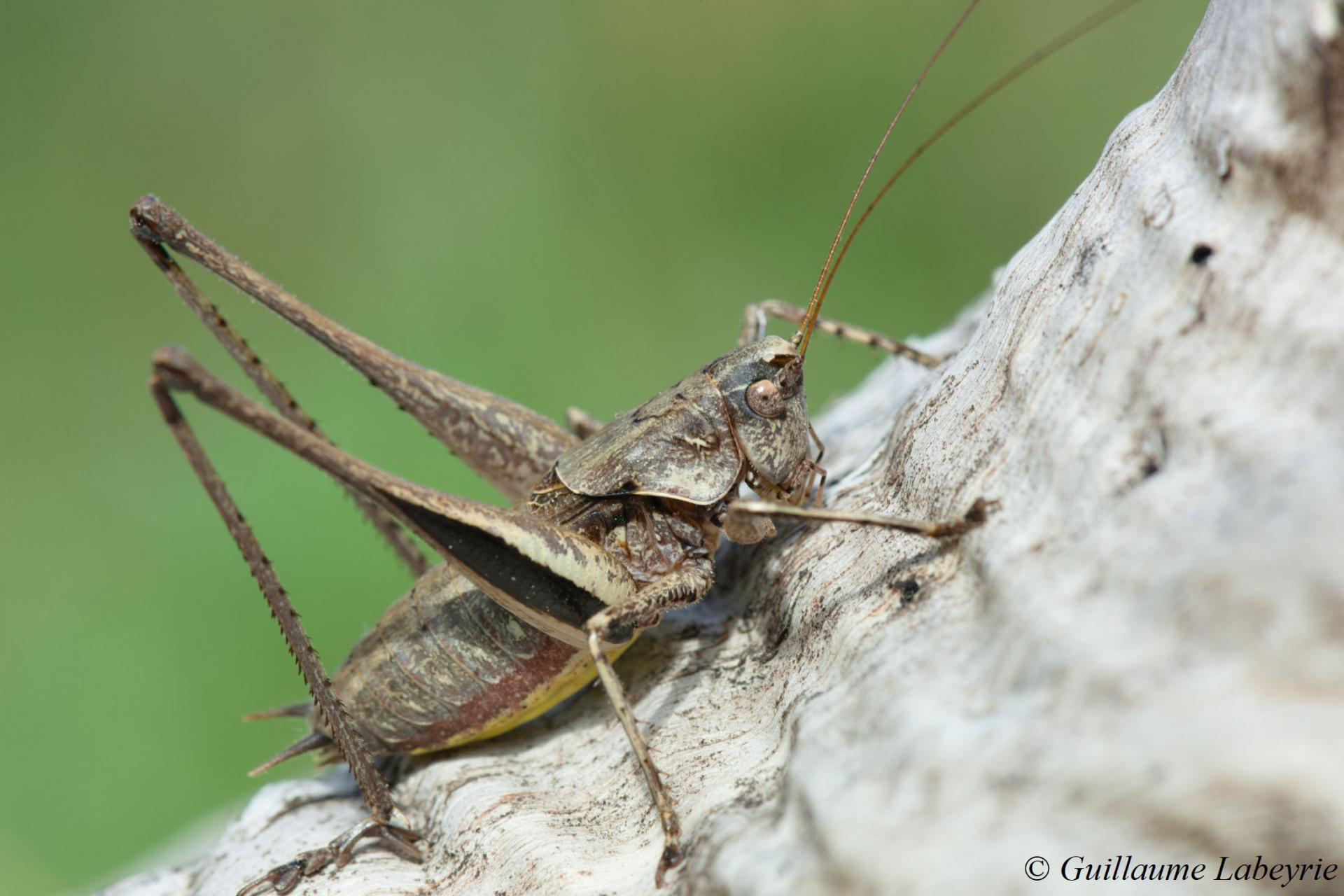 Rhacocleis poneli. This nice 20-25 mm long bush-cricket has very long hind legs, with the femurs marked with a wide black streak. Discovered as late as 1983 in the Var, this French endemic appreciates low-altitude thermophilic environments with well-developed vegetation. Present on the Mediterranean coast, and locally on the Atlantic coast, it seems to be expanding in the southern half of France.
Rhacocleis poneli. This nice 20-25 mm long bush-cricket has very long hind legs, with the femurs marked with a wide black streak. Discovered as late as 1983 in the Var, this French endemic appreciates low-altitude thermophilic environments with well-developed vegetation. Present on the Mediterranean coast, and locally on the Atlantic coast, it seems to be expanding in the southern half of France.
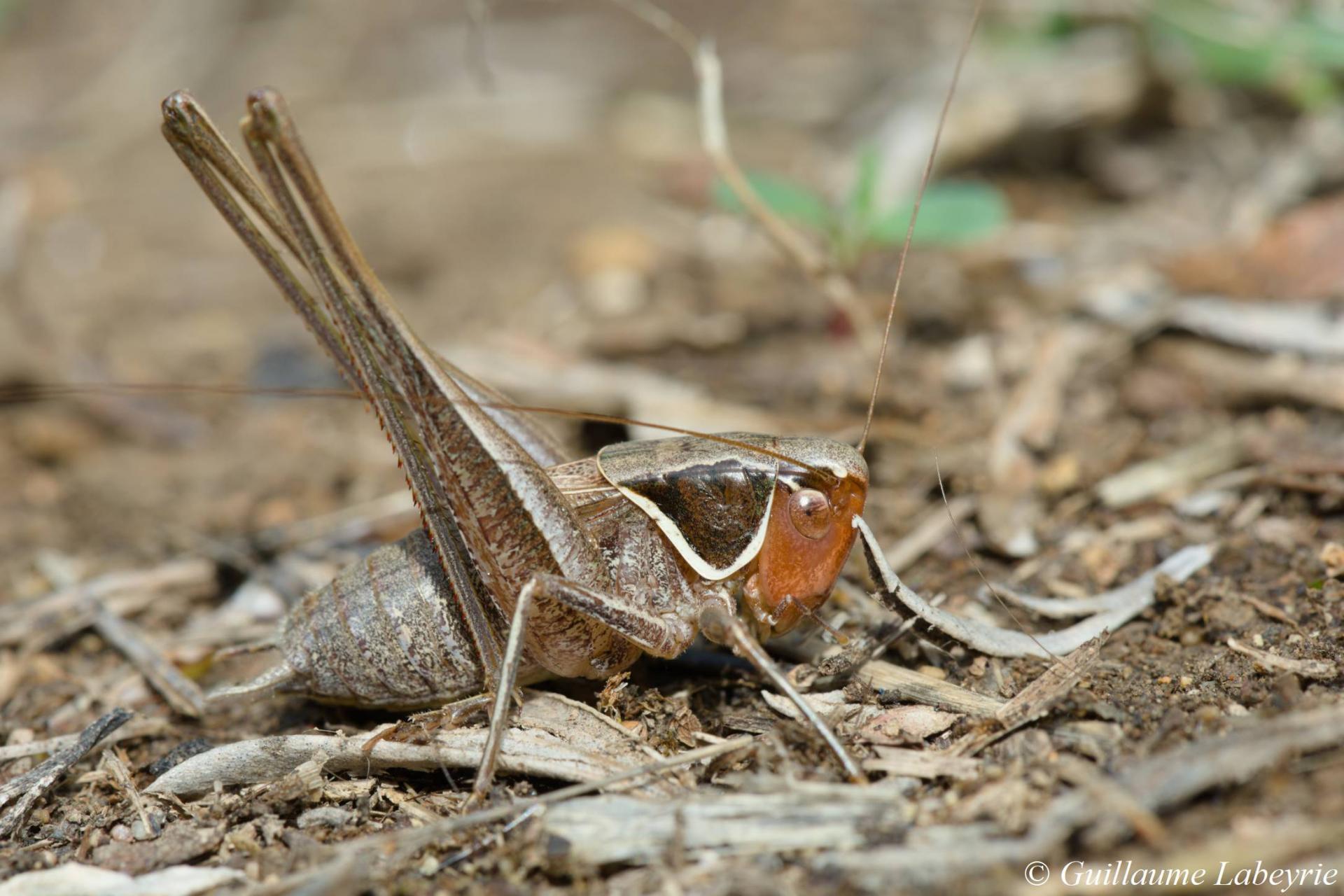 The sepia bush-cricket (Sepiana sepium). A pretty, medium-sized species well characterized by the mahogany-coloured face in both sexes and the white edging of the edge of the pronotum. It is found in thermophilic environments with abundant vegetation. It is distributed in southern Europe, from France to Turkey. In France, it is found near the Mediterranean and on the Atlantic coast, from Vendée to Gironde.
The sepia bush-cricket (Sepiana sepium). A pretty, medium-sized species well characterized by the mahogany-coloured face in both sexes and the white edging of the edge of the pronotum. It is found in thermophilic environments with abundant vegetation. It is distributed in southern Europe, from France to Turkey. In France, it is found near the Mediterranean and on the Atlantic coast, from Vendée to Gironde.
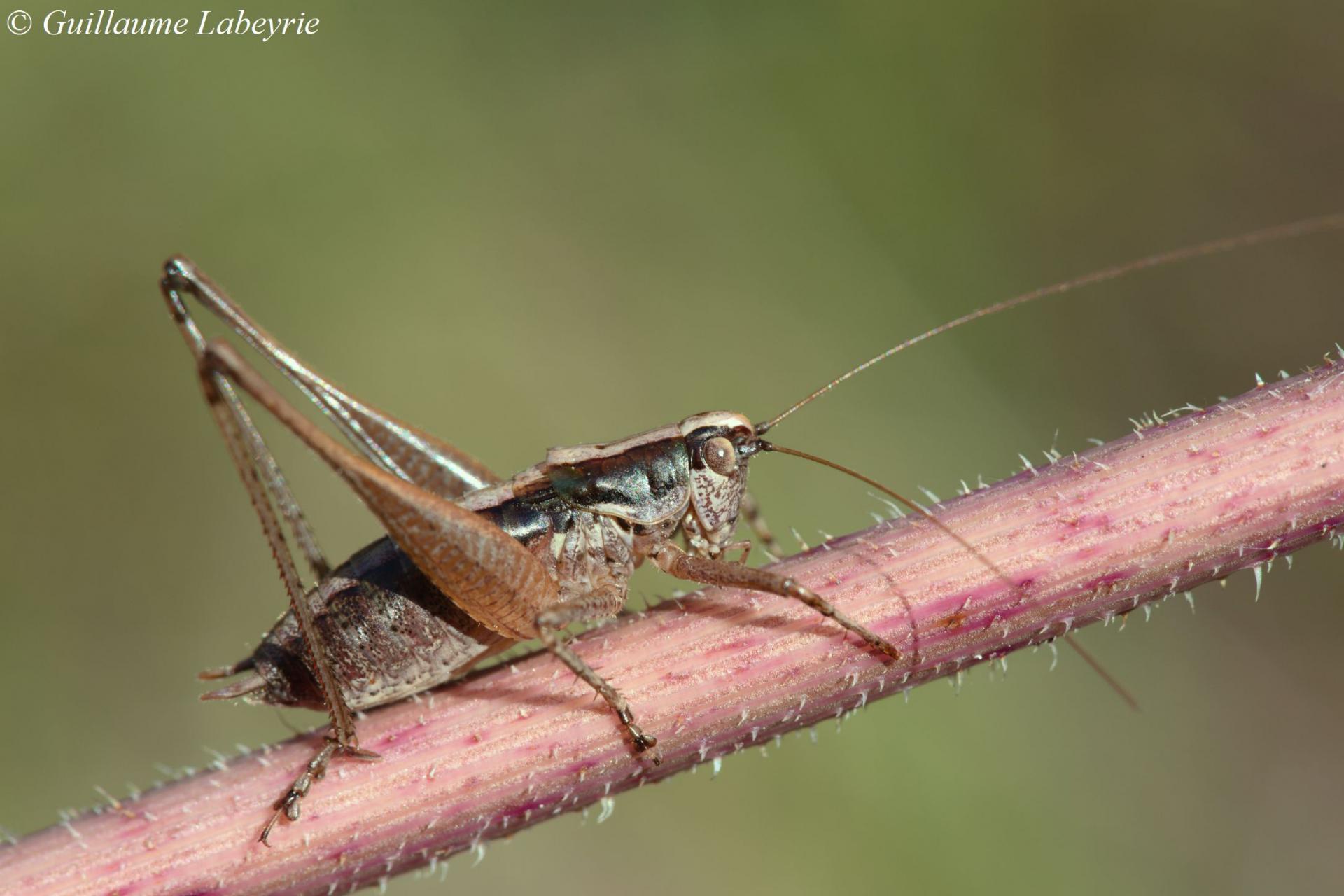 Raymond's bush-cricket (Yersinella raymondii). This small species measures 12 to 16 mm, with a brown coloration and a lighter band on the back. It is found in thermophilic thickets, generally below 1000 m of altitude. A very similar species, Yersinella beybienkoi, is found at higher elevations. This bush-cricket is present in southern Europe from France to the Balkans. In France, it is found in a southern third of the country.
Raymond's bush-cricket (Yersinella raymondii). This small species measures 12 to 16 mm, with a brown coloration and a lighter band on the back. It is found in thermophilic thickets, generally below 1000 m of altitude. A very similar species, Yersinella beybienkoi, is found at higher elevations. This bush-cricket is present in southern Europe from France to the Balkans. In France, it is found in a southern third of the country.
Mollusks
Family : Chondrinidae
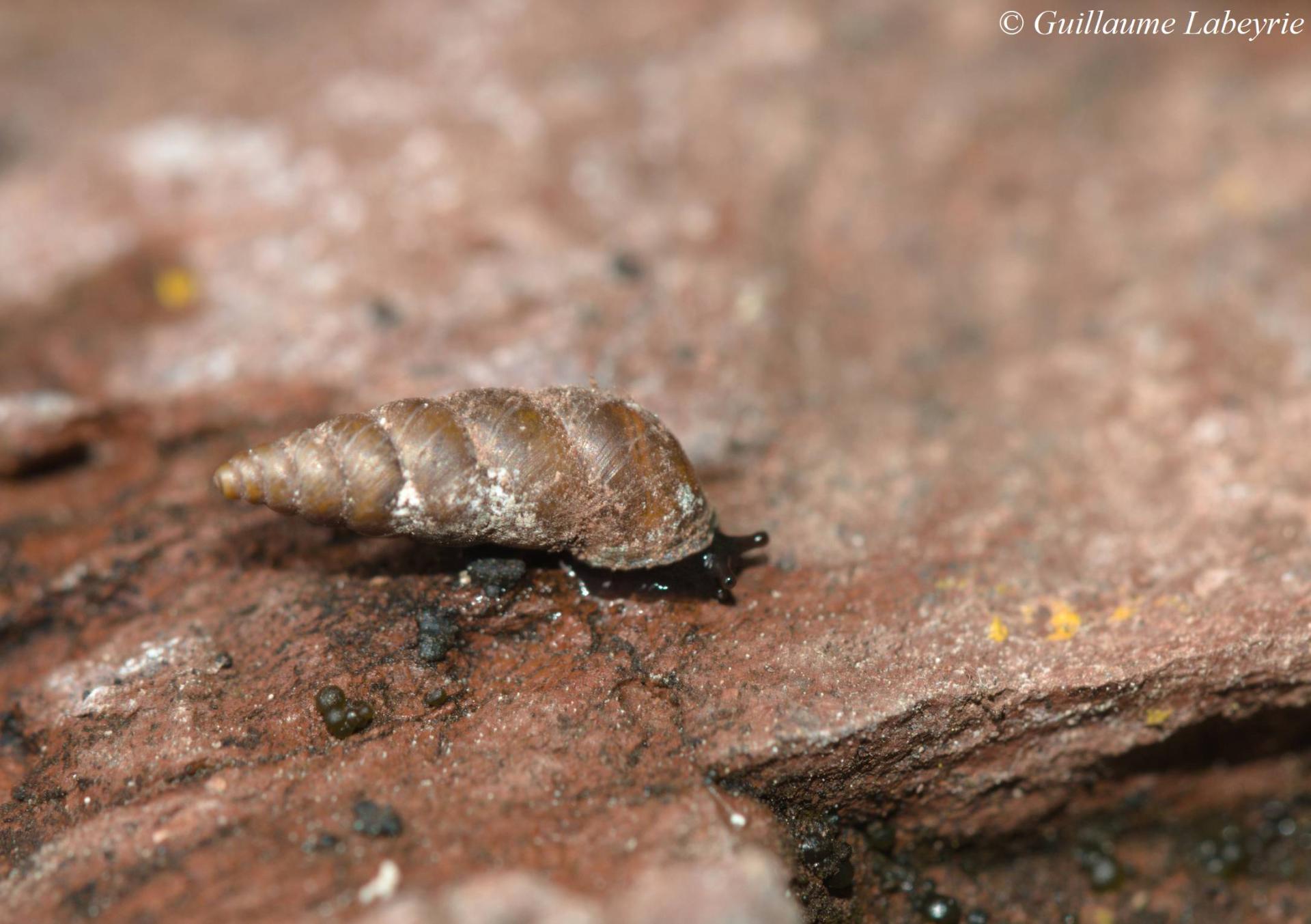
Solatopupa cianensis. This small snail measures less than a centimeter long. It is endemic to the Daluis and Cians gorges in the Alpes-Maritimes. It is found in the vertical walls of pelites, red rocks characteristic of these gorges. This species is protected in France, and appears on the national red list with the mention "near threatened".
The mountains
The PACA region includes many mountain areas, as for instance in the Parc National du Mercantour. When these mountain ranges are located near the sea and at moderate elevations, both alpine and Mediterranean influences overlap, such as in the Préalpes de Grasse.
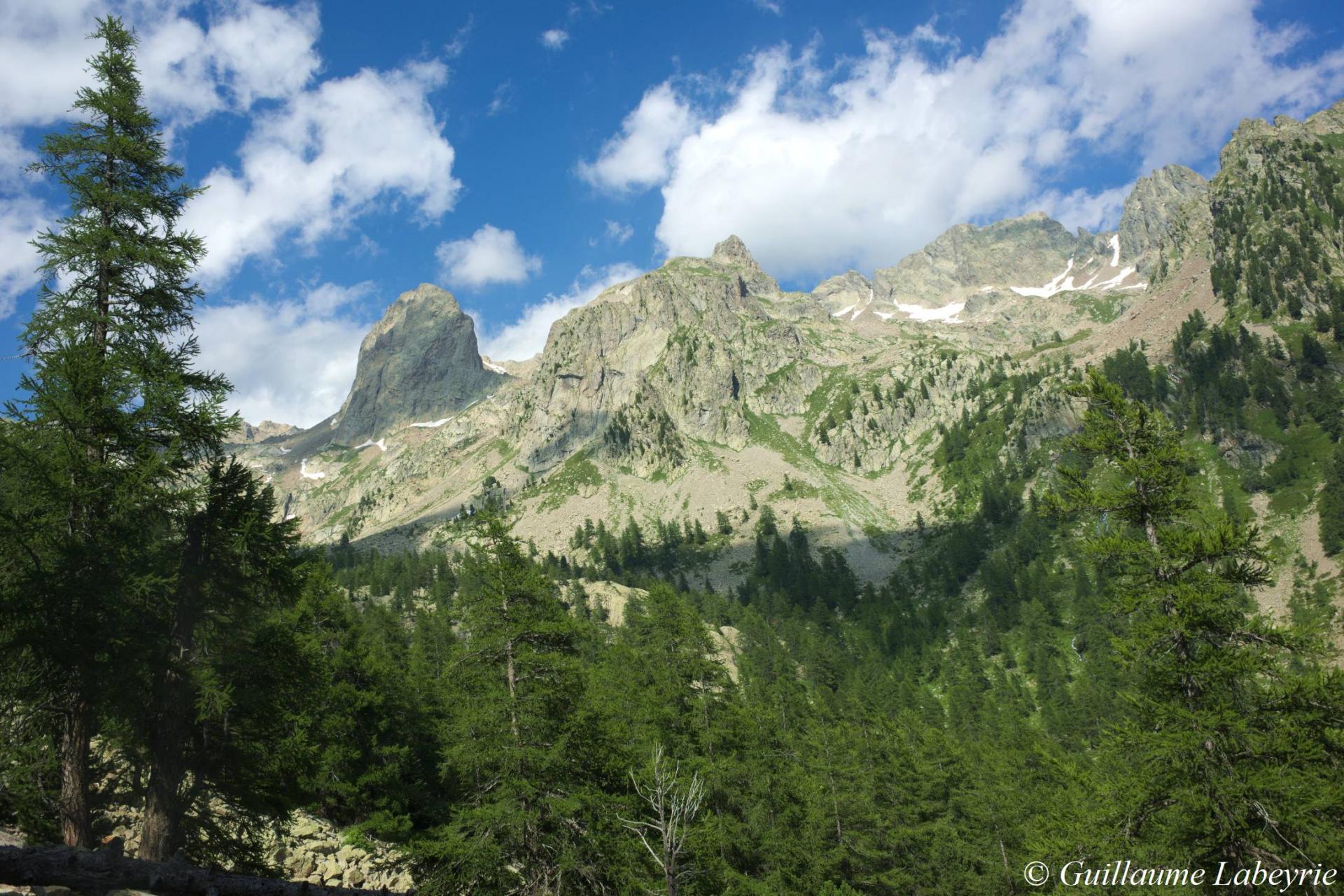
High Boréon valley, Mercantour National Park.
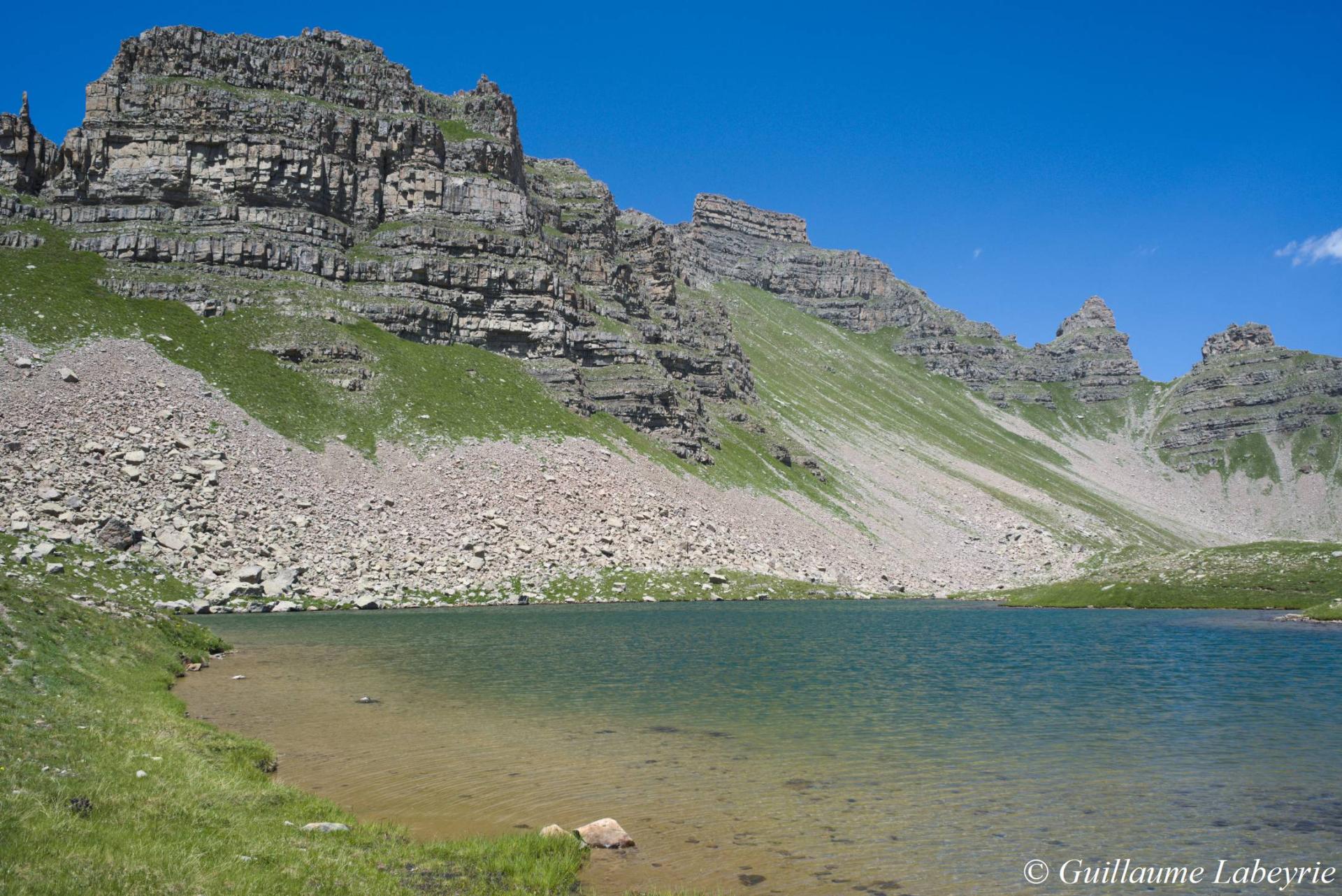 Gialorgues lakes, Mercantour National Park.
Gialorgues lakes, Mercantour National Park.
Fauna
Mammals
Family : Bovidae
 The Alpine ibex (Capra ibex). An emblematic Alpine species, the beautiful animal is found on ridges and cliffs unfrequented by man. The Alpine ibex has been the object of a reintroduction program in the Parc National du Mercantour and the nearby Italian Parco delle Alpi Marittime since 1985.
The Alpine ibex (Capra ibex). An emblematic Alpine species, the beautiful animal is found on ridges and cliffs unfrequented by man. The Alpine ibex has been the object of a reintroduction program in the Parc National du Mercantour and the nearby Italian Parco delle Alpi Marittime since 1985.
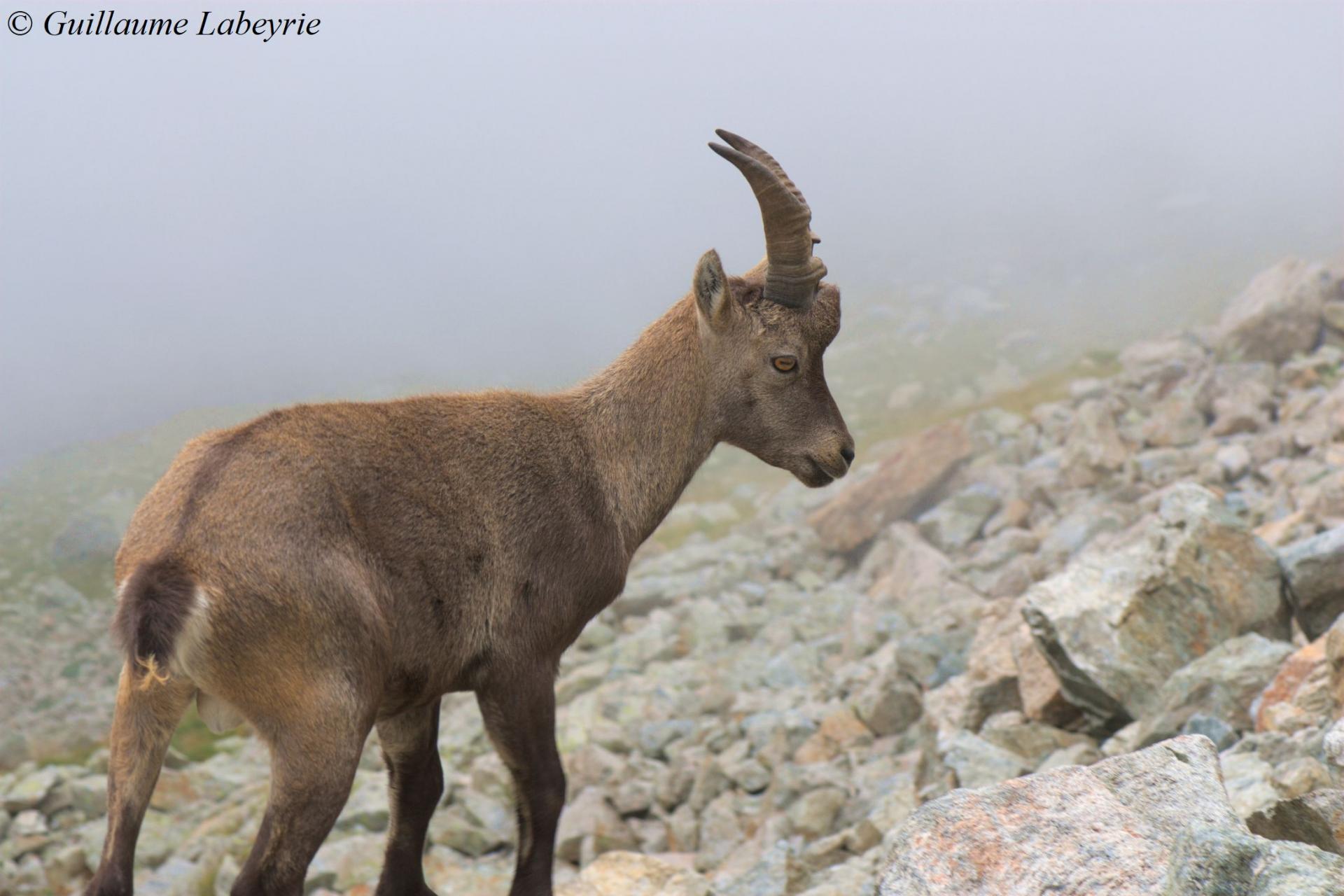
Young alpine ibex (Capra ibex) male.
Reptiles
Family : Colubridae
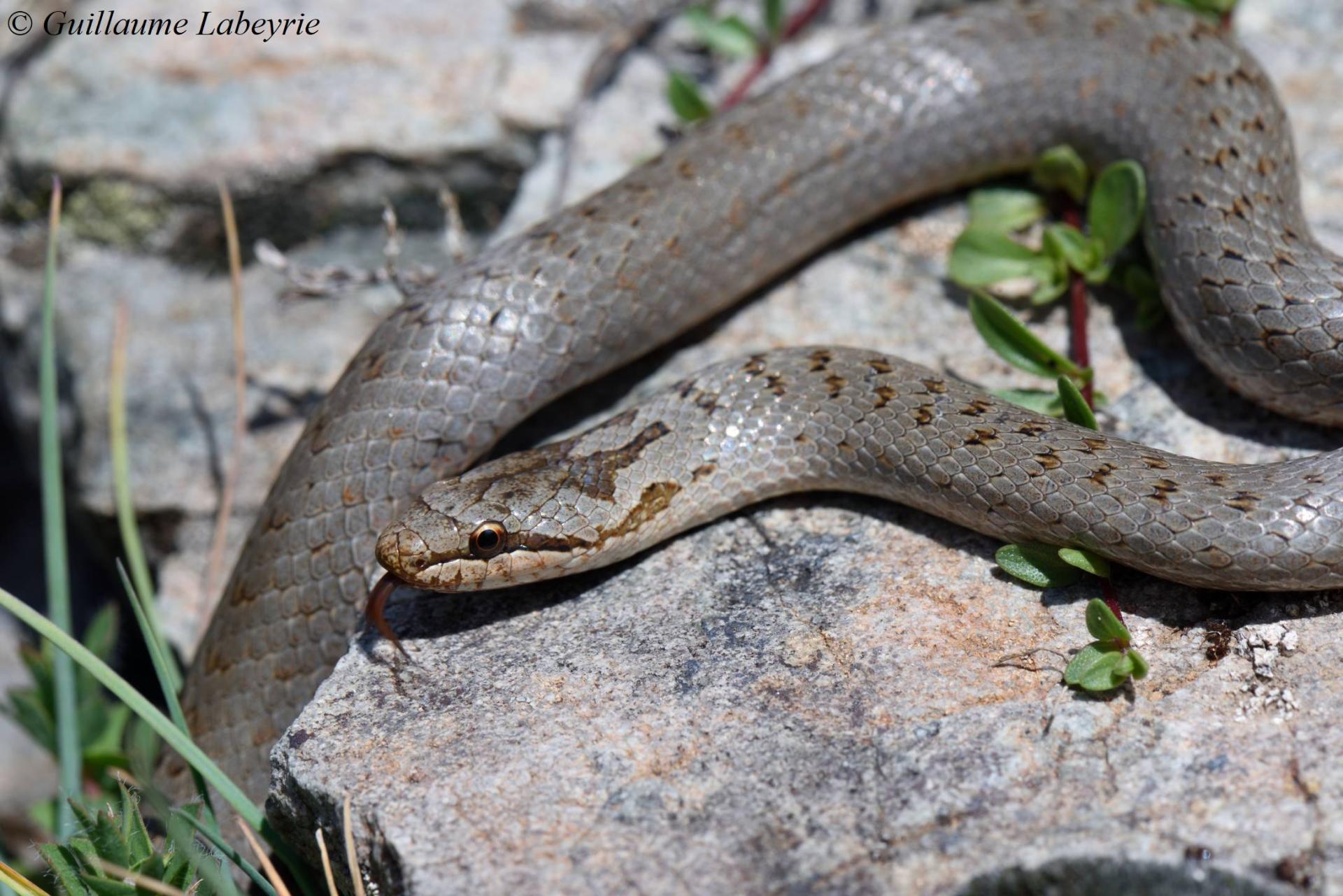
The smooth snake (Coronella austriaca). This small snake is distinguished from Coronella girondica in particular by the presence of a dark line between the eye and the nostril. Both species are heavy consumers of lizards. Much more cold-tolerant than C. girondica, C. austriaca is found in our region in the mountains (this individual was photographed at an altitude of 2400 m). Distributed throughout Europe as far as Russia, this snake is found almost everywhere in France. It is fully protected.
Amphibians
Family : Ranidae
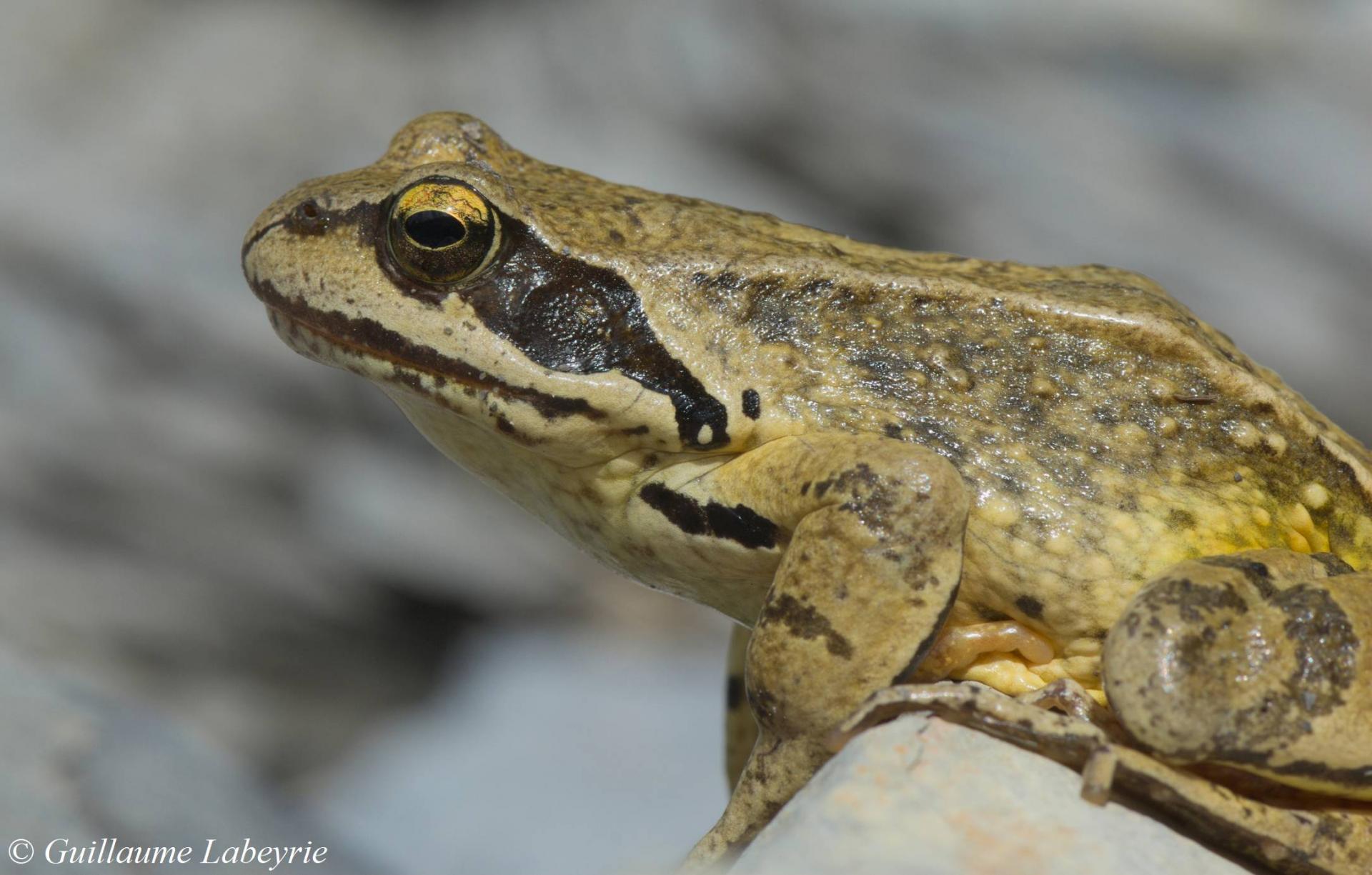 The common frog (Rana temporaria). This frog can reach high altitudes (2800 m in the Alps), but it is also found at sea level. It is a widespread amphibian, with a distribution covering most of Europe except the southernmost areas, and extending eastward to Siberia.
The common frog (Rana temporaria). This frog can reach high altitudes (2800 m in the Alps), but it is also found at sea level. It is a widespread amphibian, with a distribution covering most of Europe except the southernmost areas, and extending eastward to Siberia.
Family : Salamandridae
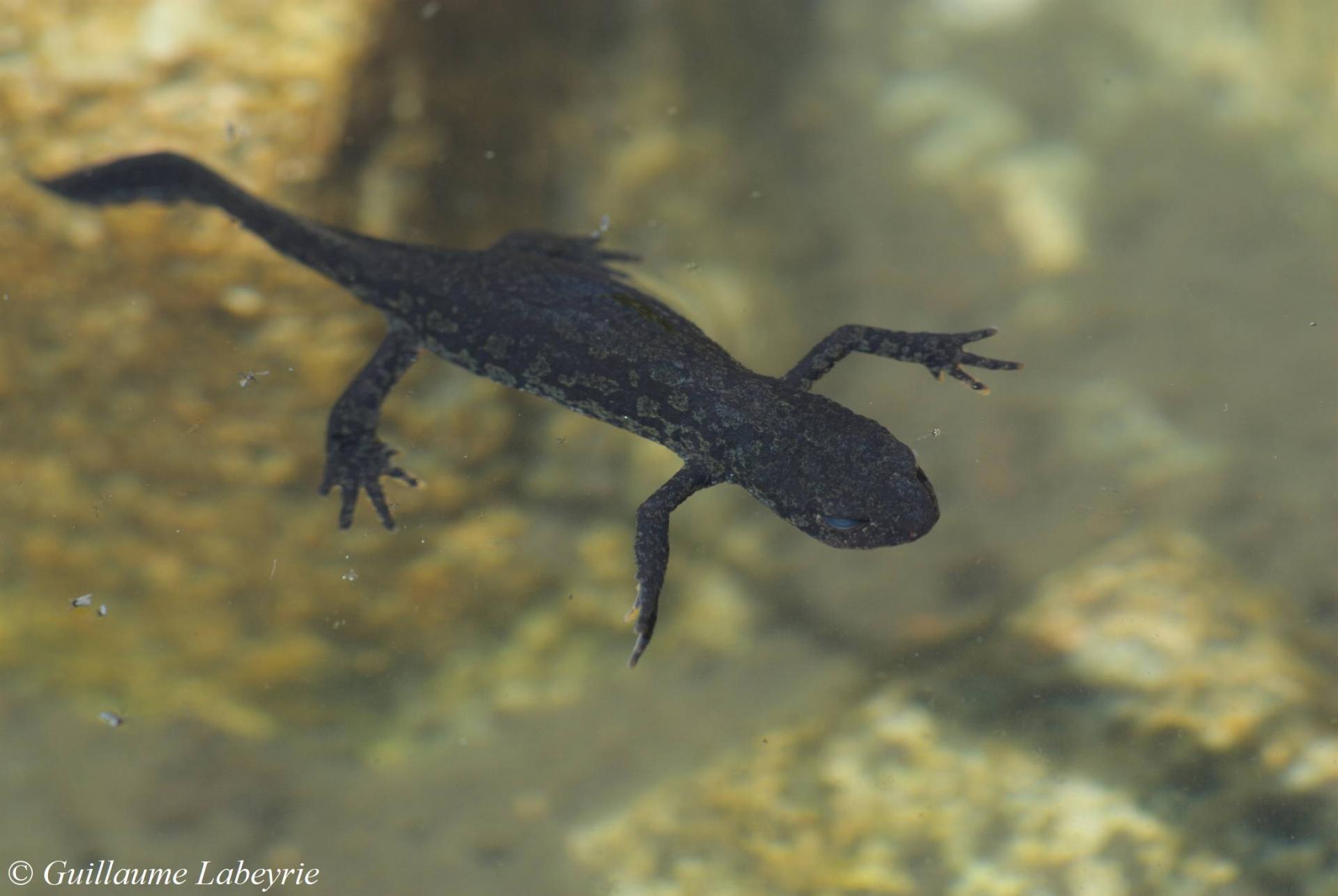 The alpine newt (Ichthyosaura alpestris). This new is found at low altitude as well as in high mountains, where it reaches 2700 m. In mountains, it is often living in alpine lakes or in peat bog ponds, devoid of aquatic vegetation. This species ranges from Europe to Ukraine. It is protected in France.
The alpine newt (Ichthyosaura alpestris). This new is found at low altitude as well as in high mountains, where it reaches 2700 m. In mountains, it is often living in alpine lakes or in peat bog ponds, devoid of aquatic vegetation. This species ranges from Europe to Ukraine. It is protected in France.
Beetles
Family : Carabidae
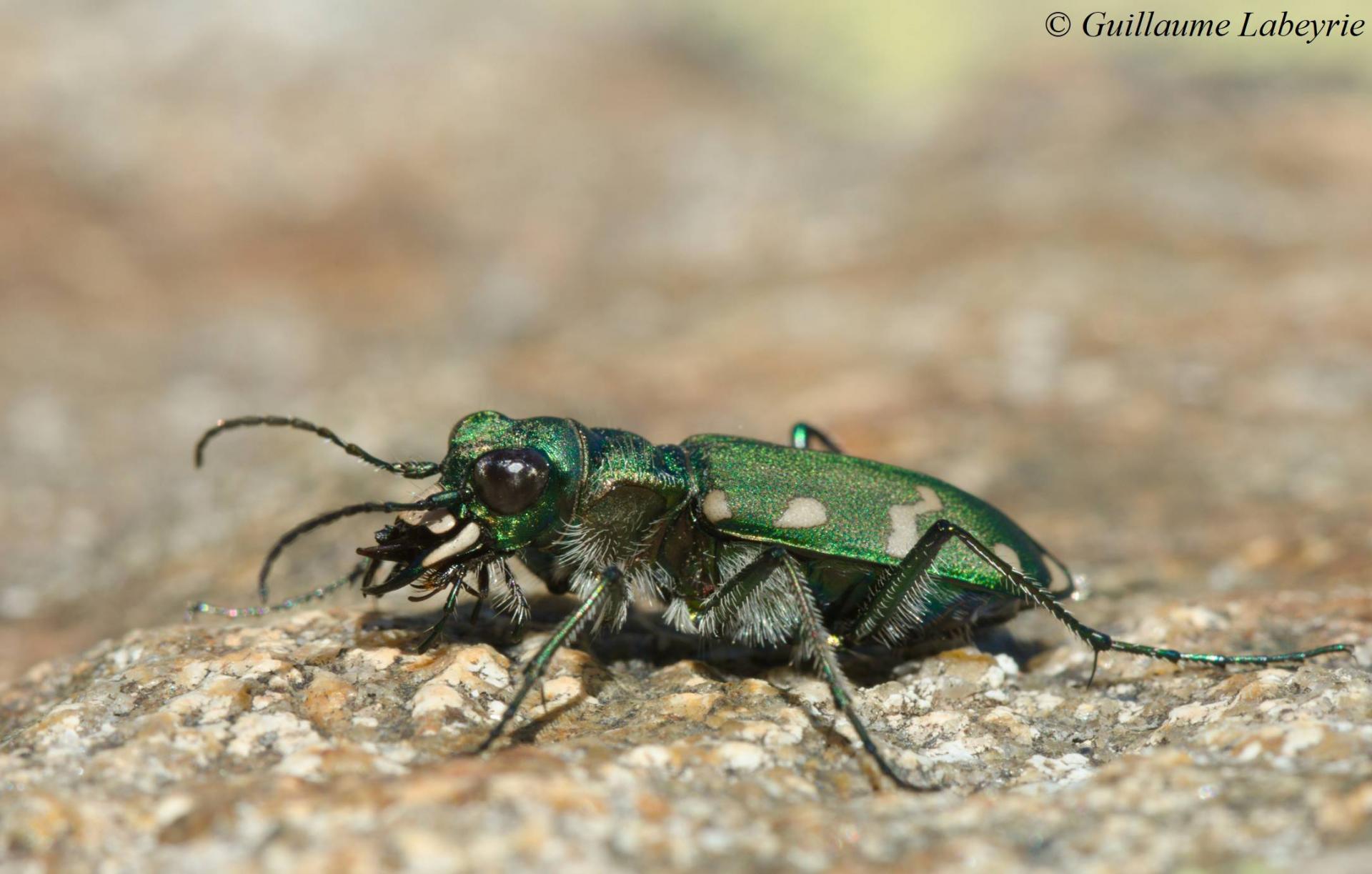 Cicindela gallica. This is our only truly alpine tiger beetle, found in alpine grasslands above an altitude of 2000 m. It is variable, green with some white spots. It is endemic to the Alps.
Cicindela gallica. This is our only truly alpine tiger beetle, found in alpine grasslands above an altitude of 2000 m. It is variable, green with some white spots. It is endemic to the Alps.
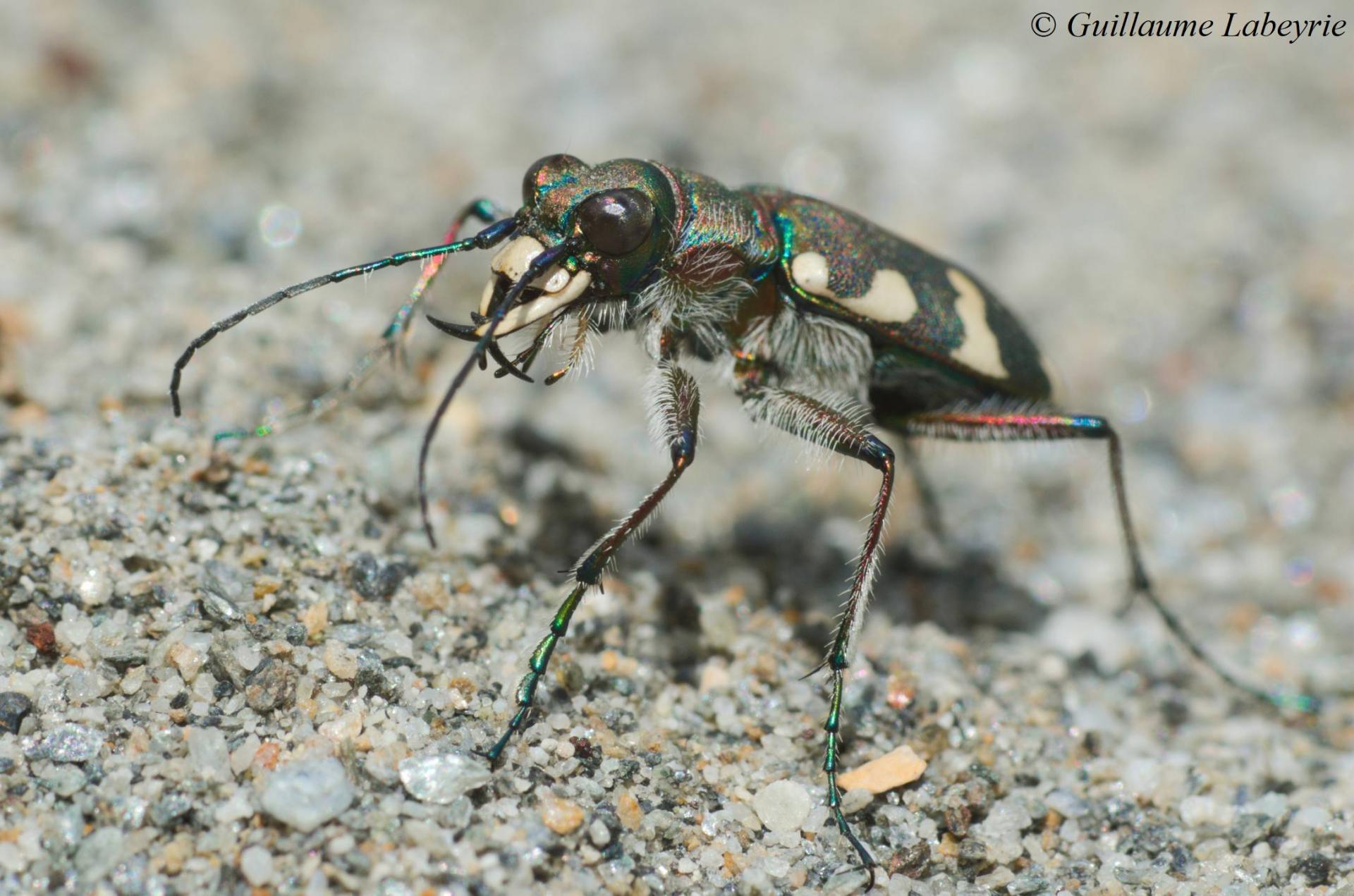 The hybrid tiger beetle (Cicindela hybrida). Not strictly-speaking an alpine species, this tiger beetle is however frequent on sandy shores along mountain rivers. As all tiger beetles, it is a very agile and ferocious hunter.
The hybrid tiger beetle (Cicindela hybrida). Not strictly-speaking an alpine species, this tiger beetle is however frequent on sandy shores along mountain rivers. As all tiger beetles, it is a very agile and ferocious hunter.
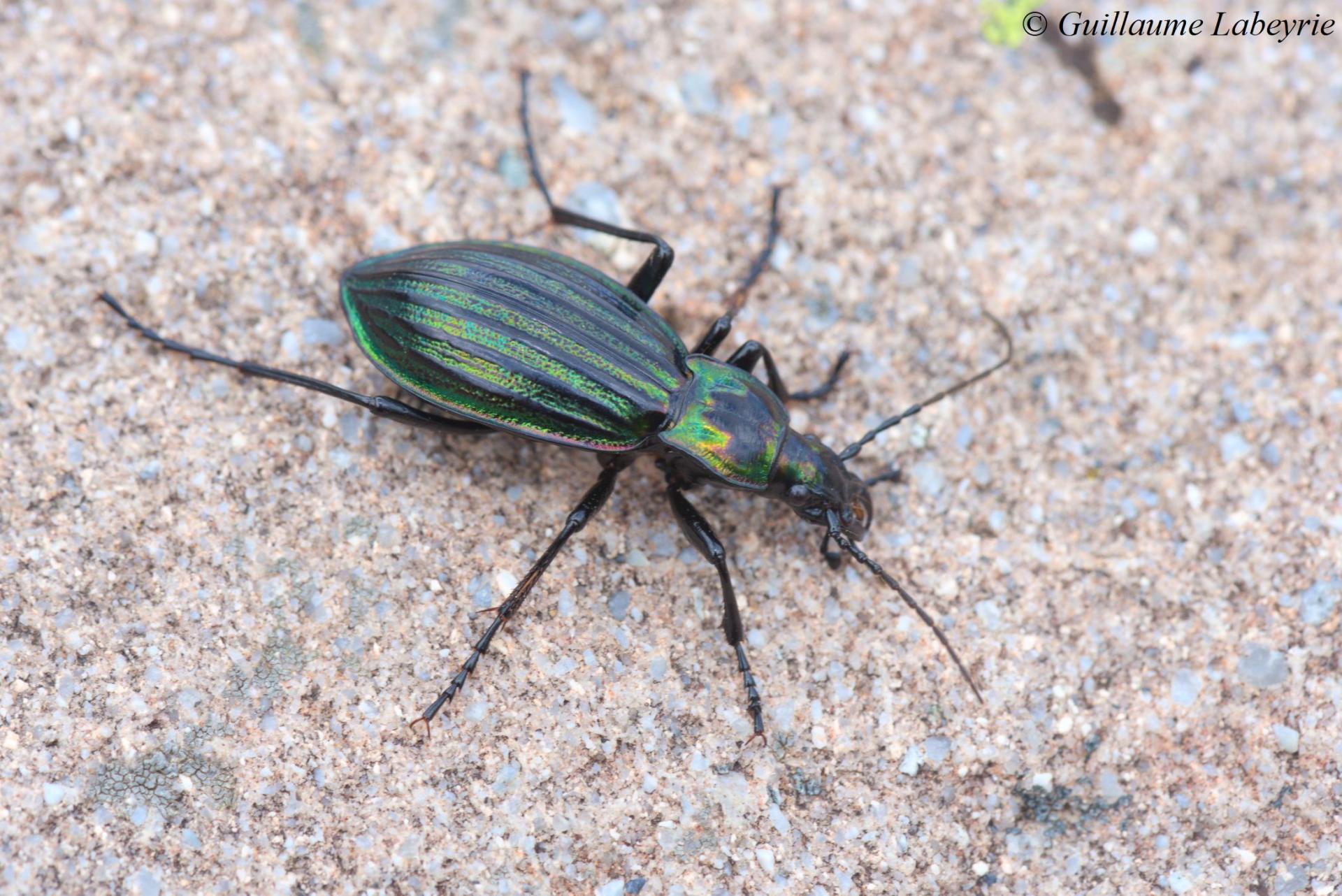
Carabus solieri subsp. solieri. This magnificent carabid is distinguished by its green elytra with blue stripes. Two other subspecies (C. solieri bonnetianus and C. solieri clairi) have the ground color of the elytra purplish blue, sometimes almost black. C. solieri solieri is restricted to the Alpes-Maritimes, the Alpes-de-Haute-Provence and part of the Hautes-Alpes. This species is protected in France.
Family : Chrysomelidae
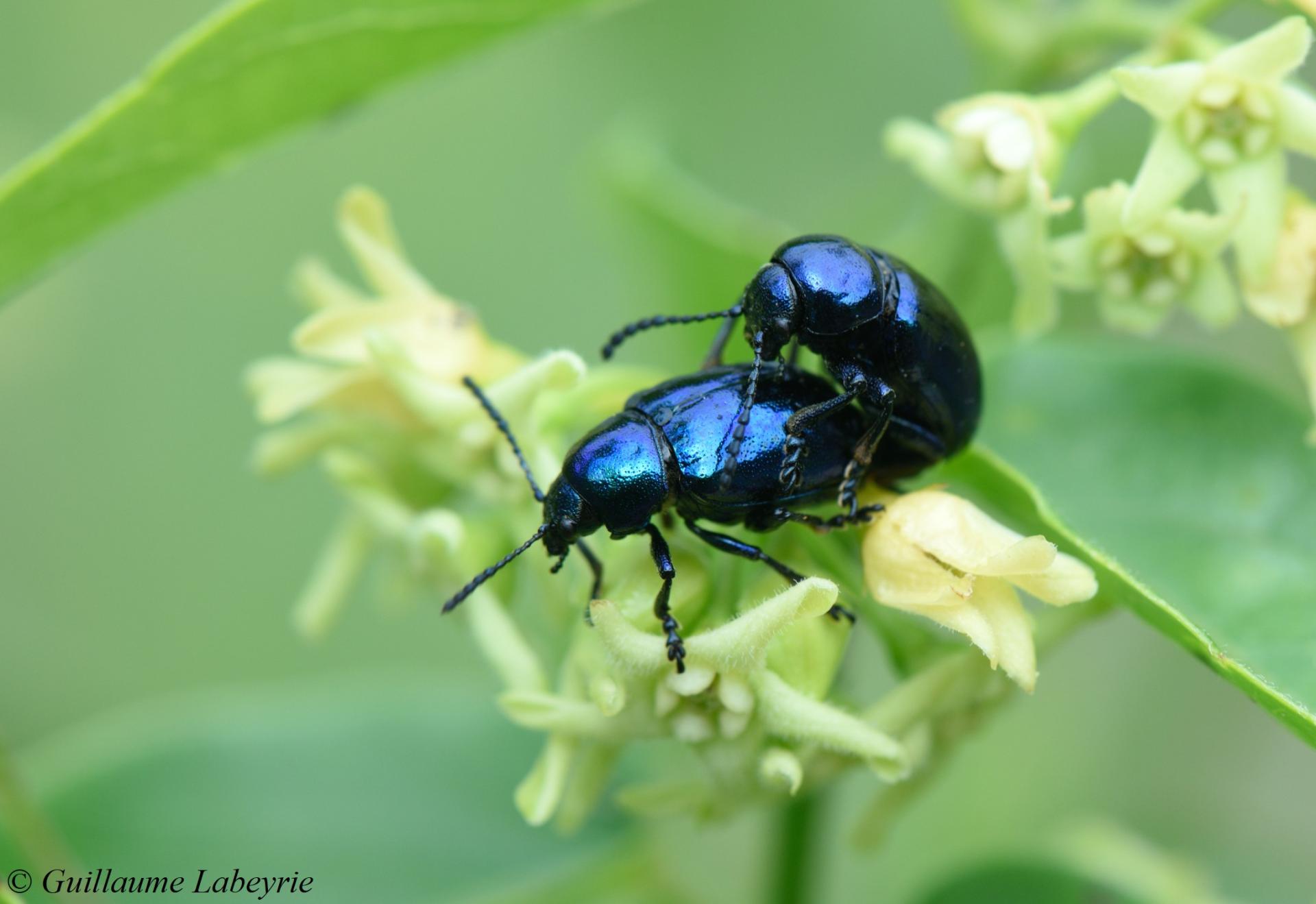
Chrysochus asclepiadeus. This beautiful blue beetle is observed exclusively on the white swallow-wort (Vincetoxicum hirundinaria). Quite widely distributed in Europe, it seems uncommon in France and is present in particular in the Alpes-de-Haute-Provence, Isère, Ain, Jura and Pyrénées-Orientales.
Family : Meloidae
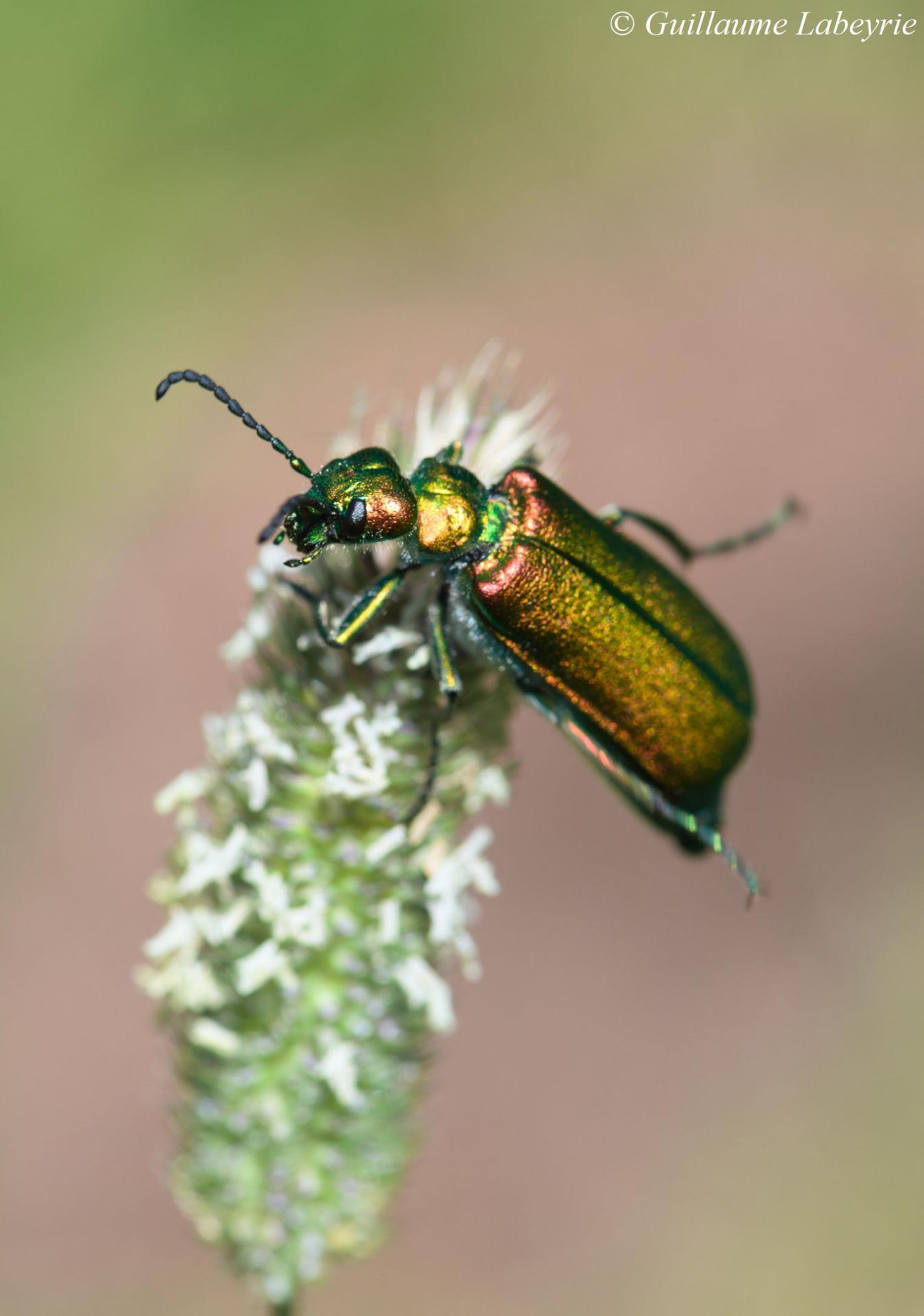 The Spanish fly (Lytta vesicatoria). This brilliant green beetle is about 2 cm long. Adults feed mainly on ash leaves. Like many Meloidae, this species can exude an irritant from its joints when attacked. In Lytta vesicatoria, this toxic and irritating substance contains cantharidin, known since antiquity for its supposed aphrodisiac properties. The ''Spanish fly'' has a wide distribution in Europe, Asia and Africa. In France, it is found here and there up to more than 2000 m of altitude.
The Spanish fly (Lytta vesicatoria). This brilliant green beetle is about 2 cm long. Adults feed mainly on ash leaves. Like many Meloidae, this species can exude an irritant from its joints when attacked. In Lytta vesicatoria, this toxic and irritating substance contains cantharidin, known since antiquity for its supposed aphrodisiac properties. The ''Spanish fly'' has a wide distribution in Europe, Asia and Africa. In France, it is found here and there up to more than 2000 m of altitude.
Butterflies
Family : Hesperiidae
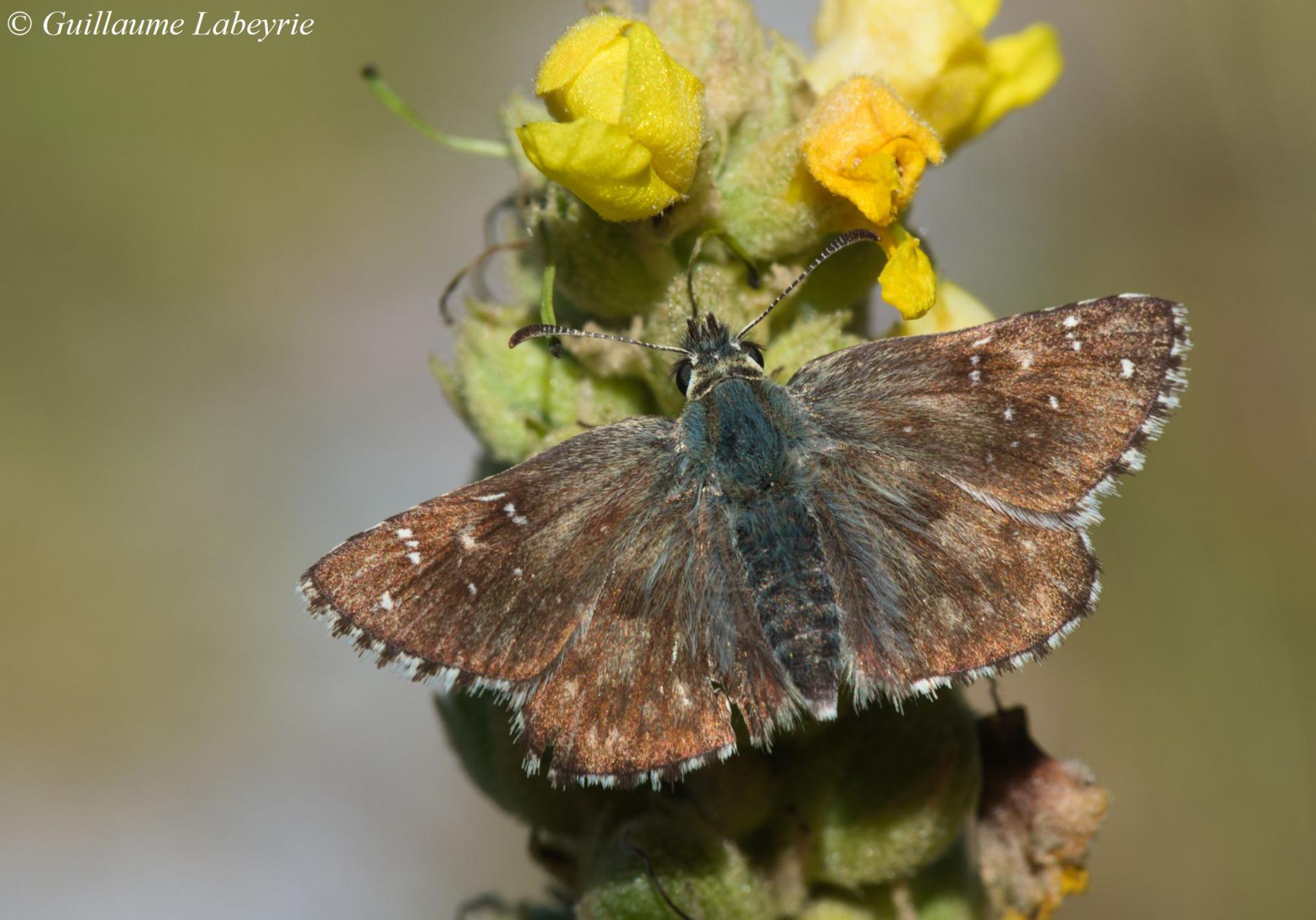 The dusky grizzled skipper (Pyrgus cacaliae). This Pyrgus is distinguished by tiny white spots on the upperside of the forewings, and very diffuse spots on the upperside of the hindwings. It frequents wetlands in the mountains, with an optimum around an altitude of 2200 m. It is distributed in the Pyrenees, the Alpine Arc and the Carpathians.
The dusky grizzled skipper (Pyrgus cacaliae). This Pyrgus is distinguished by tiny white spots on the upperside of the forewings, and very diffuse spots on the upperside of the hindwings. It frequents wetlands in the mountains, with an optimum around an altitude of 2200 m. It is distributed in the Pyrenees, the Alpine Arc and the Carpathians.
Family : Lycaenidae
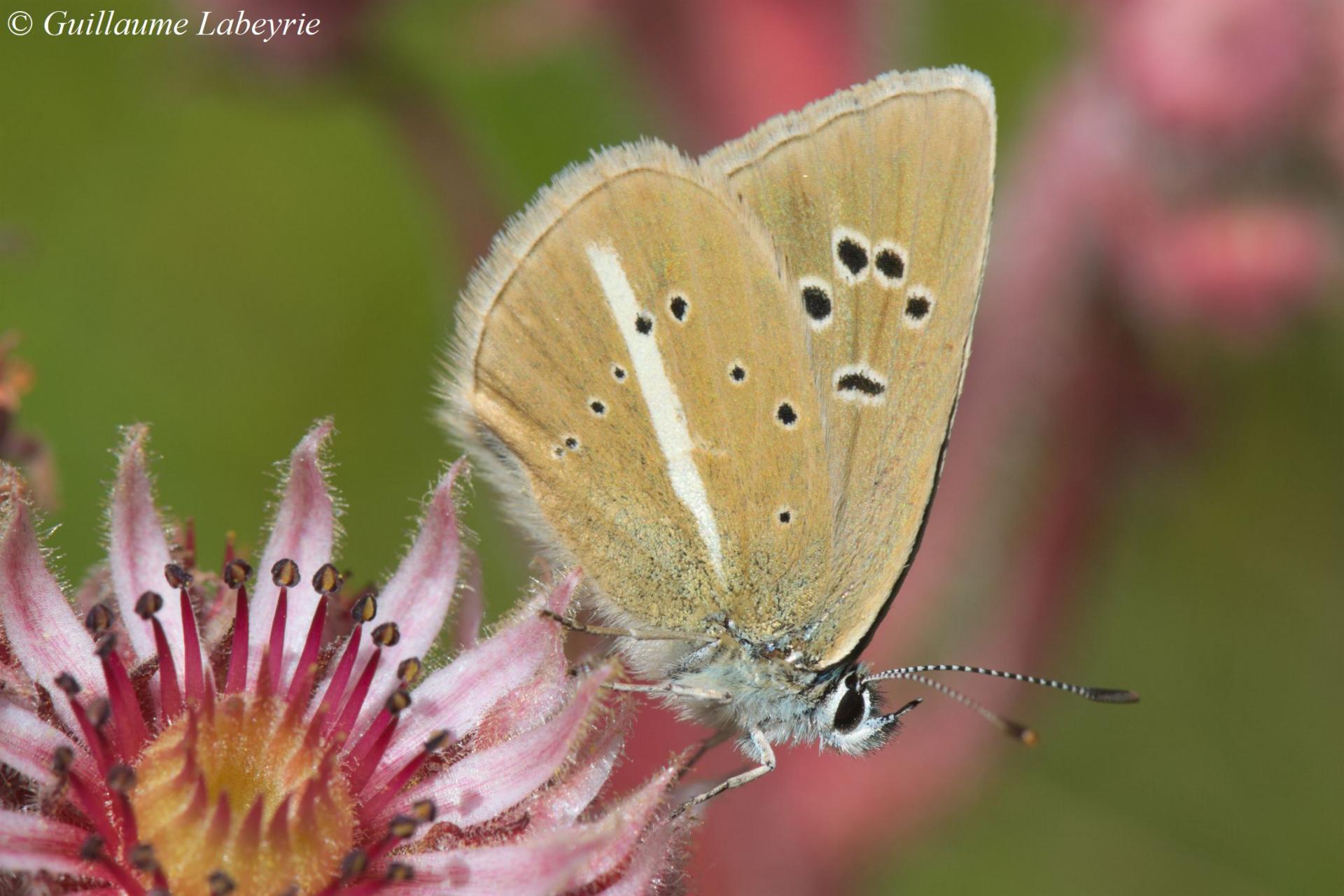 The damon blue (Polyommatus damon). This attractive species is distinguished by the white streak on the underside and the bright blue upperparts of the male. The upper side of the female, shown here, is brown. A closely related species, Ripart's anomalous blue (Polyommatus ripartii), is found in the south-east of France. The damon blue has a wide but very fragmented distribution. In France, it is found mainly in the mountains (Alps and Pyrenees).
The damon blue (Polyommatus damon). This attractive species is distinguished by the white streak on the underside and the bright blue upperparts of the male. The upper side of the female, shown here, is brown. A closely related species, Ripart's anomalous blue (Polyommatus ripartii), is found in the south-east of France. The damon blue has a wide but very fragmented distribution. In France, it is found mainly in the mountains (Alps and Pyrenees).
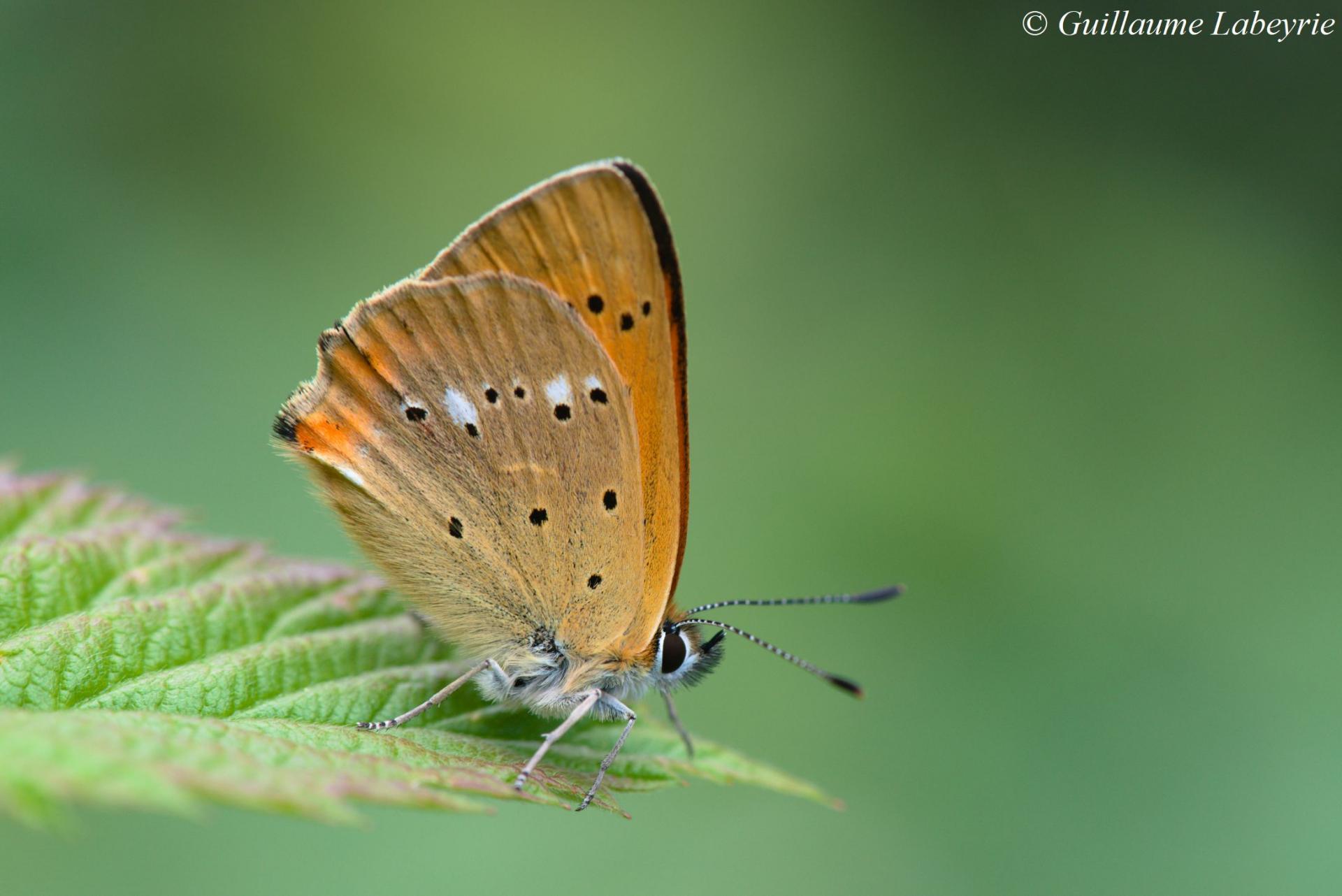 The scarce copper (Lycaena virgaureae). This copper can be observed in meadows and flowery edges, from 800 m to 2400 m. The upperside of the male, shown here, is bright orange, and the underside of the hindwings has some characteristic white spots. The caterpillars feed on sorrel (Rumex sp.). Present throughout Europe as far as Turkey and Russia, this butterfly is found in France in the south-eastern half.
The scarce copper (Lycaena virgaureae). This copper can be observed in meadows and flowery edges, from 800 m to 2400 m. The upperside of the male, shown here, is bright orange, and the underside of the hindwings has some characteristic white spots. The caterpillars feed on sorrel (Rumex sp.). Present throughout Europe as far as Turkey and Russia, this butterfly is found in France in the south-eastern half.
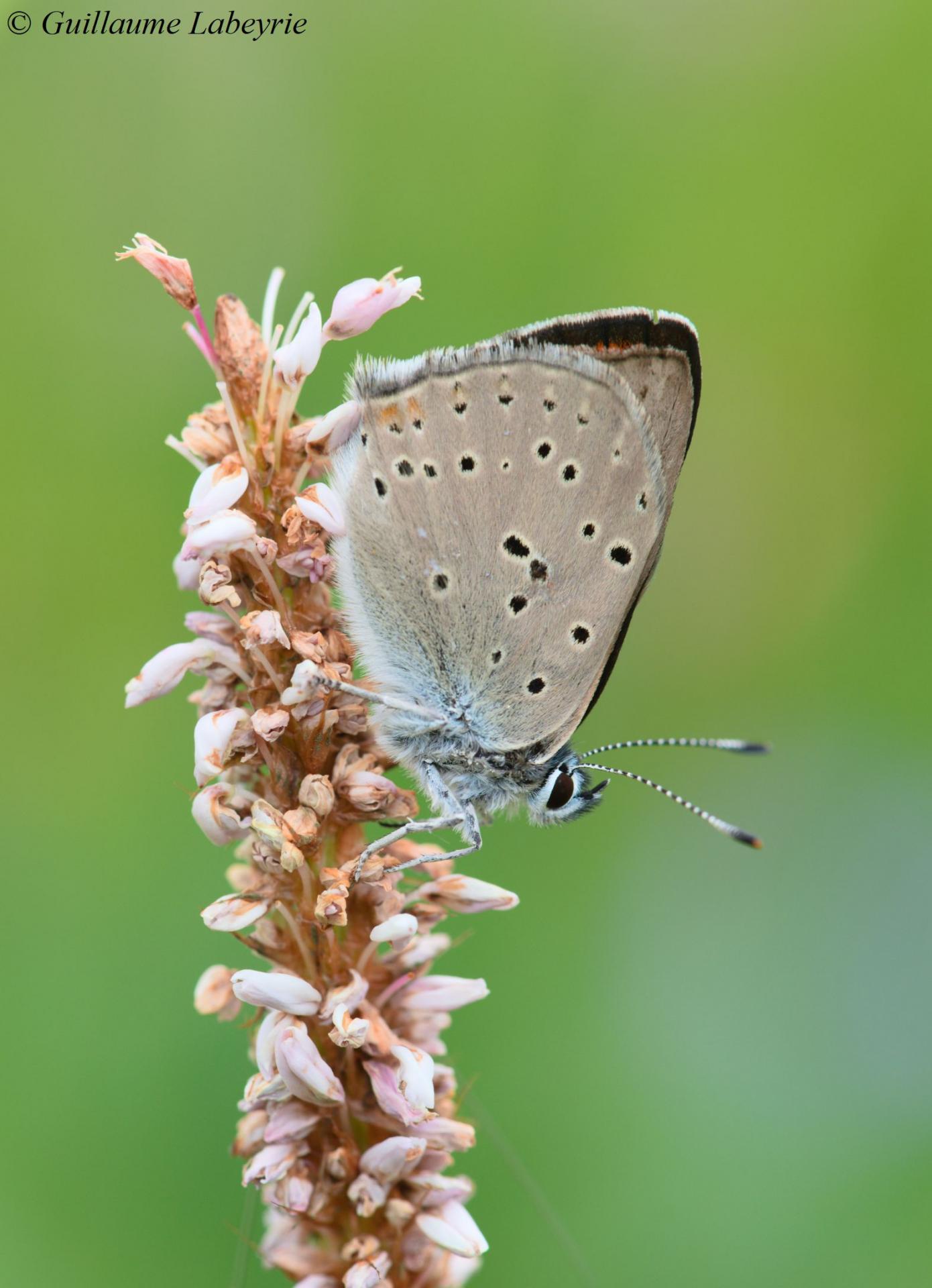 The purple-edged copper (Lycaena hippothoe). This other copper is found in wet meadows from 1200 m to 2400 m of altitude. The upperside of the male is a more intense orange-red than in L. virgaureae, and the underside of the hindwings is without white spots. The caterpillars also feed on sorrels. Distributed throughout Europe as far as Russia, this butterfly is found in France in the south-eastern half.
The purple-edged copper (Lycaena hippothoe). This other copper is found in wet meadows from 1200 m to 2400 m of altitude. The upperside of the male is a more intense orange-red than in L. virgaureae, and the underside of the hindwings is without white spots. The caterpillars also feed on sorrels. Distributed throughout Europe as far as Russia, this butterfly is found in France in the south-eastern half.
Family : Nymphalidae
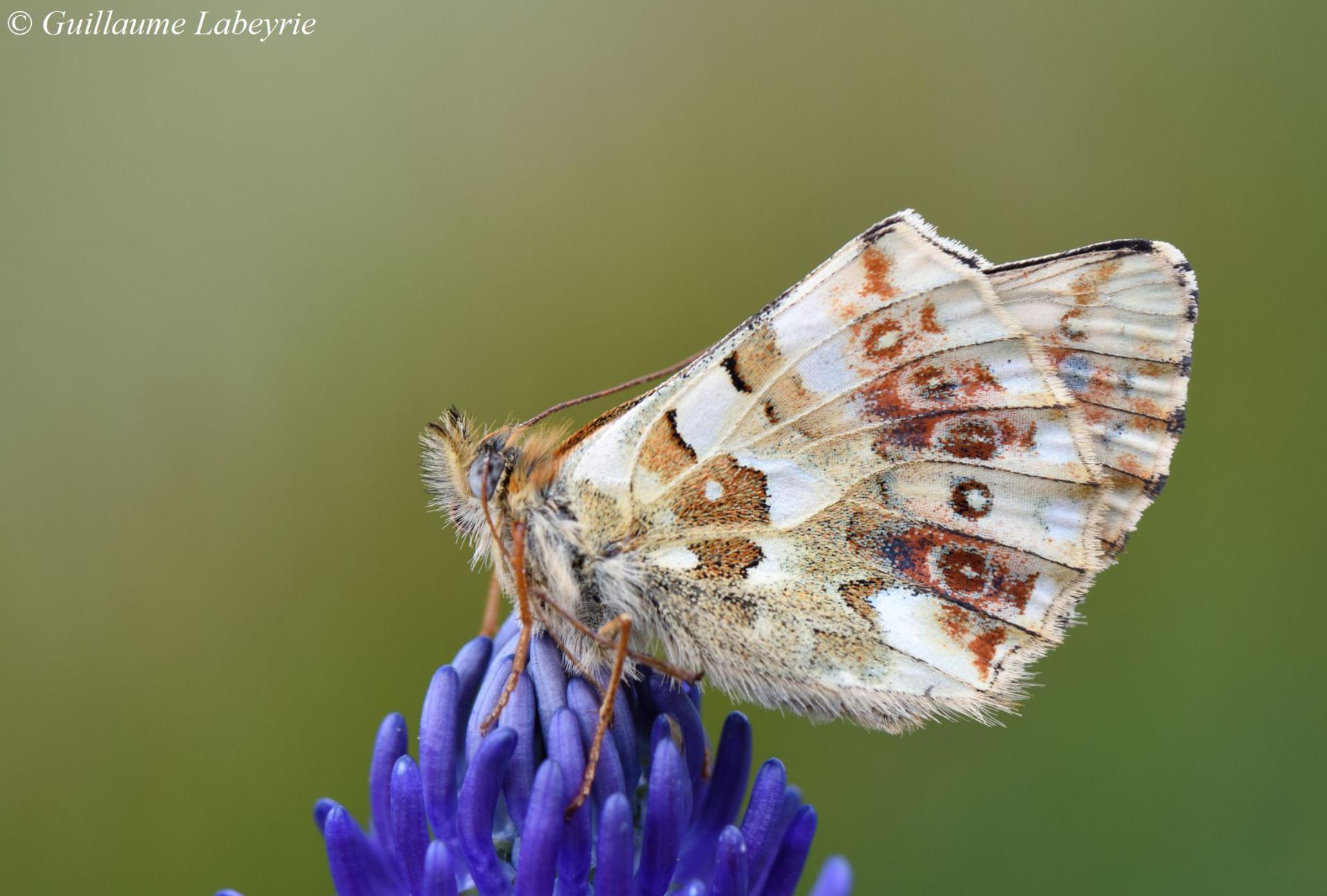
The Balkan fritillary (Boloria graeca). This beautiful, uncommon species is distinguished in particular by the angular apex of the hindwings. It frequents rocky alpine grasslands from 1600 to 2400 m of altitude. The distribution of this butterfly is restricted, with on the one hand the Balkan Mountains and on the other hand an isolated population in the Southern Alps (subspecies tendensis).
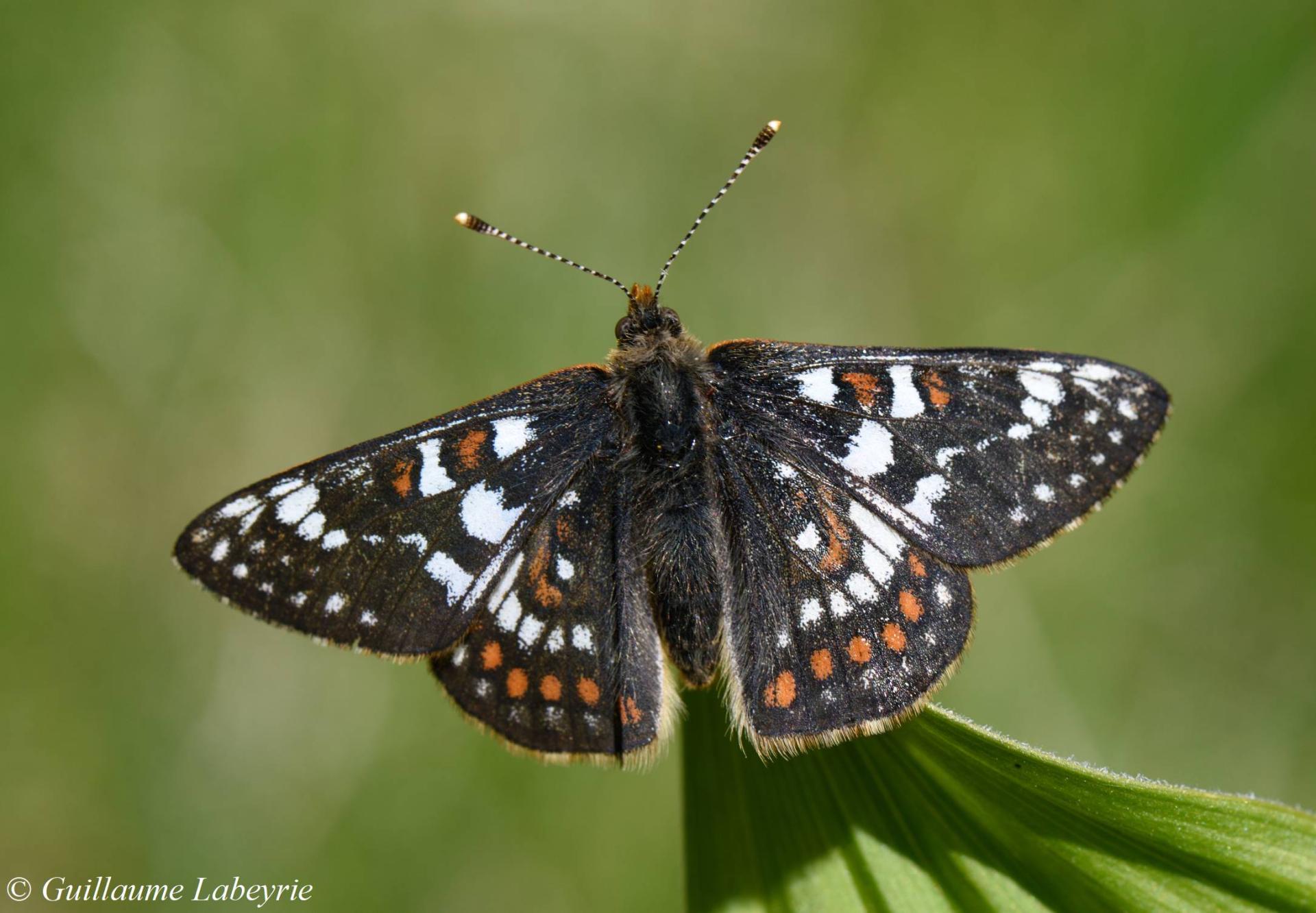
Cynthia's fritillary (Euphydryas cynthia). This nice fritillary is found in alpine grasslands, usually above 2200 m of altitude. This species exhibits very strong sexual dimorphism, as the male (depicted in this photo) sports a striking pattern of white and orange spots on a black background, while the female exhibits the usual orange and black checkerboard pattern. This species occurs in the Alps.
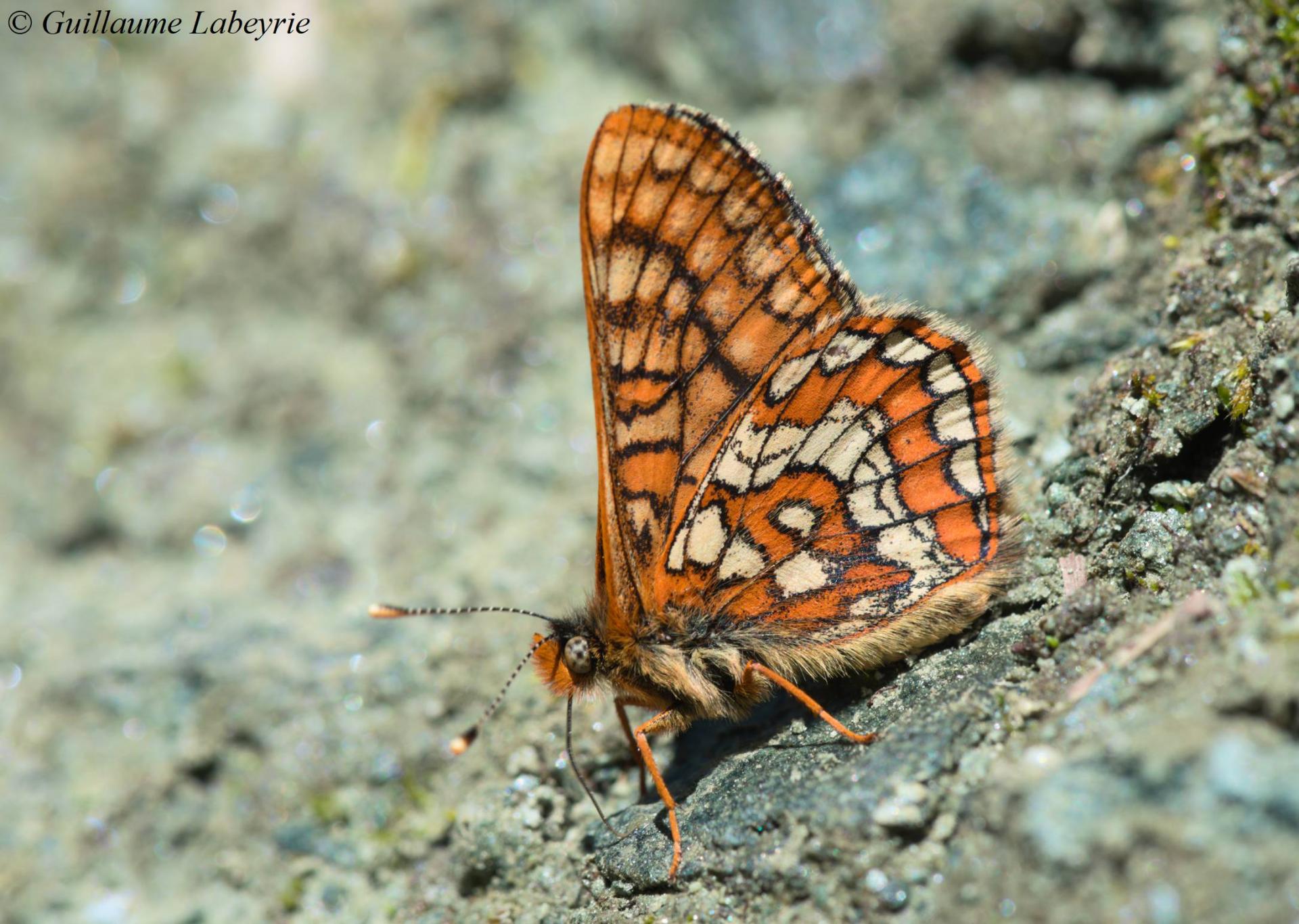 Euphydryas intermedia. This butterfly with contrasted colors resembles the scarce fritillary (Euphydryas maturna), but lives in a very different biotope: clearings on slopes with groves of green alder, around 1800 m altitude. Its caterpillar feeds on blue honeysuckle (Lonicera caerulea). This butterfly is found in Europe in the Alps, as well as in Siberia. In France, it is mainly found in the Northern Alps. Only one locality is known in the PACA region. It appears on the national red list under the mention ''vulnerable''.
Euphydryas intermedia. This butterfly with contrasted colors resembles the scarce fritillary (Euphydryas maturna), but lives in a very different biotope: clearings on slopes with groves of green alder, around 1800 m altitude. Its caterpillar feeds on blue honeysuckle (Lonicera caerulea). This butterfly is found in Europe in the Alps, as well as in Siberia. In France, it is mainly found in the Northern Alps. Only one locality is known in the PACA region. It appears on the national red list under the mention ''vulnerable''.
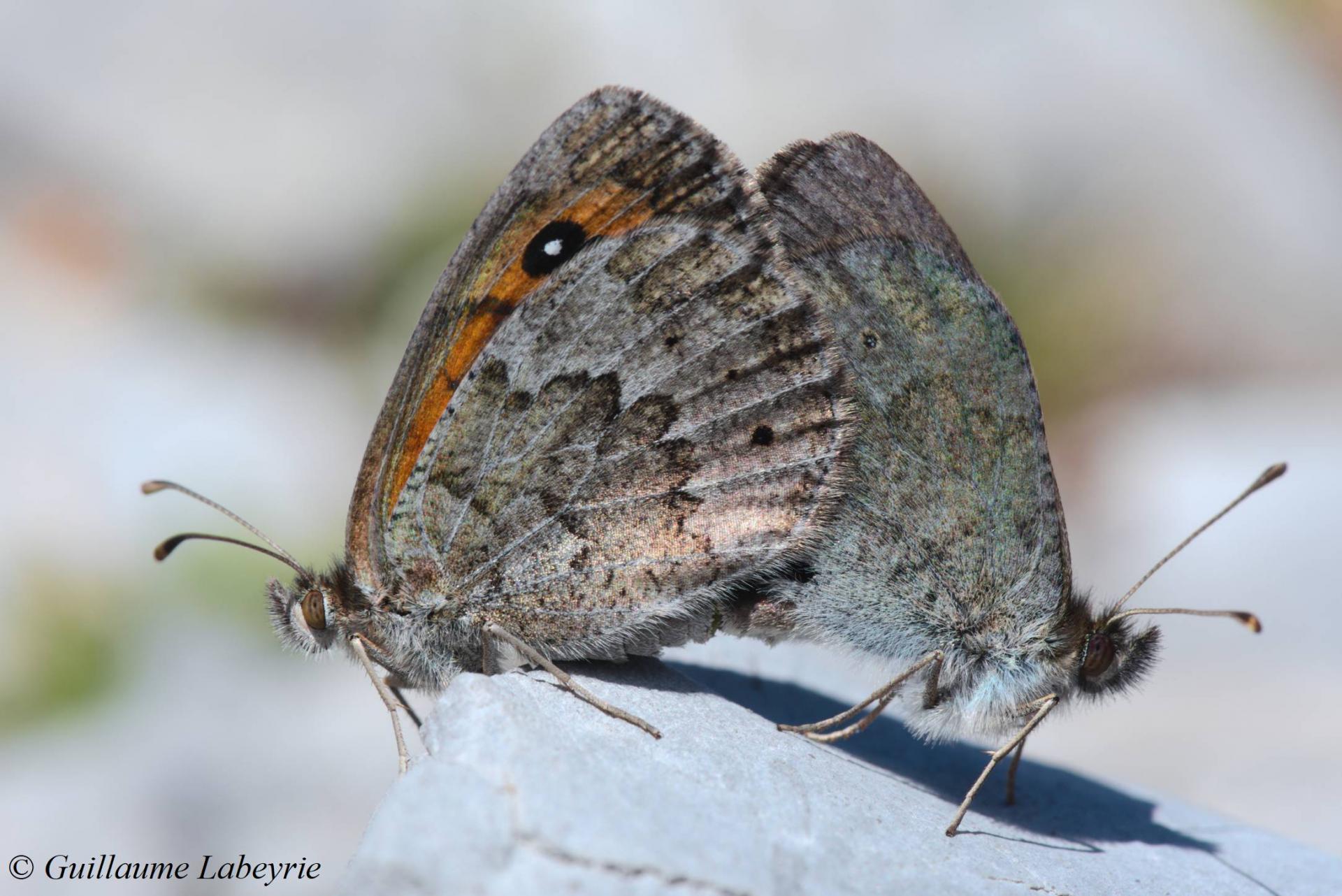 The common brassy ringlet (Erebia arvernensis). This butterfly is one of the 17 species of ringlets present in PACA. As often in the genus Erebia, it shows coppery reflections on uper side of the wings. It flies over dry alpine grasslands, with an optimum around an altitude of 2200 m. Distributed from northern Spain to the Balkans, it is found in France in the Pyrenees and the Alps.
The common brassy ringlet (Erebia arvernensis). This butterfly is one of the 17 species of ringlets present in PACA. As often in the genus Erebia, it shows coppery reflections on uper side of the wings. It flies over dry alpine grasslands, with an optimum around an altitude of 2200 m. Distributed from northern Spain to the Balkans, it is found in France in the Pyrenees and the Alps.
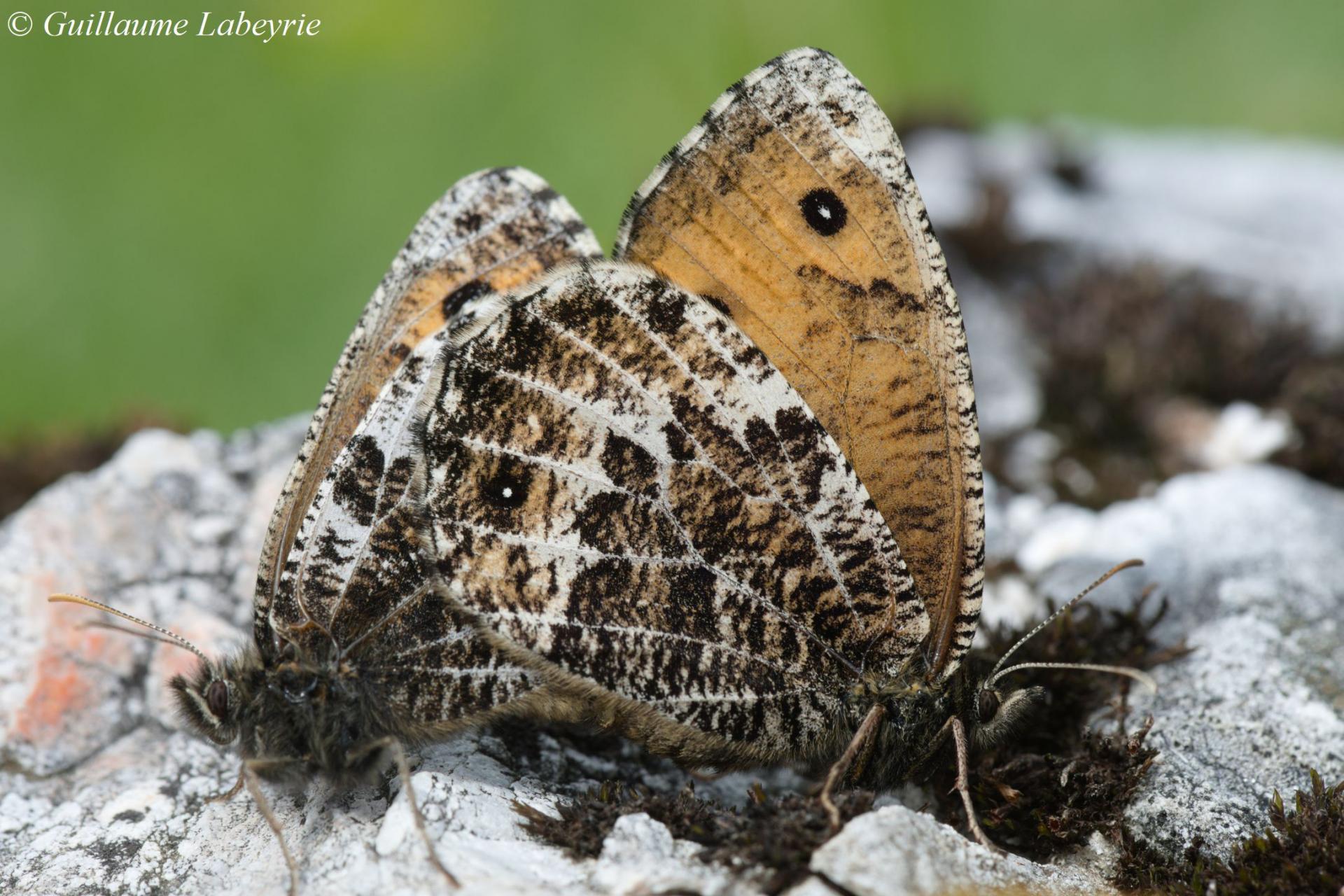 The alpine grayling (Oeneis glacialis). This scarce Satyrinae can be recognized in particular to the white veins on the underside of the hindwings. It frequents steep rocky grasslands around 2200 m of altitude. It frequently lands on the ground to warm up in the sun. It is endemic to the Alps.
The alpine grayling (Oeneis glacialis). This scarce Satyrinae can be recognized in particular to the white veins on the underside of the hindwings. It frequents steep rocky grasslands around 2200 m of altitude. It frequently lands on the ground to warm up in the sun. It is endemic to the Alps.
Family : Papilionidae
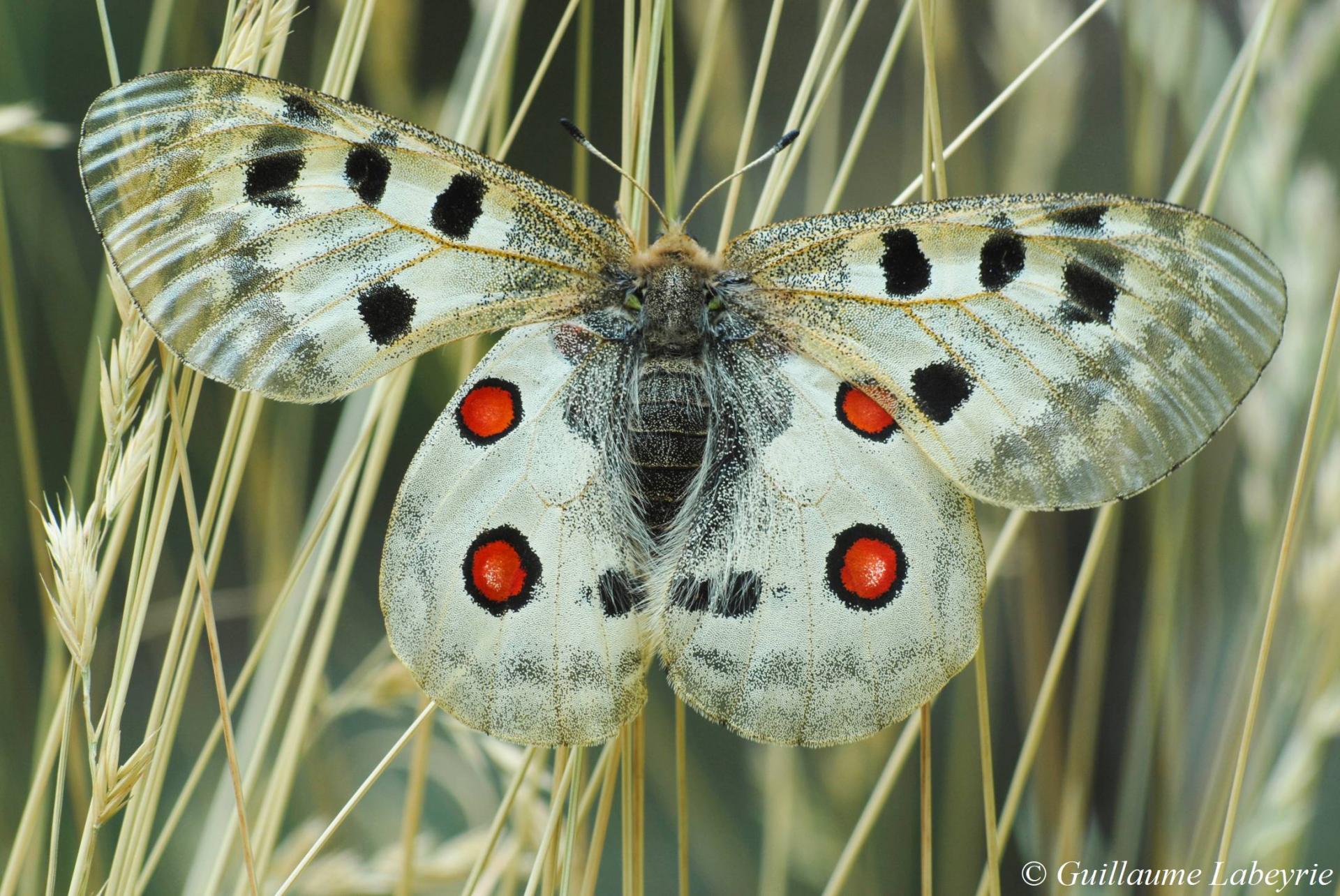 The mountain Apollo (Parnassius apollo). This mountain butterfly is one of the largest diurnal butterflies in Europe. It is found above 1000 m on dry rocky slopes and scree. Its caterpillar consumes various species of stonecrop (Sedum sp.). This butterfly has a very wide worldwide distribution, from Europe to Asia. In France, where it is threatened in several regions, it is fully protected.
The mountain Apollo (Parnassius apollo). This mountain butterfly is one of the largest diurnal butterflies in Europe. It is found above 1000 m on dry rocky slopes and scree. Its caterpillar consumes various species of stonecrop (Sedum sp.). This butterfly has a very wide worldwide distribution, from Europe to Asia. In France, where it is threatened in several regions, it is fully protected.
Family : Pieridae
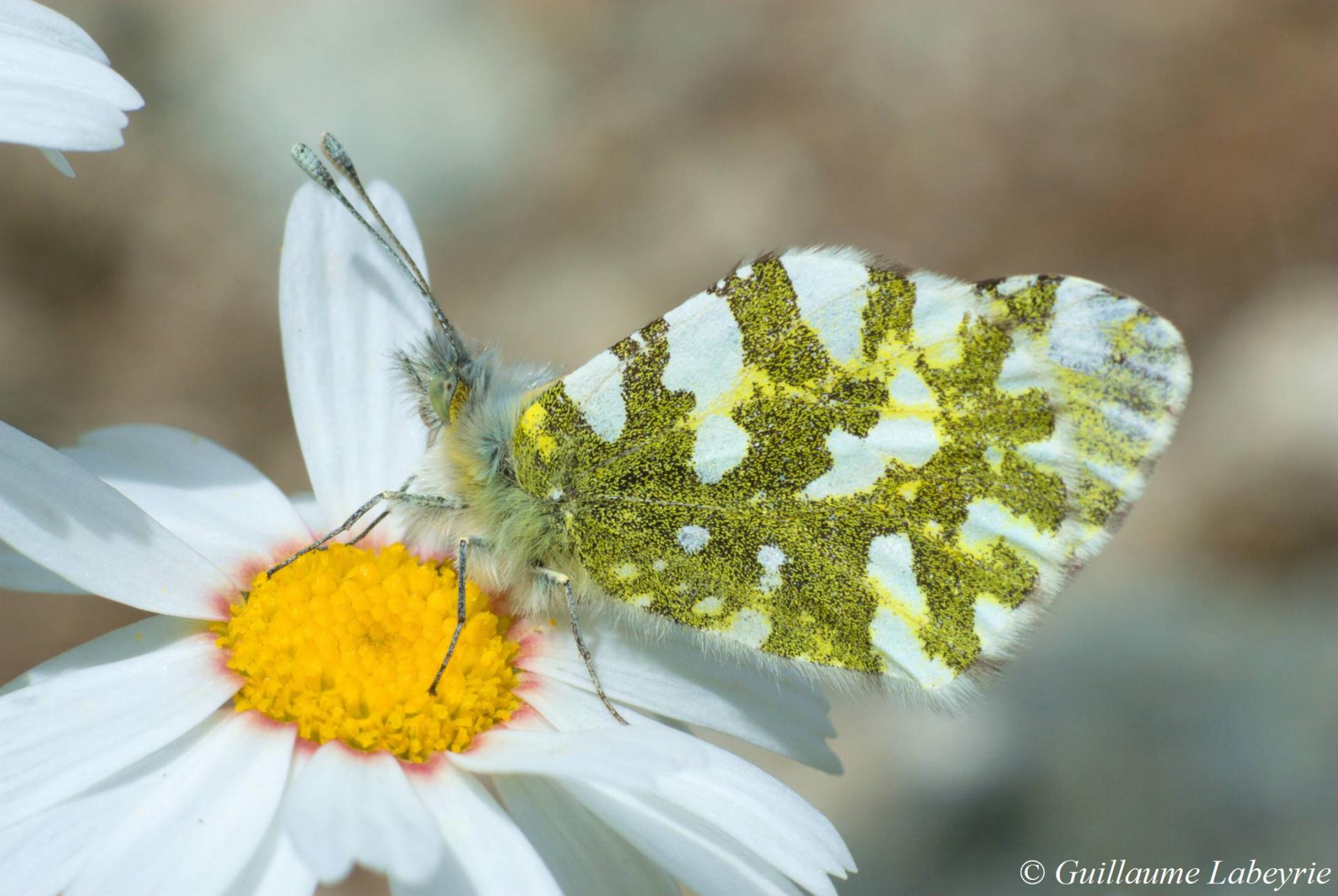 The mountain dappled white (Euchloe simplonia). This white butterfly flies in alpine grasslands, typically above 1500 m of altitude. A closely related species, the western dappled white (Euchloe crameri), is found at low altitude. The mountain dappled white is distributed in the Alps, the Pyrenees and the Cantabrian Mountains (Spain).
The mountain dappled white (Euchloe simplonia). This white butterfly flies in alpine grasslands, typically above 1500 m of altitude. A closely related species, the western dappled white (Euchloe crameri), is found at low altitude. The mountain dappled white is distributed in the Alps, the Pyrenees and the Cantabrian Mountains (Spain).
Family : Crambidae
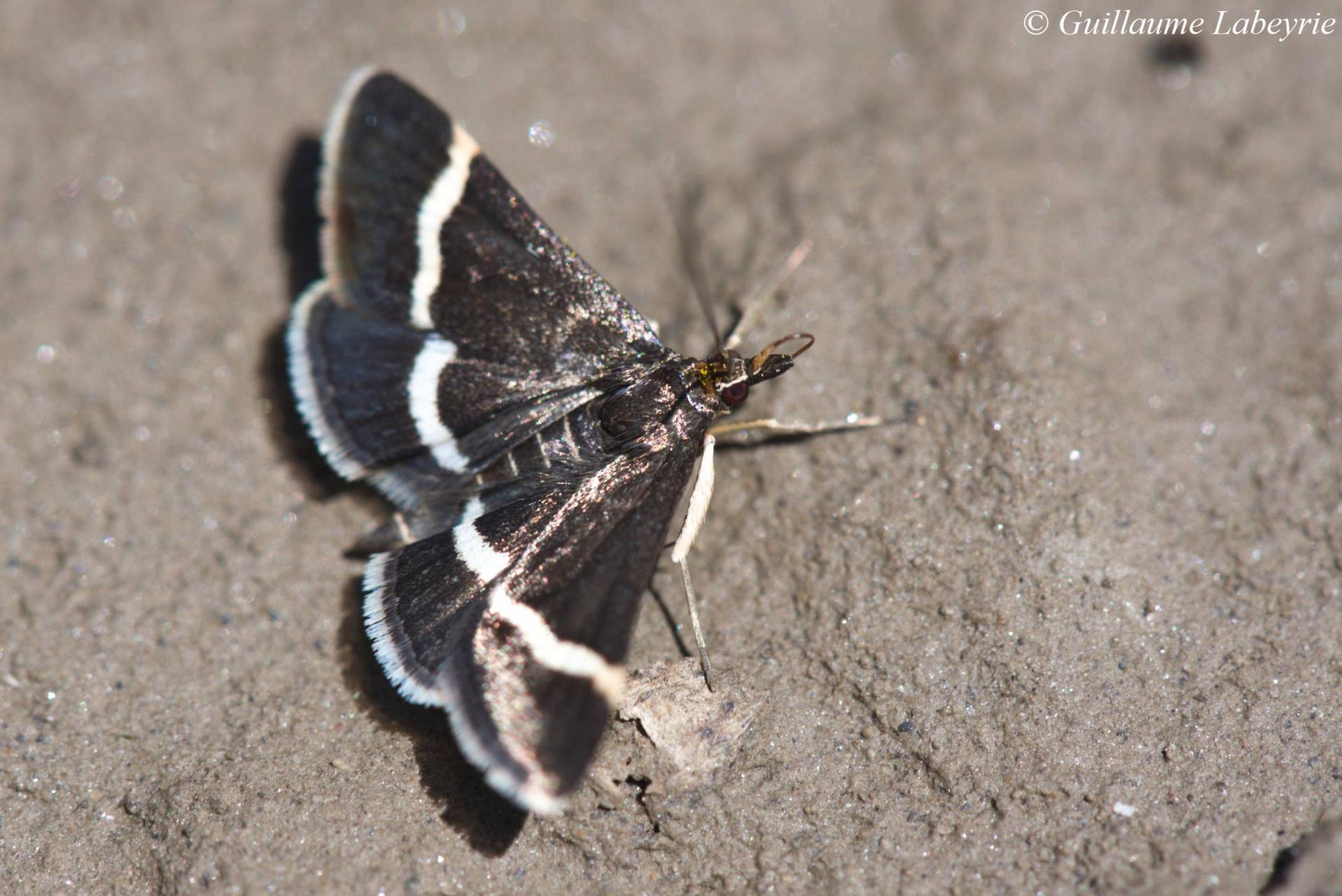
The silver-barred sable (Pyrausta cingulata). This pretty little butterfly is drinking on the mud of a mountain lake. In the PACA region, it is mainly observed in the Alpine arc.
Family : Erebidae
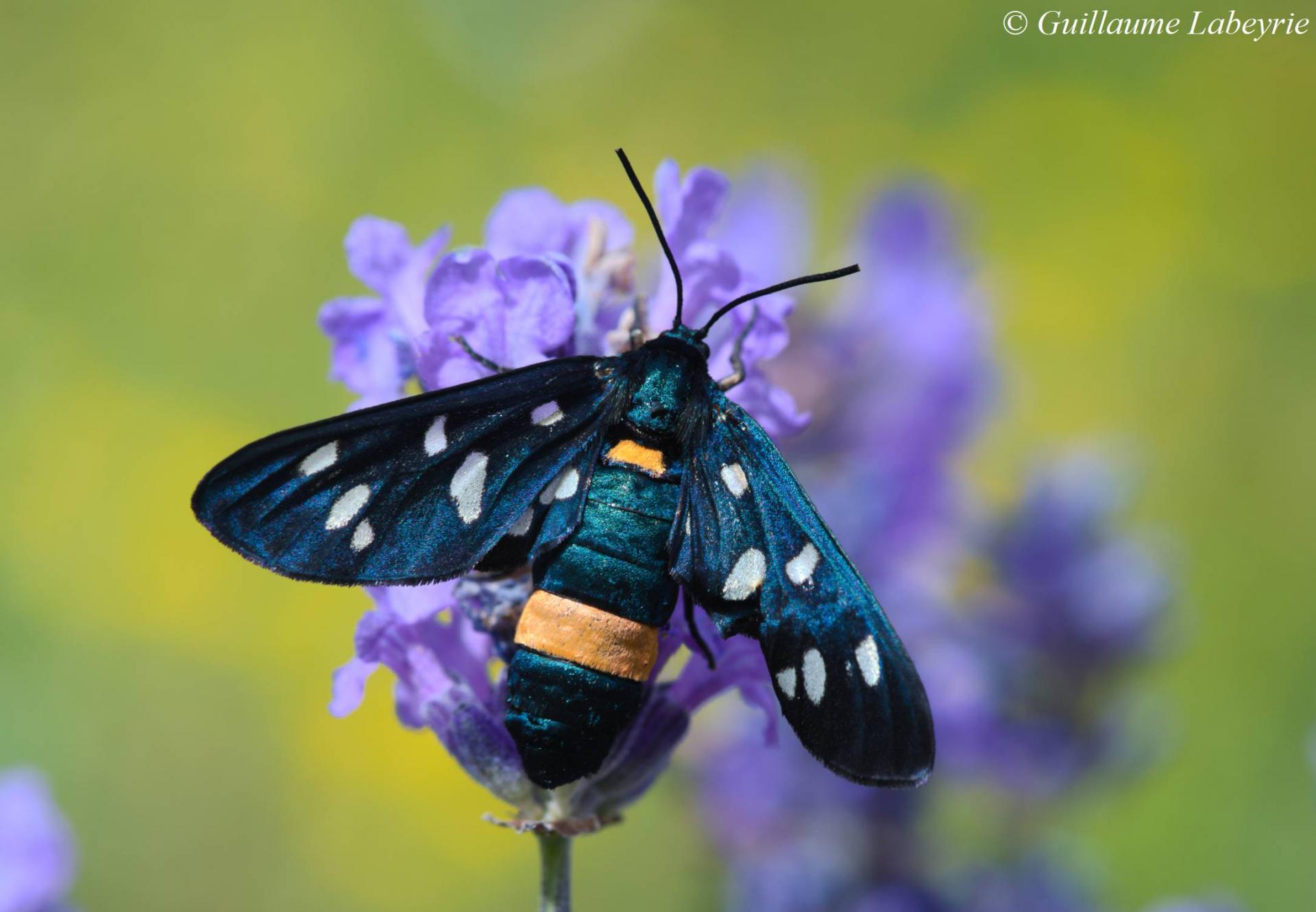
The nine-spotted moth (Amata phegea). This small moth is reminiscent of a burnet by its morphology. Another close species, Amata marjana, which seems absent from the Alpes-Maritimes, can be differentiated by details of the ornamentation of the wings. The nine-spotted moth is found on rocky dry slopes and scree, around an altitude of 1200-1400 m. It is present from Spain to Turkey and Ukraine. In France, it is restricted to the south of the Alps.
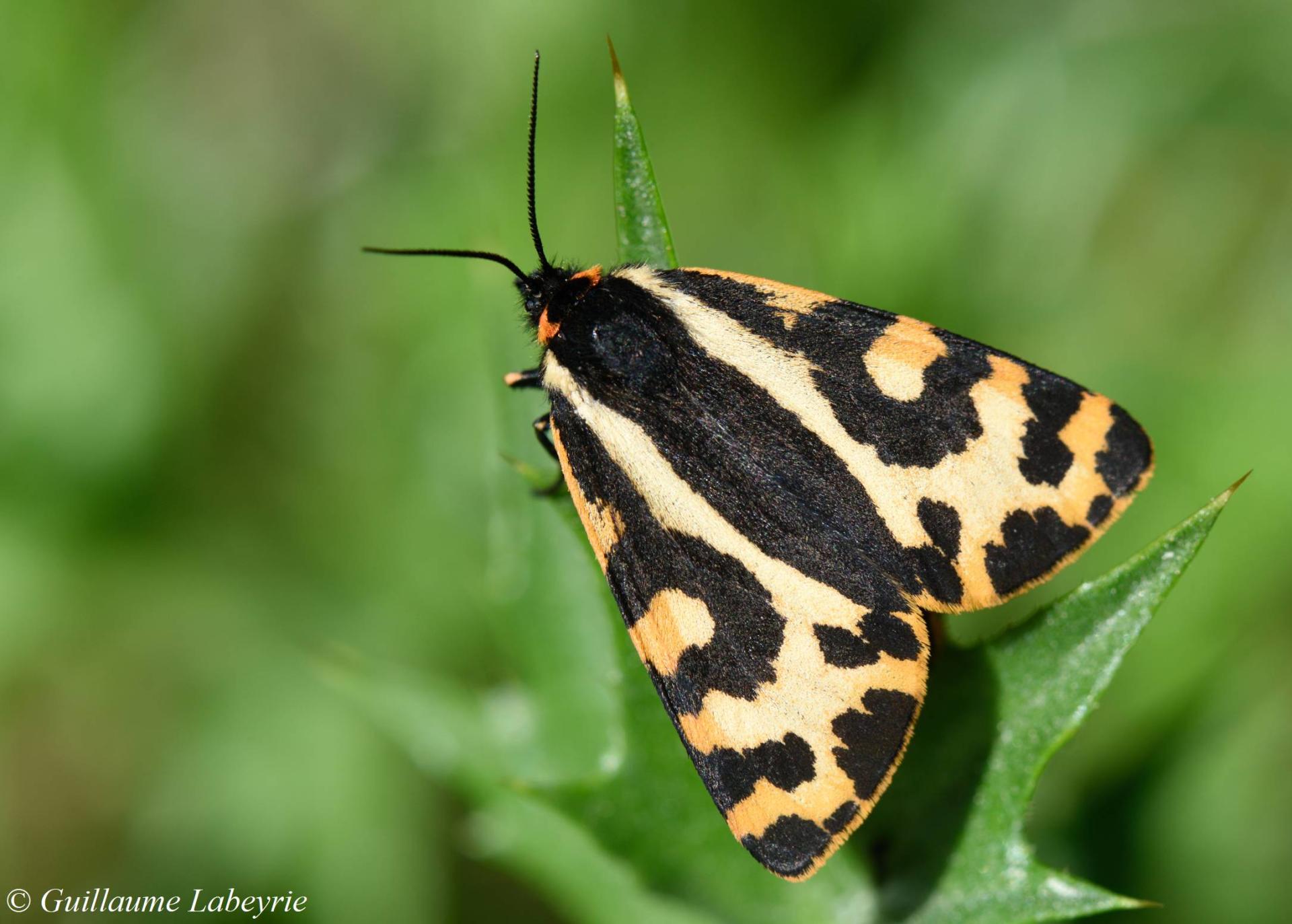
The wood tiger (Arctia plantaginis). This moth is found in the mountains, in the eastern half of France. It has an extensive global distribution, across Europe, Russia and North America.
Family : Sphingidae
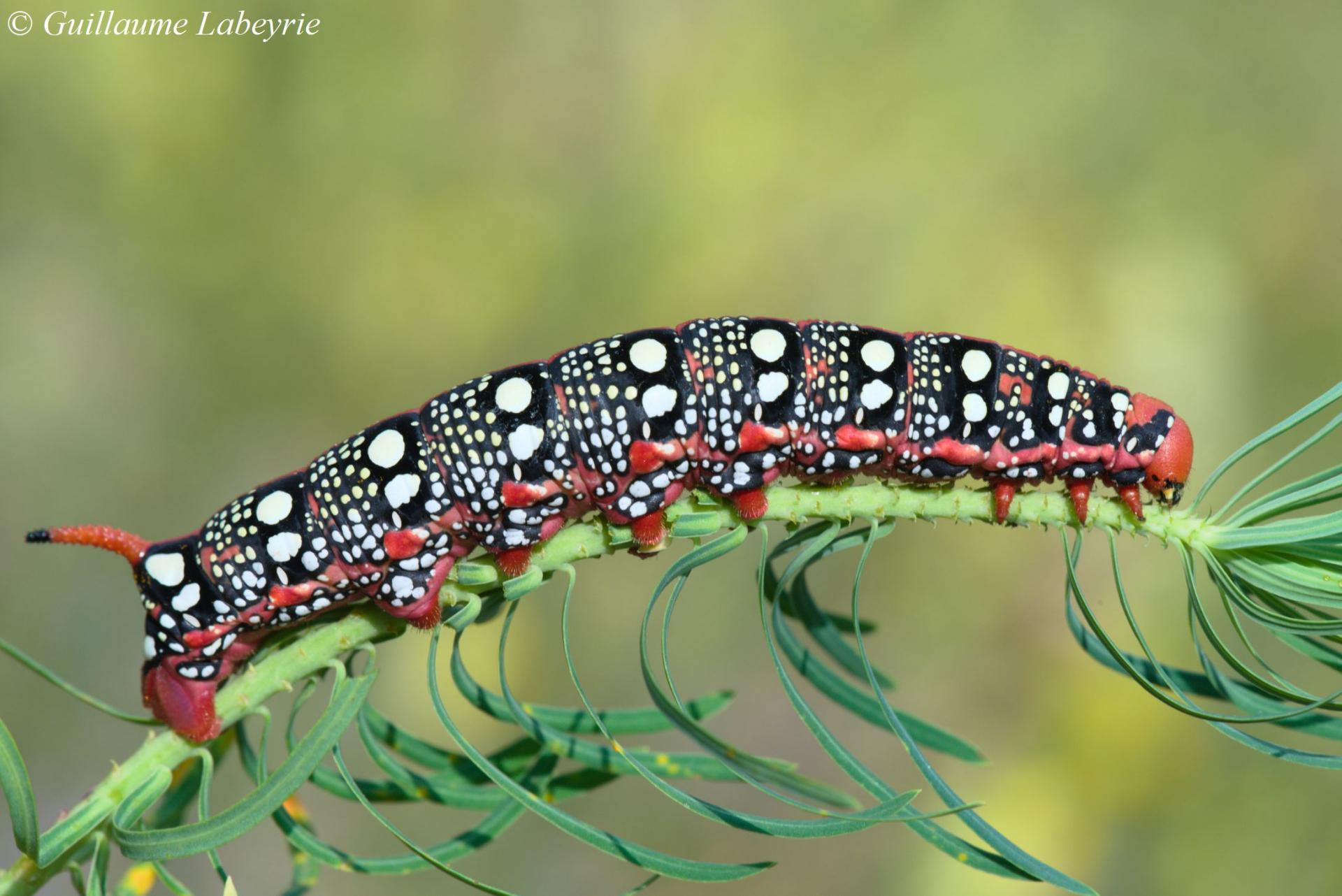 The caterpillar of the spurge hawk-moth (Hyles euphorbiae). This striking caterpillar is found on dry, sunny mountain slopes where its host plant, the cypress spurge (Euphorbia cyparissias), grows. Its bright colors warn potential predators of its toxicity. The spurge hawk-moth is found from southern Europe to central Asia. It is found in France in a large part of the territory.
The caterpillar of the spurge hawk-moth (Hyles euphorbiae). This striking caterpillar is found on dry, sunny mountain slopes where its host plant, the cypress spurge (Euphorbia cyparissias), grows. Its bright colors warn potential predators of its toxicity. The spurge hawk-moth is found from southern Europe to central Asia. It is found in France in a large part of the territory.
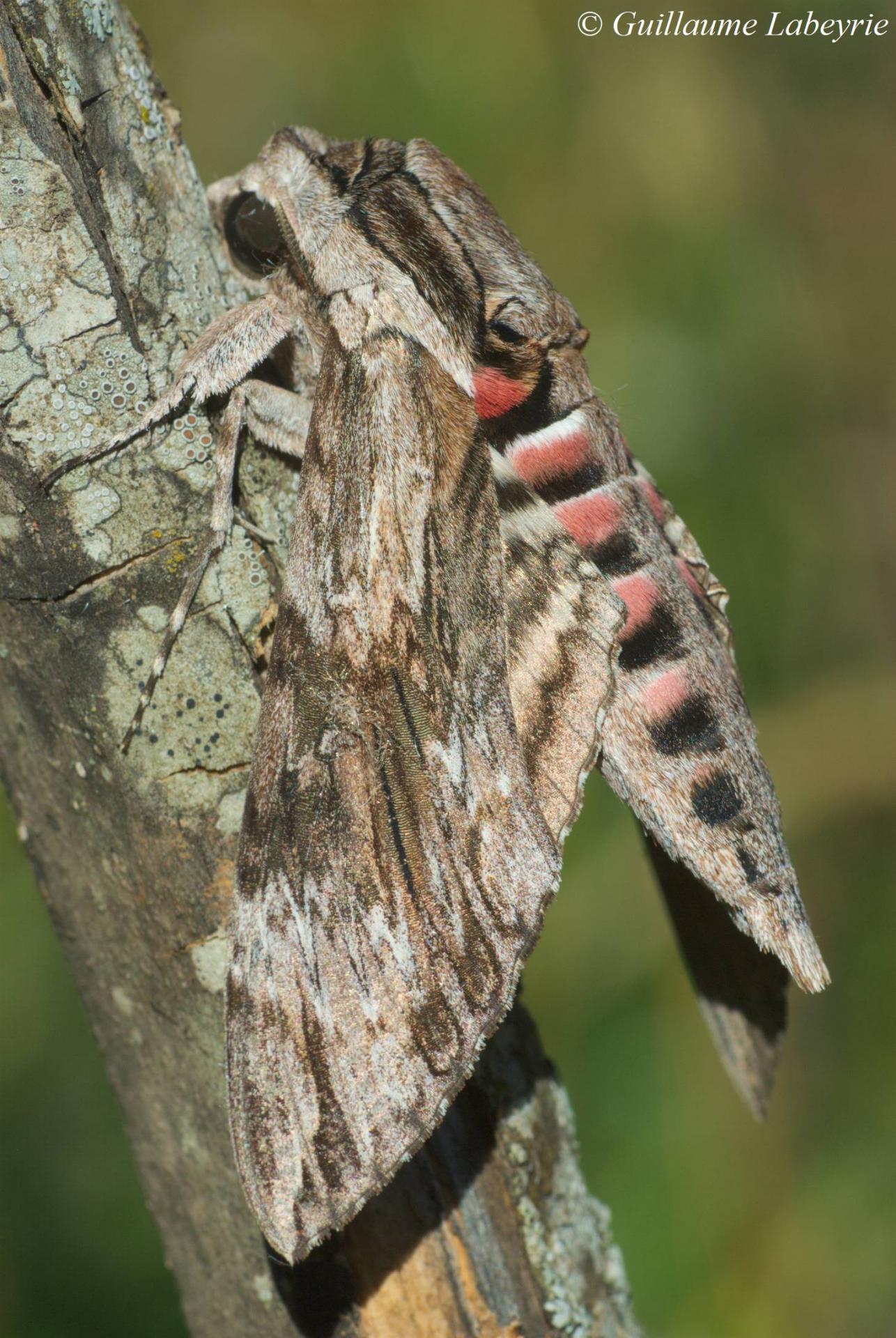 The convolvulus hawk-moth (Agrius convolvuli). This large hawk-moth can sometimes be seen at dusk, gathering nectar from the flowers in full flight. Although in regression, it is still quite often encountered in the villages of the mountain valleys. Disturbed, it exposes its pink-striped abdomen to scare away predators, as in this photo. This species, which has a very wide global distribution, is migratory in most of Europe. It is observed almost everywhere in France.
The convolvulus hawk-moth (Agrius convolvuli). This large hawk-moth can sometimes be seen at dusk, gathering nectar from the flowers in full flight. Although in regression, it is still quite often encountered in the villages of the mountain valleys. Disturbed, it exposes its pink-striped abdomen to scare away predators, as in this photo. This species, which has a very wide global distribution, is migratory in most of Europe. It is observed almost everywhere in France.
Family : Zygaenidae
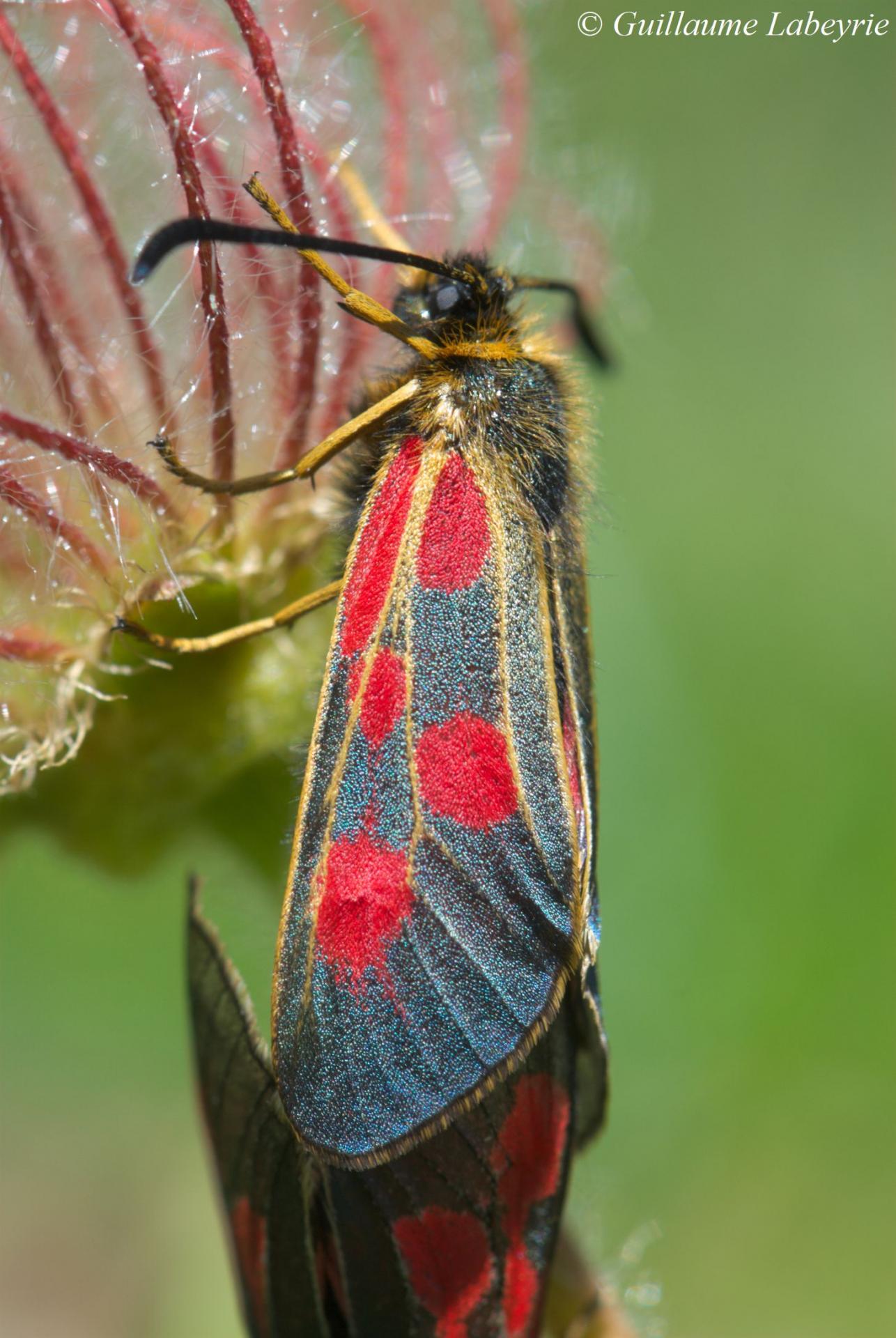 The mountain burnet (Zygaena exulans). It is our only frankly alpine burnet, which can reach 3700 m of altitude in the Alps. Its optimum is around 2400 m. In cool weather, it presents a characteristic flight at ground level, where it lands as soon as the sun hides. This species is found in the Pyrenees, the Alps, Scandinavia, as well as in Russia and Mongolia.
The mountain burnet (Zygaena exulans). It is our only frankly alpine burnet, which can reach 3700 m of altitude in the Alps. Its optimum is around 2400 m. In cool weather, it presents a characteristic flight at ground level, where it lands as soon as the sun hides. This species is found in the Pyrenees, the Alps, Scandinavia, as well as in Russia and Mongolia.
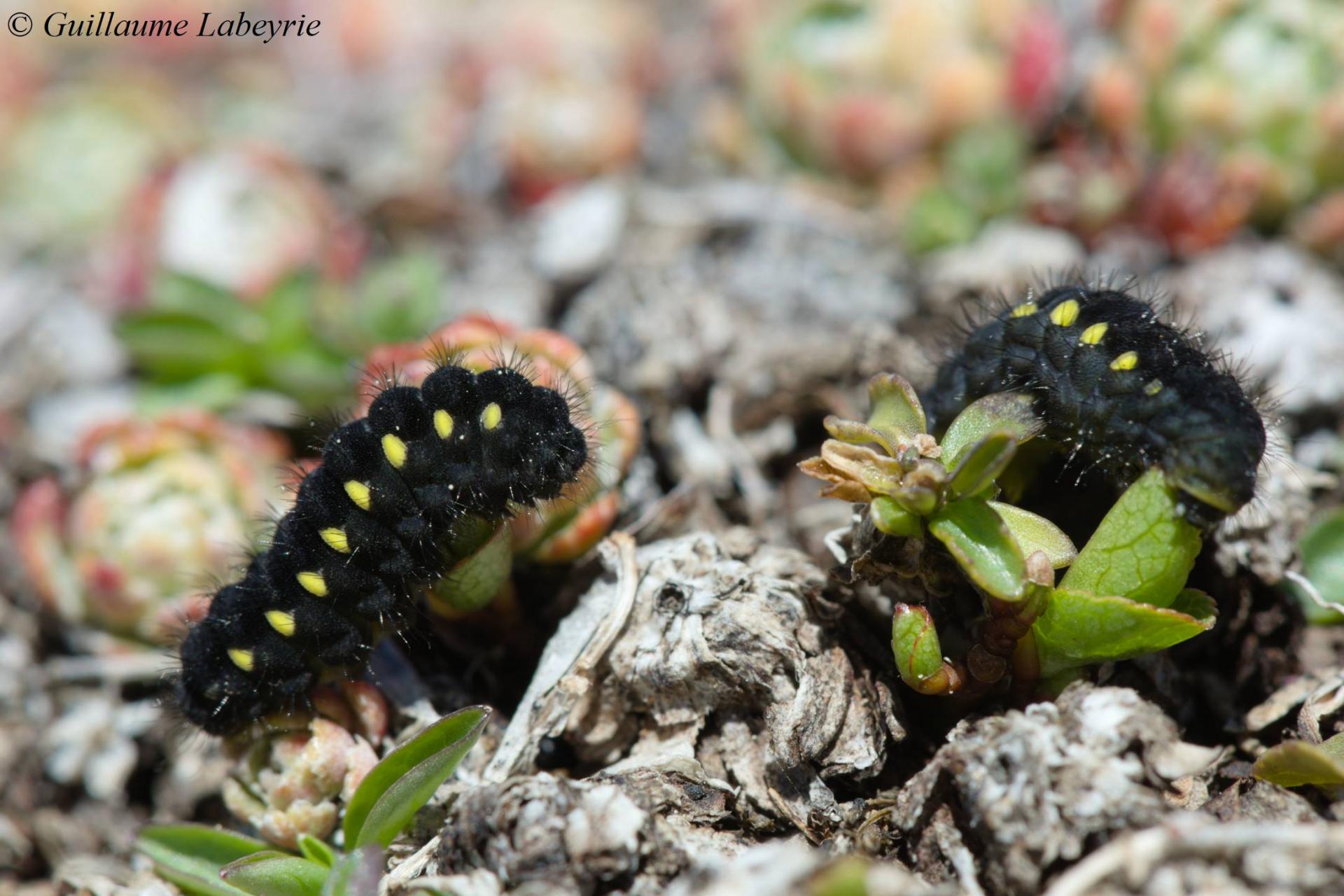 Caterpillars of the mountain burnet (Zygaena exulans). These polyphagous caterpillars are often active just after the snow has melted.
Caterpillars of the mountain burnet (Zygaena exulans). These polyphagous caterpillars are often active just after the snow has melted.
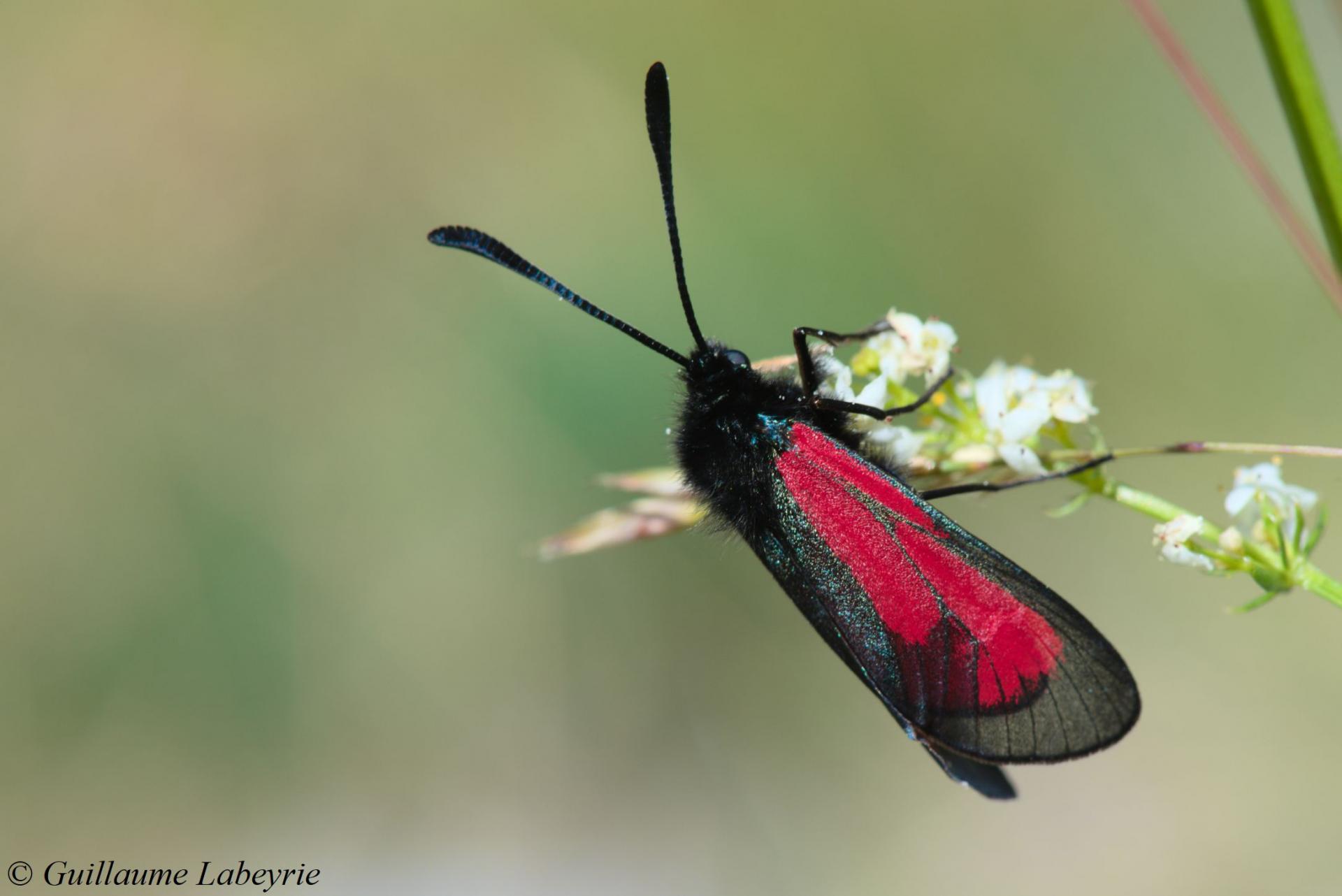
Zygaena purpuralis / Zygaena minos. These two species, indistinguishable without examination of the genitalia, are identified by the median red stripe ending in the shape of a fan (which differentiates them from the Vésubie burnet Z. brizae). In the Alpes-Maritimes, it seems that Z. purpuralis is much more widespread and is often found at higher altitude than Z. minos (optimum at 1800 m against 1000 m). In France, these two species are mainly present in the eastern half.
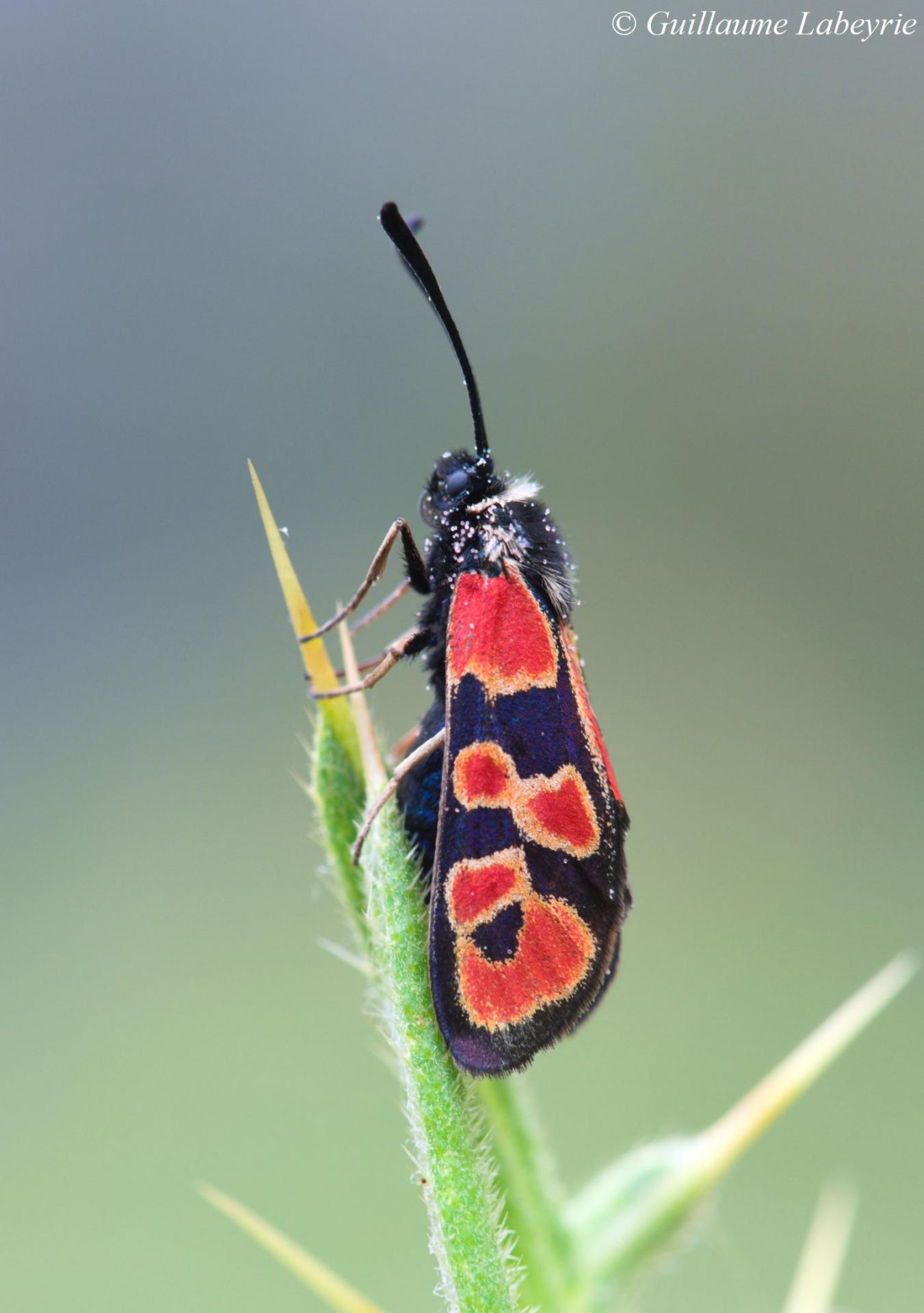
Zygaena hilaris. This beautiful burnet can be distinguished by its narrow white collar and its wings with joined red spots, circled in orange. It is found in low mountains with an optimum around 1000 m, on limestone slopes. It is relatively uncommon. The ononidis subspecies found around Cannes is critically endangered. Present from the Iberian Peninsula to Liguria, this moth is found in France mainly in the South-East.
Odonata
Family : Aeshnidae
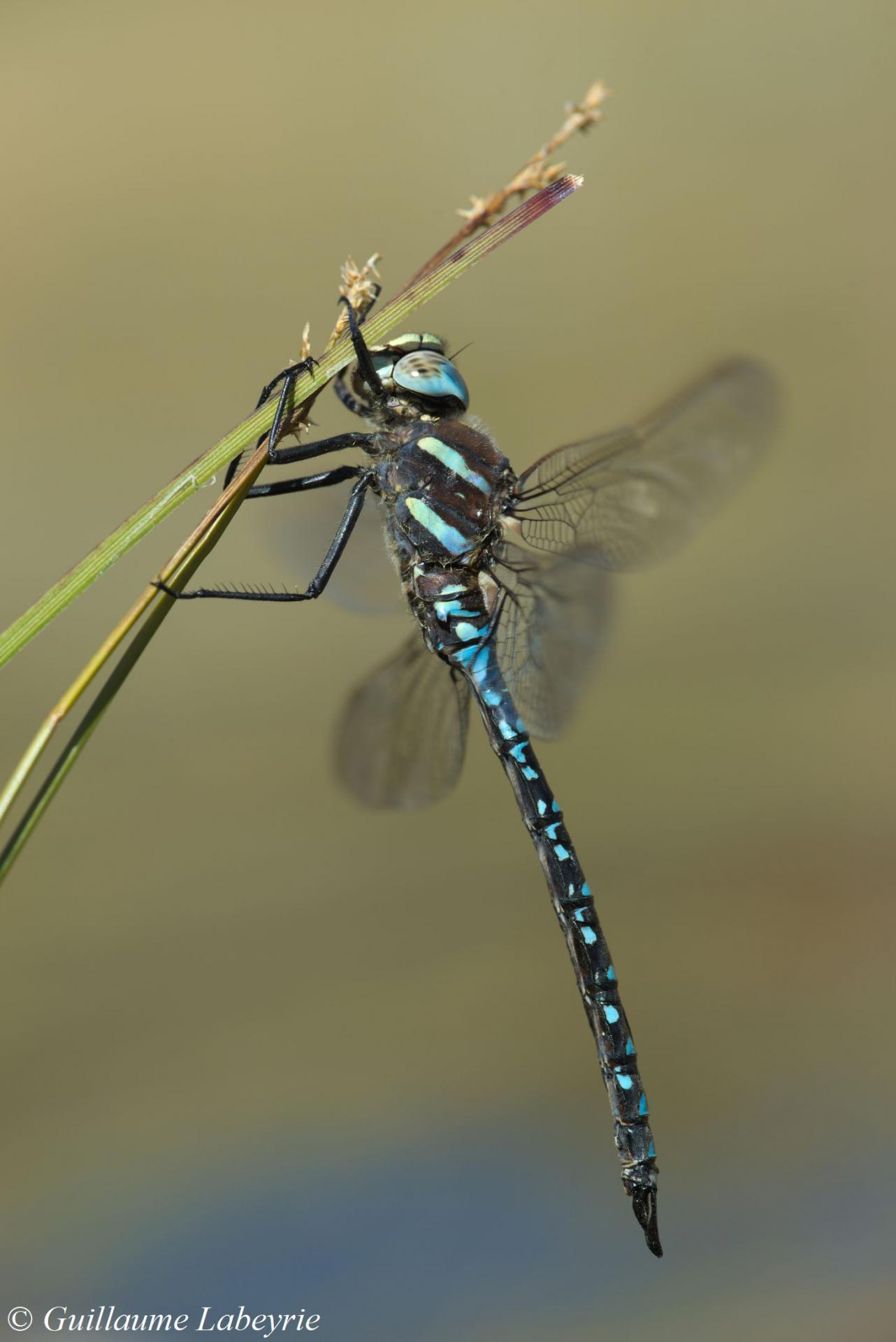
The common hawker (Aeshna juncea). This large dragonfly is found in our region in the mountains, in shallow alpine lakes and bogs, up to an altitude of 2500 m. The two blue bands on the thorax are characteristic. Its worldwide distribution includes Central and Northern Europe, Asia and North America. In France, it is found in the south-eastern half of the country.
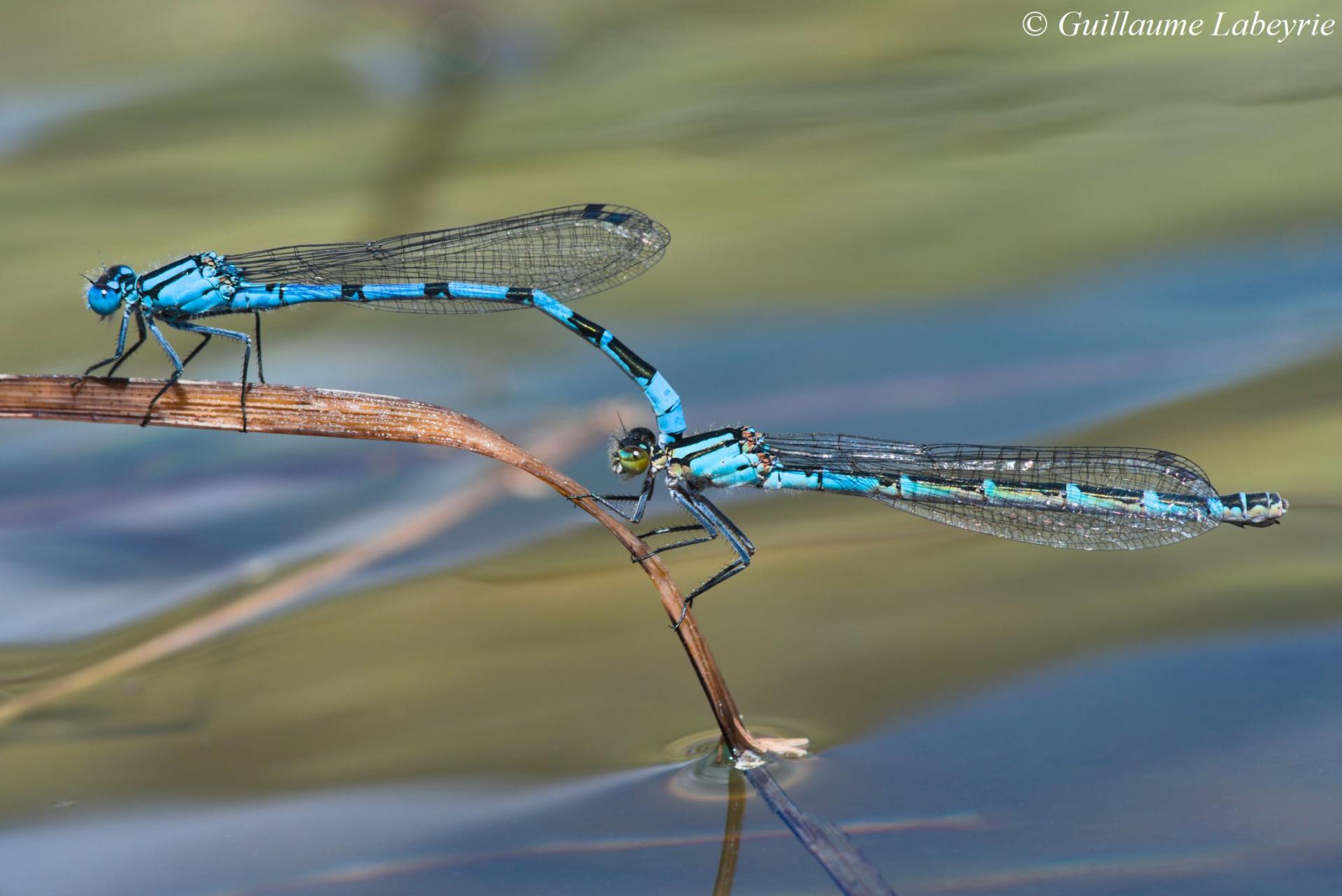 The common blue damselfly (Enallagma cyathigerum). This bright blue little damselfly owes its name to the black pattern on the back of the second abdominal segment in the male. In the South of France, it is mostly found in the mountains, up to an altitude of 2500 m. It has a vast worldwide distribution and is present everywhere in France (rare in Corsica).
The common blue damselfly (Enallagma cyathigerum). This bright blue little damselfly owes its name to the black pattern on the back of the second abdominal segment in the male. In the South of France, it is mostly found in the mountains, up to an altitude of 2500 m. It has a vast worldwide distribution and is present everywhere in France (rare in Corsica).
Orthoptera
The southern Alps are home to a large number of species of Orthoptera, some of which have a very restricted distribution.
Family : Tettigoniidae
 Female Mercantour's bush-cricket (Anonconotus mercantouri). The genus Anonconotus includes in our region several species of alpine bush-crickets difficult to identify. Anonconotus mercantouri is distinguished in particular by its very short elytra which are brownish and not yellow. It frequents rocky grasslands above 2000 m. This micro-endemic species has an extremely restricted distribution, in a few valleys of Haute-Vésubie.
Female Mercantour's bush-cricket (Anonconotus mercantouri). The genus Anonconotus includes in our region several species of alpine bush-crickets difficult to identify. Anonconotus mercantouri is distinguished in particular by its very short elytra which are brownish and not yellow. It frequents rocky grasslands above 2000 m. This micro-endemic species has an extremely restricted distribution, in a few valleys of Haute-Vésubie.
 Male Mercantour's bush-cricket (Anonconotus mercantouri). The male is much smaller and darker than the female.
Male Mercantour's bush-cricket (Anonconotus mercantouri). The male is much smaller and darker than the female.
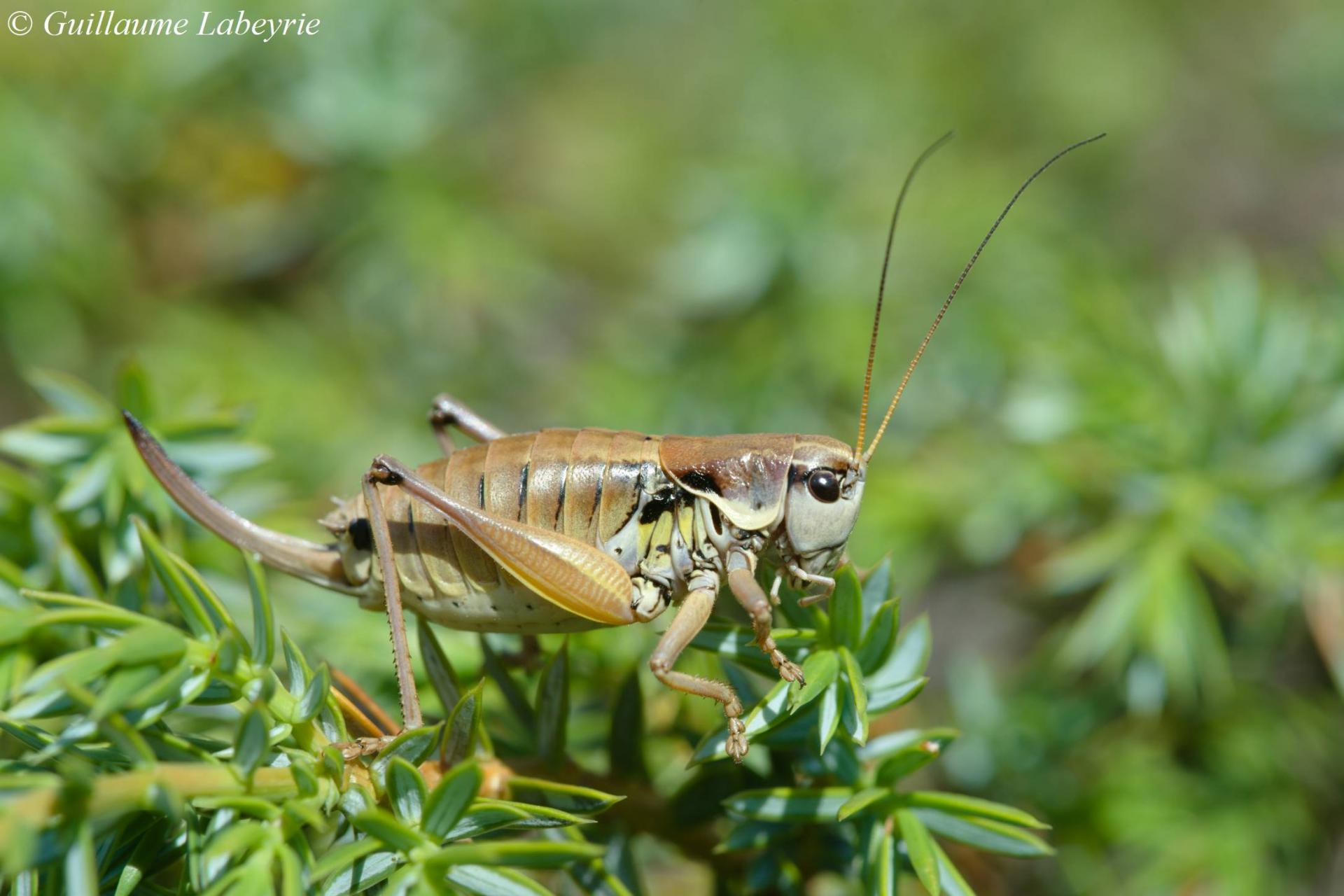 Anonconotus occidentalis. This other species is distinguished by light yellow elytra which, in females, are generally masked by the pronotum (the plate that protects the top of the thorax). The body is green or brown. This bush-cricket frequents the same habitats as the previous species. It is found only in Italy and, in France, in the Hautes-Alpes, Alpes-de-Haute-Provence and Alpes-Maritimes.
Anonconotus occidentalis. This other species is distinguished by light yellow elytra which, in females, are generally masked by the pronotum (the plate that protects the top of the thorax). The body is green or brown. This bush-cricket frequents the same habitats as the previous species. It is found only in Italy and, in France, in the Hautes-Alpes, Alpes-de-Haute-Provence and Alpes-Maritimes.
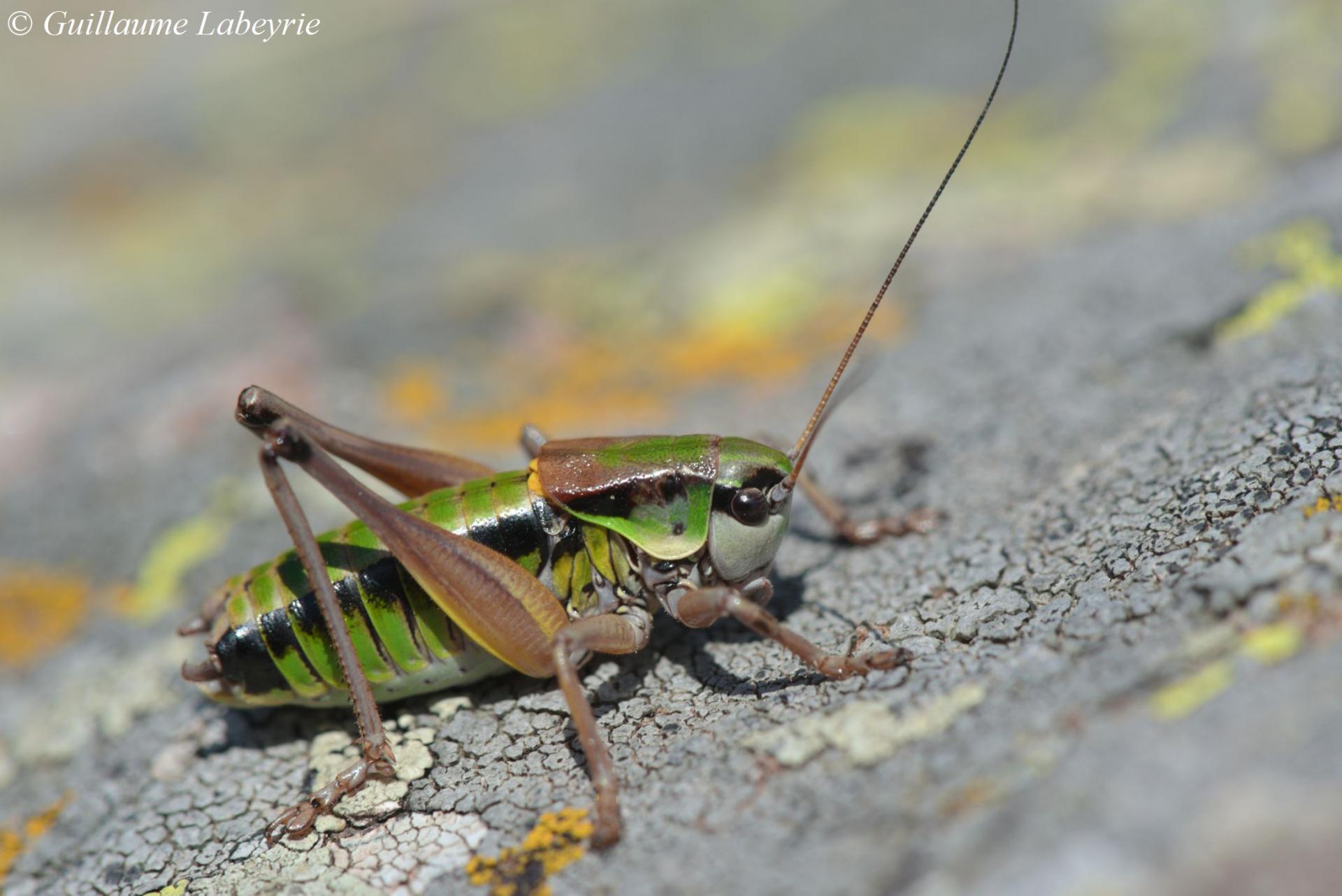 Male Anonconotus occidentalis.
Male Anonconotus occidentalis.
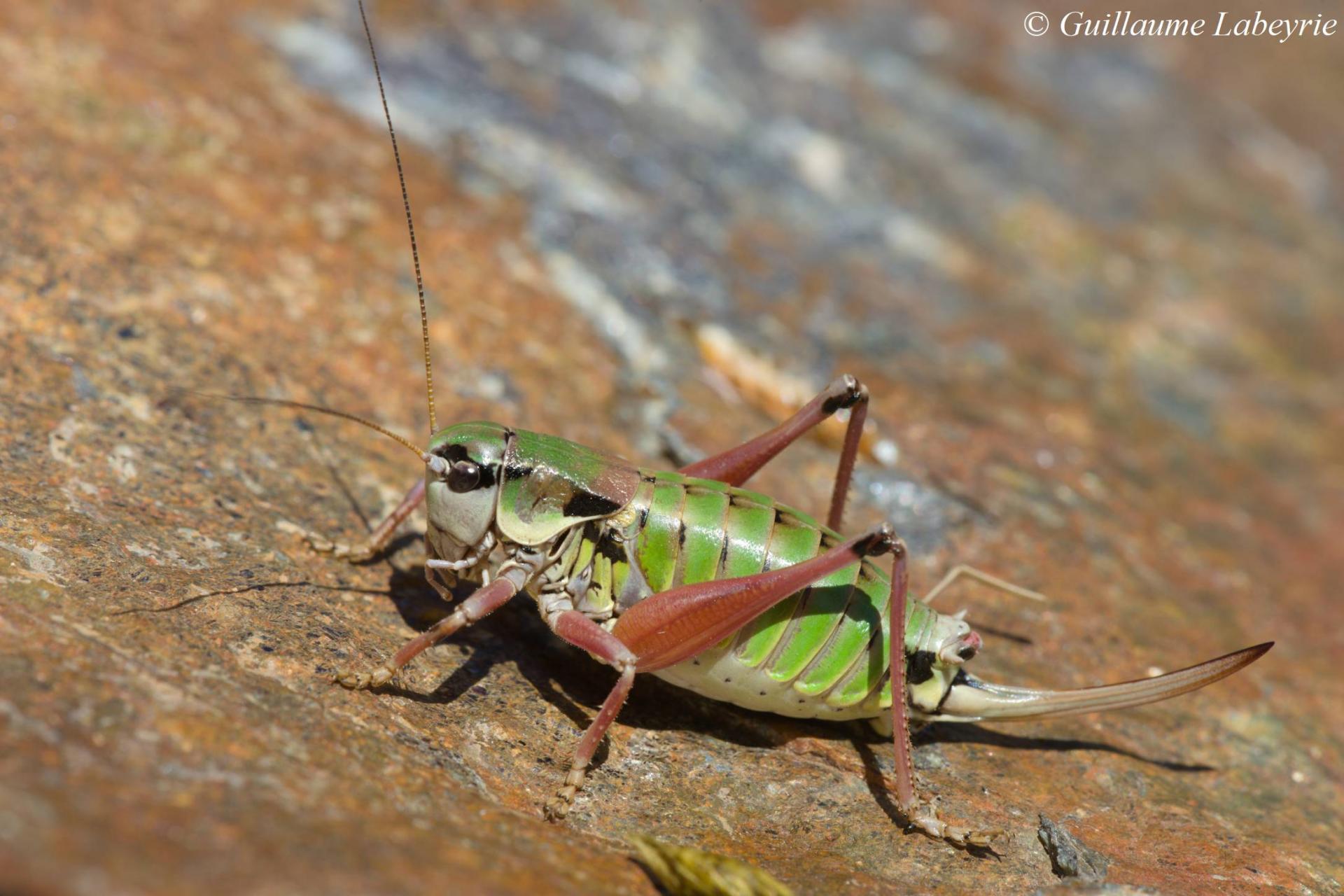 Anonconotus ligustinus. In this species, unlike the previous one, the light yellow elytra of the females are generally very short but visible. It is present only locally on both sides of the Italian border, in the Alpes-Maritimes on the French side. With a very restricted distribution, it appears on the world and European red lists under the heading ''endangered''.
Anonconotus ligustinus. In this species, unlike the previous one, the light yellow elytra of the females are generally very short but visible. It is present only locally on both sides of the Italian border, in the Alpes-Maritimes on the French side. With a very restricted distribution, it appears on the world and European red lists under the heading ''endangered''.
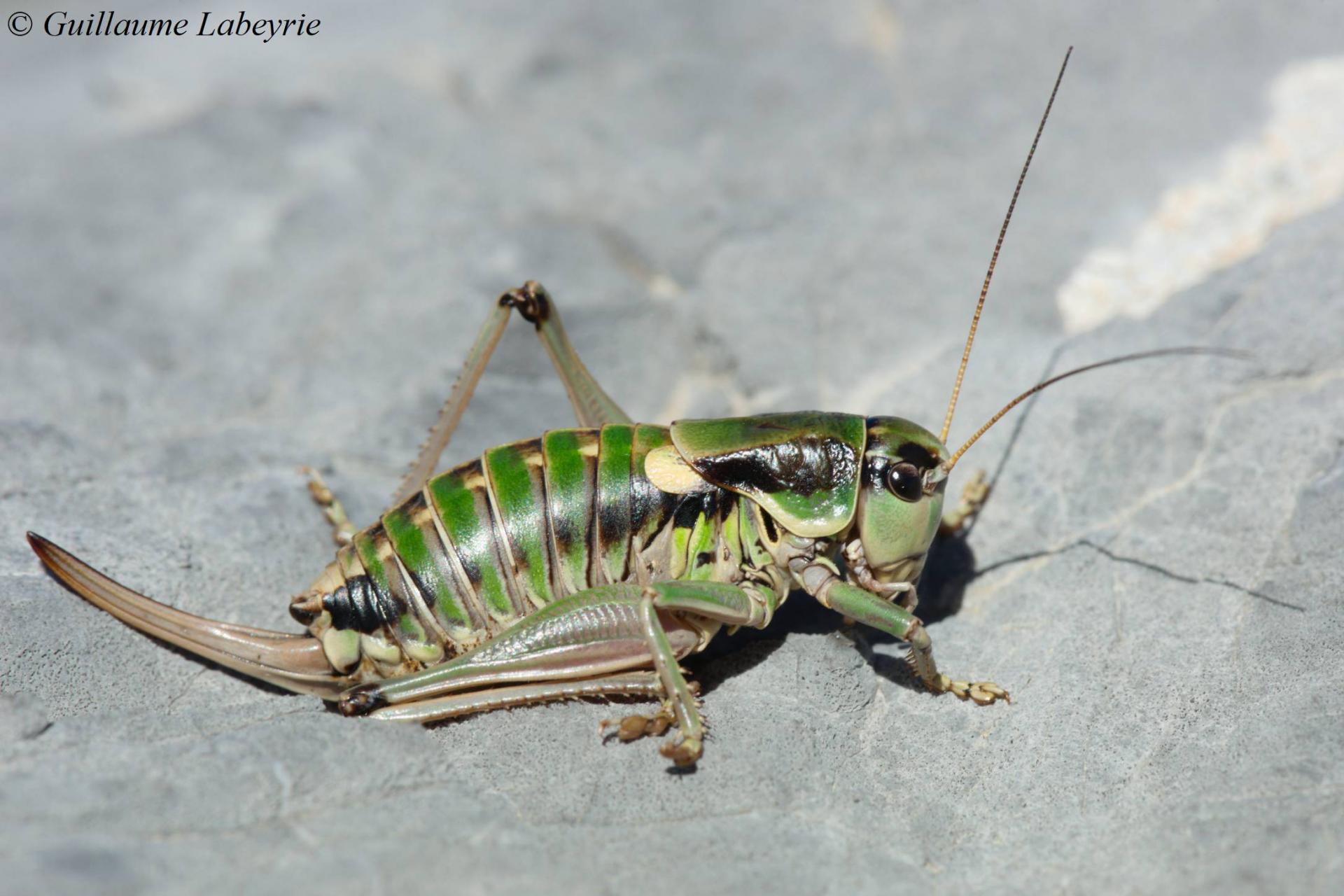 Anonconotus ghilianii. This is the fourth species of Anonconotus that can be found in the Alpes-Maritimes. It is easily distinguished by its relatively large elytra which are a very light yellow, almost white. Females are green or brown. This species is found in the Alps, in rocky grasslands above an altitude of 1600 m.
Anonconotus ghilianii. This is the fourth species of Anonconotus that can be found in the Alpes-Maritimes. It is easily distinguished by its relatively large elytra which are a very light yellow, almost white. Females are green or brown. This species is found in the Alps, in rocky grasslands above an altitude of 1600 m.
 Tettigonia cantans. This large katydid is distinguished by its green color with a dark stripe on its back. It frequents bushes and mountain meadows. Its song is particularly noisy. It is distributed from western Europe to southern Russia. It is found in France in a south-eastern half of the territory.
Tettigonia cantans. This large katydid is distinguished by its green color with a dark stripe on its back. It frequents bushes and mountain meadows. Its song is particularly noisy. It is distributed from western Europe to southern Russia. It is found in France in a south-eastern half of the territory.
Family : Acrididae
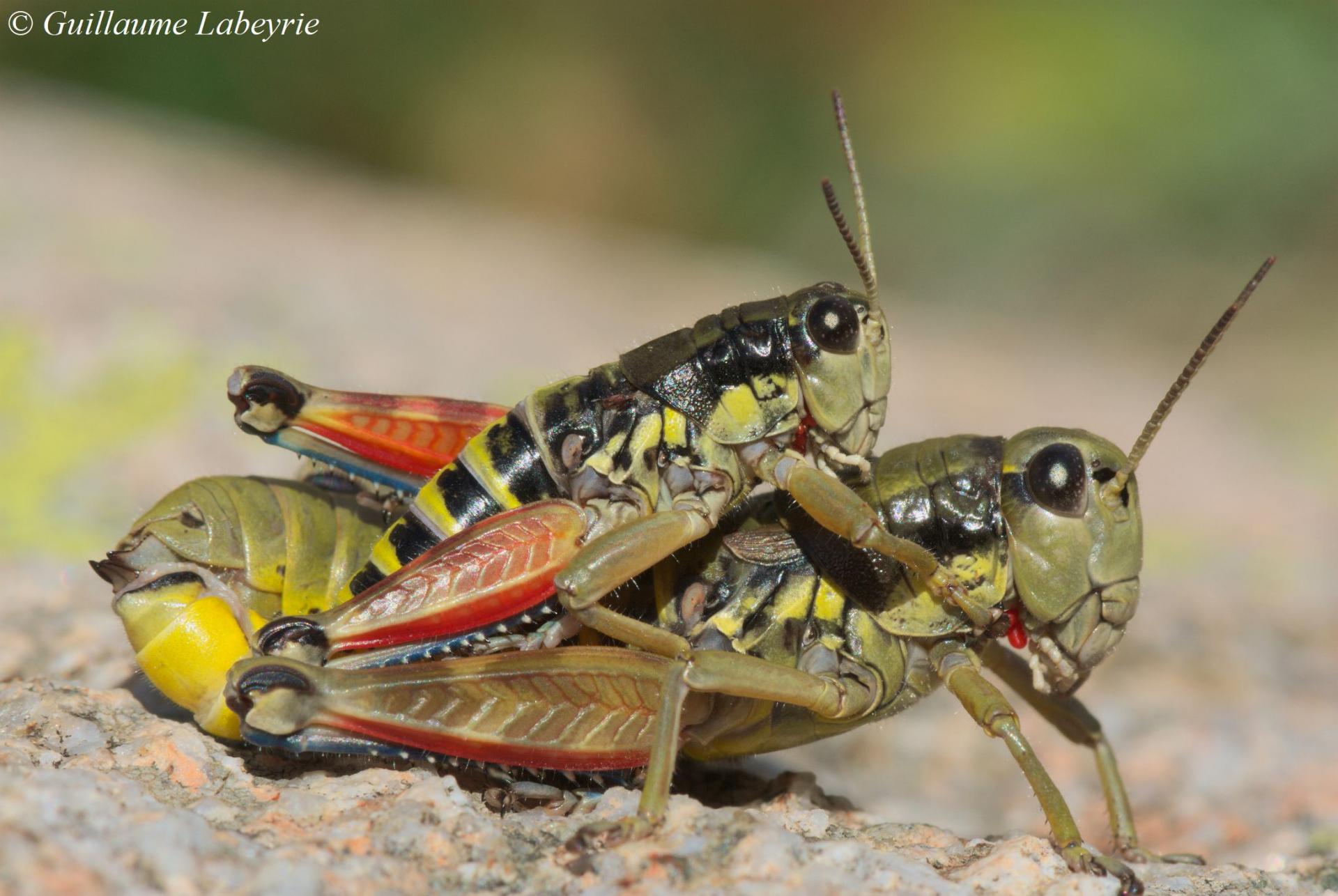 Podisma dechambrei mating. This species is distinguished from the similar Podisma pedestris by its even shorter elytra, which do not reach the edge of the second abdominal segment (tergite). A third species, Podisma amedegnatoae, also has elytra reaching to the second tergite, but females also have a pair of black spots on each tergite. With a very restricted worldwide distribution (Liguria in Italy, Hautes-Alpes, Alpes-de-Haute-Provence and Alpes-Maritimes in France), this species can however be quite abundant for instance in the Mercantour.
Podisma dechambrei mating. This species is distinguished from the similar Podisma pedestris by its even shorter elytra, which do not reach the edge of the second abdominal segment (tergite). A third species, Podisma amedegnatoae, also has elytra reaching to the second tergite, but females also have a pair of black spots on each tergite. With a very restricted worldwide distribution (Liguria in Italy, Hautes-Alpes, Alpes-de-Haute-Provence and Alpes-Maritimes in France), this species can however be quite abundant for instance in the Mercantour.
 Epipodisma pedemontana subsp. waltheri. This species is distinguished by its total absence of wings, its beautiful green color and the black band that borders its sides. The female, shown here, is stockier than the male and a little less colorful. This species is found in high altitude grasslands. Very localized, it is confined on both sides of the Franco-Italian border, from the Alpes-de-Haute-Provence to Savoie. It appears on the European red list with the mention ''near-threatened''.
Epipodisma pedemontana subsp. waltheri. This species is distinguished by its total absence of wings, its beautiful green color and the black band that borders its sides. The female, shown here, is stockier than the male and a little less colorful. This species is found in high altitude grasslands. Very localized, it is confined on both sides of the Franco-Italian border, from the Alpes-de-Haute-Provence to Savoie. It appears on the European red list with the mention ''near-threatened''.
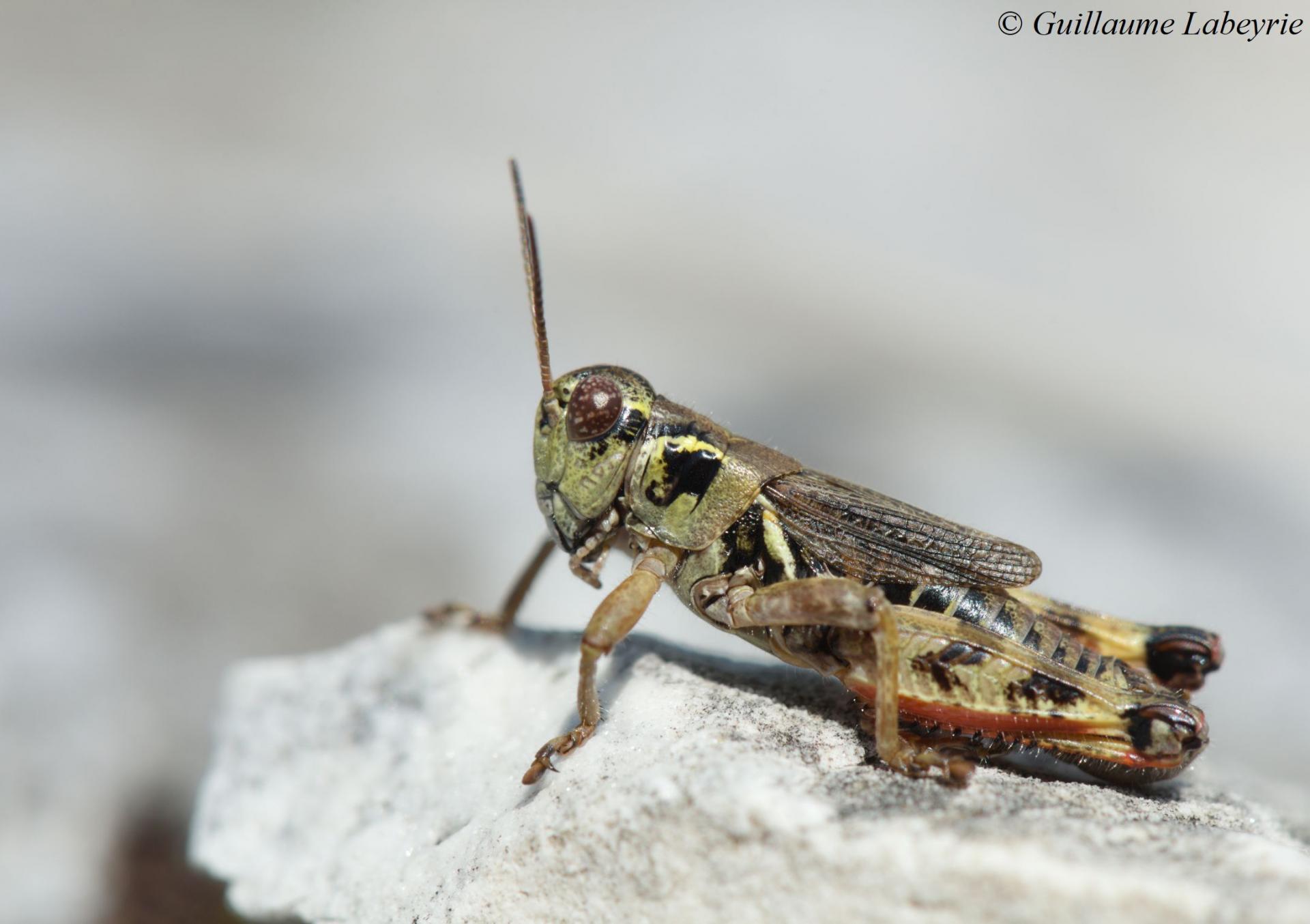 The nordic mountain grasshopper (Melanoplus frigidus subsp. frigidus). This small species can be recognized by its short but joined elytra, unlike those of the genus Podisma. It frequents rocky grasslands at high altitude. Restricted to the Alps, it is found in France from Haute-Savoie to the Hautes-Alpes.
The nordic mountain grasshopper (Melanoplus frigidus subsp. frigidus). This small species can be recognized by its short but joined elytra, unlike those of the genus Podisma. It frequents rocky grasslands at high altitude. Restricted to the Alps, it is found in France from Haute-Savoie to the Hautes-Alpes.
 Chorthippus apricarius. This species is distinguished by the enlarged median field of the elytra, which are often spoted with black, and its yellowish color. It is found mainly in the mountains, near shrubs. It is present in France especially above an altitude of 1000 m, in the Pyrenees and the Alps.
Chorthippus apricarius. This species is distinguished by the enlarged median field of the elytra, which are often spoted with black, and its yellowish color. It is found mainly in the mountains, near shrubs. It is present in France especially above an altitude of 1000 m, in the Pyrenees and the Alps.
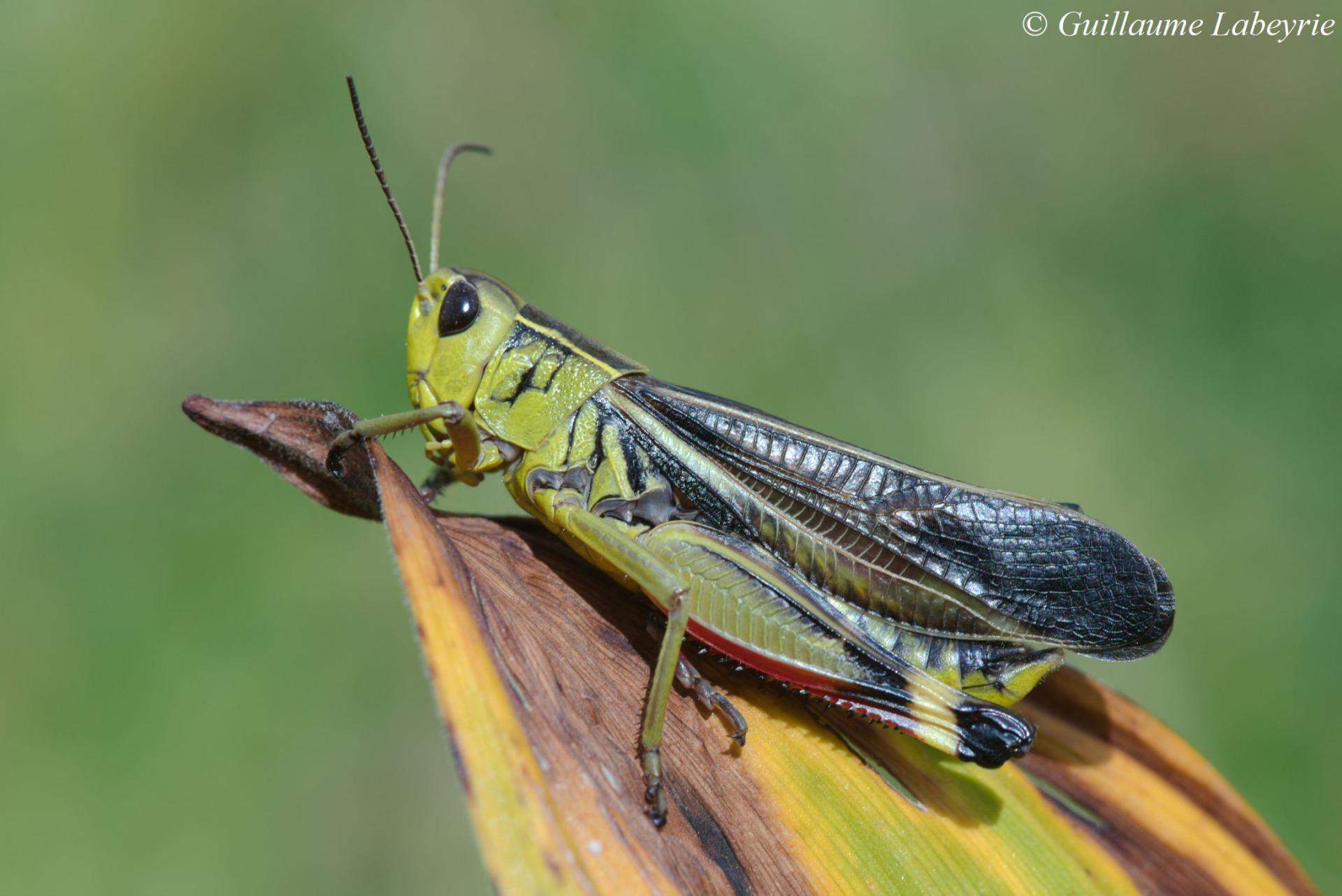 The large banded grasshopper (Arcyptera fusca). This large and brightly colored species is found on well-exposed grassy slopes above 1500 m of altitude. Distributed from southern Europe to southern Russia, it is present in France in a southern third of the country.
The large banded grasshopper (Arcyptera fusca). This large and brightly colored species is found on well-exposed grassy slopes above 1500 m of altitude. Distributed from southern Europe to southern Russia, it is present in France in a southern third of the country.
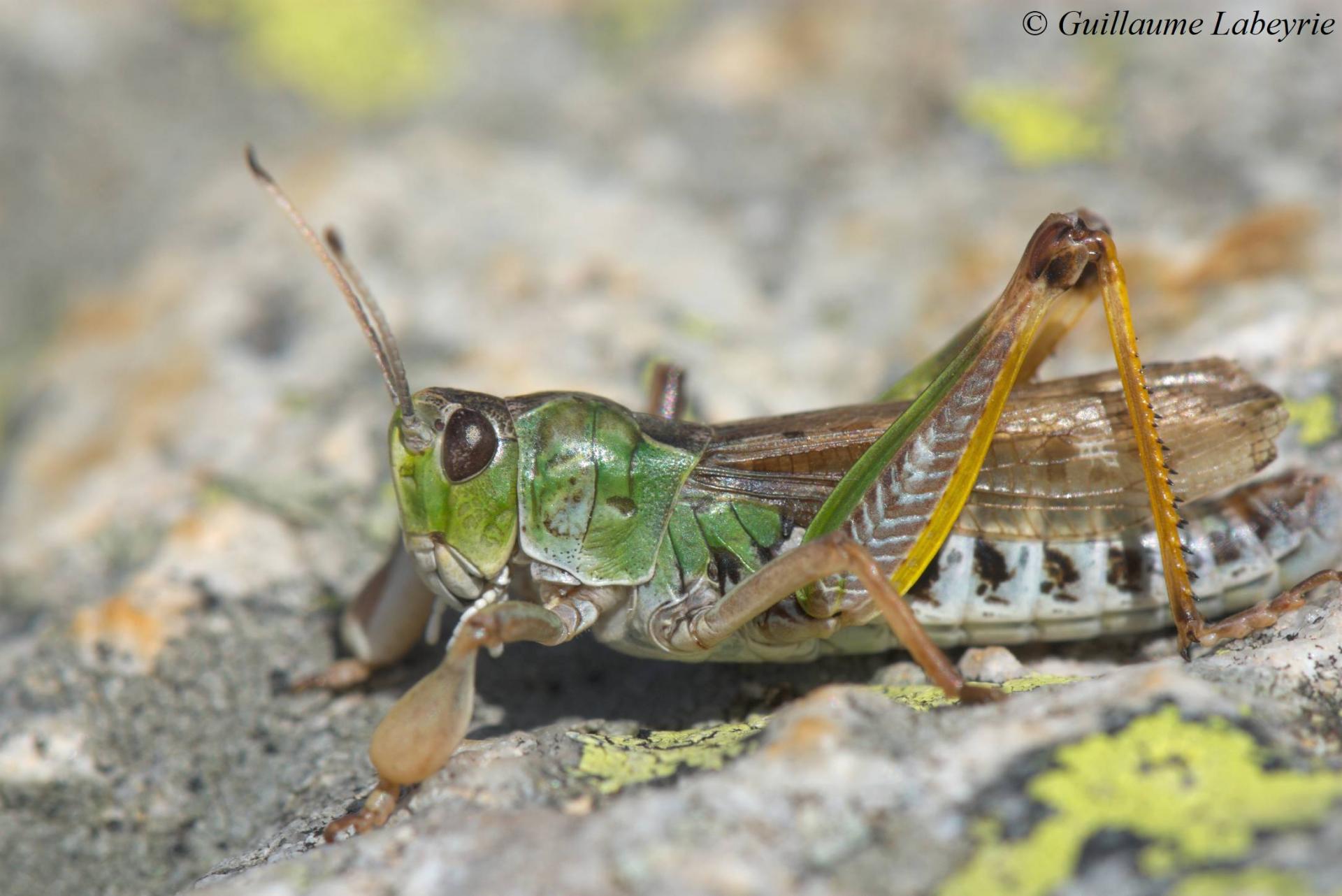 Male Gomphocerus sibiricus. This species is often the one encountered at the highest altitude, up to 3000 m. The male is easily recognizable, with his humped pronotum and curiously swollen fore tibiae. This species frequents rocky alpine grasslands. It is present in the Pyrenees, the Alps, the Balkans, and in Russia.
Male Gomphocerus sibiricus. This species is often the one encountered at the highest altitude, up to 3000 m. The male is easily recognizable, with his humped pronotum and curiously swollen fore tibiae. This species frequents rocky alpine grasslands. It is present in the Pyrenees, the Alps, the Balkans, and in Russia.
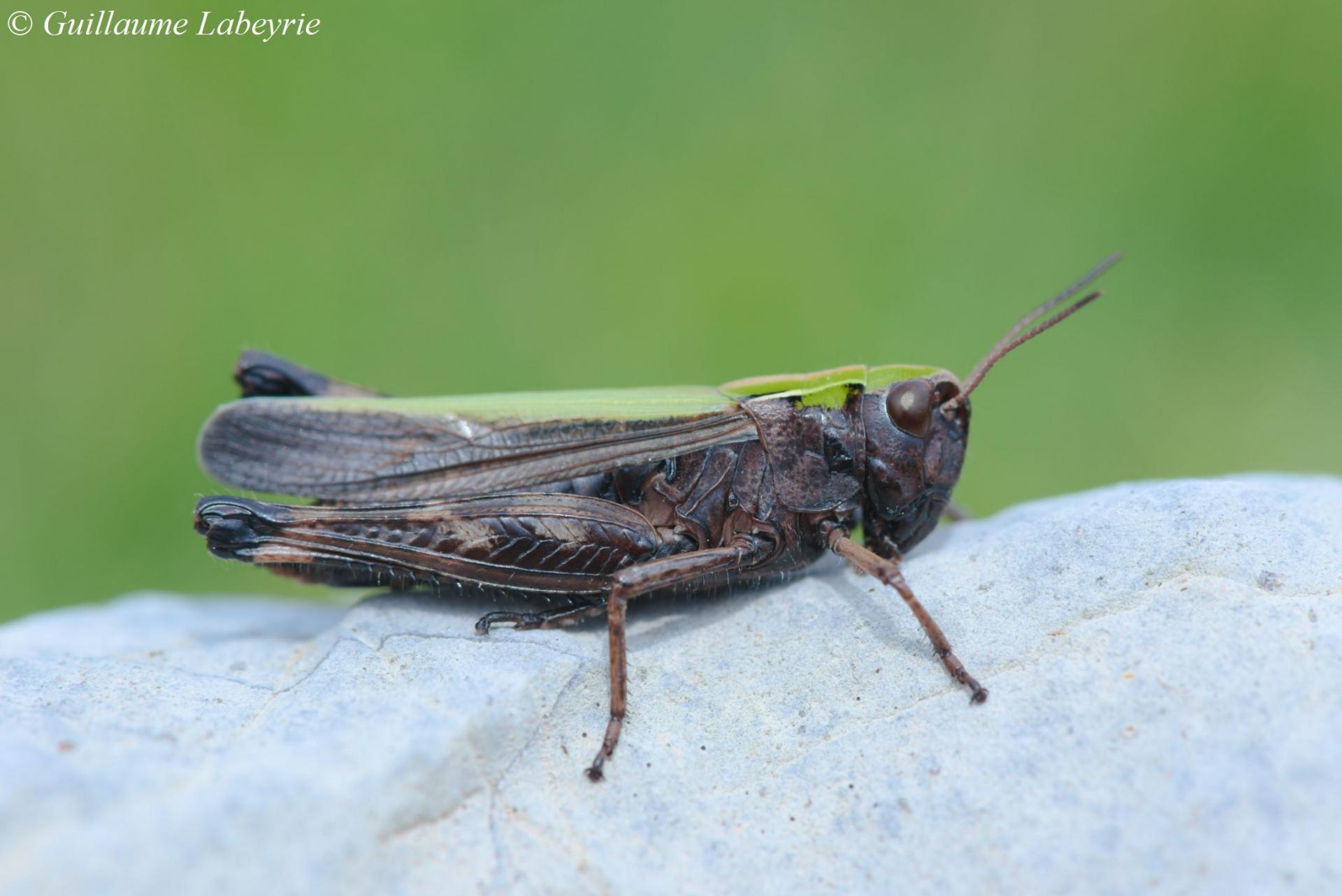 The common green grasshopper (Omocestus viridulus). This species is found in France in particular in mountain pastures. It is distributed throughout Europe as far as Russia, and present in a large part of France except on the Atlantic coast.
The common green grasshopper (Omocestus viridulus). This species is found in France in particular in mountain pastures. It is distributed throughout Europe as far as Russia, and present in a large part of France except on the Atlantic coast.
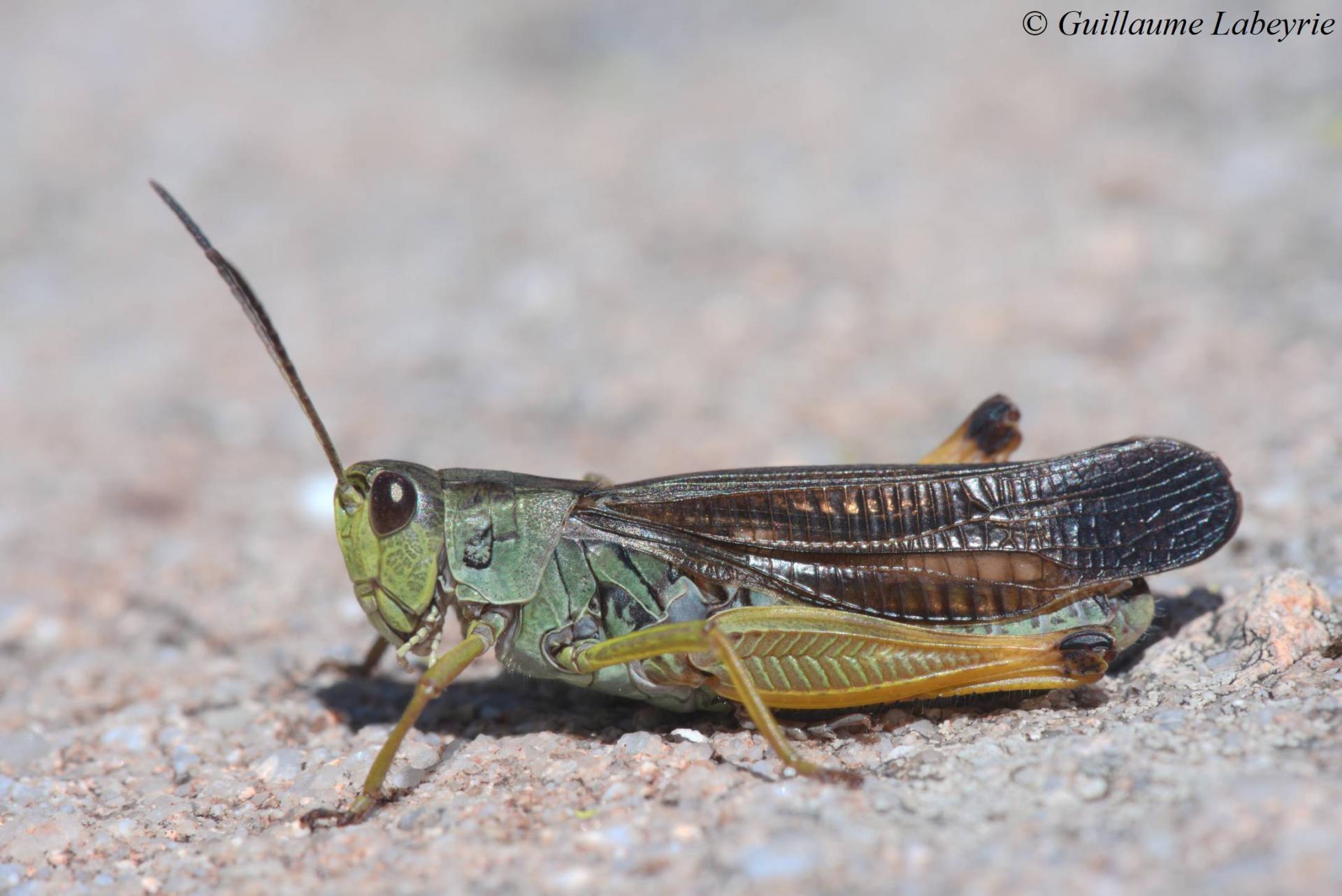 The large mountain grasshopper (Stauroderus scalaris). Males of this species have smoky elytra with a characteristic ''ladder'' pattern. They emit a typical screech while flying. This mountain species likes dry slopes with tall grass. Distributed from southern Europe to southern Russia, it is found in France in the south-eastern half of the country.
The large mountain grasshopper (Stauroderus scalaris). Males of this species have smoky elytra with a characteristic ''ladder'' pattern. They emit a typical screech while flying. This mountain species likes dry slopes with tall grass. Distributed from southern Europe to southern Russia, it is found in France in the south-eastern half of the country.
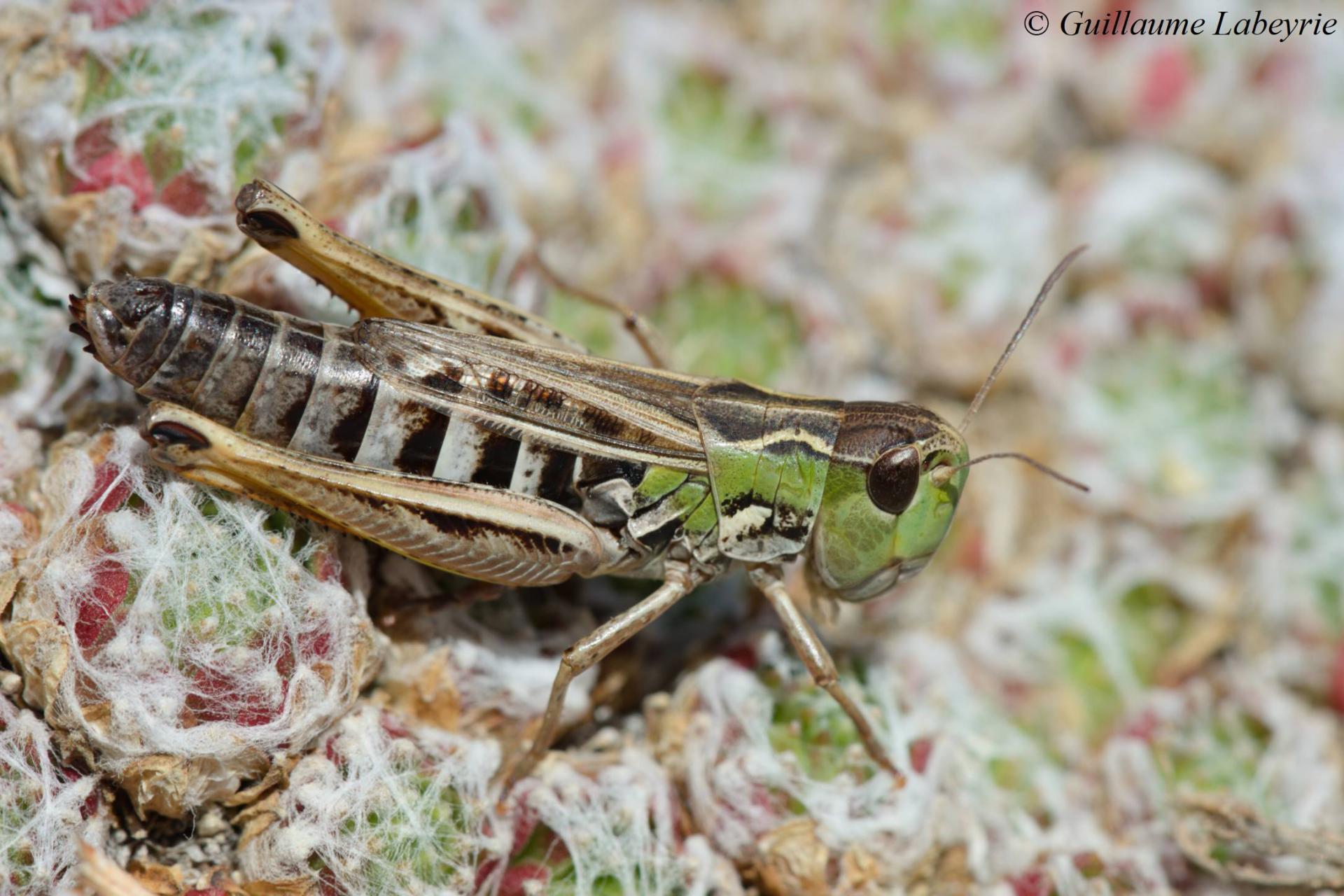 Stenobothrus nigromaculatus. In this species, the stigma (black and white spot on the elytra) is located near the end of the elytra. The antennae are bent in both sexes, but this feature is more marked in the male. The female, shown here, has elytra much shorter than the abdomen. Stenobothrus nigromaculatus likes dry slopes, usually in the mountains. It is locally present across Central and Southern Europe.
Stenobothrus nigromaculatus. In this species, the stigma (black and white spot on the elytra) is located near the end of the elytra. The antennae are bent in both sexes, but this feature is more marked in the male. The female, shown here, has elytra much shorter than the abdomen. Stenobothrus nigromaculatus likes dry slopes, usually in the mountains. It is locally present across Central and Southern Europe.
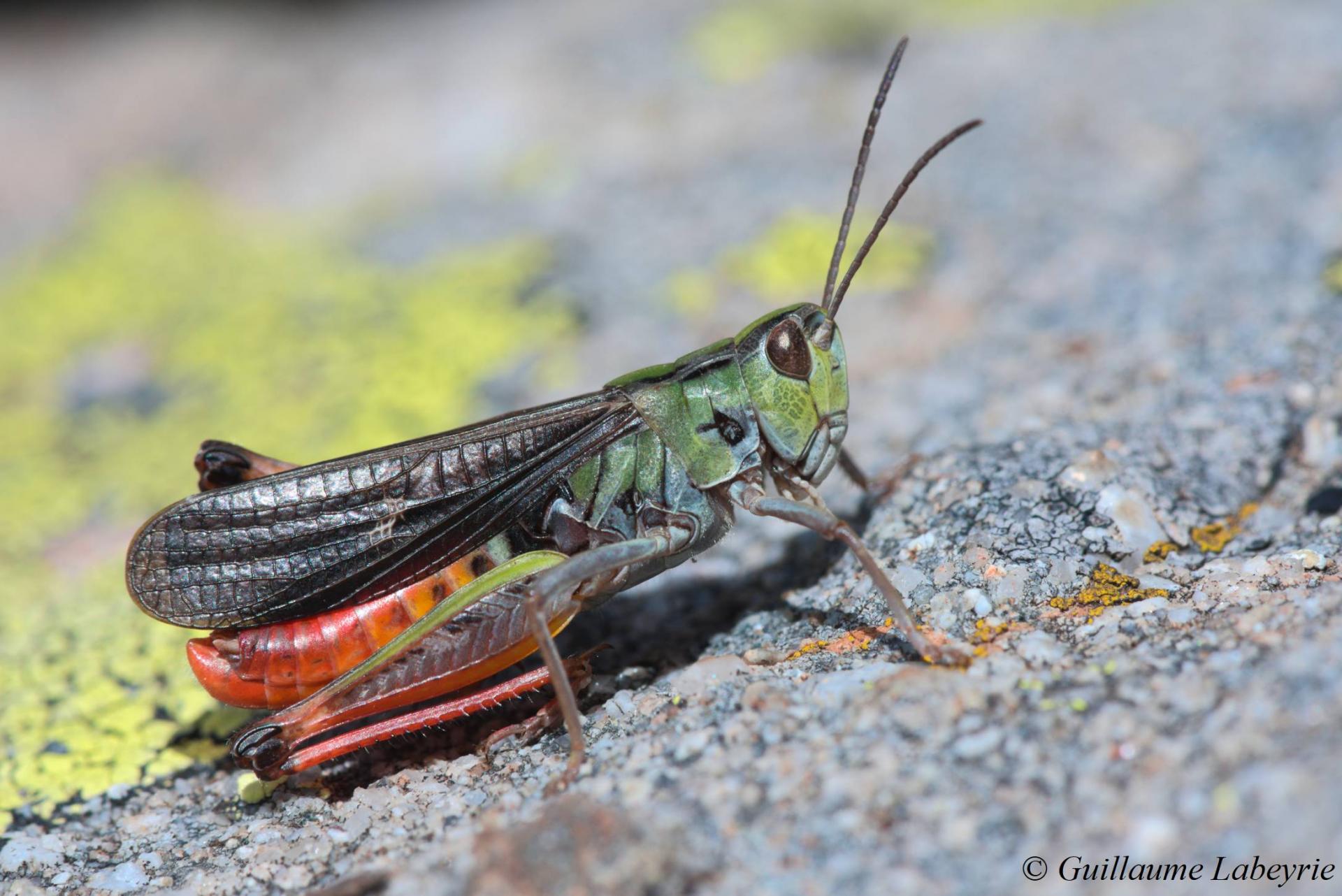 The wing-buzzing grasshopper (Stenobothrus rubicundulus). The males of this small species have large black elytra with a stigma (white spot) located in the middle. The abdomen is orange-red, the hind tibiae red, the pronotum and the head greenish or gray. The presence of this grasshopper on the dry and rocky slopes is detected by the continuous buzzing emitted by the males, either on the ground or while flying in place. This species is present in the Alps and the Balkans. In France, where it is generally located, it is found in the Alps from Savoie to the Alpes-Maritimes.
The wing-buzzing grasshopper (Stenobothrus rubicundulus). The males of this small species have large black elytra with a stigma (white spot) located in the middle. The abdomen is orange-red, the hind tibiae red, the pronotum and the head greenish or gray. The presence of this grasshopper on the dry and rocky slopes is detected by the continuous buzzing emitted by the males, either on the ground or while flying in place. This species is present in the Alps and the Balkans. In France, where it is generally located, it is found in the Alps from Savoie to the Alpes-Maritimes.
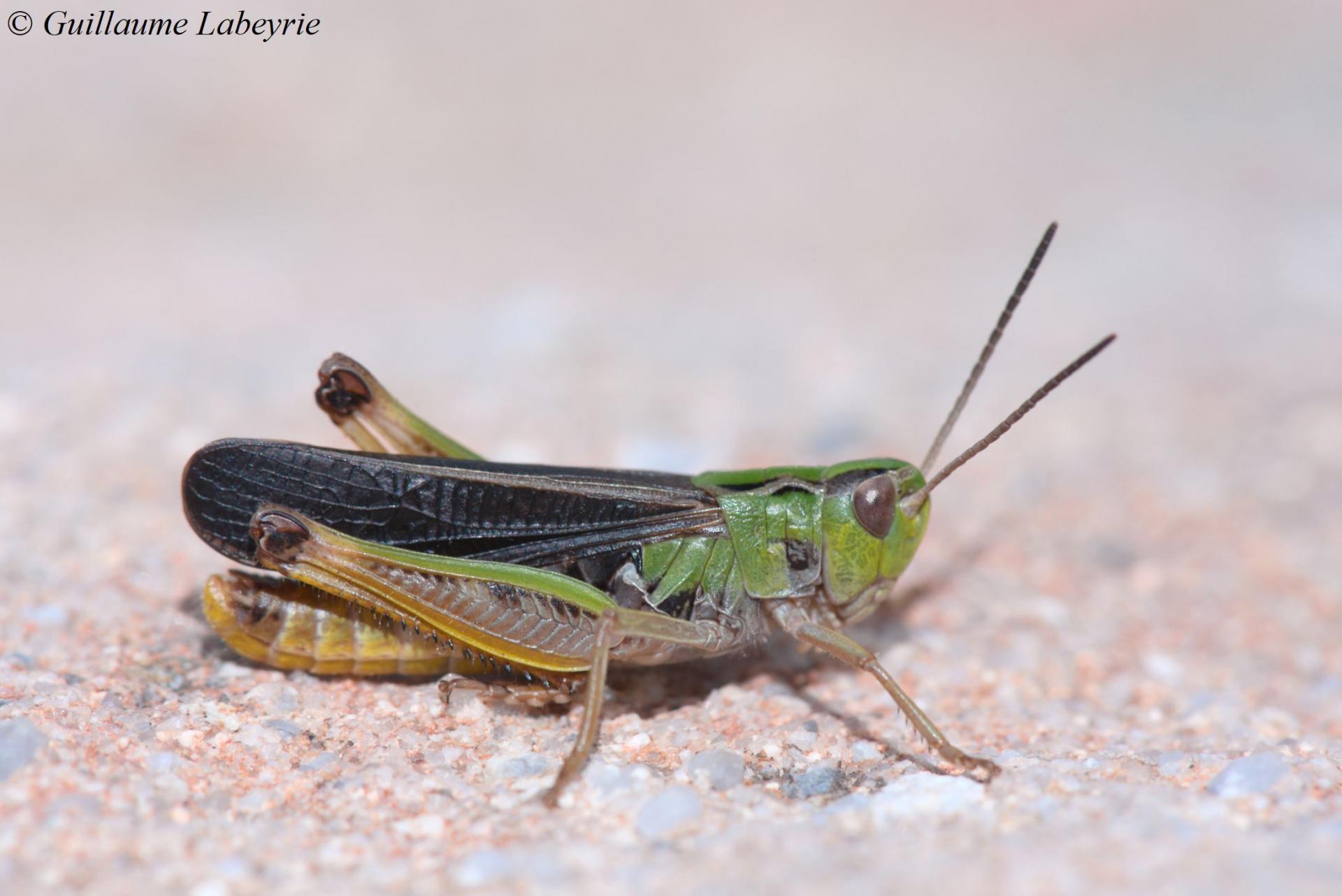 Stenobothrus cotticus. This species is the same size as the previous one, but its abdomen and hind tibiae are yellowish, not red. It frequents rocky grasslands above an altitude of 2400 m. Endemic to the South-West of the Alps, rare and very localized, it is present in France in the Hautes-Alpes, the Alpes-de-Haute-Provence and the Alpes-Maritimes. It appears on the world and European red lists with the mention ''near-threatened''.
Stenobothrus cotticus. This species is the same size as the previous one, but its abdomen and hind tibiae are yellowish, not red. It frequents rocky grasslands above an altitude of 2400 m. Endemic to the South-West of the Alps, rare and very localized, it is present in France in the Hautes-Alpes, the Alpes-de-Haute-Provence and the Alpes-Maritimes. It appears on the world and European red lists with the mention ''near-threatened''.
La flore
Family : Aspleniaceae
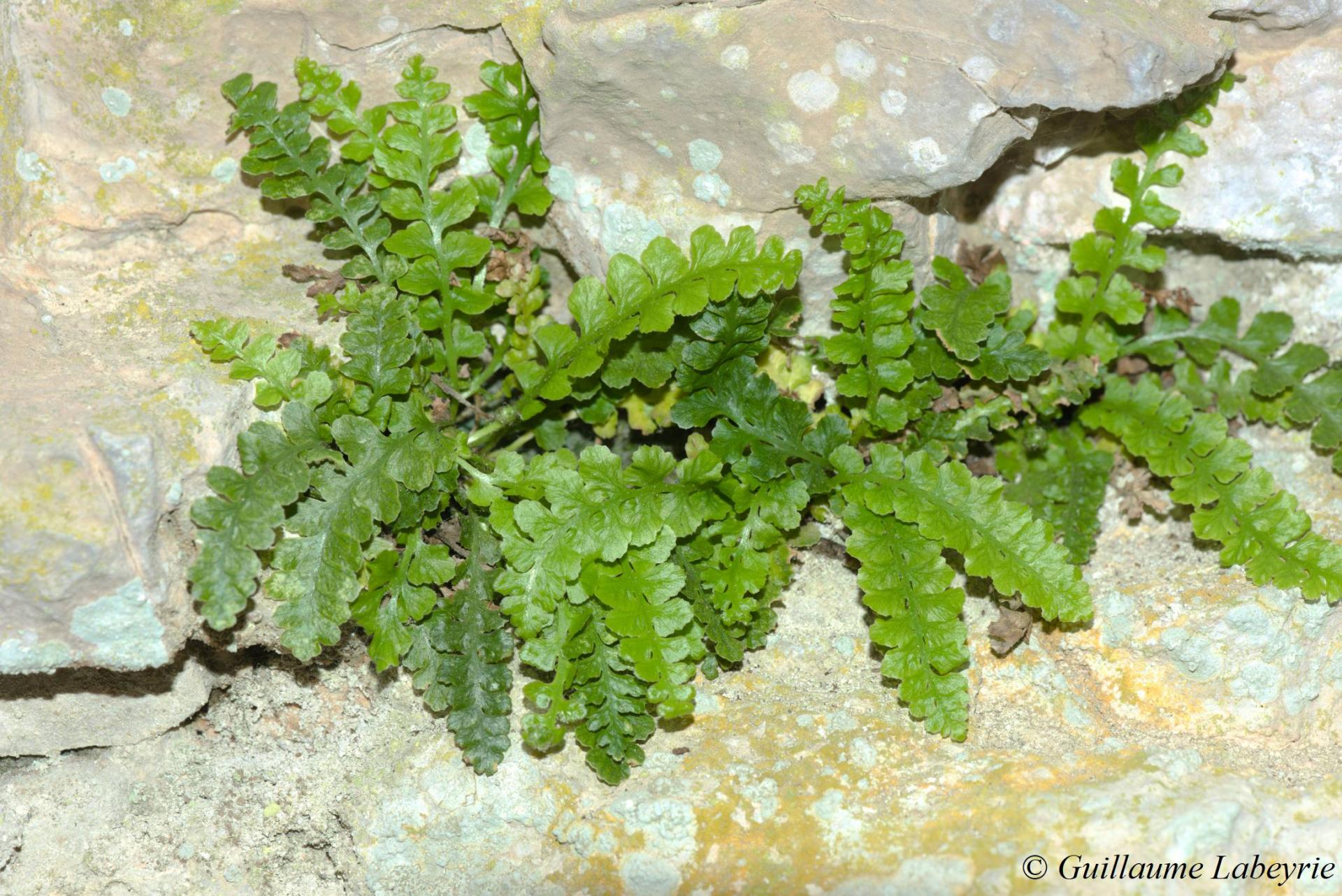 Asplenium jahandiezii. This small fern is endemic to the Gorges du Verdon, where it grows in balms and rocky overhangs, usually in the shade. Its is distinguished from other ferns growing in the same type of environment by its light green rosettes and the quadrangular segments of its fronds. This species, with its extremely restricted distribution, is listed on the national red list with the mention "near threatened". It is protected at the national level.
Asplenium jahandiezii. This small fern is endemic to the Gorges du Verdon, where it grows in balms and rocky overhangs, usually in the shade. Its is distinguished from other ferns growing in the same type of environment by its light green rosettes and the quadrangular segments of its fronds. This species, with its extremely restricted distribution, is listed on the national red list with the mention "near threatened". It is protected at the national level.
Family : Asteraceae
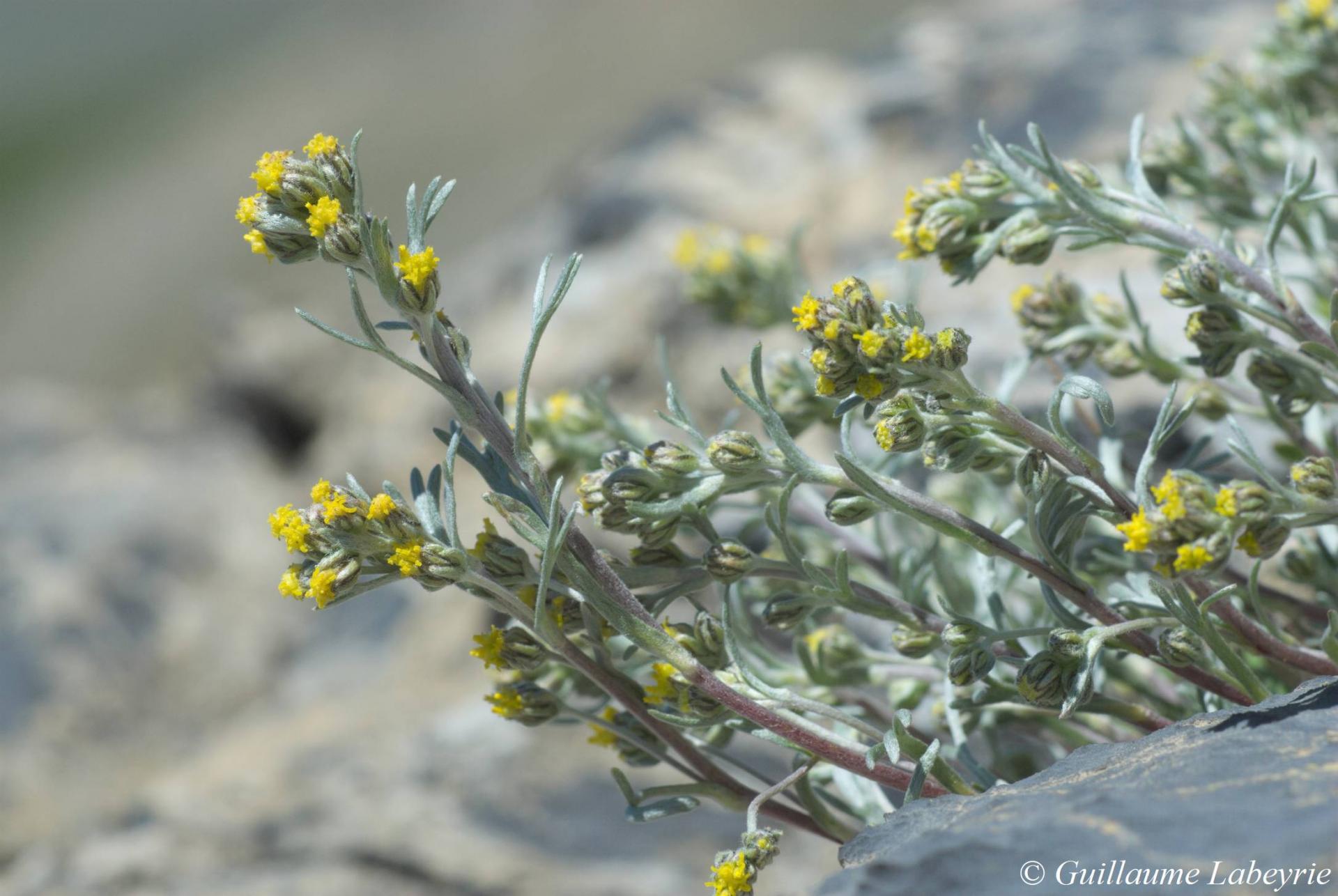 The black génépi (Artemisia genipi). This plant is distinguished by its small heads of yellow flowers that are not very open and distributed along the stem, with bracts edged in black. It grows on ridges and rocks at high altitudes, typically above 2500 m. It is found in the Alps and the Pyrenees.
The black génépi (Artemisia genipi). This plant is distinguished by its small heads of yellow flowers that are not very open and distributed along the stem, with bracts edged in black. It grows on ridges and rocks at high altitudes, typically above 2500 m. It is found in the Alps and the Pyrenees.
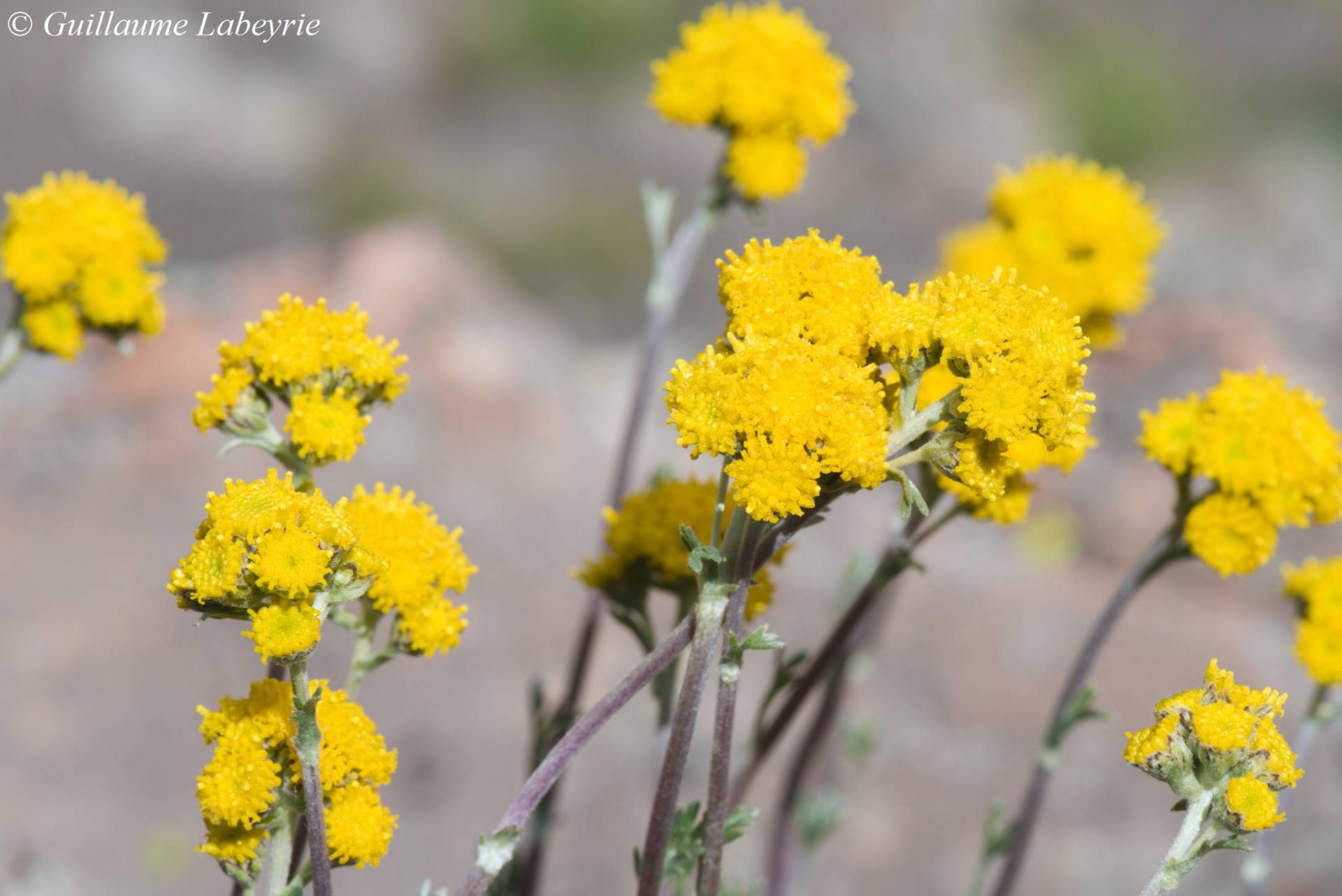 The glacier wormwood (Artemisia glacialis). This other wormwood shows comparatively large yellow flower heads grouped together at the end of the stem. It grows in the same habitats as the previous species. It is also found in the Alps and the Pyrenees.
The glacier wormwood (Artemisia glacialis). This other wormwood shows comparatively large yellow flower heads grouped together at the end of the stem. It grows in the same habitats as the previous species. It is also found in the Alps and the Pyrenees.
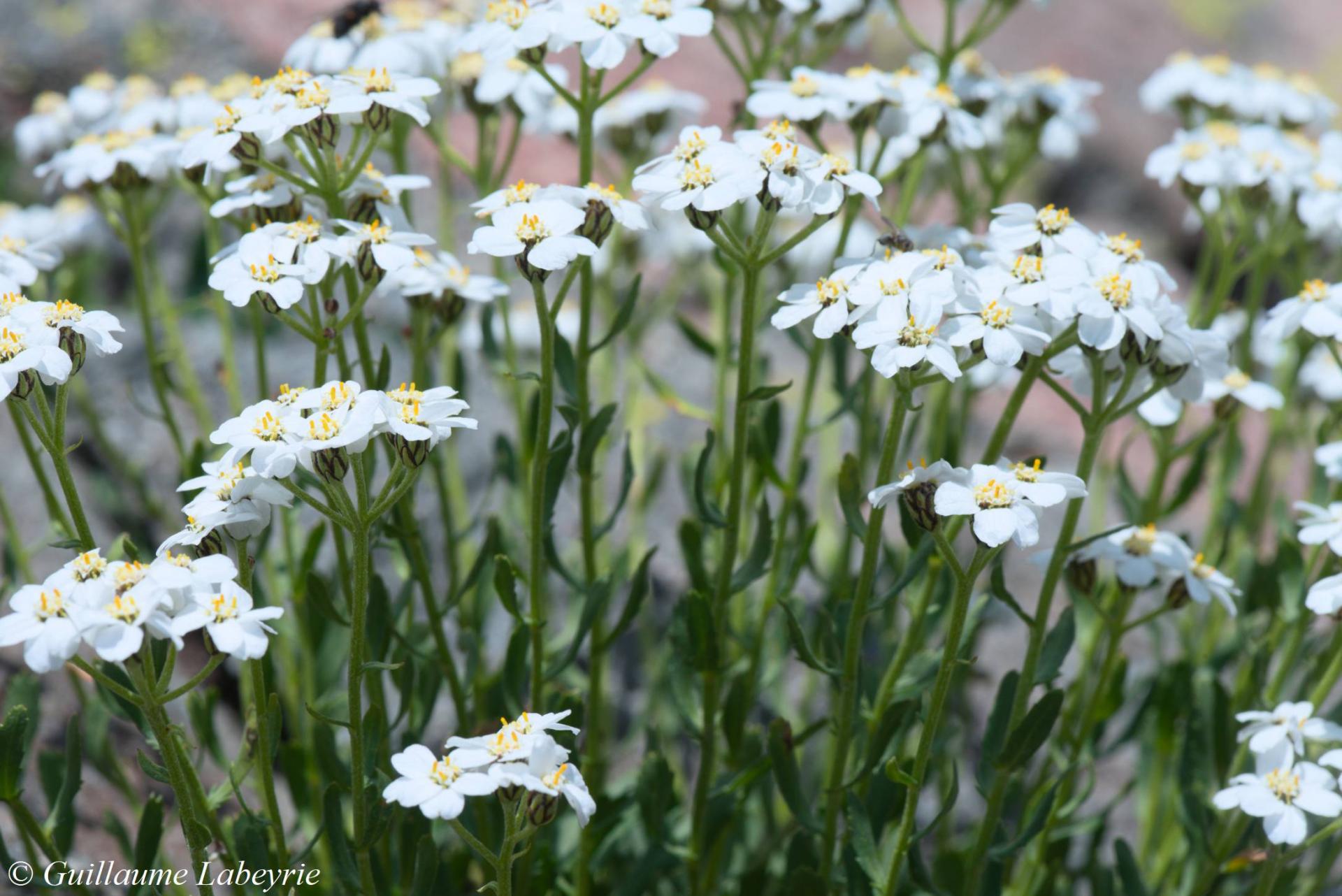 The simple-leaved milfoil (Achillea erba-rotta). This specied is characterized by its entire, toothed leaves (for the erba-rotta subspecies shown here), and its white flower heads with black-edged bracts. The moschata subspecies has divided leaves. This plant likes siliceous rocks at high altitude. Rather rare, it is found in France in the Vanoise on the one hand, and from Queyras to Mercantour on the other. It is protected in the Hautes-Alpes and the Alpes-de-Haute-Provence.
The simple-leaved milfoil (Achillea erba-rotta). This specied is characterized by its entire, toothed leaves (for the erba-rotta subspecies shown here), and its white flower heads with black-edged bracts. The moschata subspecies has divided leaves. This plant likes siliceous rocks at high altitude. Rather rare, it is found in France in the Vanoise on the one hand, and from Queyras to Mercantour on the other. It is protected in the Hautes-Alpes and the Alpes-de-Haute-Provence.
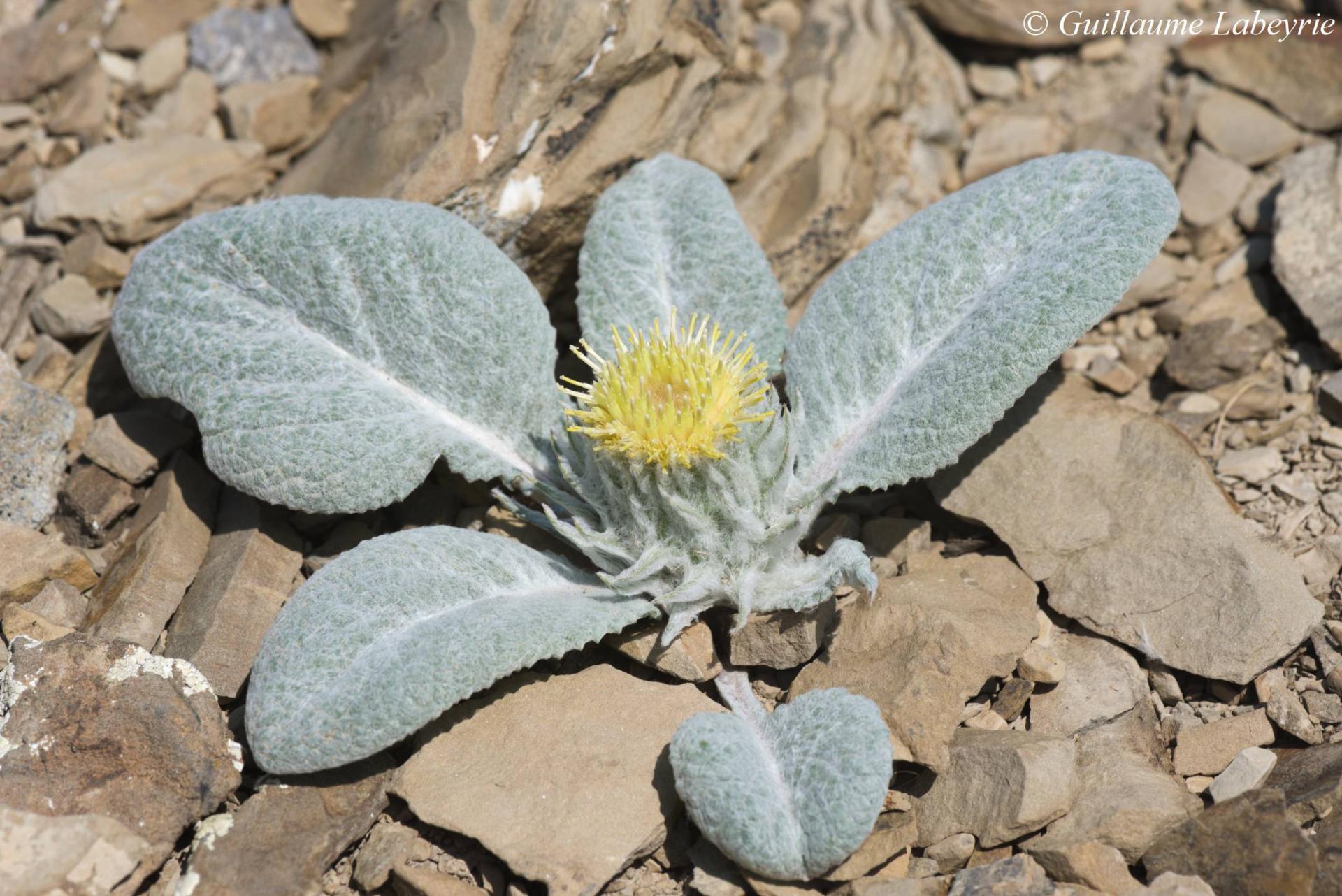
Berardia lanuginosa. This spectacular plant forms large rosettes (up to 40 cm in diameter) of whitish leaves, bearing large pale yellow flowers. It is a high altitude scree specialist. This alpine relict is practically only found in France, from Isère to the Alpes-Maritimes. It is also observed in the Italian Piedmont. It is protected in France at the national level.
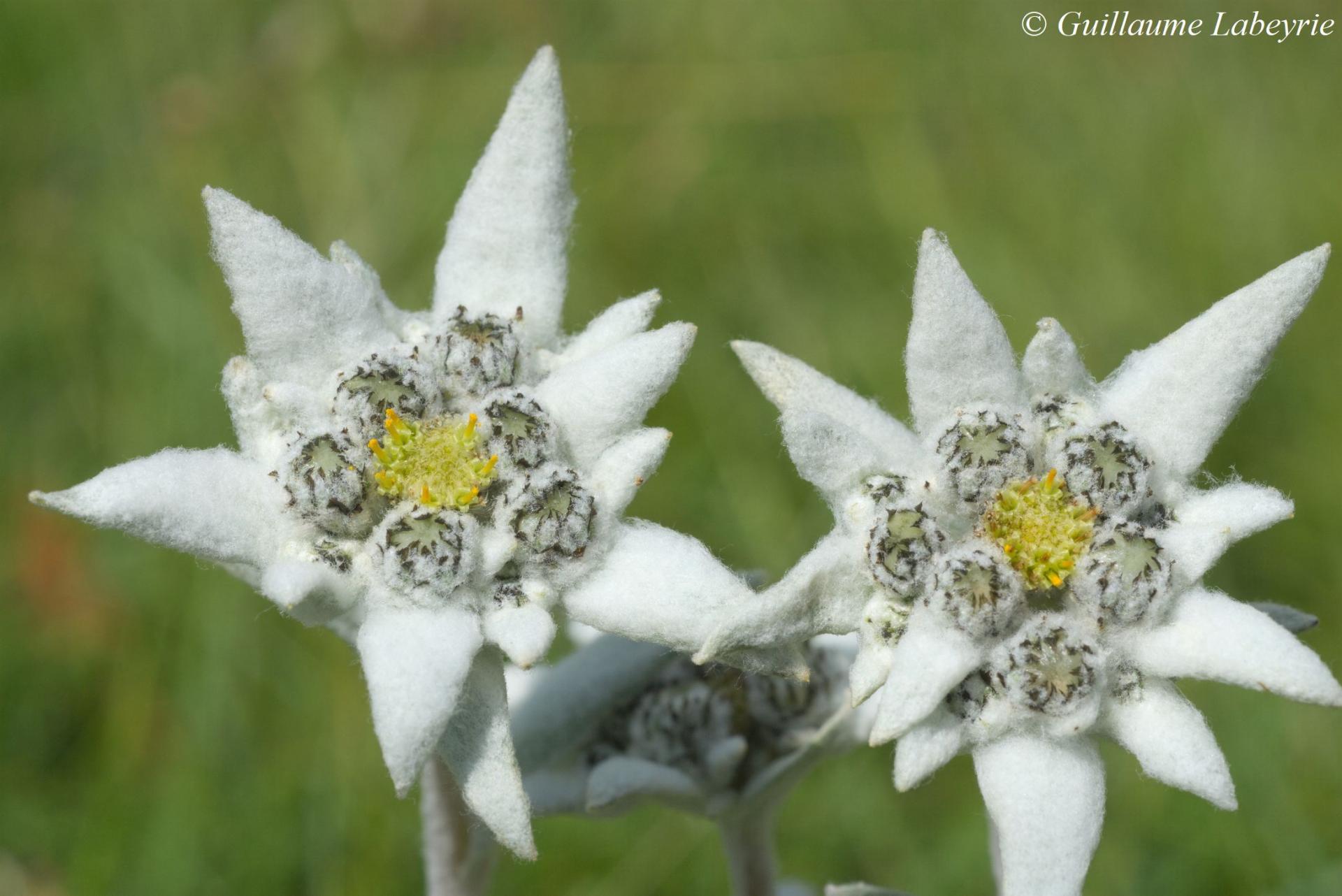 The edelweiss (Leontopodium nivale). It is probably the most iconic of the alpine flowers. It cannot be confused. It is often found in limestone grasslands, above an altitude of 1600 m. In France, it is mainly present in the Alps and the Pyrenees. It is protected in Isère and Drôme.
The edelweiss (Leontopodium nivale). It is probably the most iconic of the alpine flowers. It cannot be confused. It is often found in limestone grasslands, above an altitude of 1600 m. In France, it is mainly present in the Alps and the Pyrenees. It is protected in Isère and Drôme.
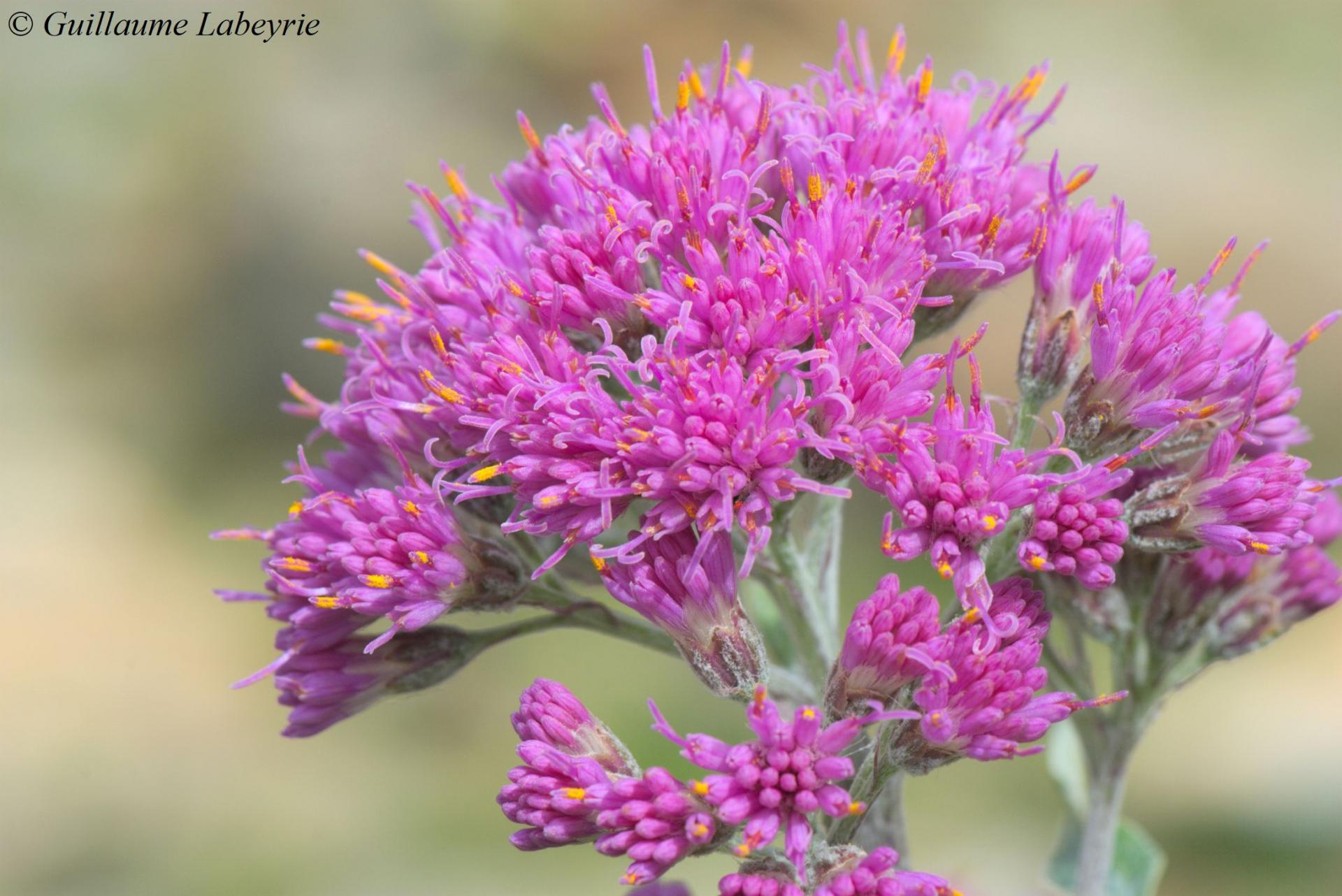 Adenostyles leucophylla. This tall plant can be recognized by its pink flower heads and broad whitish leaves, which are eaten by ibexes. It grows in scree at the subalpine and alpine levels, from Savoie to the Alpes-Maritimes.
Adenostyles leucophylla. This tall plant can be recognized by its pink flower heads and broad whitish leaves, which are eaten by ibexes. It grows in scree at the subalpine and alpine levels, from Savoie to the Alpes-Maritimes.
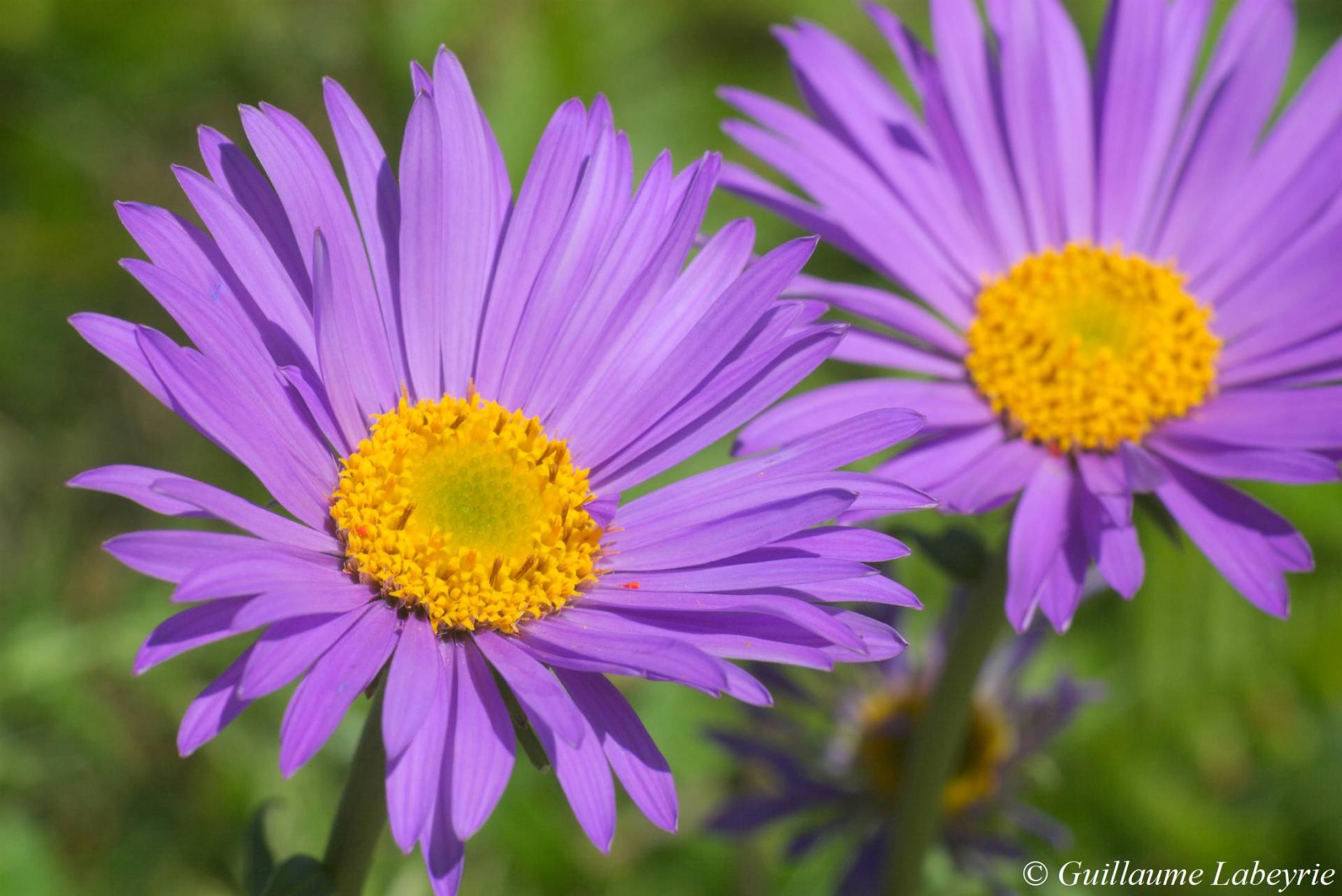 The alpine aster (Aster alpinus). This beautiful species is distinguished by its large purple flower heads with yellow hearts. It grows in rocky calcareous grasslands. It is found in France in the Alps, the Massif Central and the Pyrenees. It is protected in the Franche-Comté region.
The alpine aster (Aster alpinus). This beautiful species is distinguished by its large purple flower heads with yellow hearts. It grows in rocky calcareous grasslands. It is found in France in the Alps, the Massif Central and the Pyrenees. It is protected in the Franche-Comté region.
Family : Campanulaceae
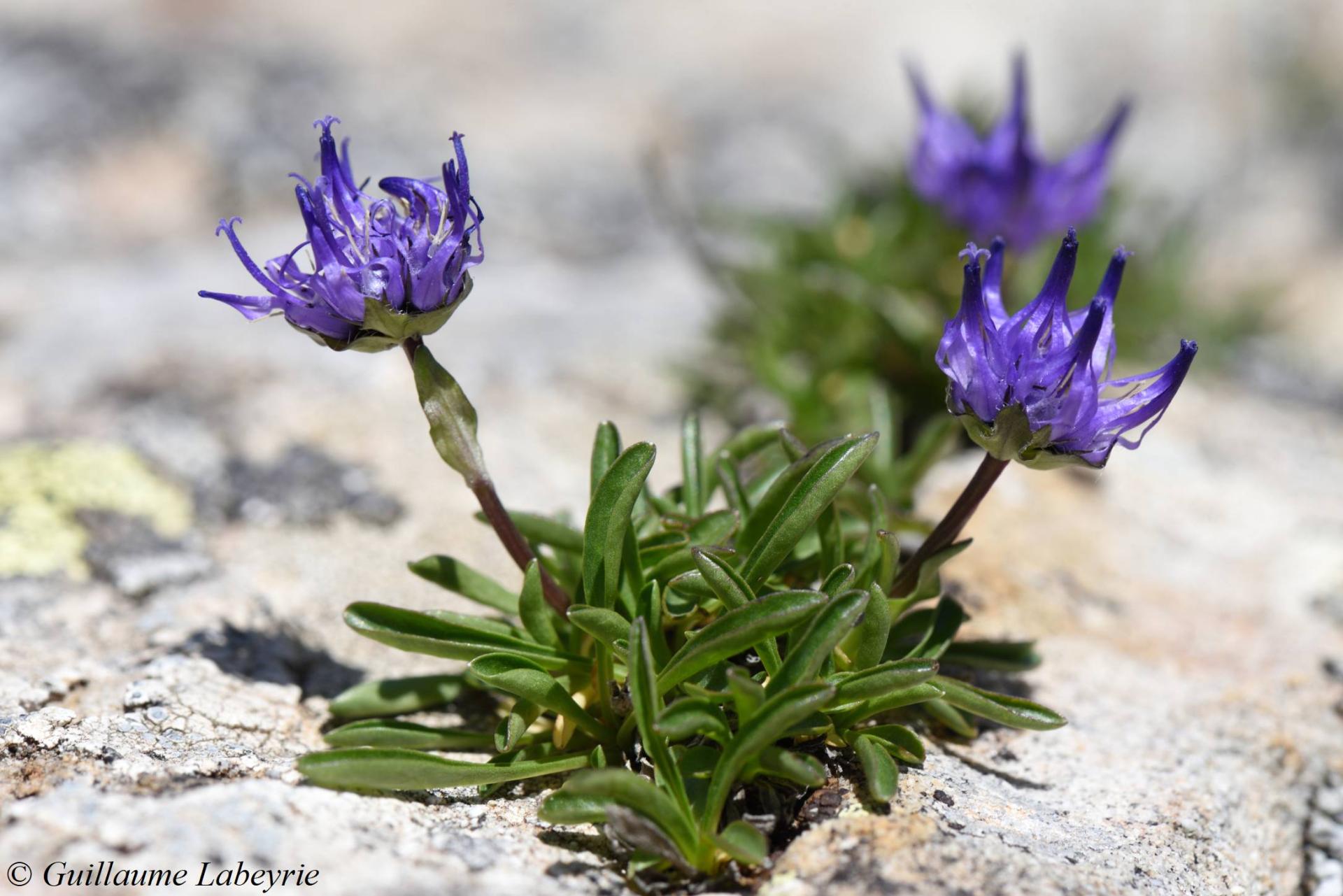
The Piedmont rampion (Phyteuma globulariifolium subsp. pedemontanum). This little plant grows in rock cracks at high altitudes. It is present in the Alpine arc and in the Pyrenees.
Family : Cystopteridaceae
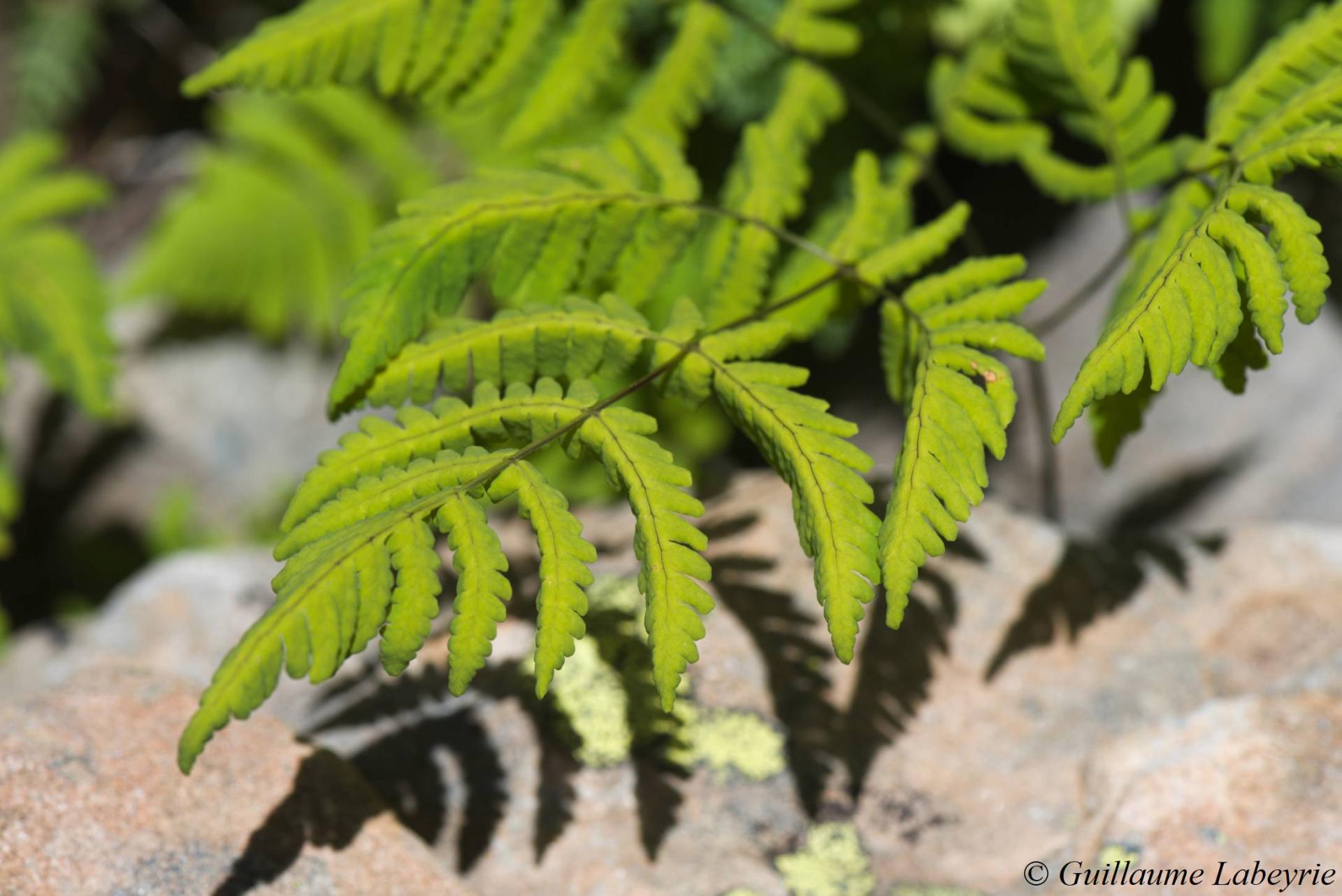
The western oakfern (Gymnocarpium dryopteris). This fern is found in woods understory but also in acid scree, as on this photo. Very widely distributed worldwide, it is however protected in several French regions.
Family : Crassulaceae
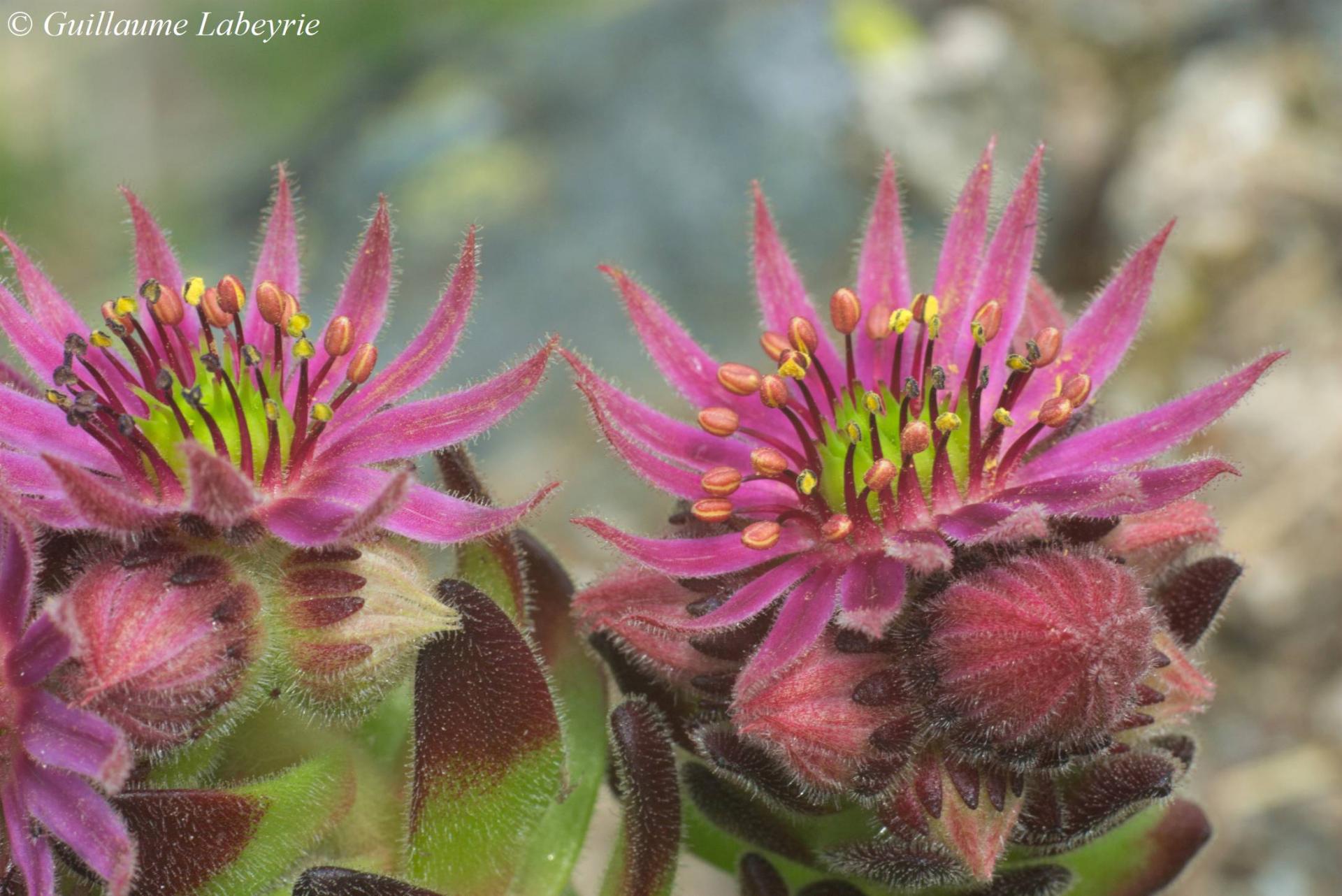 The mountain houseleek (Sempervivum montanum). This succulent plant is found in the mountains of southern Europe, on siliceous soils. It is recognized by its large rosettes reminiscent of an artichoke and its large pink flowers. In France, it is present in the Alps and the Pyrenees.
The mountain houseleek (Sempervivum montanum). This succulent plant is found in the mountains of southern Europe, on siliceous soils. It is recognized by its large rosettes reminiscent of an artichoke and its large pink flowers. In France, it is present in the Alps and the Pyrenees.
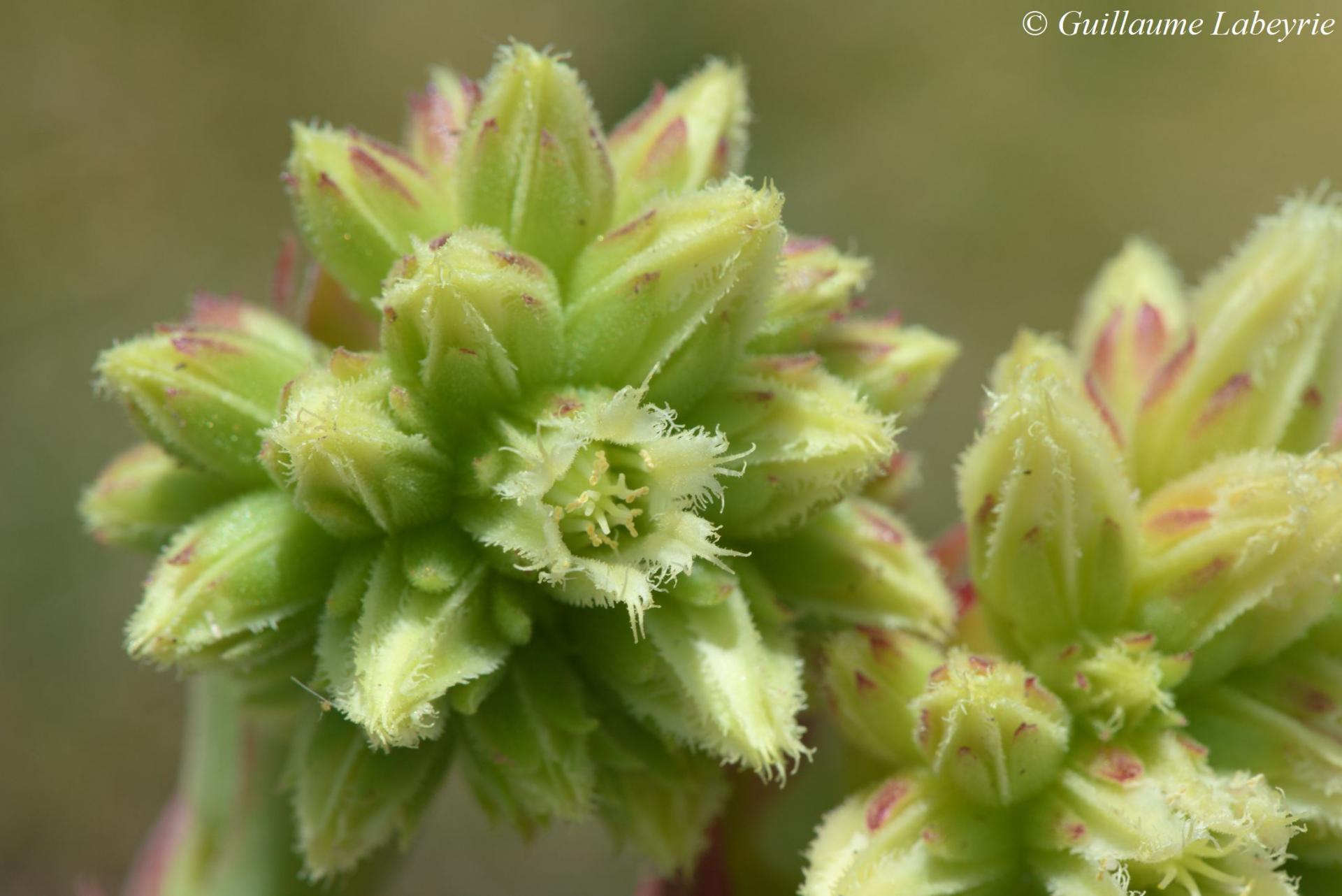
Sempervivum globiferum subsp. allionii. This unusual houseleek is identified at first glance by its pale yellow tubular flowers. The leaf rosettes are also a characteristic yellowish green. This species is generally found in rocky grasslands on siliceous soil, around 2000 m of altitude. The distribution of this species is restricted to France, Italy and Austria. In France, it is present only in the Alpes-de-Haute-Provence and the Alpes-Maritimes. It is protected in PACA.
Family : Fabaceae
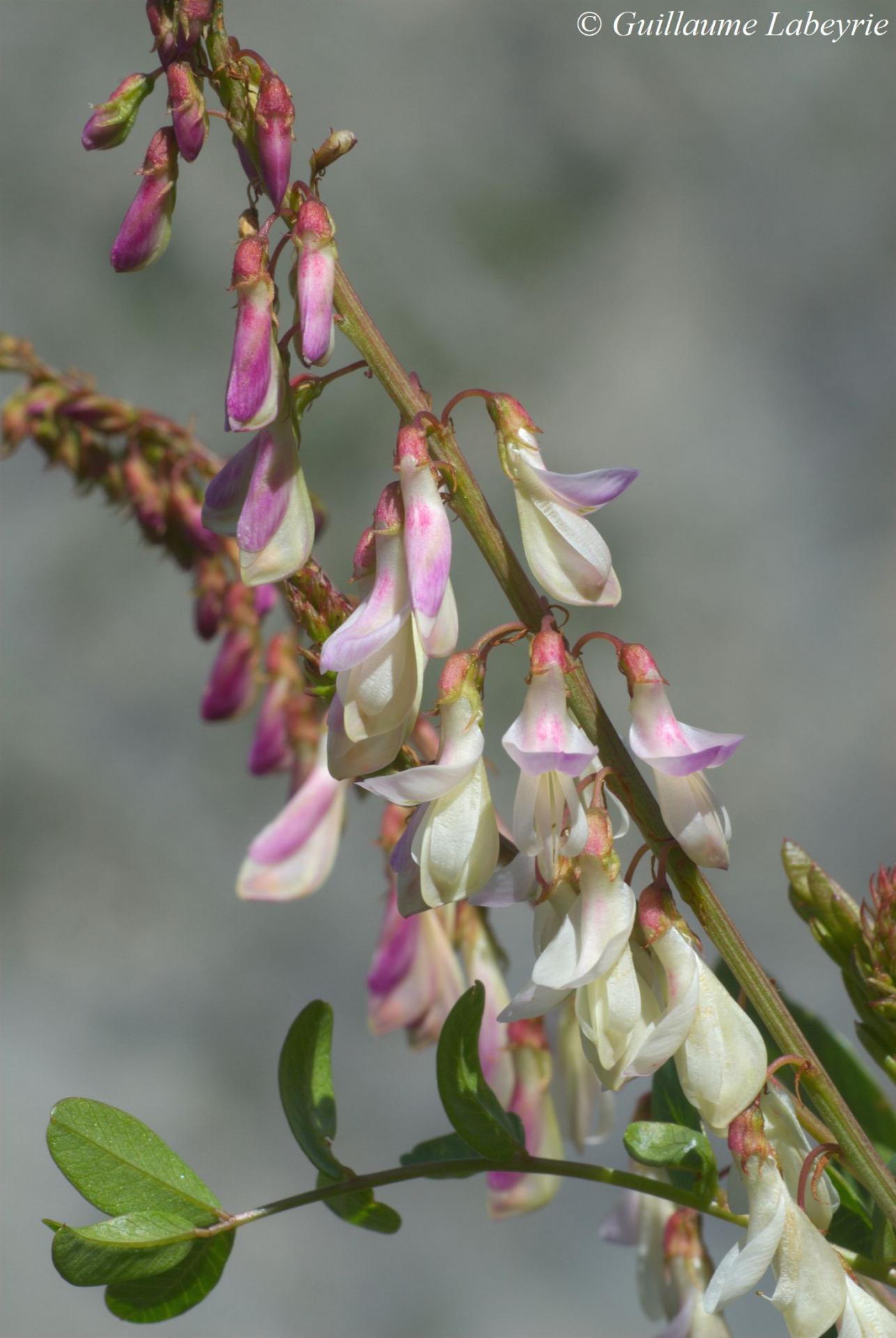 The white sainfoin (Hedysarum boutignyanum). This beautiful sainfoin forms large clumps of pinkish flowers in the scree between 1600 and 2700 m of altitude, on limestone or marl. Endemic to the southern French Alps, it is present from Isère to the Alpes-Maritimes. It is a rare plant, protected at the national level.
The white sainfoin (Hedysarum boutignyanum). This beautiful sainfoin forms large clumps of pinkish flowers in the scree between 1600 and 2700 m of altitude, on limestone or marl. Endemic to the southern French Alps, it is present from Isère to the Alpes-Maritimes. It is a rare plant, protected at the national level.
Famille : Gentianaceae
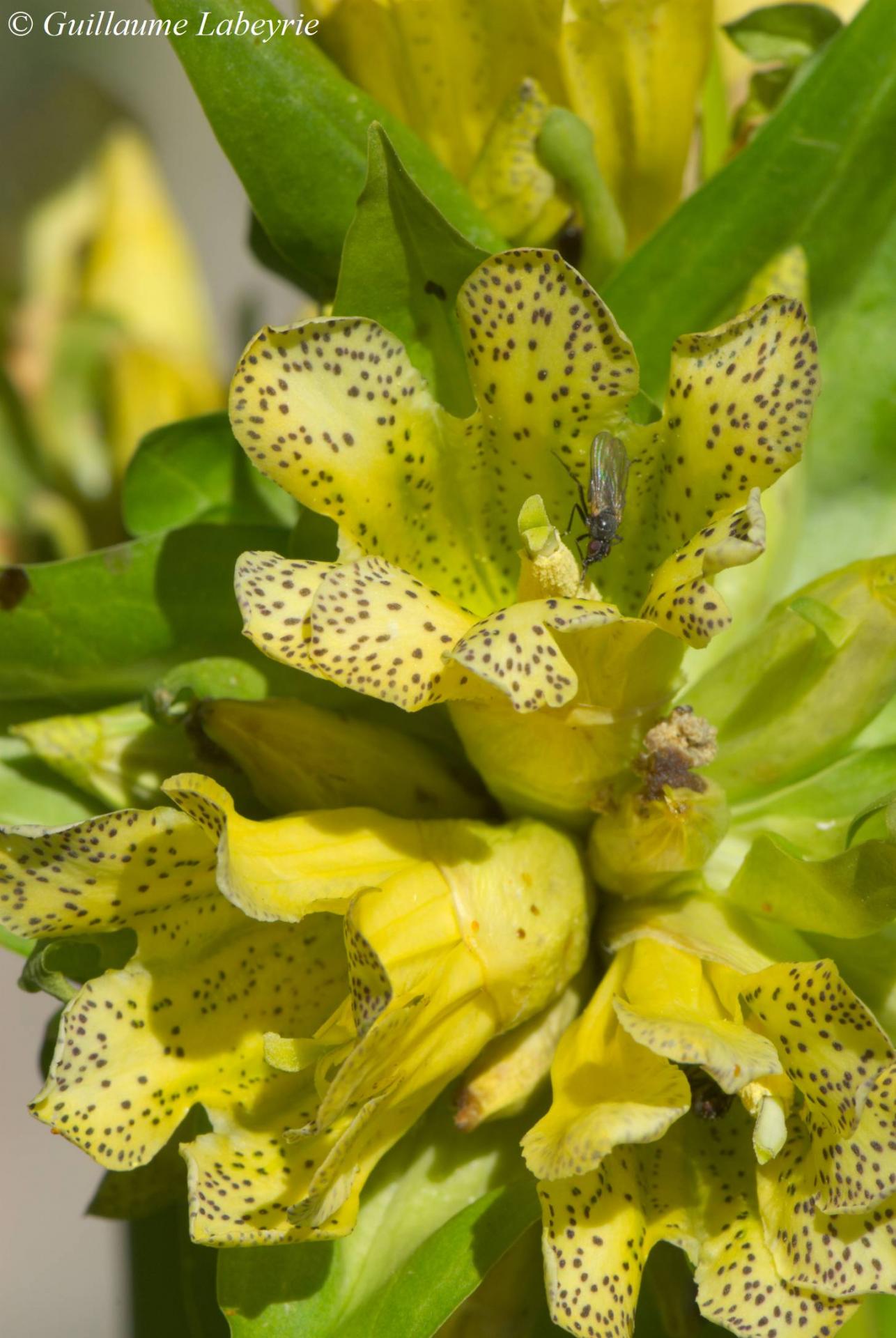
Villars's gentian (Gentiana burseri subsp. villarsii). This large gentian has yellow flowers with purple spots. The calyx is split and lacks teeth, which distinguishes this taxon from Gentiana burseri subsp. actinocalyx, found in the Roya valley, and from the spotted gentian (Gentiana punctata), found in the Northern Alps. The subspecies Gentiana burseri subsp. burseri is a Pyrenean plant. The Villars gentian is found in rocky meadows at an altitude of around 2200 m. Its distribution is restricted to the Southern Alps, France and Italy.
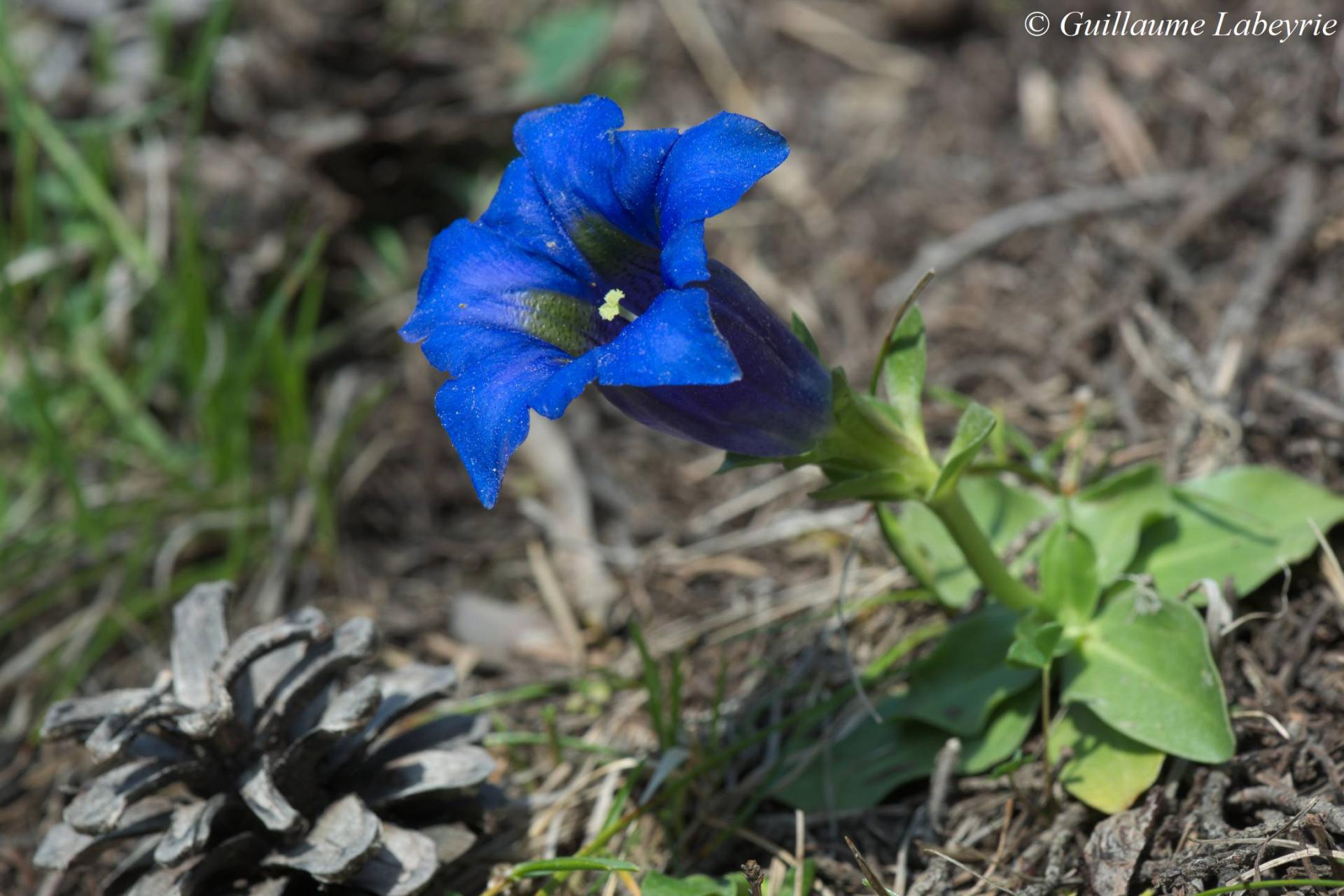 Gentiana ligustica. This beautiful gentian with its large, deep blue flowers can be distinguished from other mountain species by the diamond-shaped calyx bracts. It is also found in different environments, such as Scots pine clearings. Endemic to Liguria, it is only found in France in the Alpes-Maritimes from the Italian border to the Tinée valley. It is protected at national level.
Gentiana ligustica. This beautiful gentian with its large, deep blue flowers can be distinguished from other mountain species by the diamond-shaped calyx bracts. It is also found in different environments, such as Scots pine clearings. Endemic to Liguria, it is only found in France in the Alpes-Maritimes from the Italian border to the Tinée valley. It is protected at national level.
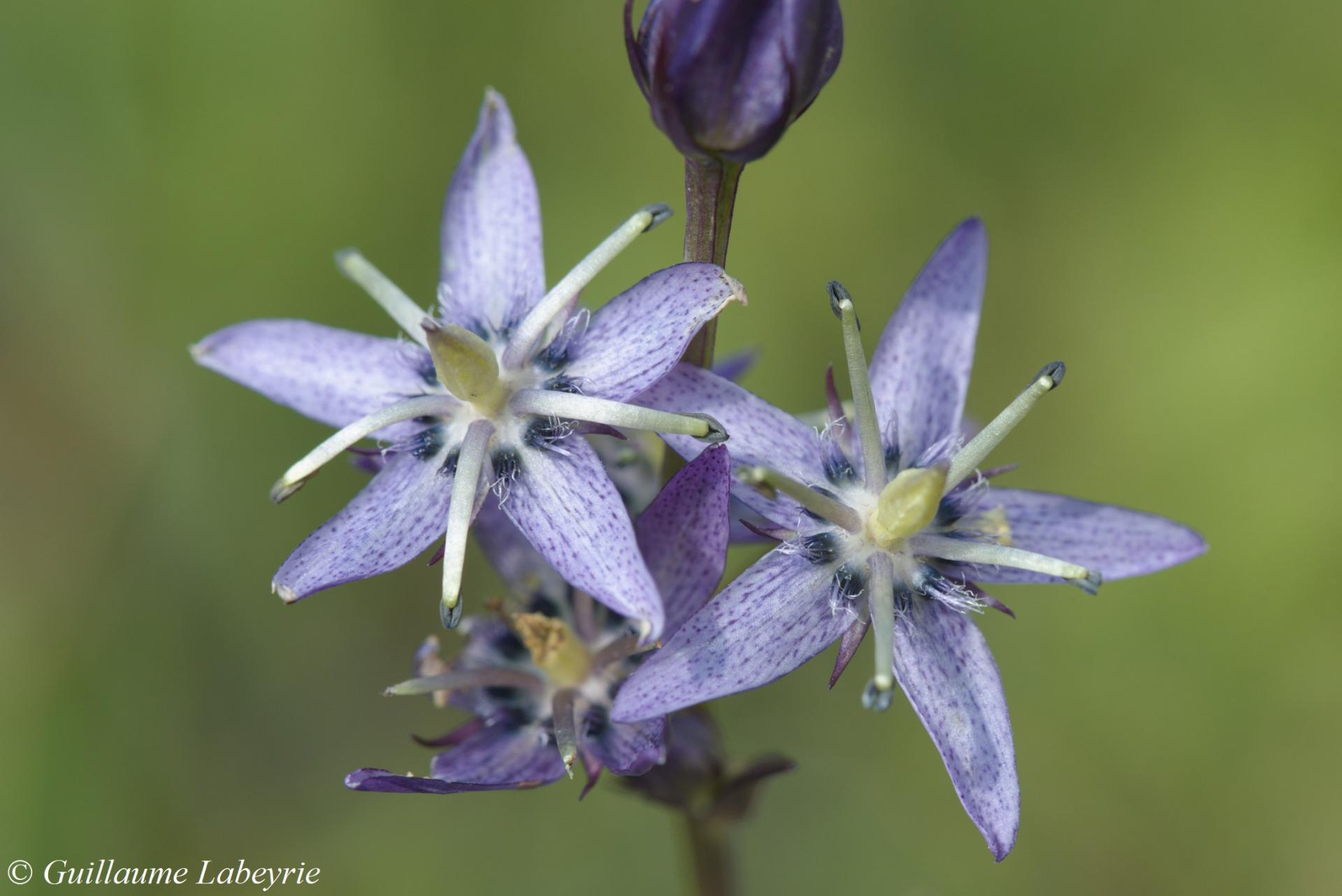
The felwort (Swertia perennis). This unusual plant has erect stems bearing ash blue flowers. It is found in high altitude calcareous fens. In France, it is present mainly in the Pyrenees and the Alps. It is protected in several regions.
Family : Iridaceae
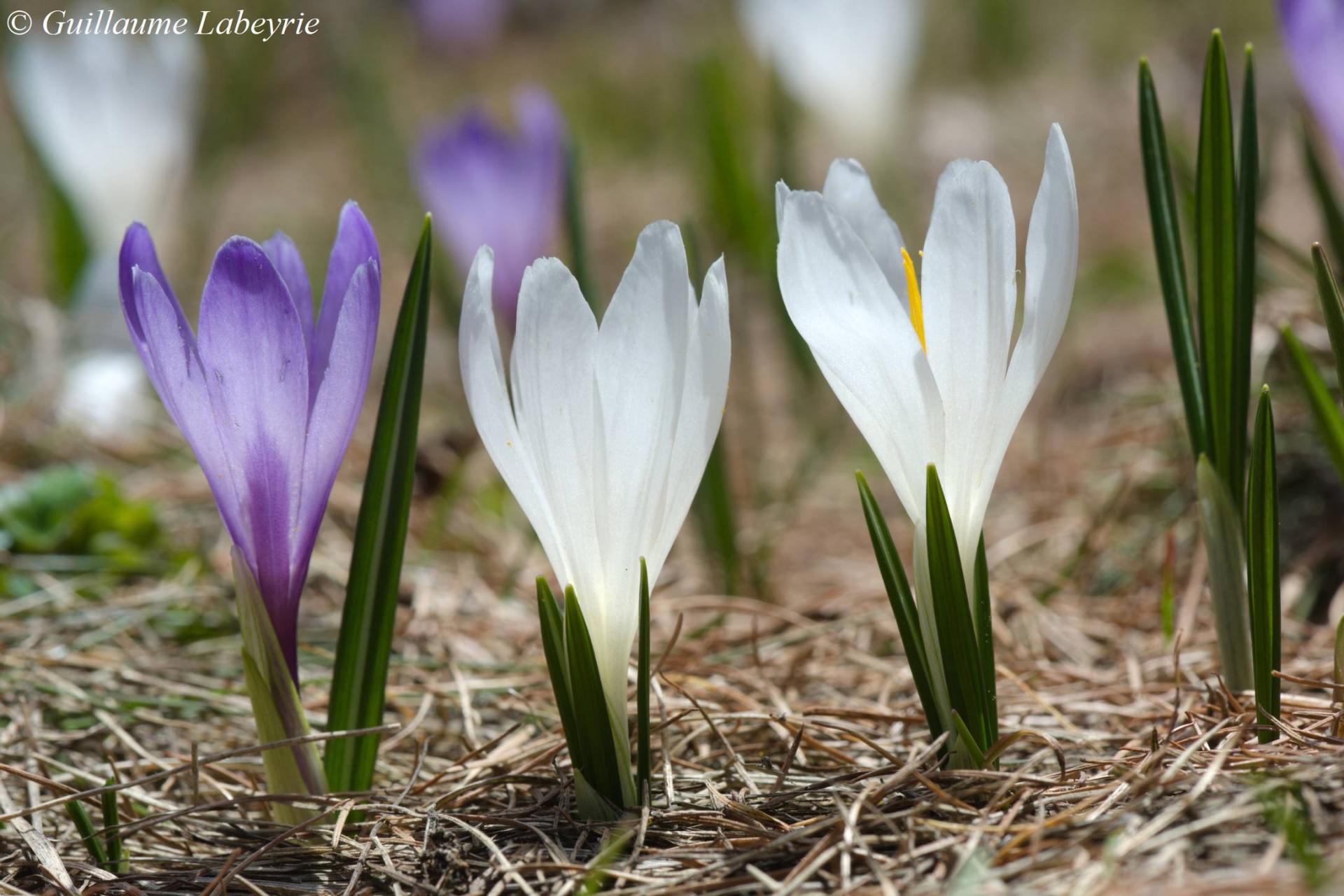 The spring crocus (Crocus vernus). This crocus blooms in the mountains just after the snow melts, in grasslands and open larch undergrowth. Its populations are usually large and dense. Unlike Crocus versicolor, the white crocus is uniform in colour (white or purple), except sometimes at the base of the tepals. It is found in France in the north-east, the Alps, the Massif Central and the Pyrenees.
The spring crocus (Crocus vernus). This crocus blooms in the mountains just after the snow melts, in grasslands and open larch undergrowth. Its populations are usually large and dense. Unlike Crocus versicolor, the white crocus is uniform in colour (white or purple), except sometimes at the base of the tepals. It is found in France in the north-east, the Alps, the Massif Central and the Pyrenees.
Family : Liliaceae
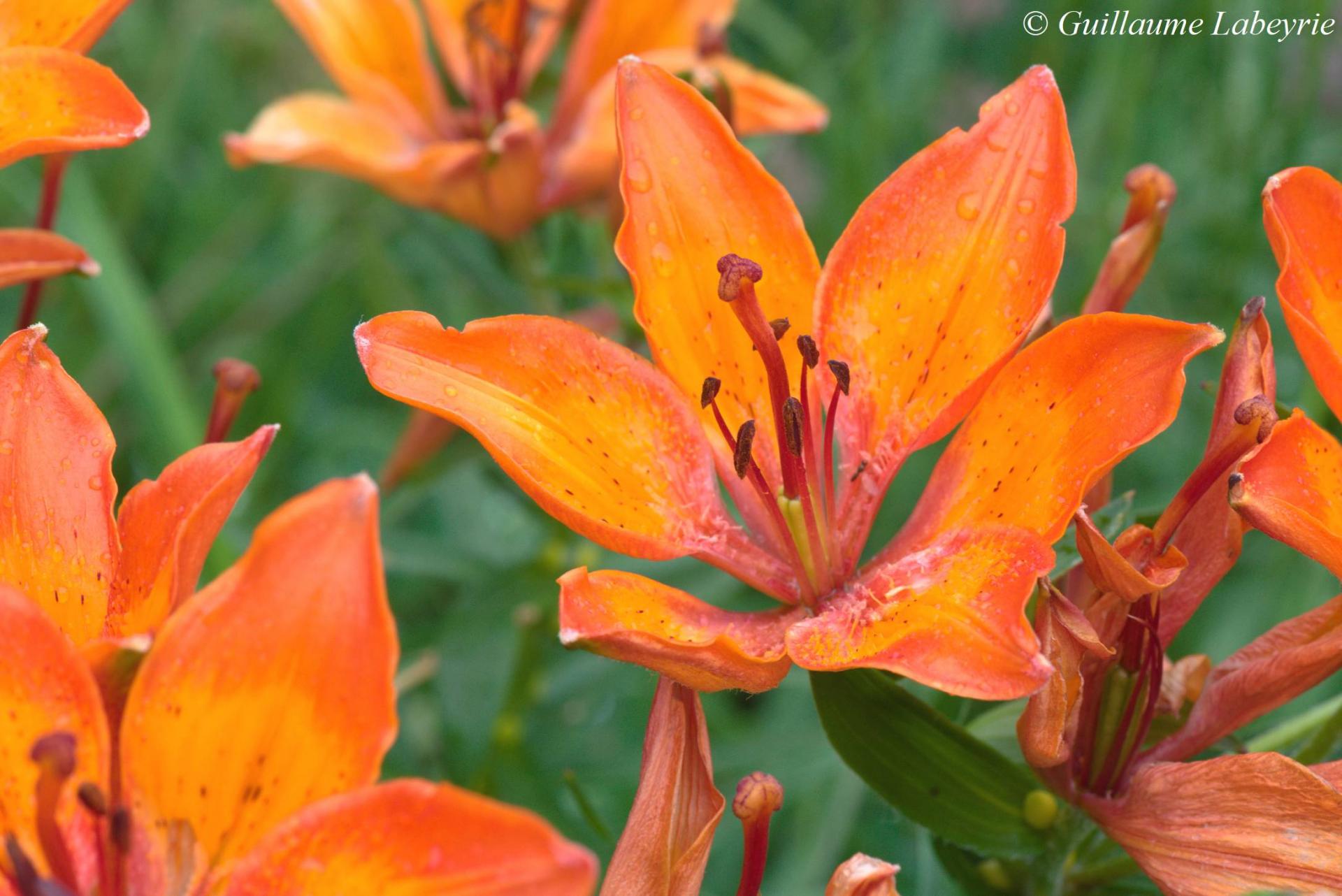 The orange lily (Lilium bulbiferum var. croceum). This splendid lily is one of our most spectacular plants, with flowers up to 10 cm in diameter. It can be found in a variety of environments: mountain meadows, grasslands, open undergrowth and rocky areas. It is found in France in the Alps and in Corsica, and is protected in various regions.
The orange lily (Lilium bulbiferum var. croceum). This splendid lily is one of our most spectacular plants, with flowers up to 10 cm in diameter. It can be found in a variety of environments: mountain meadows, grasslands, open undergrowth and rocky areas. It is found in France in the Alps and in Corsica, and is protected in various regions.

The martagon lily (Lilium martagon). This large lily, emblematic of the flora of the Alps, can be identified by its pink flowers dotted with purple spots. It is typically found in alpine meadows, sometimes in the company of the previous species. It is distributed throughout Europe as far as Russia. In France, it is mainly found in the south-eastern half of the country. It is protected in Centre, Champagne-Ardenne, Poitou-Charentes, Limousin, Auvergne and Corsica.
 Gagea fragifera. This small plant with bright yellow flowers can be recognized to its large, linear and hollow basal leaves. The flower stalks are hairy. It is a mountain species, which sometimes grows in large numbers in meadows and larch woods clearings in spring. It is found in the Pyrenees, the Alps and in Corsica.
Gagea fragifera. This small plant with bright yellow flowers can be recognized to its large, linear and hollow basal leaves. The flower stalks are hairy. It is a mountain species, which sometimes grows in large numbers in meadows and larch woods clearings in spring. It is found in the Pyrenees, the Alps and in Corsica.
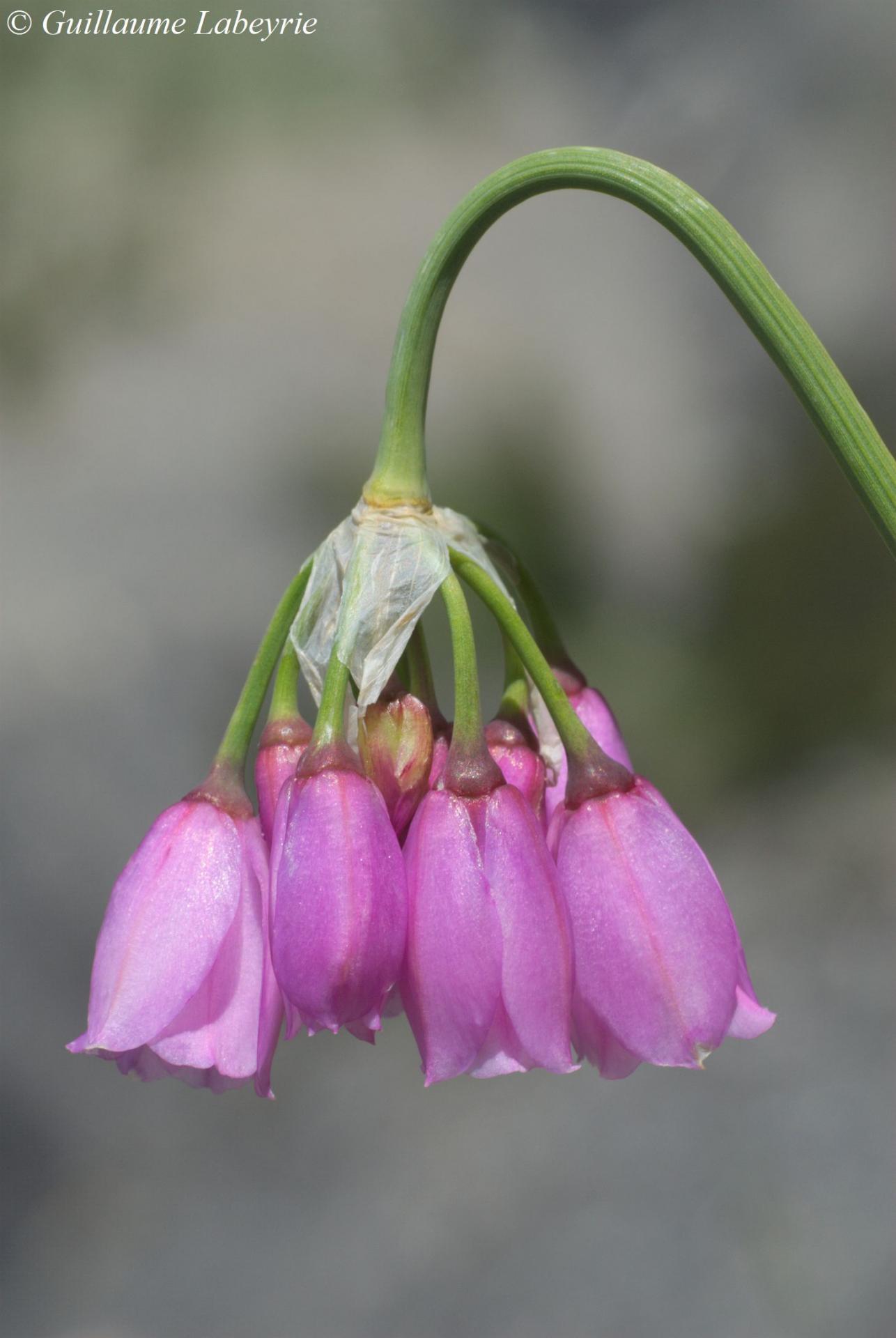 The Piedmont garlic (Allium narcissiflorum). This is our most beautiful garlic, with its umbrellas of large pink flowers. It is found in rocky calcareous slopes, above 1500m of elevation. This is a rather rare plant, endemic of the southern Alps.
The Piedmont garlic (Allium narcissiflorum). This is our most beautiful garlic, with its umbrellas of large pink flowers. It is found in rocky calcareous slopes, above 1500m of elevation. This is a rather rare plant, endemic of the southern Alps.
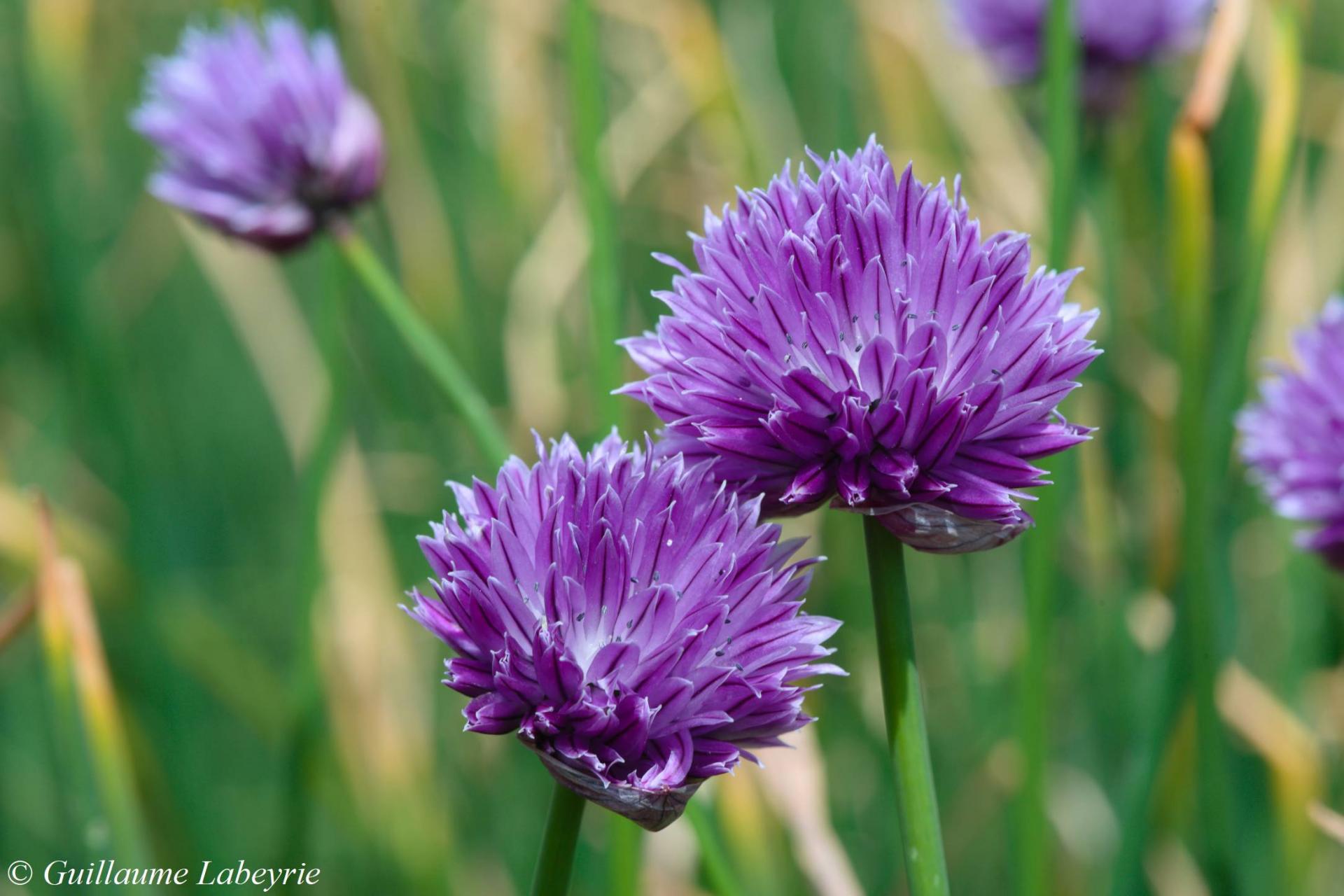 Chives (Allium schoenoprasum). This tall garlic grows in moist areas, such as bogs around small alpine lakes. Of very wide worldwide distribution, this plant is found almost everywhere in France.
Chives (Allium schoenoprasum). This tall garlic grows in moist areas, such as bogs around small alpine lakes. Of very wide worldwide distribution, this plant is found almost everywhere in France.
Family : Ophioglossaceae
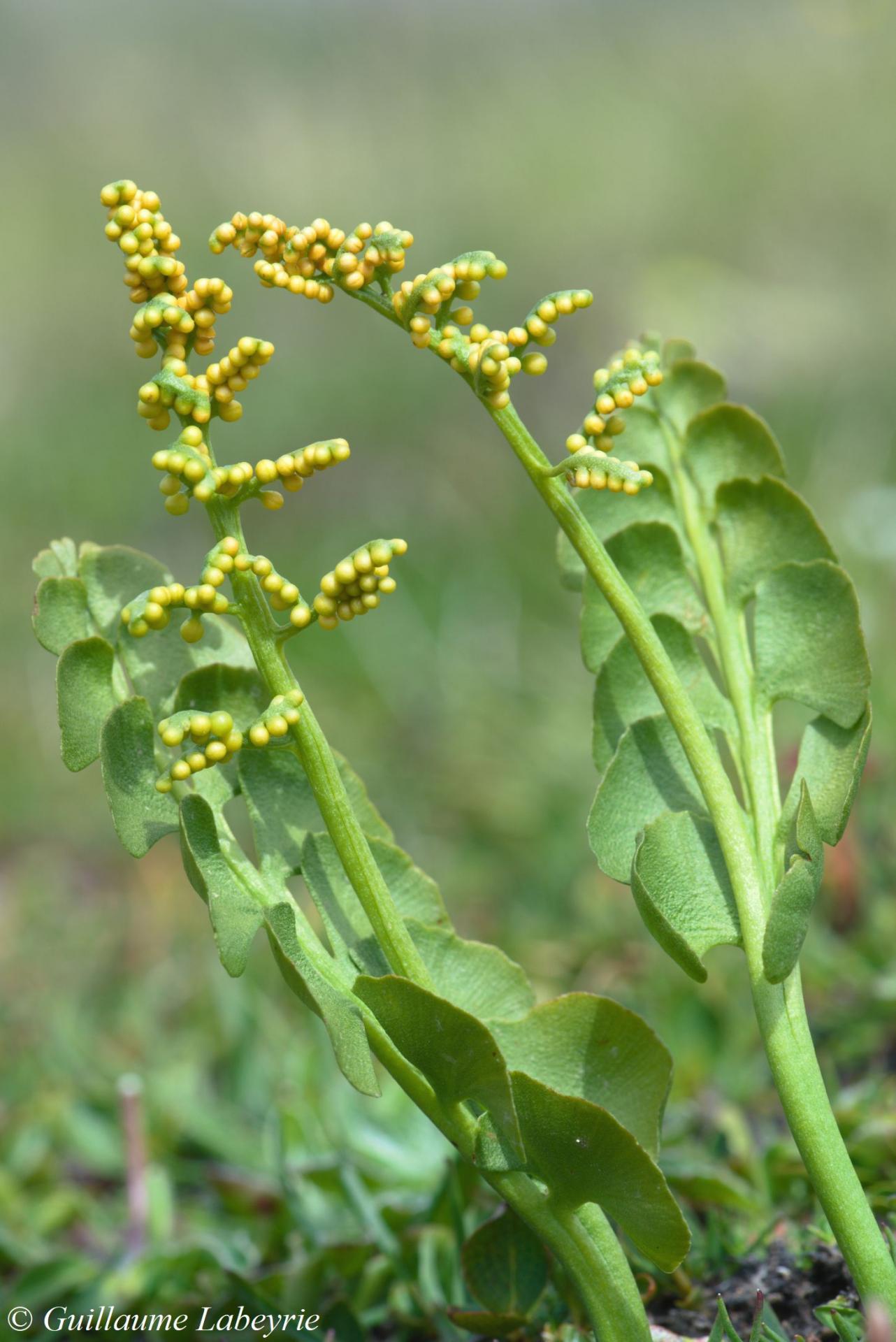 The common moonwort (Botrychium lunaria). This small boreo-alpine fern appreciates sunny grazed grasslands, above 2000 m of altitude. It has a very wide worldwide distribution. It is found here and there in France, where it is protected in many regions
The common moonwort (Botrychium lunaria). This small boreo-alpine fern appreciates sunny grazed grasslands, above 2000 m of altitude. It has a very wide worldwide distribution. It is found here and there in France, where it is protected in many regions
Family : Orchidaceae
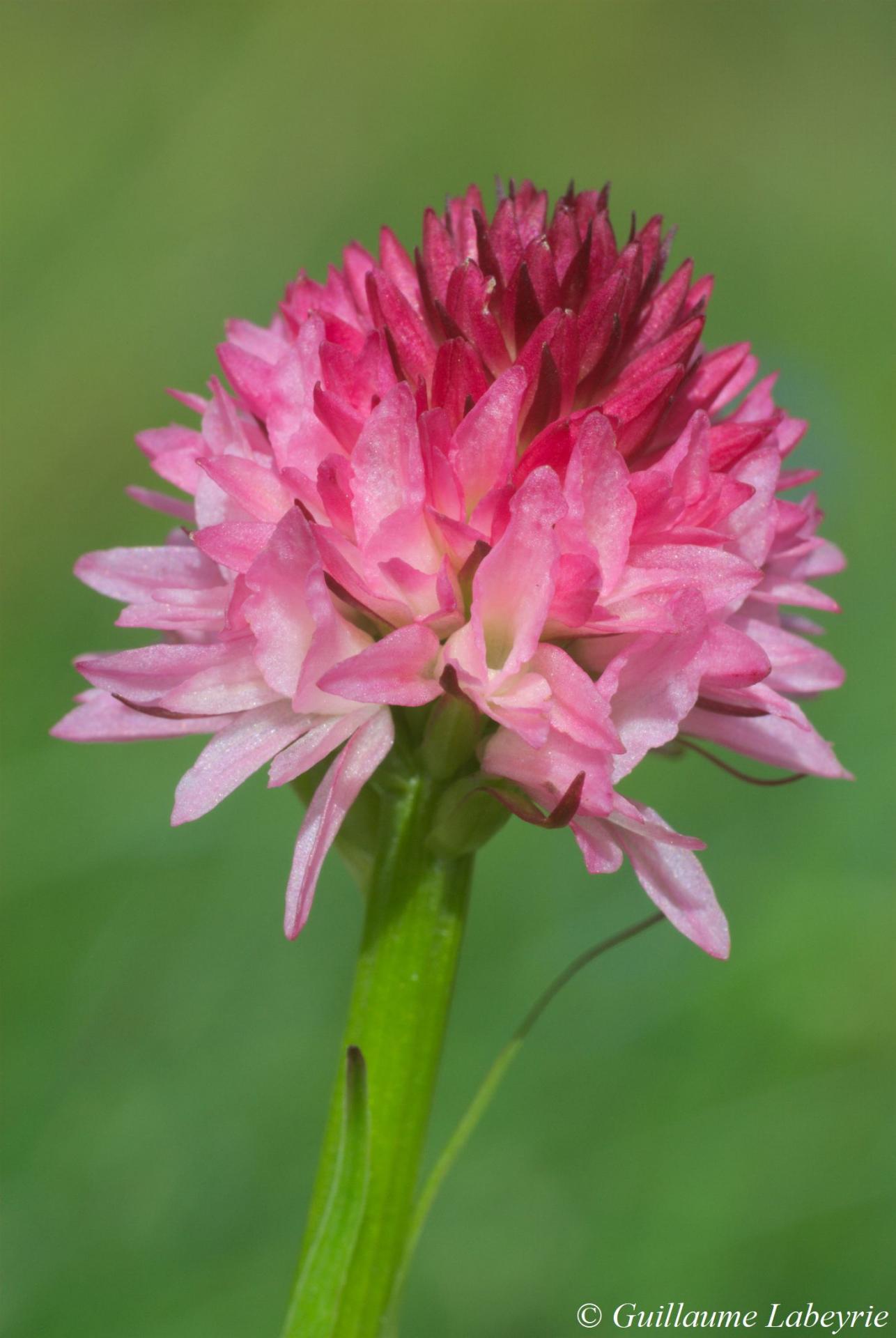 Gymnadenia corneliana. This beautiful orchid can be recognized by its tight pink floral spike, with darker unopened flowers. It frequents alpine grasslands, above 1800 m. Endemic to the southern Alps, it is found only in France and Italy.
Gymnadenia corneliana. This beautiful orchid can be recognized by its tight pink floral spike, with darker unopened flowers. It frequents alpine grasslands, above 1800 m. Endemic to the southern Alps, it is found only in France and Italy.
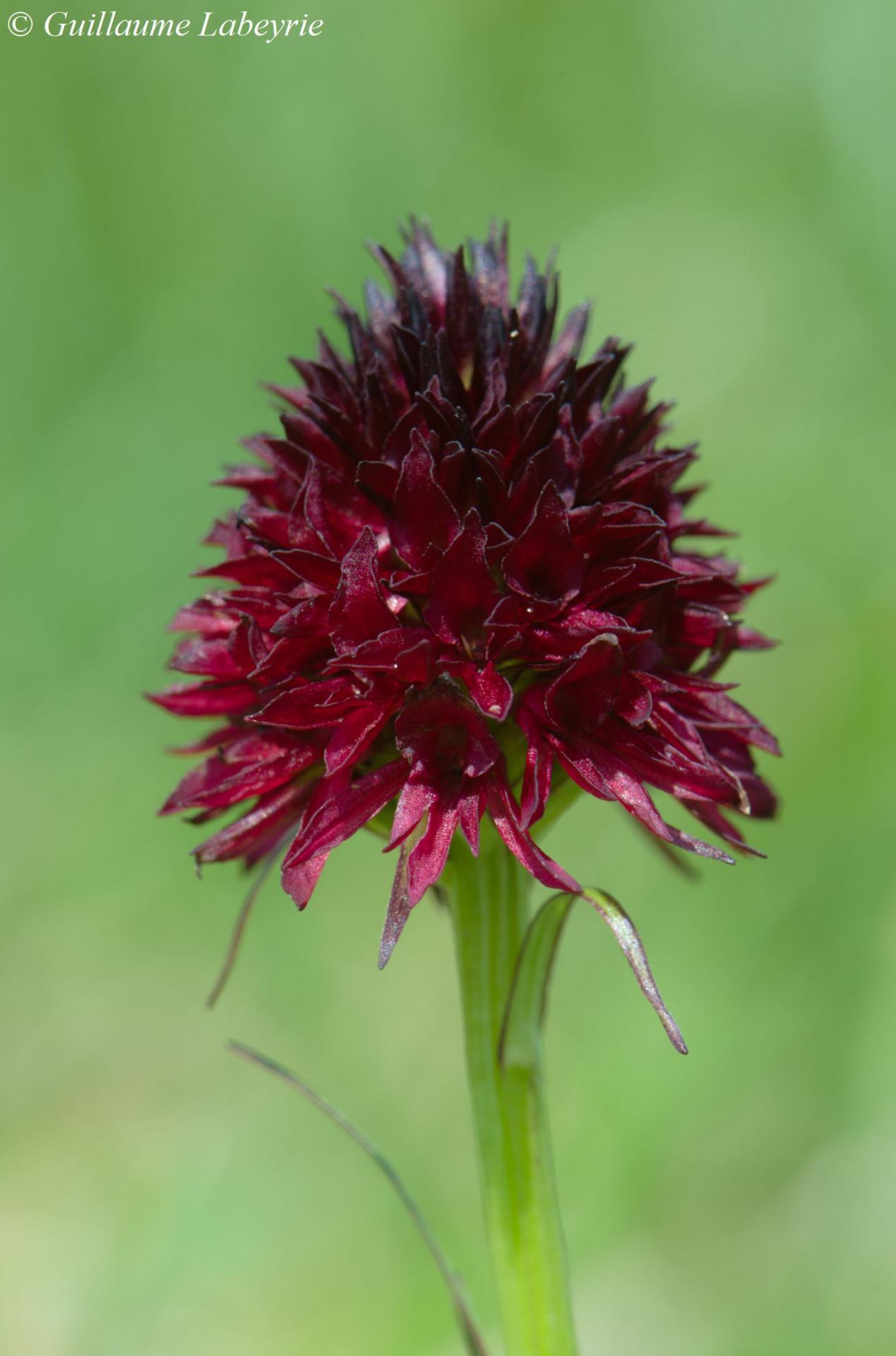 The black orchid (Gymnadenia rhellicani). This species frequents the same environments as the previous one. It can be recognized by its dark red floral spike. The similar Gymnadenia austriaca, rarer in France, is distinguished by a longer labellum and the absence of teeth on the lower bracts (criterion difficult to use without a magnifying glass). The black orchid is present in Europe, from France to the Balkans. In France, it is found in the Jura and the Alps.
The black orchid (Gymnadenia rhellicani). This species frequents the same environments as the previous one. It can be recognized by its dark red floral spike. The similar Gymnadenia austriaca, rarer in France, is distinguished by a longer labellum and the absence of teeth on the lower bracts (criterion difficult to use without a magnifying glass). The black orchid is present in Europe, from France to the Balkans. In France, it is found in the Jura and the Alps.
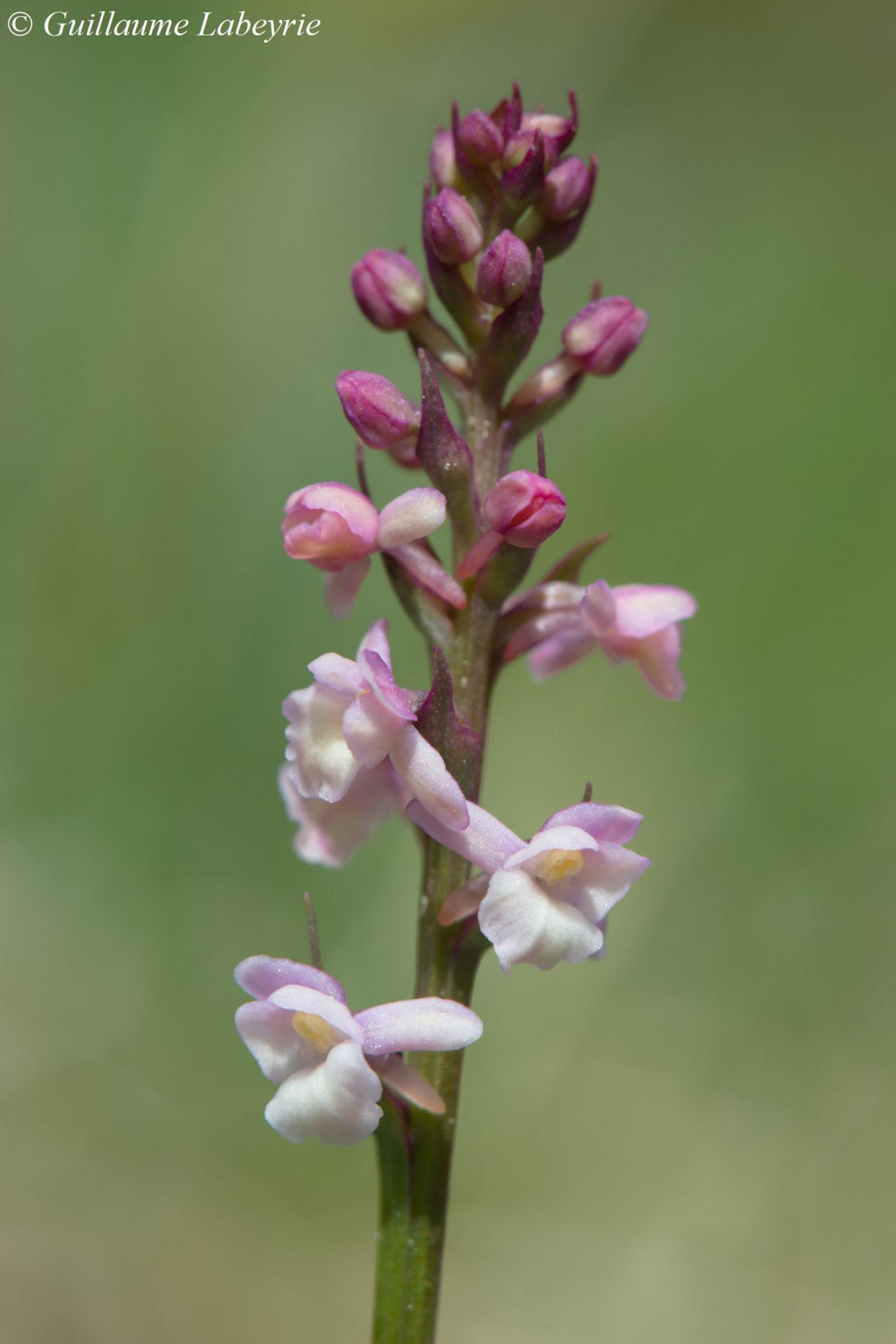 The short-spurred fragrant orchid (Gymnadenia odoratissima). This species is distinguished from the much more common fragrant orchid (Gymnadenia conopsea) by its more slender habit, its often pale flowers with a short spur (equalling at most the length of the ovary). In our country, this orchid typically grows in the mountains, on dry limestone slopes with coniferous forests. Quite widely distributed in France, it is rare everywhere and protected in many regions (including PACA). It is on the national red list with the mention "vulnerable".
The short-spurred fragrant orchid (Gymnadenia odoratissima). This species is distinguished from the much more common fragrant orchid (Gymnadenia conopsea) by its more slender habit, its often pale flowers with a short spur (equalling at most the length of the ovary). In our country, this orchid typically grows in the mountains, on dry limestone slopes with coniferous forests. Quite widely distributed in France, it is rare everywhere and protected in many regions (including PACA). It is on the national red list with the mention "vulnerable".
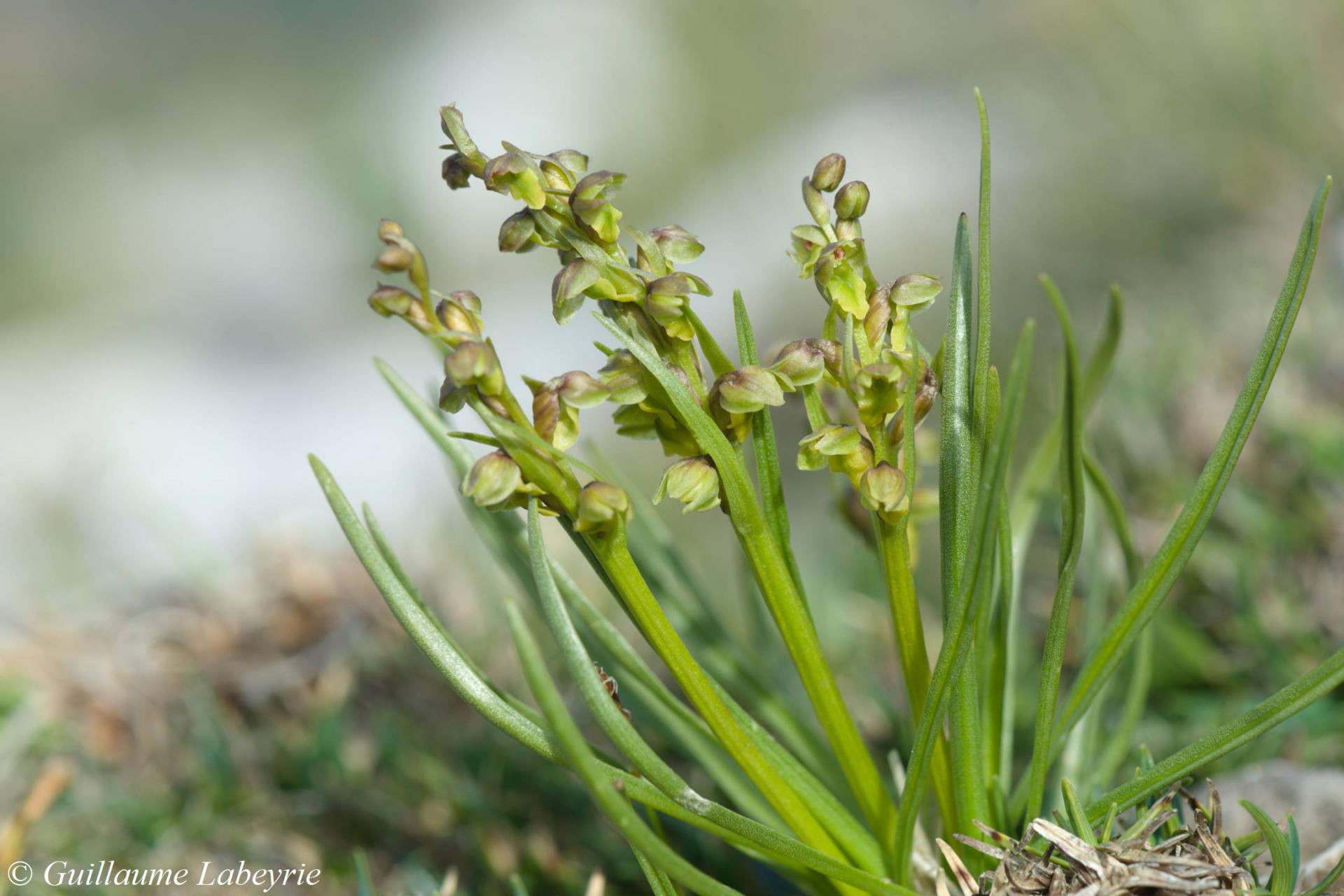 The false orchid (Chamorchis alpina). This tiny greenish orchid does not exceed a few centimeters in height. It therefore easily goes unnoticed in the calcareous alpine grasslands which constitute its natural habitat. It is distributed in the Alps, the Carpathians and Fenoscandia. Protected in the PACA region, this orchid is present there mainly in the extreme northeast of the Alpes-Maritimes and in the Queyras region (Hautes-Alpes). It is on the national red list as ''near-threatened''.
The false orchid (Chamorchis alpina). This tiny greenish orchid does not exceed a few centimeters in height. It therefore easily goes unnoticed in the calcareous alpine grasslands which constitute its natural habitat. It is distributed in the Alps, the Carpathians and Fenoscandia. Protected in the PACA region, this orchid is present there mainly in the extreme northeast of the Alpes-Maritimes and in the Queyras region (Hautes-Alpes). It is on the national red list as ''near-threatened''.
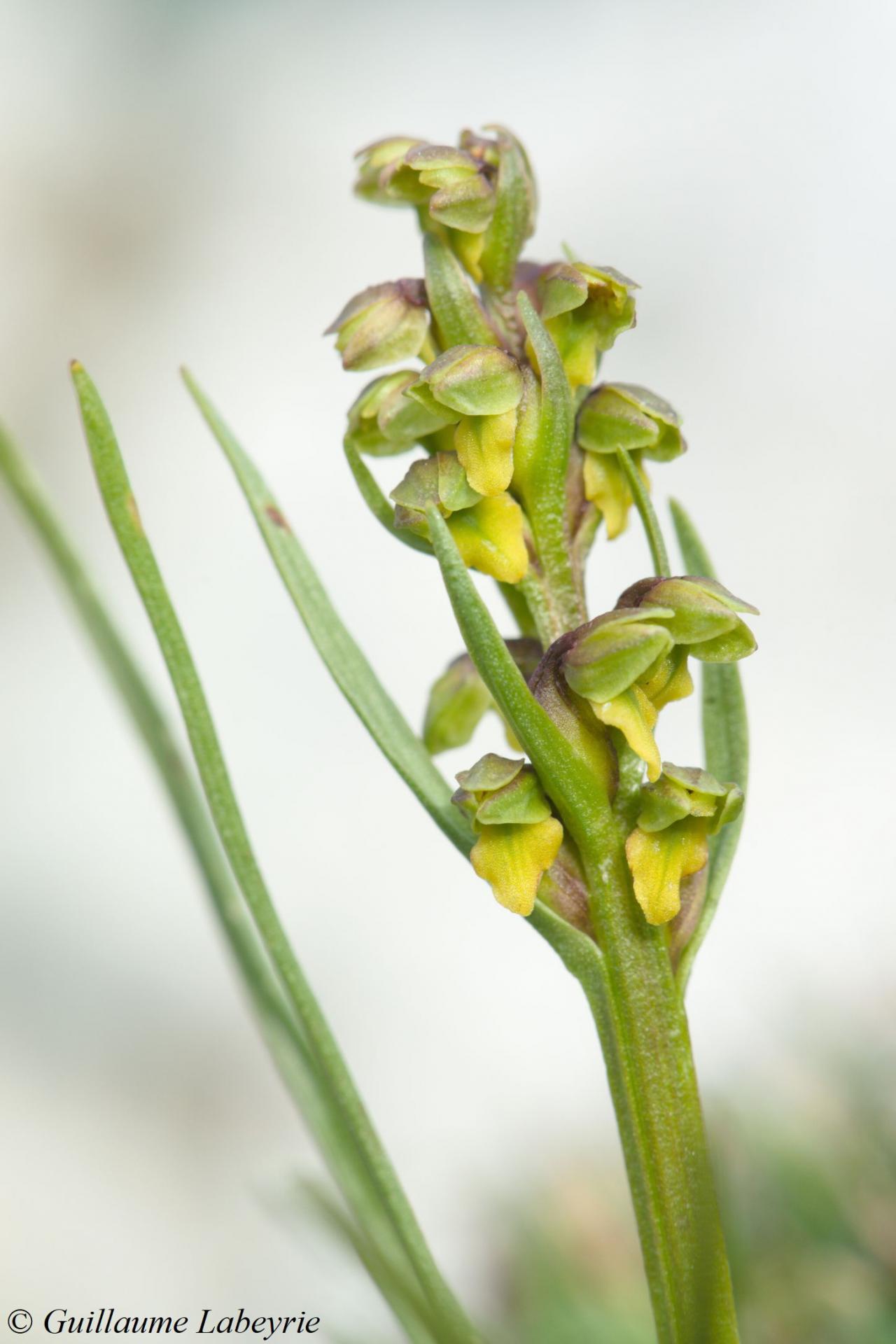 The false orchid (Chamorchis alpina).
The false orchid (Chamorchis alpina).
Family : Pinaceae
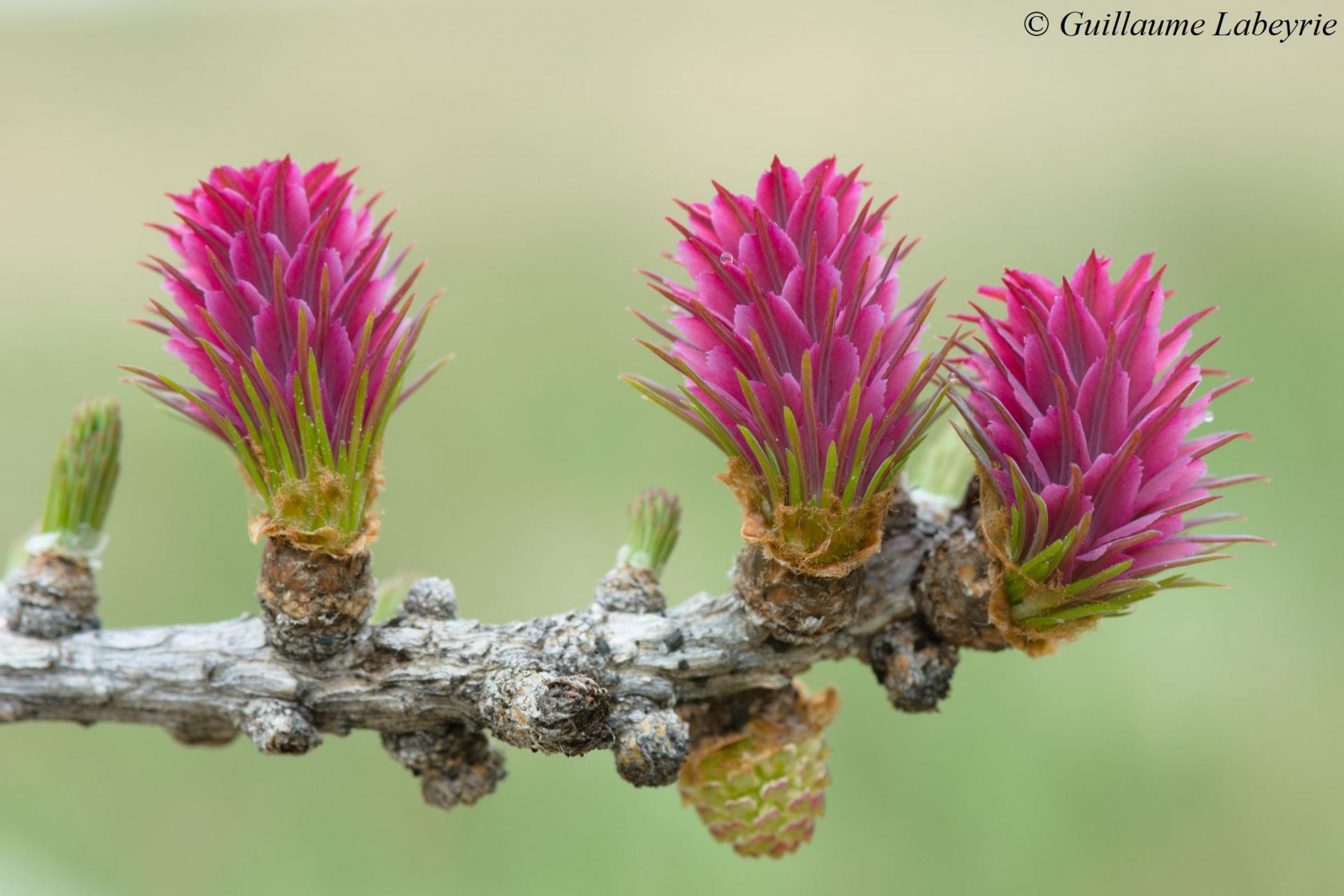 The European larch (Larix decidua). This conifer, the only one in Europe to lose its needles in winter, is emblematic of our mountains. It is found there above 1400 m. In spring, young female cones are pink, while male cones are yellow. The larch occurs naturally from the Alps to the Carpathians, but has been introduced elsewhere.
The European larch (Larix decidua). This conifer, the only one in Europe to lose its needles in winter, is emblematic of our mountains. It is found there above 1400 m. In spring, young female cones are pink, while male cones are yellow. The larch occurs naturally from the Alps to the Carpathians, but has been introduced elsewhere.
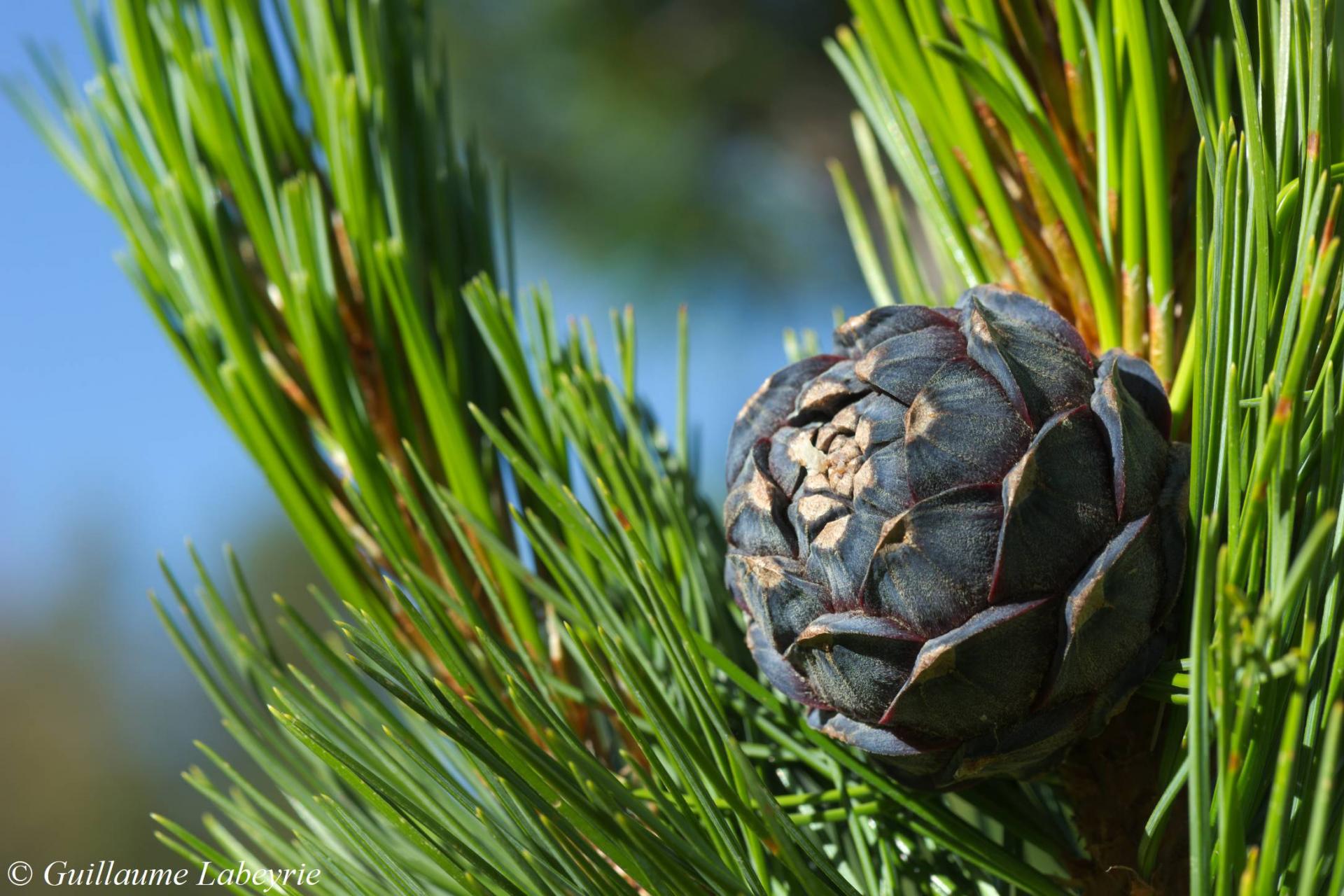 The Swiss pine (Pinus cembra). This pine is distinguished by its needles grouped by five. The cones are bluish, as can be seen in this photo. Seeds are dispersed by the spotted nutcracker (Nucifraga caryocatactes). It is a high mountain tree, which reaches an altitude of 2500 m. The Swiss pine is present in the Alps and the Carpathians.
The Swiss pine (Pinus cembra). This pine is distinguished by its needles grouped by five. The cones are bluish, as can be seen in this photo. Seeds are dispersed by the spotted nutcracker (Nucifraga caryocatactes). It is a high mountain tree, which reaches an altitude of 2500 m. The Swiss pine is present in the Alps and the Carpathians.
Family : Plantaginaceae
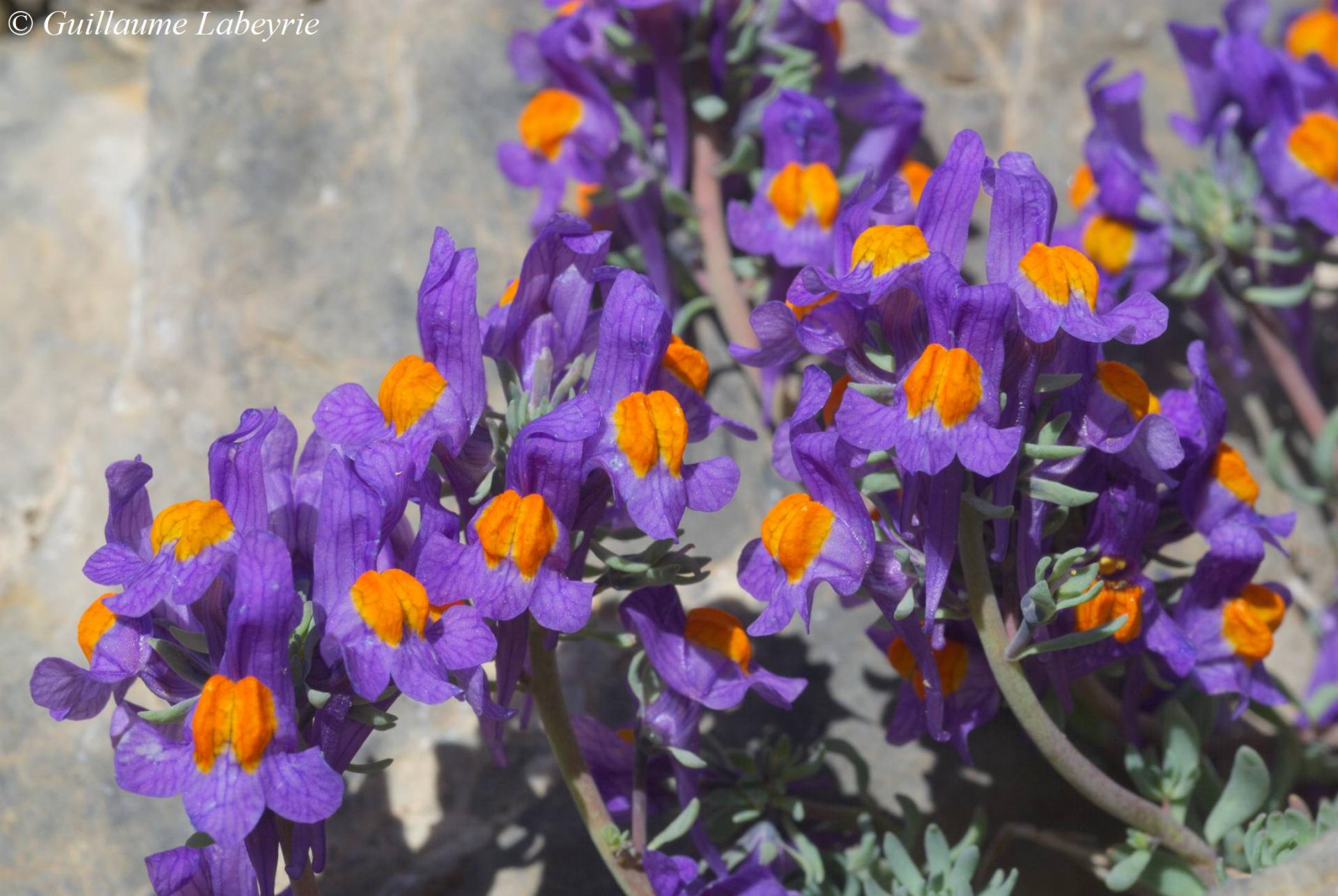 The alpine toadflax (Linaria alpina). This pretty plant, the most vividly colored of the genus, is found almost exclusively in the inhospitable scree of high mountains across Europe, from Spain to the Balkans. In France, it is mainly found in the Pyrenees and the Alps. It is protected in region Bourgogne.
The alpine toadflax (Linaria alpina). This pretty plant, the most vividly colored of the genus, is found almost exclusively in the inhospitable scree of high mountains across Europe, from Spain to the Balkans. In France, it is mainly found in the Pyrenees and the Alps. It is protected in region Bourgogne.
Family : Primulaceae
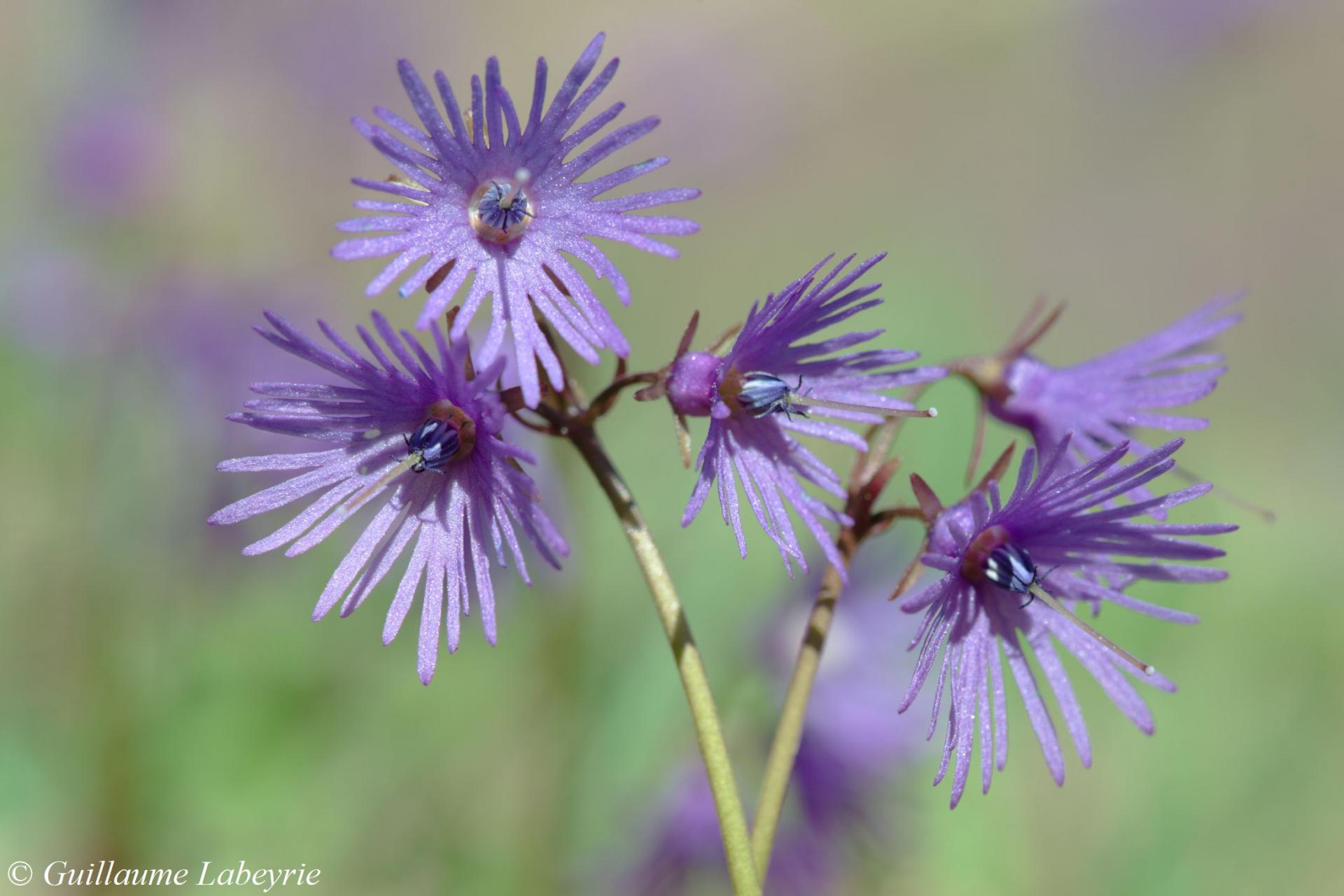 The alpine snowbell (Soldanella alpina). This delicate little plant cannot be mistaken. It is a mountain species, which flowers in spring just after the snow has melted. Distributed from the Spanish Pyrenees to the Balkans, it is found in France mainly in the Alps, the Massif Central and the Pyrenees. It is protected in the Auvergne region.
The alpine snowbell (Soldanella alpina). This delicate little plant cannot be mistaken. It is a mountain species, which flowers in spring just after the snow has melted. Distributed from the Spanish Pyrenees to the Balkans, it is found in France mainly in the Alps, the Massif Central and the Pyrenees. It is protected in the Auvergne region.
Family : Ranunculaceae
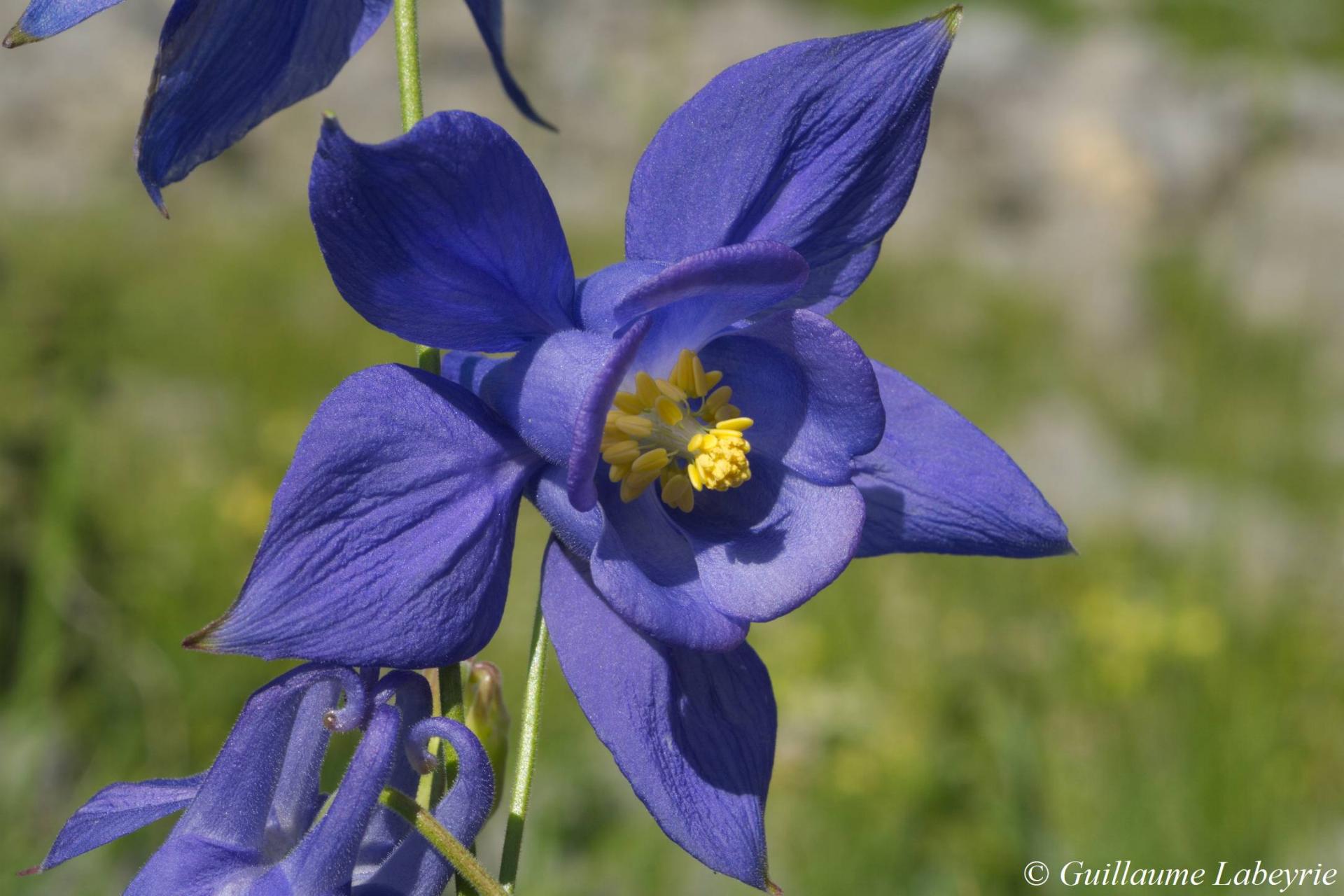 Bertoloni's columbine (Aquilegia reuteri). This beautiful columbine is distinguished from other species of the genus by the blue-violet tint of the flower, the stamens not protruding from the corolla and the hooked shape of the flower spurs. It populates limestone scree, typically between 1000 and 2000 m. It is a Liguro-Provençal endemic, which is found in France from the Drôme to the Alpes-Maritimes. It it protected at the national level.
Bertoloni's columbine (Aquilegia reuteri). This beautiful columbine is distinguished from other species of the genus by the blue-violet tint of the flower, the stamens not protruding from the corolla and the hooked shape of the flower spurs. It populates limestone scree, typically between 1000 and 2000 m. It is a Liguro-Provençal endemic, which is found in France from the Drôme to the Alpes-Maritimes. It it protected at the national level.
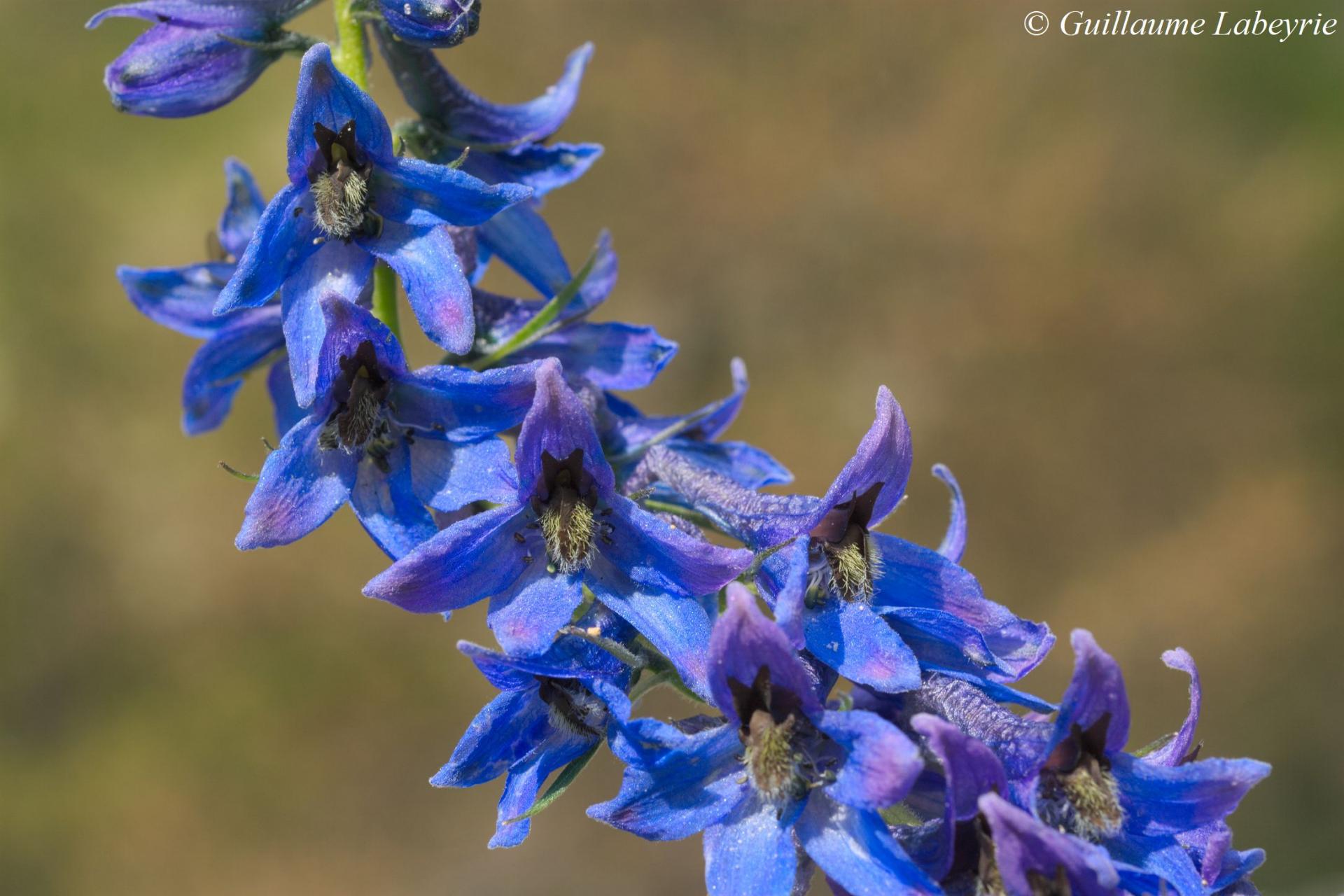 Delphinium dubium. This striking species, with intense blue flowers, loves clearings of larch woods and rocky slopes. Its large leaves are deeply divided into fairly wide lobes. This endemic to the Meridional Alps is found in southeastern France and northern Italy. It is protected in Rhône-Alpes and Drôme.
Delphinium dubium. This striking species, with intense blue flowers, loves clearings of larch woods and rocky slopes. Its large leaves are deeply divided into fairly wide lobes. This endemic to the Meridional Alps is found in southeastern France and northern Italy. It is protected in Rhône-Alpes and Drôme.
Family : Rosaceae
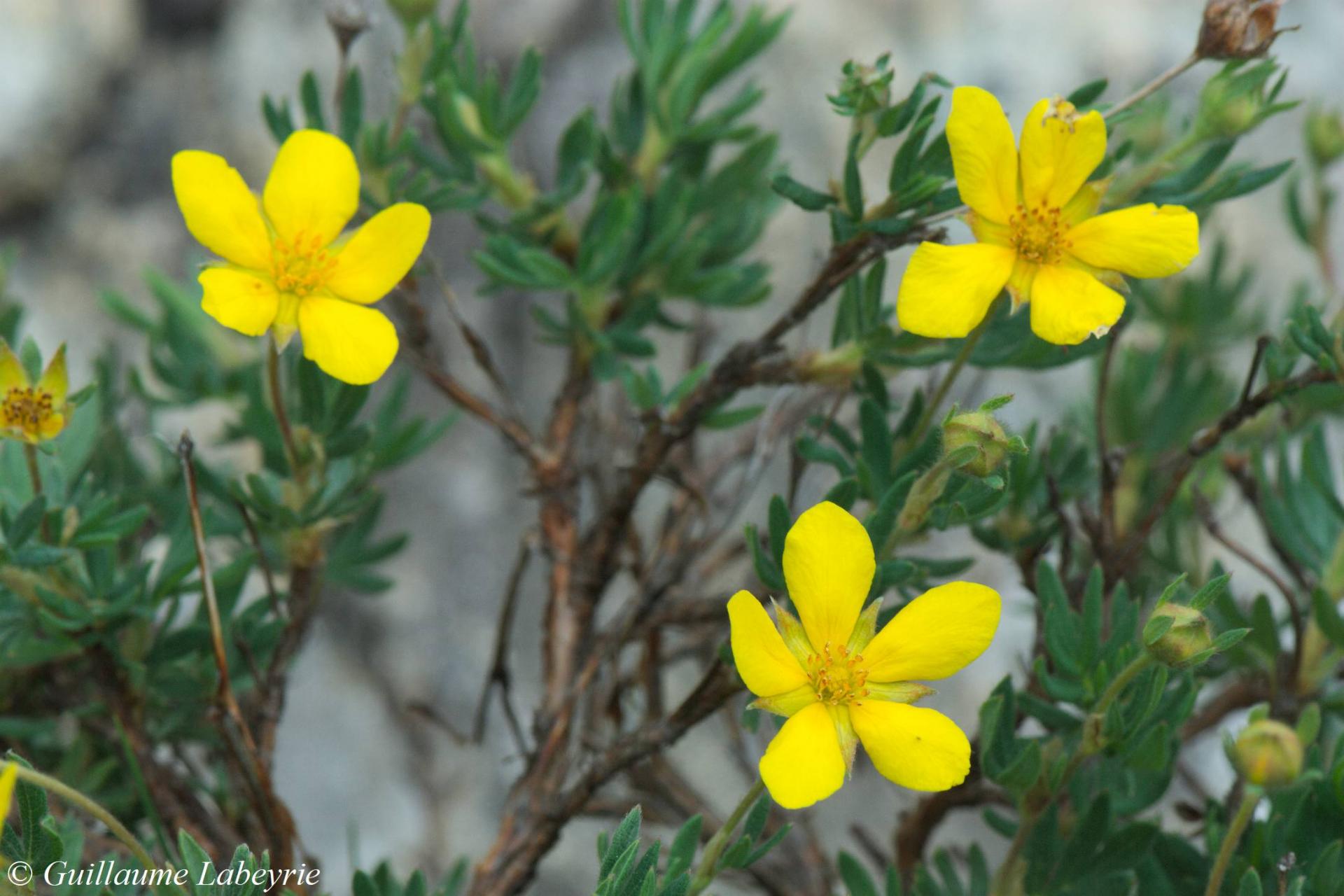 The shrubby cinquefoil (Dasiphora fruticosa). This plant forms bushes with woody stems, covered with divided leaves. It grows in the mountains, in wet rocky places along small streams. Flowering occurs from June to August. It is a species of boreal obedience, with a very wide global distribution. Relict in our climates, it is confined in France to the Alps and the Pyrenees. Extremely localized in PACA (a few stations in the Mercantour), it appears on the national red list under the mention "quasi threatened". It is fully protected in France.
The shrubby cinquefoil (Dasiphora fruticosa). This plant forms bushes with woody stems, covered with divided leaves. It grows in the mountains, in wet rocky places along small streams. Flowering occurs from June to August. It is a species of boreal obedience, with a very wide global distribution. Relict in our climates, it is confined in France to the Alps and the Pyrenees. Extremely localized in PACA (a few stations in the Mercantour), it appears on the national red list under the mention "quasi threatened". It is fully protected in France.
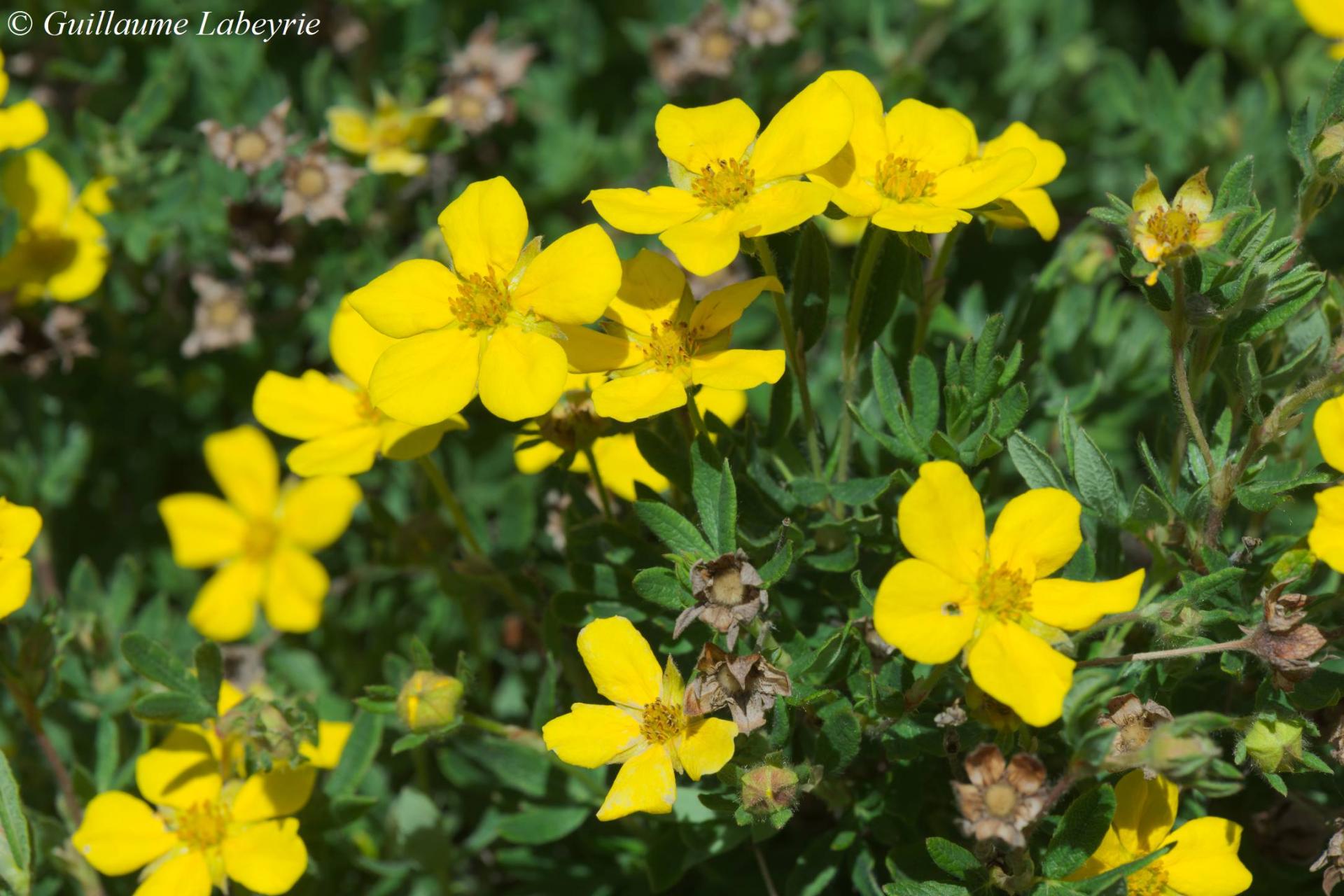
The shrubby cinquefoil (Dasiphora fruticosa).
Family : Salicaceae
 The net-leaved willow (Salix reticulata). This dwarf willow forms mats in snowbeds and wet meadows at high elevations, where it often grows in association with other dwarf willow species. It is easily recognized by its hairy leaves marked with a network of deep veins. This plant is found in the alpine or arctic regions of the globe. It is found in France in the Alps and the Pyrenees.
The net-leaved willow (Salix reticulata). This dwarf willow forms mats in snowbeds and wet meadows at high elevations, where it often grows in association with other dwarf willow species. It is easily recognized by its hairy leaves marked with a network of deep veins. This plant is found in the alpine or arctic regions of the globe. It is found in France in the Alps and the Pyrenees.
Family : Saxifragaceae
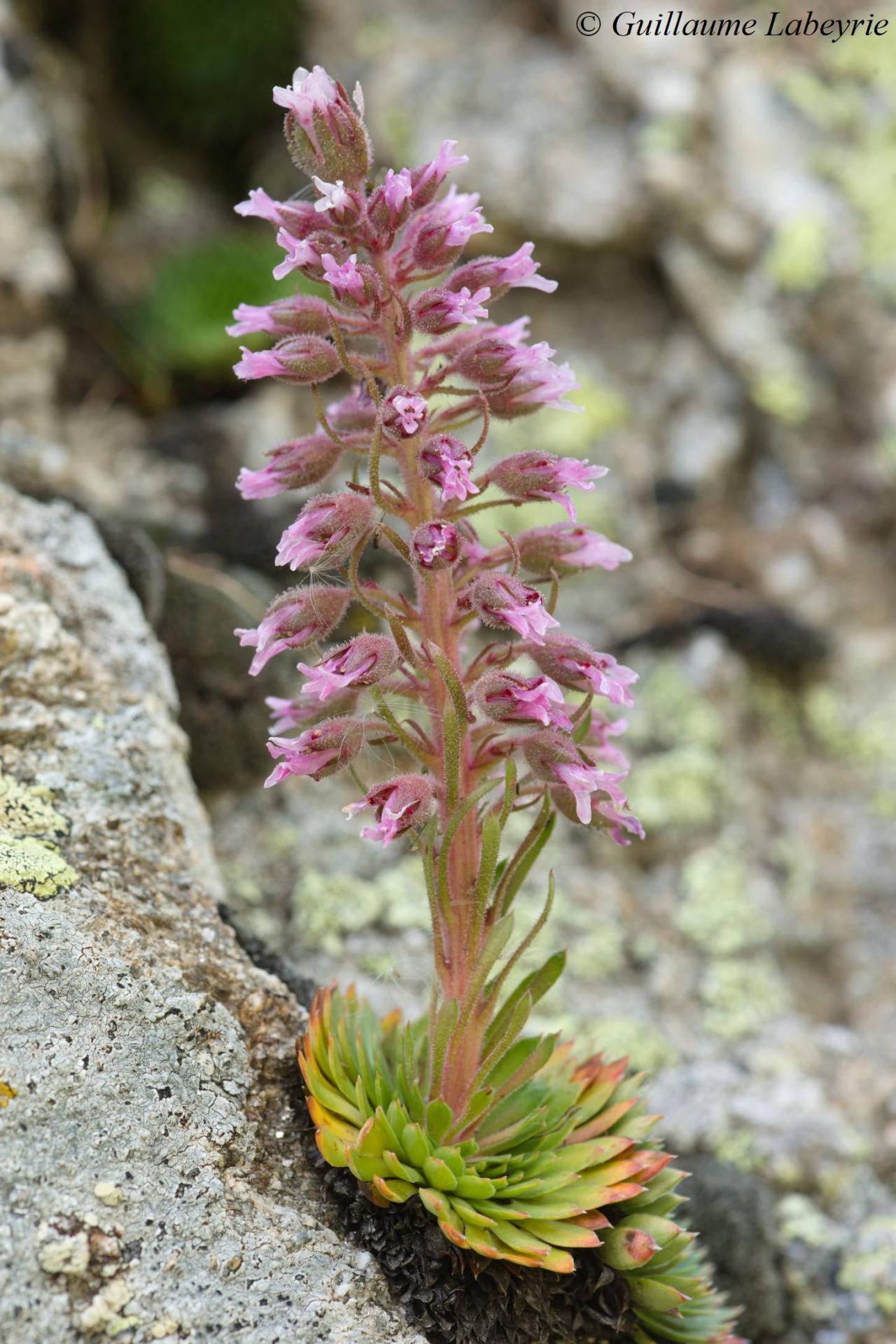 The ancient king (Saxifraga florulenta). This plant, emblematic of the Mercantour mountain range, only grows on vertical granitic rocks, usually exposed to the north. The tightly packed basal rosette of leaves is distinctive. This saxifrage flowers only once during its lifetime, which can last up to 70 years ! The plant then produces a flowering stem covered with pink flowers. This rare species, restricted to the French and Italian Maritime Alps, is fully protected in France.
The ancient king (Saxifraga florulenta). This plant, emblematic of the Mercantour mountain range, only grows on vertical granitic rocks, usually exposed to the north. The tightly packed basal rosette of leaves is distinctive. This saxifrage flowers only once during its lifetime, which can last up to 70 years ! The plant then produces a flowering stem covered with pink flowers. This rare species, restricted to the French and Italian Maritime Alps, is fully protected in France.
Family : Thymaeleaceae
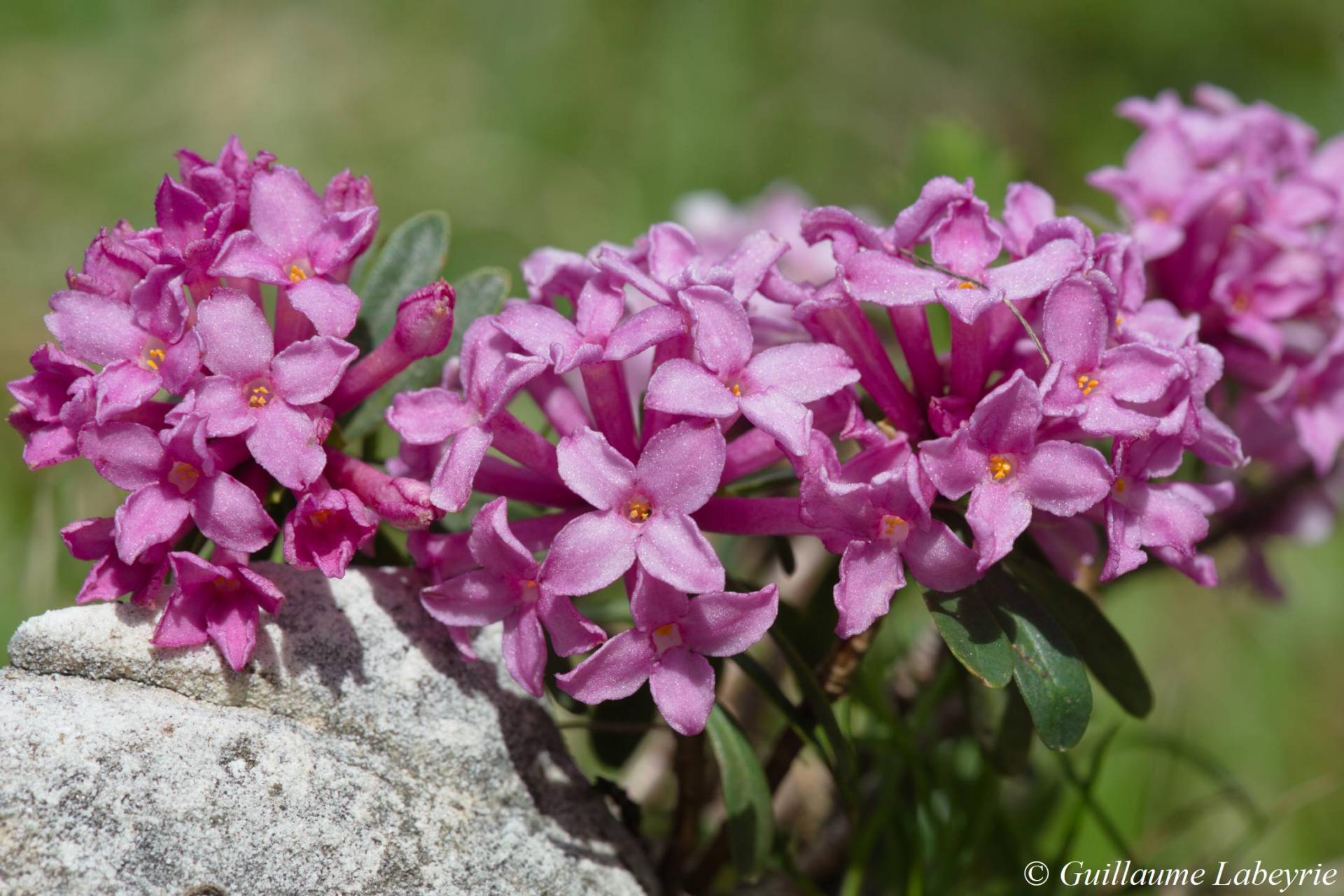 Daphne striata. This plant forms small bushes with clusters of pink flowers. It is found in grasslands and rocky woods, on limestone, at the alpine level. It differs from the rose daphne (Daphne cneorum), which is much more common in the region and grows at lower altitudes, by its hairless flowers and branches. Distributed from France to the former Yugoslavia, D. striata is present in our country in Savoie, in the Hautes-Alpes and the Alpes-Maritimes. This rare species is on the national red list as ''near-threatened'' and benefits from a national protection.
Daphne striata. This plant forms small bushes with clusters of pink flowers. It is found in grasslands and rocky woods, on limestone, at the alpine level. It differs from the rose daphne (Daphne cneorum), which is much more common in the region and grows at lower altitudes, by its hairless flowers and branches. Distributed from France to the former Yugoslavia, D. striata is present in our country in Savoie, in the Hautes-Alpes and the Alpes-Maritimes. This rare species is on the national red list as ''near-threatened'' and benefits from a national protection.
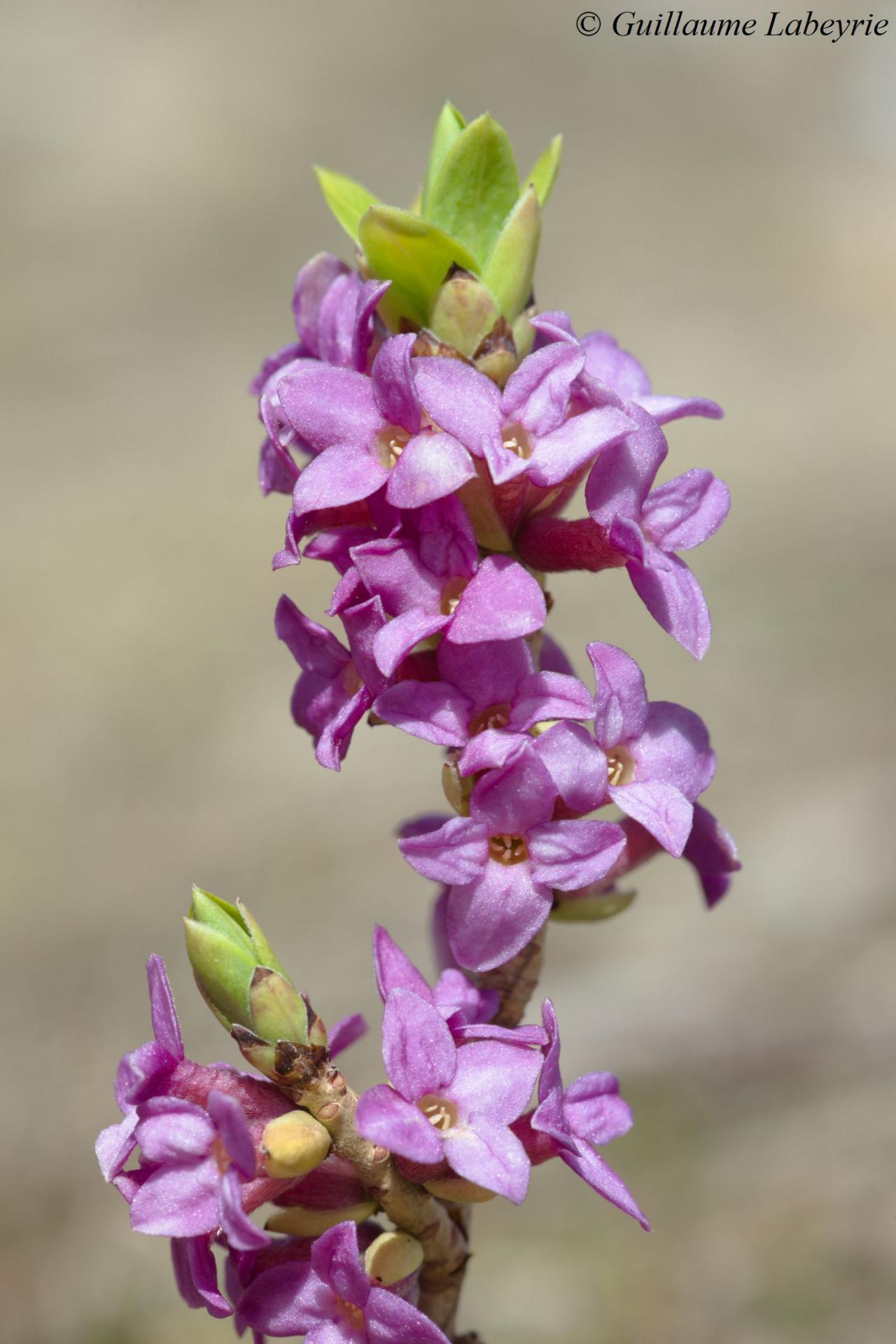 The spurge laurel (Daphne mezereum). Much more common than the previous species, this erect plant is found in meadows and undergrowth up to more than 2000 m of altitude. Flowering occurs in spring (April-May). As with most Daphne, the flowers are very fragrant but the plant is poisonous. Distributed throughout Europe as far as Russia and Iran, this species is present almost everywhere in France, but rare and protected in certain regions.
The spurge laurel (Daphne mezereum). Much more common than the previous species, this erect plant is found in meadows and undergrowth up to more than 2000 m of altitude. Flowering occurs in spring (April-May). As with most Daphne, the flowers are very fragrant but the plant is poisonous. Distributed throughout Europe as far as Russia and Iran, this species is present almost everywhere in France, but rare and protected in certain regions.
Family : Violaceae
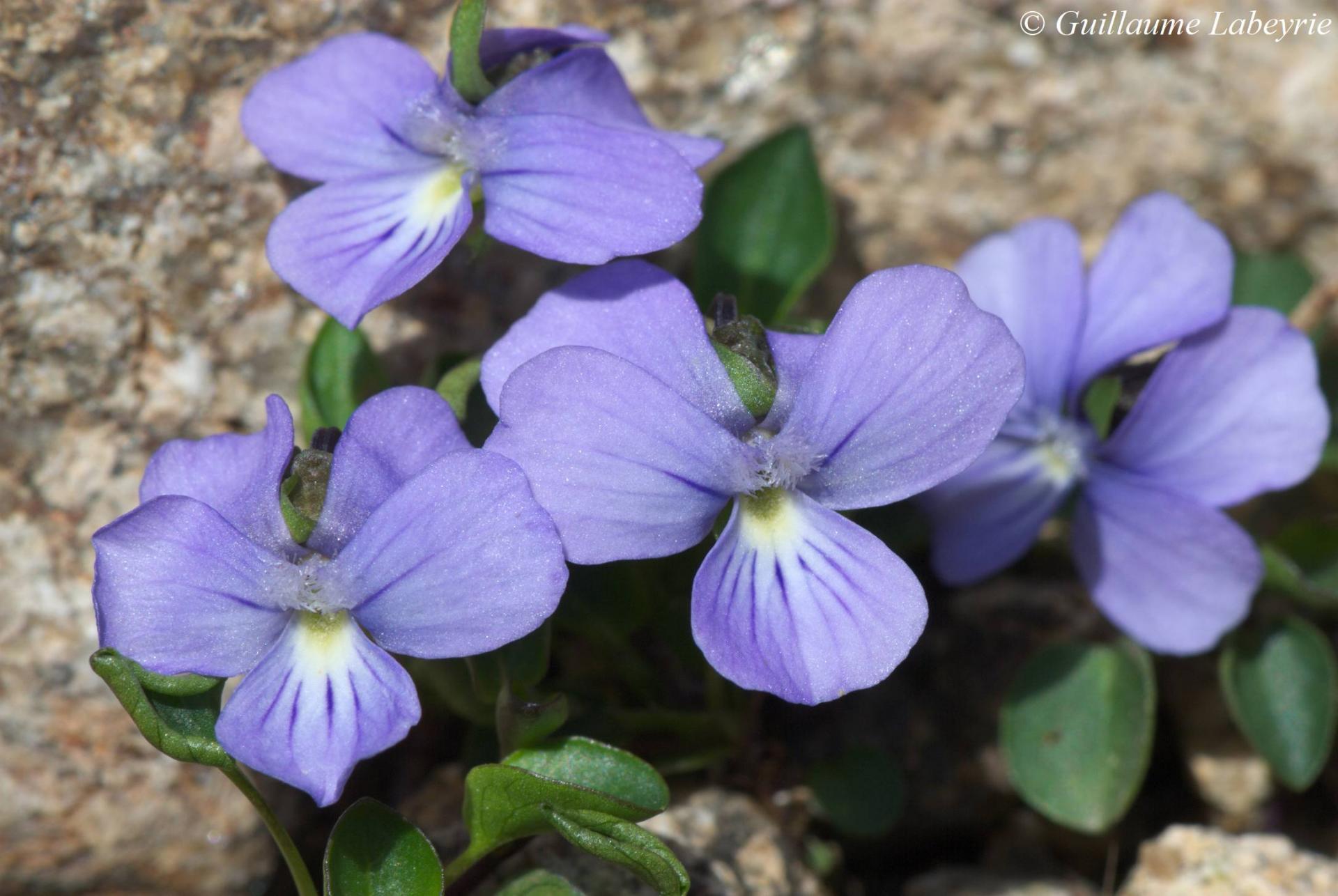 Viola argenteria (= V. nummularifolia). This little violet can be recognized to its small, round, shiny leaves and its pale blue flowers. It is found in rocky places at the alpine level (flowering August-September). This species with restricted distribution is present only in the French and Italian Alpes-Maritimes, as well as in Corsica.
Viola argenteria (= V. nummularifolia). This little violet can be recognized to its small, round, shiny leaves and its pale blue flowers. It is found in rocky places at the alpine level (flowering August-September). This species with restricted distribution is present only in the French and Italian Alpes-Maritimes, as well as in Corsica.